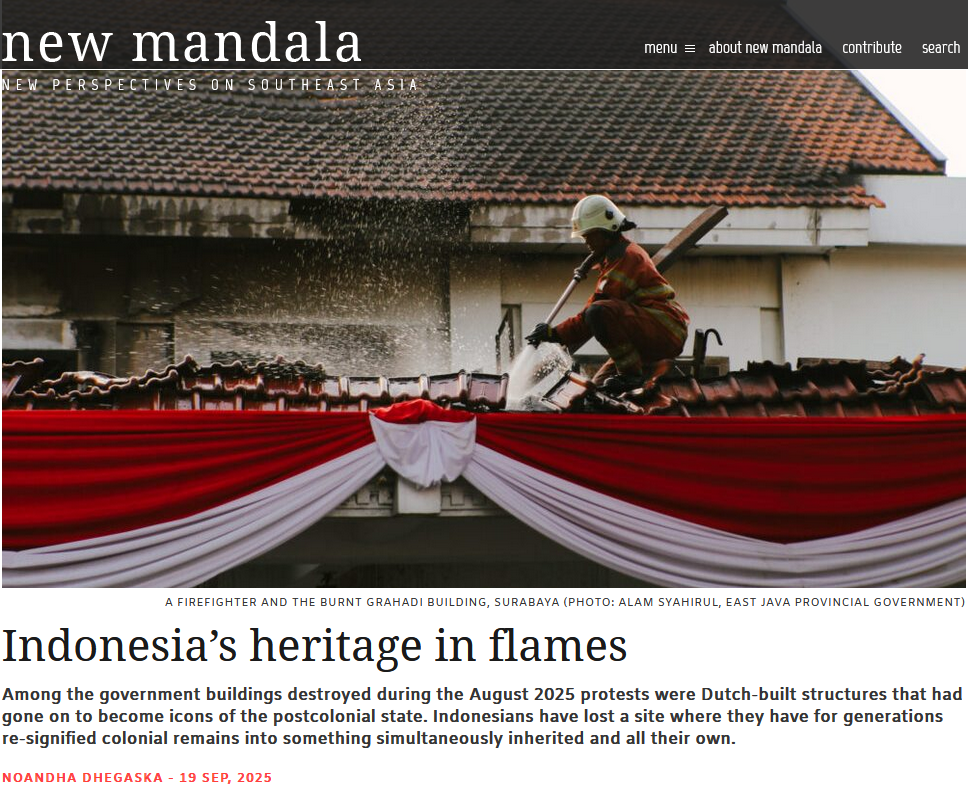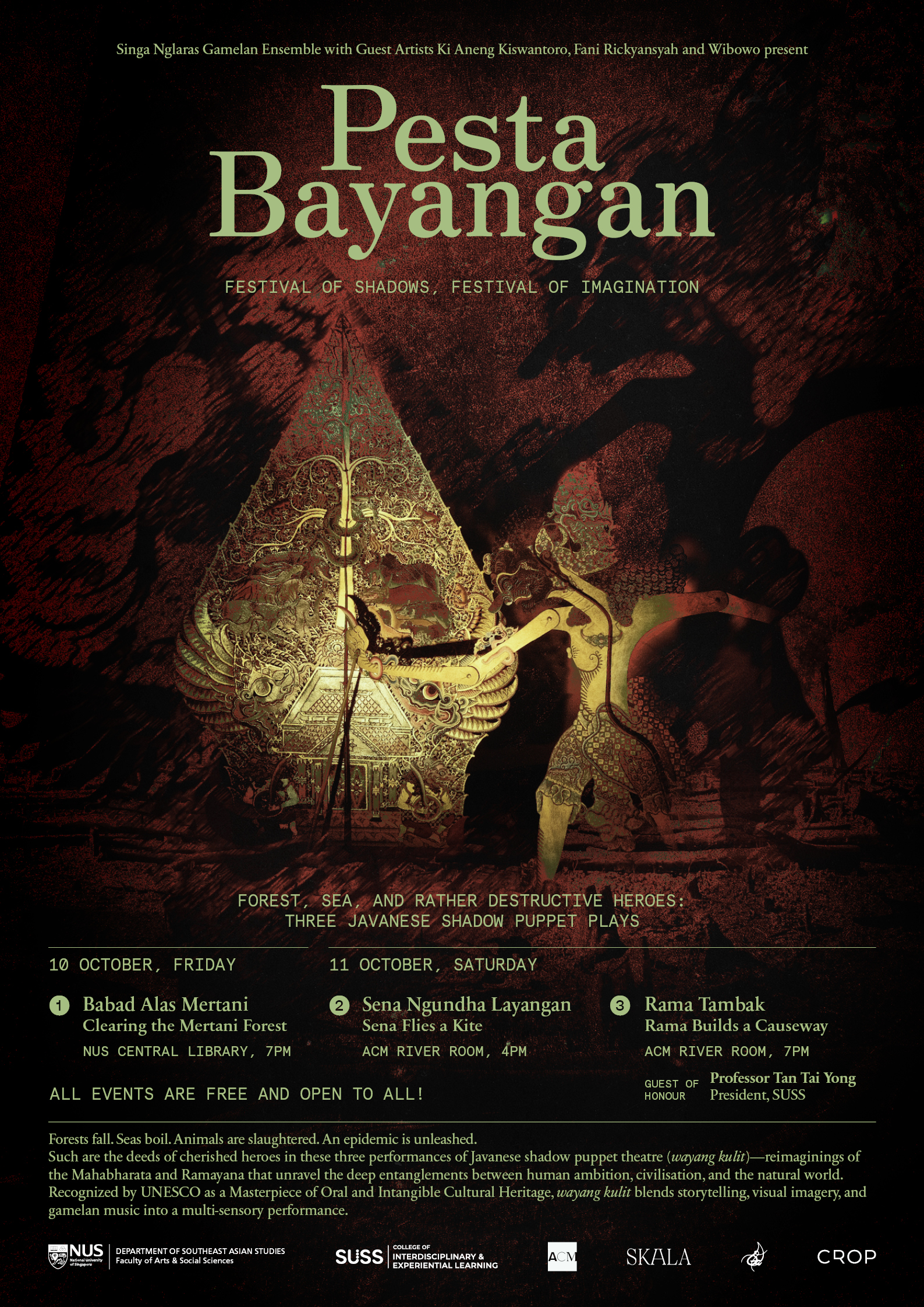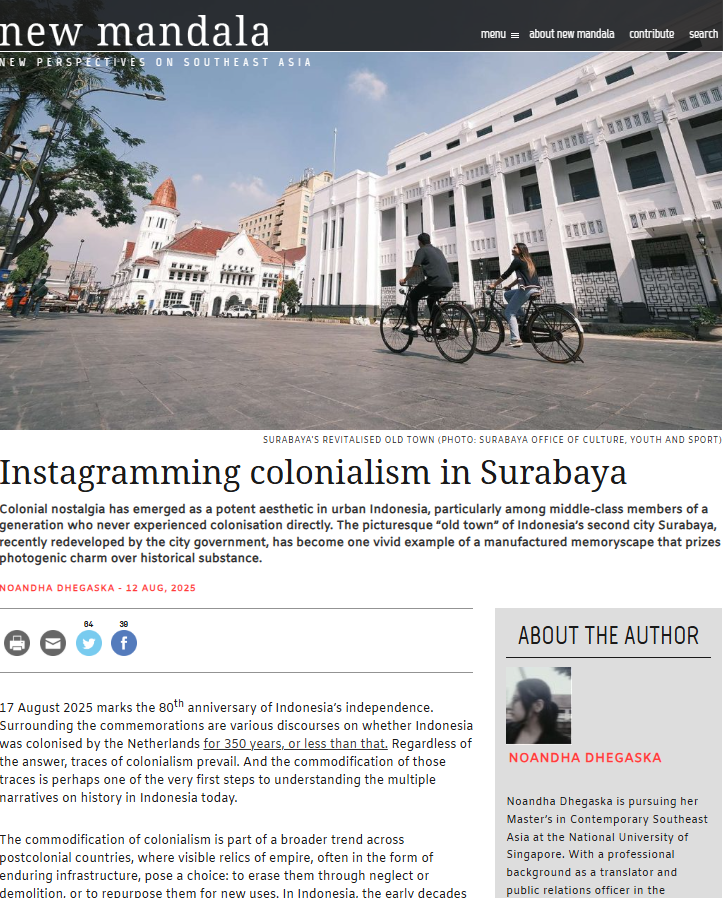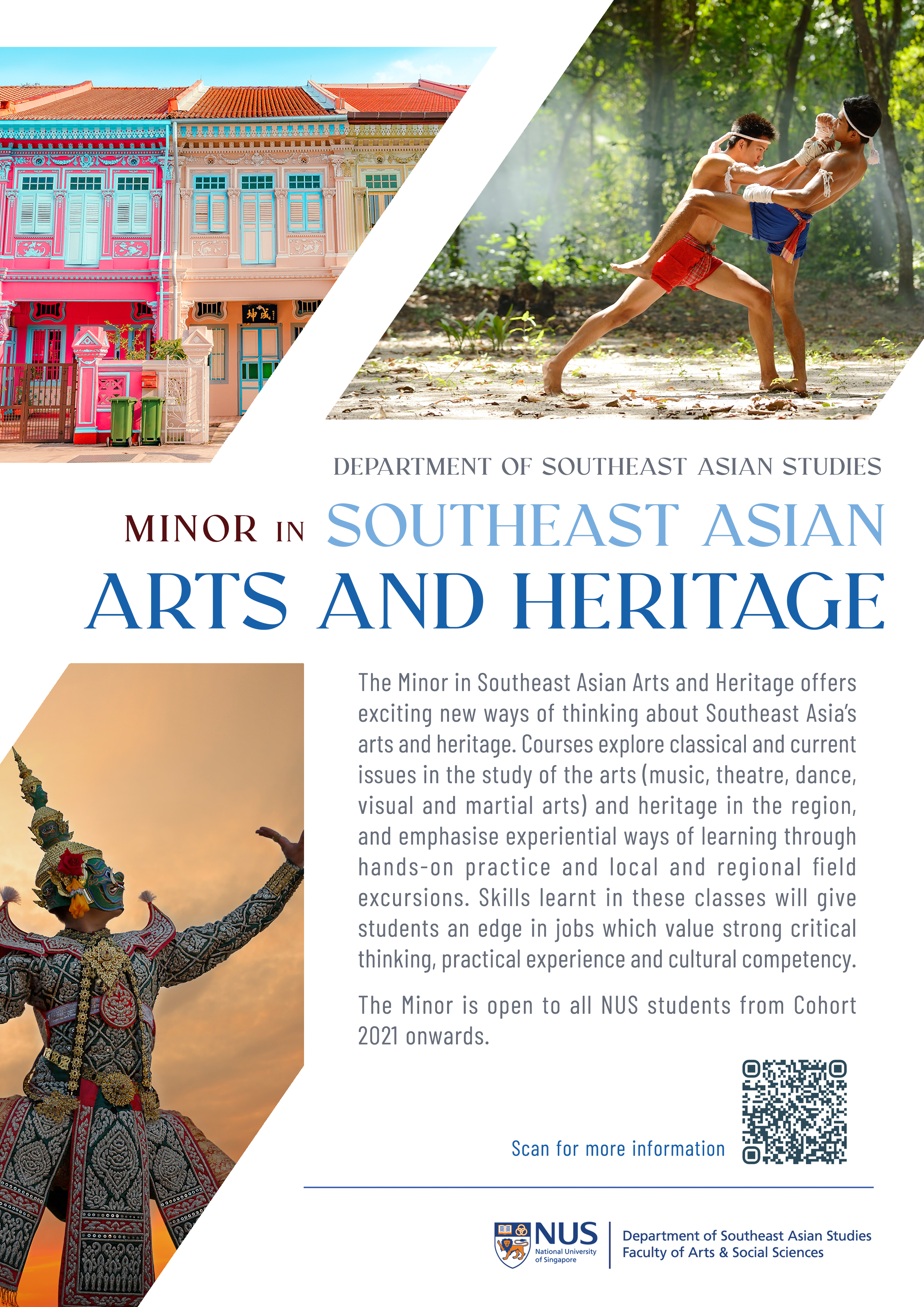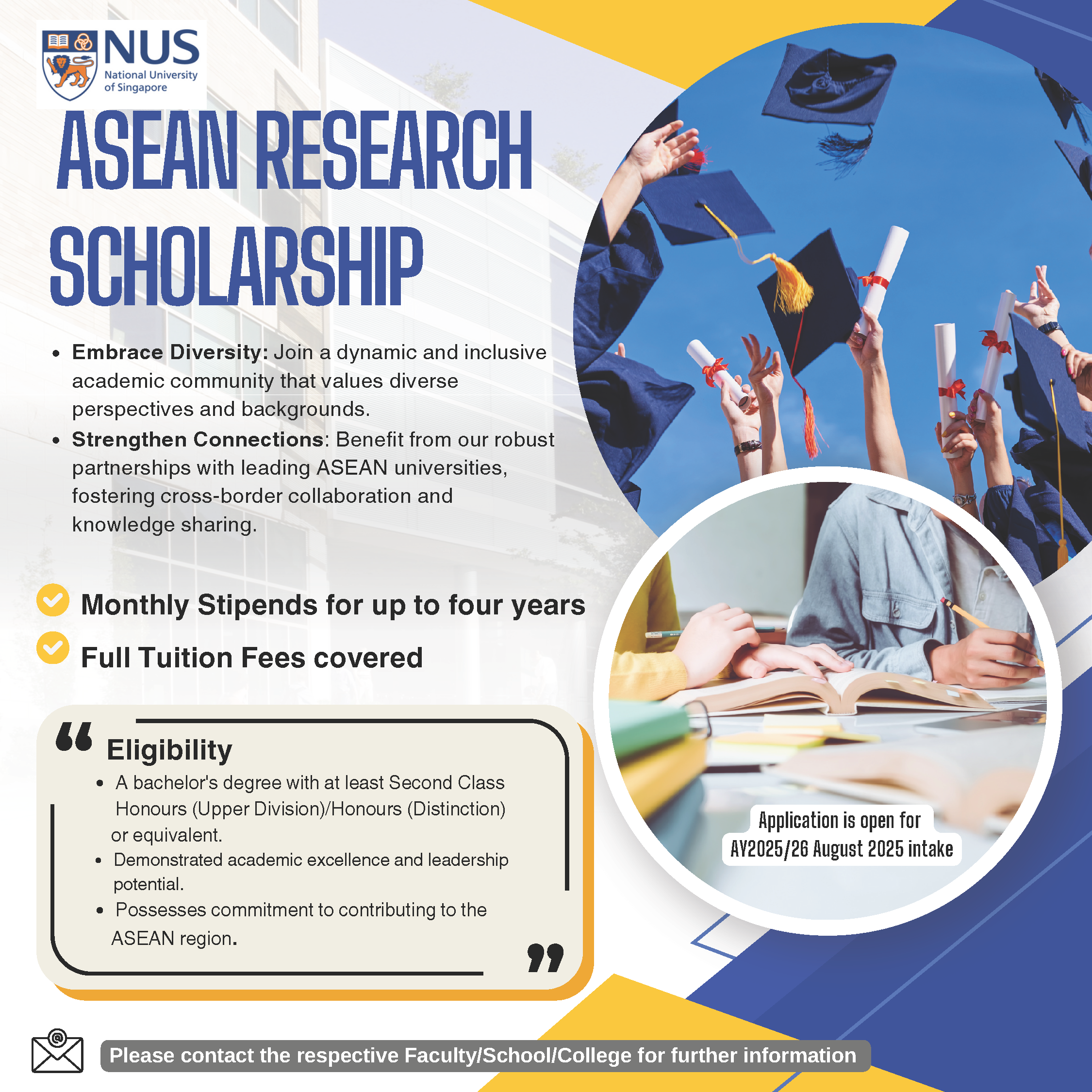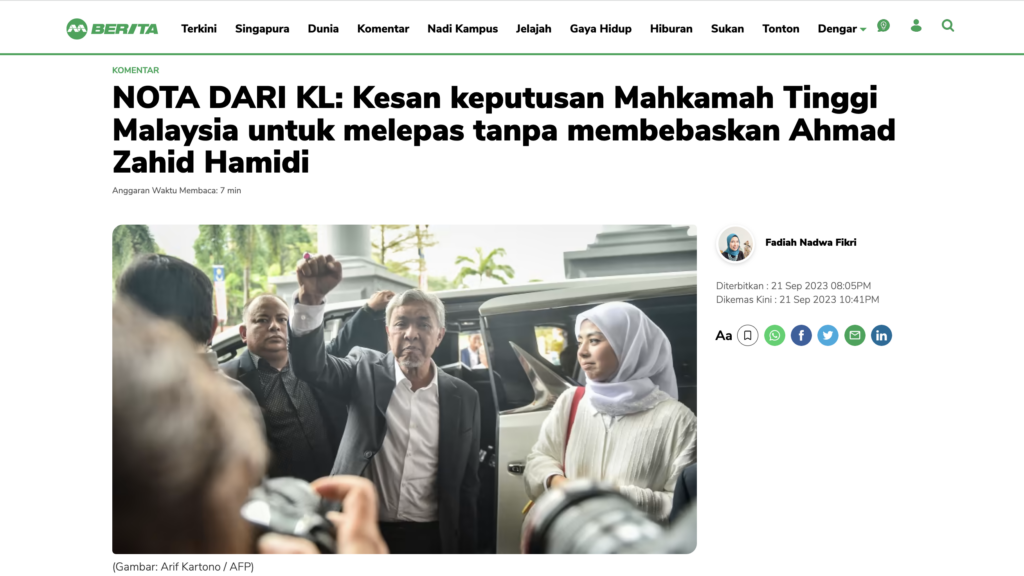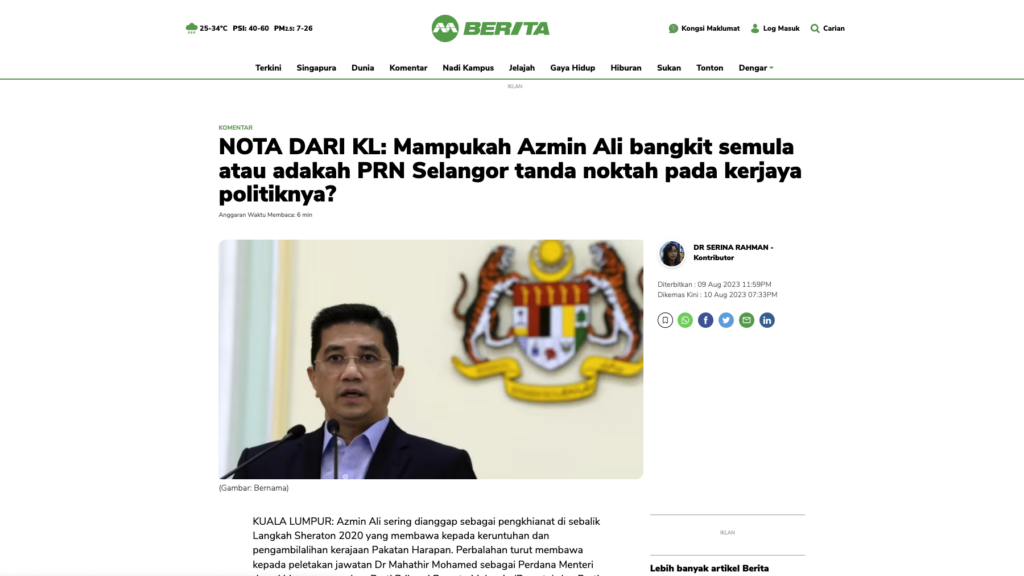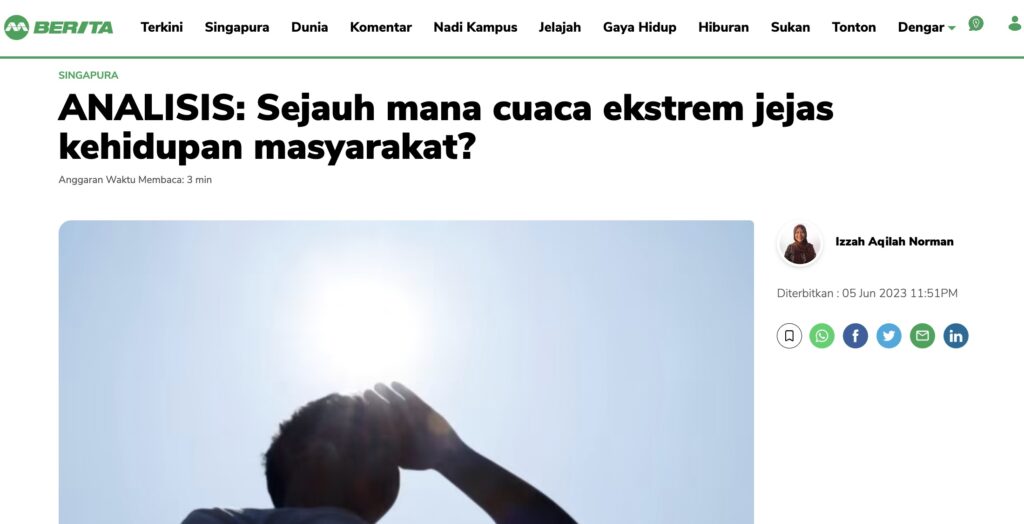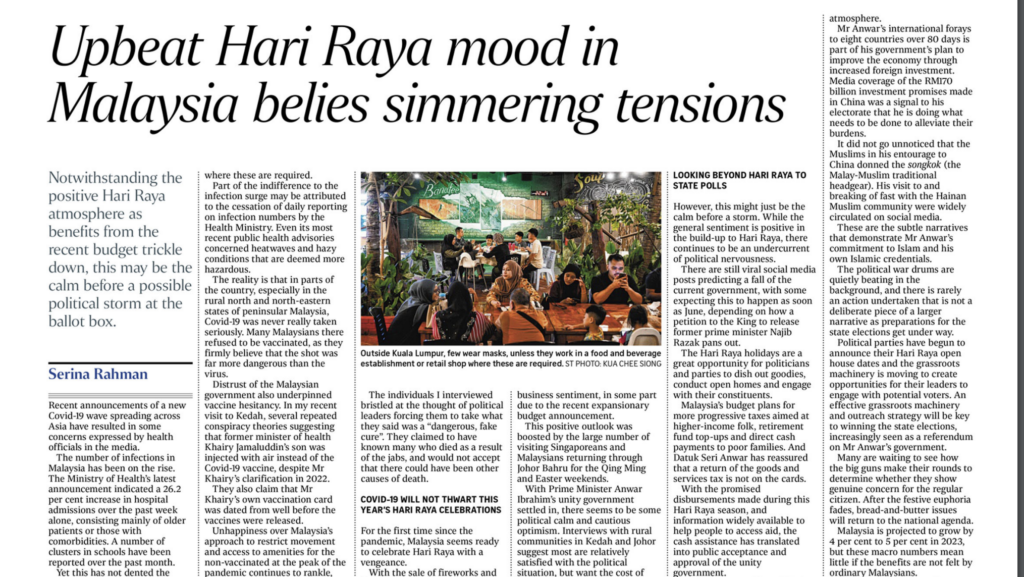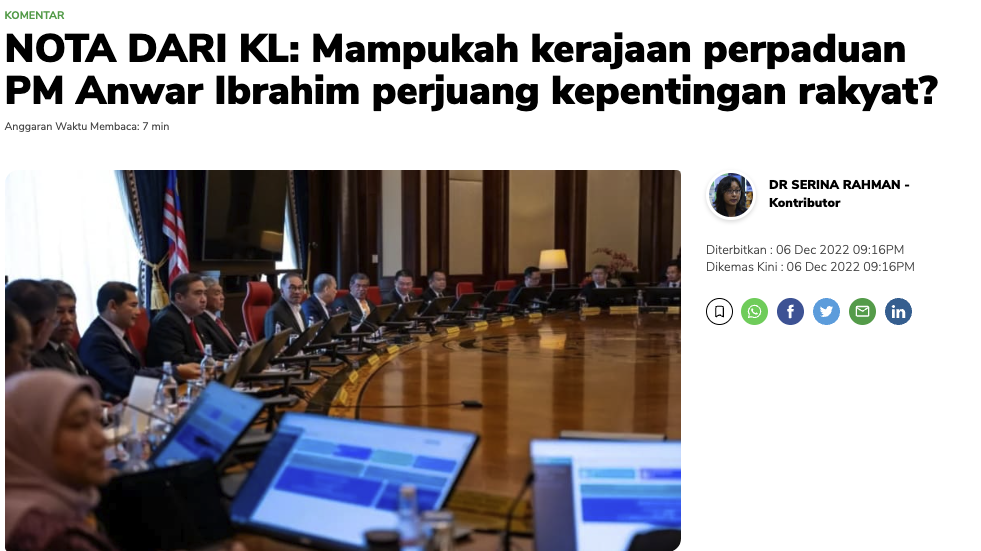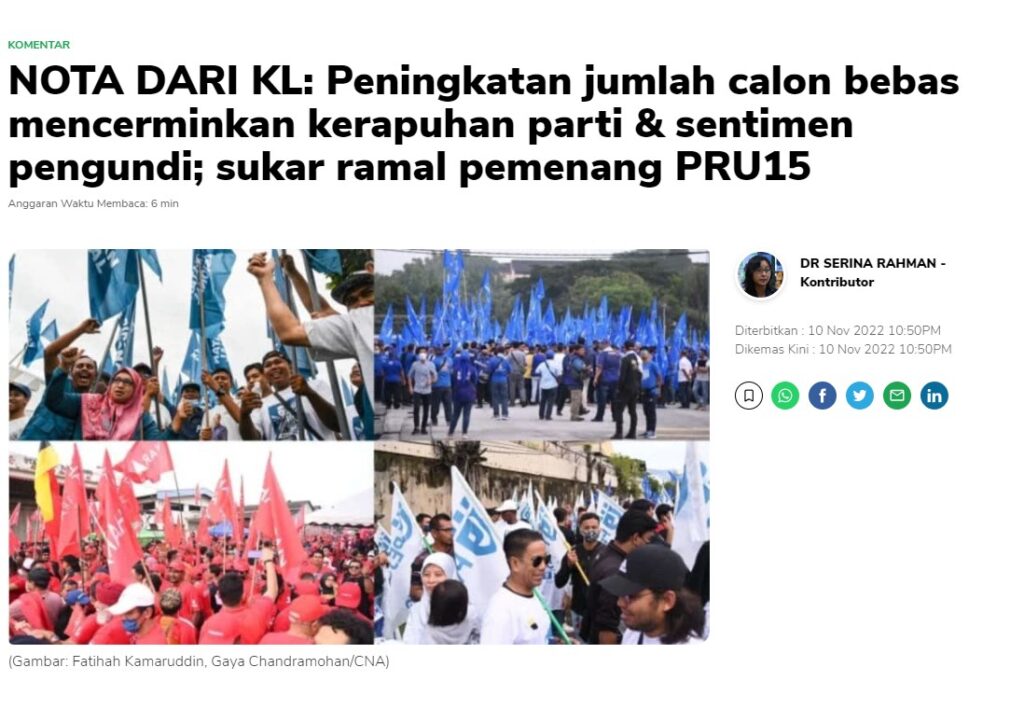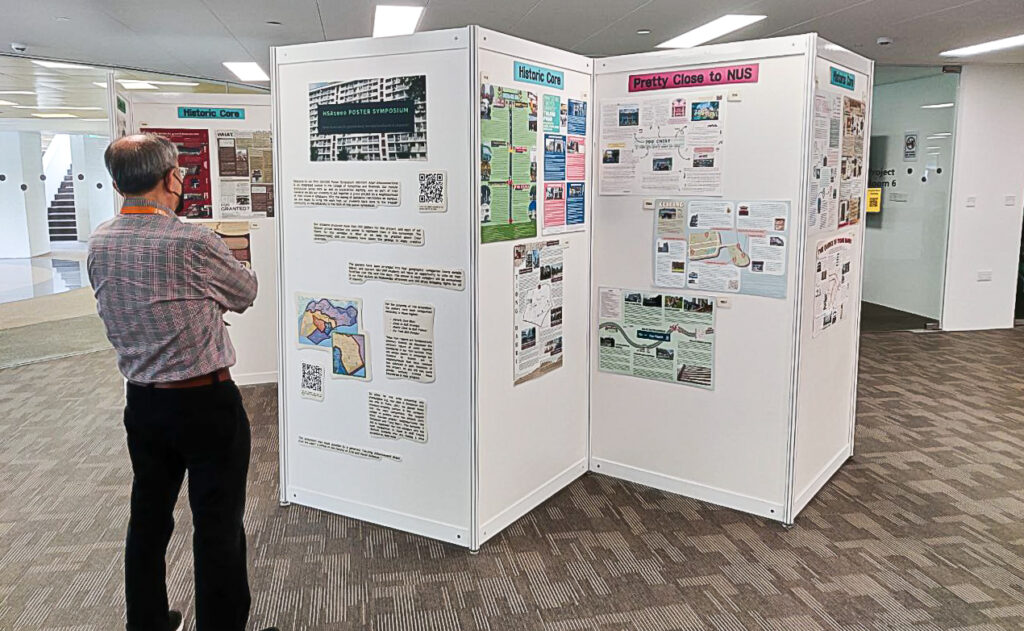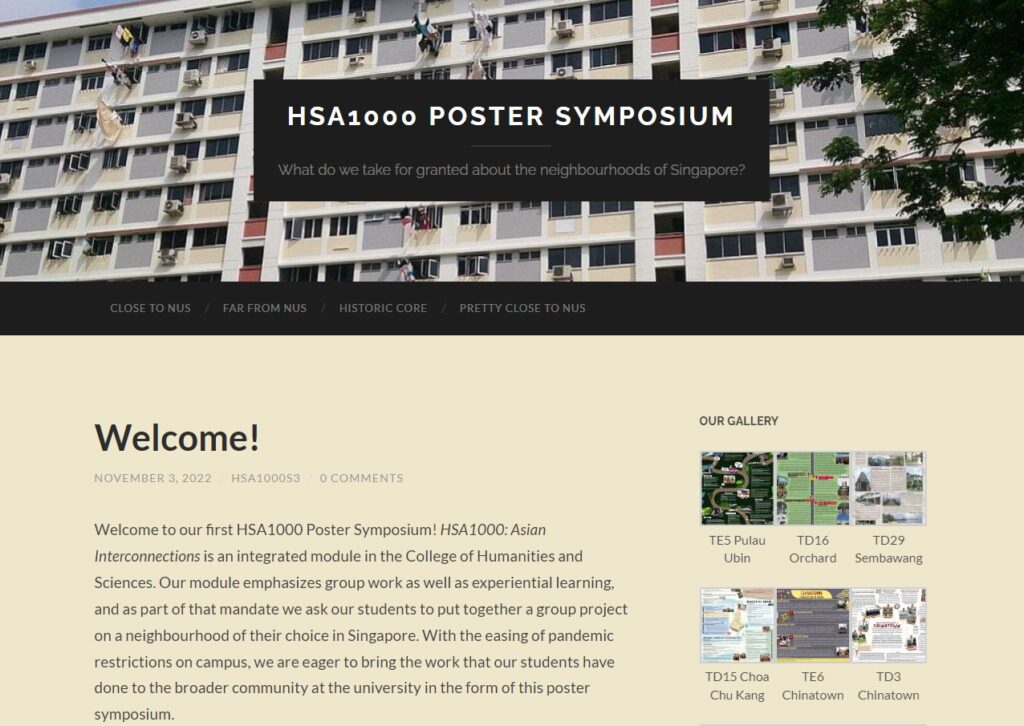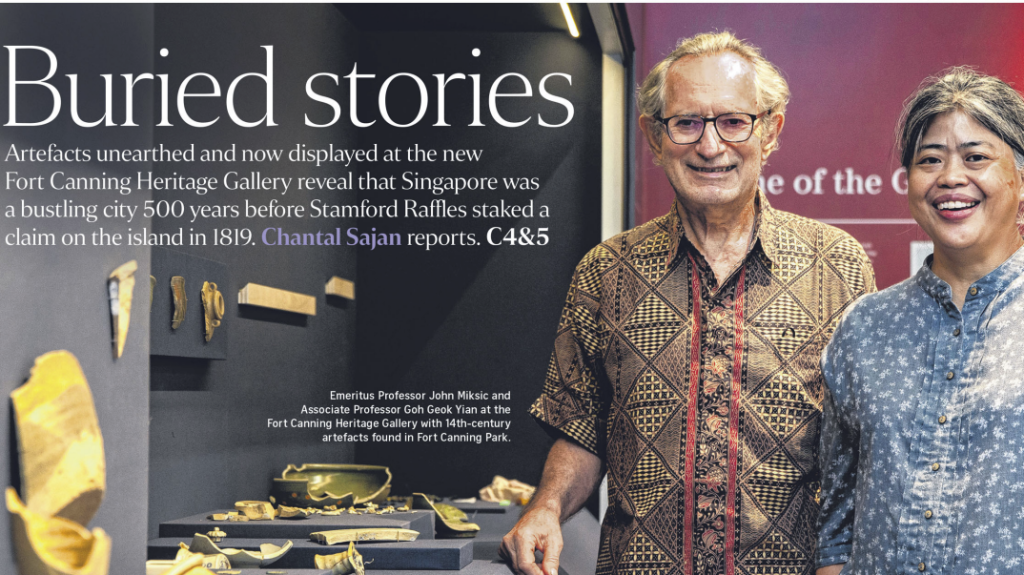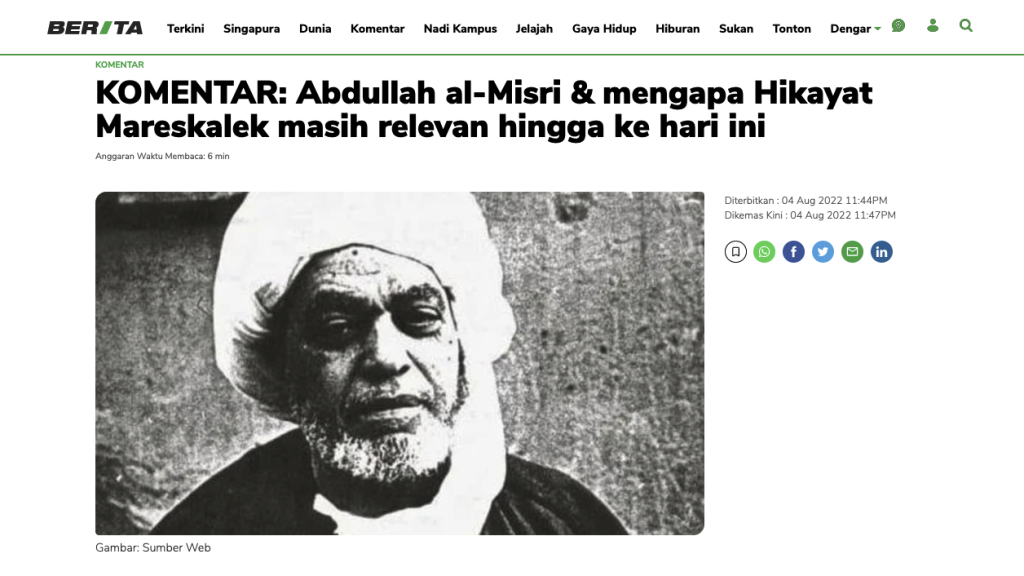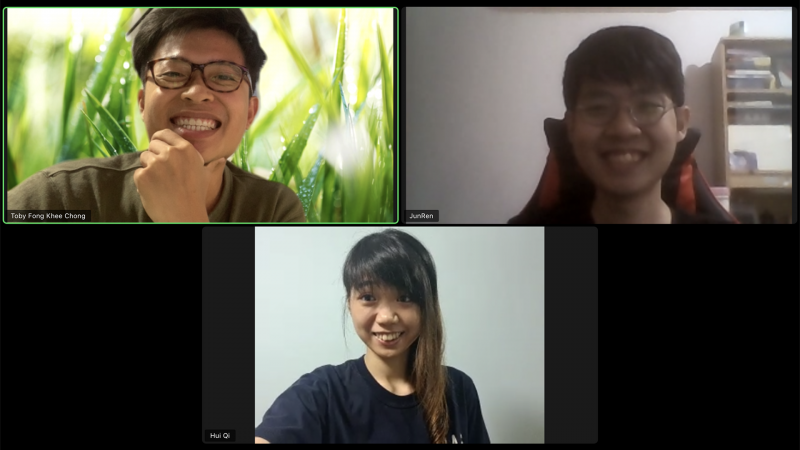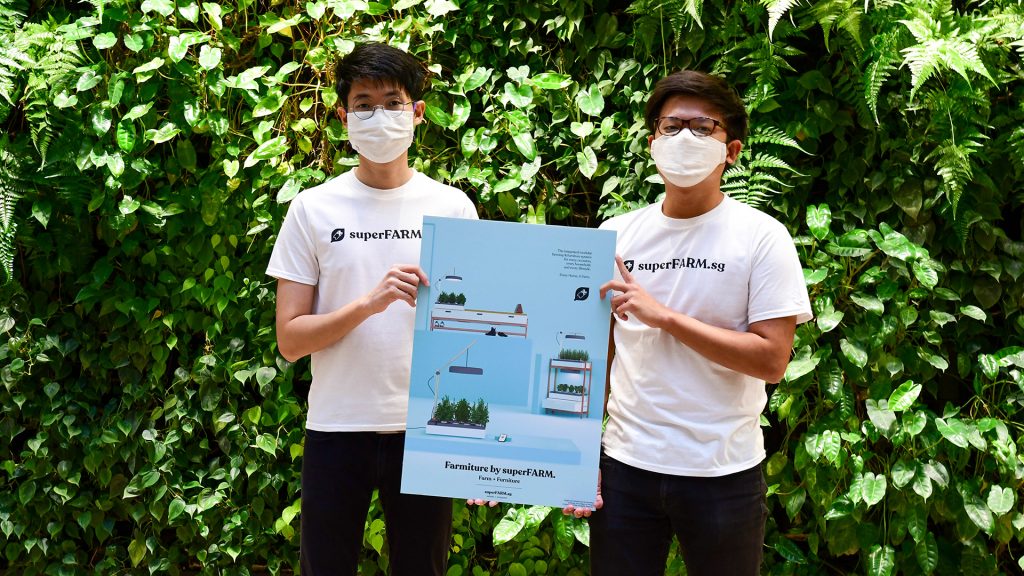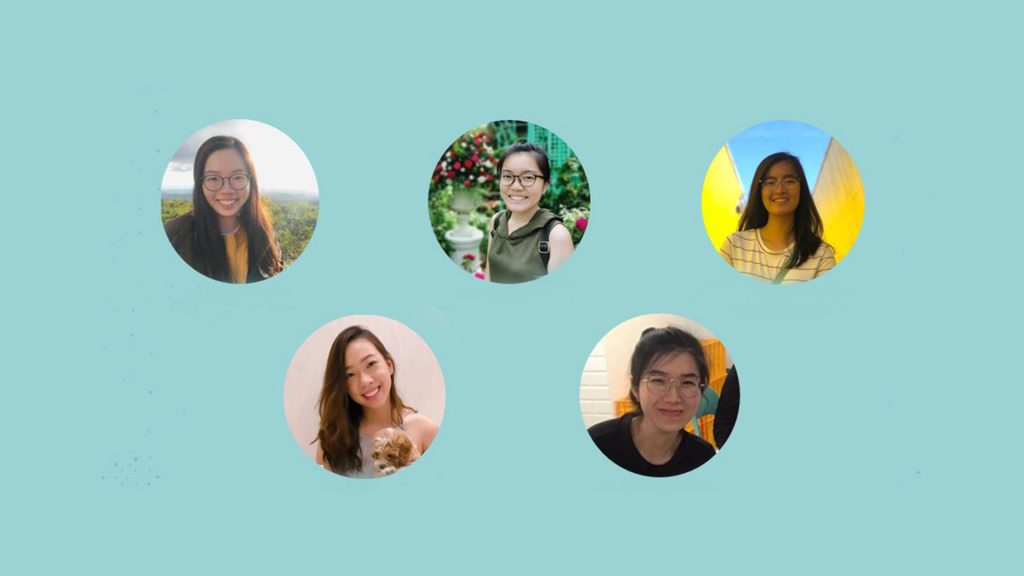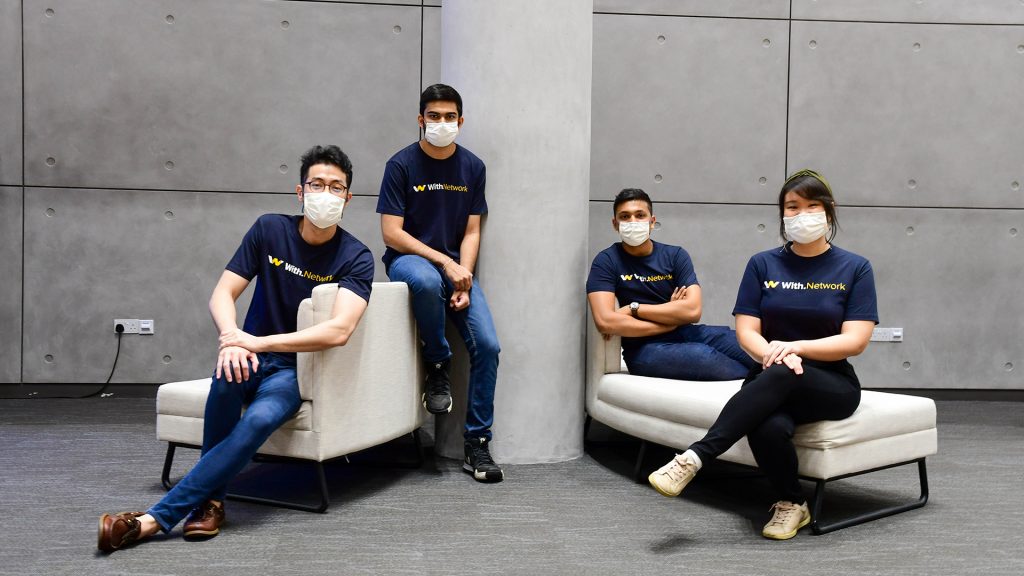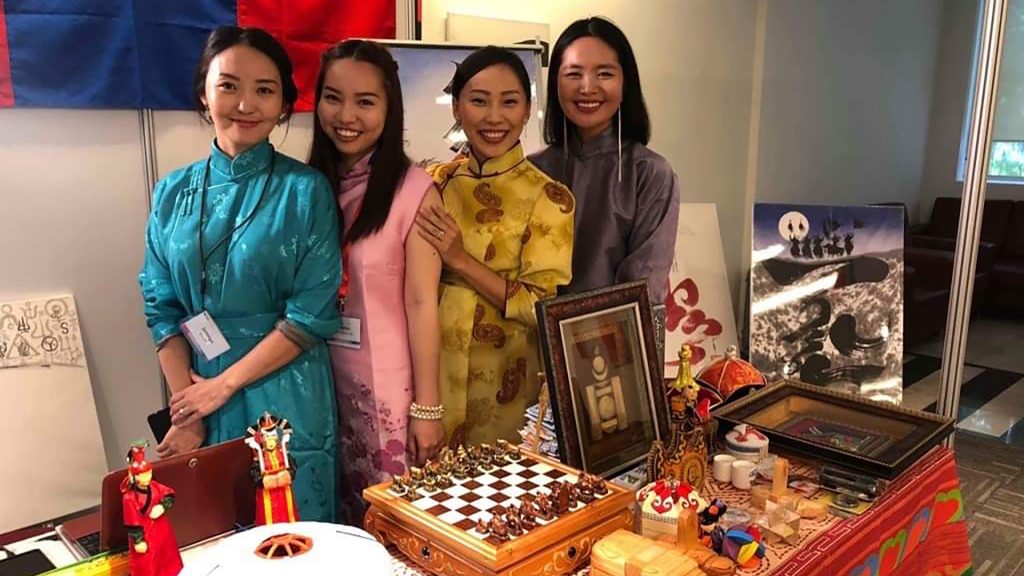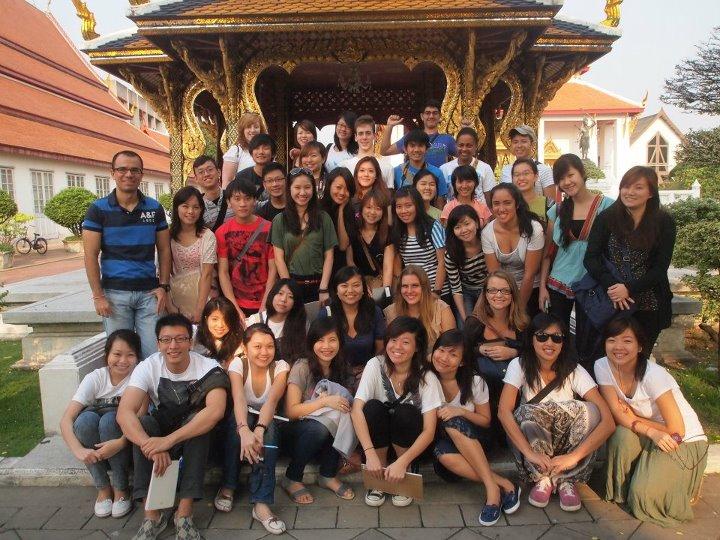News
To Singapore for the buzz. To Johor for vast skies, open seas
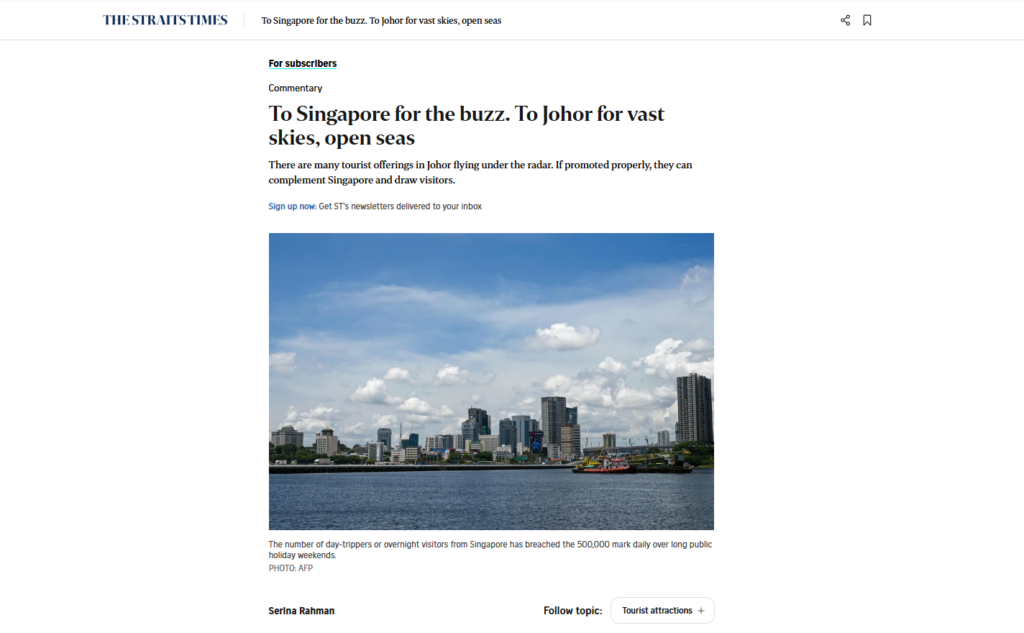 Discover a thoughtful reflection on the contrasting charms of Singapore and Johor, written by our lecturer Dr Serina Rahman. She shares personal insights on the buzz of city life versus the calm of open skies and wide-open spaces across the Causeway. A meaningful read for those curious about both places and the lives lived between them.
Discover a thoughtful reflection on the contrasting charms of Singapore and Johor, written by our lecturer Dr Serina Rahman. She shares personal insights on the buzz of city life versus the calm of open skies and wide-open spaces across the Causeway. A meaningful read for those curious about both places and the lives lived between them.This article is available to subscribers.
Celebrating Singapore Studies: Sixty Years of Nationhood | Looking Back, Moving Forward Video Series – Episode 5: Innovation at the Intersections
As part of our 'Celebrating Singapore Studies: Sixty Years of Nationhood' campaign for SG60, we present the 'Looking Back, Moving Forward' video series — inviting reflection on how Singapore’s past shapes its future. Through the work of NUS FASS researchers, the series uncovers the complexities behind the nation’s celebrated 'success story', bringing to light the inequalities, contradictions, and costs often overlooked. The fifth video, 'Innovation at the intersections', shows that studying Singapore helps us understand how innovation emerges at the intersections of technology, culture, and everyday life. Research by FASS faculty and students illustrates how AI, digital culture, public health, and youth sports are transforming urban life, with this video showing how technology and society are shaping Singapore today and tomorrow. Looking closely at Singapore today is, in this way, also a way of anticipating the Singapore we want to build for the next generation. Read more about the four publications featured in this episode on the Singapore Research Nexus (SRN) website using the link above each publication.
- Neyazi, T. A., Ng, S. W. T., Hobbs, M., & Yue, A. (2023). Understanding user interactions and perceptions of AI risk in Singapore. Big Data & Society, 10(2), 20539517231213823. https://tinyurl.com/yfmfn87t
- Yamin, J., & Mitchell, A. (2023). Excavating Amnesia: A Media Archaeology of Early Internet Art from Singapore. Southeast of Now: Directions in Contemporary and Modern Art in Asia, 7(2), 47–78. https://tinyurl.com/b2fdzjwn
- Chin, W. C. B., Feng, C.-C., Leong, C.-H., Pang, J., Clapham, H. E., Nara, A., Tsou, M.-H., & Wang, Y.-C. (2023). Integrating local and neighboring area influences into vulnerability modeling of infectious diseases in Singapore. International Journal of Applied Earth Observation and Geoinformation, 121, 103376.https://tinyurl.com/3f9nnnya
- Chan, Y. (2023). Skateboarding in Singapore: Youth, Masculinity and Urban Sports Culture. The International Journal of the History of Sport, 40(14), 1272–1286. https://tinyurl.com/2w2bup63
Archaeological Approaches and Possibilities in Humanities/Social Science Education in Singapore
In “Archaeological Approaches and Possibilities in Humanities/Social Science Education in Singapore” (Studies in Singapore Education: Research, Innovation & Practice, 2021), Professor John N. Miksic (NUS Southeast Asian Studies) and Associate Professor Geok Yian Goh (NTU) capture the essence of their life’s work — that archaeology is, above all, a deeply educational pursuit. In this essay, they distil four decades of teaching, fieldwork, and institution-building into a coherent philosophy: that material culture can anchor abstract thought, and that the study of the past is most meaningful when it engages learners directly in the process of discovery. Miksic and Goh open with a concise history of Singaporean archaeology — a field that, until Miksic’s arrival in the 1980s, did not quite exist. His 1984 Fort Canning excavation marked the beginning of a new intellectual tradition, one that connected the study of history with physical evidence and collective participation. Yet Miksic’s intent was never limited to uncovering artifacts; he envisioned archaeology as a bridge between the humanities and the lived environment. By involving students, teachers, and even families in excavations, he turned archaeology into a communal form of inquiry, where learning emerged not from textbooks but from application. At the core of the chapter lies Miksic and Goh’s argument for object-based learning. They posit that tangible artifacts serve as entry points for abstract reasoning — evidence that invites students to hypothesize, interpret, and reconstruct narratives from fragments. In this way, archaeology mirrors the broader goals of the humanities: to question, to infer, and to connect. These reflections anticipate contemporary calls for interdisciplinary education, showing how archaeological practice fosters not only historical understanding but also critical and empathetic thinking. The essay’s most distinctive contribution is its articulation of experiential learning as the foundation of archaeological pedagogy. Citing the seminal work of John Dewey and David Kolb, Miksic and Goh describe fieldwork as a “total visceral immersion” that engages all the senses — sight, touch, and intuition. Fieldtrips, they argue, should not be scripted performances but open-ended explorations that nurture intellectual curiosity. Whether in simulated excavations or overseas field schools, students learn not only to handle artifacts but to handle uncertainty — to think critically amid ambiguity. In later sections, Miksic and Goh illustrate how this philosophy translated into concrete teaching practice. At both NUS and NTU, archaeology became a mode of learning that crossed disciplinary boundaries — linking history, geography, and anthropology. One of the most vivid examples was the Southeast Asia in Context (SEAiC) summer programme, which Miksic founded and taught for over a decade. Designed for both local and international students, SEAiC combined classroom study with fieldwork across Southeast Asia — from Singapore to Malaysia, Thailand, and Indonesia — enabling participants to experience heritage sites firsthand and engage directly with local communities. In doing so, it embodied Miksic’s conviction that education is most powerful when students encounter history in situ, tracing the continuities between ancient networks and modern societies. The chapter concludes with a forward-looking vision. Anticipating the challenges of the digital era, Miksic and Goh advocate integrating technology, heritage policy, and continuing education, yet caution that digital tools must never replace the immediacy of fieldwork. Knowledge, they remind readers, begins with touch. Viewed in retrospect, the chapter stands as both a scholarly milestone and a legacy of thought. It encapsulates Miksic’s defining synthesis of precision and humanity. For him, archaeology was less a science of relics than a practice of connection — linking evidence with imagination, past with present, student with teacher. Miksic’s influence endures in how Singapore and the region conceive of history: not as buried and gone, but as a living presence just beneath our feet. Read the chapter here.
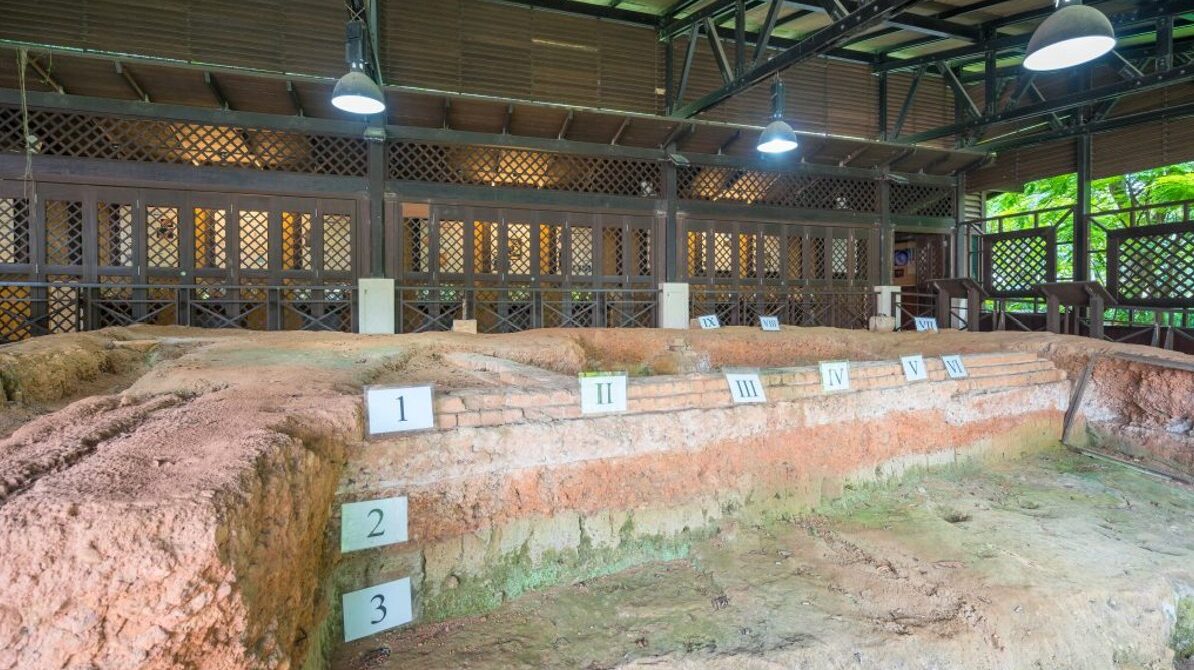
In Memoriam: Emeritus Professor John Miksic

Emeritus Professor John Norman Miksic, a distinguished scholar at NUS Southeast Asian Studies and Senior Research Fellow at Nanyang Technological University, passed away on 25 October 2025 at the age of 79.
Professor Miksic first came to Singapore in 1968 while serving in the Peace Corps in Kedah, Malaysia, and went on to spend most of his life in Southeast Asia. After earning his PhD from Cornell University's Department of Anthropology in 1979, he worked for USAID as a Rural Development Advisor in Bengkulu, Indonesia, for two years, and taught at Gadjah Mada University, Yogyakarta, for six years. In 1987, he moved to Singapore, where he joined the National University of Singapore's Department of History (NUS History) and played a key role in establishing the Southeast Asian Studies Programme in 1991.
Prof. Miksic was the first head of the Nalanda-Sriwijaya Centre, the ISEAS-Yusof Ishak Institute's Archaeological Unit, between 2010-2013 and was a member of the Board of the Center for Khmer Studies in Siem Reap, Cambodia, for 15 years. He also held the position of Deputy Chairperson of the National Heritage Board's Archaeological Advisory Panel. In 2023, he was awarded the Public Service Medal by the Government of Singapore for his contributions to the nation.
Prof. Miksic was a towering figure in the field of archaeology in Southeast Asia. His extensive fieldwork spanned the region and included major excavations, including such world-renowned sites at Borobudur in Indonesia and Angkor in Cambodia, as well as more than a dozen sites in Singapore, including St. Andrew's Cathedral, Empress Place, Parliament House and Padang. He is renowned for leading the first systematic excavation at Fort Canning Hill in 1984, which uncovered compelling evidence of Singapore's significance as an early major regional port before 1819. His discoveries profoundly reshaped the understanding of Singapore's pre-colonial history and prompted revision to the national secondary school history curriculum. Prof. Miksic was the winner of the inaugural Singapore History Prize awarded in 2018 for his book Singapore and the Silk Road of the Sea, 1300-1800 (NUS Press, 2013).
At NUS Southeast Asian Studies, his courses on archaeology, art, history and cultural resource management, as well as his supervision of undergraduate and postgraduate research, educated generations of historians and archaeologists and inspired many students to take up the study of ancient Southeast Asia. He was a beloved teacher, admired for his generosity, kindness and vast knowledge. He will be deeply missed by his students and colleagues.
Prof. Miksic is survived by his wife, Dr Goh Geok Yian, his two children from his first marriage, Mr Ezra Miksic and Ms. Vonya Miksic Eisinger, and four grandchildren.
By Associate Professor Vatthana Pholsena, Head of NUS Southeast Asian Studies.
“A Tale of Two Quakes: Politics of Foreign Assistance in Nepal and Myanmar” by Su Mon Thazin Aung and Zhao Yiran
Heads up: disaster aid isn't always "just humanitarian." In "A Tale of Two Quakes," Su Mon Thazin Aung and Zhao Yiran draw a stark contrast between the world's rollout of support after Nepal's 2015 earthquake and how Myanmar's 2025 quake barely made ripples in international aid. Spoiler: it's not because Myanmar didn't need help - it's politics, perception, and power. Regime legitimacy, geopolitics, and how "worthy" a country appears all tilt the scale in who gets rescued first. 💡 Read more to see how humanitarian aid can be deeply political. Click the article to dive deeper.
Su Mon Thazin Aung is a Visiting Fellow with the Myanmar Studies Programme at ISEAS - Yusof Ishak Institute. She is also an Adjunct Assistant Professor at the Department of Southeast Asian Studies, National University of Singapore.
Zhao Yiran, is a graduate student in the Contemporary Southeast Asian Studies programme at the National University of Singapore and currently studying is a PhD student in the School of International Relations, Xiamen University.
Indonesia’s heritage in flames by Noansha Dhegaska
Noandha Dhegaska, a current MA student in Contemporary Southeast Asia at the National University of Singapore, has published an article in New Mandala titled "Indonesia's heritage in flames" (19 September 2025). Reflecting on the destruction of Dutch-built government buildings during the August 2025 protests, her piece highlights how these structures, long re-signified by Indonesians as part of their postcolonial identity, represented both a tangible inheritance and a uniquely national heritage.
Click on the image to read the article
Rachel and the Dream of a Kinder World
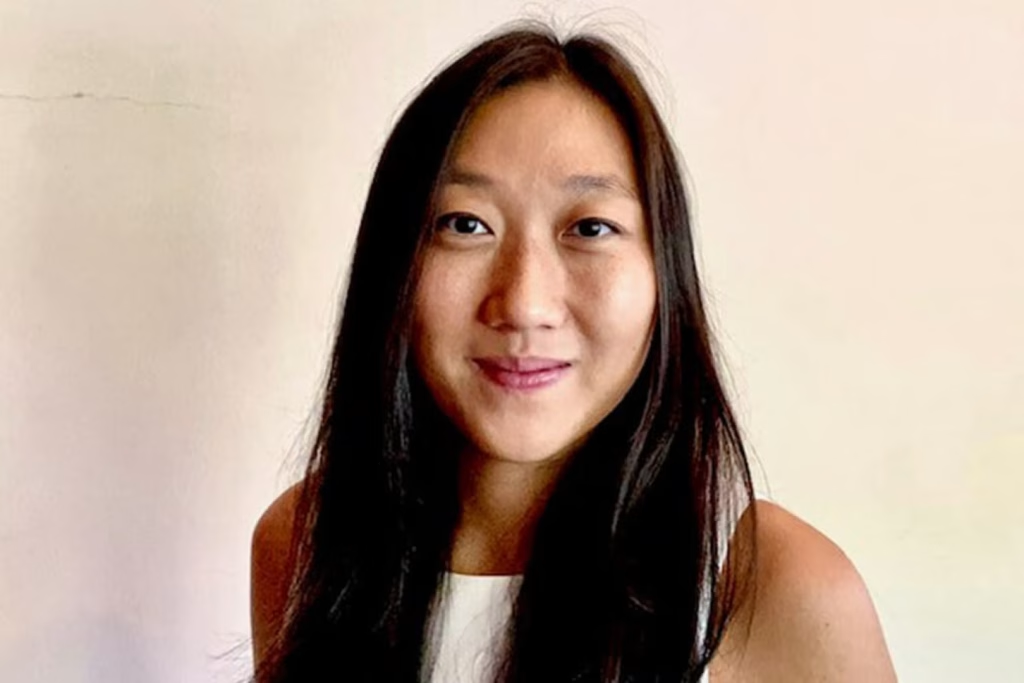
When Ms Rachel Nadia Goh (NUS Southeast Asian Studies '14) speaks about her work, there is no saviour complex. No over-polished pitch. Just clarity, conviction and the kind of quiet fire that comes from years of bearing witness to the human cost of crisis. A humanitarian and development professional, Rachel has spent the last decade working across disaster zones, refugee settlements and conflict-affected regions with leading international NGOs. Along the way, she has listened to stories of unimaginable hardship, often shared in moments of radical vulnerability. In 2019, she founded Kin Collective, a social enterprise that transforms these lived realities into illustrated children's books designed to spark empathy and reflection among readers of all ages. "I always get questions like, 'Why do you choose to do this kind of work?' Honestly, I don't know. Why not? It's as simple as that," she said. "I just care."

It is an instinct that has defined her path since childhood. At 14, she volunteered at an orphanage in Thailand, a formative experience that left her brimming with questions. Why do bad things happen to good people? Why is it always the poor who suffer most? A mentor posed a challenge: "If you knew the answer, would it change what you choose to do?" Her answer was no. That question - and her response - have stayed with her ever since.
Rachel's academic path reflects her deep interest in the region. At the National University of Singapore (NUS), she majored in Southeast Asian studies, motivated by a desire to work directly with local communities and better understand the region's cultures and complexities. "That degree gave me the language, context and grounding I needed," she said. She credits her time at NUS as foundational, particularly the guidance of mentors like Professor TC Chang (Arts & Social Sciences '90, MA '94) and Dr George Radics (Arts & Social Sciences PhD '09). A poster on campus for a human rights programme in Geneva would later lead to a life-changing opportunity, a turning point that opened doors to a life of humanitarian service.

Today, Kin Collective has published four illustrated titles, all supported by the National Library Board and stocked in libraries across Singapore. The stories draw from Rachel's field experiences in some of the most complex corners of the world. Think Gaza, Ethiopia, Afghanistan. But rather than spotlighting trauma, her books elevate stories of courage, connection and hope. "I've had so many conversations over coffee, sharing these stories with friends. And they'd say, 'I wish my kids could hear this' or 'I wish more people knew'. But you can't have coffee with everyone. So we started writing."
Tripina Finds Fresh Water, Kin Collective's debut title, was inspired by the story of a mother and her children who were forced to fetch gallons of water from a neighbouring village each night, under the cover of darkness. "Water was such a precious resource that if they went in the day, they risked being chased away or attacked," explained Rachel.
The journey was perilous. The woman described how, at night, she could hear hyenas and had to weigh whether it was safe to go or better to stay home and endure a day without water. When a new water point was eventually built within her village, the trek dropped to just 20 minutes. Still a long walk, but a transformative one. "She could then go in the day and make multiple trips on her own. She said that this meant she could now send her kids to school. Now they can chase their dreams," said Rachel. "So for some communities, when we say water is life, water truly is life."All of Kin Collective's books are self-published to preserve the integrity of the stories. "These are real stories of real people," she shared. "We don't want them to be altered or pressured into being edited to take a different angle."
 Building Peace, One Tale at a Time
Building Peace, One Tale at a TimeKin Collective's most recent title, Sara, Hana and Their Three Wishes, is a gentle fable inspired by the experiences of children growing up in conflict zones. This September, it will be adapted into a theatrical production to mark World Peace Day. "Every year on World Peace Day, nothing much actually happens," said Rachel, half-laughing. "There's this ceremonial bell that gets rung at the United Nations, and that's about it. But what does that do for children? For families? We wanted to create something that stirs conversation. Something immersive. Something that persists."
The play, like the book, is deliberately non-specific in setting and ethnicity. You can't tell where the characters are from, or what cultures they represent. "We didn't want people to focus on identity or geography," she explained. "This is about shared humanity." It's also about the power of choice. "We wanted to show that even in conflict, the possibility of choosing peace, of choosing friendship and love, still exists," she said. "That's what we hope for readers and viewers to reflect on."
Storytelling, to Rachel, is ultimately about planting possibility. "Creative storytelling can ignite conversations, memories and imagination," she said. "If we allow our narratives to be dominated by the worst of what's happening in the world, we're not really doing our part."
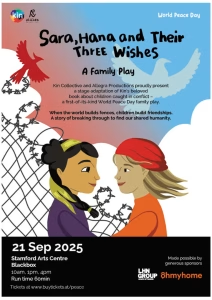 The team behind Kin Collective is small and mostly made up of volunteers. Yet somehow, the books get made, thanks to a mix of tenacity, serendipity and shared belief. One of her illustrators, for instance, is an artist Rachel found online by chance-someone touched by her own experiences of conflict who shares the same values. "When I told her about the project, she immediately said yes. It was such a serendipitous connection."
The team behind Kin Collective is small and mostly made up of volunteers. Yet somehow, the books get made, thanks to a mix of tenacity, serendipity and shared belief. One of her illustrators, for instance, is an artist Rachel found online by chance-someone touched by her own experiences of conflict who shares the same values. "When I told her about the project, she immediately said yes. It was such a serendipitous connection."
So what's next? "People keep asking for more stories. And we do have more to tell. But right now, the focus is on the Peace Day play," she said. "This is the first time we're doing something like this. I don't see why it should be the last." Her message for young changemakers is this: Take action. Don't wait. "Be courageous. Be kind. You have to be both. These times ask for it. They demand it."
Sara, Hana and Their Three Wishes will be brought to life on stage this September in a special theatrical production for World Peace Day. Get your tickets at wearekinco.com/tickets.
This story by Genevieve Jiang first appeared on AlumNUS on 7 August 2025.
Instagramming Colonialism in Surabaya by Noandha Dhegaska
Noandha Dhegaska, currently pursuing her MA in Contemporary Southeast Asia at the National University of Singapore, has contributed an insightful piece to New Mandala titled "Instagramming colonialism in Surabaya" (12 August 2025). In this timely analysis, she examines the revival of Surabaya's colonial-era "Old Town" as a staged, photogenic heritage site highlighting how its aesthetic revitalisation caters to social media culture while potentially glossing over the deeper, more challenging histories of colonialism.
Click on the image to read the article
“Huh, Southeast Asian Studies? Have ah?” – Meet Our 2025 Valedictorian Ning Poh
Valedictorian Spotlight: Ms Ning Poh, Class of 2025
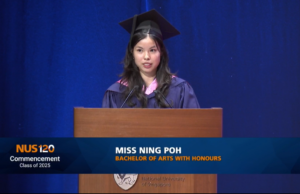
That's the question Ning Poh, our Class of 2025 Valedictorian, has fielded more times than she can count. But if there's one thing Ning's journey shows us, it's that following your passion (no matter how niche it seems) is always worth it. Proudly representing one of the smallest cohorts on campus, Ning speaks to the joy of learning in an intimate, curious, and creative community. From painting temple murals in Bangkok to embracing interdisciplinary fieldwork, her story is proof that Southeast Asian Studies is more than just a major. It's an experience. Here's an excerpt from Ning's valedictory speech that had us nodding, laughing, and getting all the feels:
Congratulations once again, Ning! 💛 Your bold spirit and big heart for Southeast Asia inspire us all."Huh Southeast Asian Studies? Have ah? Why you take? These are questions that my fellow majors and I have faced throughout the years... We are a tiny cohort - numbering less than what you can count with one hand - but I like to think we are proud of being the few oddballs who have enrolled in a relatively unknown major. More importantly, we are committed to pursuing what we love and enjoy - where despite having a small cohort and small classes, we do have a big, big heart for the region. Some of us remember mischievously flaunting that while others had more conventional final examinations, we were lucky to experience unique assignments such as submitting our very own painting - a result of our experience studying temple murals during a fieldtrip to Bangkok. I would like to give a shout out to Professor Irving Chan Johnson for his class on Thai Drawing and Painting, an experience that even my friends in art school are envious of. It is a privilege to learn and grow with a community that is so committed to interdisciplinary and experiential learning. With that, I want to thank all the professors in our department for nurturing us to be bold, critical, and creative, as well as my family and friends for their unwavering support throughout my time at NUS. From overseas field trips to gallery visits, the experience of engaging with the region's arts and culture as a core part of my university education is one that I will never forget."
The art of academics: NUS graduates on pursuing their artistic passions

Pursuing the arts is more than a pastime. As three NUS graduates from the Class of 2025 can attest, it's a way of making sense of the world through media like theatre, fiction and poetry. Better yet, it has also enriched their time at NUS.

Jade Ow: Singapore's trailblazing deaf actress
As a teenager, Jade Ow was always told that her voice was not "standard or conventional" enough for theatre. Born with moderate-severe deafness, she turned instead to visual arts, literature, and dance as outlets of expression.
But Jade still longed to break into theatre. In 2021, she decided to take a leap of faith and enrolled in Theatre Studies at the NUS Faculty of Arts and Social Sciences, with a minor in Chinese Translation.
"I had a really difficult time convincing people at first that I could go into theatre," admitted the 23-year-old. Her family was also worried about the financial viability of theatre as a career.
Thankfully, she found a "support crew" at NUS. "Teachers came together to really help me with my journey, and I'm very grateful for them," she shared. For instance, Dr Noorlinah Mohamed, who taught the course Voice Studies and Production, guided her through intensive voice and speech training in her second year.

The Student Accessibility Unit also equipped her with assistive speech-to-text technologies, helping her fill in the gaps when she lip-read during conversations and classes. They even connected her with theatre professionals, including director and disability arts advocate Peter Sau, who is currently her mentor in ART:DIS Singapore, a non-profit that advocates for opportunities for persons with disabilities within the arts scene. These experiences honed her craft and expanded her industry network.
By 2023, Jade had found not only her voice, but also her calling. Today, she has carved a niche for herself as one of Singapore's few deaf actresses.

"Every chance to put myself out there is one step closer to where I want to be… It's not really about achieving an Oscar or a 金马奖 (Golden Horse Award)," she said. "To me, the highest level of artistry is getting to that level where I feel satisfaction when I am performing."
Her biggest role to date is her breakthrough autobiographical performance in Through The Looking Glass, directed by Claire Teo, and performed as part of the Light to Night Festival in conjunction with Singapore Art Week 2025. She credits NUS for providing a rare confluence of cultural diversity, academic freedom, and advocacy platforms. "I don't think I could have gotten such a journey anywhere else in the world," she noted.

Her family has since thrown their support behind her career choice. Post-graduation, she continues her journey as a theatre professional, while working with arts entities such as the National Gallery Singapore and the Singapore Drama Educators Association to promote disability arts in the region.
She also wishes to inspire other disabled artists. "I'm hoping to visit more special education schools, share my experience as an artist and disability advocate, and encourage students to see the arts as a path they can take too," she said.
Ng Ziqin: Blending law with a love for writing
Ng Ziqin's passion for the literary arts began before her NUS days. She started writing novels in secondary school, completing a coming-of-age novel, Every School a Good School, just before entering university. The book was a 2022 Epigram Books Fiction Prize finalist.
During her four years at NUS Law, Ziqin led University Court Friends, a pro bono project under the faculty's pro bono group; served as Editor-in-Chief of its digital publication, Justified; and taught writing classes via Book-a-Writer, a programme started by literary non-profit SingLit Station.

For the 23-year-old, who lived on campus for two years under the NUS College (NUSC) programme, law and writing are two sides of the same craft. "NUS taught me what kind of lawyer - and person - I want to be," she said. "I want to keep being someone who finds purpose in my job and maintains a personality and friends outside of work."
At NUSC, she honed her short-story writing skills through the Global Experience (GEx) Paris programme, choosing a course centred on the arts, diplomacy, and social innovation. During the month-long programme, which included language classes and seminars, she found time to visit 18 museums in Brussels, Paris, Villers-Cotterêts and Giverny. This immersive journey inspired a collection of five short stories, titled Tales from the Pyramides, currently unpublished.
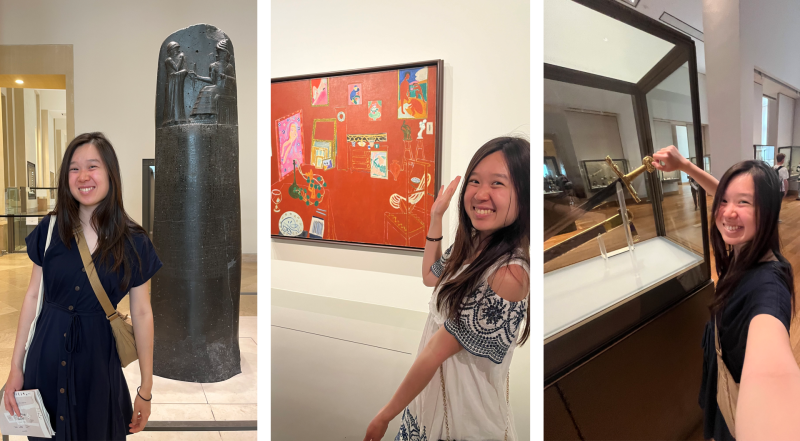
Ziqin even found a way to merge her interest in law and creative writing. For instance, she joined the scriptwriting team for Law IV, an annual musical traditionally staged by the graduating law cohort.
These creative projects are ways of "exploring authenticity". This process is critical for Ziqin who "draws from lived experience" to pen her stories.

Ziqin will be preparing for the Bar exam in the coming months - but that doesn't mean she is putting her creative work on the backburner.
When time allows, she hopes to spend the latter half of 2025 working on her next novel, about a university student stranded with a Chinese ethnic minority tribe during a trip to China.

The idea was sparked by her visit to Betel Nut Valley in Hainan, a lived experience she wishes to capture in writing.
Stephanie Peck: Finding purpose in poetry and psychology
In the quaint, seaside town of Swanage, England, with its chalk cliffs and sea breeze echoing with bird cries, Stephanie Peck and her friends came to a realisation: life was bigger than the woes they faced as secondary school students.
"It was so peaceful, our brains couldn't handle it," she said with a laugh.

"The adolescent period is not easy. (Psychologists) call it a period of storm and stress," said Stephanie. Then 15, she was in Swanage to learn about geography. But the trip ended up sparking her curiosity about the human mind and mental health.
Now 23, she has traversed an eclectic academic journey. She initially enrolled in medicine, but eventually switched to psychology, along with a double minor in English Literature and Southeast Asian Studies at the NUS Faculty of Arts and Social Sciences. In hindsight, the arts was the right place as she grew creatively and academically.

During her five years in the College of Alice & Peter Tan (CAPT), a pivotal moment came in 2022 when she took the course Identities in Asia. It was taught by Senior Lecturer, Dr Kankana Mukhopadhyay, who encouraged the budding poet to submit poetry reflecting on the course's field trips.
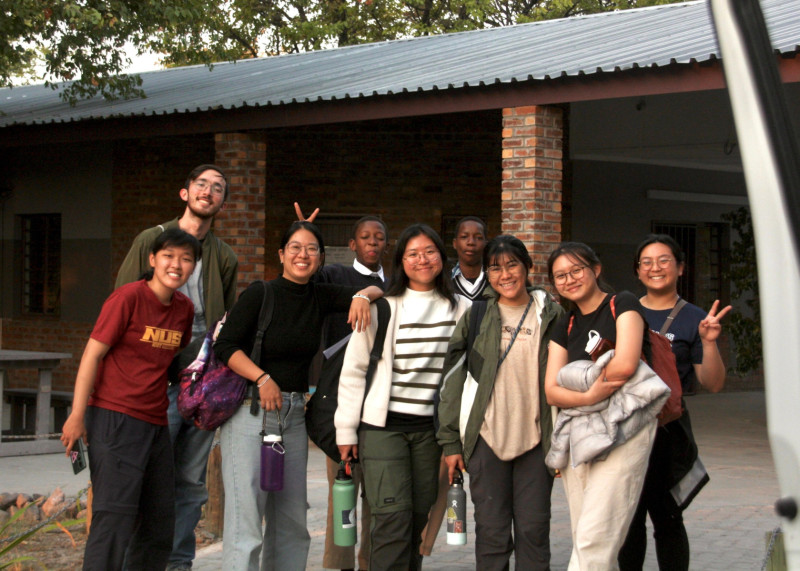
With Dr Kankana's support, Stephanie launched "Beginner's Guide to Writing Poetry", the following year, a reading and writing group she facilitated within CAPT for her final three semesters. One participant, who had long wished to learn to write poetry but never had the chance, described the sessions as "an answered prayer".
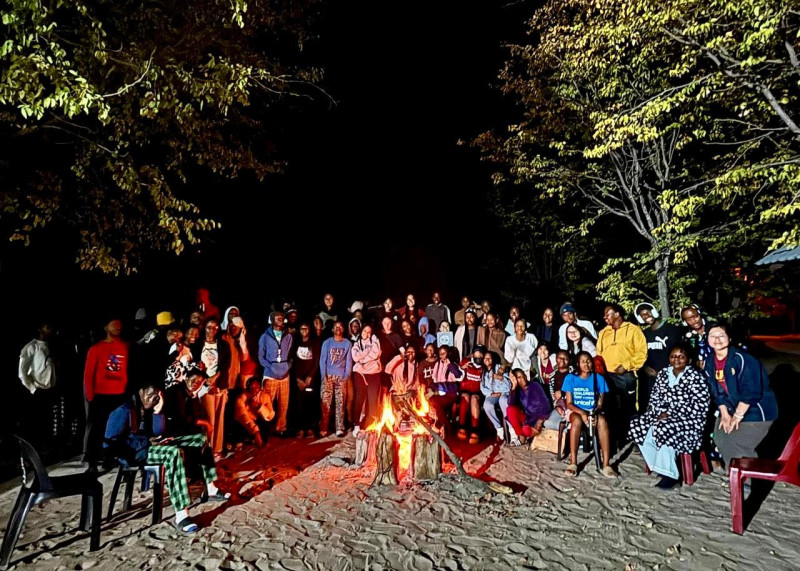
In 2024, Stephanie took her love for the arts abroad to Botswana for a two-month teaching internship at Delta Waters International School in Maun, a key partner of CAPT's Study Trips for Engagement and EnRichment (STEER) programme. There she taught English, Literature, and Creative Writing to secondary and primary school students.

Post-graduation, Stephanie hopes to pursue clinical psychology, kickstarting her career in the mental health and social service sectors.
"What draws me to both poetry and psychology is their shared power to surprise - to shift a person's perspective when they feel stuck. Sometimes, change begins with simply seeing things differently," she said.
This story first appeared on NUSNews on 13 July 2025.
Has China’s great relocation helped Southeast Asia industrialise?
IN BRIEF | 10 min read
- By Adj Asst Prof Maria Monica Wihardja (NUS Southeast Asian Studies) and Ms Midzuki Low, Analyst in the Industry Research Dept at Mizuho Bank based in Singapore.
Click through image below to read this piece.
This story first appeared in CNA Online and on NUSNews on 3 May 2025.
#Minimosque: Cov-Eid as Image, Event, and Archive
The COVID-19 pandemic led to the closure of mosques in Singapore, preventing Muslims from gathering for communal prayers and rituals. Projects such as "Living with COVID-19 in Southeast Asia: Personal and Visual Experiences of Crisis, Control, and Community", the NUS Asia Research Institute’s crowdsourced visual archive on pandemic life in Southeast Asia attempted to organise the plethora of archives produced during this time. However, the bulk of digital artefacts, such as images under the hashtag #minimasjid, are scattered across the internet, with some hidden behind private accounts while others circulate in public domains. While the use of hashtags connected public and private realms, images could detach from their original context and be linked to different narratives. In her book chapter, '#Minimosque: Cov-Eid as Image, Event, and Archive' (CoronAsur, 2023) Assistant Professor Faizah Zakaria (NUS Southeast Asian Studies and NUS Malay Studies) explores the current and potential future interpretations of Cov-Eid images. She tracks the mini-masjid (mosque) and the home-delivered khutbah (sermon) from the morning of Eid ul-Fitr as both an event that occurred, and an emerging archive that is not yet defined by a single set of narratives. Specifically, she shows how power dynamics are influenced by both algorithmic determinations of digital platforms and real-world events. The #minimosque challenge, which emerged during Cov-Eid, aimed to inspire parents worldwide to create mini-prayer areas for their children. Zakaria observes how images from such events can acquire multiple meanings over time, serving as both events and archives. As an event, the #minimasjid challenge sought to reshape the narrative about Muslims during the pandemic, offering a positive portrayal of creative Muslim resilience, amid reports linking Tabligh mass prayer events to infection clusters. Sharing these images countered the stereotype of Islam as fatalistic and superstitious, and highlighted the creativity and resilience of quarantined Muslims instead. Looking ahead, future researchers might encounter these images without the context of social media algorithms and interpret them as symbols of ingenuity and strength during a difficult time. Following Dr Nazirudin Mohd Nasir, the mufti of Singapore who livestreamed the sermon while holding his staff, the ‘asa, from an empty mosque due to congregational prayer restrictions, families conducted smaller Eid prayers at home. These were led by a male family member acting as an "insta-imam" with their own creatively improvised 'asa, such as a fishing rod or an IKEA hat stand. The images of family imams' ‘asas were documented and circulated on private sharing platforms like WhatsApp. However, tracking the meaning and distribution of images in private spaces is challenging due to algorithms and sharing choices. Similarly, preserving an archive of WhatsApp images raises questions about their coherence and continuity. Ultimately, the study reveals how digital images during the pandemic reflect individual agency among quarantined Muslims. The online circulation of Cov-Eid images not only mirrors the absence of physical congregational spaces but also highlights the evolving landscape of virtual public interaction. As Singapore adapts to this unprecedented shift towards virtual engagement, it is crucial to acknowledge the significance of digital imagery in shaping new realities, including our engagement with religious practices during crises. Read the chapter here.

Book on religion and the environment by Dr Faizah Zakaria accorded prestigious Association for Asian Studies award

The esteemed Harry J. Benda Prize was awarded to Dr Faizah Zakaria for her book "The Camphor Tree and the Elephant: Religion and Ecological Change in Maritime Southeast Asia".
A book titled "The Camphor Tree and the Elephant: Religion and Ecological Change in Maritime Southeast Asia" by historian Dr Faizah Zakaria has claimed the prestigious annual "Harry J. Benda Prize (First book on Southeast Asian Studies)" by the Southeast Asia Council of the Association for Asian Studies. Established in 1977, the Prize honours books that make exceptional contributions to the understanding of Southeast Asia, specifically to authors publishing their first major work on the topic. One of the most esteemed awards in the field, receiving this prize is considered a major milestone for early-career scholars.
Published in February 2023 by University of Washington Press, Dr Zakaria's book explores how religious beliefs and practices have influenced the way people in the region interact with their environment, specifically with respect to the natural world. She traces the conversion of the Batak people in upland Sumatra and the Malay Peninsula to Islam and Christianity during the 19th century, and finds that the process helped shape social structures that voided the natural world of enchantment, ushered in a cash economy, and placed the power to remake local landscapes into the hands of elites.
Dr Zakaria shared how she felt honoured to receive the distinction in the company of many wonderful scholars whose field-shaping books in Southeast Asian studies have been recognised through this award.
She added, "More importantly, I hope that my book will spark new conversations about environmental history and ethics as well as the role of religious communities in co-creating a sustainable world. Area studies, with its phenomenological approaches to understanding the region's communities, continues to offer grounded views to the pressing issues of our time and I hope that more students will be interested to explore the region on their own terms."
Dr Zakaria holds a joint appointment in the Departments of Southeast Asian Studies and Malay Studies at the NUS Faculty of Arts and Social Sciences. Her research interests focus on religion and ecology, environmental justice and indigenous movements in Southeast Asia. She is currently working on a research project on the role of religion and science in disaster responses, focusing on volcanic eruptions, and she also co-coordinates a digital humanities project comparing Malay and Chinese heritage medicine.
This story first appeared on NUSNews on 11 April 2025.
Curating Shadows: Malayan Shadow Puppets in Singapore's Asian Civilisations Museum
World Puppetry Day is celebrated worldwide on 21 March. Across Asia, shadow puppetry is an art form traditionally associated with the high culture of Hindu India and has proliferated as a form of entertainment in various contexts. Singapore’s Asian Civilisations Museum (ACM) exhibits over 700 shadow puppets (wayang purwo), with most scholarship focusing on the genre’s dramaturgical features. In ‘Curating Shadows: Malayan Shadow Puppets in Singapore's Asian Civilisations Museum’ (Journal of the Malaysian Branch of the Royal Asiatic Society, 2022), Associate Professor Irving Chan Johnson (NUS Southeast Asian Studies) and Darryl Lim (Asian Civilisations Museum) examine the origins and features of Malayan shadow puppets. Their work showcases the otherwise hidden associations between power, politics, and art in the British colonial era, and contains numerous pictures that showcase the ACM digital collection.
Wayang siam, a traditional form of Malay shadow puppetry from Kelantan, is characterised by its vibrant oil-based pigments. Having examined the museum records from the Raffles Library and Museum (RLM), researchers found that Malayan puppets are underrepresented in the Asian Civilisations Museum (ACM) - only 9 out of 132 have been accessioned by the RLM as donated by Tengku Khalid.
The peak period of puppet performances and collections in Kelantan during the 1930s contributed to the complex array of wayang siam figures in the ACM today, a time when many tutelage opportunities were available. Among many puppets with unknown origins, there is a noticeable overrepresentation of fanged ogre generals, animals, and monkey generals. The researchers, through detailed analysis of the puppets' iconography, propose that Anker Rentse, a Dane with a keen interest in Kelantanese culture, likely played a significant role in building this collection.
Interestingly, the ACM's collection lacks certain figures such as Dewa Panah (gods holding bows) and Tok Peran Hutan (forest clowns), yet includes other rare characters, reflecting shifts in the popularity of specific characters over time. The presence of puppets resembling Thai nang talung puppets also indicates a once-existing genre of Kelantanese Thai shadow puppetry, now replaced by southern Thai performances featuring translucent hide puppets.
The researchers conclude that the colonial approach to curating the ACM's Malayan puppet collection in the early 20th century was marked by a disregard for the subjecthood and agency of the creators. Instead, the focus was on displaying exotic art pieces to celebrate the colonial status of the Unfederated Malay States. Key donors like Tengku Khalid and Rentse, embedded in elite Malay and British socio-political circles and the Malayan Branch of the Royal Asiatic Society (MBRAS), influenced this collection approach. The researchers advocate for viewing these puppets not merely as entertainment artefacts but as cultural objects that can provide deeper insights into local histories and contemporary knowledge systems.
Read the article here.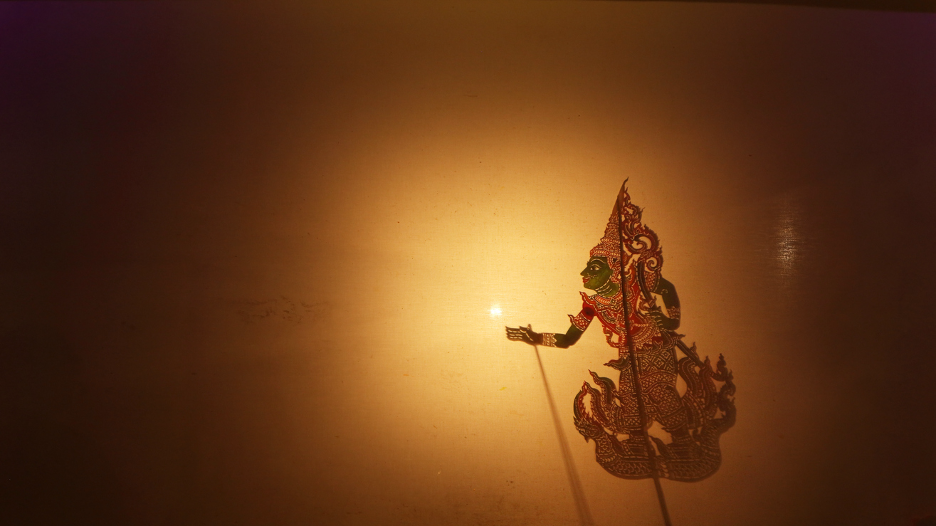
Cheeseburgers in Paradise by Dr Lin Hongxuan
"Cheeseburger in Paradise: Why we eat what we eat" is a multi-perspectival course (co-taught by a food scientist and a historian) that focuses on food systems, rather than a history of the hamburger. By using the ultimate symbol of globalized "industrial cuisine," the cheeseburger, as an entry point to understanding food, this course explores how the food we consume affects the natural environment, the microbial environment, as well as the welfare of humans and other animals. By considering everything from the practices of rearing, feeding, and slaughtering animals, to innovations in baking bread or farming crops, students are guided to understand the many complex consequences of the simple act of producing sustenance for humans.
A distinctive aspect of this course lies in its assessment format: recognizing a diversity of student aptitudes, the major assignments for this course are not written exams or essays, but rather built around groups of five students producing a "pitch video" and a flowchart on one food item of their choice. Instructors carefully guide students across five tutorials to help them craft and refine their projects.
This class is beneficial for students in a multitude of ways, depending on which aspect they find most compelling. At the micro-level, the deep engagement with the "farm to table" production process of a food item of their choice allows students to develop research skills in collaboration with their group mates, improving their understanding of the incredible complexity that goes into the production and distribution of staple foods we take for granted. At the macro-level, students are introduced to the multi-faceted problems created by meeting both the sustenance demands of 8 billion people, as well as some potential solutions. At the personal level, students will minimally learn about nutrition and food safety, practical knowledge that every person can benefit from in their daily lives.
HS2905
Cheeseburger in Paradise: Why We Eat What We Eat
FASS Outreach & Engagement Award 2024 Winners
Congratulations Dr Serina Abdul Rahman!
The FASS Outreach and Engagement Award programme acknowledges the service efforts and contributions of faculty members who have been instrumental in promoting the visibility and presence of FASS Departments and Programmes among prospective students, parents, schools, alumni and the broader public.
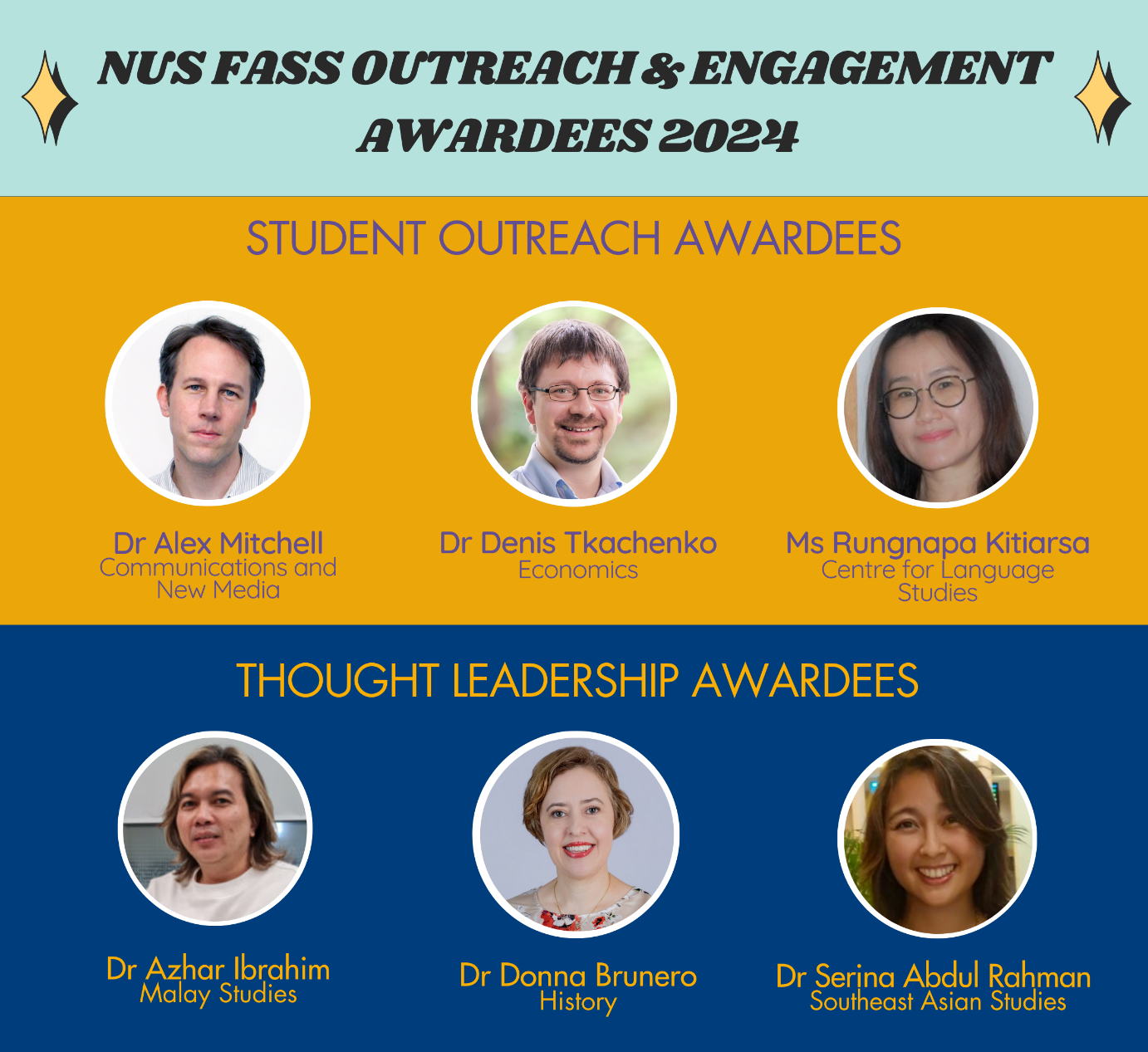
Dr Faizah Zakaria Wins Prestigious Harry J. Benda Prize
Dr Faizah Zakaria Wins Prestigious Harry J. Benda Prize Dr Faizah Zakaria has been awarded the prestigious Harry J. Benda Prize for her groundbreaking book, The Camphor Tree and the Elephant: Religion and Ecological Change in Maritime Southeast Asia. Presented by the Southeast Asia Council of the Association for Asian Studies (AAS), the prize recognizes outstanding first books in Southeast Asian Studies.
https://www.asianstudies.org/aas-2025-prizes/
Established in 1977, the Harry J. Benda Prize honors exceptional contributions to the study of Southeast Asia and is one of the most esteemed awards in the field.
Congratulations to Dr Faizah Zakaria on this well-deserved recognition!
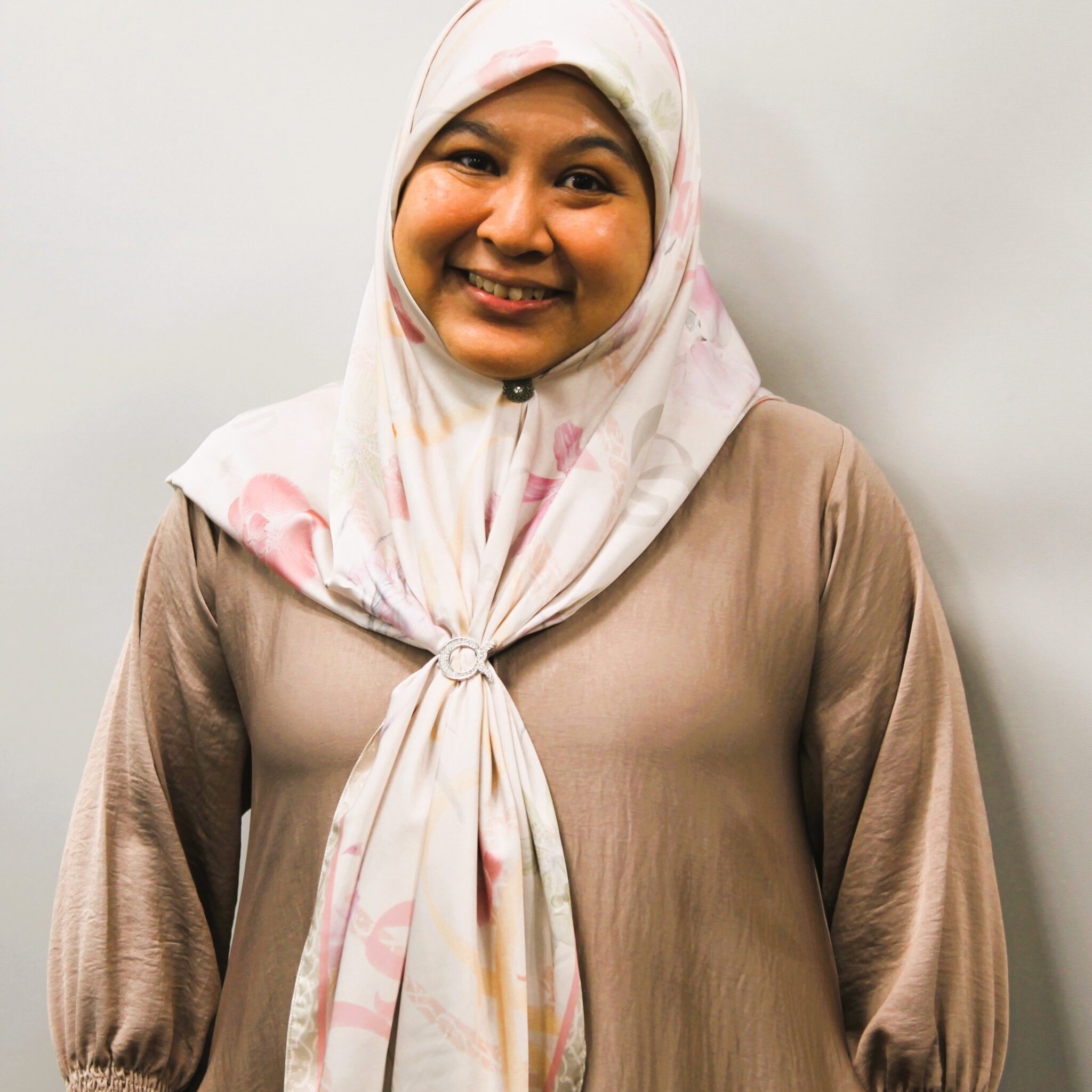
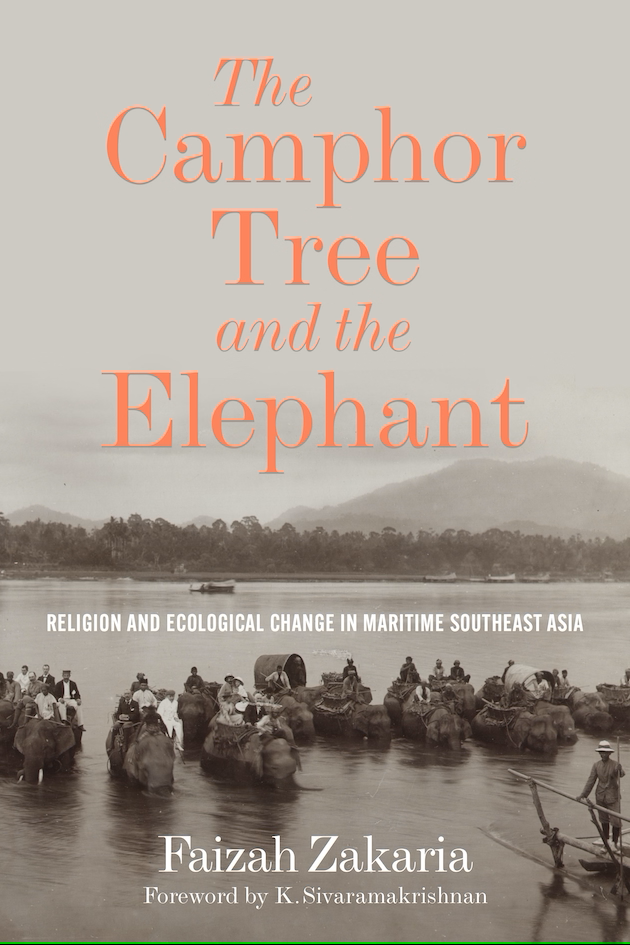 The Camphor Tree and the Elephant
The Camphor Tree and the Elephant
Religion and Ecological Change in Maritime Southeast Asia
By Faizah Zakaria
Uncovers a spiritual dimension in the transition to the Anthropocene
What is the role of religion in shaping interactions and relations between the human and nonhuman in nature? Why are Muslim and Christian organizations generally not a potent force in Southeast Asian environmental movements? The Camphor Tree and the Elephant brings these questions into the history of ecological change in the region, centering the roles of religion and colonialism in shaping the Anthropocene-"the human epoch."
Historian Faizah Zakaria traces the conversion of the Batak people in upland Sumatra and the Malay Peninsula to Islam and Christianity during the long nineteenth century. She finds that the process helped shape social structures that voided the natural world of enchantment, ushered in a cash economy, and placed the power to remake local landscapes into the hands of a distant elite. Using a wide array of sources such as family histories, prayer manuscripts, and folktales in tandem with colonial and ethnographic archives, Zakaria brings everyday religion and its far-flung implications into our understanding of the environmental history of the modern world.
Martial arts classes at NUS allow for deeper appreciation
Click through image below to read this piece.

Escaping Kakania: Eastern European Travels in Colonial Southeast Asia
Escaping Kakania: Eastern European Travels in Colonial Southeast Asia (CEU Press, 2024), edited by Associate Professor Jan Mrazek (NUS Southeast Asian Studies), features a diverse range of encounters narrated by Eastern Europeans during their stays and travels across Southeast Asia. Some chapters delve into post-colonial studies, critically re-evaluating eastern Europe's “semi-peripheral” involvement in colonialism. Others unveil the plurality of the travellers’ experiences, drawing parallels between the two regions as they navigate through diverse peoples, races, and empires to establish distinct identities and ideologies.
“Kakania” is a term coined by Austrian philosophical writer Robert Musil to refer to the Austro-Hungarian Empire. According to A/P Mrazek, "escaping" Kakania figuratively alludes to an ongoing unsettled movement out of one's self and homeland toward other forms of settlements. This journey leads to unexpected encounters and transformations that evoke a strange, mirror-like reflection of their familiar homeland, connecting and reflecting across borders.
In the first chapter of the book, "Introductory (Dis)orientation", Singapore is contextualised as a melting pot of cultures and ethnicities. It is depicted not just as a futuristic and technologically advanced country, but as a place envisioned to inspire conversations between Eastern European and Southeast Asian scholars due to its plural nature. Although the workshop had to be moved online due to the COVID-19 pandemic, something of Singapore’s essence as a port city seeped through. Participants were able to converse freely across multiple foreign accents and even engage in side conversations in different European languages, reminding the author that amidst this “Global City”, the ancient entrepot of diverse country specialisations, disciplines, and histories still stood. The author hopes that this book fosters an awareness of the limits of our vision and the transregional mirroring and interpenetration of cultures.
Read the book here.

Book on history and culture of Malay gastronomy wins NUS Singapore History Prize
IN BRIEF | 10 min read
- The groundbreaking book by educator and historian Khir Johari offers new insights into the cultural history and heritage of Singapore Malays through Malay cuisine.
Educator and food historian Mr Khir Johari, whose work, The Food of Singapore Malays: Gastronomic Travels through the Archipelago (Singapore: Marshall Cavendish, 2021) profoundly reshapes our understanding of the gastronomy and cultural history of Singapore Malays, has been awarded the 2024 NUS Singapore History Prize. Mr Khir Johari will receive a cash award of S$50,000.
Created in 2014 in support of the national SG50 programme to celebrate the 50th anniversary of Singapore's independence, the NUS Singapore History Prize is awarded to an outstanding publication that has made a lasting impact on our understanding of the history of Singapore, and that is accessible to a wide audience of specialist and non-specialist readers.
A five-member Jury Panel chaired by Mr Kishore Mahbubani, Distinguished Fellow at the NUS Asia Research Institute, selected the winning work from a short list of six works, itself culled from a total of 26 submitted works authored by local and international scholars. The other Jury Panel members are: Emeritus Professor John N. Miksic of the NUS Department of Southeast Asian Studies; Professor Tan Tai Yong, President of the Singapore University of Social Sciences; Professor Peter A. Coclanis, Director, Global Research Institute, the University of North Carolina, Chapel Hill; and economist Dr Lam San Ling.

A five-member Jury Panel chaired by Mr Kishore Mahbubani, Distinguished Fellow at the NUS Asia Research Institute, selected the winning work from a short list of six works, itself culled from a total of 26 submitted works authored by local and international scholars. The other Jury Panel members are: Emeritus Professor John N. Miksic of the NUS Department of Southeast Asian Studies; Professor Tan Tai Yong, President of the Singapore University of Social Sciences; Professor Peter A. Coclanis, Director, Global Research Institute, the University of North Carolina, Chapel Hill; and economist Dr Lam San Ling.
The five books that were shortlisted alongside the winning publication are:
- Wesley Leon Aroozoo, The Punkhawala and the Prostitute (Singapore: Epigram Books, 2021).
- Timothy P. Barnard, ed., Singaporean Creatures: Histories of Humans and Other Animals in the Garden City (Singapore: NUS Press, 2024).
- Kevin Blackburn, The Comfort Women of Singapore in History and Memory (Singapore: NUS Press, 2022).
- Loh Kah Seng, Alex Tan Tiong Hee, Koh Keng We, Tan Teng Phee, and Juria Toramae, Theatres of Memory: Industrial Heritage of 20th Century Singapore (Singapore: Pagesetters Services, 2021).
- Lynn Wong Yuqing and Lee Kok Leong, Reviving Qixi: Singapore's Forgotten Seven Sisters Festival (Singapore: Renforest Publishing, 2022).
Of the five books, the Jury Panel also highlighted two that deserve special commendation and recognition. They are, ranked in order of priority, Reviving Qixi: Singapore's Forgotten Seven Sisters Festival by Lynn Wong Yuqing and Lee Kok Leong; and Theatres of Memory: Industrial Heritage of 20th Century Singapore by Loh Kah Seng, Alex Tan Tiong Hee, Koh Keng We, Tan Teng Phee, and Juria Toramae. The Jury Panel found the two books compelling and riveting: one offers new insights into a forgotten festival celebrated by the Chinese community in Singapore while the other delves into the understudied labour and industrial history of Singapore.
Mr Mahbubani, Chair of the NUS Singapore History Prize Jury Panel, said: "Southeast Asia is a magical place. At a time when many regions are suffering conflict, tension and stagnation, Southeast Asia remains an oasis of peace and prosperity, despite its incredible diversity. Why? The deeper and longer history of the region may explain this. Khir Johari's book is a deserving winner of the Singapore History Prize because it sheds new light on our history. Few Singaporeans know that over a hundred years ago, Singapore had already emerged as 'the New York of the Nusantara.' This book will open their eyes to Singapore's long and rich involvement with its surrounding region. And it is a truly beautifully produced book that will enchant its readers."
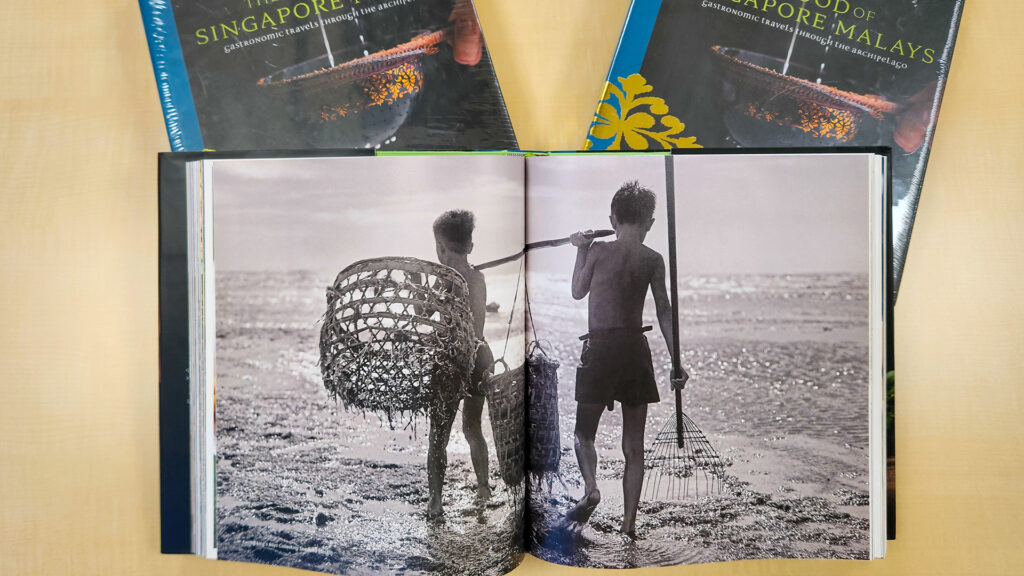
The Food of Singapore Malays: Gastronomic Travels through the Archipelago
The Food of Singapore Malays: Gastronomic Travels through the Archipelago is an unwritten story of a people. Between the vast Indian and Pacific oceans lies the Malay Archipelago, known widely as the Nusantara, which has nourished the lives of indigenous Malays throughout the centuries and nurtured the diverse peoples that have set foot on their shores. Today, the Malays make up less than a fifth of the population in Singapore, a city with ancient ties to the Malay world.
This book explores their food, not just as a means of sustenance but as a cultural activity. Inheriting the Nusantara's rich flavours, Singapore Malays have a grand culinary heritage reflecting their worldviews, social values and historical interactions with other cultures. Through close examination of their daily objects, customs, art and literature, these pages reveal how the food Malays enjoy is deeply embedded in different aspects of their identity.
Following the broad sweep of Malay cuisine's evolution - from the 7th-century kingdom of Srivijaya to the 21st-century emporium of cosmopolitan Singapore - this book traces the continuity and dynamism of a shared cultural consciousness. Sumptuously served with stunning photographs, delicious recipes and diligent research, this is essential reading for anyone - gourmets and amateurs alike - hungry for a deeper understanding of the relationship between people and their food.
Please refer to the Annex for the citation on the winning work by Khir Johari, along with the two books receiving special commendations.
About Khir Johari
Khir Johari is the author of the award-winning book, The Food of the Singapore Malays: Gastronomic Travels Through the Archipelago. which has received widespread acclaim, including Singapore's Book of the Year 2022, Gourmand World Food Culture Award's Best of the Best Book 2023, and its prestigious Best of the Last 25 Years. Following this success, Khir founded "Dialogues by Khir Johari," a platform dedicated to exploring Nusantara's gastronomy through events and online discussions. Its inaugural event was a symposium titled Serumpun: Tasting Tradition, Telling Tales.
Aside from his literary achievements, Khir is an avid art collector and independent researcher specialising in the history and heritage of maritime Southeast Asia. He holds a Bachelor of Science degree in Mathematics from Santa Clara University and a Masters in Education from Stanford University. He serves as a board member of the Asian Civilisations Museum Singapore.
Born and raised in Kampong Gelam, Khir was immersed in the diverse Nusantara culinary traditions from a young age, learning from both his family and the larger vibrant communities of this historic district.
Khir Johari remarked: "I am touched and humbled by this recognition. It is an honour to receive this NUS Singapore History Prize among such a distinguished list of writers. My hope is that we continue the important work of preserving and celebrating our rich culinary heritage. Our shared cultural roots are an essential starting point for understanding how food connects us across generations and borders."
"When I set out on this book project 14 years ago, my aim was to document our nation's first cuisine. What started as a chronicle of food culture evolved into a celebration of our custodians of gastronomic knowledge and wisdom. This book is a tribute to the fishermen, farmers, hawkers, smiths who produced our kitchen accoutrements, as well as cookbook writers, cookery teachers, homemakers and more."
"My wish for this book is that it answers the question of why we eat what we eat as a people. I also hope it serves as a reminder that Singapore has always been an important node in a larger interconnected network. Indeed, Singapore can be aptly regarded as the New York of the Nusantara for its role and contributions in shipping, trade, publishing and performing arts of the region."
The NUS Singapore History Prize
Mooted by Mr Mahbubani, the NUS Singapore History Prize aims to stimulate an engagement with Singapore's history broadly understood (this might include pre-1819) and works dealing with Singapore's place in the world. Another purpose is to make the complexities and nuances of Singapore's history more accessible to non-academic audiences and to cast a wide net for consideration of works that deal with history. At the same time, the Prize hopes to generate a greater understanding among Singaporean citizens of their own unique history.
The Prize is an open global competition and is administered by the Department of History at the NUS Faculty of Arts and Social Sciences. The 2024 Prize was open to works in English (written or translated) published between 1 June 2021 and 31 May 2024. Non-fiction and fiction works were eligible for the Prize. Other creative works that have clear historical themes could also be submitted. Book-length works that were either authored or co-authored, and addressed any time period, theme, or field of Singaporean history, or include a substantial aspect of Singaporean history as part of a wider story were eligible.
The Prize is awarded every three years, and the author of the winning publication will receive a cash award of S$50,000. The inaugural Prize was awarded in 2018 to Professor John Miksic, whose work Singapore and the Silk Road of the Sea, 1300-1800 provides detailed archaeological evidence that Singapore's story began more than 700 years ago. In 2021, the Prize was awarded to Hidayah Amin for her book Leluhur: Singapore's Kampong Gelam which presents the history of Kampong Gelam in the context of changes to Singapore's economic, political, and social history over the last 200 years.
Enquires about the next round of the NUS Singapore History Prize, which will open for nominations in due course, and be awarded in 2027, should be addressed to hisprize@nus.edu.sg.
This story first appeared on NUSnews on 24 October 2024.
GISBH 'perverted and sadistic cult' is not just the latest incarnation of Al-Arqam
IN BRIEF | 10 min read
- By Dr Serina Rahman, Lecturer at NUS Southeast Asian Studies.By Dr Serina Rahman, Lecturer at NUS Southeast Asian Studies.
Click through image below to read this piece.
This story first appeared in Suria News Online and NUSNews on 11 October 2024.
Honours Student Maisy Kim Tyan-Wei Joins ASEAN-Plus Three Seminar and Student Camp, Fostering Cultural Understanding and Collaboration in East Asian Studies
by Maisy Kim Tyan-Wei The APT International Seminar on East Asian Studies at Major Universities and ASEAN Plus Three Student Camp aimed to foster greater understanding of East Asian issues among educators and students from ASEAN Plus Three (APT) countries. As participants of the ASEAN Plus Three Student Camp, we attended lectures that enhanced our understanding of East Asia as a region, and engaged in meaningful discussion on the role of ASEAN Plus Three to both ASEAN and the Plus Three nations. Part of the camp involved discussion of a Yogyakarta Declaration that was meant to represent what we, as the youth, believed ASEAN Plus Three could do. Through that activity, we got to explore the different cultural backgrounds of each country, especially countries that we were less familiar with such as Timor-Leste. Personally, this camp was a great introduction to Timor-Leste for me as we got to interact and learn more about their history and culture, more so as they ease into their position as a new member of ASEAN. We were also invited to visit the UNESCO World Heritage site of Borobudur Temple, as well as a Ramayana Ballet at the Prambanan Temple, truly experiencing and appreciating the rich cultural heritage of Yogyakarta. Overall, the camp facilitated exchanges of views, perspectives, and knowledge on establishing East Asian Studies at major universities in APT countries, enhancing people-to-people connectivity through in-person interaction, and promoting cultural understanding. More details on UGM CESASS website: https://pssat.ugm.ac.id/apt-seminar-on-east-asian-studies-and-apt-student-camp-fostering-regional-understanding-and-academic-collaboration/
Commentary: After removing diesel subsidies, Malaysia must now manage the fallout
IN BRIEF | 10 min read
- By Dr Serina Rahman (NUS Southeast Asian Studies).
Click through image below to read this piece.

This story first appeared in CNA Online and NUSNews on 12 July 2024.
Punching Home Lessons about Southeast Asia through Martial Arts
IN BRIEF | 10 min read
- From honing basic silat techniques to dabbling in the various styles of martial arts practised in Southeast Asia - such as kung fu and baguazhang from China as well as the Japanese sword-fighting art of kendo - students discover the region's cultures and history in unconventional ways, in a course conducted by Dr Mohamed Effendy (NUS Southeast Asian Studies).
With their arms stretched out and feet apart, the students practise the sikap pasang - Malay for "ready stance". At their trainer's command, they squat and stretch one leg out in unison, performing the sapu dalam, or inside leg sweep.
Students also learnt the langkah perguruan, consisting of strikes and footwork, along with moves such as langkah pedang (the art of the sword), langkah golok (the art of the machete), as well as many different styles of pokolan (kicks and punches).
These youth are not part of a silat club, but students of the Martial Arts in Southeast Asia course in the middle of a supervised silat lesson held on campus. It is just one of many hands-on martial arts sessions they enjoy throughout the course.
Typically, each session begins with a short introduction to a particular martial art, before a professional trainer demonstrates basic techniques. Students then pair up to practise their moves, before learning about the philosophy behind the martial art.
Dr Mohamed Effendy Abdul Hamid, who launched the course in 2015, says such hands-on lessons enable students to learn better by experiencing things for themselves.
"We aim to ignite students' understanding of the region in less conventional ways," said the lecturer in the Department of Southeast Asian Studies at the NUS Faculty of Arts and Social Sciences (FASS). "The best way is to practise the cultures embedded in the region, and martial arts can be a window to understanding Southeast Asian cultures."
Students experience "the warrior spirit, especially resilience" when they practise these martial arts. "This spirit is emblematic of the Southeast Asian spirit itself," added the martial arts buff, who began reading books about different ancient battles and war philosophies during rest periods while on patrol in the coast guard while serving National Service.
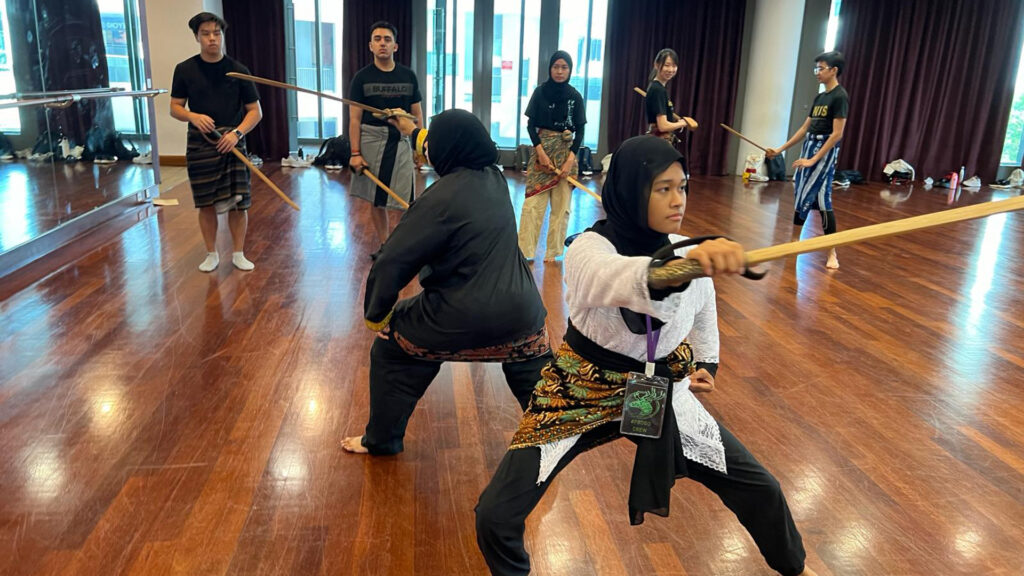
Lessons from the Region and Beyond
Although the course aims to educate students about the region's cultures, it also taps into martial arts from all over the world, such as kung fu and baguazhang from China, and the Japanese sword-fighting art of kendo which Dr Effendy is trained in.
Dabbling in a wide variety of martial arts helps students grasp an essential truth - Southeast Asia has always been connected to the rest of the world. "Studying martial arts in the region, you can see that we have a long history of exposure to trade and connections with other communities," he explained.
"For example, Japanese, Malaysian and Filipino martial arts all have a strong emphasis on spirit and ethics during fighting. People in Southeast Asia encounter people from other regions, see how they fight, then adapt things to their own fighting style. This is what we call localisation."
Another clear example of this "cross-pollination" is how silat warriors greet their opponents with their fists against their palms, a traditional Chinese martial art greeting.
"I had a friend, a kung fu master, who saw a video of silat being practised in Sulawesi, Indonesia, and he told me that silat looks like a martial art with Chinese hands and Malay feet," Dr Effendy shared. "To me this is a good example of historical exchanges that enriches cultures in the region," he quipped.
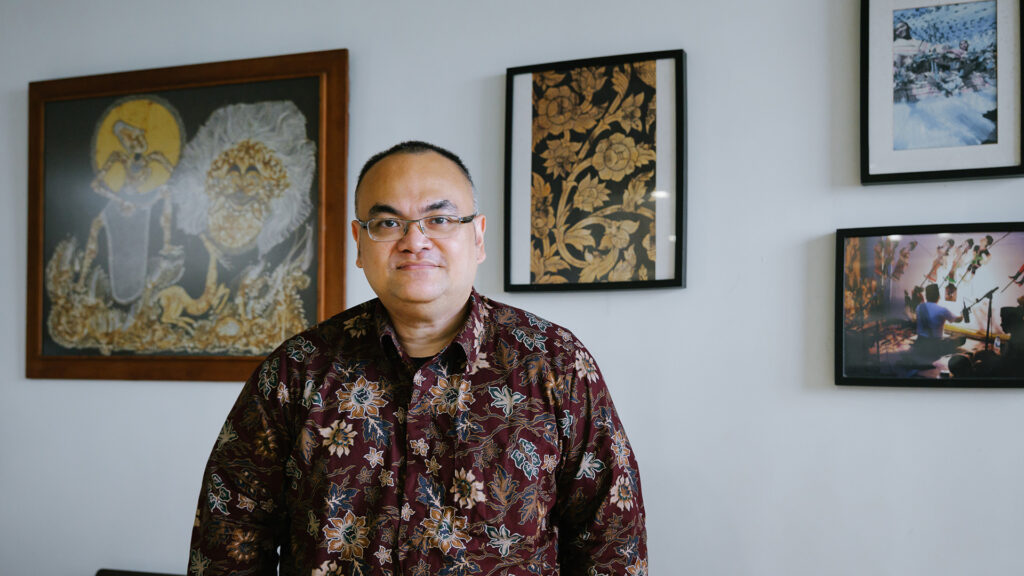
Combat and Core Values
These perspectives on the region's history brought to life through the martial art forms practised by its people has been illuminating for students.
"We learned through Prof's class (that) many martial arts had their origins in actual warfare or combat. So certain martial arts may be perhaps more adapted to certain types of combat," said Bryan Cambo, a Year 1 undergraduate at FASS, who intends to major in Southeast Asian Studies. He cited, for instance, how certain forms of silat are geared towards one-on-one combat and employ the karambit as a tool in battle, reflecting how combat was carried out in earlier times.
Gergana Biserova Atanasova, a Year 3 exchange student majoring in Cognitive Science from Denmark's Aarhus University, recalls a particular manoeuvre from the demonstration by local silat group, Pencak Silat Bawean Dheun, which involved throwing sand at an opponent to deceive them.
She later learnt that the technique arose from the sandy terrain on which the martial art form is traditionally practised. "I think you can learn a lot from the martial arts just from looking at the movements they teach you at these very basic training sessions."
Aside from discovering the historical and cultural contexts behind the various martial art forms, students also learn about the individual philosophies underpinning the different styles.
During the class exploring kendo, they gained insights into its core values such as courage, humility and perseverance while trying their hand at basic footwork and strikes with the shinai, a bamboo training sword, under the guidance of the NUS Kendo Kai student club and JSK or Joushinkan, a local kendo group based in Tiong Bahru Community Centre led by Peter Ong sensei.
Terence Chong, the captain of the NUS Kendo Kai student club and a Year 3 Computer Science undergraduate, said he hoped the exposure to kendo would instil a sense of confidence in his fellow students. "What we try to convey in our lessons is to be confident in your strikes because without confidence it will hold you back in kendo. In my opinion, this can (also) be applied to everyday life."
Dr Effendy, too, has learnt a few things while delving into the world of regional martial arts with his students. They realised, for example, that women play a very important role in the development of martial arts in Southeast Asia.
"There is a strong tradition of female practitioners in the region. In northern Vietnam, when the Chinese invaded in C.E. 39-43 the Trung sisters fiercely fought back," he noted. "Apart from northern Vietnam, other examples of women warriors exist such as prajurit estri, or female soldiers and warriors in the Javanese court of Sultan Agung (1613-1645 C.E.) of Mataram. Even in Aceh, women warriors played an important role in the struggle for independence from the 19th to 20th centuries."
"The evidence tells us that, compared with other regions, more women practised martial arts and played an indispensable role in defending their communities in Southeast Asia."
This tradition is reflected in the demographic of the course - it draws about an equal mix of males and females in each class of 30. "Sometimes the ladies are even more enthusiastic than the guys," he said with a laugh.
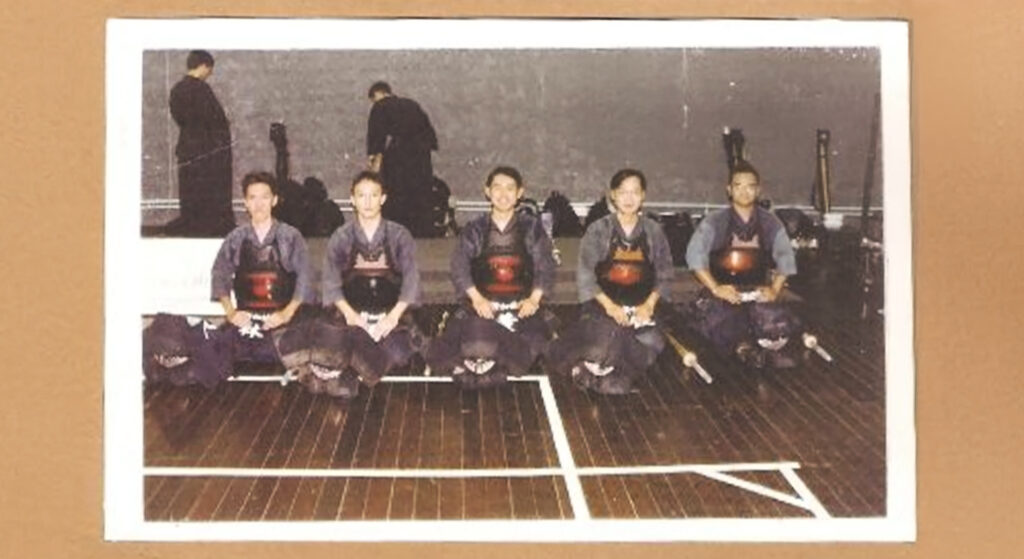
Going beyond convention
The course, which runs every second semester of each academic year, is open to students from all faculties. There are no seated final examinations, but Dr Effendy expects the students to think outside the box.
"I tell my students that they can stick to the traditional essay for their final project submission, but I strongly encourage them to go for more unconventional formats - music videos, documentaries, even paintings," he said.
His aim is to let them have fun, which he believes helps them better appreciate the learning process. "After each class, and this module, I want students to walk away feeling fulfilled, that they have learnt something new about themselves and the subject," he added.
His students' work has been enlightening. He fondly recalls a video documentary by a former student, Mr Khoo Yi Feng, which detailed how domestic workers in Singapore used their days off to learn taekwondo. Some turned this new skill into a viable means of living when they worked as taekwondo trainers upon returning home.
"This documentary was so memorable that I still keep in contact with this student," he recounted.
Khoo, a manager at the National Council of Social Service and a mental health advocate, recently received the prestigious NUS 2023 Outstanding Young Alumni Award. The accolade is awarded to alumni below 40 who have made significant contributions in their fields of work.
To Dr Effendy, a good gauge of whether students are really learning is their level of engagement in class. "If students are asking questions, discussing with one another and participating, that indicates they are enjoying themselves and learning," he noted.
The most important indicator, however, is whether students explore the topic beyond what is taught in class and seek out information on their own.
This, to Dr Effendy, is the ideal learning approach. "A victorious and effective learner of martial arts is someone who is self-motivated, independent, and unafraid of pursuing new knowledge in new ways," he said. "I hope every one of my students will grow to embody this spirit of a fighter in their learning."
This story first appeared in NUSNews on 16 May 2024.
Notes from KL: The Chasm Between the Richest and the Poorest in Malaysia is Not as Far as the Comparison between Ethnic Groups
IN BRIEF | 10 min read
- Column on Suria News Online by Dr Serina Rahman, Lecturer from NUS Southeast Asian Studies.
Click through image below to read this piece.
This story first appeared in Suria News Online and NUSNews on 20 May 2024.
NEW PUBLICATION: Escaping Kakania Eastern European Travels in Colonial Southeast Asia
Escaping Kakania Eastern European Travels in Colonial Southeast Asia Escaping Kakania is about fascinating characters—soldiers, doctors, scientists, writers, painters—who traveled from their eastern European homelands to colonial Southeast Asia. Their stories
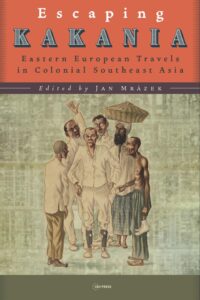 are told by experts on different countries in the two regions, who bring diverse approaches into a conversation that crosses disciplinary and national borders.
The 14 chapters deal with the diverse encounters of eastern Europeans with the many faces of colonial southeast Asia. Some essays directly engage with post-colonial studies, contributing to an ongoing critical re-evaluation of eastern European “semi-peripheral” (non-)involvement in colonialism. Other chapters disclose a range of perspectives and narratives that illuminate the plurality of the travelers’ positions while reflecting on the specificity of the eastern European experience.
The travellers moved—as do the chapter authors—between two regions that are off-centre, in-between, shiftingly “Eastern,” and disorientingly heterogeneous, thus complicating colonial and postcolonial notions of “Europe,” “East,” and East-West distinctions. Both at home and overseas, they navigated among a multiplicity of peoples, “races,” and empires, Occidents and Orients, fantasies of the Self and the Other, adopting/adapting/mimicking/rejecting colonialist identities and ideologies. They saw both eastern Europe and southeast Asia in a distinctive light, as if through each other—and so will the readers of Escaping Kakania.
The book is Open Access – free download is available here: https://ceupress.com/book/escaping-kakania
Jan Mrazek is an Associate Professor in the Department of Southeast Asian Studies at the National University of Singapore.
are told by experts on different countries in the two regions, who bring diverse approaches into a conversation that crosses disciplinary and national borders.
The 14 chapters deal with the diverse encounters of eastern Europeans with the many faces of colonial southeast Asia. Some essays directly engage with post-colonial studies, contributing to an ongoing critical re-evaluation of eastern European “semi-peripheral” (non-)involvement in colonialism. Other chapters disclose a range of perspectives and narratives that illuminate the plurality of the travelers’ positions while reflecting on the specificity of the eastern European experience.
The travellers moved—as do the chapter authors—between two regions that are off-centre, in-between, shiftingly “Eastern,” and disorientingly heterogeneous, thus complicating colonial and postcolonial notions of “Europe,” “East,” and East-West distinctions. Both at home and overseas, they navigated among a multiplicity of peoples, “races,” and empires, Occidents and Orients, fantasies of the Self and the Other, adopting/adapting/mimicking/rejecting colonialist identities and ideologies. They saw both eastern Europe and southeast Asia in a distinctive light, as if through each other—and so will the readers of Escaping Kakania.
The book is Open Access – free download is available here: https://ceupress.com/book/escaping-kakania
Jan Mrazek is an Associate Professor in the Department of Southeast Asian Studies at the National University of Singapore.Exploring Kendo: A Hands-On Journey into Japanese Martial Arts Culture in SE3233

SE3233: Martial Arts in Southeast Asia and the Dynamic World of Kendo!
Today's session in SE3233 saw students learning about Kendo, a Japanese martial art that has captivated Southeast Asia and the region's communities since at least the 1950s (and possibly even earlier!). We explored the reasons behind its enduring popularity, discussing influences like movies ("Shogun" and "The Last Samurai"), music, and even anime.
But SE3233 goes beyond theory! Students weren't just passive observers. Under the guidance of Mr. Peter Ong, sensei (teacher) of both the NUS Kendo Kai and Joushinkan kendo clubs, and his students, the class learned about the essential equipment - the shinai (bamboo sword) and bogu (armor). The session even included demonstrations of sparring techniques, followed by the thrilling opportunity for students to practice basic strikes with the shinai on each other and the instructors. They even donned the bogu themselves, experiencing firsthand what it feels to be a practitioner of Kendo.
This immersive experience wasn't just about learning a martial art; it was about experiencing the rich culture and discipline that Kendo embodies. Students gained a deeper understanding of the appeal of Japanese martial arts in Southeast Asia, fostering a newfound appreciation for this dynamic tradition.
Please click here to see additional photos from the class event: https://www.facebook.com/media/set/?set=a.905477068250100&type=3
Claiming the Right to Nasi Lemak, Laksa and now Roti Kaya
IN BRIEF | 4 min read
- A Op-Ed in Suria News Online by Dr Serina Rahman, Lecturer from NUS Southeast Asian Studies.
Click through image below to read this piece.
These stories first appeared in Suria News Online and NUSNews on 22 March 2024.
Dr Faizah Zakaria Receives John A. Lent Prize for Exceptional Scholarly Paper at AAS 2024 Conference
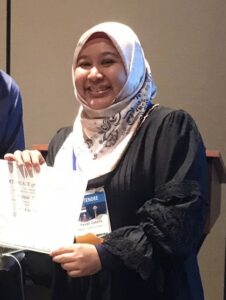
Immersed in the World of Pencak Silat Bawean Dheun: SE3233 Students Experience Martial Arts Mastery!
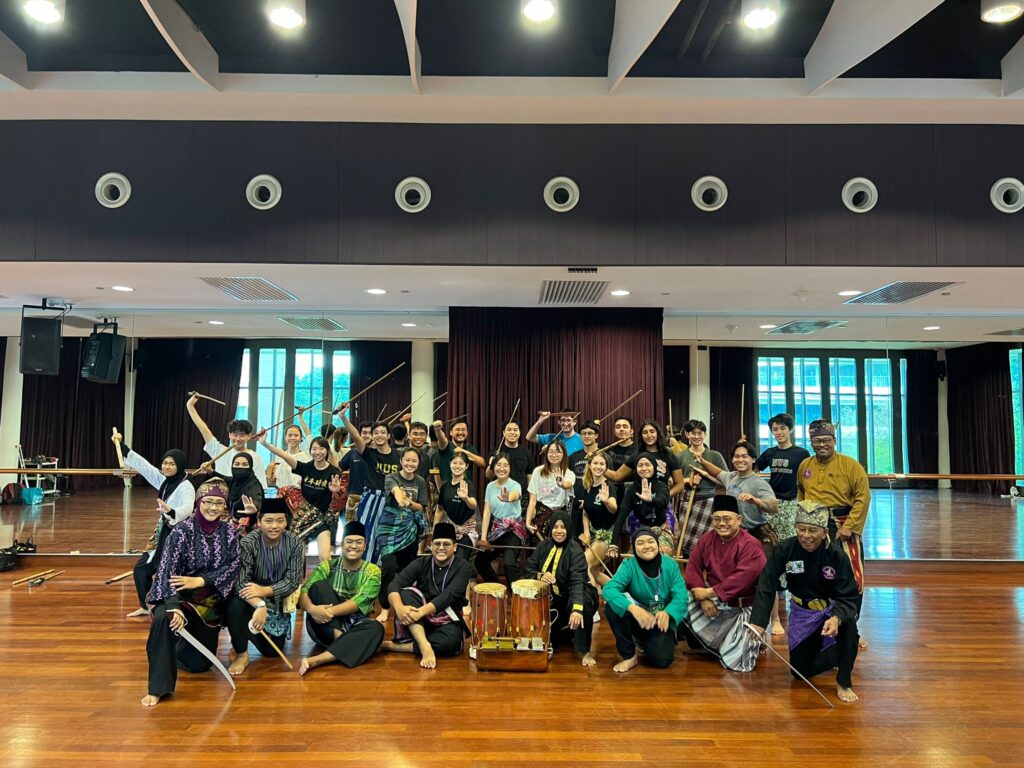
Dr Serina Rahman's NGO, Kelab Alami, Wins The Hornbill Award 2023 for Conservation Efforts
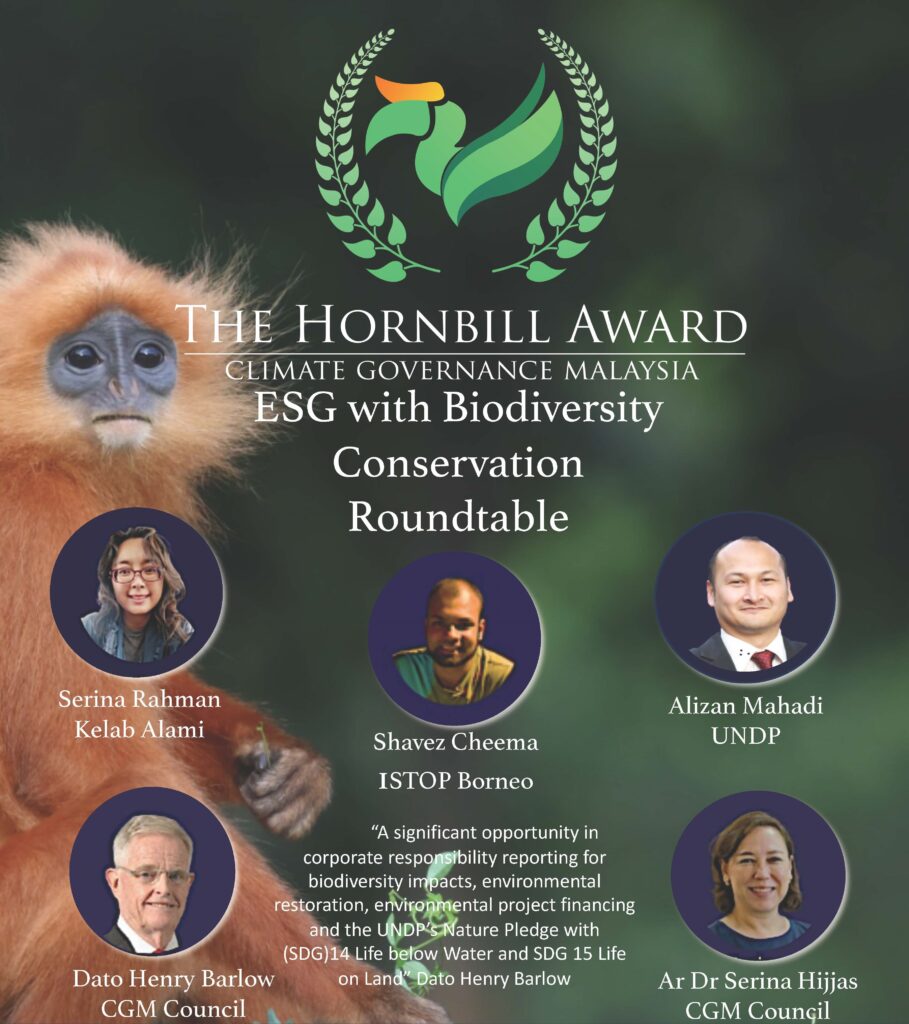
View the Award Presentation here: https://youtu.be/sgCJAf8tnk8?si=AKBgSuhYrT_J_jJ4
Dr Serina Rahman's non-governmental organization (NGO), Kelab Alami, has been honored with The Hornbill Award 2023. The Hornbill Award, established in 2021, spotlights conservation efforts aimed at preserving and managing biodiversity and natural resources in the face of pressing environmental challenges.
Dr Serina Rahman, in light of this achievement, discusses strategies to tackle the diverse challenges posed by climate change on Malaysian artisanal fishing communities. These communities play a pivotal role in maintaining livelihoods, preserving heritage, and ensuring seafood sustainability.
Emphasizing community empowerment and sustainable initiatives, Dr Serina advocates for seagrass conservation and advocacy programs as effective measures to protect both the environment and the livelihoods of fishermen. By focusing on enhancing income opportunities and preserving traditional practices, Dr Serina aims to secure economic viability while safeguarding marine ecosystems for future generations.
Assistant Professor (Southeast Asia: Digital Studies, STS, Economics and/or Religious Studies)
The National University of Singapore is seeking to fill a tenure-track position at the level of Assistant Professor in the Department of Southeast Asian Studies. We are particularly interested in recruiting scholars who will enjoy the opportunity of working collaboratively with colleagues from different disciplines. The Department is the only Southeast Asian Studies department at a world-class university located in Southeast Asia itself, a distinction that provides faculty with unique research access as well as ensuring a highly diverse student body. We seek a scholar who specialises in one or more of the following fields: digital and media studies (including digital humanities); science, technology, and society; economics (particularly with a focus on the political economy, ASEAN regionalism and/or China-Southeast Asia relations), and/or religious studies. The disciplinary focus is broad, as we are particularly interested in applicants whose research and teaching are multi- or inter-disciplinary. Priority will be given to applicants with a regional focus on Mainland Southeast Asia or the Philippines. Candidates should have expertise in Southeast Asian languages relevant to their research. The successful applicant will be expected to take up the position by January 2025 at the earliest, or latest by August 2025.
Job Requirements and Responsibilities
Candidates should show evidence of strong teaching and publication records. In addition to teaching, the successful applicant will be expected to supervise undergraduate and graduate students.Application Process
Interested applicants should submit an application dossier consisting of the following:- Cover letter explaining your interest in the position and how your qualifications and plans would contribute to the long-term development and enhancement of the Department of Southeast Asian Studies (maximum 2 pages)
- Up to date Curriculum vitae
- Concise statement of your research trajectory thus far and publication plans (maximum 2 pages)
- Concise statement of your teaching experience and interests, as well as possible courses you are able to offer that would enrich the teaching of the Department (maximum 2 pages)
- Evidence of teaching experience (course reviews, sample syllabi, teaching awards)
- A list of three referees, including the applicant’s main PhD supervisor/advisor (names, contact details and applicant’s relationship to them). Only referees of shortlisted applicants will be invited to submit reference letters.
Application Timeline
Candidates should submit all application materials by 15 June 2024. Shortlisted applicants will be invited for a campus visit from August 2024.Other Information
Remuneration will be internationally competitive and commensurate with qualifications and experience. The successful candidate may also enjoy research funding, housing benefits, relocation allowance, and other benefits depending on the type and duration of appointment and citizenship. Successful talented early career candidates with excellent research track records may be considered for the NUS Presidential Young Professorship (NUS PYP) award. For further details, please refer to the NUS PYP website.Contact for Enquiries
Potential candidates are welcome to get in touch with the Chair of the Search Committee to answer any questions they may have at seas.recruitment@nus.edu.sgSingapore and Johor: Deep bonds inspire new wellsprings of growth
The connection between Singapore and Malaysia extends far beyond being neighbours. From economic interdependence to bilateral relations, to even being part of the same nation at one point, the relationship between the two countries is complex and multi-faceted. Despite past conflicts, Singapore and Malaysia continue to share a mutually beneficial relationship, with up to one million people crossing the land border between the two countries each day. The long queues and persistent traffic congestion can make crossing the border a pain, yet people continue to do so. In ‘Singapore and Johor: Deep bonds inspire new wellsprings of growth’ (The Straits Times, February 2024), Dr Serina Rahman (NUS Southeast Asian Studies and ISEAS-Yusof Ishak Institute) explores the unique relationship between the two cities, Singapore and Johor, discussing the history of their economic cooperation, the influx of Singaporean tourists to Johor, and the role of government in nurturing this relationship. Dr Rahman describes the layered economic relationship between Singapore and Malaysia with reference to the planned collaborations for improving economic connections. This includes the improved transport infrastructure between Singapore and Johor Bahru and the recent special economic zone (SEZ) agreements. Johor benefits not only from Singaporean tourism, but also from the large volume of Singaporean investments, as Singapore isone of its largest investors and trading partners. Dr Rahman also notes the efforts of the government is improving the economic conditions of Singapore and Malaysia. Traffic flow and the frequency of public transport between the Singapore and Johor Bahru has been heavily managed, with new immigration policies being put in place to facilitate smooth crossing over the border. The improvements are expected to continue, especially since Sultan of Johor Ibrahim Iskandar has recently ascended to the throne as Malaysia’s 17th King. The new King has established his investment in continuing to nurture the relationship between Singapore and Malaysia, through further development and initiatives in his home state, Johor. Read the article here.
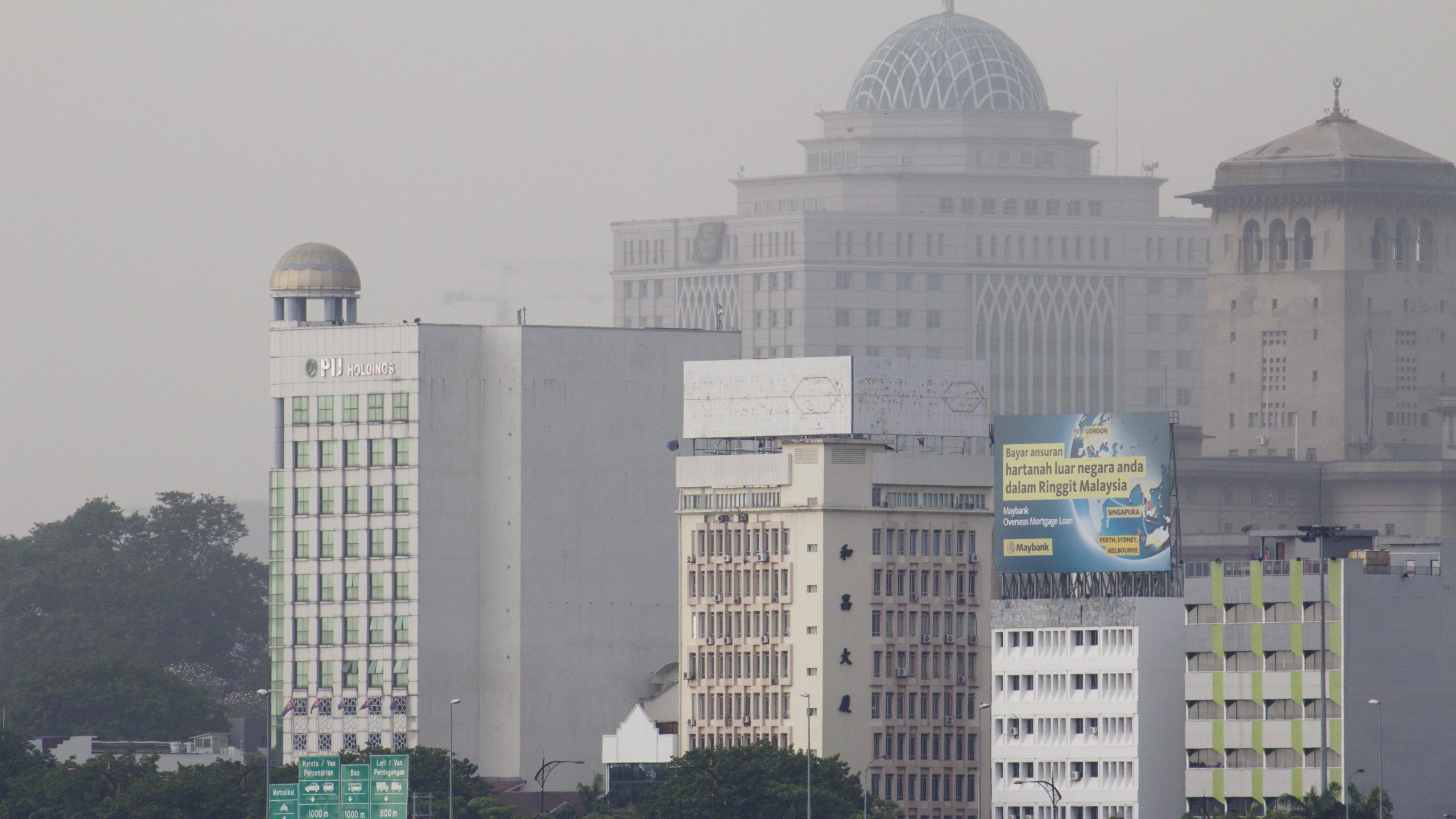
Experiential Learning in Action: Sailing from Batam to Bangka
IN BRIEF | 8 min read
- As part of the Southeast Asia Friendship Initiative, students visited local communities to glean an in-depth, first-hand understanding of the Indonesian way of life.
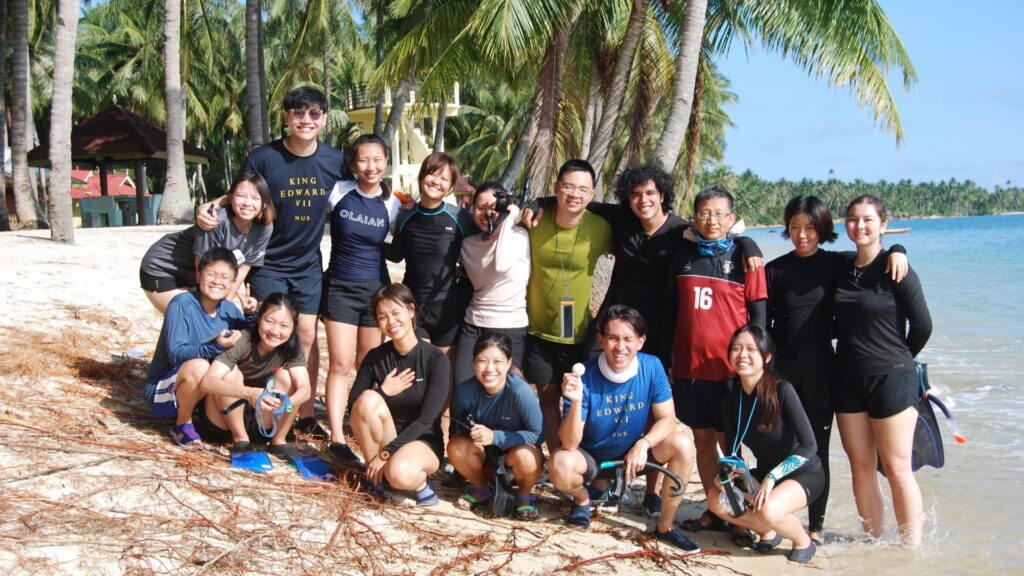
A 14-day voyage through Indonesia's Riau Islands Province to the island of Bangka in December took a group of NUS students on an adventure to get a glimpse of life in remote communities, learn about the region's economic industries, and explore environmental conservation initiatives up close - all while mastering the art of seafaring.
As part of the Southeast Asia Friendship Initiative (SFI), offered by NUS residential units to improve students' understanding of Singapore's neighbours in Southeast Asia, the SFI2014-Introducing Indonesia course was run in Semester 1 of Academic Year 2023/2024 as an introduction to Indonesian culture and politics via a six-week crash course in Bahasa Indonesia.
To complement the course, King Edward VII Hall (KEVII) organised the voyage in collaboration with Tembusu College. This experiential learning component focused on three crucial economic sectors of this region: mining, fisheries, and tourism. Maximising the students' exposure to remote communities and maritime resources, the voyage explored the industries' complex relationships with each other and how they impact the region's communities through the perspective of the United Nations Sustainable Development Goals, such as Decent Work and Economic Growth, and Sustainable Cities and Communities.
The team drew on the logistical experience from 19 previous voyages aboard sailing ships conducted by the NUS Seafarers since 2017. 12 KEVII students and six Tembusu students set sail from Batam, the most populous island of the Riau Islands Province, on 10 December 2023, accompanied by KEVII Residential Fellows Associate Professor Martin Henz and Dr Wu Jinlu, Tembusu College Residential Fellow Mr Shamraz Anver, Ms Sarah Chong of the Department of Southeast Asian Studies at the NUS Faculty of Arts and Social Sciences, and NUS Seafarer alumnus Li Xi Yuan (Class of 2024, Computer Engineering).
The two sailing ships, the Four Friends and the Rona, made stops along the way to the islands of Buluh, Bintan, Benan, Sebangka, Benoh, Gojong, Singkep, Pekacang, and Cebia, before arriving at Bangka, the largest island of the province Bangka and Belitung, on 21 December.
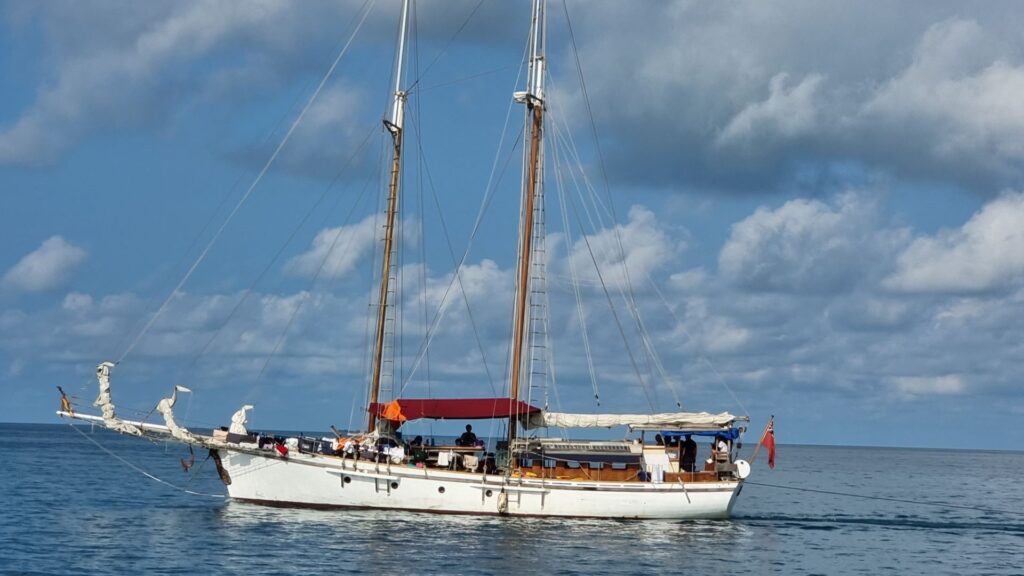
Benefitting from extensive collaborations established on previous NUS Seafarers voyages in this region, the team invited Mr Fazham Fadlil, fondly known as Pak Sam, aboard the 1998-built schooner Four Friends, where he introduced the students to the unique culture of his native island of Buluh, situated a stone's throw west of Batam. Pak Sam also led an onshore excursion to the site of a refugee camp from the Vietnam War era on the island of Galang, south of Batam, where students were immersed in the rich history of the location that has withstood the test of time.
The voyagers were also joined by students and staff from Universitas Maritim Raja Ali Haji (UMRAH), a university in Tanjung Pinang, who organised a visit to a fish farm near Pengujan on Bintan island where the group learnt about the economic and cultural importance of fishing as a means of livelihood in the region.
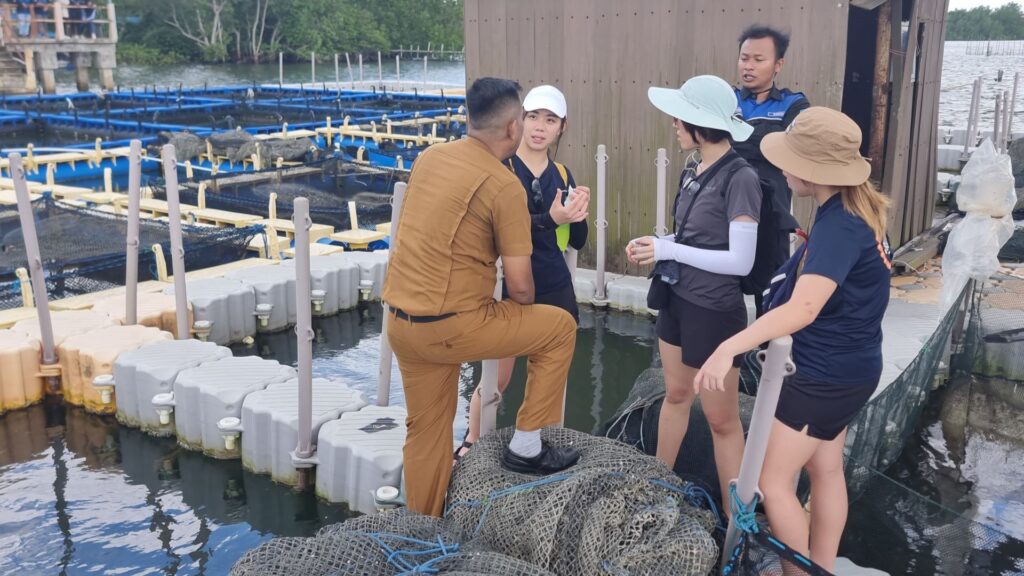
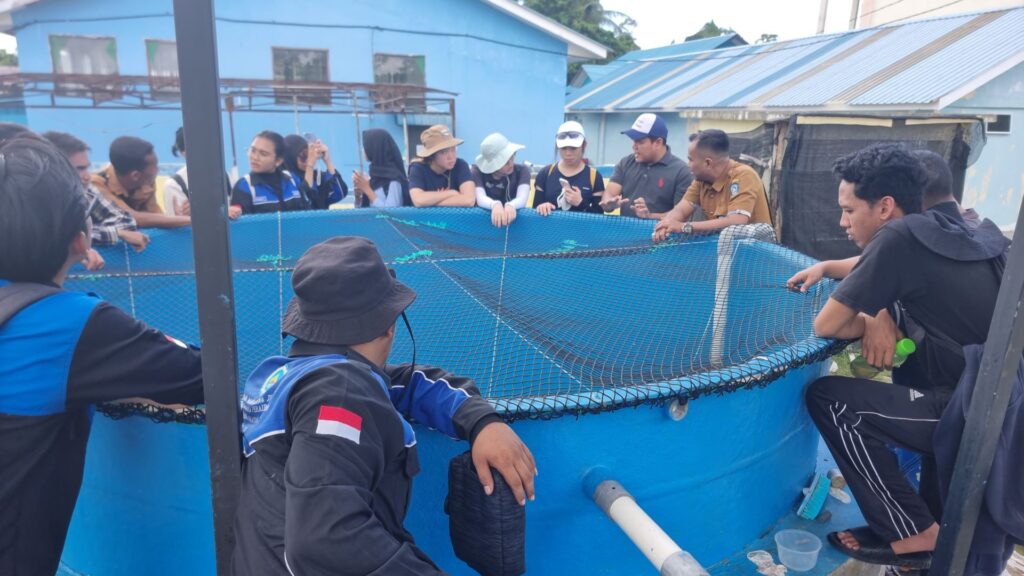
On the east coast of Bintan in Kawal, they also heard from two UMRAH students, Sintana Tri Yuniar and Dedi Kurniawan, about their university's mangrove restoration efforts in the area. Sandy runoff from a large bauxite mine situated in the immediate vicinity of these extensive mangrove forests, kelp forests and coral reefs have endangered these vulnerable ecosystems, explained Mr Elyas Purwanto, a manager at the LooLa Adventure Resort. The resort is one of two eco-resorts coexisting with the mine and the local fishing communities near Kawal.
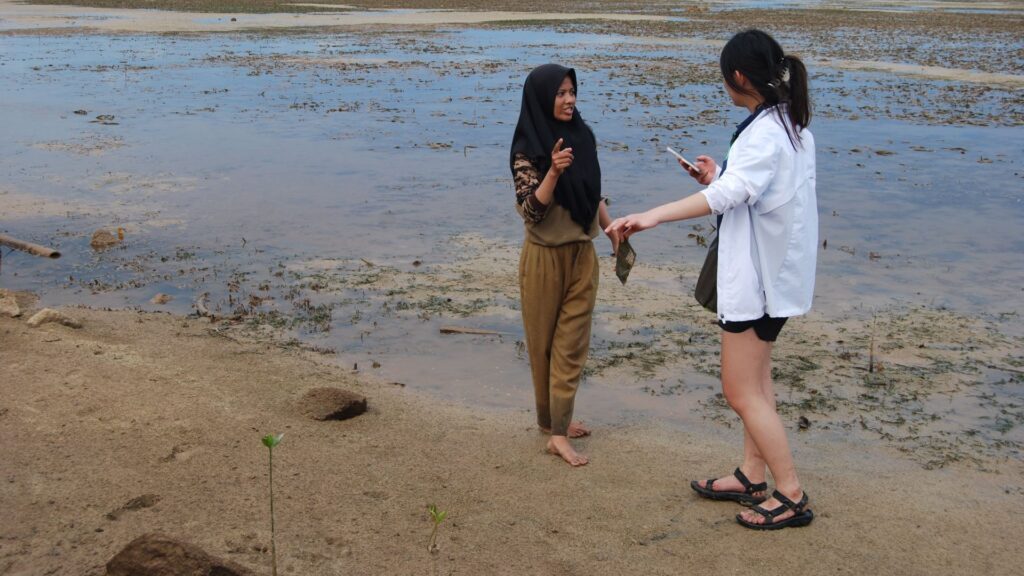
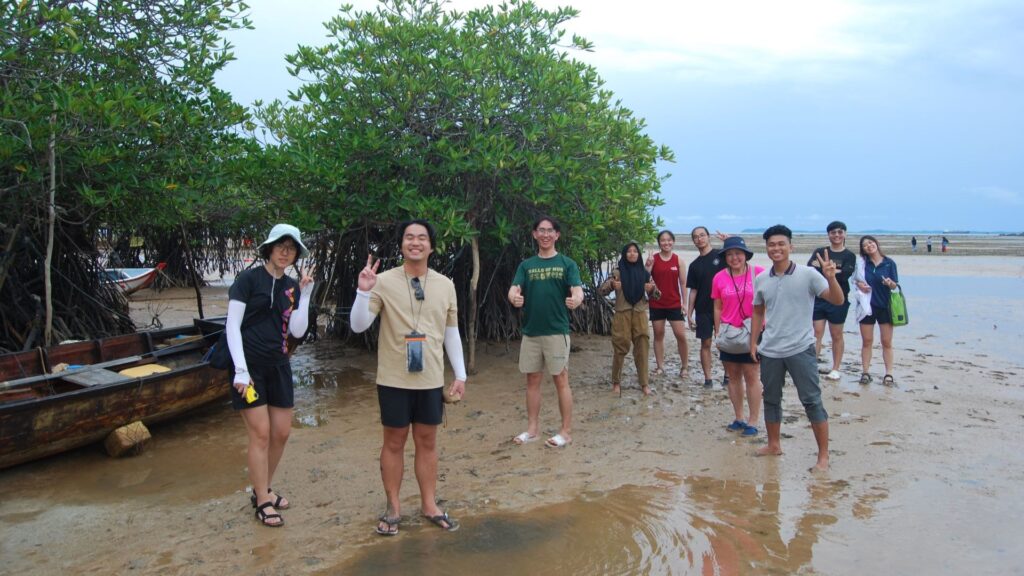
Sailing downwind from Buluh and Bintan, the two vessels reunited near the fishing and resort island of Benan. There, the students were taught to snorkel by Captain Warren Blake, owner of the Four Friends, and participated in a tour of the Benan Island Resort where they learned about the impact of the COVID-19 pandemic on the local tourism businesses and the efforts by the resort to reach out to new customers.


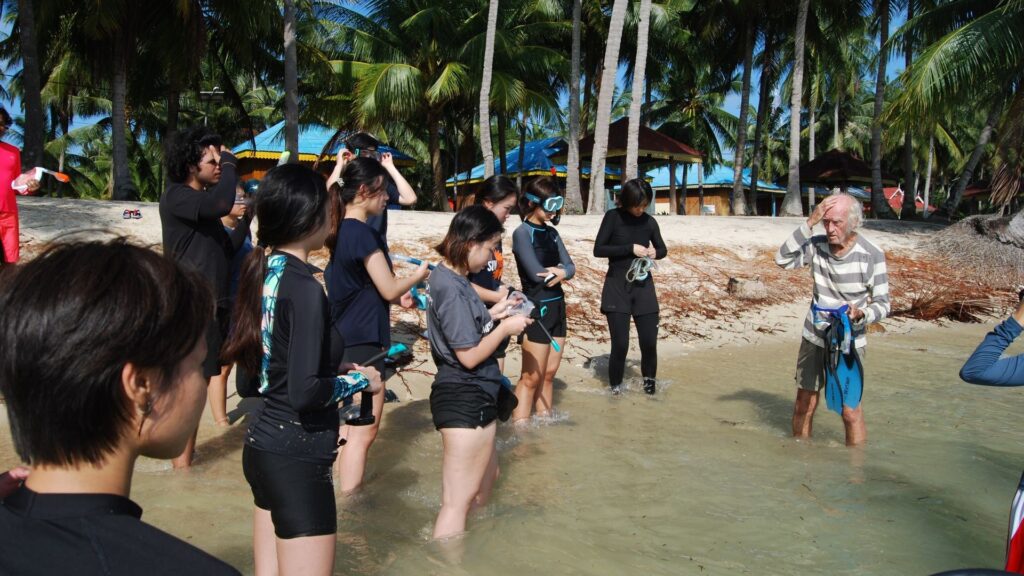

On the next stop, at Pulau Sebangka, the team explored a mangrove estuary by kayak, toured an artisanal charcoal factory, and visited a fishing community.
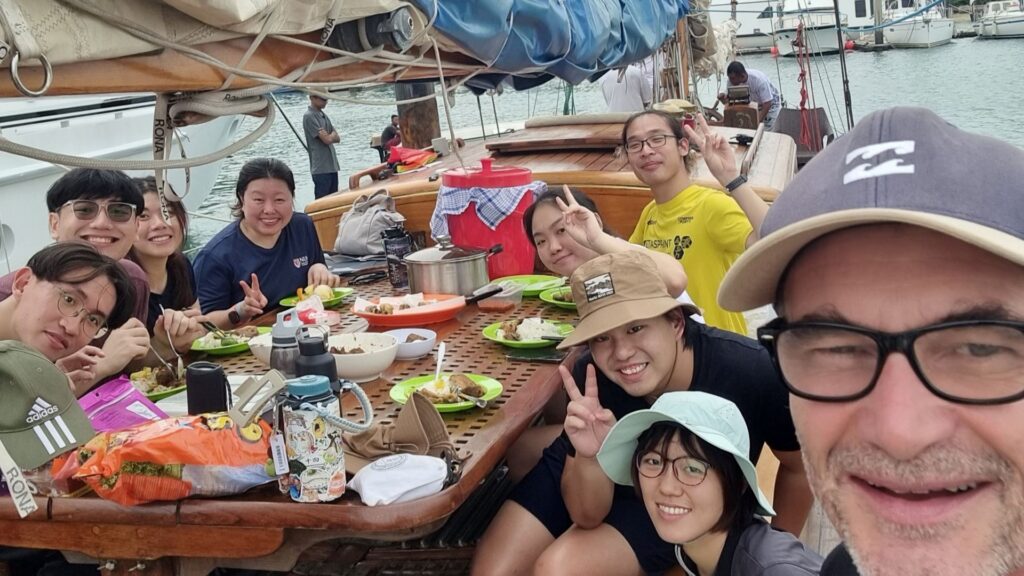
Sailing onwards, the voyagers got the opportunity for a homestay on Pulau Benoh, which specialises in offering recreational fishing to domestic and international tourists, as well as more coastal kayaking and snorkelling activities on Gojong island, located east of Pulau Benoh.
A visit to Dabo, a market town on Singkep in the southern Riau Islands, also gave the students a striking impression of the Chinese diaspora of the region and provided opportunities to recover from the physical demands of sailing at two popular local attractions in the Singkep hillsides: the cool waterfall of Batu Ampar and the hot springs of Wisata Pemandian.
After 12 hours of sailing downwind from Dabo in the strengthening North monsoon, the ships reached Pulau Cebia, the only inhabited island of the Tujuh islands. The village on Cebia, with a population of 535, is one of the region's remotest communities. The elected village leader gave the team a tour of the island, introduced them to his family and explained the challenges of living on such an isolated archipelago. The team learned of the necessity of largely self-sustained life in such remote locations and the opportunities and challenges the community is facing in their attempts to attract tourism.
The visit to their final destination, Bangka, saw students explore a local industry dominated by mining activities. The team started with a visit to a tin museum, where Mr Suwito Wu, their guide and a leader of the Mentok Chinese diaspora, introduced them to the owner of a vast open-pit tin mine. As they toured through the grounds of the mine where the owner lives with his family, the students learnt about the mining process, which uses large amounts of rainwater to separate the tin ore from the reddish sand.

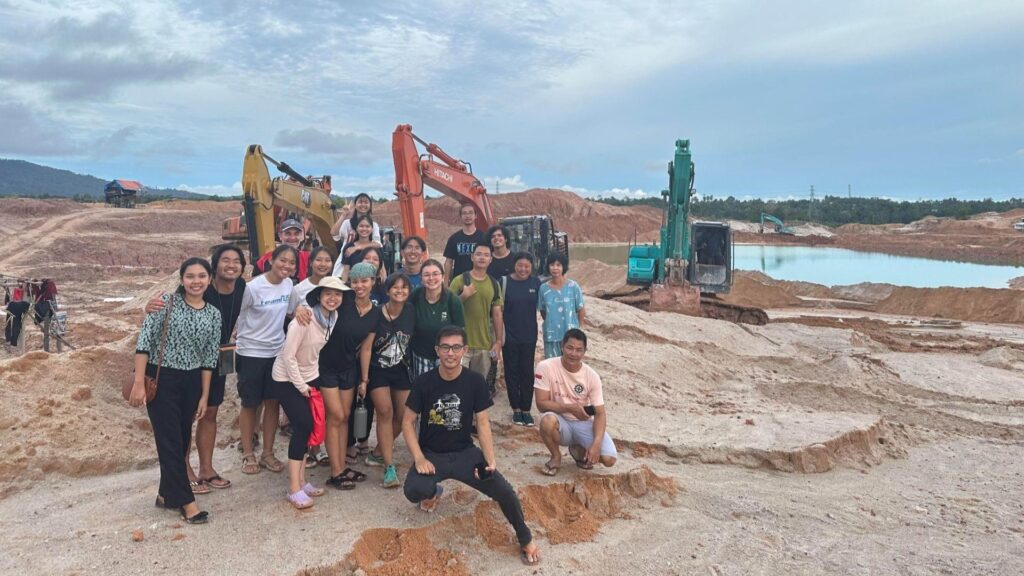
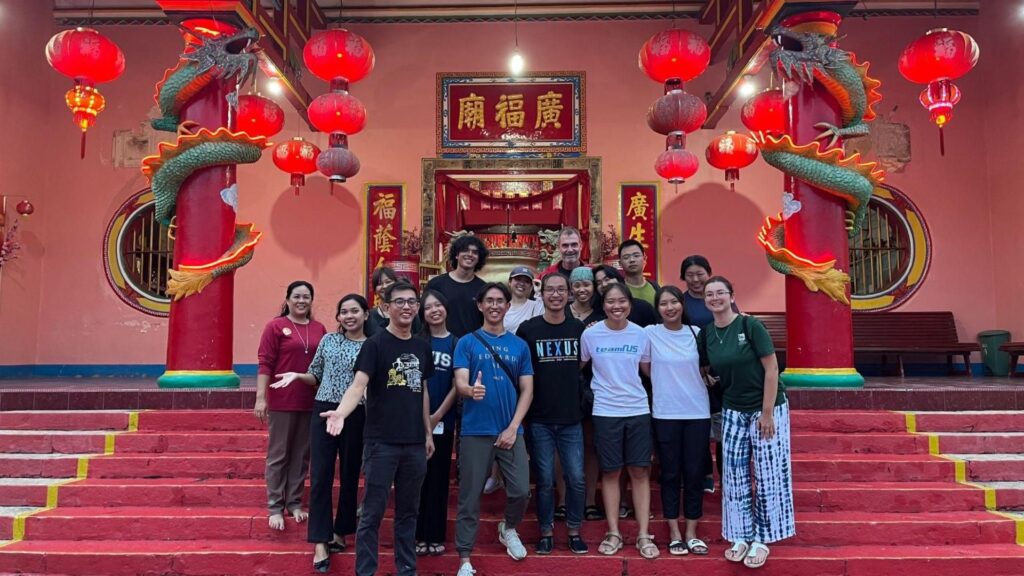
On the final day of the academic programme, the team crossed northern Bangka in vans to reach the coastal town of Sungailiat in the northeast. Their host, Mr Sandy Pratama from Universitas Bangka Belitung (UBB), led them on a tour of an area in which extensive offshore industrial mining, as well as artisanal tin mining, coexist alongside commercial and subsistence fishing and international and domestic tourism. The visit to UBB at Pangkalpinang, the capital of the Bangka and Belitung province, complemented the students' understanding of the complex interactions and competing demands of these economic sectors.
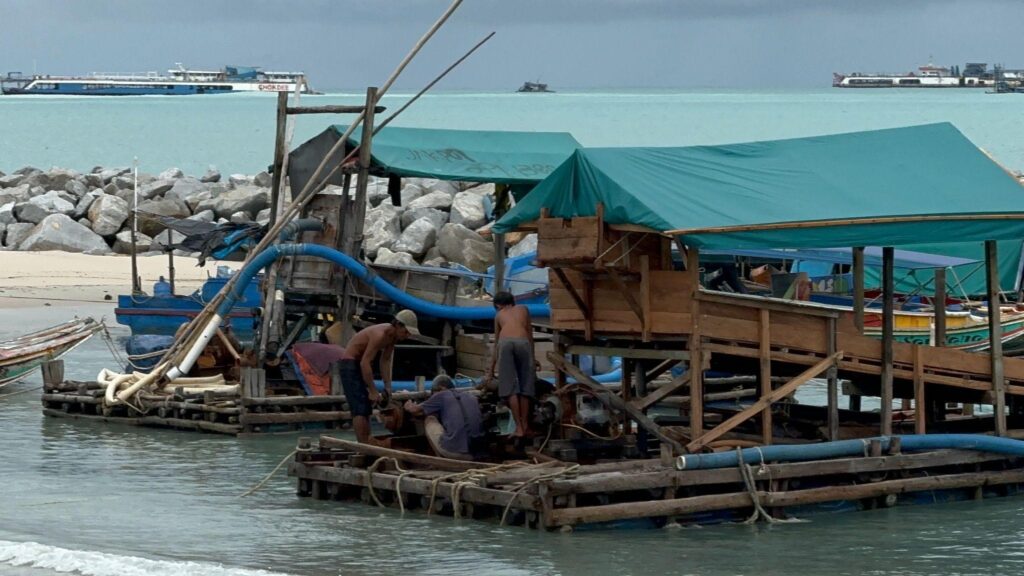
The KEVII and Tembusu team returned to Singapore on 23 Dec 2023 with their memories, notebooks and cameras filled with impressions, photos and video footage, rich resources for the post-trip thematic reports, travelogues, and videos that constitute the academic deliverables of the experiential learning component of the SFI course.
Watch the voyagers' experiential learning adventures here.
This story by Associate Professor Martin Henz, NUS School of Computing and Resident Fellow at NUS King Edward VII Hall first appeared in NUSNews on 5 February 2024.
Malaysia Must Act More Swiftly to Conserve Environment and Build Resilient Communities
IN BRIEF | 10 min read
- An Op-Ed in Suria News Online by Dr Serina Rahman (NUS Southeast Asian Studies).
Click through image below to read this piece.
This article first appeared in Suria News Online and on NUSNews on 4 February 2024.
Singapore and Johor: Deep Bonds Inspire New Wellsprings of Growth
IN BRIEF | 10 min read
- An Op-Ed in The Straits Times by Dr Serina Rahman (NUS Southeast Asian Studies).
Click through image below to read this piece.
This article first appeared in The Straits Times and on NUSNews on 2 February 2024.
Exploring Arts and Culture in Yogyakarta: A Transformative Fieldtrip Experience for SE2214 Students
During the September mid-semester recess, a group of students travelled for a week-long fieldtrip to Yogyakarta, Indonesia, as part of SE2214, “Beyond the Frame: Arts and Lives in Southeast Asia,” taught by Jan Mrazek (Department of Southeast Asian Studies), an expert on Southeast Asian and particularly Javanese arts, as well as a practicing performer of traditional music and theatre.
The Yogyakarta area is the site of ancient Hindu and Buddhist temples (the World Heritage sites Borobudur and Prambanan are among the most famous, but there are many more), and it is a vibrant centre of both traditional and contemporary arts. Situated between the imposing volcano Mount Merapi and the Southern Ocean, the city is centred on the massive kraton, the palace, which serves as the residence of the ruling sultan as well as a space of various living traditional arts and culture.
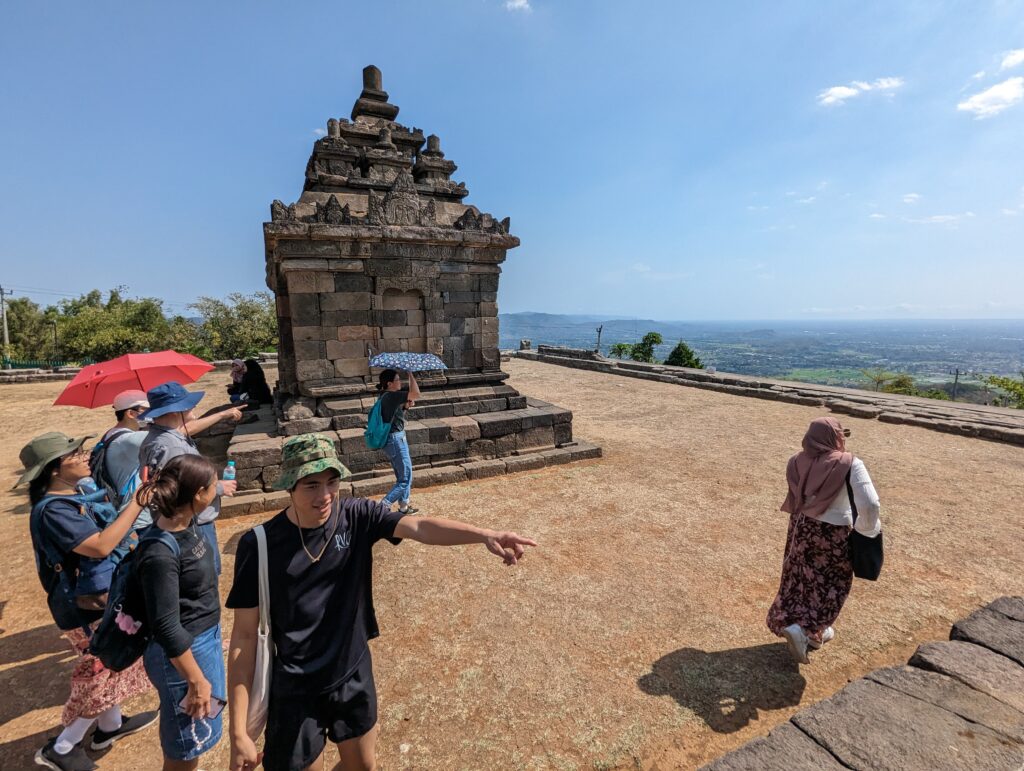
On the fieldtrip, the emphasis was not only on visiting cultural sites, but also meeting and learning from various “artsy” people and on experiential learning. We also worked with a group of students from the local university, who participated in some of our activities. Our students got to know the city and the people; they visited the temples, batik shops, the palace, museums, art galleries, artists' studios, and a community cultural/art centre. They also attended performances. During these activities, they were meeting both "traditional" and "contemporary" artists, curators, community arts activists, and other people involved with the arts.
Among the highlights were a number of workshops, where the students had a chance to get an hands-on experience of making Javanese batik and shadow puppets, and of learning Javanese dance, with a brief performance at a community arts centre. Before the trip -- during the first half of the semester -- they had studied playing Javanese gamelan music, using the SE Asian Studies’ own set of instruments; and in Yogyakarta, they accompanied a short performance of the shadow puppet theatre, which was open to public and broadcast live “to the whole world.” There was of course free time to enjoy the day- and night-life, sample local and localized cuisine (such as the amazing chilli-chocolate ice cream), as well as to work in small groups on research projects, which emphasized reflection on first-hand experience and creativity in presentations. Embark on a visual journey! Click Here to explore more captivating moments from our unforgettable fieldtrip. ??
Inclusive Sustainability Immersion in Mukim Tanjung Kupang, Johor Malaysia.
Inclusive Sustainability Immersion in Mukim Tanjung Kupang, Johor Malaysia.
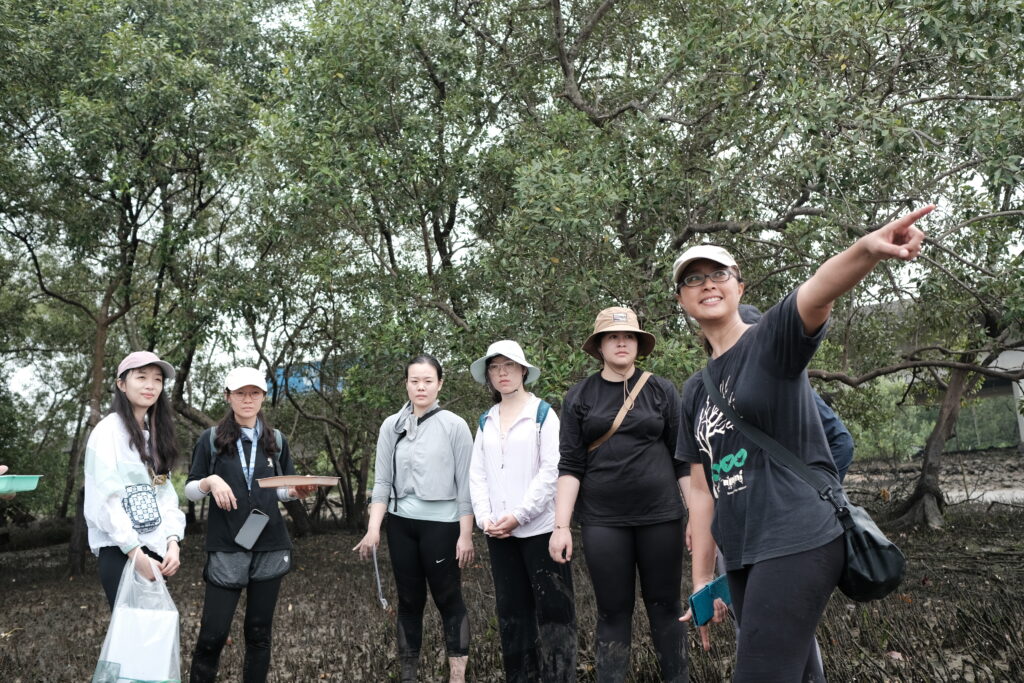
As part of the unique options offered by the MA in Contemporary Southeast Asia, a matching module to the Gamelan Masterclass is the 2-course credit Field Trip that takes place in the second semester.
This field trip takes postgraduate students to a string of fishing villages in the western Tebrau Strait, between Singapore and Malaysia, where they will meet and engage with the community of Mukim Tanjung Kupang. This is an unparalleled opportunity to get to the ground to learn about changes that this community has had to undergo as a result of development and climate change impacts in their neighbourhood. It is, however, just one example of myriad communities across Southeast Asia facing the same dilemma.
This case study, however, is made accessible to students through this immersion, which is also a unique opportunity to get deep amongst Malaysian rural locals and their lives and livelihoods far from the regular tourist trails.
The fishing community in this sub-district is bound on all sides by escalating development. This comes in the form of urbanisation in the form of luxury residential and business development projects, and industrialisation such as factories and the Port of Tg Pelepas. There is also an impact on their natural habitats as a result of coastal development along the Tebrau Strait, both on the Malaysian and Singapore coasts.
The field trip allows students to see first-hand the impacts of climate change and development on rural communities, as well as maritime transnational landscapes and fluid borders.
Students will get first-hand experience at life in a fishing village and attempt to use some of the equipment (nets/traps) to catch their meals, as well as begin to understand how these communities that supply seafood to the rest of Malaysia (and beyond) suffer from dire economic situations themselves.
As an introduction to the local natural habitats, they will visit a seagrass meadow and mangrove forest, both at risk of being lost to coastal development, and learn of their importance to the community and the environment as a whole. In contrast to these natural areas, they will also be brought to Forest City – a majority-Chinese owned luxury and mixed-use development that landed on this community in 2015.
The visit to the local community will also include cultural aspects such as an introduction to local Chinese history (including information on the Japanese massacre of residents during World War II), and a traditional dance form called zapin that originated in these villages. They will also get to eat locally harvested seafood with the fishermen and other villagers in their home.
While this excursion will push students’ boundaries in the mud, seagrass and natural elements, the outcome will be extremely rewarding. Past students’ testimonials provide proof that it is an opportunity not to be missed.
Past student testimonials: The field trip is an important method of research. It is useful for master students to experience it and learn from the reality rather than only from the papers and books. (Bing Ying) The field trip added value to my MA course because I got close to the nature, it let us realize how amazing those habitats are and how seriously they are damaged, and improve our awareness of protecting the environment. (Jieting) A field trip is always the best way to get more knowledge. Rather than reading a hundred readings, I might as well experience and feel more in an only-three-day field trip. what i smelled, what i felt and what i touched were staying in my memory longer. (Xueying) This was beyond “usual field trip” that i got to experience in NUS so far. I was able to learn a lot more pragmatically from touching, feeling and smelling than just reading in classes. Also visiting a fishing village is not something I can do in foreign countries especially when I don’t speak their language. And there are many things that I couldn’t have known unless they explained to me. ALSO I appreciate that we could join a Ramadan dinner. It was a whole new experience. So it’s really one of the most memorable experience in NUS. (Mahiro) The field trip brought some of the things we learned and studied much closer. It allowed us to see some of the theories and concepts we studied in person, which would be impossible to do in Singapore. (Nina) YES the fieldtrip added value to the MA course. Because if not for this opportunity, through personal travel I would not have gone to the countryside of Malaysia. (Zhi Zhi) The field trip added value to my MA programme. It helped me understand and appreciate marine and coastal biodiversity even more, and provided me with a unique opportuntiy to witness and therefore understand the range of environmental sustainability challenges the local people and their surrounding flora and fauna need to cope with due to large-scale human activites. (Kata) Explore the full gallery of fieldtrip moments! Click Here to view more photos. ?Forest City is Awakening, with New Settlers of an Unexpected Kind
IN BRIEF | 10 min read
- Op-Ed in The Straits Times by Dr Serina Rahman, NUS Southeast Asian Studies.
Click through image below to read this piece.
This article first appeared on The Straits Times and NUSNews on 28 December 2023.
Whitewashing of Malay Supremacy in Malaysia’s Progressive Intellectual Culture
IN BRIEF | 15 min read
- Column in Suria News Online by Ms Fadiah Nadwa Fikri, a PhD candidate from NUS Southeast Asian Studies.
Click through image below to read this piece.
This article first appeared in Suria News Online on 10 December 2023 and NUSNews on 11 December 2023.
Launch of New Book on Southeast Asia’s Local and National Cultures by University Professor Wang Gungwu
IN BRIEF | 9 min watch
- Coverage of the launch of the latest book by Professor Wang Gungwu (NUS History and Chairman of the East Asian Institute) on Southeast Asia's local and national cultures.
Click through image below to read this piece.
This article first appeared in NUS News and The Straits Times on 6 December 2023.
NOTE FROM KL: Southeast Asia at Risk of Being Severely Affected by Climate Change; COP28 Must Act Immediately
IN BRIEF | 9 min watch
- An Op-Ed by Dr Serina Rahman, Lecturer from NUS Southeast Asian Studies in Suria News Online on 4 December 2023.
Click through image below to read this piece.
This article first appeared in NUS News and Suria News Online on 4 December 2023.
Learning about Southeast Asian History and Culture through Balinese Dance
IN BRIEF | 5 min read
- Students from SE2224: Unmasked: An Introduction to Traditional Dance in Southeast Asia performed "Sutasoma: The Journey", a mesmerising rendition of the Balinese literary classic. This marks a pioneering showcase of the tale in the Topeng Prembon genre.
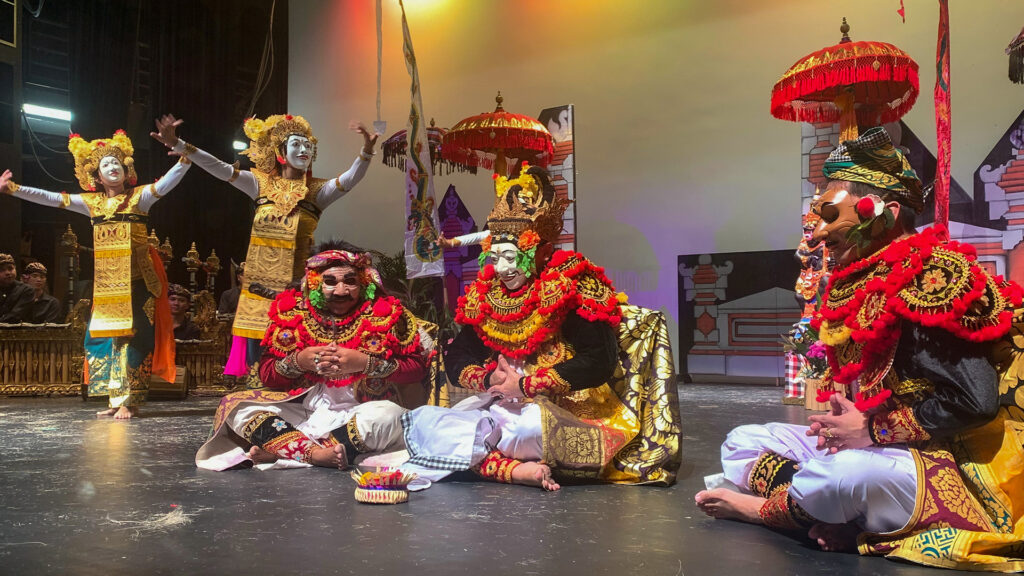
It was a feast for the senses from the moment the performance began. Buoyed by the melodious, almost hypnotic, Balinese gamelan music, actors - some wearing beautifully carved masks - moved and sang in a wonderful blend of Old Javanese, Balinese, Bahasa Indonesia and English as they took centrestage to perform "Sutasoma: The Journey" - a 14th-century Javanese poem depicting Buddhist prince Sutasoma's journey towards enlightenment and the obstacles he encounters along the way with his eclectic group of friends: a tiger, a dragon and a flesh-eating elephant-headed demon.Directed and produced by NUS Southeast Asian Studies' Associate Professor Irving Johnson, this Balinese dance drama showcases a timeless story woven around the theme of kindness and compassion for all living things. The performance is the fruitful cap to the SE2224 course he teaches at the Department of Southeast Asian Studies. The show was notably the first time that the story of Sutasoma was performed as Topeng Prembon - a Balinese dramatic dance presentation that involves masked and unmasked actors.
Titled "SE2224: Unmasked! An Introduction to Traditional Dance in Southeast Asia", the non-examinable course introduces students to classical Southeast Asian dance with a particular emphasis on masked dance traditions. Through the analysis of scholarly texts, videos and hands-on sessions, students are taught how to appreciate classical dance traditions in the region from a variety of angles, such as dramaturgical principles, music, aesthetics, ritual significance and change. Students will also have to participate in an organised field trip and perform in a staged performance at the end of the course. Open to all NUS students, the course is available in the first semester of each academic year.
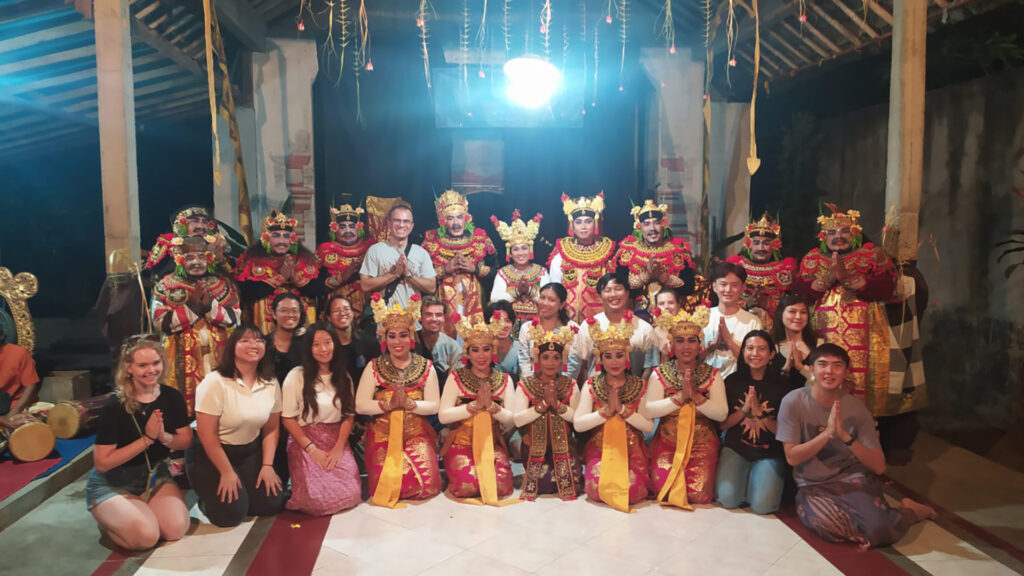
"In SE2224, we dissect the meaning of 'tradition' and study dance in Thailand, Malaysia, Indonesia and Singapore. Take Singapore for example. We discuss how occasions like Chingay, the People's Association and the National Arts Council are instrumental in constructing new 'traditions'. We also examine how the Association of Southeast Asian Nations as a bloc impacts dance traditions in the region," said Assoc Prof Johnson, who is himself a Balinese dancer and Thai mural painter.
He added, "This year, Bali was the case study for learning about dance in Southeast Asia. Topeng Prembon was the genre of Balinese dance we chose for Sutasoma."
A Field Trip to Better Appreciate Balinese Culture, History and Dance TraditionsFor a full immersion into Balinese dance traditions, Assoc Prof Johnson brought all 14 SE2224 students for an experiential seven-day field trip to Bali. They took dance lessons every morning from local teachers, visited religious, cultural and historical sites such as the 1,000-year-old temple in the village of Batuan, and the old palace at Klungkung where they saw first-hand the paintings of the story of Sutasoma to better appreciate Balinese dance and the drama they were performing.
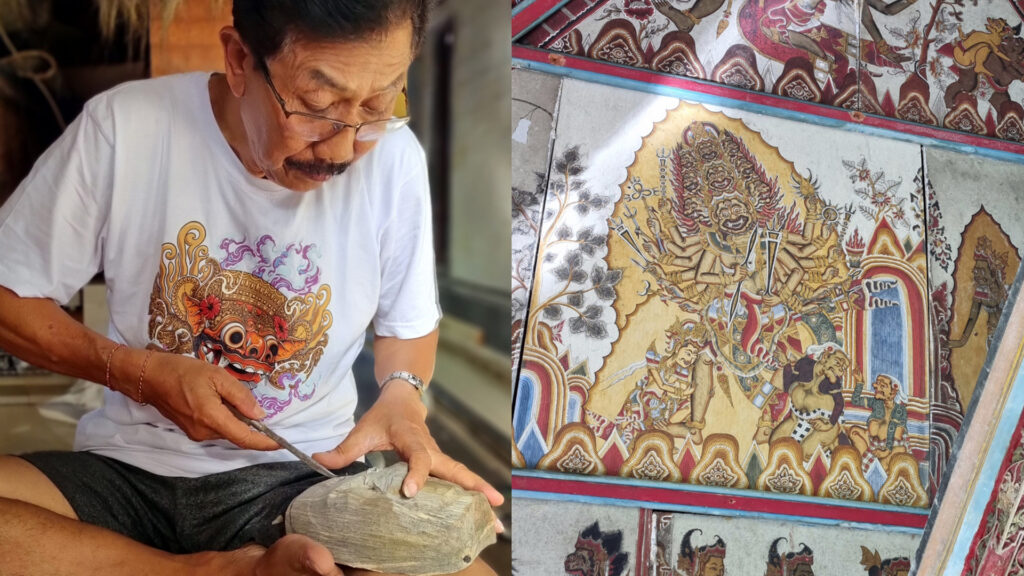
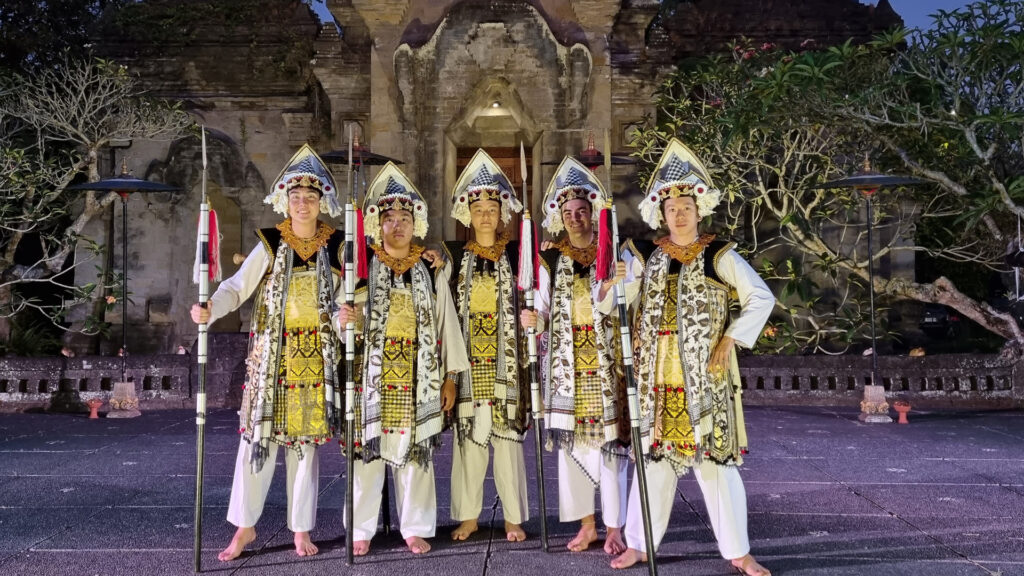
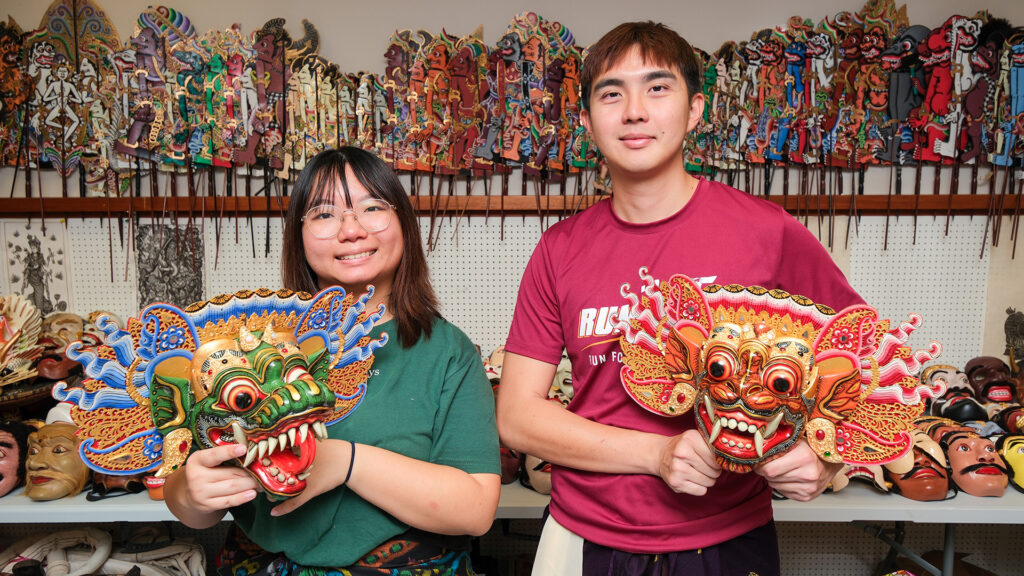
Chai Jia Xin, a third-year NUS Nursing student observed, "After watching several Balinese performances during the trip, I discovered that their style of art feels more intimate. Unlike seats in a theatre, the audience is seated on the ground with nothing physically separating the performers and the audience. The gamelan musicians also laughed at jokes or spoke to each other while the show was ongoing. It was an eye-opening and wonderful experience."
Offering another perspective, FASS fourth-year student Timothy Timuari shared, "Almost all of us have no experience in traditional dance. I chose to take SE2224 because it exposed me to ethnography. By fully immersing myself in a Balinese village with the folks there, I experienced so much about Balinese culture and learnt quite a bit about life. This is not something that readings can teach."
A Unique Course that Offers Important Lessons
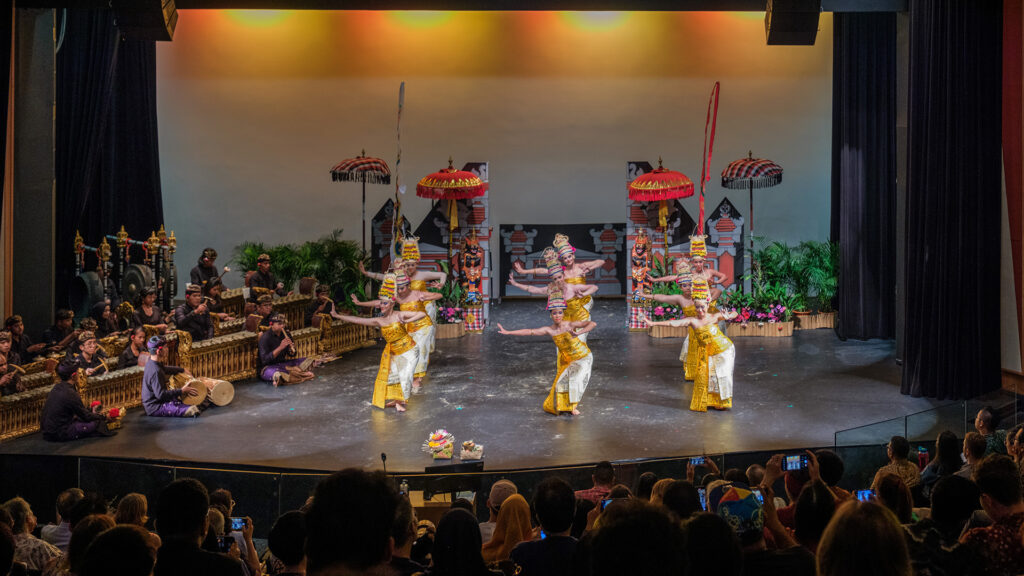
The sound of appreciative applause from a 280-strong audience rang loud and clear as Sutasoma came to a moving close. From the stands, it was apparent that the student performers as well as the rest of the cast enjoyed themselves throughout the three-hour spectacle. Indeed, the production was a truly collaborative one as it not only involved alumni from the Department of Southeast Asian Studies but also professional dancers and musicians from the Balinese dance and music community in Singapore and Bali.
This cross-cultural experience was not lost on anthropology exchange student Pablo López Basurco who played the role of the elephant-headed demon or Gajah Waktra. "If you'd asked me in August, I would never have thought I would travel to Bali to learn how to dance and perform in Singapore. I study in the Netherlands and I could never imagine a project like this taking place there. This is truly a unique experience."
Assoc Prof Johnson shared, "With this class, I wanted to show students that dance is just as relevant a subject as any of the other disciplines. To dance is to be human and the SE2224 course not only teaches us important things about our bodies, our mind and our community. It also teaches us about happiness, respect and patience. These are precious lessons that my students will carry with them long after their university days."

This story first appeared in NUSNews on 23 November 2023.
NUS Alumni Awards 2023: Celebrating Outstanding Changemakers and Trailblazers
IN BRIEF | 8 min read
- NUS honoured the achievements of 21 outstanding alumni and three alumni teams comprising another 14 alumni, at the prestigious NUS Alumni Awards 2023.

Twenty-one individual alumni and three alumni teams, comprising another 14 individuals, were honoured at the NUS Alumni Awards 2023 on 2 November.
Now in its 10th edition, the biennial NUS Alumni Awards recognise alumni who have distinguished themselves through significant and impactful contributions to their alma mater, society and the world.
Speaking at the celebratory event, NUS President Professor Tan Eng Chye noted that the award recipients have, “not only found success in their respective fields, but elevated what it means to be an alumnus or alumna of our institution: their achievements have enriched our culture, advanced our science, deepened our humanity, and bettered our society”. Read Prof Tan's speech here.
Eminent Alumni AwardThe Eminent Alumni Award was conferred on Mdm Halimah Yacob, former President of the Republic of Singapore, for her achievements in public service, as well as her exemplary service to the University as the former Chancellor of NUS from 2017 to 2023. Mdm Halimah Yacob
Mdm Halimah graduated in 1978 with a Bachelor of Laws from the University of Singapore and obtained her Master of Laws from NUS in 2001. She spent 33 years with the labour movement, rising to become Deputy Secretary-General of the National Trades Union Congress (NTUC). In 1999, she became the first Singaporean elected to the International Labour Organisation (ILO), where she served for 12 years, representing workers globally. She entered politics in 2001, serving as a Member of Parliament until 2017. In a career filled with firsts, she became the first woman appointed Speaker of Parliament in 2013; and the first woman to be elected President of Singapore in 2017, a role she held until 2023. For her service, she was conferred the Order of Temasek (With High Distinction), the nation’s highest civilian honour, this year.
As Chancellor of the University, Mdm Halimah conferred close to 76,000 undergraduate, master’s, doctorate and honorary degrees over six years, and presided over the Main Commencement ceremonies for graduates and honorary graduates. She also graced various NUS events, including NUSSU Rag & Flag Day 2018, NUS Bizad Charity Run 2020, the Bukit Timah Homecomings of 2018 and 2022, the Institute of Policy Studies’ Women’s Conference in 2021, and the 52nd UM-NUS Inter-University Tunku Chancellor Golf Tournament in 2023.
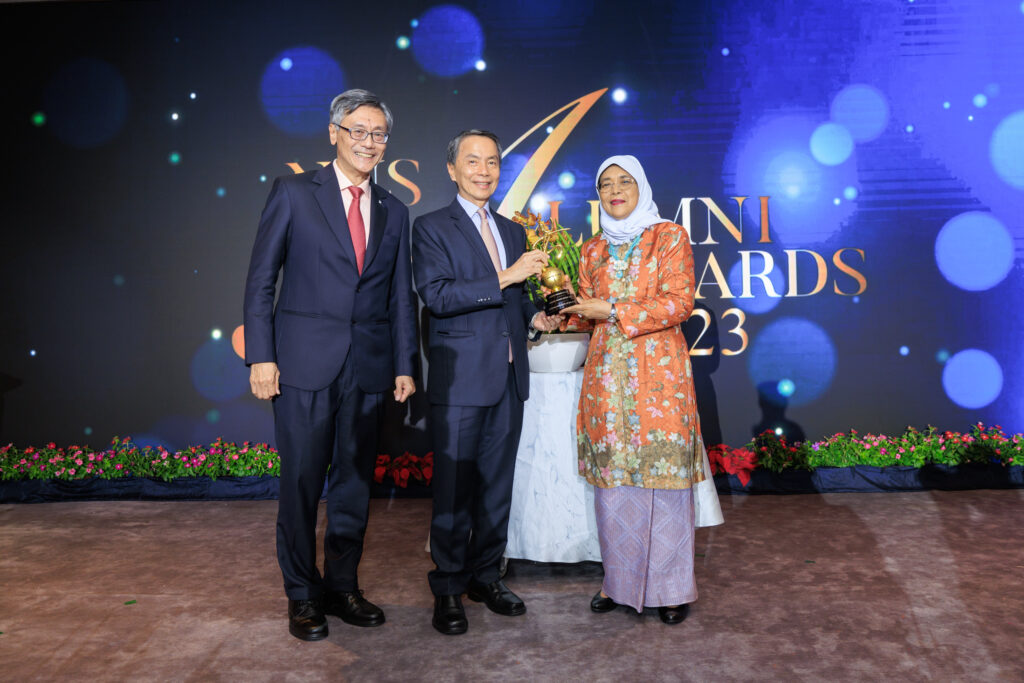
Delivering the citation for Mdm Halimah’s conferment, Prof Tan commended Mdm Halimah as an “inspiring leader” and “trailblazing alumna”, noting her “unwavering dedication to advancing the lives of individuals and communities, particularly the underprivileged”. Read the citation here.
“I am deeply honoured to receive the Eminent Alumni Award from my alma mater. NUS has played a formative role in my life, shaping not only my academic development but the values I have carried throughout my career,” said Mdm Halimah.
Watch this tribute video on Mdm Halimah’s contributions to the University and Singapore.
Distinguished Alumni Service AwardEight NUS alumni were conferred the Distinguished Alumni Service Award for their achievements in their chosen fields, as well as their excellent volunteer service to NUS, its predecessor institutions and/or the community.
These award recipients were:
- Professor Kishore Mahbubani (NUS Philosophy '71), Distinguished Fellow at NUS Asia Research Institute
- Mr Kok Heng Leun, founder of the Drama Box theatre group
- Ms Janet Lim Yuen Kheng (NUS Sociology, 75), former Assistant High Commissioner (Operations) at the United Nations High Commissioner for Refugees (UNHCR)
- Justice Andrew Phang Boon Leong, Senior Judge of the Supreme Court of Singapore
- Mr Ravi Menon (NUS Economics '87), Managing Director of the Monetary Authority of Singapore
- Mr Brian Tan Kai Piang, Regional President of Applied Materials Southeast Asia
- Mr Wong Kan Seng (NUS History and English '70), former Deputy Prime Minister of Singapore
- Mr Yatiman Bin Yusof (NUS Geography and Malay Studies '72), High Commissioner of Singapore to Kenya and Malay language champion
Twelve young NUS alumni were honoured for their achievements and outstanding contributions to their chosen fields.
These award recipients were:
- Dr Aishwarya Bandla, Regional R&D Manager at Paxman Coolers
- Ms Akanksha Batura Pai, Head of Strategy and Growth at Sinoda Shipping Agency
- Dr Rena Dharmawan, Assistant Dean and Assistant Professor at Duke-NUS Medical School
- Mr Faris Bin Ridzuan (NUS Sociology '15), academic tutor at the National University of Singapore
- Dr Izzuddin Bin Mohd Aris, Assistant Professor at Harvard Medical School and Harvard Pilgrim Healthcare Institute
- Mr Khoo Yi Feng (NUS Southeast Asian Studies and Psychology '17, Social Work (postgraduate diploma) '20), social worker and mental health advocate
- Mr Kwok Ka Ming Andre, founder of Good City Foundation
- Mr Samson Leo, Chief Legal Officer of Fazz
- Mr Raghuram Natarajan, Chief Executive Officer of Blueleaf Energy
- Mr Seah Li Song Shawn (NUS Economics '10), local history author
- Dr Shravan Verma, Co-founder of Speedoc
- Ms Frances Tho Siao Ting, Vice President of Sales at Numerix
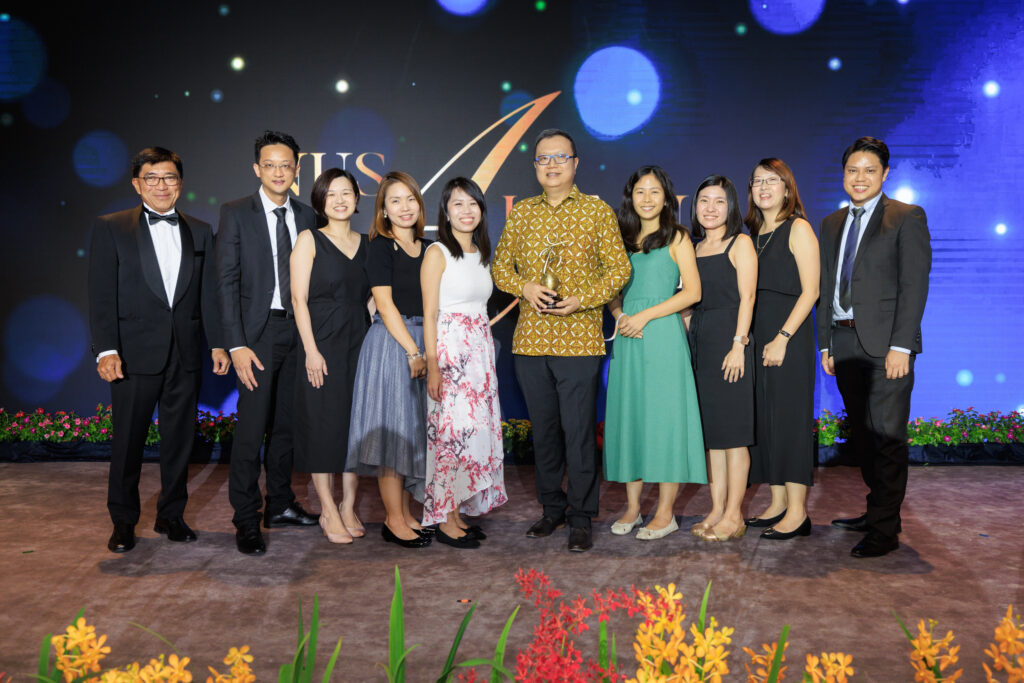
Team (Alumni) Award Recipients
The Team (Alumni) Award recognises the outstanding achievements of alumni teams who have collectively distinguished themselves in their chosen fields.
Three awards recipients were:
- Co-founders of Growthbeans: Ms Shamantha Yan Shiya (NUS Sociology '09) and Ms Shane Yan Shiyan (NUS Psychology '09)
- Co-founders of Janio Asia: Mr Ng Jun Kai and Mr Nathaniel Asher Yim
- REACH (Response, Early Intervention and Assessment in Community mental Health) Team, Institute of Mental Health: Ms Esther Chew Yuki (FASS '14), Dr Daniel Fung Shuen Sheng, Mr Ho Weng Siong (FASS '16), Ms Li Jiaying Grace, Mr Ong Guo Xiong Jeffrey (FASS '09), Ms Ong Tze-I Cheryl (FASS '08), Ms Sim Si Lin (FASS '12), Ms Tan Ke Jia (FASS '03), Mr Tan Zheng Xin, Jason (FASS '08) and Ms Kelly Yeo (FASS '07)
Read more about the NUS Alumni Awards 2023 recipients here and here.
This story by the NUS Office of Alumni Relations first appeared in NUSNews on 2 November 2023.
SEA Alumnus Mr Khoo Yi Feng awarded Outstanding Young Alumni Award
Join us in celebrating our alumnus, Khoo Yi Feng, for his remarkable achievement! Yi Feng has been honored with the prestigious National University of Singapore 2023 Outstanding Young Alumni Award. Your dedication and hard work continue to inspire us all. We are beaming with pride! #NUSAlumniExcellence #ProudAlmaMater #CongratulationsKhooYiFeng
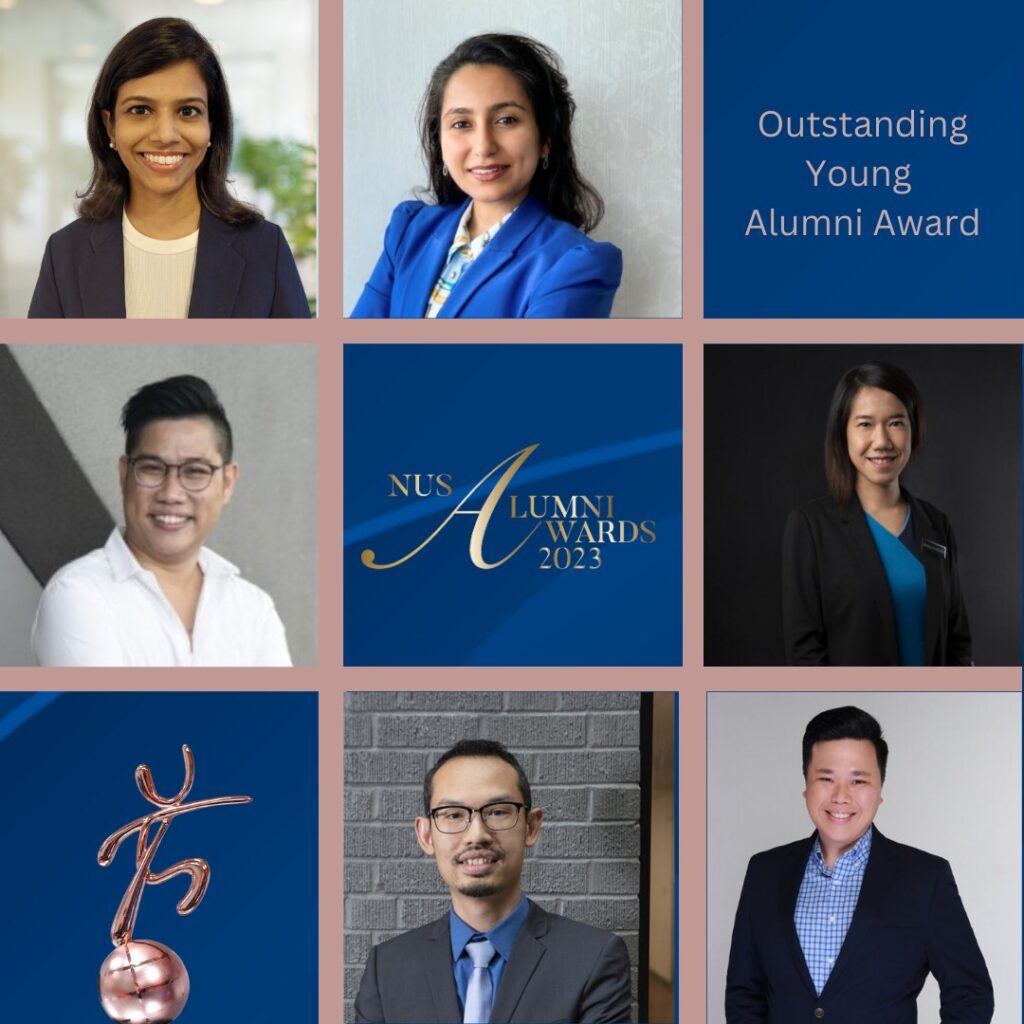 Mr Khoo Yi Feng (second row, far left). Photo Credit: NUS Alumni
Mr Khoo Yi Feng (second row, far left). Photo Credit: NUS Alumni
Collaboration on the preservation, digitisation, and translation of the Daeng Paduppa manuscript by NUS Libraries and Universitas Muslim Indonesia (UMI).
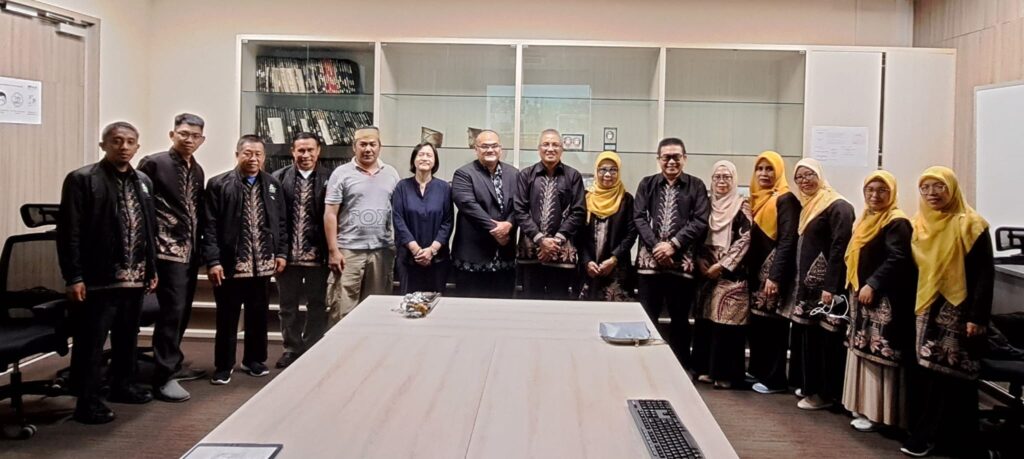
Exploring Southeast Asian manuscripts is a fascinating journey through a rich tapestry steeped in history and culture. On 5 October 2023, Universitas Muslim Indonesia (UMI, Makassar) and NUS Libraries signed an agreement to establish a framework for sharing resources and expertise and to launch a collaboration for interdisciplinary studies and academic innovation through the preservation, digitization, and open access to Bugis-Makassar manuscripts. Within this framework, UMI donated the original Daeng Paduppa Manuscript to NUS Libraries. In partnership with researchers from the Jusuf Kalla Research Center for Bugis-Makassar Cultural Studies at UMI, Dr Mohammed Effendy, who initiated the agreement between UMI and NUS Libraries, will lead the translation of the Daeng Paduppa Manuscript from Bugis language to Indonesian language, and from Indonesian language to English language. This collaboration will deepen our understanding of Singapore's historical, cultural and economic links within Southeast Asia and with the Bugis-Makassar communities of Sulawesi in particular.
The Effect of the High Court of Malaysia’s Decision to Release Ahmad Zahid Hamidi
IN BRIEF | 5 min read
- Commentary in Suria News Online by Fadiah Nadwa Fikri, a PhD candidate from NUS Southeast Asian Studies.
Click through image below to read this piece.
This article first appeared in Suria News Online and NUSNews on 21 September 2023.
NEW PUBLICATION: Ummah Yet Proletariat : Islam, Marxism, and the Making of the Indonesian Republic
Ummah Yet Proletariat Islam, Marxism, and the Making of the Indonesian Republic
From 1965 to 1966, at least 500,000 Indonesians were killed in military-directed violence that targeted suspected Communists. Muslim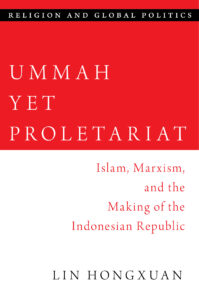 politicians justified the killings, arguing that Marxism posed an existential threat to all religions. Since then, the demonization of Marxism, as well as the presumed irreconcilability of Islam and Marxism, has permeated Indonesian society. Today, the Indonesian military and Islamic political parties regularly invoke the spectre of Marxism as an enduring threat that would destroy the republic if left unchecked.
politicians justified the killings, arguing that Marxism posed an existential threat to all religions. Since then, the demonization of Marxism, as well as the presumed irreconcilability of Islam and Marxism, has permeated Indonesian society. Today, the Indonesian military and Islamic political parties regularly invoke the spectre of Marxism as an enduring threat that would destroy the republic if left unchecked.
In Ummah Yet Proletariat, Lin Hongxuan explores the relationship between Islam and Marxism in the Netherlands East Indies (NEI) and Indonesia from the publication of the first Communist periodical in 1915 to the beginning of the 1965-66 massacres. Lin demonstrates how, in contrast to state-driven narratives, Muslim identity and Marxist analytical frameworks coexisted in Indonesian minds, as well as how individuals' Islamic faith shaped their openness to Marxist ideas. Examining Indonesian-language print culture, including newspapers, books, pamphlets, memoirs, letters, novels, plays, and poetry, Lin shows how deeply embedded confluences of Islam and Marxism were in the Indonesian nationalist project. He argues that these confluences were the result of Indonesian participation in networks of intellectual exchange across Asia, Europe, and the Middle East, of Indonesians "translating" the world to Indonesia in an ambitious project of creative adaptation.
Lin Hongxuan is Assistant Professor in the Department of Southeast Asian Studies at the National University of Singapore. In 2022, he was a Visiting Fellow at the Saw Swee Hock Centre for Southeast Asian Studies, London School of Economics and Political Science. A scholar of Indonesian history, his work has been published in Southeast Asian Studies, Studia Islamika, Positions: Asia Critique, and New Mandala.
Sutasoma: The Journey - A Balinese dance performance
The Department of Southeast Asian Studies at NUS is pleased to announce a performance of a Balinese spectacular dance drama on 17 November 2023.
The story of Sutasoma is a Buddhist poem that was composed in 14th century Java. It tells of the wanderings of Sutasoma and his strange group of friends: a tiger, a dragon and a flesh eating elephant-headed demon. The story revolves around the theme of loving kindness and compassion for all living things while showcasing the idea of Unity in Diversity. To Indonesians, Sutasoma is the source of the country’s national ideology.
In this dance drama, students from SE2224, a class in the Department of Southeast Asian Studies taught by Associate Professor Irving Johnson, will be joined by a team of 15 dancers and musicians from Bali, as well as other NUS students and faculty who have a passion for all things theatrical. The NUS students developed their skills in Balinese acting and dancing while on a one-week fieldtrip to the island in September. This grand production is a one-time only Premier, having never been performed. Come prepared to be dazzled by splendid costumes, amazing dancing, fantastic beasts and hypnotic music as we bring a slice of Bali to NUS!
Tickets at $20 can be reserved from Associate Professor Irving Johnson at 98785874.
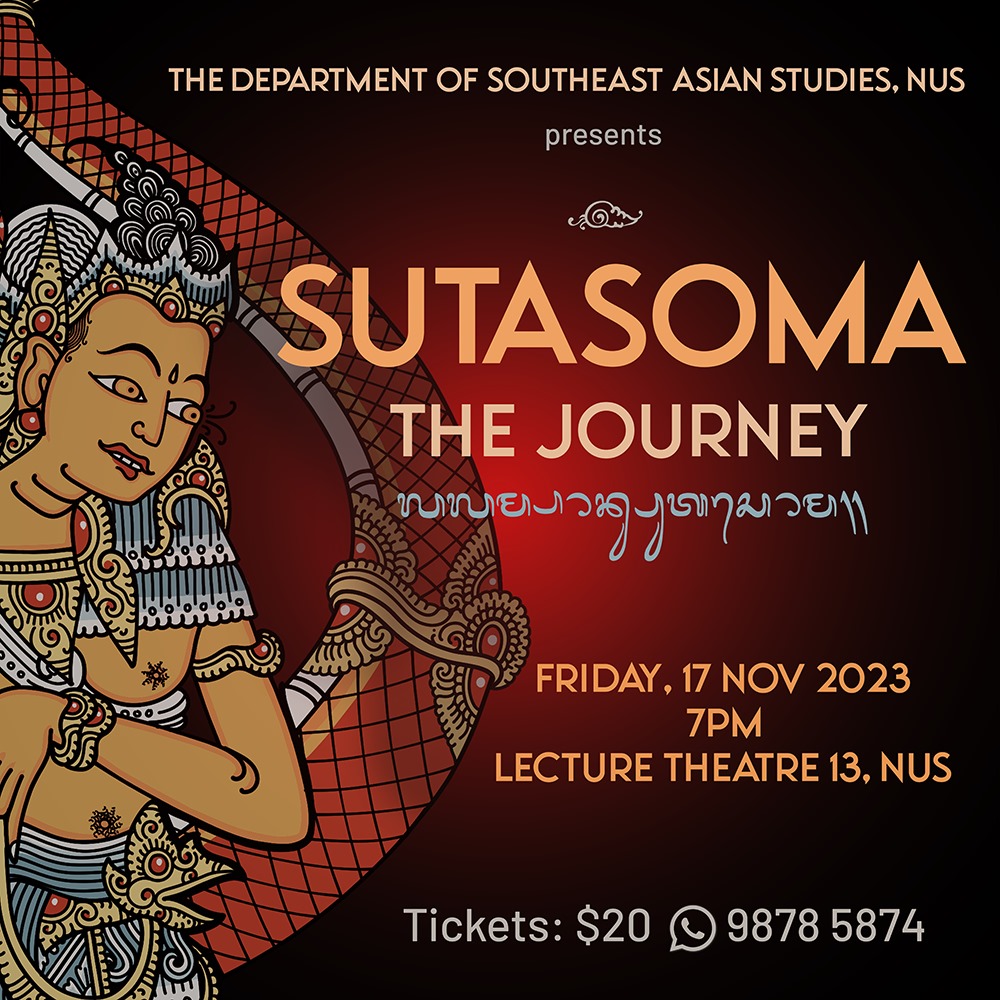
Journeying through Maritime Southeast Asia on the NUS Southeast Asia Friendship Initiative
IN BRIEF | 8 min read
- As part of the new Southeast Asia Friendship Initiative, students from various NUS halls, residential colleges and houses went on experiential study trips to countries in the region.
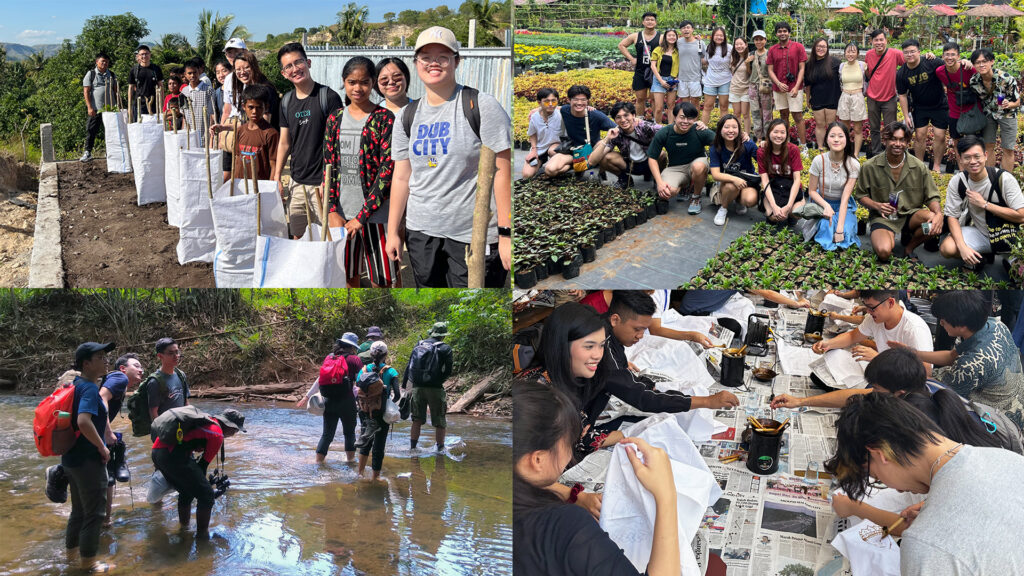
With a population of almost 640 million people, Southeast Asia (SEA) is one of the most culturally diverse regions in the world. To further explore this region, students from various NUS halls, residential colleges and houses embarked on inaugural experiential study trips to neighbouring SEA countries, spanning 10 weeks from May to July this year, as part of the new Southeast Asia Friendship Initiative (SFI) under the auspices of the Office of the Provost and NUS Global.
Focusing on the United Nations Sustainable Development Goals (UN SDGs), SFI aims to expose students to real issues and challenges faced by Southeast Asian communities, while fostering a deeper appreciation of the diverse cultures, histories and complexities in the region.
“SFI blends classroom teaching and a carefully curated study trip in the targeted country to help students gain insights into the history, culture, peoples, and potential of Southeast Asian countries,” explained NUS Associate Provost (Special Projects) Associate Professor Melvin Yap, who is also Chief of SFI.
Reflecting on the intent of the SFI, Associate Vice President (Global Relations) Associate Professor Reuben Wong added, “We hope that through SFI, NUS students will build long-term friendships and connections, appreciate the challenges and opportunities in the region; and that many more NUS graduates will work and live in SEA countries.”
Tapping on the academic expertise of the NUS Southeast Asian Studies and Malay Studies departments, students were given a broad introduction to a selected country of study through informative lectures and tutorials, before heading to their destinations with their fellow resident-mates. For the pilot launch, NUS residential units organised 12 unique overseas field trips to SEA, each narrowing in on specific SDGs and exploring the challenges faced by their chosen destination of travel.
This is the first of a two-part series on the SFI study trips, where students share their insights into the Maritime Southeast Asia region, which is made up of the world’s two largest archipelagos situated between the Indian Ocean, the South China Sea, and the Western Pacific.
Sustainable Agricultural Practices in Malang, Indonesia
Sixteen residents of Pioneer House (PH) were whisked away on a seven-day trip, in May, to Malang, Indonesia, to learn about sustainable agricultural practices. Led by PH Resident Fellow, Dr Andi Sudjana Putra and three other NUS staff, the group interacted with staff and students from Universitas Brawijaya, gaining a deeper understanding of the culture and customs in Malang, as well as the sustainability issues in the city. They also visited Ngroto, a village in Malang, and Bumiaji, an adjacent village outside Malang, where they were introduced to sustainable and organic farming practices, as well as innovative ways to cultivate crops while preserving the ecosystem and promoting biodiversity.
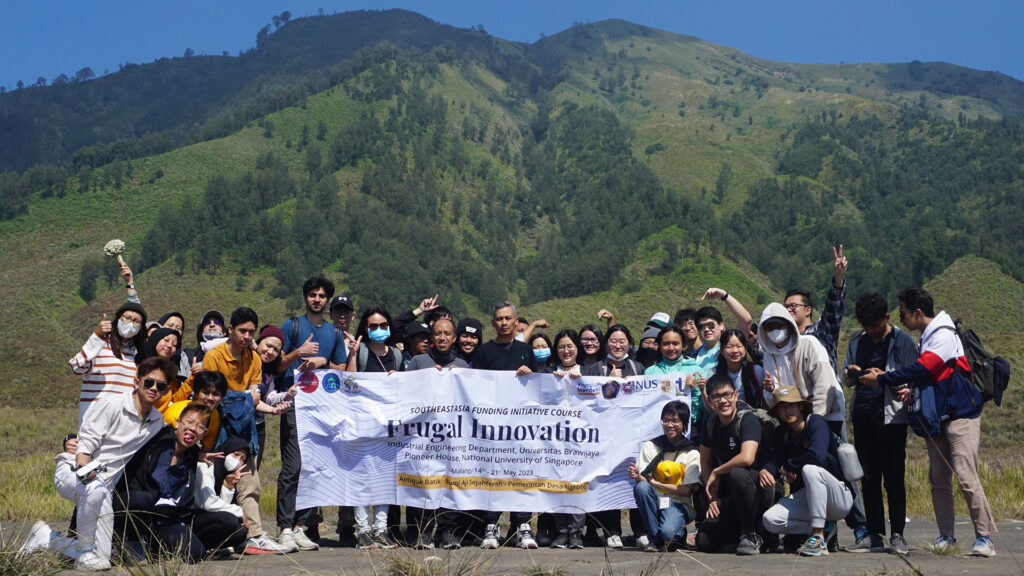
Gideon Tay, a first-year student from NUS Business School recounted that his time at Bumiaji Farm was an immersive, eye-opening experience that allowed him and his fellow students to establish a genuine connection with the land. “As we worked alongside the farmers, we felt a sense of camaraderie and admiration for their commitment to nurturing the earth. The experience went beyond education and was invigorating and transformative,” said Gideon.
“By actively participating in their activities like planting seeds, tending to the crops, and observing the farmers' techniques, we gained practical knowledge and an understanding of the importance of sustainable farming practices,” he added.
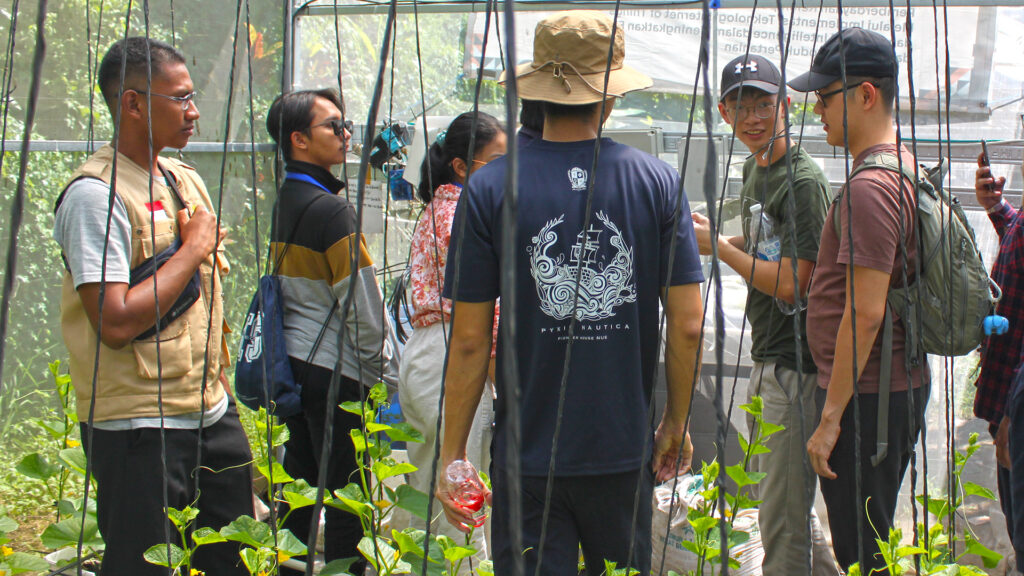
Gideon's testimony highlighted the transformative power of hands-on experiences in sustainable agriculture, which is vital in fostering a deep appreciation for the natural world and an understanding of the interconnectedness between humans and the environment.
To find out more about SFI at PH, click here.
Sustainability and Education in Bali, Indonesia
For the 23 students who took up the SFI course offered at LightHouse (LH), their discovery of the meaning of education and sustainability, amidst Indonesia’s booming tourism industry, was an enriching experience.
With concrete learning outcomes in mind, LH Resident Fellow Dr Lynette Tan who led the study trip explained, “I wanted our students to be equipped with skills to solve real-life issues faced by our partner organisations and universities. At the same time, it was an opportunity for them to learn to develop and apply a framework to evaluate the sustainability of solutions proposed.”
Dr Tan also made sure to include experiential learning throughout the itinerary, by incorporating forest visits and meetings with Junglo and Green School, organisations which focus on forest regeneration via the Miyawaki Method to regrow ecosystems.
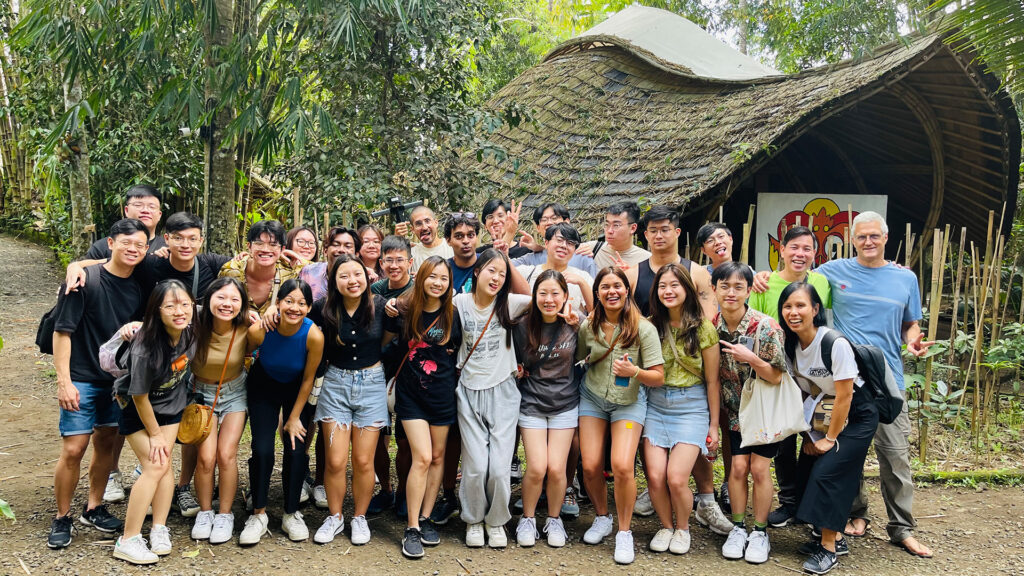
At a half-day workshop organised by Bali’s Udayana University and Plastic Bank, a social enterprise seeking to stop ocean plastic by allowing coastal communities to exchange plastic waste as currency for necessities, the students examined the SDG Goals on Quality Education and Sustainable Cities. The event was complemented with lively group discussions on Bali’s challenges given their economy’s heavy reliance on tourism.
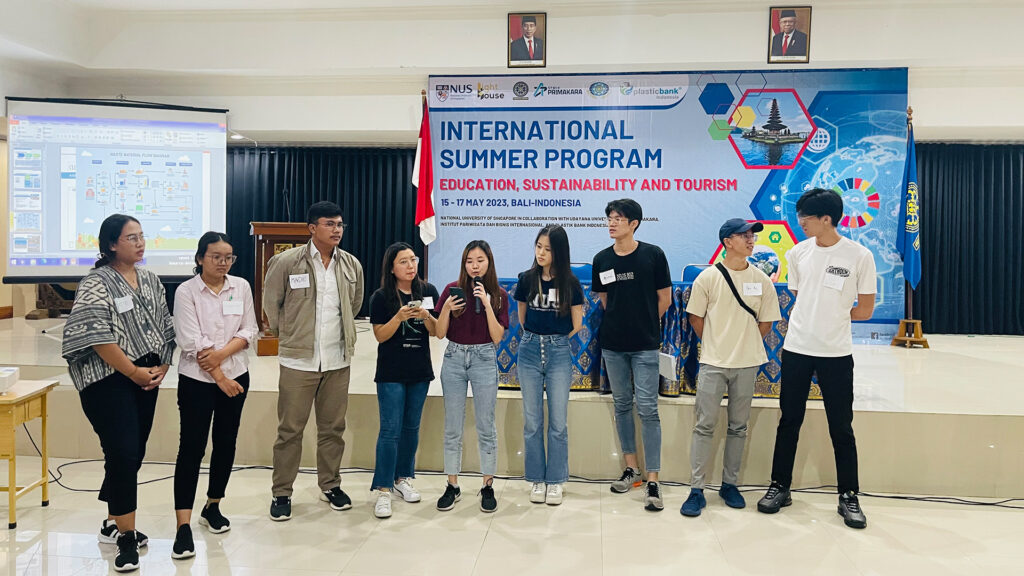
At another visit, to the International Institute of Tourism and Business (IPB), students learnt about the principles of Tri Hita Karana, which refers to the interconnectedness of ‘God, Community and Environment’, and how this influences sustainable tourism in Bali. IPB thoughtfully curated a series of activities which gave the students a taste of Balinese culture, hospitality and dining.
LH students also spent two days at Generasi Bali (Gerasa), where they learnt about sustainable education from a non-governmental organisation (NGO) that helps the marginalised in the local community. After meeting with and hearing the stories of the beneficiaries supported by Gerasa, the students then discussed and proposed ideas to increase the awareness and impact of the meaningful work done by the organisation.
L Keerthnah Lectchumanan, a Year 2 student from the Faculty of Science, had no regrets signing up for the programme. “I’m so glad that I took the opportunity to join the inaugural LightHouse SFI. What I learned on this trip cannot be taught within a classroom. My conversations with the locals gave me a Balinese perspective on education and sustainability. I really appreciate Dr Tan for taking care of us so well, and am grateful for the support from NUS and LH in making this trip possible for us.”
To find out more about SFI at LH, click here.
Leadership at the Fringe in Lombok and Pulau Sumba, Indonesia
Across two study trips in May and July, 41 students from Residential College 4 (RC4) discovered the captivating rural locales of Lombok and Pulau Sumba islands located in eastern Indonesia. Led by RC4 Fellows, Associate Professor Tan Lai Yong and Senior Lecturer Li Jingping, the trip sought to explore leadership at the fringe, with a focus on two UN SDGs – food security (Zero Hunger) and climate change (Climate Action).
The SFI programme provided an invaluable platform for staff and students to engage with local partners involved in sustainable development efforts across SEA. “The study trips deepened our understanding of the interconnected issues of food security and climate change in the Indonesian context,” said Assoc Prof Tan.
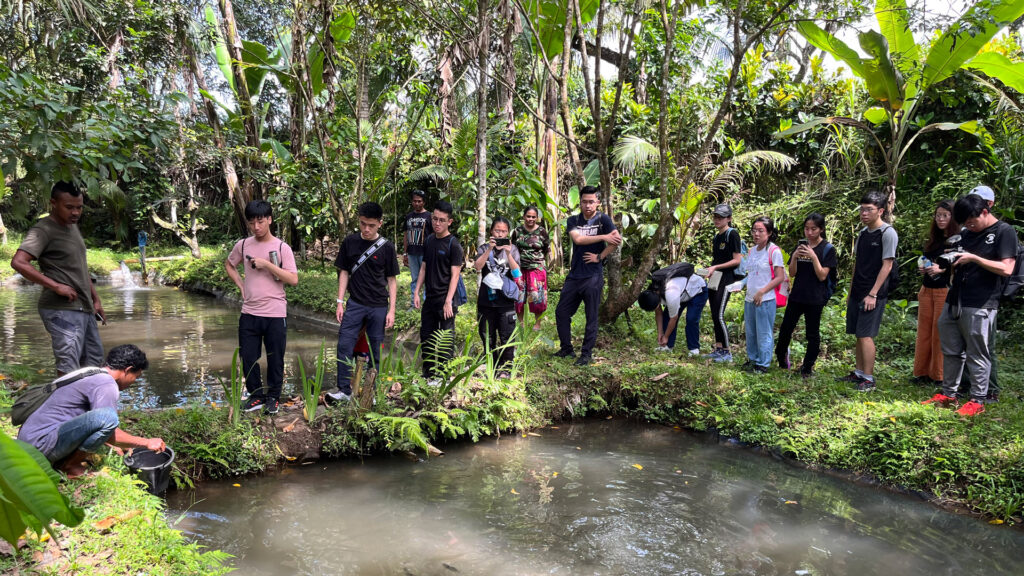
One such example was their early morning trip to Tanjung Luar village in Lombok, a bustling coastal hub. It was there that they heard first-hand from the local fishermen of the challenges of rising sea levels, unpredictable storms and escalating petrol costs. Thereafter, they ventured to a fish farm to better understand their challenges, and the viability of fish farming as compared to open-sea fishing.
Moving further inland, the students met with farmers and community volunteers from Desa Gangga, whose dedication to tree-planting brought about economic benefits and reduced soil erosion along riverbanks. When the first delegation from RC4 visited in May, they had planted approximately 100 trees; and barely two months later in July, the next group of RC4 students were able to witness the fruits of their labour!
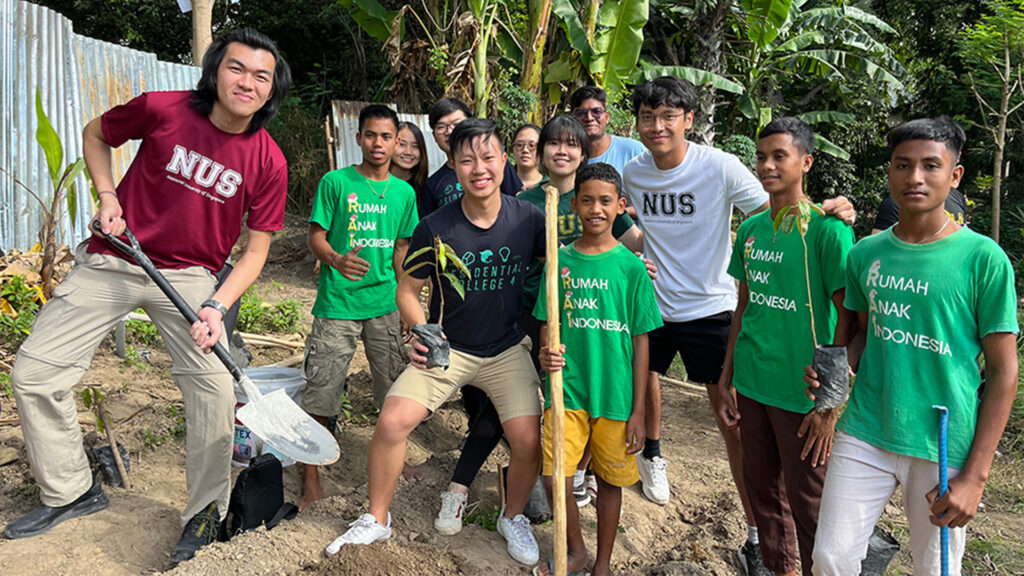
Such close interactions with the local communities left indelible memories for participants, igniting a passion in many of them to actively contribute to positive change and finding innovative solutions. Having two study trips back-to-back also allowed for greater continuity in terms of RC4’s engagement with the local communities.
“This trip has been incredibly fulfilling, packed with learning and filled with experiences. Not only have I learned much about food security and food production, I have also gained an intense appreciation for Indonesia and its diverse culture and people,” remarked Dion Chua Yee Kin, a freshman from the College of Design and Engineering. “I will definitely return to Indonesia not just to experience its incredible culture and the warm hospitality of the locals, but also hopefully to contribute to helping push the sustainability frontier of its food production systems.”
Watch the team’s journey to Lombok and Pulau Sumba below.
Conservation Matters in Pahang, Malaysia
There is beauty in out-of-classrooms learnings. With this in mind, Ridge View Residential College (RVRC) Fellow Dr Patricia Lorenz led 17 students to Pahang, Malaysia to explore facets of conservation. Despite the sweltering heat, the study trip allowed students to take a closer look at biodiversity loss, threats to the ecosystem, the role of indigenous peoples and ecotourism in conservation areas.
Venturing into the forest trails of the Sungai Yu Ecological Corridor, Taman Negara, and Universiti Kebangsaan Malaysia’s (UKM) research centre at Fraser’s Hill, RVRC students went on day treks and night drives to get a taste of the region’s diverse wildlife. At UKM, the team got up close and personal with wildlife through activities like a frog night walk and dragonfly walk.
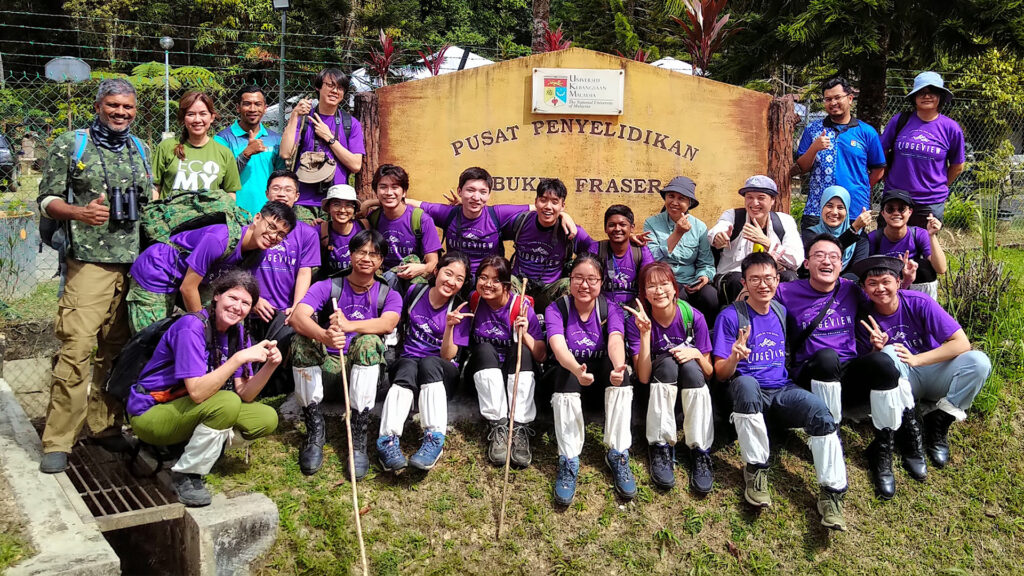
To better understand the intention behind the various conservation efforts, the team also met with Malaysian Conservation Alliance for Tigers and Ecotourism and Conservation Society Malaysia – two main community partners in Pahang dedicated to conservation and working with the local indigenous Bateq communities.

Freshman Ngoi Kai Sheng from the Faculty of Arts and Social Sciences spoke candidly of his initial intention to sign up for the combination of outdoor experiences – the hikes, landmarks and scenery. The experience, however, made him gain an appreciation of the value of conservation.
“I discovered so much beyond what I was familiar with, from visiting the Orang Asli villages, to experiencing night life in the dark of the palm tree plantations, to engaging the eloquent representative from Fraser's Hill Nature & Heritage Association,” he shared.
“The biodiversity and cultural heritage we risk losing for ‘development’ is shattering,” he said. “Conservation is not some far-fetched ideal,” even if people may compartmentalise and disassociate themselves from the realities of environmental destruction, he observed. “Development, on the other hand, will always come at the price of precious life.”
To find out more about the SFI at RVRC, click here.
This story – the first instalment of a two-part series on the NUS Southeast Asia Friendship) – first appeared in NUSnews on 22 August 2023.
UK band's controversial kiss achieved something few have in Malaysia
Against the backdrop of Malaysia's state elections, the controversy sparked by British band The 1975’s lead singer Matty Healy's on-stage antics at Malaysia’s Good Vibes Festival has unveiled a multitude of perspectives and implications that extend beyond the realm of music.
In her commentary published in Channel NewsAsia (August 2023), Dr Serina Abdul Rahman (NUS Southeast Asian Studies) delves into the impact of the incident on Malaysian society, its connection to political narratives, and its reverberations within the LGBTQ community. She unravels the layers of meaning behind the incident, emphasizing the need for a nuanced understanding of local contexts when engaging in advocacy efforts and artistic expressions.
While The 1975 had performed in Singapore shortly before their controversy, the Good Vibes Festival in Malaysia drew great crowds from Singapore with its varied line-up of artists. However, lead singer Matty Healy's unprompted tirade against Malaysian laws, followed by a same-sex kiss while on stage, led to the immediate cancellation of the highly anticipated festival. The incident stirred a mix of reactions, with some applauding the act while others disapproved. It also became a political talking point as politicians seized the opportunity to shape the narrative, particularly with imminent state elections. Interestingly, Dr Rahman points out that Healy's actions briefly united Malaysians from different political backgrounds in their criticism of his behaviour, a feat which few have managed.
However, the incident's aftermath unveiled deeper concerns. Conservative religious groups criticized it as a sign of moral decay, while others lamented the resultant economic fallout from the cancellation of the festival that negatively affected vendors and local bands. As Dr Rahman asserts, Healy's actions more significantly took a toll on Malaysia's LGBTQ community. In a country where homosexuality remains illegal, his behaviour gave ammunition to anti-LGBTQ sentiments and jeopardized years of work by local LGBTQ advocates who had been cautiously collaborating with authorities within societal constraints.
Dr Rahman concludes by suggesting that this incident serves as a reminder of the complex interplay between art, politics, and cultural norms. It underscores the importance of understanding and respecting local contexts when advocating for change. As the nation navigates these waters, it becomes clear that the aftermath of Healy's actions extends beyond festival cancellations to deeply impact social dynamics and advocacy efforts.
Read the article here.

Will Azmin Ali be Able to Rise Again or will the Selangor PRN Mark the End of his Political Career?
IN BRIEF | 5 min read
- An Op-Ed in Suria News Online by Dr Serina Rahman, Lecturer at NUS Southeast Asian Studies.
Click through image below to read this piece.
This article first appeared on CNA Online and on NUSNews on 10 August 2023.
UK Band’s Controversial Kiss Achieved Something Few Have in Malaysia
IN BRIEF | 5 min read
- The British band, The 1975, may have thought their same-sex kiss on stage during a Good Vibes Festival performance was a statement against the government of Malaysia, but in fact it only hurts members of the LGBTQ community living by the country's laws, according to Dr Serina Rahman (NUS Southeast Asian Studies).
Click through image below to read this piece.
This article first appeared in CNA Online and on NUSNews on 1 August 2023.
Charting New Experiences: The Anambas Odyssey Continues for the NUS Seafarers
IN BRIEF | 15 min read
- As their journey continues in this second instalment of the two-part series, the voyagers learn more about the local industries and explore the urban sights of the archipelago.
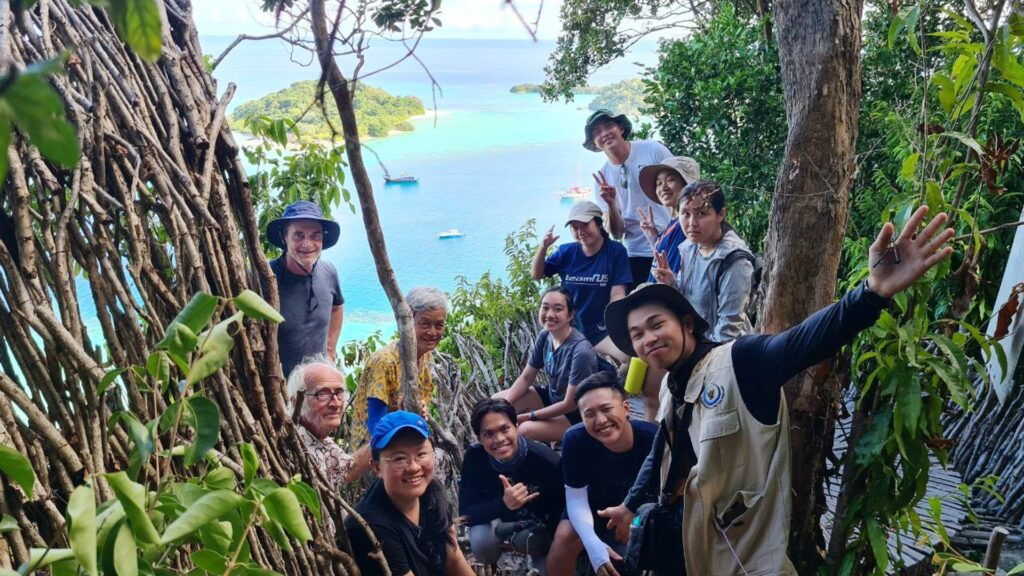
“The fair breeze blew, the white foam flew,
The furrow followed free;
We were the first that ever burst
Into that silent sea.”
– Coleridge, “Rime of the Ancient Mariner”
They may not have been the first to traverse that stretch of ocean, but for many of the students embarking on the 12-day voyage with the NUS Seafarers to Indonesia’s Anambas Islands, the experience of sailing was a first that opened their eyes to the thrill of being out at sea.
Read about the voyagers’ experiences picking up nautical skills, visiting local communities, and exploring the marine biodiversity in Part 1 here.
As their journey continues in this second instalment of the two-part series, NUS News tags along to chronicle the voyagers’ adventures learning about the local industries and exploring the urban sights of the archipelago.
The green economy: Investigating the ecotourism industry
Sailing onwards, the voyagers got a comprehensive view of an increasingly dominant form of economic activity in the region—ecotourism. They visited Bawah Reserve, an eco-island resort located in the southern islands, to learn how ecotourism, a relatively new, up-and-coming niche in tourism, offers a more sustainable alternative to the high levels of consumption associated with luxury tourism.
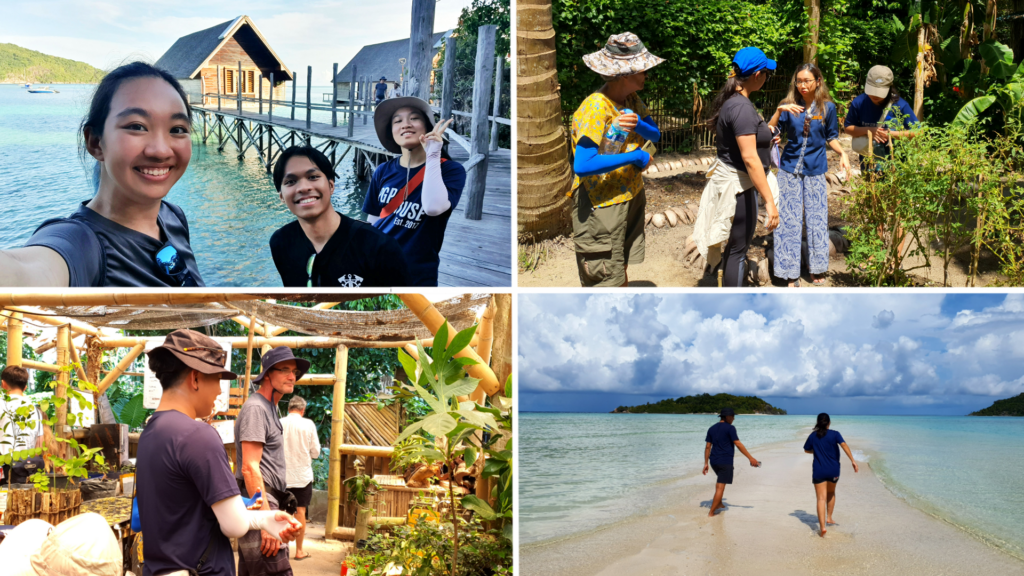
Receiving a behind-the-scenes tour of the efforts made towards Bawah Reserve’s eco-philosophy, the voyagers were acquainted with features such as lodgings constructed using bamboo and locally sourced natural building materials, a permaculture garden that supplies fruits, crops and herbs to the kitchens, solar panels that keep the island running on a greener source of energy, and a waste management programme predicated on a recycling policy, with the profits going to local communities in Batam. A marine conservation area with coral nurseries also protects the natural habitats of the sea turtles, eagle rays, and blacktip reef sharks that frequent its waters.
By offering nature-based tourist attractions and activities such as hiking, snorkelling, and paddleboarding, the resort not only creates jobs for locals and raises awareness of sustainability issues, but incentivises local populations to become environmental stewards in order to attract tourist dollars, a win-win situation that marries the twin goals of economy and sustainability.
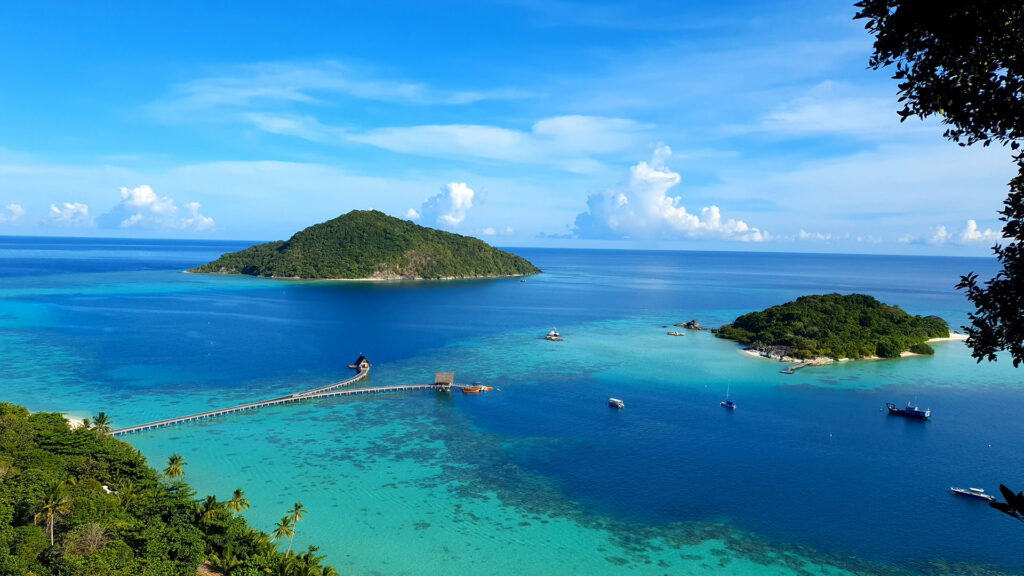
They also had the opportunity to visit an ecotourism establishment at the other end of the spectrum, Ecosymbiosis, in Sagudampur. Run by founder Antje Spors and her daughters, with the help of the Orang Laut people and some local employees, the survival ecotourism concept aims to bring visitors back in harmony with nature, to lead a sustainable, minimalist hunter-gatherer existence integrated seamlessly into the wider ecosystem.
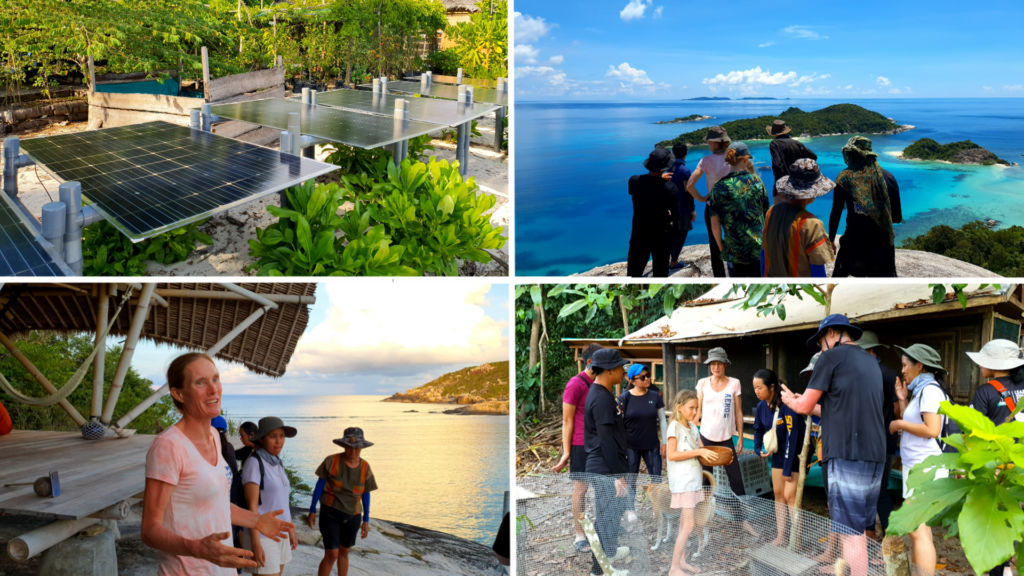
The voyagers experienced the model of zero-trace, non-pollutive tourism, witnessing a self-sufficient way of life in close connection with nature—from the rearing of chickens, ducks and rabbits as livestock, and groundwater wells that tap on the island’s natural water resources, to solar panels that supply electricity at night, and composting toilets that repurpose human waste as fertiliser for the crops and indigenous fruit trees on the island. They also got their hands dirty creating charcoal from rabbit manure and coconut husks, and learnt the art and science of living off the land.
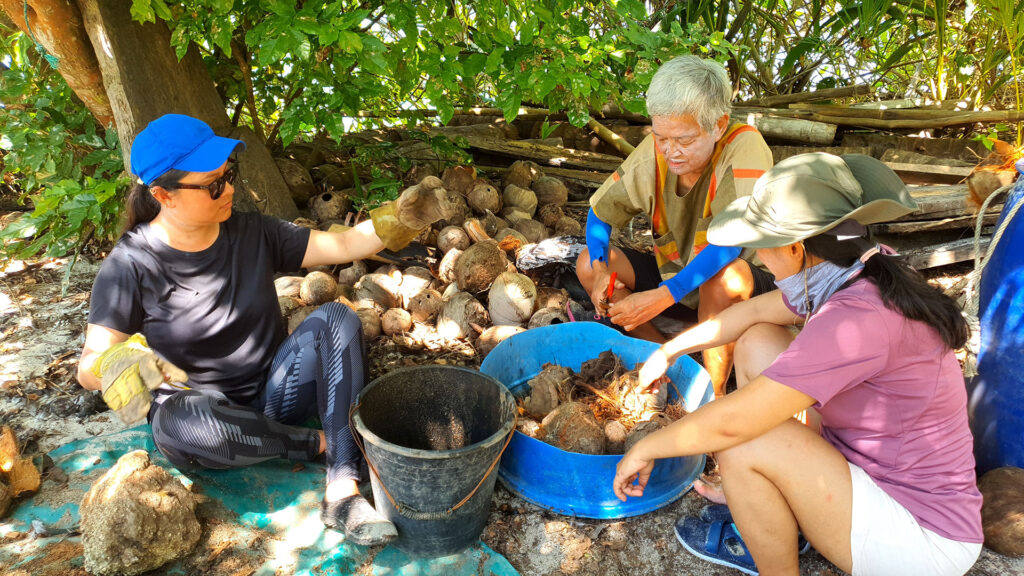
“One of my greatest takeaways from this experience was witnessing the dedicated efforts of these individuals and communities in their pursuit of sustainable living,” Tong Xinyao, a Year 1 Computer Science major, said. “Through small but meaningful steps, such as responsibly managing waste and reducing consumption, we can actively protect and preserve the environment.”
Partaking in an Urban Cultural Experience
After ten gruelling days at sea, the voyagers made their final landfall at Tarempa City, the vibrant, fast-growing capital of the Anambas Regency on Siantan Island, steeped in heritage and industry.
Going onshore at the crack of dawn, the buzz of trade and traffic carried on the morning breeze, they explored the bustling streets, negotiating the omnipresent motorcycles plying the roads and visiting the numerous provision shops, street hawkers, and other small businesses along the way.
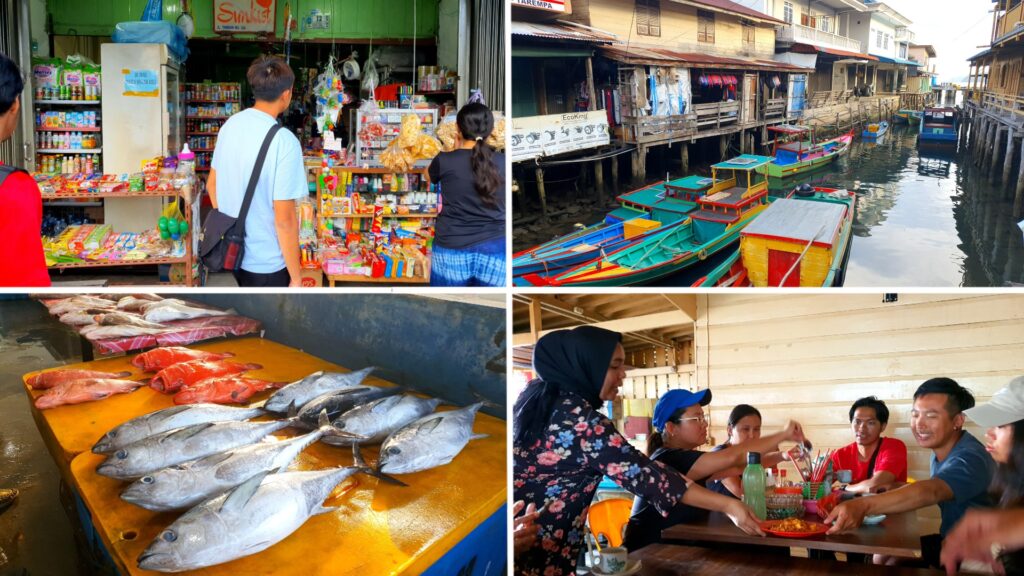
Immersing themselves in the sights, smells, and sounds of Tarempa City, they dug into hearty local dishes like Indonesian mie bakso and Indomie goreng at traditional eateries, and witnessed the local fishing economy in operation at a lively morning fish market selling seafood like squid, red snapper, grouper, and tuna.
The cultural experience also included a comprehensive tour of the newly built Masjid Agung Baitul Ma’mur mosque overlooking Tarempa Bay, a central facet of religious life for the Muslim demographic in Tarempa City.
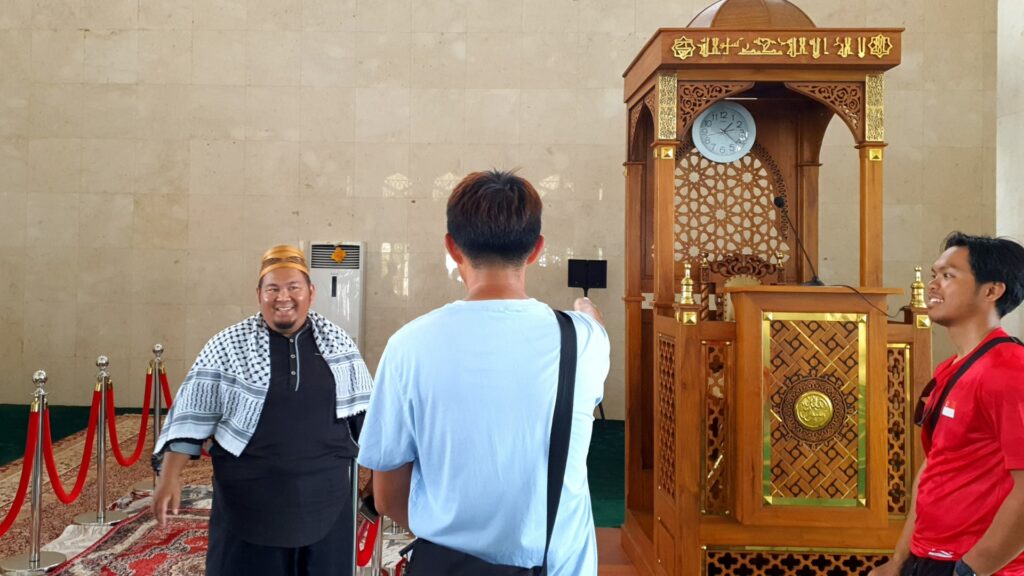
Besides elucidating its religious and cultural significance to the region, the imam delivered a sonorous rendition of the azan, the Islamic call to congregational prayer. The voyagers also learnt about the symbolism behind the mosque’s striking architectural features, such as the distinctive green dome and golden doors reminiscent of the Al Masjid an Nabawi in Medina, Saudi Arabia, one of the most important mosques in the Islamic tradition.
In good company: An enduring community of learners
For the crew, the journey itself, as well as the human connections made along the way, was as valuable as the various destinations. Living in the moment, the voyagers gained a profound sense of peace and mindfulness, getting in tune with their surroundings and each other.
“We didn’t use our phones as much and instead relied on our senses, and each other to live,” Ethan Leong, a Year 4 major in Psychology, said. “We woke to the dew of the morning and the morning sun at dawn. We slept to the waves and the moon rising over the horizon, and saw the stars move around the night sky. We slowed down enough to listen.”
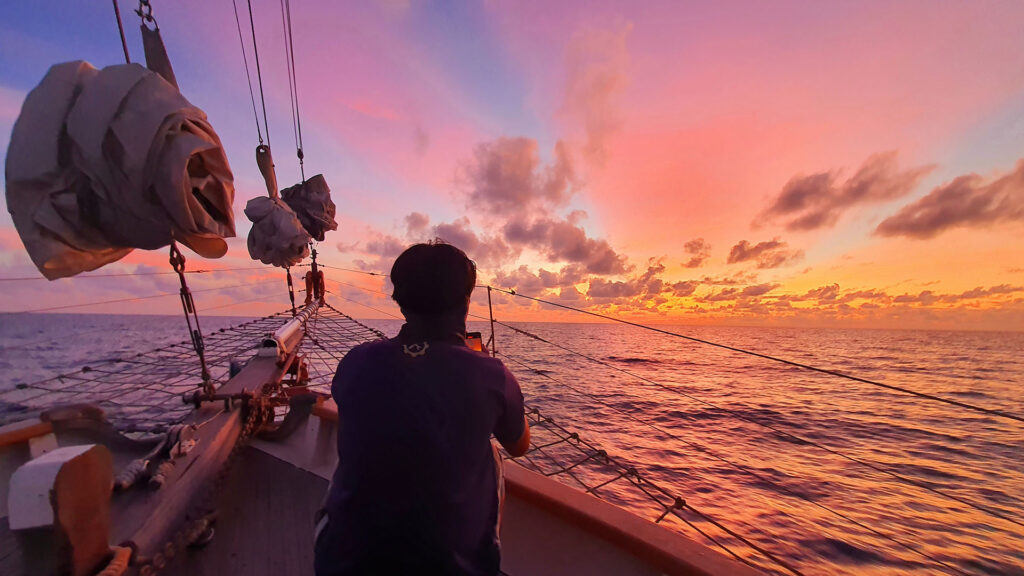
“Away from the hustle and bustle of city life, we were presented with a rare opportunity to embrace an alternative way of existence,” Xinyao echoed.
The company also enhanced the entire experience—what started out as a ragtag band of strangers from all walks of life quickly coalesced into a tightknit community that cared for and brought out the best in one another, bound by a sense of rapport, camaraderie, and trust in each other.
“Our efforts in cultivating a safe and pleasant space to share our ideas were rewarded as everyone began to truly enjoy themselves, sharing opinions, helping others and creating memorable moments together,” Muhammad Harriz Adry Bin Ridzuan, a Year 4 major in Mechanical Engineering, reminisced.
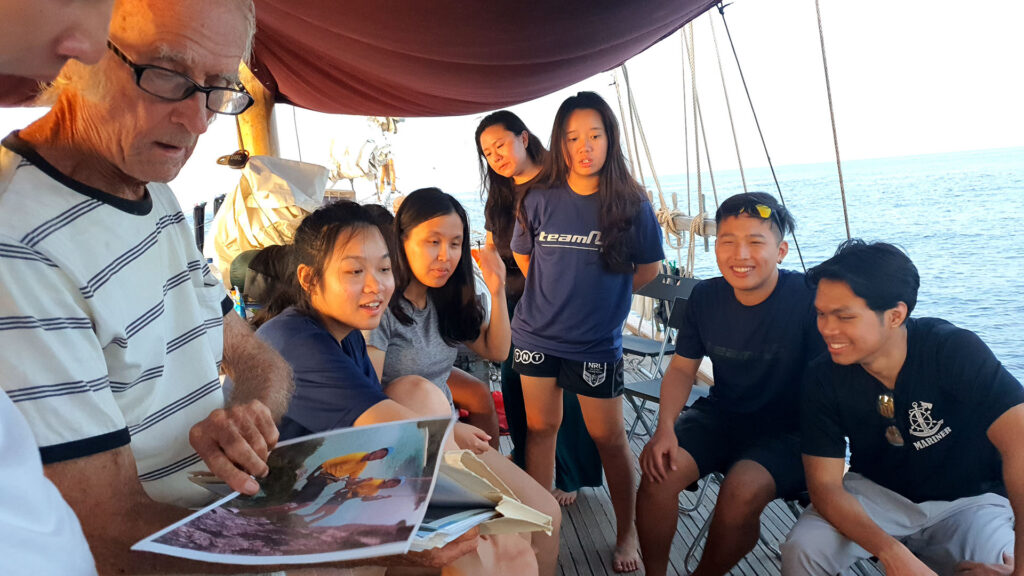
Even more remarkable was the immense value that every individual brought to the table, enriching the whole. Possessing diverse skillsets, talents, and interests, each member of the crew quickly found a niche in which to contribute, from a Nursing student who volunteered as Chief Safety Officer and the 73-year-old artist-in-residence who gave the voyagers art lessons onboard, to an NUS sailor who taught the novices the ropes and a Southeast Asian Studies minor who took it upon himself to share fascinating nuggets of information about local Indonesian art, architecture, religion, and culture.
“Living on a sailing boat together for ten days fostered a greater understanding and cultural consciousness among us, with our diverse backgrounds in nationality, religion, academic pursuits and life stages bringing unique perspectives to our discussions,” Xinyao shared.
“Through daily interactions and shared challenges, we developed a deeper appreciation for one another’s backgrounds and beliefs, gaining insight into different cultures and learning to navigate cultural differences with respect and understanding. I am delighted that I had the opportunity to learn some Bahasa Melayu and about Southeast Asian cultures from my friends!” she added.

Reflecting on the rich experiences on the voyage that have broadened his worldview, as well as how he has grown both as an individual and as part of a community, Harriz said, “Even now, weeks after the trip, the crew has left a mark on me. Of all the experiences I have had in NUS, this was the one that left something indelible and made me feel so much more well-rounded and ready to approach anything out there in the world.”
The voyage may have come to a close, but for the intrepid voyagers, it is the sum of all these memories and experiences, unmoored from the trappings of a frenetic urban existence, that they will carry with them for a lifetime.
This second instalment of a two-part series on the NUS Seafarers “Understanding Anambas” STEER voyage and first appeared in NUSnews on 24 July 2023. Read more about the NUS Seafarers, or check out their YouTube channel!
NOTE FROM KL: PRN this Time is Not Just About Political Stability, Economic Recovery and Lower Cost of Living
IN BRIEF | 7 min read
- A Commentary by Dr Serina Rahman (NUS Southeast Asian Studies) on Suria News Online.
Click through image below to read this piece.

This article first appeared on Suria News Online on 16 July 2023 and in NUSNews on 17 July 2023.
NUS Seafarers Take to Sea Once Again on Voyages to Indonesia’s Anambas Islands
IN BRIEF | 15 min read
- The NUS Seafarers headed out to the Anambas Islands in Indonesia on two voyages in April and May, exploring diverse communities, enterprises, and environments scattered across the archipelago.
A second wind filled the sails of the schooner Four Friends for the first time in three years since the COVID-19 pandemic, as it glided through turquoise waters teeming with marine life.
Supported by the NUS Global Relations Office’s Study Trips For Engagement & EnRichment (STEER), which immerses students in diverse cultural and socio-economic environments of fast-evolving regions through experiential site visits, the NUS Seafarers took to the sea once more on two voyages to the Anambas Islands in Indonesia.
The NUS Seafarers is a close-knit community united by a love of nautical adventure, venturing out to the seas and communities of Southeast Asia aboard traditional sailing vessels with zero carbon footprint since 2017.
Led by Captain Warren Blake and Associate Professor Martin Henz of the Department of Computer Science at NUS Computing, the momentous revival of the NUS Seafarers saw the two groups of voyagers sail, hike, abseil, kayak, and snorkel their way across the Anambas archipelago over the course of 12 days each from 29 April to 10 May and 9 to 20 May, exploring its rich culture, history, economy, and natural environment from the unique perspective of a seafarer.
“NUS Seafarers voyages are holistic experiences that combine communal living, structured and ad hoc learning projects, and adventure learning. The vessel serves as a safe learning space from which learning journeys are planned and executed and where reflection and documentation take place,” Assoc Prof Henz, who is also a Residential Fellow at King Edward VII Hall, explained. “It is fascinating to observe how communities of learners spontaneously form on these voyages to tackle challenging learning objectives.”
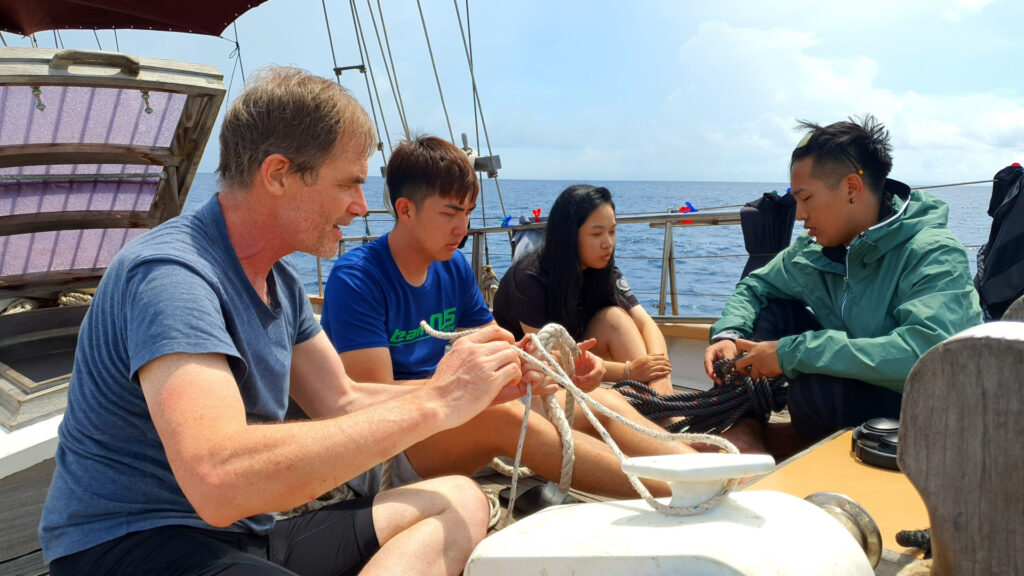
The crew comprised NUS students, alumni, and staff from all walks of life, hailing from faculties as diverse as the NUS Faculty of Arts and Social Sciences, School of Computing, College of Design and Engineering, and Yong Loo Lin School of Medicine.
Visiting a wide range of communities, enterprises, and environments throughout the archipelago, the crew derived a well-rounded understanding of the region from the expedition. NUS News tags along to find out what the voyagers learn from the rich experiences, interactions, and connections as they embark on the adventure of a lifetime!
Adapting to the Rhythms of Life at Sea
Plying the ropes, sails, and ship's helm by day, and getting regaled over dinner with gripping swashbuckling accounts of shipwrecks and shark encounters from the Captain by the light of the moon, the voyagers quickly took to life onboard the schooner, gaining their sea legs and acquiring experience and confidence in the manifold aspects of living at sea.
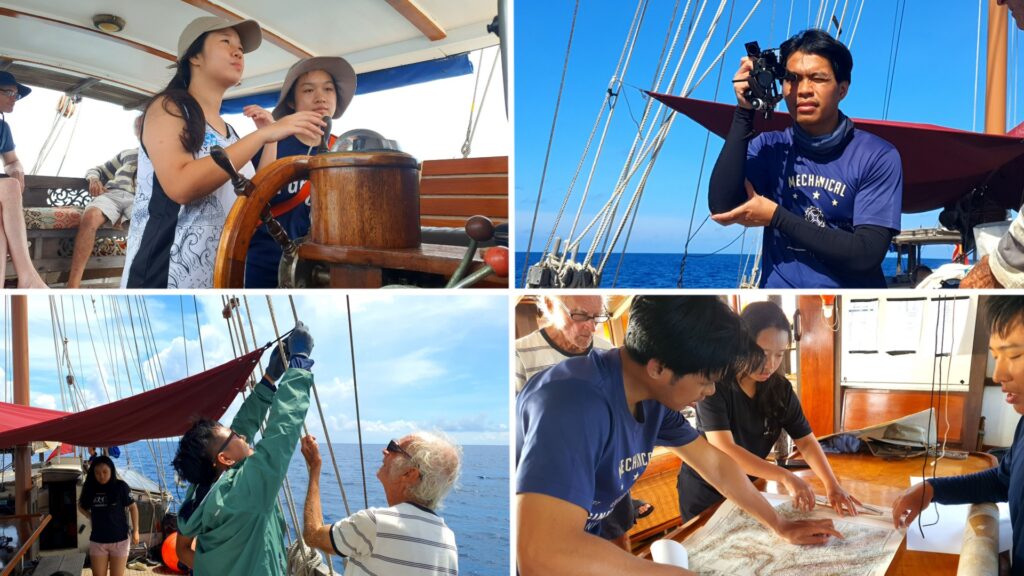
Over the course of ten days, the crew learnt a host of nautical skills on the fly—steering the ship, manning the ropes, tying nautical knots, manually raising the anchor, employing basic cartography to chart the ship’s course, and taking depth-sounding readings and records.
They also received a crash course in celestial navigation, including hands-on experience with using a sextant and the identification of significant constellations like the Big Dipper and Southern Cross to get their bearings out at sea. Blessed with clear skies and the absence of light pollution on most nights out at sea, the voyagers stargazed to their hearts’ content, treated to the sight of swathes of constellations, and even Venus and the Milky Way.
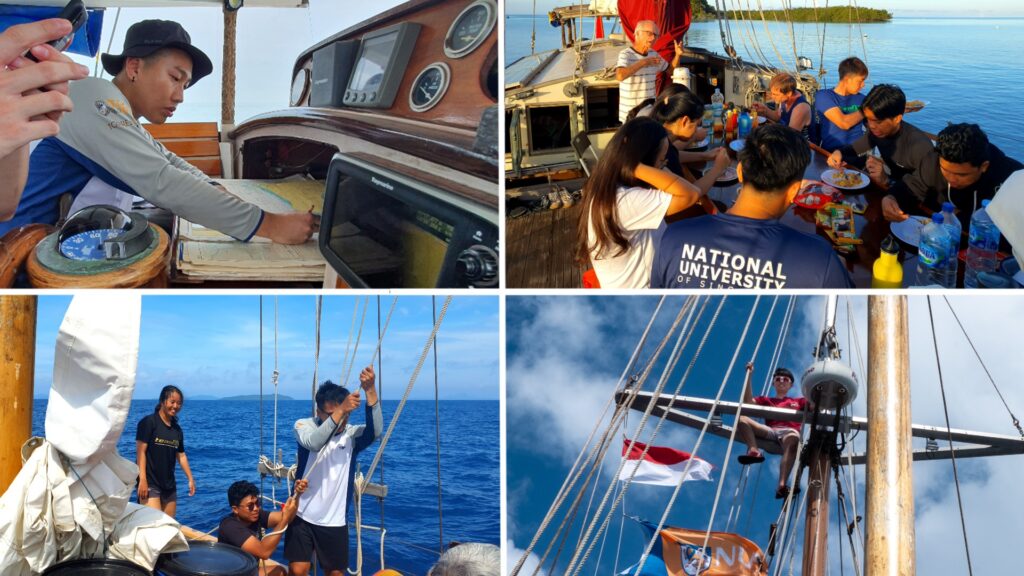
The journey was not all smooth sailing however— the voyagers contended with various challenges that took the wind out of their sails, such as a jammed rudder and anchor winching mechanism, and other small mishaps that they had to work together to overcome. Confronted with limited freshwater supply and limited electricity generated from the ship’s battery, they also gained a heightened appreciation for finite resources.
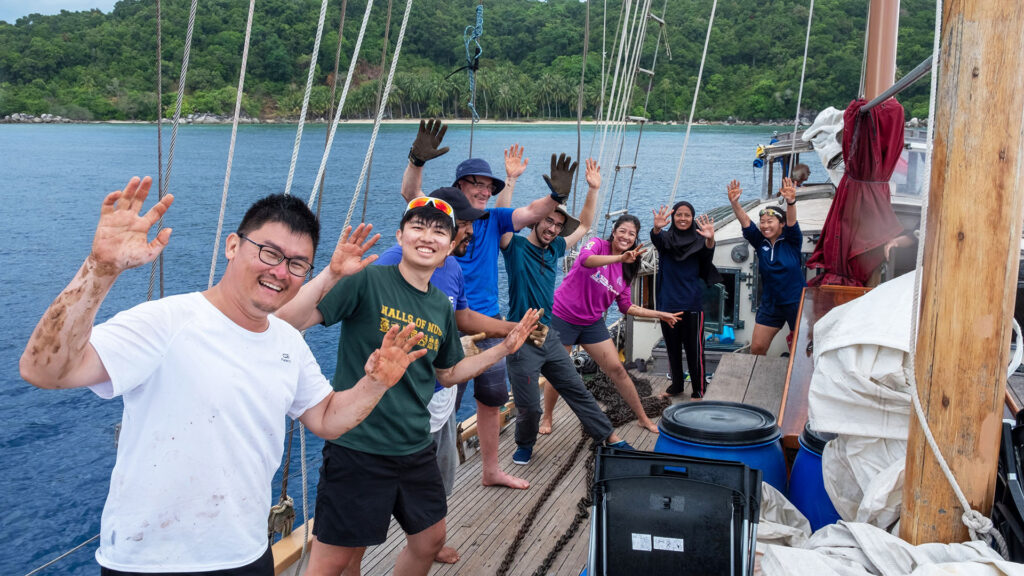
“One of the biggest challenges we faced was sailing the ship, an activity that requires accurate coordination, quick decision-making, and effective cooperation. The changing wind conditions and navigational challenges necessitated a cohesive team effort,” shared Tong Xinyao, a Year 1 Computer Science major.
“Through effective communication and a willingness to learn and help, we gradually grasped the basics of sailing. It was really fun and rewarding to see the sails up and enjoy the breeze on the deck after the hard work!” she quipped.
Connecting with Cocal communities: A Window into a Way of Life
The voyagers made a stop at Air Sena, a seaside village of stilt houses inhabited by the descendants of the Orang Laut, a nomadic seafaring people with a proud heritage of nautical knowledge and skill, and a resourcefulness in eking out a living from the sea.
Welcomed by the village chief Keng Lei, who led the voyagers on a tour through the village and graciously hosted them in his own home, the crew gleaned a first-hand understanding of the culture and economic structure of the local community.
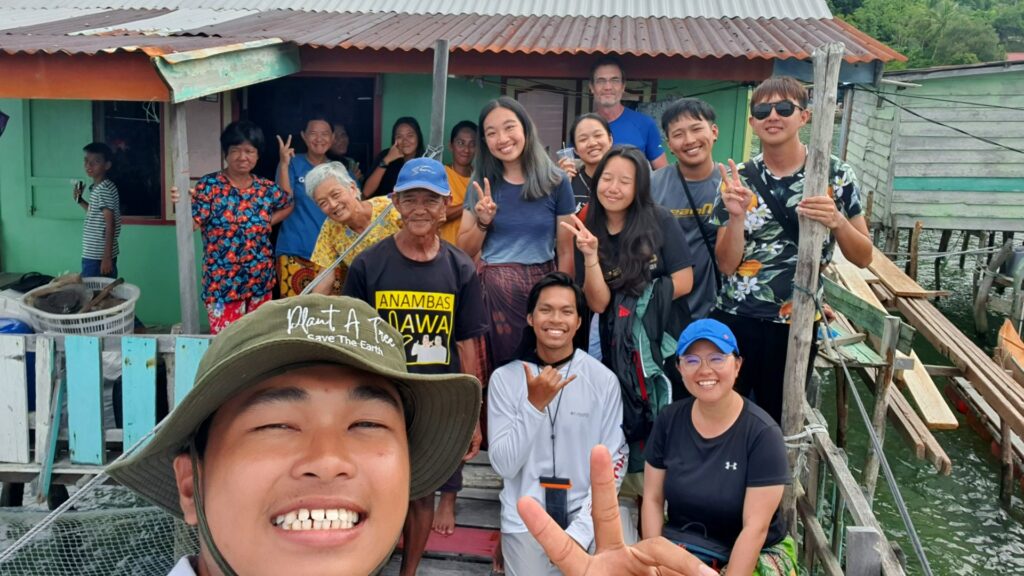
Despite the communication barrier between the villagers and most of the crew, the locals’ palpable warmth and hospitality quickly broke the ice. The experience exploring the village and interacting with the villagers as the latter went about their daily lives opened a window into a way of life vastly disparate from the fast-paced urban existence the voyagers lead.
“I was surprised by how much of my perception of Indonesia was comprehensively challenged, while also teaching me so much more than I could on my own through books and the internet. Each island we visited possessed a unique culture, history, economy and perspective that stretched back more than hundreds of years,” Muhammad Harriz Adry Bin Ridzuan, a Year 4 major in Mechanical Engineering, reflected. “The villagers of Air Sena are good people with a rich history, who can teach us plenty about how to live contentedly and treat others with kindness in our work.”
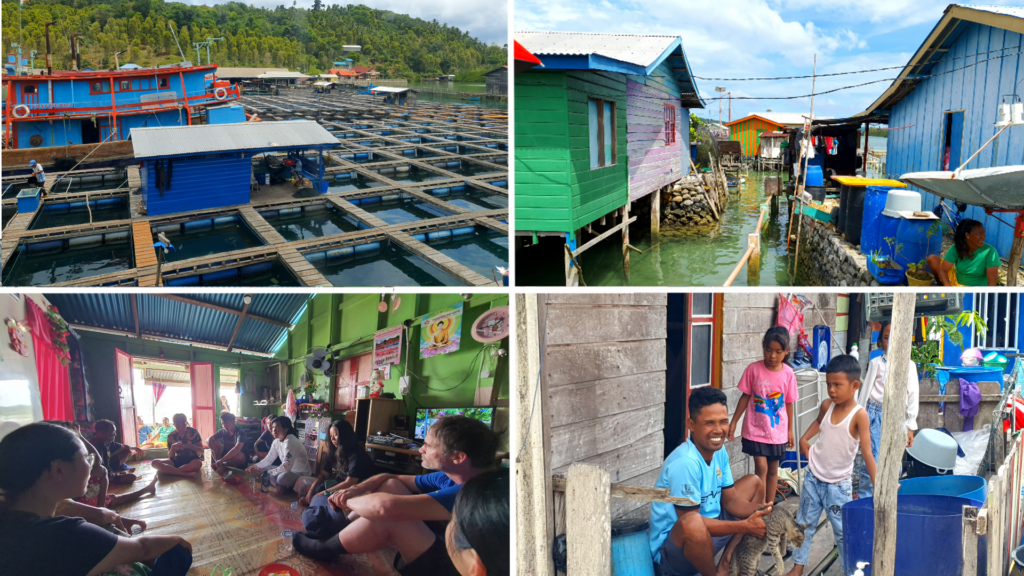
Through conversing with Keng Lei and other locals on the ground, the voyagers also gained valuable insights into the various aspects and nuances of kampong life, from culture and history to economy and family structure. Of particular interest was the village’s unique religious composition—an agglomeration of Buddhists and Christians—thanks to its history as a Chinese settlement generations ago, before Christian missionaries arrived in the colonial era.
“Some of them speak Mandarin Chinese, and others speak Chinese dialects like Hokkien and Cantonese. What is more interesting is they have been partly assimilated into Indonesian culture, mainly speaking Bahasa Indonesia,” Timothy Timuari Li Zhi, a Year 4 major in Global Studies and Southeast Asian Studies, observed. “The Chinese temple we visited also featured a fusion of the Chinese deity Tua Pek Gong with local Indonesian influences, resulting in a fascinating syncretism between Chinese culture and Indonesian culture.”
Besides the cultural aspects of Air Sena, the voyagers also witnessed the village’s economy in action, from small-scale fishermen heading out for the day’s work to the village’s extensive floating kelongs that farm species like grouper and Napoleon wrasse as part of its growing fish export enterprise.
Living Biodiversities: A Study in Reef Ecology
No voyage would be complete without experiencing the flora and fauna of the region. The voyagers had ample opportunities to kayak, swim and snorkel in the crystal-clear cerulean waters of the Anambas Islands, located within the famed Coral Triangle that supports one of the richest marine biodiversities in the world.

Immersed in the world beneath the waves, they witnessed first-hand the extensive, thriving coral reefs of Tokong Malangbiru and Sagudampur, and the breathtaking smorgasbord of marine life they harbour. Among the numerous coral species spotted around islands and in lagoons were brain coral, staghorn coral, and table coral, mesmerising swathes of shapes and colours through which residents of the reef darted.

From blue sea stars, giant clams and anemones, to parrotfish, striped surgeonfish, clownfish, and multiple species of butterflyfish and damselfish, the voyagers observed the vibrant underwater ecosystem up close, and were even accosted by a particularly inquisitive longfin batfish. The experience was a first for some voyagers, cultivating an understanding and appreciation of the vast biosphere and the complex symbiotic interconnections between its various components.
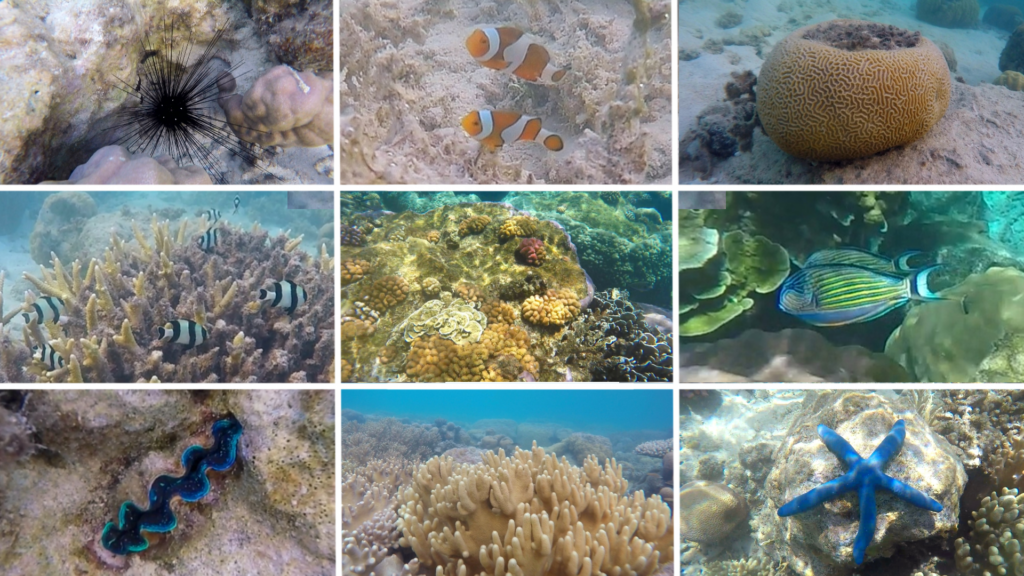
Besides being immersed in the beauty of reef ecology, the voyagers came up close with the sobering realities of climate change and global warming at some snorkelling locations—bleached, desolate reefs covered with detritus and devoid of the colour and splendour of the healthier reefs. Accompanied by Dedi Kurniawan, a Marine Science student from Universitas Maritim Raja Ali Haji (UMRAH) who shared his extensive knowledge on coral reefs, they also learnt about the damage that destructive fishing techniques such as trawling inflict on the ocean floor, and other threats to marine and reef biodiversity.
This is the first instalment of a two-part series on the NUS Seafarers “Understanding Anambas” STEER voyage and first appeared in NUSnews on 20 July 2023. Stay tuned for the second instalment of the voyagers’ experiences on the high seas and read more about the NUS Seafarers, or check out their YouTube channel!
Analysis: To What Extent can Extreme Weather Affect People’s Lives?
IN BRIEF | 10 min read
- Dr Serina Rahman (NUS Southeast Asian Studies) discusses the negative impact adverse climate and environmental conditions have on societies, and the complex relationships that sometimes make accountability more difficult to establish.
Click through image below to read this piece.
This article first appeared in Suria News Online and NUSNews on 5 and 6 June 2023, respectively.
NOTE FROM KL: Sports shirts & 'comfortable but decent' clothing is not a long-term solution to beat heat waves
IN BRIEF | 7 min read A commentary by Dr Serina Rahman (NUS Southeast Asian Studies) in Mediacorp Berita News Online. Read the article here:https://berita.mediacorp.sg/komentar/nota-dari-kl-baju-sukan-pakaian-selesa-tetapi-sopan-bukan-huraian-jangka-panjang-lawan-gelombang-haba-755421?cid=internal_sharetool_iphone_14052023_berita
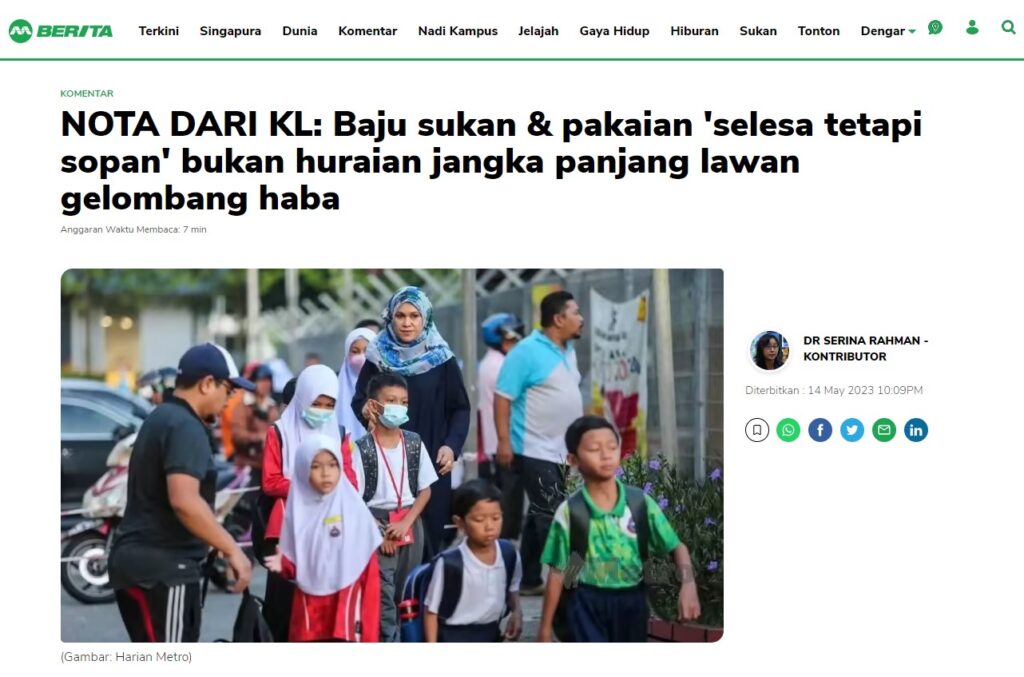 This story first appeared in Mediacorp Berita News Online on 14 May 2023.
This story first appeared in Mediacorp Berita News Online on 14 May 2023.Upbeat Hari Raya Mood in Malaysia Belies Simmering Tensions
IN BRIEF | 10 min read
- Notwithstanding the positive Hari Raya atmosphere as benefits from the budget trickle down, this may be the calm before a possible political storm at the ballot box, cautions Dr Serina Rahman (NUS Southeast Asian Studies).
Click through image below to read this piece.
This article first appeared in The Straits Times and NUSNews on 22 April 2023.
NEW PUBLICATION: The Camphor Tree and the Elephant: Religion and Ecological Change in Maritime Southeast Asia
The Camphor Tree and the Elephant Religion and Ecological Change in Maritime Southeast Asia
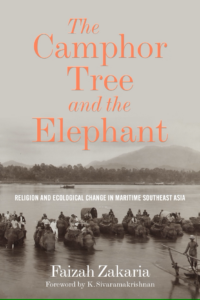 What is the role of religion in shaping interactions and relations between the human and nonhuman in nature? Why are Muslim and Christian organizations generally not a potent force in Southeast Asian environmental movements? The Camphor Tree and the Elephant brings these questions into the history of ecological change in the region, centering the roles of religion and colonialism in shaping the Anthropocene—“the human epoch.”
Historian Faizah Zakaria traces the conversion of the Batak people in upland Sumatra and the Malay Peninsula to Islam and Christianity during the long nineteenth century. She finds that the process helped shape social structures that voided the natural world of enchantment, ushered in a cash economy, and placed the power to remake local landscapes into the hands of a distant elite. Using a wide array of sources such as family histories, prayer manuscripts, and folktales in tandem with colonial and ethnographic archives, Zakaria brings everyday religion and its far-flung implications into our understanding of the environmental history of the modern world.
Faizah Zakaria is assistant professor in the Departments of Southeast Asian Studies and Malay Studies at the National University of Singapore. She is coeditor of Fatwas of Singapore: Science, Medicine and Health.
What is the role of religion in shaping interactions and relations between the human and nonhuman in nature? Why are Muslim and Christian organizations generally not a potent force in Southeast Asian environmental movements? The Camphor Tree and the Elephant brings these questions into the history of ecological change in the region, centering the roles of religion and colonialism in shaping the Anthropocene—“the human epoch.”
Historian Faizah Zakaria traces the conversion of the Batak people in upland Sumatra and the Malay Peninsula to Islam and Christianity during the long nineteenth century. She finds that the process helped shape social structures that voided the natural world of enchantment, ushered in a cash economy, and placed the power to remake local landscapes into the hands of a distant elite. Using a wide array of sources such as family histories, prayer manuscripts, and folktales in tandem with colonial and ethnographic archives, Zakaria brings everyday religion and its far-flung implications into our understanding of the environmental history of the modern world.
Faizah Zakaria is assistant professor in the Departments of Southeast Asian Studies and Malay Studies at the National University of Singapore. She is coeditor of Fatwas of Singapore: Science, Medicine and Health.NOTE FROM KL: Developing Civilized Malaysia, how far does Budget 2023 help the people?
IN BRIEF | 6 min read A commentary by Dr Serina Rahman (NUS Southeast Asian Studies) in Mediacorp Berita News Online. Read the article here: https://berita.mediacorp.sg/dunia/nota-dari-kl-membangunkan-malaysia-madani-sejauh-mana-belanjawan-2023-membantu-rakyat-742476?cid=internal_sharetool_iphone_26032023_berita
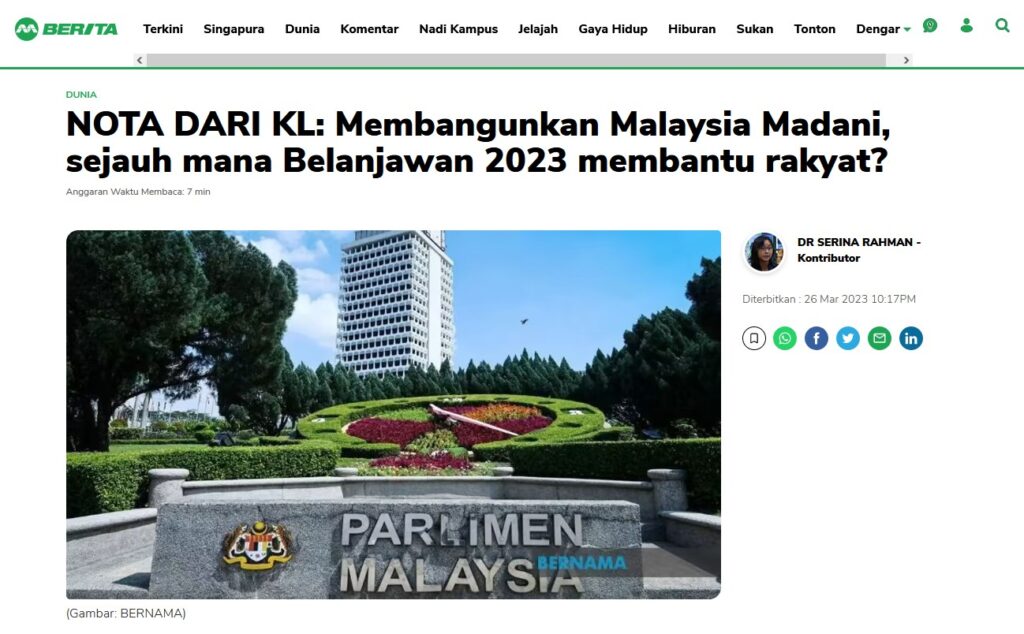 This story first appeared in Mediacorp Berita News Online on 26 March 2023.
This story first appeared in Mediacorp Berita News Online on 26 March 2023.Commentary: When shopping giant Mustafa meets retail paradise Johor Bahru
A commentary by Dr Serina Rahman (NUS Southeast Asian Studies) in ChannelNewsAsia online. Read the article here: https://www.channelnewsasia.com/commentary/mustafa-centre-jb-shopping-malaysia-economy-3375021
 This story first appeared in ChannelNewsAsia online on 28 March 2023.
This story first appeared in ChannelNewsAsia online on 28 March 2023.What might happen if Padang is made Unesco World Heritage Site
This story first appeared in The Straits Times on 27 March 2023.
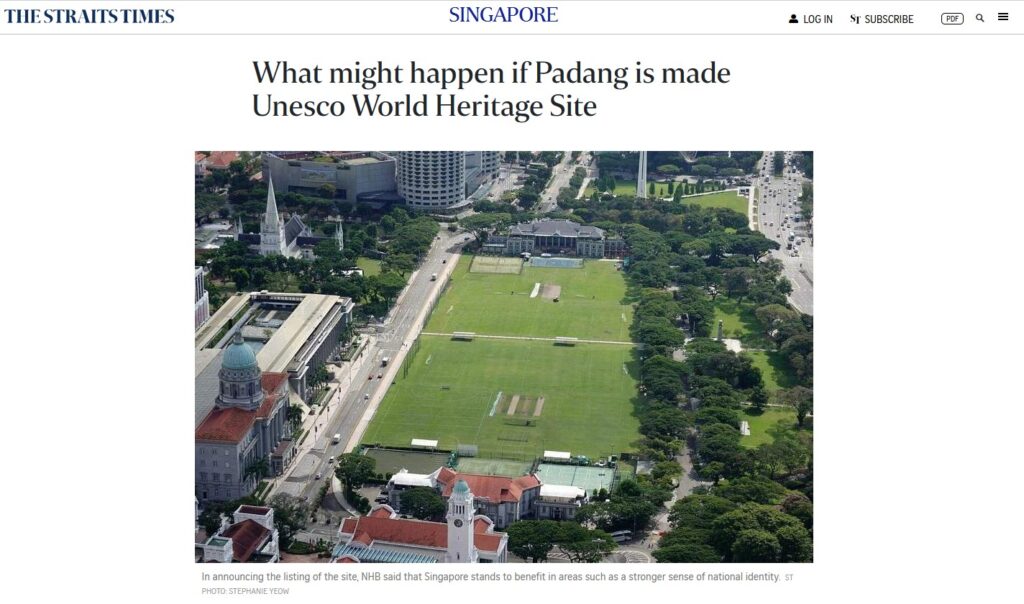
How would Singapore benefit from having a second Unesco World Heritage Site? Prof Hamzah hopes that marketing and tourism purposes would be secondary to getting Singaporeans more interested in local heritage sites. He is optimistic that the potential nomination will raise awareness and public knowledge about the less visible and intangible aspects of Singapore’s heritage, rather than just the “Instagrammable” tangible aspects of the historic buildings and areas. Prof Hamzah said that putting together a nomination also allows Singapore to better understand its history.Read the article here: https://www.straitstimes.com/singapore/what-happens-if-padang-and-surrounding-buildings-become-a-unesco-world-heritage-site
From Houses on Stilts to Eco-Houses: Former Lazarus Islanders Fondly Recall Their Old Home
This story first appeared in The Straits Times on 18 March 2023.
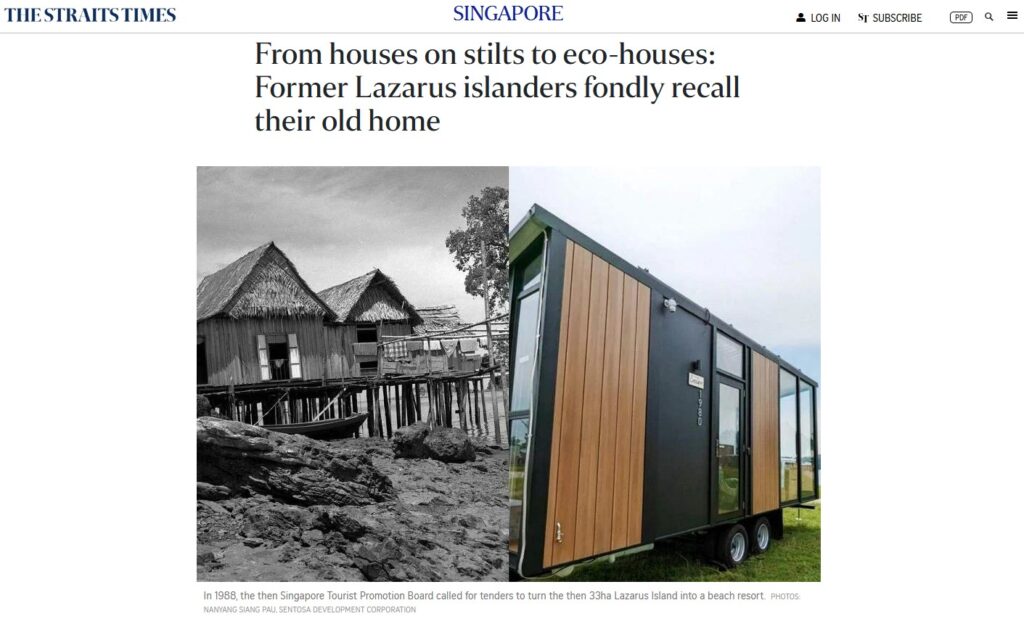
Lazarus Island, formerly known as Pulau Sekijang Pelepah, has recently been announced to be the site of new tourism developments. In ‘From Houses on Stilts to Eco-Houses: Former Lazarus Islanders Fondly Recall Their Old Home’ (Straits Times, March 2023), the history of this island is briefly revisited as locals look forward to its future possibilities.
Assistant Professor Hamzah Muzaini (NUS Southeast Asian Studies) reveals that, from the 1970s, plans were plotted to develop Lazarus Island for recreation purposes. Sentosa Island’s development would later come to fruition as part of this suite of plans. Lazarus Island’s inhabitants were relocated to the mainland in 1975 to facilitate further development of the island.
Although the original plans for the development of Lazarus Islands did not come to fruition in the 1980s, recreation plans in the form of short-term recreational accommodation are being restarted, according to parliamentary remarks by Minister of State for Trade and Industry Alvin Tan. This takes advantage of the islands existing lush greenery and natural scenery.
Once an inhabited island, Asst Prof Muzaini says that Lazarus Island was home to 44 houses across two kampungs at its peak. It had been inhabited from the early 1800s. Today, public representation of the communities that once lived on the island seems sparse.
As plans to convert Lazarus Island into an eco-conscious recreational space develop, Asst Prof Muzaini urges planners to incorporate lessons from former islanders’ coexistence with nature into the eco-tourism spot’s offerings.
Read the article here: https://www.straitstimes.com/singapore/from-houses-on-stilts-to-eco-houses-former-lazarus-islanders-fondly-recall-their-old-home
NOTE FROM KL: Is Menu Rahmah a one-time help or a starting point for a viable description?
IN BRIEF | 6 min read A commentary by Dr Serina Rahman (NUS Southeast Asian Studies) in Mediacorp Berita News Online. Click through to read this article.
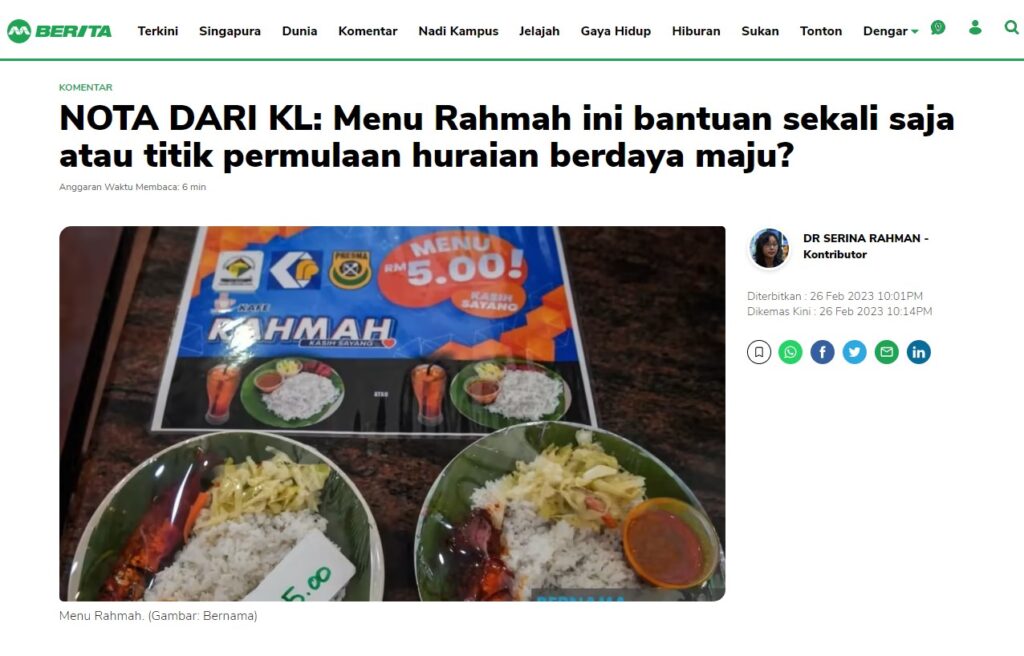 This story first appeared in Mediacorp Berita News Online on 26 Feb 2023.
This story first appeared in Mediacorp Berita News Online on 26 Feb 2023.Exploring the Spaces between the Arts, Social Issues and Academia
IN BRIEF | 8 min read
- This year’s edition of NUS Arts Festival features over 20 performances, films, public art, installations, and dialogues. It is also the first to return to pre-pandemic levels, and involves more than 700 NUS students, alumni, faculty, staff and collaborators, nearly twice of 2022 figures, and remains the largest performing arts event on campus..
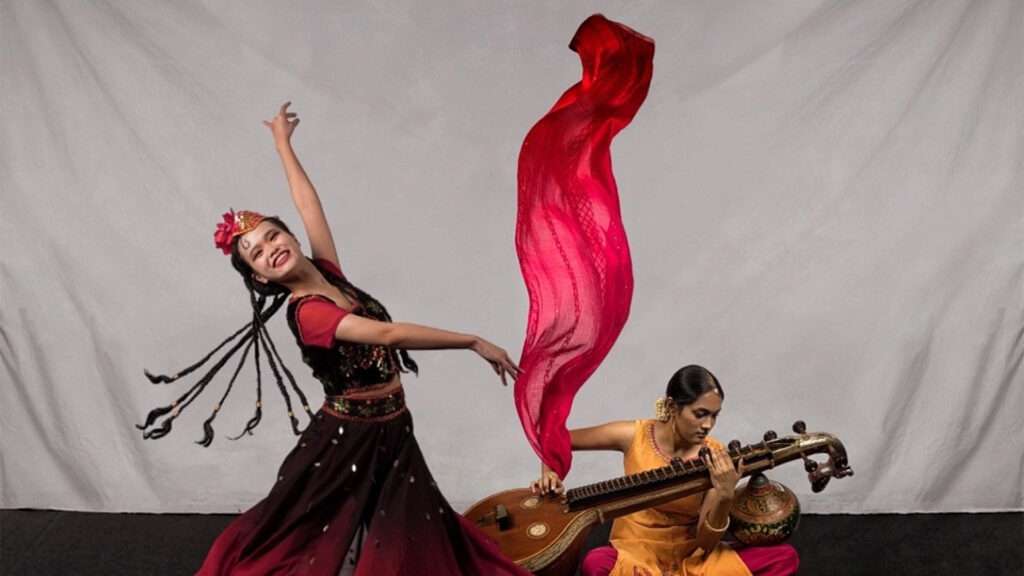
What can we learn from uncomfortable transitions and ambiguous spaces? The highlight of NUS’ performing arts calendar, NUS Arts Festival 2023: Spaces Between, returns to campus from 10 to 26 March 2023, and explores the idea of liminal spaces and the exciting, yet uncomfortable unknown that accompanies the transition between phases and states.
This year's theme, Spaces Between, is the finale to a trilogy of themes that began with A Question of Time in 2021 and Shades of Light(ness) in 2022. All three are universal concepts that drive the purpose of our everyday lives.
This year’s edition of NUS Arts Festival features over 20 performances, films, public art, installations, and dialogues. It is also the first to return to pre-pandemic levels, and involves more than 700 NUS students, alumni, faculty, staff and collaborators, nearly twice of 2022 figures, and remains the largest performing arts event on campus.
“The purpose of the festival theme is to allow us to reflect on the times we live in through art. Furthermore, art has always been a vehicle in which we rediscover ourselves, encounter a confluence of different ideas, and ask difficult questions,” said Festival Director, Jobina Tan.
“As we live in a world of diverse and divided views, I hope the theme demonstrates our perennial need to constantly negotiate between varied perspectives and find more meeting points with each other."
Professor Audrey Yue, Head of Department of Communications and New Media, and Festival Faculty Advisor, added, “While we recover from the downturn of the pandemic, we also arrive at the intersection of concurrent crises including global economic, racial and geopolitical unrests. How do we boldly unfold and spring forth from the complexity of this conjunction?”
Indeed, the theme has inspired a bumper crop of interdisciplinary artistic collaborations, bringing together different art forms, student groups, and academic departments. Many of these are rare partnerships or first-of-its-kind pairings within NUS, with a handful pushing the envelope to address contemporary issues which resonate with youths in Singapore.
One such collaboration is the festival opening show, Inter/change, which marries the two contrasting traditional art forms practiced by NUS Chinese Dance and NUS Indian Instrumental Ensemble. Led by Artistic Director, Jenny Neo, dance choreographer, Xiao Jing, and musician Nawaz Mirajkar, the production is inspired by the history and evolution of the Silk Road as well as its cultural impact and relevance in our world today.
“Inter/change allows us to explore and interpret the theme as spaces between two different parts of the world joined together by the Silk Road, as well as the idea of spaces between different viewpoints, ideologies and cultures. The idea of liminality can possibly be explored through the interactions between these two civilisations and through the comparisons which highlight similarities between the Indian and Chinese ways of life,” said Lee Ruo Shi, Dance Captain of NUS Chinese Dance, and a second-year Accountancy student.
Another unique collaboration is Essentially Macbeth, featuring NUS Chinese Drama and NUS Chinese Orchestra. A Chinese language play-within-a-play, the production follows the lives of young graduates who reconnect with theatre after a pronounced absence, and questions the relevance of the arts in our everyday lives. The play is inspired by the public conversations about artists being considered “non-essential” workers in Singapore, during the COVID-19 pandemic.
“I suggested to Moses, conductor of NUS Chinese Orchestra to let NUS Chinese Drama and NUS Chinese Orchestra tackle a Western classic by Shakespeare. Moses suggested getting composer Phang Kok Jun to write original music for this daring piece of work. I think we both saw this as a chance to play, learn and explore new boundaries for our art form,” said NUS alumna Judy Ngo, who directs the play.

Presented by Malay cultural dance group NUS Ilsa Tari, together with NUS Dikir Barat, Pengabdian Batin (or “Inner Enslavement” in Malay) aims to deconstruct the stigma surrounding Intimate Partner Violence amongst the Malay/Muslim community. This production is helmed by Artistic Director, Osman Abdul Hamid.
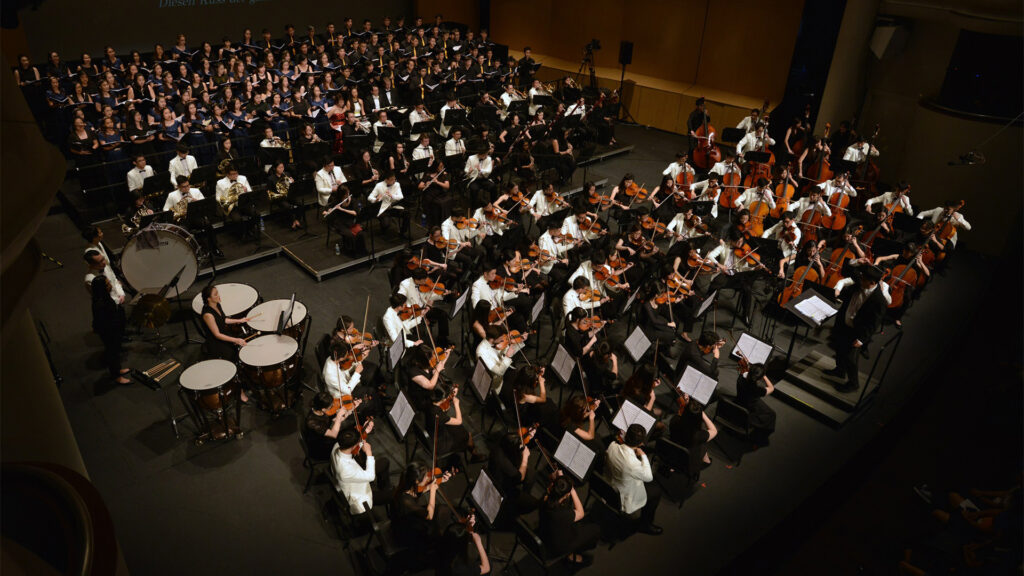
Promise of a Future celebrates the union of artists and their art forms, bringing the largest number of performers on stage within the festival. Some 182 musicians from NUS Symphony Orchestra, The NUSChoir, and NUS Yong Siew Toh Conservatory of Music, will present musical interpretations of the triumph of hope over uncertainty, which includes Mozart’s famous Coronation Mass. This is the first in-person collaboration between NUS Symphony Orchestra and The NUSChoir since 2018.
“Now that we are back to pre-pandemic productions, watching everything unfold again at full scale, how it was meant to be, is far grander and exciting than what any of us could've imagined. It's certainly only a special, magical moment that you can only feel it in person, live, either as a performer on stage or an audience,” said Wong Ting Feng, President of NUS Symphony Orchestra, and a fourth-year Philosophy, Political Science, and Economics student.
The NUS Arts Festival is generously supported by donors, namely, Hong Leong Foundation, Shaw Foundation, Kwan Im Thong Hood Cho Temple, The Ngee Ann Kongsi, Salleh Marican Foundation and the Ministry of Culture, Community and Youth’s Cultural Matching Fund.
For more information, please visit nusartsfestival.com.
This NUS Centre for the Arts story first appeared on NUSnews on 9 March 2023.
NUS Open House: More than 7.7M Visitors Drawn to Action-Packed Showcase over 10 Days
IN BRIEF | 25 min read
- NUS Open House 2023 saw a strong showing by visitors eager to find out about the University’s academic programmes, as it returned in from 25 February to 6 March. Some 7.71 million visitors attended the physical and online showcase which involved 3,071 faculty and staff, students and alumni.
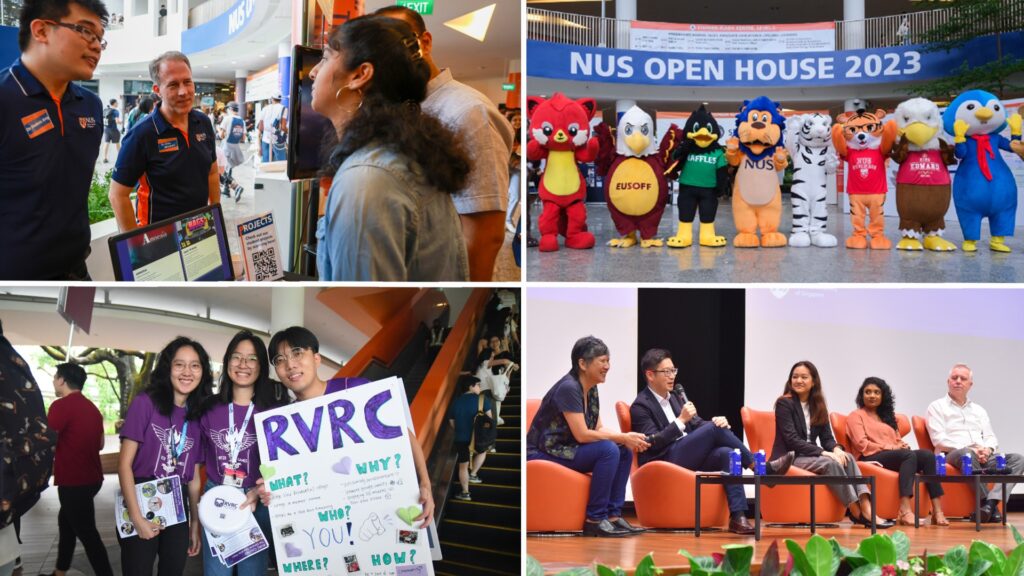
NUS Open House 2023 saw a strong showing by visitors eager to find out about the University’s academic programmes, as it returned from 25 February to 6 March. Some 7.71 million visitors attended the physical and online showcase which involved 3,071 faculty and staff, students and alumni.
Kicking off the 10 action-packed days were the informative virtual talks, webinars, and social media sessions. The on-campus event on 4 March saw packed crowds at the programme booths, talks, special classes, campus tours, student life performances and residential venues despite the heavy downpour. Prospective students gained valuable insights from faculty members, explored the University’s extensive global opportunities, as well as its diverse entrepreneurship platforms and lifelong learning courses, giving them a comprehensive overview of what NUS has to offer.
“I really enjoyed meeting the professors and students who are from the courses I'm interested in as I gained many insights from them on life in NUS and the various possibilities that are open for exploration,” said prospective student Karthika Warrier, an alumna from Raffles Institution who is considering applying to NUS Computing or the College of Humanities and Sciences (CHS).
Jasmine Chiam, an alumna from Nanyang Junior College (NYJC) who is interested in applying to CHS and NUS College, agreed. “The programme was well-run despite the fact that it was raining,” she said. “I felt that it was well-curated for students with different interests.”
A draw for many prospective students were CHS, the newly launched NUS College, and the College of Design and Engineering (CDE) – the University’s recent interdisciplinary pathways aimed at meeting the evolving demands of the workforce.
Addressing Shared Challenges with the Humanities and Sciences
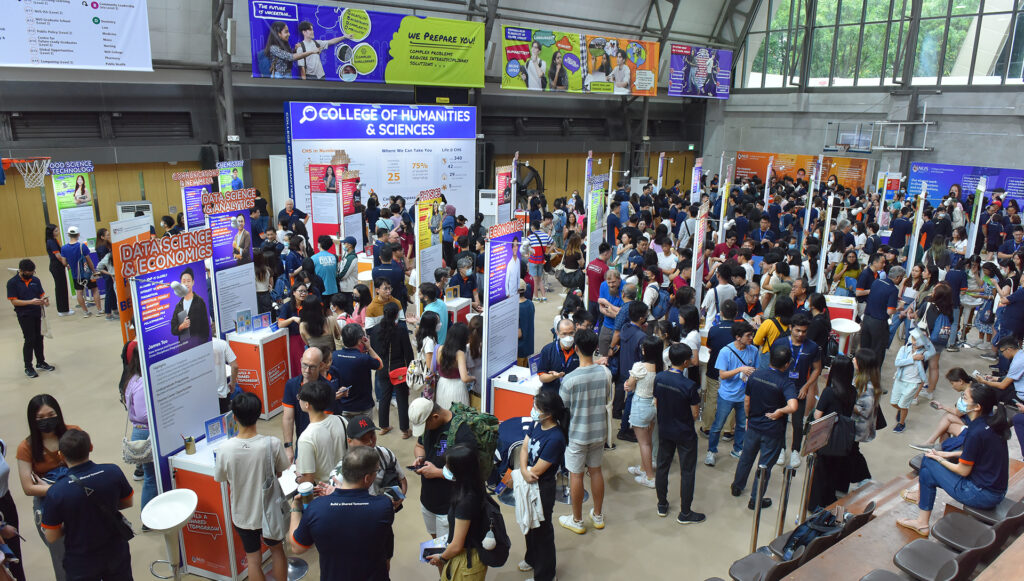
CHS, which provides an enhanced undergraduate experience for students of the Faculty of Science (FOS) and the Faculty of Arts and Social Sciences to pursue breadth and depth across academic disciplines, showcased its Common Curriculum throughout the Open House.
Currently accepting its third intake, it held talks on hot topics such as sustainability, food science and technology, and mental health to demonstrate how students can apply various perspectives to address complex real-world issues.
The panel entitled “Why Sustainability and Climate Change Matter” saw speakers from the Geography, Japanese Studies, Anthropology and English, Linguistics and Theatre Studies departments weighing in on the topic from their respective disciplines. Another session by the Department of Food Science and Technology explained how its programme applies principles from chemistry, biology, engineering and nutrition to address issues such as food safety and security, as well as the careers its graduates can pursue.
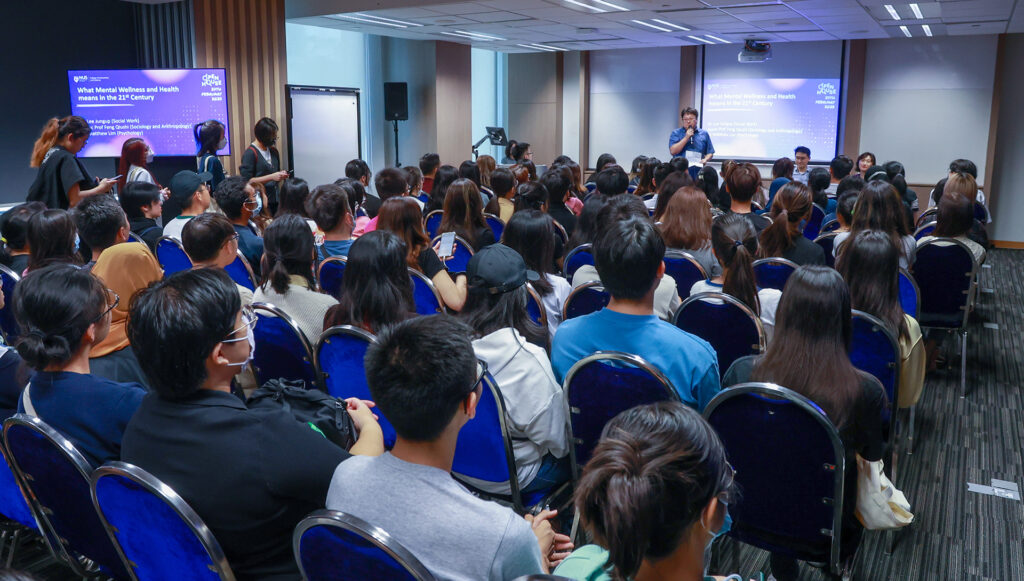
In the same vein, the panel “What Mental Wellness and Health Means in the 21st Century” saw speakers from the Social Work, Sociology and Psychology departments discuss perceptions of mental health in society. Dr Lee Jungup, an Assistant Professor in Social Work, pointed out the close relationship between social work and psychology. “Many of our Social Work students consider a double major with Psychology,” she said, noting that social work emphasises the practical while psychology is more theoretical and clinical in nature.
Jasmine, the NYJC alumna, said the various informative talks reaffirmed her decision to apply to NUS. “The NUS College tour as well as the CHS Common Curriculum sharing were particularly informative. They made the programmes seem quite appealing and I am looking forward to applying for both,” she said.
For some like Christian Chua, an alumnus from the NUS High School of Math and Science, attending the Open House talks helped clarify the career options available for the different programmes.
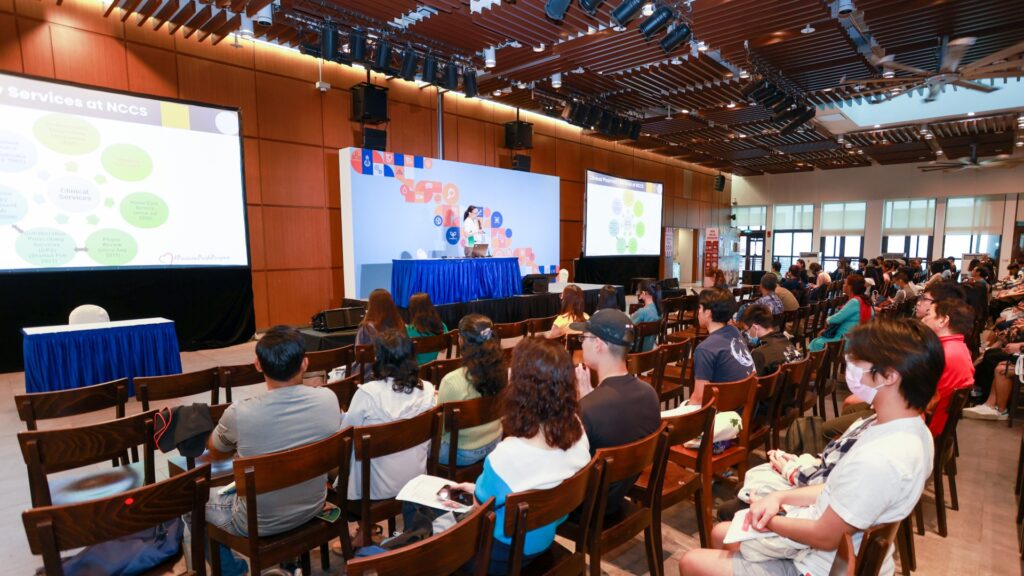
Christian, who is currently considering the Medicine, Pharmacy, and Pharmaceutical Science programmes, attended the Pharmacy talk and booth, where faculty members of different specialisations touched on the various career pathways and the collaborative practices of the discipline.
“It was useful that they discussed the different careers that Pharmacy graduates had gone into so I knew a degree in Pharmacy wouldn't just limit me to community or hospital pharmacy but also to the R&D, drug approval side, or the business side as well,” he said.
Shaping the Future of Design and Engineering
Meanwhile, there was action aplenty over at both the online and in-person Open House by CDE, which is accepting its second intake. Officially launched in November 2021, CDE was a merger of the Faculty of Engineering and the School of Design and Environment, ramping up the distinctive interdisciplinary experience at NUS.
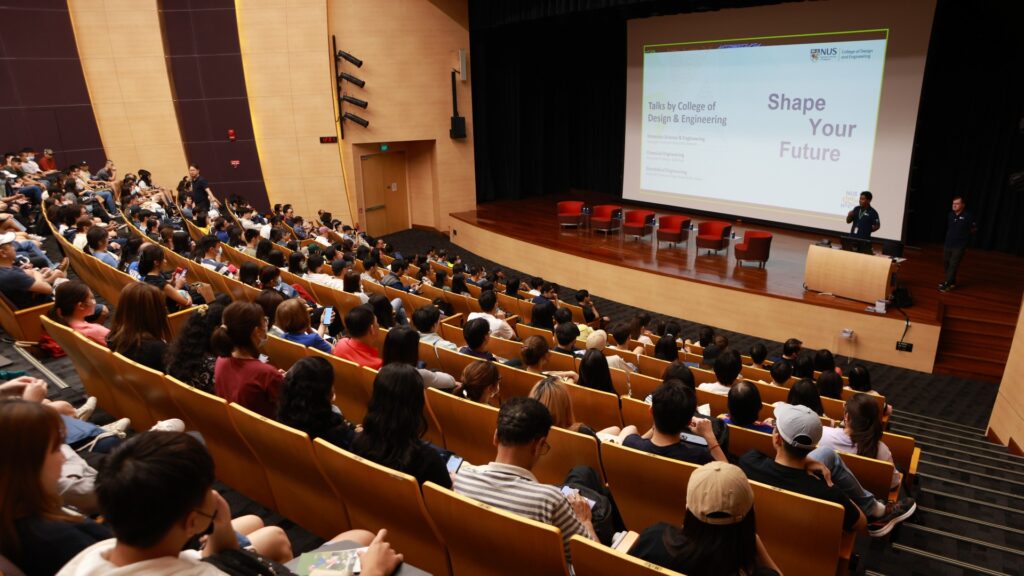
From the Common Curriculum and the multidisciplinary education model, to the Student Exchange Programme and future career prospects, CDE faculty and students shared their insights on a plethora of topics with prospective students.
The talks, such as the one on Biomedical Engineering, Chemical Engineering and Materials Science & Engineering, also provided valuable information. Prospective students learnt how undergraduates are exposed to a range of interdisciplinary topics with global-scale applications in class, and how NUS engineers are taking on the world’s biggest challenges, such as clean energy.
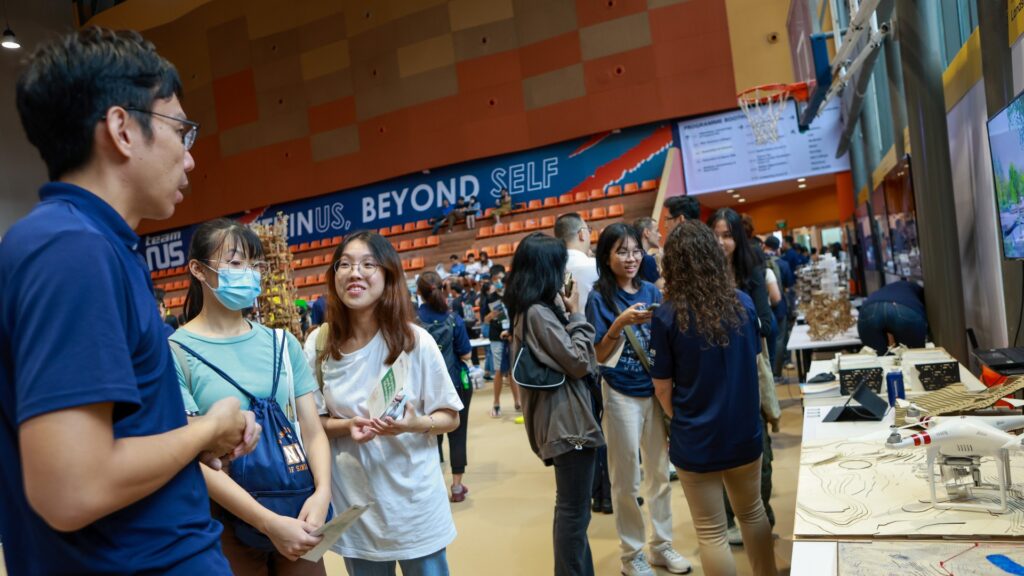
The talk on Architecture, Industrial Design and Landscape Architecture also saw a large turn-out. Discussing the breadth and depth of CDE’s curriculum, it touched on how students will be equipped to face the 21st-century challenges through their education in CDE.
Kaisyn, who is graduating from Nanyang Polytechnic this year, said, “I appreciated that they covered the basic skills and activities done throughout the curriculum. It allowed me to confirm that the Industrial Design course is relevant to my study and career plan.”
The in-person Ask-Me-Anything sessions with student panels also allowed participants to get their burning questions answered.
Tee Jia Hong, a graduate of Anglo-Chinese Junior College who intends to apply to Industrial and Systems Engineering (ISE) and attended the student sharing, said, “By listening to the experience from the ISE senior, I am able to get the hang of the academic and co-curricular prospect of being an ISE student.”
Over at CDE’s Rise of the Robots campus tour, participants were given a look at the Advanced Robotics Centre, which displayed projects such as an autonomous wheelchair, an artificial robotic arm, and a haptic feedback machine.
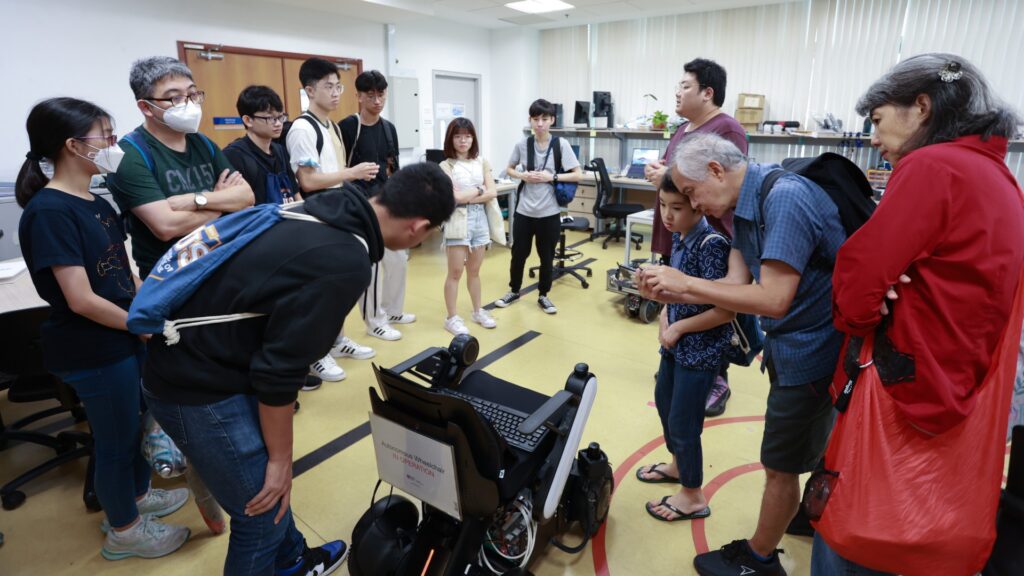
Robert Lim from Singapore Polytechnic, who attended the tour, said, “It was a memorable experience . . . I was able to learn more about what the courses have to offer and what undergrad students have accomplished in NUS.”
Exploring experiential learning
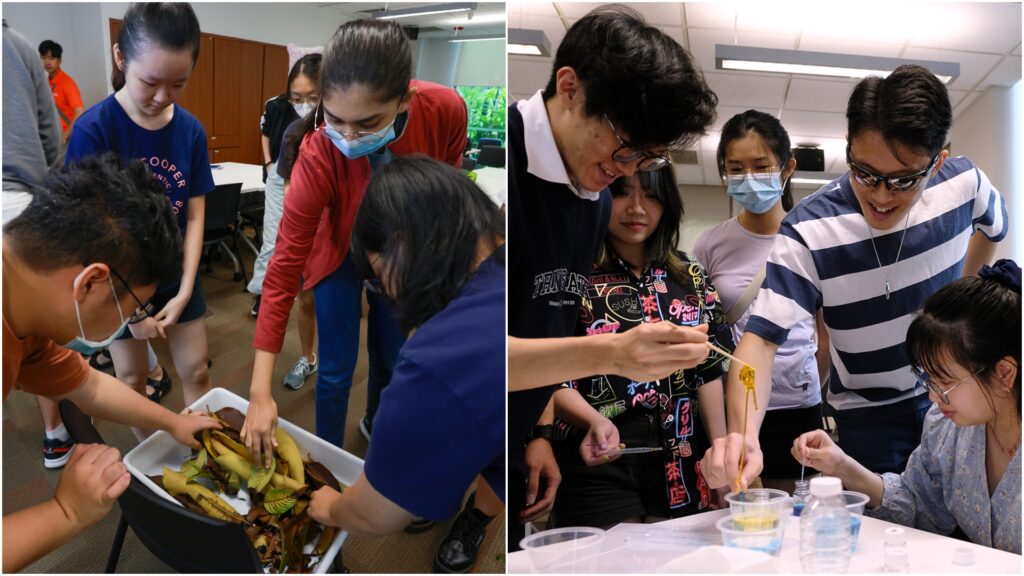
NUS College, Singapore’s first honours college, offered a glimpse of its flagship experiential learning programmes during its online and physical showcase. Faculty members highlighted the Impact Experience programme, where students develop solutions to real-world issues with community partners, and the Global Experience programme, which immerses them in global cities for specially curated courses and field visits based on specific themes.
The college, which is accepting its second intake, also held special classes for prospective students to get a feel of its small-group seminar-style lessons. Dr Ang Yuchen’s special class introduced his field course Biodiversity and Natural History in Singapore, which combines scientific concepts with the visual and language arts and environmental philosophy.
“I found the sample lessons useful in helping me not just get a sense of how lessons are conducted over at NUS College, but also how my potential Profs are like as teachers and facilitators,” said Eugene Teo, an alumnus of Raffles Institution, explaining that small, collaborative discussions was better suited to his learning style. Attending the Open House “also gave me a better understanding of the people I will be interacting with and the environment in which I would be studying in upon entering university life”, he added.
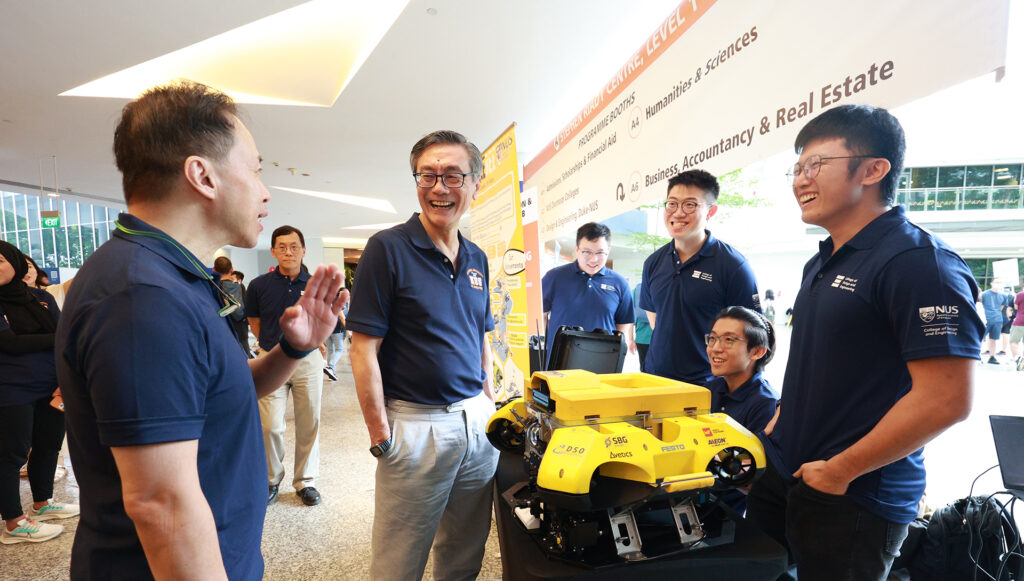
Interactivity was a prominent feature of the Open House. NUS Nursing offered visitors a chance to try basic wound treatment and resuscitation, while NUS Law held moot demonstrations at its Bukit Timah Campus.
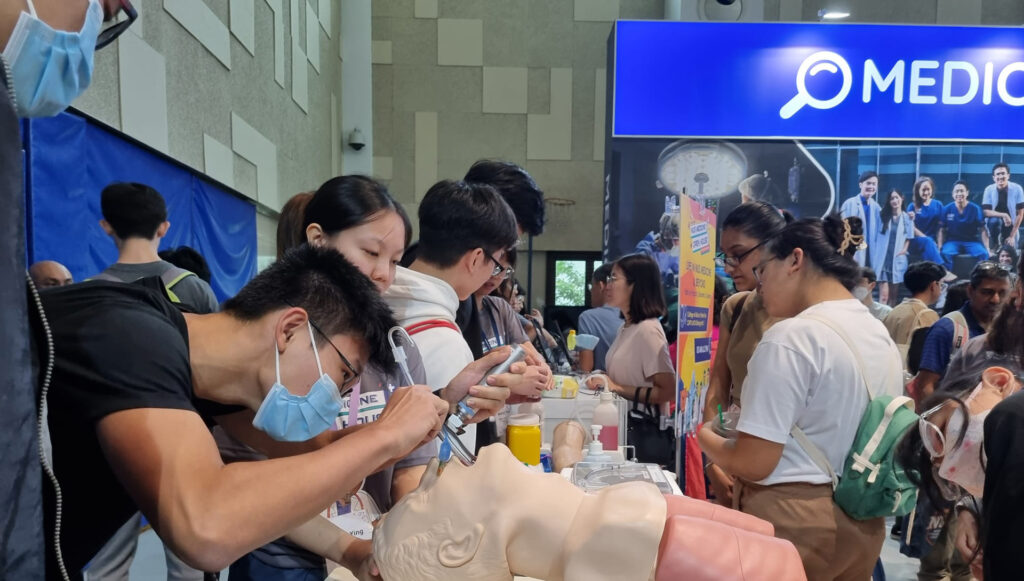 |
 |
Aqirah Bte Azam, who will be graduating from Temasek Polytechnic in May, had the chance to see the Nursing students in action and attended a talk by its alumni. “Hearing their experiences in NUS and their careers have given me the courage to pursue my aspirations in nursing”, she said.
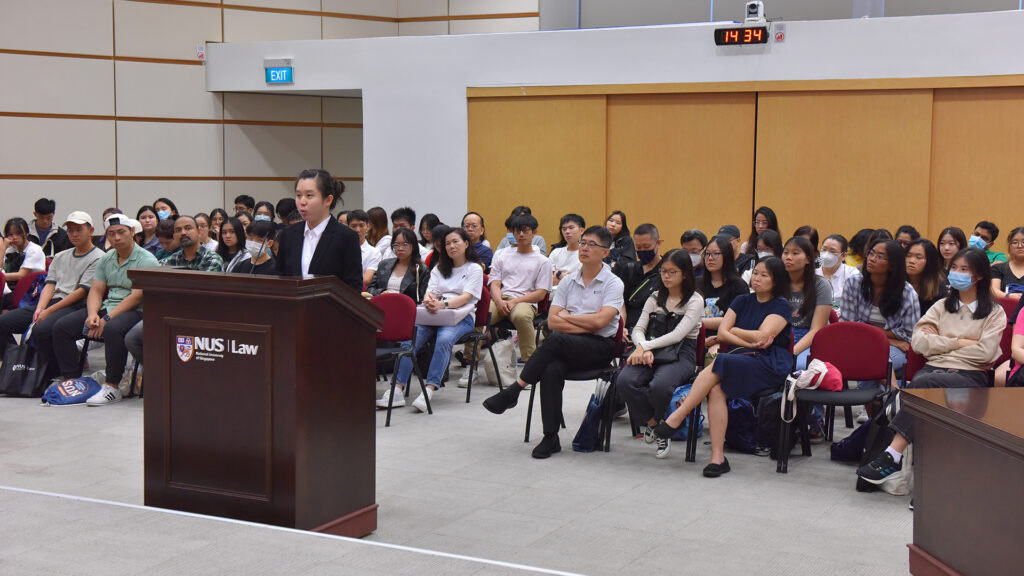
Smorgasbord of Student Life
Visitors also got a taste of the vibrant NUS student life on display. Student clubs and societies, as well as the Hall and Residential College (RC) interest groups, put their best foot forward at the Student Village.
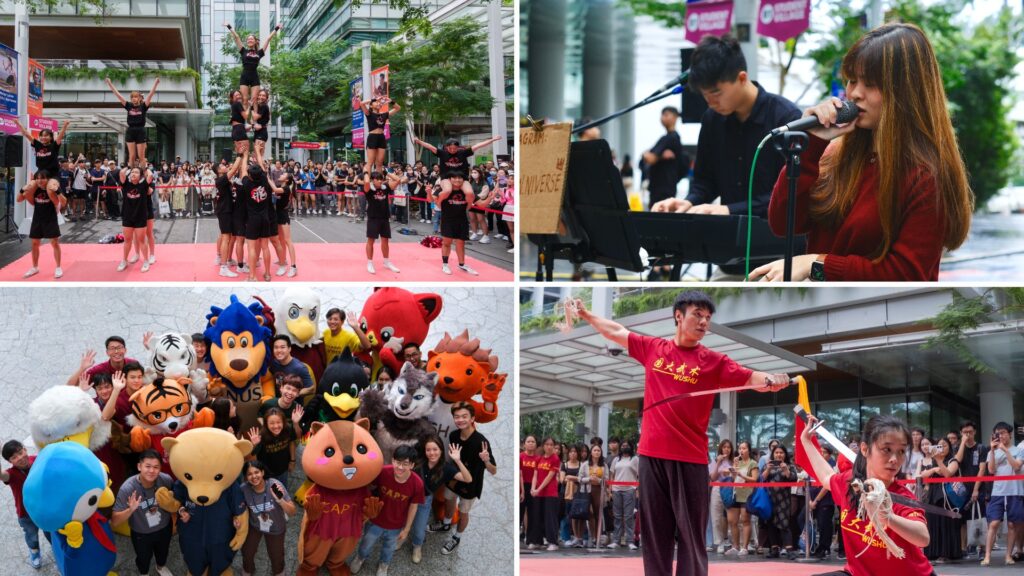
Visitors were wowed by the striking moves of NUS Wushu, the energetic cheerleading displays of King Edward VII Hall’s KE Titans, and the snazzy K-pop dance moves of the Korean Cultural Interest Group. They were also treated to renditions of catchy tunes from Mandopop group NUS CAC Voices, acapella group NUS Resonance, Raffles Hall rock and jazz band RHockerfellas, and many more.
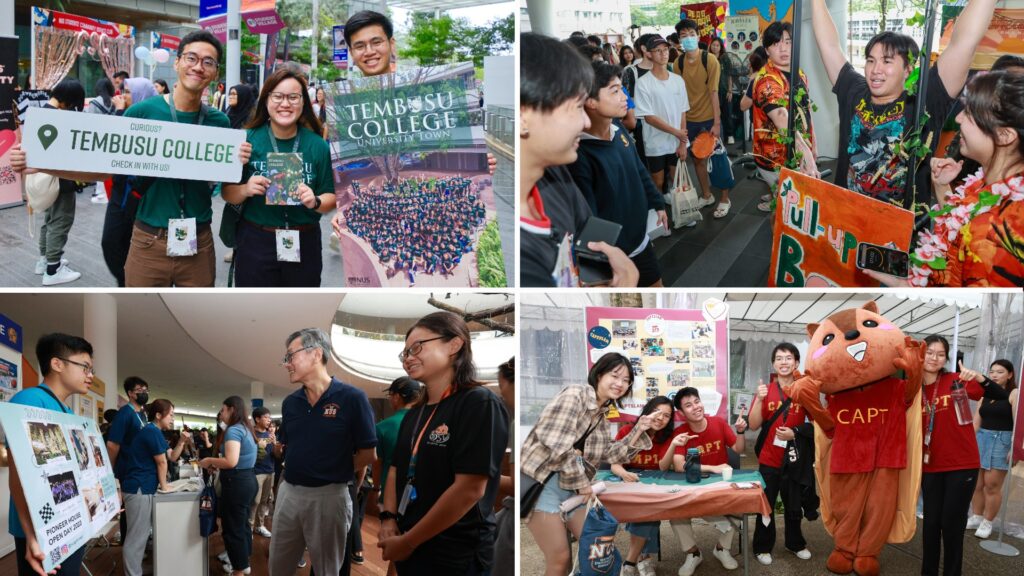
Representatives from the RCs, halls, and houses were present to offer prospective students the inside scoop on the on-campus experience. Complemented by A-Day-in-the-Life videos and 360° virtual tours, the booths, talks, and Ask-Me-Anything panels by student leaders gave participants a sense of the residential options at their fingertips.
“The House Life talk was the most enjoyable and informative event to me since the masters and students really explained to me what living in houses was like, while keeping us engaged through jokes and videos,” said Jia Hong.
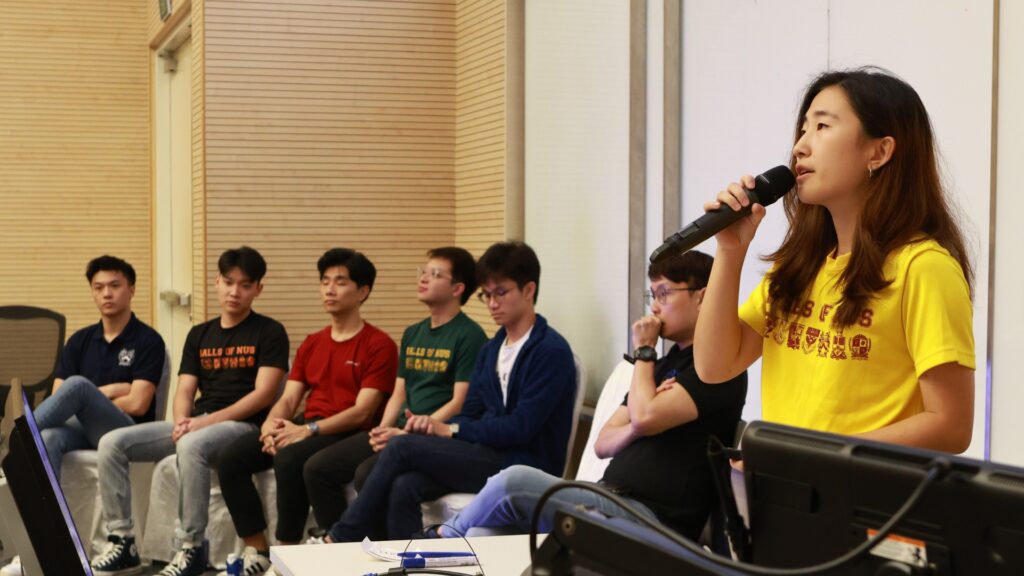
Charlotte Toh from Singapore Polytechnic, said the Halls talk helped her better understand the hall culture and admission criteria.
Guided in-person tours of the various halls and residences, such as King Edward VII Hall, Tembusu College, Ridge View Residential College, and Residential College 4, opened a window to the close-knit community of residential life.
Samuel Liu, who graduated from National Junior College, said, “The well-guided tours and booths set up for each RC that I visited gave me a good indication of which RC would be most suitable for my character and goals.”
This story first appeared on NUSnews on 9 March 2023.
FASS Inspiring Mentor 2022 Award Winners Announced

The NUS Faculty of Arts and Social Sciences is proud to announce the winners of the 2022 FASS Inspiring Mentor Awards.
Congratulations to:
- Assoc Prof Melvin Yap Ju-Min, Associate Professor, Department of Psychology
- Assoc Prof Robin Loon Seong Yun, Associate Professor, Department of English Language and Literature
- Dr Amazaki Osamu, Senior Lecturer, Centre for Language Studies
- Dr Natalie Pang Lee San, Senior Lecturer, Department of Communications and New Media
- Dr Kamalini Ramdas, Senior Lecturer, Department of Geography
The NUS Career Compass 2023
IN BRIEF | 5 min read
- Find out how the University has developed and broadened our curriculum to better prepare our graduates for the swiftly evolving workplace, and how interdisciplinary learning can help students solve complex issues in our society.

In collaboration with CNA938
How does NUS cultivate highly sought-after talents in the workforce of the future?
Find out how the University has developed and broadened our curriculum to better prepare our graduates for the swiftly evolving workplace, and how interdisciplinary learning can help students solve complex issues in our society.
This story first appeared on NUSnews on 23 February 2023.
CHS at NUS Open House 2023: Download the FASS Essentials on 27 February 2023
IN BRIEF | 10 min read
- On 27 February, get the full download on the essentials of academic programmes, student life, career preparation, overseas opportunities and financial aid at CHS via Zoom in the ‘virtual’ edition of CHS@NUS Open House 2023.
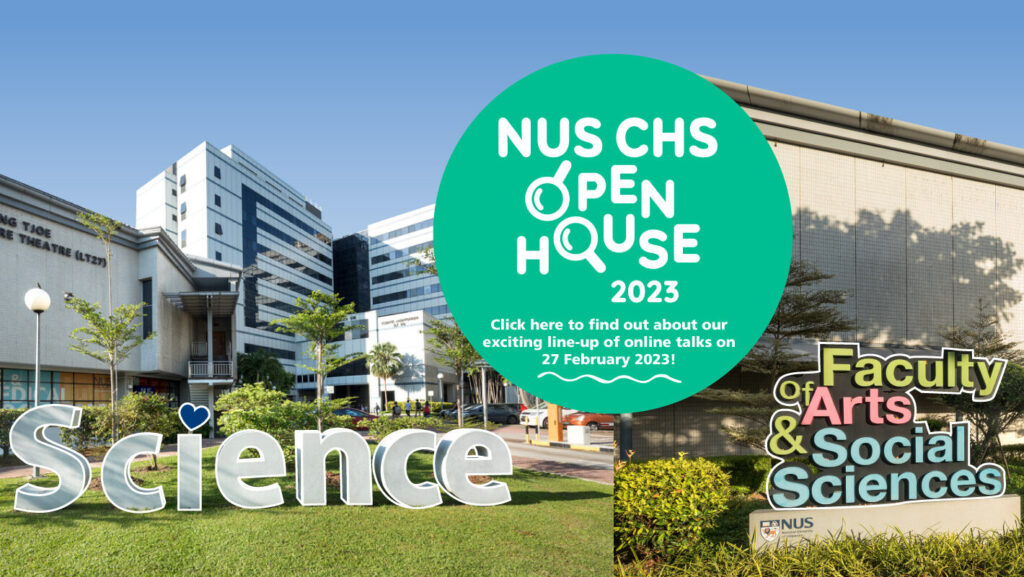
If you have not already marked your calendars for two dates with the NUS College of Humanities (CHS) during NUS Open House 2023, do it now!
On 27 February, get the full download on the essentials of academic programmes, student life, career preparation, overseas opportunities and financial aid at CHS via Zoom in the ‘virtual’ edition of CHS@NUS Open House 2023. Go to https://bit.ly/CHSatNUSOH2023-Virtual for the full 27 February programme.

Then prepare to come on-campus on 4 March to engage with our award-winning faculty members, advisors and students to experience interdisciplinary education and explore your future vocation. Go to https://bit.ly/CHSatNUSOH2023-OnCampus for the full 4 March programme.
To help you plan your way through the lineup of FASS-specific talks and activities, read on for some of our highlights on 27 February 2023 that ought not to be missed.
Academics at the Forefront
The online edition of CHS@NUS Open House is meant to provide you with as comprehensive a briefing of what CHS, and its component Faculties of Arts and Social Sciences, and Science, have to offer students.
Academics is at the forefront and the day starts with a session devoted to the CHS Core Curriculum (9:00 – 11:00 am), a specially curated interdisciplinary programme that provides unprecedented freedom to choose the pursuit of breadth and depth across a broad spectrum of disciplines. This session will be led by Professor Sow Chorng Haur, Vice Dean (Outreach & Admissions), NUS Faculty of Science (FoS), and Dr Noorman Abdullah, Assistant Dean (External Relations & Student Life), FASS.
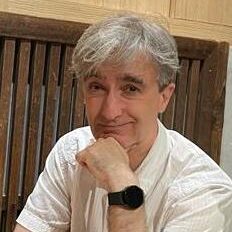
Associate Professor Luke O'Sullivan
The CHS Cross-Disciplinary Programmes
Three one-hour talks devoted to introducing Cross-Disciplinary Programmes (XDPs) offered by CHS will be running concurrently from 11:00 am. One programme FASS offers that embodies the concept of interdisciplinarity is the Philosophy, Politics, and Economics XDP, and the session for that will be led by Associate Professor Luke O’Sullivan (NUS Political Science) in discussion with fellow PPE Joint Programme Committee member, Dr Joel Chow (NUS Philosophy).
"This session is an opportunity to ask questions about the PPE-XDP. Philosophy, Politics, and Economics is a classic combination of disciplines that was first taught in Oxford and has spread globally because of its proven effectiveness. It brings together the ability to think about ideas in abstract and analytical terms, explore their practical implications for society, and model their costs and benefits in quantitative terms,” says Assoc Prof O’Sullivan. “PPE students can expect to develop a unique knowledge base and set of skills that leaves them suited for a wide range of careers in today's complex and fast-changing world."
Attendees are required to come prepared, because in addition to providing an overview of the PPE-XDP, Assoc Prof O’Sullivan expects audience engagement. Join the PPE-XDP session on 27 February at 11:00 am here.
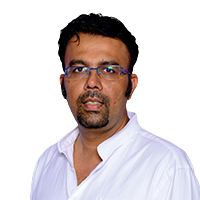
Associate Professor Rajesh Rai
Asian Studies @ CHS
NUS is recognised as a global centre of excellence in Asian Studies, where a multidisciplinary and comparative approach to the study of Asia and its regions is adopted. The session on programmes by the various Asian Studies departments at NUS (2:00 – 2:50 pm) will feature Associate Professor Rajesh Rai (NUS South Asian Studies), Dr Faizah Zakaria (NUS Malay Studies), Associate Professor Tham Shiao Wei (NUS Chinese Studies), Dr Clay Eaton (NUS Japanese Studies) and Dr Mohamed Effendy Abdul Hamid (NUS Southeast Asian Studies).
“You probably hear a lot about how Asia is the largest continent in the world, with the greatest diversity of cultures, philosophies, political thought and economic might, as well as scientific and technological advancement,” says Assoc Prof Rai, offering up a brief on the discussion he will be leading as moderator. “This session will take you through an interdisciplinary journey through history and current affairs to show you just how influential Asia has been a force for change, both positive and negative, on the world’s stage.”
Join this session by clicking here.
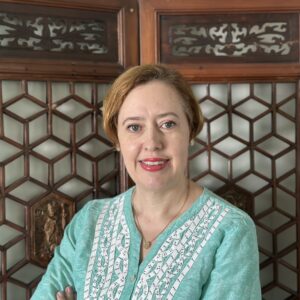
Humanities @ CHS
Learn more about the academic disciplines that focus on studying different aspects of the human condition from: Dr Donna Brunero (NUS History); Associate Professor John Whalen-Bridge, Associate Professor Graham Wolfe and Dr Leslie of NUS English, Linguistics and Theatre Studies; and Dr Zachary Barnett (NUS Philosophy).
“Do you: Ponder big questions regarding life, society, and culture? Wonder how language develops? Hold theatrical ambitions? Find yourself curious about connecting the past and present, the local and global?” session moderator Dr Brunero asks rhetorically. “If so, join us as we answer questions regarding our disciplines and share insights into how studying with us at NUS can broaden your horizons.”
To join Dr Brunero and her fellow speakers in this 3:00 - 3:50 pm session click here.
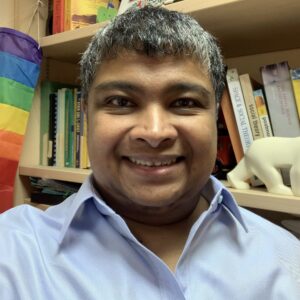
Social Sciences I: Same, Same but Different
This session features Dr Kamalini Ramdas (NUS Geography), Associate Professor Feng Qiushi (NUS Sociology and Anthropology), Dr Elaine Tan (NUS Political Science) and Dr Georgios Georgiou (NUS Economics), and will delve into their respective programmes as well as approaches toward forging a “collective identity”.
Session moderator Dr Kamalini explains. “This panel brings together social scientists from Economics, Geography, Political Science and Sociology to discuss what it takes to develop a collective identity as social scientists,” says Dr Kamalini, who will be working with her fellow speakers toward answering questions such as, “What are the benefits and challenges of a collective approach to learning and research? How might our students benefit from our commitment to engage?”
Click here to join the Social Sciences I (4:00 – 4:50 pm) session.
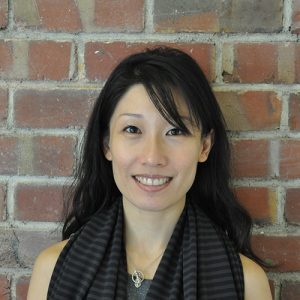
Social Sciences II: Understanding Social Complexity
Dr Adelyn Lim (NUS Sociology and Anthropology), Associate Professor Irene Ng (NUS Social Work), Dr Nina Powell (NUS Psychology) and Dr Alex Mitchell (NUS Communications and New Media) will be introducing the disciplines offered by their respective Departments, and show how they can each be applied to enable a deeper understanding of our world.
“The world we live in today can feel exciting but also downright contradictory. Global friendships are in many ways easier to make than in the past, yet we see terrorism, violent crime, wars, and enduring social inequality,” says session moderator Dr Lim, who will be discussing in detail with her fellow speakers complex issues thrown up by questions such as, “How did this world come about? Where are we heading in the future?”
To join the Social Sciences II (5:00 – 5:50 pm) session, click here.
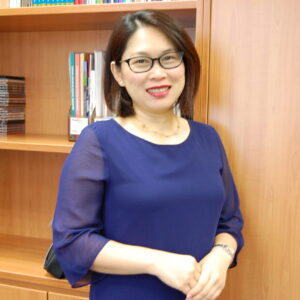
Ms Sasiwimol Klayklueng
Foreign Language Studies: Passport to the World
Meet leading Language instructors Ms Sasiwimol Klayklueng (Thai), Dr Sandhya Singh (Hindi and Tamil), Ms Indianti Tjan (Indonesian), Ms Rungnapa Kitiarsa (Thai) and Ms Sophie Undorf Bouvier (French), who will elaborate on the Minor in Language Studies and Proficiency Certificates conferred by the NUS Centre for Language Studies, which are very much sought after by students looking to enhance their career prospects.
Could Anwar Ibrahim's Unity Government Fight for the Interests of the People?
IN BRIEF | 7 min read
- Commentary by Dr Serina Rahman (NUS Southeast Asian Studies) in Suria News Online.
Click through image below to read this piece.
This article first appeared in Suria News Online and NUSNews on 6 December 2022.
Malaysia election: The wipe-out of ‘old Malaysia’ should prompt soul-searching
OPINION
- Voters want a new way forward after frustration with intense politicking over the past two years. by Serina Rahman
Click through image below to read this piece.
This article first appeared in The Straits Times on 20 November 2022.
The increase in the number of independent candidates reflects the fragility of the party & voter sentiment; It is difficult to predict the winner of GE15
IN BRIEF | 6 min read
- A commentary by Dr Serina Rahman (NUS Southeast Asian Studies) in Suria News Online.
HSA1000 Poster Symposium - Cherishing the Neighbourhoods We Live In
The Half-life of Knowledge
IN BRIEF | 10 min read
- There is now an indisputable requisite to equip graduates with interdisciplinary knowledge and skillsets. We need both the agile lenses of interdisciplinarity as well as the deep-cutting laser of deep domain expertise. The former trains us to aim and focus the laser, while the latter allows us to cut to the heart of a problem.
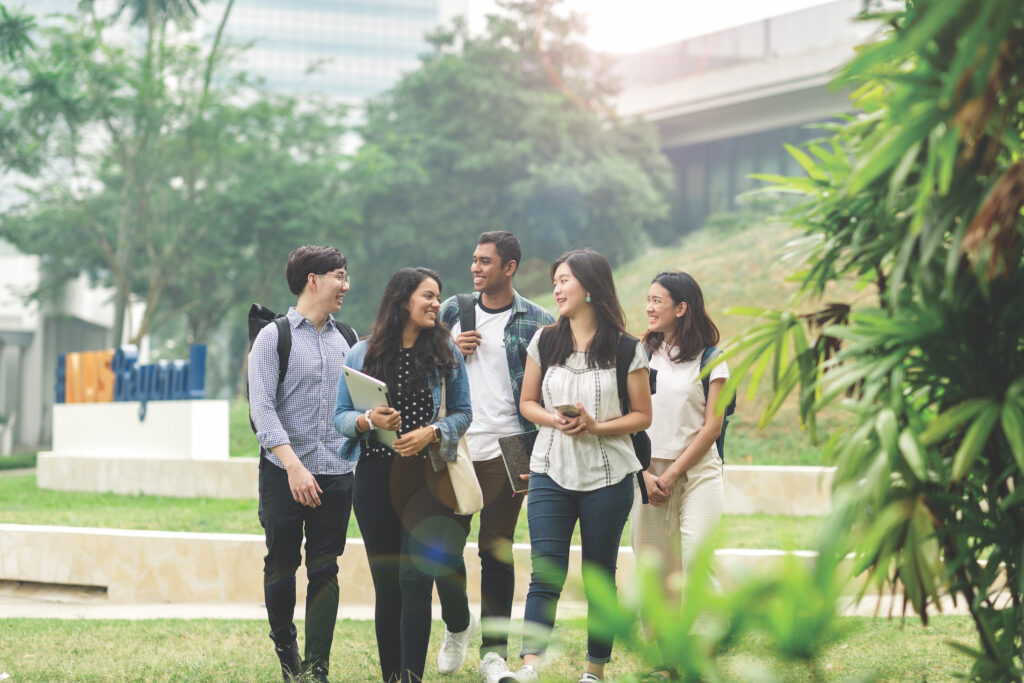
| By Professor Tan Eng Chye |
“Teach a person to fish, and you may feed them for three-and-a-half years” may sound less inspiring than “Teach a person to fish, and you feed them for a lifetime”, but the former more accurately reflects the current realities of tertiary education.
Breaking news travels at warp speed, accelerated by social media and instant messaging. In a matter of minutes, news can reach the four corners of the world. Such interconnectedness highlights the leaps made in information technology over the years while underscoring a persistent and inexorable phenomenon – the reduction of the half-life of knowledge.
The half-life of knowledge, coined by Fritz Machlup in 1962, refers to the amount of time elapsed before half of the knowledge in a particular field is superseded or becomes obsolete. Given the speed with which knowledge develops and is shared, it is perhaps not surprising that this value is ever decreasing in many fields.
This phenomenon raises fundamental questions about our university degree programmes. How should a fresh graduate, filled with aspirations to change the world, deal with the harsh reality that a significant portion of their undergraduate training may be rendered irrelevant by the simple passage of time?
Distilling a degree programme is one possible, albeit drastic approach. We can consider equipping students only with evergreen core domain concepts. This training should take less time than our current degree programmes. As and when students require specific new knowledge, or need to upgrade existing knowledge, they can take short courses to bridge knowledge gaps and meet their professional needs. This type of “just in time” learning, also known as micro-credentialing, helps to circumvent the shortened half-life by injecting cutting-edge knowledge at just the right time.
Another less disruptive approach is revitalisation. We can maintain the current degree programme structure, but provide avenues for graduates to return to university in the future. Such short stints of study can follow existing models for bite-sized, self-contained courses, or semester-long study periods undertaken with the support of employers.
One certainty is that university study will cease to be just one stage of life. Instead, “university studies” will become the de facto way of studying, with a person continually refreshing and renewing their knowledge in tandem with or in anticipation of developments in industry, society and the world.
In anticipation of this, we created the NUS Lifelong Learners Programme (or NUS L3), which promises a 20-year period of student enrolment, from the point of undergraduate or postgraduate admission. In other words, a graduate of NUS can choose to come back to campus to take courses for at least 20 years from the day of matriculation.
Interdisciplinarity
Beyond the way knowledge is acquired, we are also grappling with working in an increasingly VUCA (volatile, uncertain, complex, and ambiguous) world. In such a context, can we continue to hold a siloed view of domain disciplines? In training law students, for example, we would be remiss not to show them basic programming, which can allow them to create customised commands to quickly and easily trawl through databases, with millions of legal records, to identify precedents.
Deep domain expertise is like a laser – a focused beam of knowledge that can cut through dense problems. However, real-world issues are increasingly multifaceted and ill-defined, often lacking a clear vulnerable spot at which a laser beam can be aimed.
As a mental experiment, consider the challenge of introducing autonomous electric vehicles to a city. This proposition involves urban design, city planning, the law, and engineering for accessibility. We can form a multidisciplinary team of experts, where each member is a domain expert, to tackle the issue. However, in all likelihood, we will encounter misalignment between domains, simply owing to differences in problem-solving methodology, thinking models or even nomenclature.
If we liken domain training to equipping students with specific lenses through which they can see and focus on information to solve a problem, then interdisciplinarity suggests that we should train students to operate across more than one domain. By educating them in core ideas from multiple domains and providing opportunities to apply their knowledge in authentic settings, students with interdisciplinary training can switch domain lenses as needed, solving problems using novel and unorthodox approaches that transcend domains.
To be clear, we are not advocating for dismantling deep domain training. Rather, we recognise that there is now an indisputable requisite to equip graduates with interdisciplinary knowledge and skillsets. We need both the agile lenses of interdisciplinarity as well as the deep-cutting laser of deep domain expertise. The former trains us to aim and focus the laser, while the latter allows us to cut to the heart of a problem.
NUS strongly believes in providing interdisciplinary pathways for our students. In 2020, we created the College of Humanities and Sciences (CHS) to provide an enhanced interdisciplinary undergraduate experience for students of the Faculty of Science and the Faculty of Arts and Social Sciences. CHS undergraduates can choose between deep domain training or the flexibility of interdisciplinary training of varying breadth and depth in modules offered by both faculties. Continuing our efforts to pave more interdisciplinary pathways for students, in 2021, we merged the School of Design and Environment and the Faculty of Engineering to form the College of Design and Engineering. More recently, NUS launched NUS College, Singapore’s first honours college offering pathways to more than 50 majors across a half dozen degree programmes. The aim of NUS College, as explained by its inaugural dean, Professor Simon Chesterman, “[is to offer] broad, interdisciplinary competencies that equip students for life, along with the opportunity to dive deep into areas in which you are passionate.”
To quote Charles Dickens, “It was the best of times, it was the worst of times, it was the age of wisdom, it was the age of foolishness.” Indeed, our experiences with the global pandemic and its effects on education over the past two years have given us the rare opportunity to engage in deep reflection and introspection. Witnessing the breakdown of resistance to adopting and adapting technology for teaching and learning during this time, we should be emboldened to re-examine and revolutionise some of our established, and perhaps outmoded, notions of how to offer higher education.
About the Author
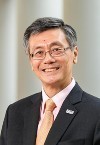 Professor Tan Eng Chye is President of the National University of Singapore. A passionate academic and educator, Prof Tan is a member of the World Economic Forum’s Global University Leaders’ Forum, as well as Singapore’s Future Economy Council, which is tasked with driving the growth and transformation of the country’s future economy.
Professor Tan Eng Chye is President of the National University of Singapore. A passionate academic and educator, Prof Tan is a member of the World Economic Forum’s Global University Leaders’ Forum, as well as Singapore’s Future Economy Council, which is tasked with driving the growth and transformation of the country’s future economy.
This article was first published in the Times Higher Education World University Rankings 2023 supplement and first appeared in NUSNews on 4 November 2022.
Monsoon season in Malaysia: Disaster is about to strike or is it just a political warning?
IN BRIEF | 6 min read
- A commentary by Dr Serina Rahman (NUS Southeast Asian Studies) in Suria News Online.
 This story first appeared in Suria News Online on 16 Oct 2022.
This story first appeared in Suria News Online on 16 Oct 2022.
Call for Nominations | FASS Inspiring Mentor Award 2022
IN BRIEF | 3 min read
- We invite NUS FASS members of staff to nominate the colleagues who have served as their truly inspiring mentors - who have gone beyond the call of duty to positively impact their work and life - for FIMA 2022 honours.
Click through image below (or just write to fassmentoraward@nus.edu.sg) to file your nomination.
Fragments of the Past
IN BRIEF | 10 min read
- A story about what the artefacts unearthed on Fort Canning by Emeritus Professor John Miksic (NUS Southeast Asian Studies) and alumna Associate Professor Goh Geok Yian (NUS Southeast Asian Studies, '95), who is Director of the History Major Program at Nanyang Technological University, tell us about Singapore's history.
Click through image below to read this piece.
This article first appeared in The Straits Times and NUSNews on 3 September 2022.
What is the fate of the children of Malaysian women born abroad?
IN BRIEF | 6 min read
- Commentary by Dr Serina Rahman (NUS Southeast Asian Studies) on what happens to the children of Malaysian women who are born abroad.
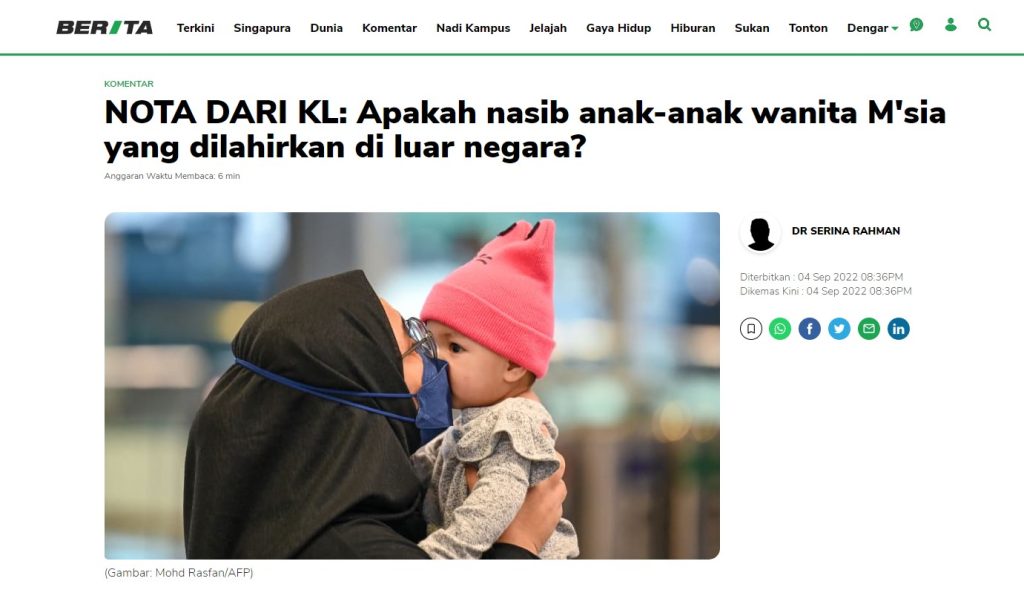 This article first appeared on Beritamediacorp on 4 September 2022.
This article first appeared on Beritamediacorp on 4 September 2022.Abdullah al-Misri and why Hikayat Mareskalek is Still Relevant to this Day
IN BRIEF | 6 min read
- Commentary by Dr Azhar Ibrahim Alwee (NUS Malay Studies) on Abdullah al-Misri's 'Hidayat Mareskalek'.
Click through to read this piece on Beritamediacorp.
This article first appeared on Beritamediacorp on 4 August 2022 and NUSNews on 5 August 2022.
NEW PUBLICATION: Internationalising Higher Education in the Asia Pacific
Internationalising Higher Education in the Asia Pacific Case of Australia, Japan and Singapore
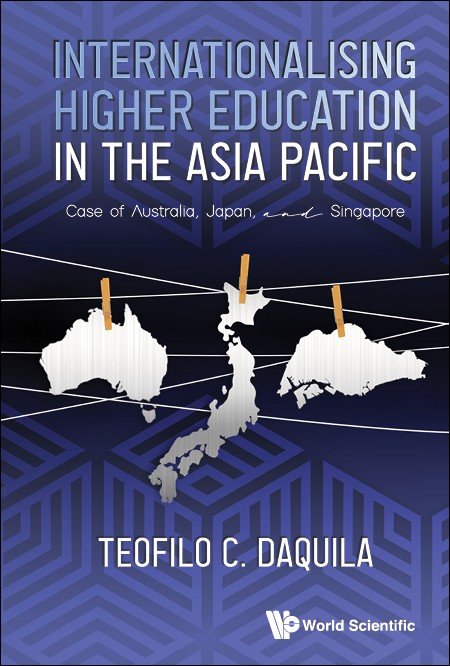 With his many years of overseas experiences as an international student, educator and scholar, Teofilo C Daquila has conducted his research on the internationalisation of higher education (IHE), as it has become an important policy issue and research topic for governments and universities around the world. He aims to determine the extent of internationalisation of higher education in the Asia-Pacific region particularly in Australia, Singapore and Japan in terms of its determinants and impacts using a multi- and inter-disciplinary framework of analysis, through historical, political, geographical, economic, social, and cultural dimensions.
Daquila examines three leading universities in the world as case studies to determine their internationalisation experiences and the extent of their competitiveness. These are the University of Melbourne, the National University of Singapore, and Kyoto University. He uses four indicators of competitiveness: governance and structure, demand conditions, factor conditions, and internationalisation strategies (using the following indicators of IHE: expansion, broadening/diversification, deepening and facilitation).
This book is highly recommended for anyone interested in the internationalisation of higher education, its determinants and multiple perspectives, the competitiveness and internationalisation experiences and strategies of universities.
Contents:
With his many years of overseas experiences as an international student, educator and scholar, Teofilo C Daquila has conducted his research on the internationalisation of higher education (IHE), as it has become an important policy issue and research topic for governments and universities around the world. He aims to determine the extent of internationalisation of higher education in the Asia-Pacific region particularly in Australia, Singapore and Japan in terms of its determinants and impacts using a multi- and inter-disciplinary framework of analysis, through historical, political, geographical, economic, social, and cultural dimensions.
Daquila examines three leading universities in the world as case studies to determine their internationalisation experiences and the extent of their competitiveness. These are the University of Melbourne, the National University of Singapore, and Kyoto University. He uses four indicators of competitiveness: governance and structure, demand conditions, factor conditions, and internationalisation strategies (using the following indicators of IHE: expansion, broadening/diversification, deepening and facilitation).
This book is highly recommended for anyone interested in the internationalisation of higher education, its determinants and multiple perspectives, the competitiveness and internationalisation experiences and strategies of universities.
Contents:
- Introduction: Background and Significance of the Internationalisation of Higher Education
- The Global Picture, Definitions and Concepts and Rationale
- The Australian Picture: Trends, Patterns, Determinants and Impacts — A Multidisciplinary Analysis
- The Competitiveness and Internationalisation Experience of the University of Melbourne
- The Japan Picture: Trends, Patterns, Determinants and Impacts — A Multidisciplinary Analysis
- The Competitiveness and Internationalisation Experience of Kyoto University
- The Singapore Picture: Government Policies and the NUS Experience
- Establishing Connections in a Diverse Class Environment
- Conclusion
Commencement 2022: Kickstarting a Season of Celebration and Achievement
IN BRIEF | 10 min read
- NUS celebrates the milestone accomplishments of 13,975 graduates through 28 in-person ceremonies.

A long-awaited season of celebration is officially under way, with the inaugural ceremony of Commencement 2022 marking the milestone achievements of some 200 Faculty of Arts and Social Sciences (FASS) graduates, and seeing the conferment of two Honorary Graduates, Professor Tommy Koh and Professor Wang Gungwu.
Taking place at the University Cultural Centre, the ceremony kicked off bright and early on 6 July to an effervescent buzz of anticipation from the graduates and their loved ones, inaugurating a total of 28 in-person ceremonies to be held over the following 10 days.
In keeping with the Commencement traditions and the proud ceremonial heritage of NUS, the ceremony showcased the pageantry of the Ceremonial Procession, the fanfare, and playing of the National Anthem, all culminating in the highlight of the ceremony-the presentation of graduates. Graduates from the Class of 2022 celebrated their achievements amid the applause of family and friends, a momentous apogee of their time in NUS.
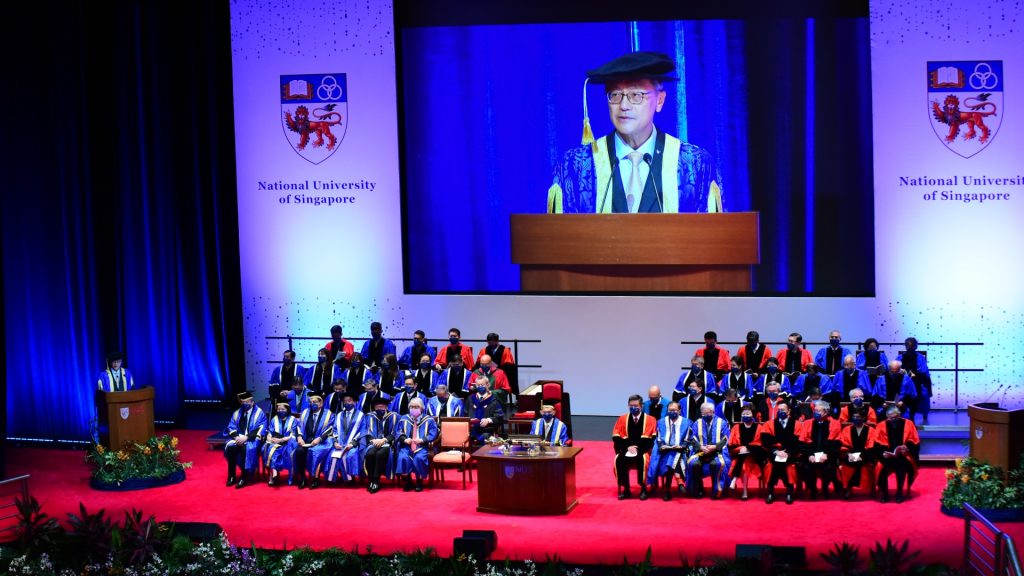
Speaking at the ceremony, NUS President Professor Tan Eng Chye reflected on the qualities needed for graduates to thrive in today's dynamic environment: an attitude of resilience and adaptability to overcome challenges, and a willingness and boldness to view problems as opportunities, exercise creativity, and apply their skills and knowledge to create solutions.
"For the Class of 2022, you are crossing the threshold into a wider world of dynamic change and great possibilities, but also of discomforting uncertainty," he said.
"But I am fully confident that the NUS graduates of today share the same ethos of excellence and service to community of generations past. In time to come, you will undoubtedly make your own unique contributions, and become the vanguard in elevating our collective prosperity and well-being."
Contributions to Law, Nature and Culture: Prof Tommy KohTwo illustrious NUS alumni were also honoured as Honorary Graduates for the Class of 2022-lawyer and diplomat Professor Tommy Koh, and historian Professor Wang Gungwu.
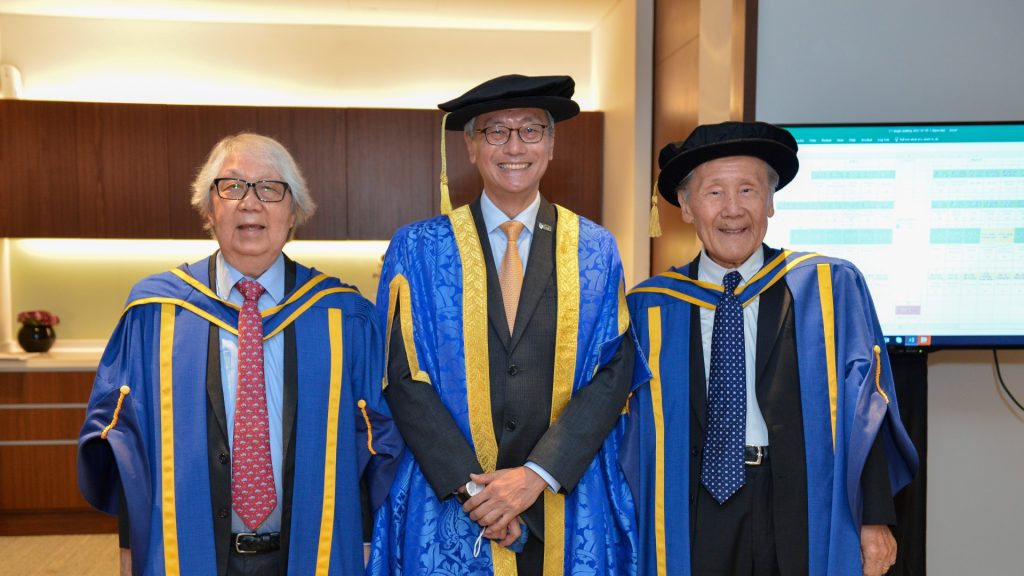
In recognition of his dedication as a practitioner-scholar and decades of service to the University, Singapore, and the world, Prof Koh, who wears many hats including Ambassador-at-Large at Singapore's Ministry of Foreign Affairs, Special Advisor of the Institute of Policy Studies, and founding Rector of NUS' Tembusu College, was conferred the Honorary Degree of Doctor of Laws.
Highlighting three areas on which he has focused his energies - law, nature, and culture - Prof Koh said, "I chose to study law, not to enrich myself, but to pursue justice and to promote the rule of law."
He also spoke about his work concerning nature and the environment, including chairing the 1992 Earth Summit, being patron of the Nature Society, and helping NUS establish the Lee Kong Chian Natural History Museum as its founding Chairman. "My vision is to live in harmony with nature. My agenda is to promote sustainability in all our endeavours," he added. "I am [also] glad that I have been able to play a very small role in transforming Singapore, from a cultural desert to a cultural oasis."
Delivering the citation for Prof Koh's conferment, Professor Simon Chesterman, Vice-Provost (Educational Innovation) and Dean of the NUS Faculty of Law and NUS College, referred to Prof Koh's "academic milestones [which] are but one strand of the rich tapestry of his professional life", as well as his leadership and guidance in education at NUS, and his eminent contributions to state and environmental diplomacy.
An Inspiring Story Worth Retelling: Prof Wang GungwuProf Wang, one of the world's foremost experts on the Chinese diaspora and Sino-Southeast Asian historical relations, was conferred the Honorary Degree of Doctor of Letters, the latest in a long list of accolades that includes the prestigious Tang Prize in Sinology, and the Distinguished Service Order of Singapore.
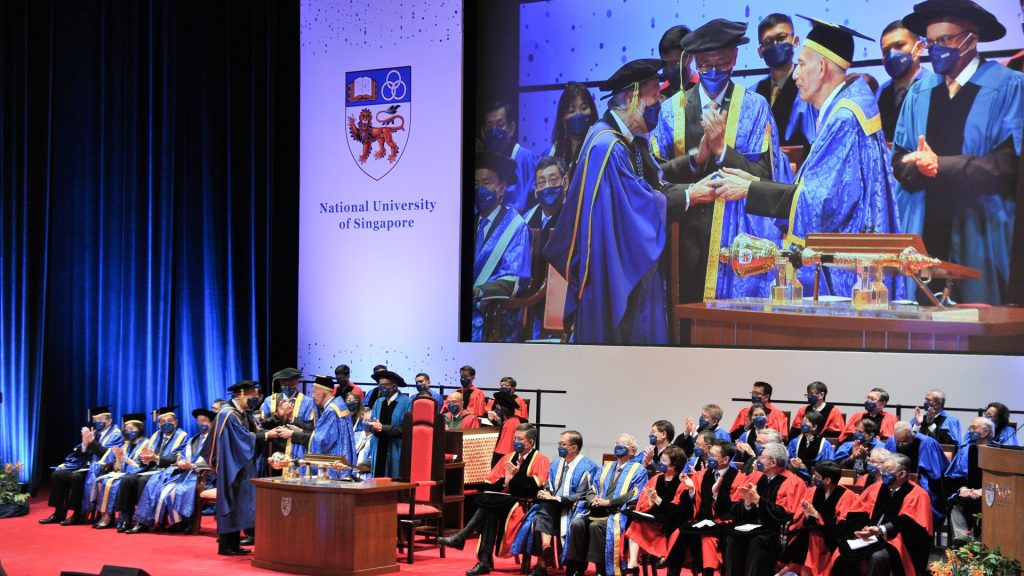
Reflecting on his time as a student of the University in colonial Malaya, Prof Wang said: "You can imagine how happy I am to be a graduand again with my alma mater. The university gave my generation a good start in life. It went on to adapt to the rapid changes of our time. In so doing, it has come out better and stronger."
He spoke about the "inspiring story worth retelling" of how the University had set out and followed its own aspirations, becoming a major centre of learning by being actively connected to the world, as well as regularly reinventing itself.
"The way our university strives to keep our humanity always in our sights is something to be very proud of. I hope that all of us graduating today, no matter where life leads us, will never hesitate to help our university to enhance this capacity to advance our human condition," Prof Wang stressed.
Prof Lionel Wee, Dean of FASS and co-Dean of the College of Humanities and Sciences, who delivered the citation on Prof Wang's conferment, lauded the latter as "an eminent figure and brilliant mind" who has made manifold contributions as a leading figure in Sinology, a renowned public intellectual, and a visionary leader and administrator at leading academic institutions around the world.
"This doctorate symbolises the meaningful connections between Professor Wang and the University, and it celebrates the long-standing contributions and value that Professor Wang's scholarly insights bring to Singapore, to Southeast Asia and, indeed, to the world," he said.
Parsing the Path ForwardInfusing the celebrations with a spirit of introspective gratitude, Valedictorian Mr Nickson Quak, who is graduating with a Bachelor of Arts with Honours (Highest Distinction) in Philosophy, Politics, and Economics said, "As varied as our journeys may have been, each and every one of us graduates here could have only made it thus far because of the unwavering support that our parents, our families, our loved ones, and our friends have so generously afforded us."
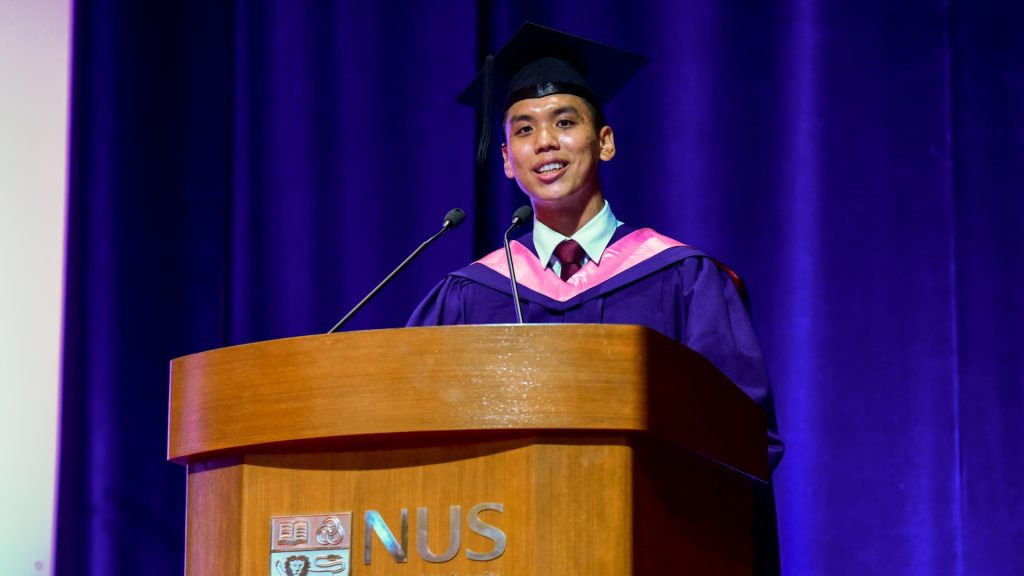
His words further summarised the spirit of determination and community that will carry graduates onwards in their lives: "If [the journey ahead] appears daunting to you, I say to you: fret not… because when you look to your left and your right, you see the resilient men and women who, forged by the challenges brought upon by the global pandemic, will always offer you a helping hand."
This story first appeared in NUSNews on 6 July 2022 as part of NUS News' coverage of Commencement 2022, which celebrates the achievements of our 13,975 graduates through 28 in-person ceremonies. For more on Commencement, look out for our upcoming graduate profiles, check out the official Commencement website, or look up (and tag) #NUS2022 and #NUSFASS on NUS' and FASS' social media channels!
Edible Heritage: Foodscapes and Sensory Heritage Making in Chinatown and Little India

Teaching Dharma, Grooming Sangha: The Buddhist College of Singapore
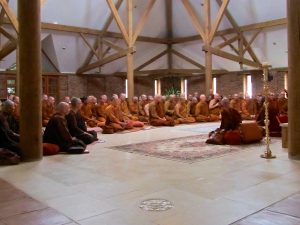
NUS CHS Open House 2022: Discover #Interdisciplinary Education!
IN BRIEF | 5 min read
- The NUS College of Humanities and Sciences is hosting its Open House 2022 next week and all prospective students who have received offers are invited!
- A two-day hybrid programme – 11 May on Zoom (and viewable on CHS’ Facebook page) and 14 May on several locations across the NUS Kent Ridge campus, specifically the areas around the Faculty of Arts and Social Science (FASS), and the Faculty of Science (FoS) – CHS Open House 2022 aims to address all concerns a prospective undergraduate may have before committing to academic at the University and College.
- Highlights include opportunities to engage, discuss and explore academic pursuits, career development and student life at the College with key faculty and administrative staff and leadership — live and in person.
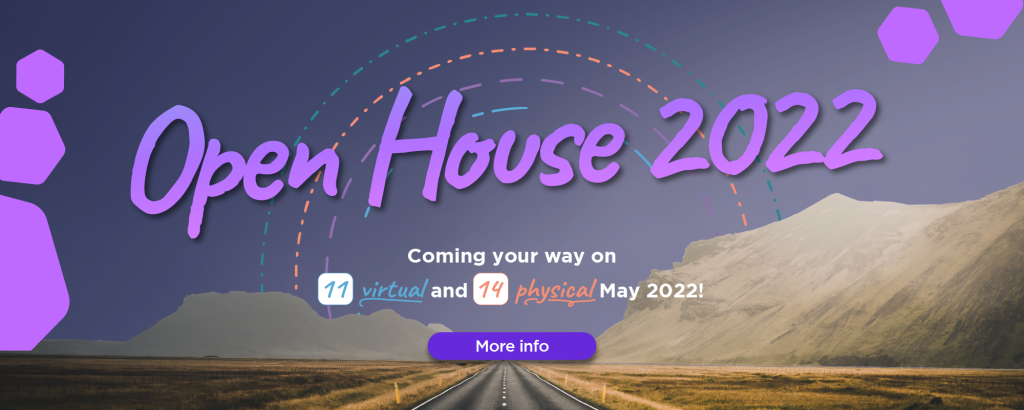
The NUS College of Humanities and Sciences is hosting its Open House 2022 next week and all prospective students who have received their offers are invited. As the deadline for them to accept their offers is looming, CHS has put together a programme aimed at answering all the questions they may have and clarifying all their concerns as much as possible.
Marking a cautiously calibrated return of the University to the normalcy of hosting large on-site events, this year’s CHS Open House is a two-day hybrid programme: 11 May on Zoom (and viewable on CHS’ Facebook page) and 14 May on several locations across the NUS Kent Ridge campus, specifically the areas around the Faculty of Arts and Social Science (FASS), and the Faculty of Science (FoS).*
11 May 2022 (Wednesday): The Essentials, OnlineThis a series of comprehensive information sessions (on Zoom and livestreamed on Facebook Live) covering everything new undergraduates need to know to get the most out of their education journey with CHS, including the:
- CHS Core Curriculum
- College’s three challenging but rewarding cross-disciplinary programmes
- Data Science and Economics (DSE-XDP)
- Environmental Studies (BES-XDP)
- Philosophy, Politics, and Economics (PPE-XDP)
- myriad Learning Pathways laid for you
- versatile career development programmes designed to prepare you for the future workplace
- CHS Student Experience—eye-opening and busy, yet energising and enriching
Speakers and panelists include CHS Co-Deans, Vice-Deans, key faculty staff members, career preparation and student services leader.
For more information and links to the 11 May sessions, click here.
14 May 2022 (Saturday): Get Personal, On CampusThe College is calling for prospective students to come on site, visit where they could well be spending their undergraduate years very soon, and speak to their future instructors and potential mentors. The full-day programme – running in key FASS and FoS locations across the NUS campus – offers:
- entry to witness and even participate in talks/lectures and panel discussions presented and hosted by award-winning instructors on a variety of academic subjects, interdisciplinary topics and specialised research areas
- face-to-face engagement with faculty, admin and student representatives from ALL Departments and student organisations under CHS, and opportunities to explore academic, financial aid and student activity options with the people in the know
- consultation with the career development teams of CHS
- guided Walking Tours across the facilities of FoS and FASS
For more information on the activities planned for 14 May, click here.
Discover Your #Interdisciplinary Future @ CHSThis Open House is the last chance for prospective students to learn more about the complete #interdisciplinary educational experience that they can expect at CHS. One that opens up a world of possibilities and equips them with skills and knowledge across the humanities, social sciences, physical sciences and applied sciences. One that inspires, cultivates and prepares them to work across diverse industries and sectors, with multidisciplinary teams, to solve some of the most complex wicked problems facing the world today — from social inequality to food shortage, unsustainable development and global warming. And one that grooms them to be the leaders of public institutions and private enterprise tomorrow.
* Campus shuttle bus services will be made available on 14 May to all visitors for easier movement across campus, which extends to Kent Ridge MRT.
Locating “Malay Places” and Ethnic Identity Making in Singapore

Open House 2022 Engages and Excites
IN BRIEF | 30 min read
- The ever-popular NUS Open House hit new heights this year, attracting over 8.61 million visitors – a 26.2 per cent increase from the 6.83 million visitors that attended last year's online Open House.
- From 26 Feb to 5 Mar, visitors crowded the websites, livestreams, webinars and social media sessions hosted by the University's colleges, faculties and schools. There was something for everyone, and the event covered everything from academic courses to student life and entrepreneurship programmes.

The ever-popular NUS Open House hit new heights this year, attracting over 8.61 million visitors – a 26.2 per cent increase from the 6.83 million visitors that attended last year's online Open House.
From 26 Feb to 5 Mar, visitors crowded the websites, livestreams, webinars and social media sessions hosted by the University's colleges, faculties and schools. There was something for everyone, and the hybrid event covered everything from academic courses to student life and entrepreneurship programmes.
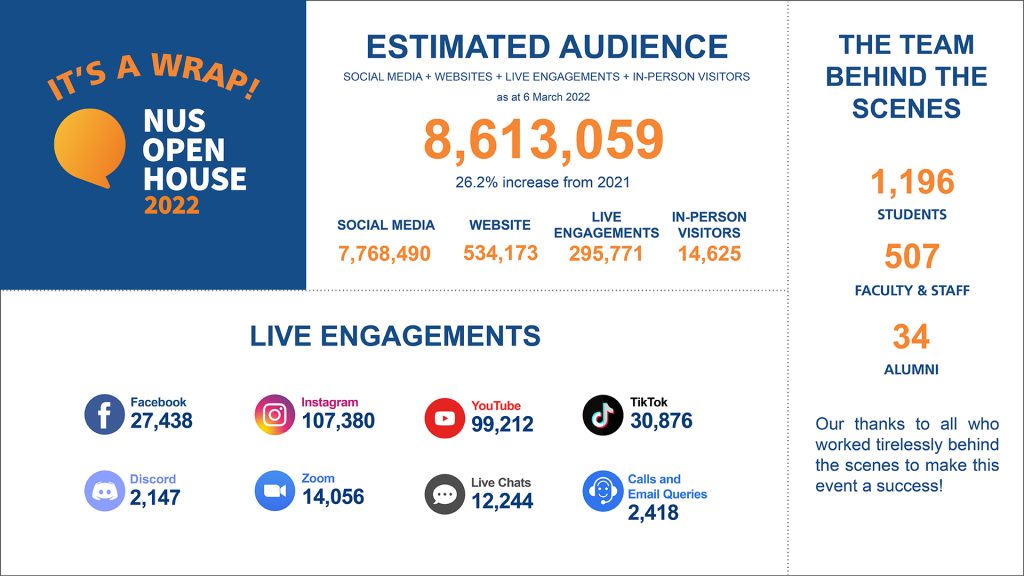
While much of the engagement happened online, prospective students got to meet NUS students and staff face-to-face for the first time since the pandemic started.
The physical Open House, held one sunny Saturday on 5 Mar, included numerous booths showcasing the University’s wide-ranging academic options and vibrant student life; sample classes and talks to get a taste of varsity life; and tours of the different colleges, faculties, and schools.
Prospective students gave the hybrid format a thumbs-up.
Joshua Chua, an alumnus of Anderson Serangoon Junior College, appreciated the online sessions and felt the physical Open House was a huge differentiating factor.
“The (physical) Open House really gave me a good image of what living and studying at NUS could look like by virtue of being an in-person event as opposed to it being virtual, so I'm really grateful to NUS and everyone involved for having this opportunity during the pandemic,” he said.
On her part, Hwa Chong Institution alumna Elsie Woo, who attended both the online and in-person sessions, said, “The experience was really welcoming and wholesome, and really exposed me to NUS as a whole.”
Showcasing the country’s first honours college
One of the highlights this year was the NUS College, Singapore’s first honours college. It will accept its first batch of students this year.
Prospective students were treated to online webinars on the College’s distinctive curriculum, its global pathways, and its focus on hands-on experiential learning. In more intimate breakout rooms, staff and student volunteers readily answered questions about student life and academic pathways. By having a home college or faculty – say Business or Science – while simultaneously being enrolled at NUS College, students will be able to get an educational experience that is as broad as it is deep.

The in-person activities featured a tour of the facilities and residential options that NUS College students would be able to enjoy.
Elsie Woo was one of many students drawn to NUS College’s unique offerings.
“I attended a few webinars, including introductory talks for NUS College and Food Science and Technology,” said Elsie, who also visited many booths in-person.
“The sessions were very well-planned and the seniors were extremely helpful and patient.”
Nanyang Polytechnic alumnus Koh Jin Yuen focused his time on NUS College, attending the College’s guided tour and virtual sharing sessions.
“The NUS College tour was informative as I got to ask the facilitators about their experiences. I think the curriculum is very meaningful,” said Jin Yuen.
“The Open House helped to deepen my understanding of how NUS College works, and allowed me to better understand the lifestyle of a student from NUS College.” He is intending to apply for the Information Systems programme offered by NUS Computing, as well as NUS College.
Ramping up interdisciplinary offerings
Exciting developments in the realm of interdisciplinary education—a major theme that NUS has been championing—were foregrounded at the Open House, with the College of Design and Engineering (CDE) also taking in its inaugural cohort. A result of the merger of the Faculty of Engineering and the School of Design and Environment, CDE is set to transform the NUS educational experience.
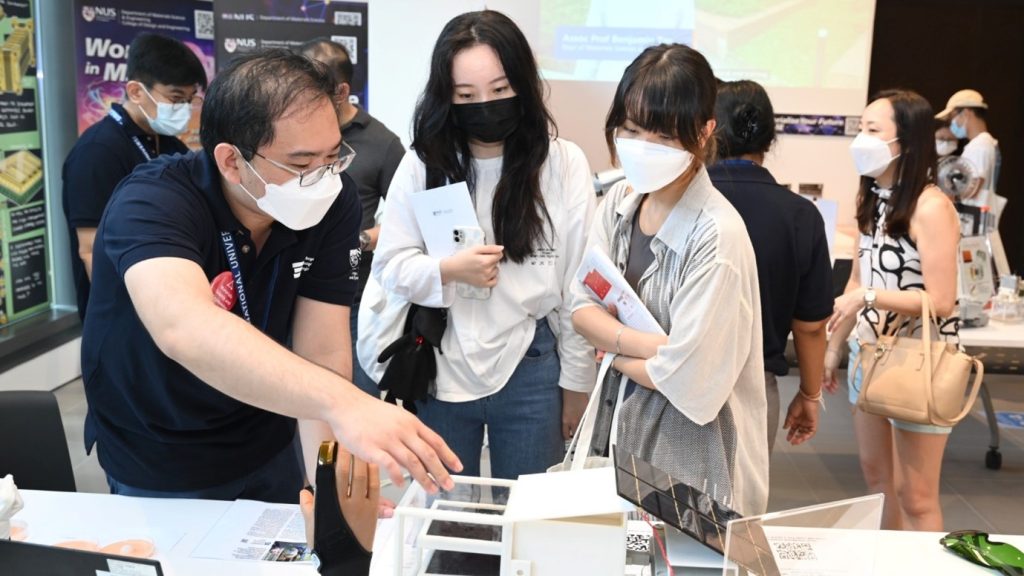
Across five galleries and 19 sub-categories, including Architecture, Industrial Design, Materials Science and Engineering, Biomedical Engineering, and Civil Engineering, visitors were presented with an informative display of the wide range of courses and programmes that will be on offer in the new College.
Raffles Institution alumna Grace Zai, who visited the Designing the Future exhibition and galleries, said, “The Engineering galleries were very informative as I could ask questions I had about the course, as well as student life, and get a clearer picture of what I would be studying and doing. It helped me make a more informed decision on my choices.”
Grace is considering applying to Engineering Science and Architecture, as well as Mechanical Engineering and Electrical Engineering with a specialisation in robotics.
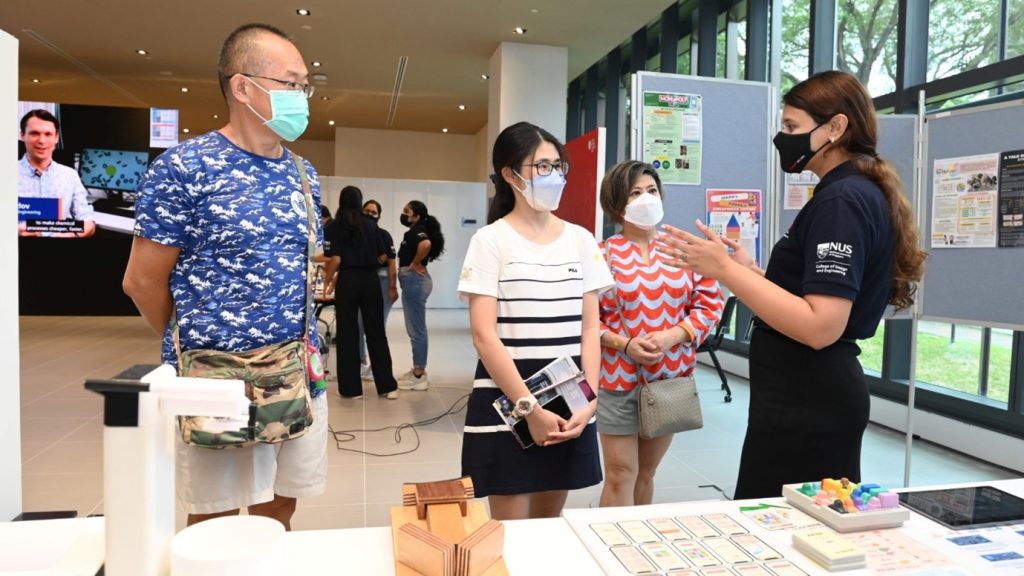
There were also panel discussions, both online and in-person, where faculty and current students interacted with prospective students to share their experiences and answer questions about the new interdisciplinary curriculum.
“As a prospective student, I got to see first-hand the school facilities, as well as the accommodations. My experience was pretty enriching and enlightening because I could ask the professors questions I had in mind and learn more about the courses,” said Timothy Tay, a graduate of Victoria Junior College who visited the SDE gallery on Sustainable Innovations.
“For example, I did not realise Project Facilities Management (PFM) was recently changed to Infrastructure Project Management (IPM). The professor explained that students will now graduate with a BEng degree rather than a BSc degree,” he recalled, referring to the first interdisciplinary full-time undergraduate programme to cover engineering, design, management, technology, building science and law modules.
Information was also available on the vibrant student life of the College’s various clubs and societies, as well as career programmes that enable students to better understand their interests and what it takes to marry that with industry skills and experience.
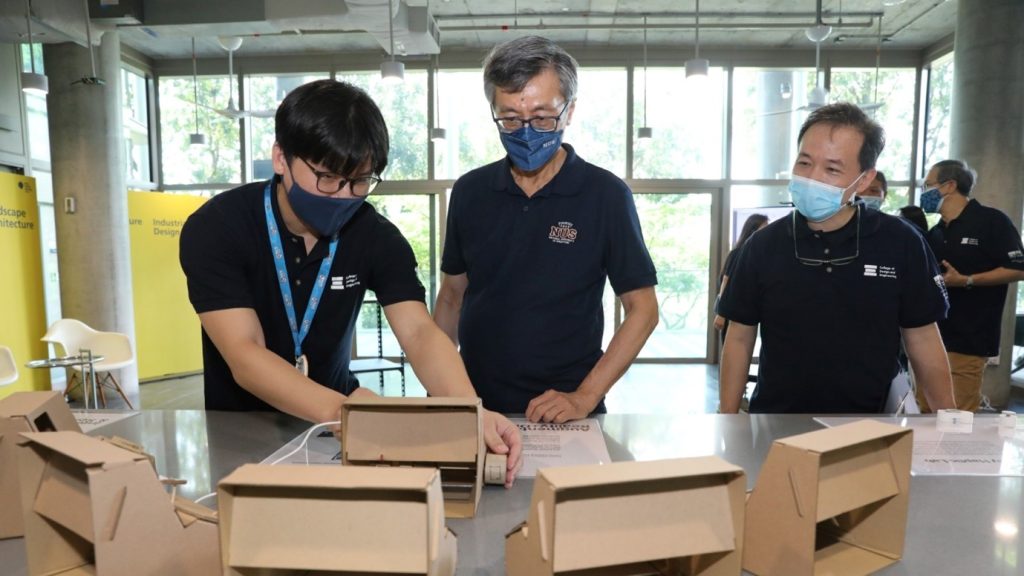
“The NUS Open House provided me with a more informed perspective on the courses offered in NUS. The various booths set up and run by students allowed for quick chats about what the courses have to offer. The responses by the students and professors were engaging and genuine, which I found informative in making my choice for courses in NUS,” said Kalepu Sai Sri Akshath, who attended CDE’s online and in-person events with his family and is intending to apply to Computer Engineering.
Drone-sensing demonstrations and the Solar Roof Tour, 5G Lab Tour, and BEEHUB Tour further showcased the College’s manifold facilities. Visitors also got a first-hand experience of NUS’ very own net-zero energy building through tours at SDE4, itself a product of both architecture and engineering, and the first of its kind in Singapore.
A marriage of the humanities and sciences
Continuing in the vein of interdisciplinarity and equipping students with a multifaceted, integrated toolbox of skills to thrive in the future economy is the College of Humanities and Sciences (CHS), which will be accepting its second intake this year.
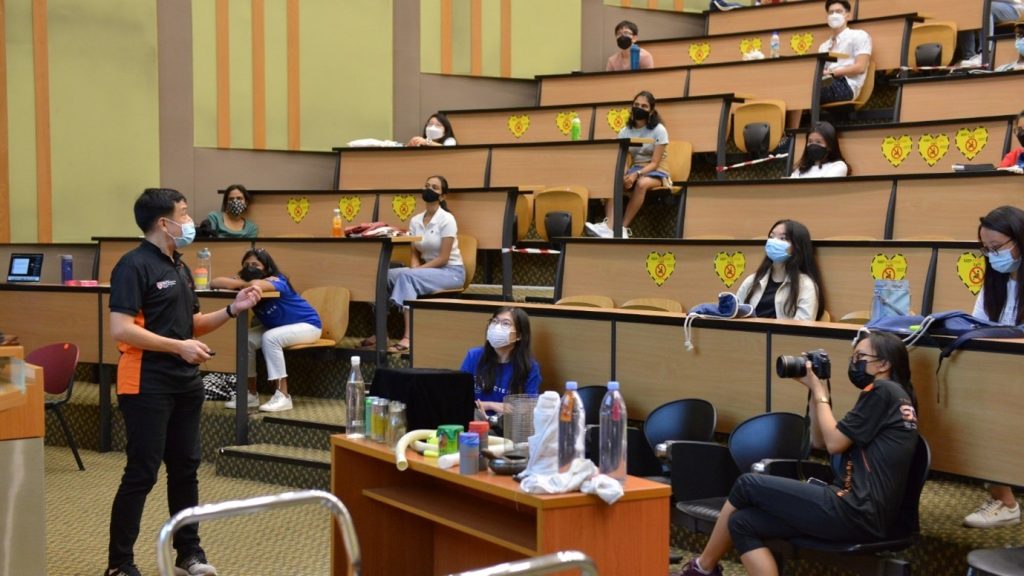
Seminars about the CHS Core Curriculum were available at the Open House, as well as informative masterclasses that covered a vast range of interdisciplinary topics.
The Data Science and Economics masterclass saw Assoc Prof Lim Tiong Wee and Assoc Prof Chen Ying (Statistics & Data Science, Faculty of Science) and Dr Denis Tkachenko (Faculty of Arts and Social Sciences) break down the complexities of the digital economy with real-life examples, and explicate its relevance to Singapore’s Smart Nation goals.
The new Data Science and Economics (DSE) cross-disciplinary programme will be the first of its kind in Singapore to integrate knowledge across these two disciplines.
“I got to understand how data science and economics complement each other,” said Russell Hor, a graduate of St. Joseph's Institution who has finished National Service and is enrolling in CHS this year.
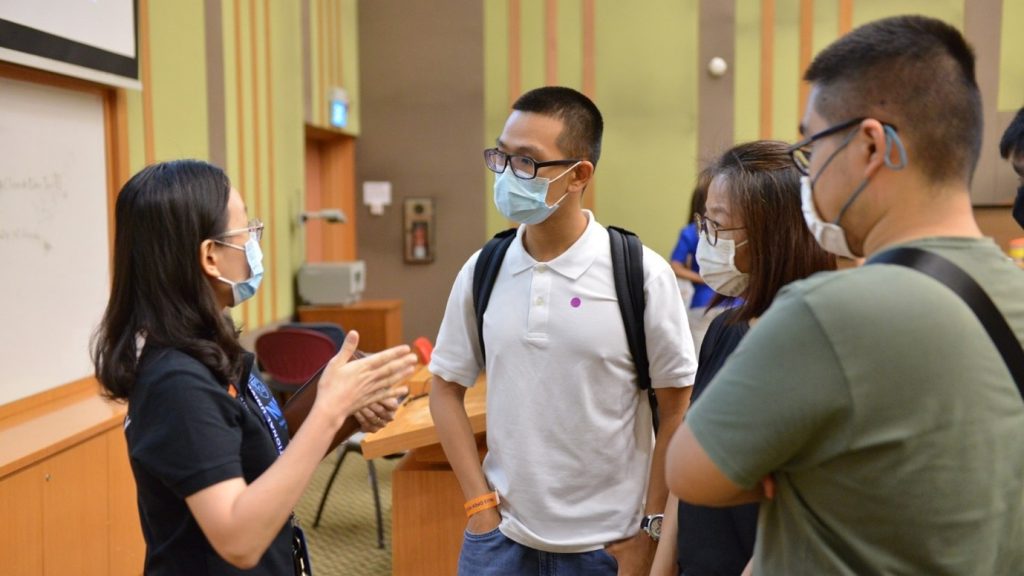
Vanille Goh, who graduated from Anglo-Chinese Junior College and attended the Geography and Environmental Studies masterclasses, said, “[The masterclasses] provided me with a good overview of how passionate the lecturers were and how each course will adequately prepare me for what I would want to do in the future.”
Nanyang Junior College alumna Wen Xinyue also appreciated the in-person masterclasses, adding that they gave her a first-hand glimpse into studying humanities at the university level.
“I am interested in studying English, and from the English Language and Literature masterclass on Gender, Sexuality and Language, I learnt about how entrenched gender roles and stereotypes can be within the language we use,” she shared.
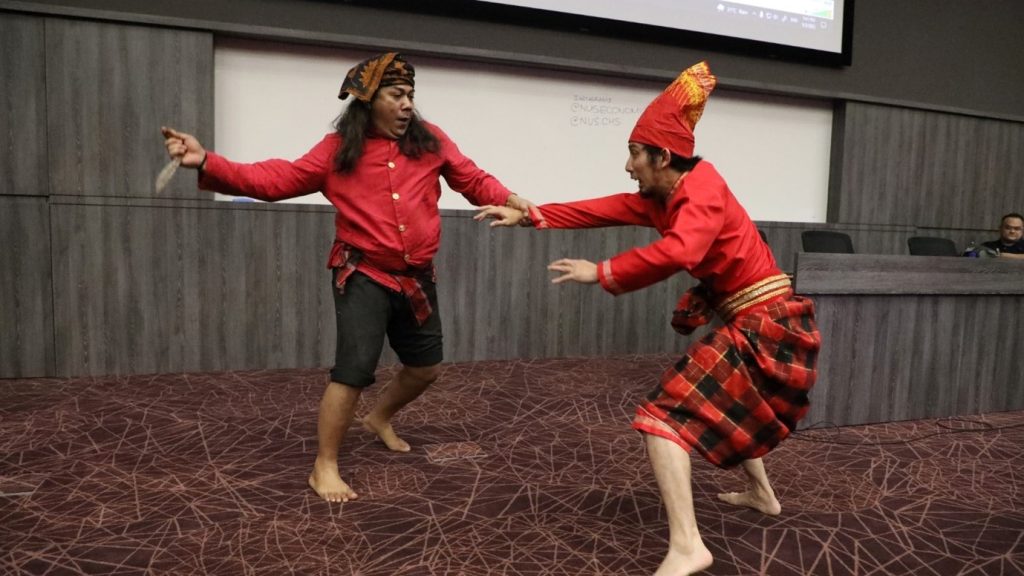
Meanwhile, over at the “Insights into Southeast Asia from the Martial Arts Perspective” masterclass, Dr Mohamed Effendy of NUS Southeast Asian Studies presented prospective students with a riveting intellectual and visual treat, demonstrating how useful unique perspectives on the region’s myriad communities can be gleaned by studying them through the lens of the martial arts. Students saw the concepts brought to life – witnessing first-hand an exciting live demonstration by practitioners of pencak silat – of how Southeast Asian warriors of old defended themselves using a wide array of techniques and weapons.
Action aplenty
There was action aplenty among other faculties. NUS Business School’s programmes included a 360 live tour, as well as live chats with the BBA Deans on the different majors offered by the School. Its in-person sessions included sharing sessions by the BBA Deans, BIZCareers advisors, and student ambassadors.
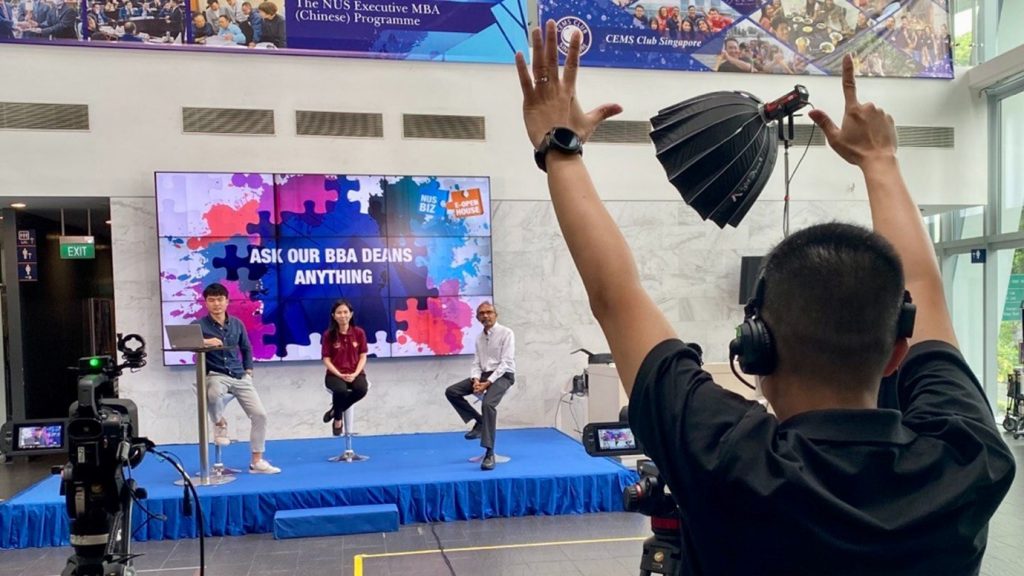
Year 4 Accountancy and Finance undergraduate Calvin Chur was one such student volunteer, serving as an emcee for the online Open House and sharing in-person on 5 Mar about life at the Business School.
“It was a tiring, but extremely fulfilling day engaging with prospective students, learning about their concerns with regards to entering a new phase of life and trying to address those concerns,” said Calvin. “In fact, many of their concerns mirrored those that I had as a fresh A-level graduate attending the NUS Open House back in 2016 – and I am glad that I could offer insider insights to help them make an informed decision at this major milestone of their lives.”
Year 4 Real Estate undergraduate Natasha Liem, another student volunteer who served as an emcee, added, “There was quite a large number of viewers for the panel and a prospective student actually sent me a message on Instagram to enquire more about real estate from a student's perspective. I think the panel went well!”
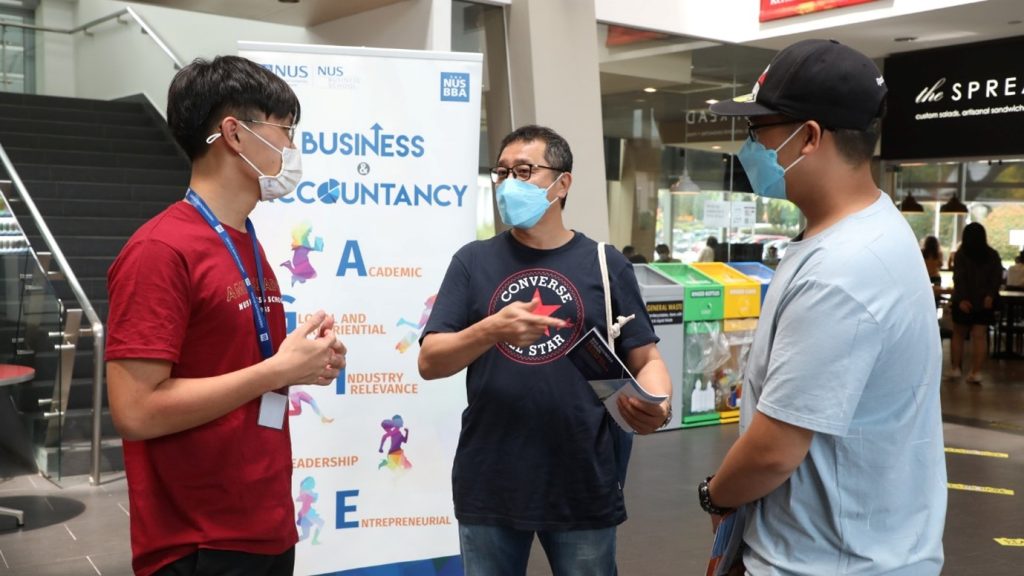
For NUS Business School Executive (Marketing & Outreach) Ms Casey Jean Grant, it was an eye-opener to experience the whole planning process.
“Most of the students and parents were very curious and excited about the prospect of coming to NUS Business School,” she added. “Their excitement definitely rubbed off on us and made the rest of us excited to share about our School.”
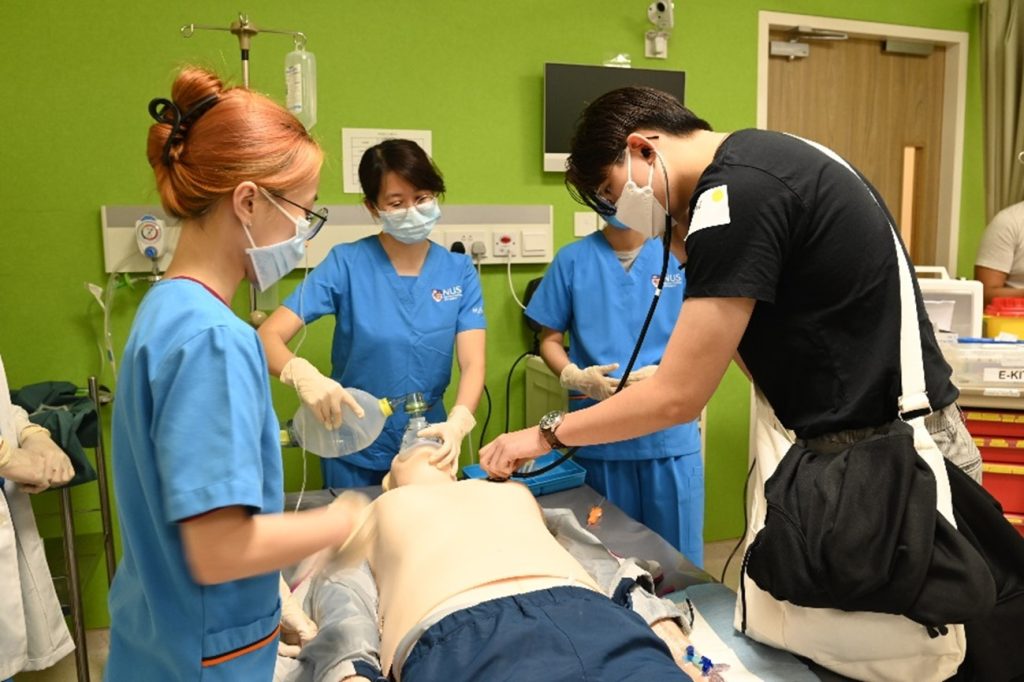
With frontline healthcare workers being in the spotlight these couple of years, there was plenty of interest in NUS Dentistry, NUS Nursing, NUS Medicine, and Duke-NUS Medical School. Live demonstrations were conducted and prospective students got a taste of what it would be like to be a dentist, nurse or doctor.
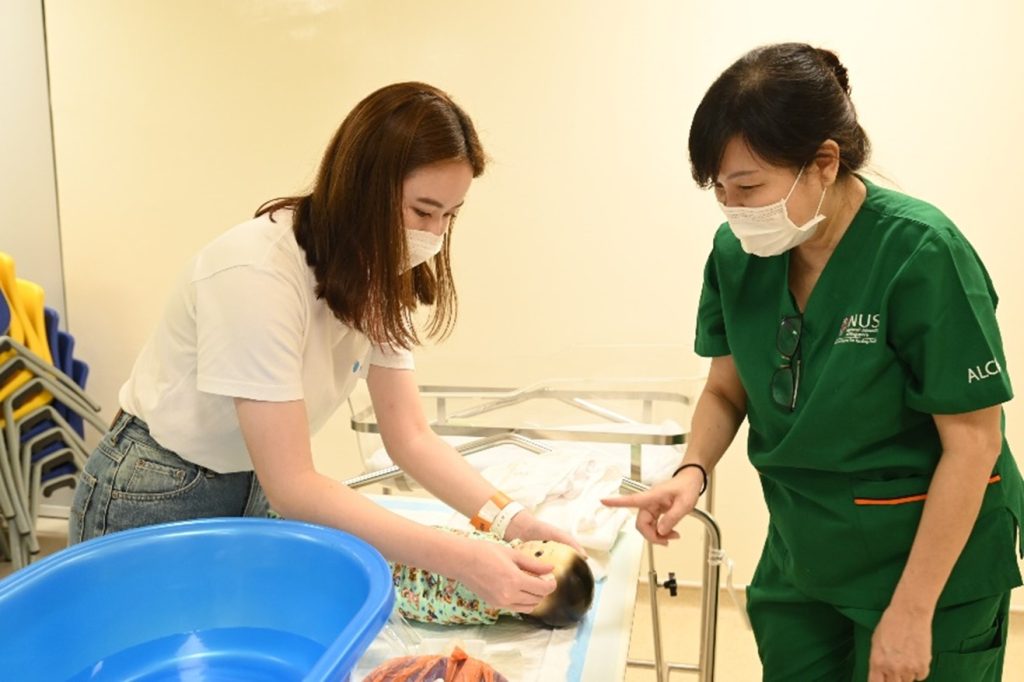
Serving up a slice of campus life
Whether on the screen or in the flesh, visitors to the Open House also witnessed the rich and vibrant student life beyond the classroom that NUS is known for.
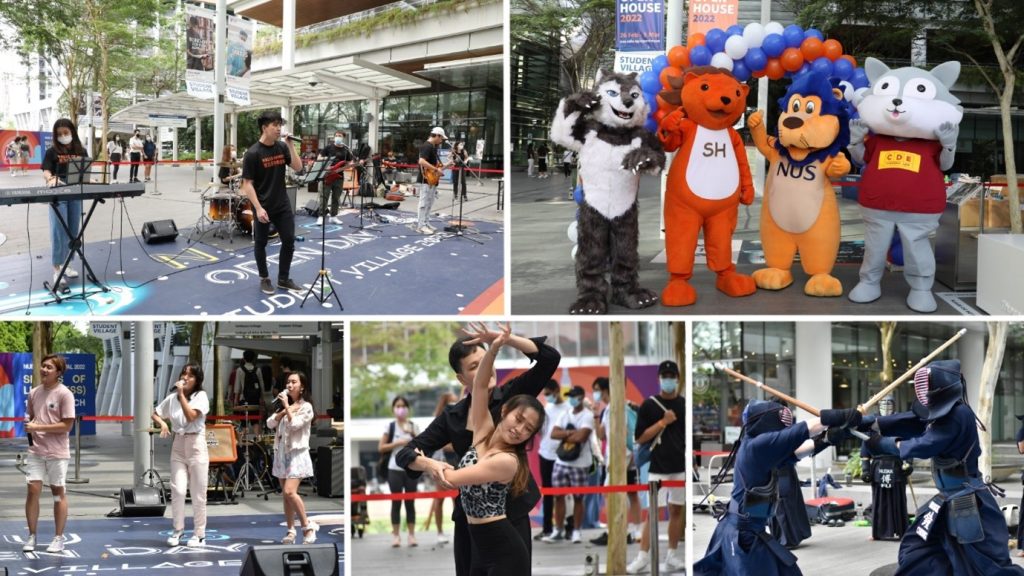
Besides holding talks to acquaint visitors with the wide range of co-curricular activities available, student clubs and societies rose to the occasion at the Student Village showcases to feature a spectacular smorgasbord of music, dance and sporting performance across the eight days that Open House was on. Visitors were serenaded by soulful tunes by the NUS Jazz Band and wowed by the moves of NUS Kendo Club. They were also treated to cheerleading displays, snazzy dance performances by NUS Funkstyle and BreakiNUS, catchy renditions of contemporary pop and choral music by the a cappella group Resonance, and the dulcet tones of TheNUSChoir and the NUS Mandopop group Voices.
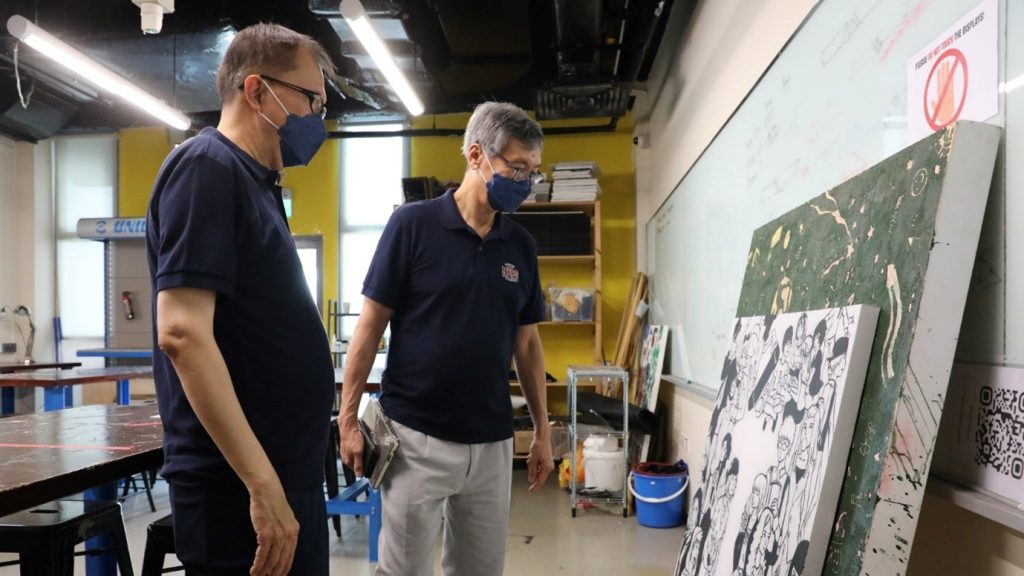
"It was really lively with dozens of booths as well as live performances put on by really talented students! It truly allowed me to understand the culture here and makes me want to be a part of it after experiencing first hand,” Vanille Goh shared.
Students and hall masters from the halls and residences also conducted informative residential life talks, A-Day-in-the-Life-Of vlog sessions and Ask-Me-Anything sessions to help students interested in on-campus living understand its manifold aspects like academic programmes and pastoral care.
These were complemented by in-person tours of King Edward VII Hall, NUS College, Ridge View Residential College, Tembusu College, RC4, and Pioneer House, NUS’ newest housing model, giving participants a real taste of the sense of community and camaraderie that comes with residential life in NUS.
Joshua Chua, who also participated in the RC4 tour, said, “The RC4 tour was definitely a highlight because the tour guide, as with most staff and students, was welcoming and frank, which eased my nervousness.”

Matthew Yeow, an alumnus of Anglo-Chinese School (Independent) who attended both online and in-person sharing sessions by student residents of the Residential Colleges, said, “During the physical Open House, I had the opportunity to find out a lot more about the residential colleges and what made them distinct from halls. Furthermore, I also got to find out more about the individual residential colleges and their communities, as well as the additional modules they took.”
“As a prospective student, I think the Open House was executed effectively through both the online and physical mediums. Having the opportunity to come down and visit the University and talk to the current students gave me a better understanding of student life in NUS,” he added.
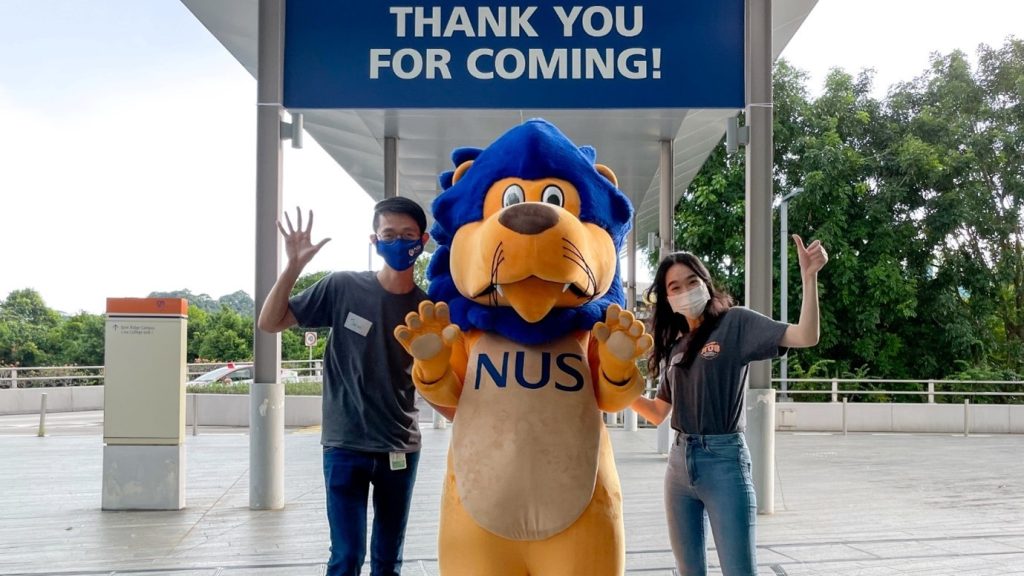
This story first appeared on NUSNews on 8 March 2022.
NEW PUBLICATION: On this Modern Highway, Lost in the Jungle by Jan Mrazek
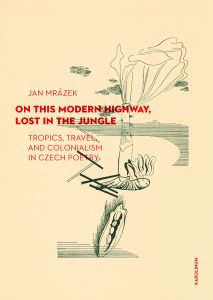
The latest book by A/P Jan Mrázek aka Pak Jan is just out, about a Czech poet’s journey to colonial Java, and more broadly about Czech literary and artistic images of our region (and beyond). Says the book cover: “In [the] texts, poetic and often comic, both landlocked Bohemia and the colonized tropical islands are seen disorientingly anew, like ‘mirrors looking at themselves in each other.’ … In its attention to how poetic travel reflects the Czech historical experience in the shadow of imperial nations, the book moves scholarly reflection on literary travel, modernity, and colonialism to a new ground.”
Get the book here: https://karolinum.cz/.../mrazek-on-this-modern-highway...
New Courses for the New Economy
IN BRIEF | 5 min read
- NUS is offering a number of new programmes to prepare graduates for the future, including the much-anticipated Major in Anthropology, and Minor in Interpreting by the NUS Department of Chinese Studies.
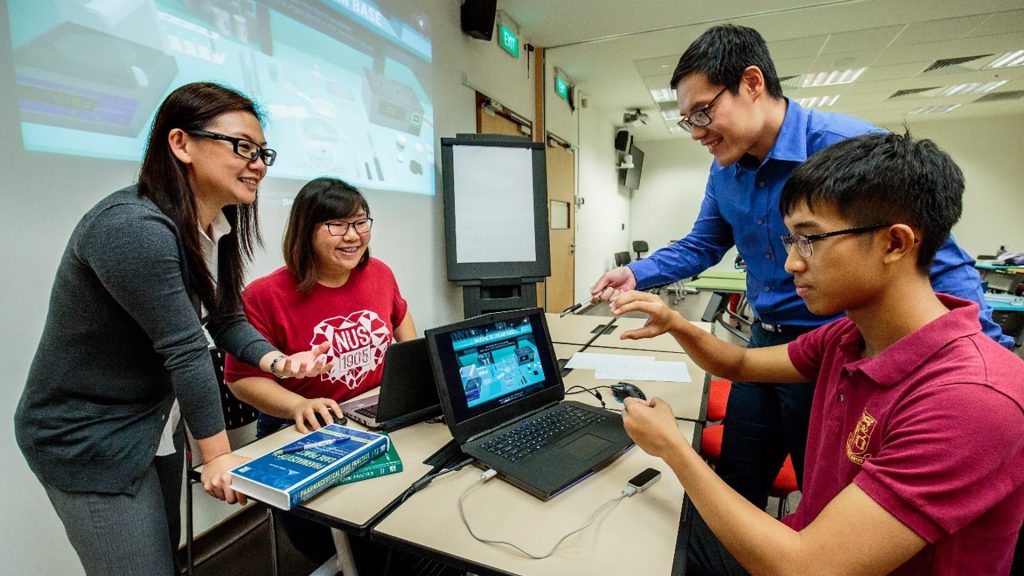
The University’s key theme of preparing undergraduates for the workplace of the future will be further enhanced with the launch of new majors, minors and degree specialisations in the upcoming academic year. About 10 new courses are on the cards.
New programmes from the NUS College of Design and Engineering (CDE), NUS Faculty of Science, NUS School of Computing, and NUS Faculty of Arts and Social Sciences will cover areas such as Artificial Intelligence, technology, data science, sustainability, globalisation. They will add on to the interdisciplinary offerings by the flagship NUS College, Singapore’s first honours college welcoming its first cohort in August – as well as those by the College of Humanities and Sciences (CHS).
“The overall goal of all our education reform efforts is to advance a university curriculum that prepares students well for a Fourth Industrial Revolution world and workplace,” said Professor Bernard Tan, NUS Senior Vice Provost (Undergraduate Education).
“Our education, focused on both breadth and depth, ensures that our graduates are held in high regard by employers. Last year, more than nine in 10 NUS graduates secured a job within six months of their final examinations.”
New majors and minors
Bachelor of Engineering (Infrastructure and Project Management)Offered by CDE’s Department of the Built Environment, this degree will equip graduates with the knowledge and interdisciplinary skills to excel in the multifaceted built environment. This is the first interdisciplinary full-time undergraduate programme to cover engineering, design, management, technology, building science and law modules. Major in Anthropology
Offered by the NUS Faculty of Arts and Social Sciences to all CHS students, this major will study the range of human diversity, accounting for how people in different times and places have developed into distinctly different societies. The degree will expose students to a vast variety of different beliefs and health practices, economic and political systems, material culture, and even different notions of beauty, the environment, food, family, and the good life.
Anthropology is much sought after for the sort of training it offers its students – a ground up approach to developing deep understanding on just about every aspect of the human condition. Students will be equipped to better understand and deal with the chaos, uncertainty, and ambiguity that characterises the contemporary age.
Second Major in Sustainable Urban DevelopmentOffered by CDE’s Department of Civil and Environmental Engineering, it aims to train the next generation of urban problem-solvers. They will be equipped with interdisciplinary knowledge and skills to create sustainable urban environments in the context of the changing climate. Open to all NUS undergraduate students, this major is stackable to students’ primary major in their chosen field, and can be completed in four years with no additional academic workload. Second Major in Nutrition
This will be offered by the Faculty of Science to all CHS students, including those reading Food Science and Technology as the primary major. It is designed to equip students with knowledge in human nutrition, providing them with the necessary foundation to develop a cross-disciplinary perspective along the food supply chain – from farm to fork to health. Minor in Interpreting
Multilingualism is a defining characteristic of Singapore’s multi-ethnic, immigrant society. With four official languages and with English as the working language, translating and interpreting between each of the mother tongues and English has always been a prominent feature of Singapore society. Against this backdrop, the NUS Department of Chinese Studies has placed as one of its core objectives, the training of graduates with strong Chinese-English bilingual skills who can become leaders in the translation and interpreting arenas.
This new Minor will allow students a related alternative to translation, or as an affiliated Minor to Translation which is already being offered at the Department.
New specialisations
Three new specialisations will be offered by the NUS School of Computing:
Specialisation in Digital Product and Platform ManagementThis will be offered to students pursuing the Bachelor of Computing (Information Systems) Degree. They will build up a repertoire of knowledge and skills sought after by both technology companies and the digital immigrant companies that are fast adopting the product- and platform-centric technology and business operating models. Specialisation in Intelligent Systems Solutioning
Students pursuing the Bachelor of Computing (Information Systems) Degree can also take this new specialisation to learn to implement and apply intelligent system solutions buttressed by the new technologies of Artificial Intelligence, the Internet of Things, and Augmented Reality. They will learn to apply these new technologies in software engineering, and to implement and manage intelligent system solutions. Graduates will be able to take on job roles in intelligent systems engineering and solutioning. Specialisation in Machine Learning-based Analytics
This new specialisation for Bachelor of Science (Business Analytics) students will enable students to tap into the analytics capabilities of Machine Learning, a sub-field of Artificial Intelligence. They will learn to rapidly and automatically develop models that can quickly and accurately analyse massive, complex data sets, in order to help businesses unlock the value of corporate and customer data and enact decisions that keep them ahead of the competition. Graduates will be able to take on careers in the rapidly-growing business and data analytics field, among others.
New modules
Aside from the new majors, minors and specialisations, a number of new modules are being offered. For instance, the NUS School of Computing is starting a Digital Ethics and Data Privacy module to educate students on this pertinent and pressing issue.
The NUS Faculty of Law is introducing two modules – one on Law & Technology and one on Data Literacy – as technology and data are increasingly being key drivers for the legal industry.
Find out more about the courses offered by the University, and explore this year’s Open House. Here are four things to look out for at the Open House.
This story first appeared on NUSNews on 24 February 2022.
NUS Open House 2022: Interdisciplinary Offerings, In-person Activities and More!
IN BRIEF | 5 min read
- NUS Open House 2022 is back with opportunities for prospective students to meet NUS professors, students and alumni face-to-face, after two years of connecting virtually.
- Running from 26 February through 5 March, NUS Open House 2022 will begin with a comprehensive line-up of informative activities, including the online segment, during the week leading up to the physical Open House, which takes place on Saturday, 5 March from 9 am to 7 pm across NUS’ campuses in Kent Ridge and Bukit Timah.

NUS Open House 2022 is back with opportunities for prospective students to meet NUS professors, students and alumni face-to-face, after two years of connecting virtually.
The physical event will take place on Sat, 5 Mar from 9am to 7pm across NUS’ campuses in Kent Ridge and Bukit Timah. This will be preceded by a comprehensive line-up of informative activities during the week leading up to the physical Open House.
Including the online segment, NUS Open House 2022 takes place from 26 Feb to 5 Mar. Here’s a heads-up on four things to check out:
1. Exciting interdisciplinary offerings
NUS College, Singapore’s first honours college, was formed by the merger of the University Scholars Programme and Yale-NUS College. Offering an immersive, experiential and interdisciplinary educational journey, it will welcome its first batch of students this year. Students will have a home college or faculty, say, Business or Engineering, while simultaneously being enrolled at NUS College. There, they will have the opportunity to enjoy a holistic interdisciplinary curriculum that is complementary to their major.
Another option for interdisciplinary learning can be found at NUS College of Design and Engineering. The College offers a programme that prepares students for the future through interdisciplinary learning and robust research in the fields of engineering and design. At the College, students are given the flexibility to build and design their own learning experience.
The NUS College of Humanities and Sciences, the enhanced undergraduate experience for students of the Faculty of Arts & Social Sciences and the Faculty of Science, is accepting its second intake this year. The College offers 13 Common Curriculum pillars consisting of modules such as scientific inquiry, humanities, digital literacy, design thinking, artificial intelligence and many more exciting options. These are complemented by majors and minors spanning the arts, humanities and sciences, such as global studies, philosophy, theatre and performance studies, quantitative finance, data analytics and pharmaceutical science. Students can pick and choose modules to create a customised curriculum that matches their interest and aspirations.
To ensure that graduates are ready to take on leading roles in the New Economy, NUS constantly develops new courses. Here are this year's new offerings.

2. Meeting you in person - again
After two years of meeting virtually, the NUS community is excited to get together in real life with prospective students once again!
You can look forward to an enlightening schedule of in-person activities including a tour of the Centre for Healthcare Simulation by NUS Nursing; tours of residential living options such as Tembusu College, CAPT (College of Alice & Peter Tan), and RC4; a live demonstration of a moot court session and tour of the NUS Bukit Timah campus by NUS Law; tours and a showcase of NUS College; as well as a live question-and-answer session with Duke-NUS Medical School.
3. Webinars, talks, live chats, hotlines and more
Get a taste of life as an NUS student, even before the physical event. A host of insightful webinars, talks, question-and-answer sessions, live chats, hotlines, and virtual tours have been arranged starting 26 Feb to give you a head start on topics such as admissions, student life, and on-campus living, as well as programmes offered by NUS College, the College of Design and Engineering, the College of Humanities and Sciences, Business, Music and many more.
Obtain behind-the-scenes knowledge from NUS student ambassadors and the NUS Students’ Union on the rich student life available at NUS, and be serenaded by NUS Choir and NUS Jazz Band.
Professors will be on hand to share information on their respective programmes, and you’ll even have a chance to sit in on classes. Have a question that is not covered by the briefing? No sweat! There’ll be chat sessions with NUS Admissions, professors and students from selected programmes during which you can get your queries addressed.
Click here for the list of virtual and in-person activities for NUS Open House.

4. Exciting student life
NUS offers a myriad options for a rich student life, and NUS Open House is the perfect place to start exploring the possibilities. Many alumni recall their NUS days fondly, remembering not only the academic progress they made, but the camaraderie forged with friends from clubs, societies and on-campus residences.
Throughout the period of the online Open House and during the physical event, representatives from various student-led groups will speak on topics including hall life, clubs and societies, as well as campus performing groups. Take part in a live session with music and dance groups, embark on a virtual residential tour, and more.
We’re looking forward to seeing you online from 26 Feb and in-person on 5 Mar!
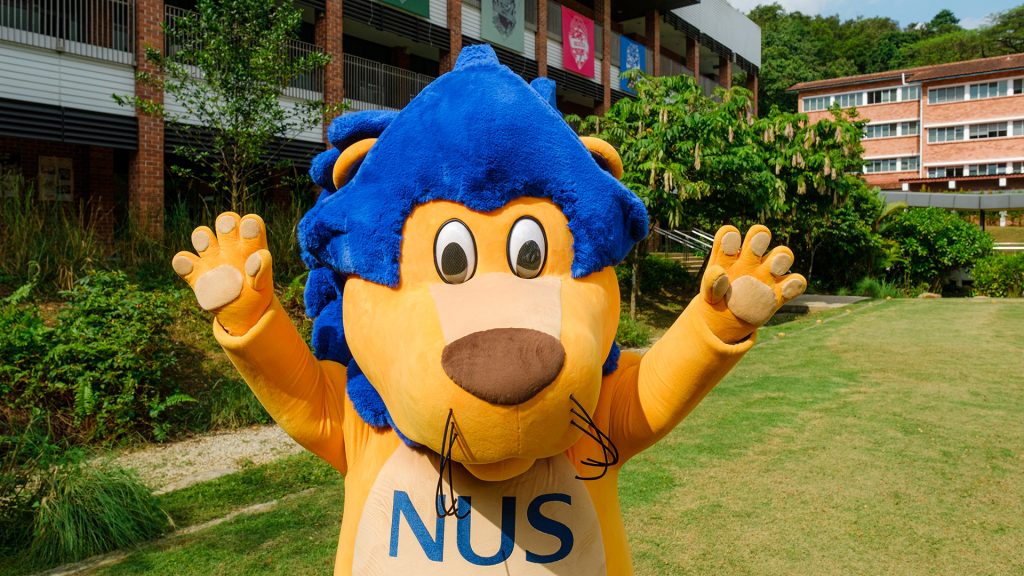
This story first appeared on NUSNews on 23 February 2022.
We Are NUS: 60 Fascinating Vignettes by Alumnus Yeo Tze Yang
IN BRIEF | 5 min read
- Artist and NUS alumnus Yeo Tze Yang (Southeast Asian Studies, ’19) spent about two years to complete the 60 paintings constituting an installation – “We Are NUS: The People and Everyday Life of a University” – residing in the newly-refurbished NUS Central Library.

Visitors to the newly-refurbished NUS Central Library would have chanced upon a brand new art exhibition, brightly installed at the entrance foyer. Launched virtually on 22 Feb, the visual display comprised 60 smaller art pieces, depicting people and scenes from everyday life in NUS, and presenting a microcosm of the vibrant and extensive NUS community.
Painted by artist and NUS alumnus Mr Yeo Tze Yang, the art pieces took around two years to complete, in light of COVID-19 challenges. The Southeast Asian Studies graduate from the Class of 2019 at the Faculty of Arts & Social Sciences was selected to work on this commissioned collection.
Gathering a diverse yet collegial community
Baby steps towards putting together this exhibition started in 2020, as the NUS community banded together during the early days of the pandemic. A series of virtual get-togethers called “NUS OK’ or ‘NUS, Our Kampung” was organised for the community to stay in touch. “We Are NUS: The People and Everyday Life of a University” built on this to celebrate the treasured bonding and shared experience.
In the spirit of capturing the zeitgeist of the NUS community, staff, students and contractors were selected through an open call, along with iconic scenes from various corners of the campuses.

Said Tze Yang, “I painted a diverse range of people from different backgrounds, faculties and offices. Some have spent only a couple of years in NUS. Some have spent almost half a century. Everyone's story is unique – for some, an NUS education was a first in their family. For others, NUS was a workplace where they found friendship and meaning. Everyone's experience of the University is different.
“The project kickstarted with a vision in mind, to fill three walls with small paintings of the people, places and things that make up NUS. The University is a large institution, with so many facets, corners and nitty-gritty that called for such a display format.”
In order to bring out the essence of the people he painted, Tze Yang said he adopted the approach of painting them in a setting where he engaged them in direct conversation, citing two Asian artists, Thailand’s Navin Rawanchaikul and China’s Liu Xiaodong, who are known for this approach.
A sensitive and perceptive eye
Tze Yang’s talent extends beyond the artistic – he has the ability to connect with others to help them relax, feel comfortable and draw out their stories, bringing out different sides of people hitherto unseen.
“We had a really intense conversation on weighty subjects such as politics, privilege and purpose during the portraiture session,” said Associate Professor Daniel Goh, NUS Associate Provost (Undergraduate Education).
“That was how he painted me, wisened and wizened, with the severe frown that I often carry on my face when I am alone with my thoughts of the issues I wrestle and memories of the good fight I tried to fight. Tze Yang peeked into my inner struggles and painted it.”

This sentiment was also echoed by Ms Daphne Chua who works at NUS Business School. “We chatted over various topics, such as art versus design, family backgrounds, personalities, personal setbacks, and mental health, which I have never openly shared with anyone throughout my two years of work in NUS. It was rare to connect with someone as understanding as Tze Yang, who held space to embrace my thoughts and vulnerability without judgment,” said Daphne who has a background in visual arts.
Daphne also recounted how Tze Yang’s patience and discipline resonated with her, sharing an interesting snippet. Tze Yang had painted her portrait twice because he was not satisfied with the first iteration. However, she loved both portraits because they represented his own time, effort and unique perspective.
“This experience made me feel incredibly seen and appreciated as a person, rather than what I can simply produce,” she added.

Also part of the exhibition is a familiar face to those who frequent the canteen at Faculty of Science – Uncle Wong, who mans the drinks stall at Frontier. To Uncle Wong, who has been a steadfast presence in NUS since 1996, the University represents a place where he has met many people and developed close friendships with them. He described the painting process as “relaxing”, where he was able to chat with Tze Yang and answer his questions. It is Uncle Wong’s hope that “current students or alumni will reminisce about their time in NUS, when they see the painting of my likeness.”

Celebrating a community
Associate Professor Erle Lim, NUS Vice Provost (Teaching Innovation & Quality), a member of the committee involved in spearheading this project, shared, “I am very proud to see the project come to fruition. We hope that this exhibition can convey how special NUS is, that we are more than a place of study for the community – we are a family.”
For Tze Yang, as an alumnus and the artist behind this project, the collection of paintings represents his hope that it will “serve as a reminder of what makes a University special, beyond the newspaper headlines and trophies. These tiny moments and stories of people are what make this institution matter so much to many of us over its many decades of existence”.
Even as one steps away from the exhibition, the NUS story continues. The visual tapestry of NUS will evolve and transform, as new experiences are lived, and exciting discovery moments celebrated in the years to come.
Take a virtual tour of the art gallery here or visit the gallery and take wefies or selfies with the paintings at the photo booth.
You can also catch a short video on what Tze Yang and his subjects said about their experience here.
This story first appeared on NUSNews on 23 February 2022.
FASS Inspiring Mentor 2021 Award Winners Announced

The NUS Faculty of Arts and Social Sciences is proud to announce the winners of the 2021 FASS Inspiring Mentor Awards.
Congratulations to:
- Prof Jack Qiu Linchuan, Professor, Department of Communications and New Media
- Assoc Prof Loy Hui Chieh, Associate Professor, Department of Philosophy
- Assoc Prof Robin Loon Seong Yun, Associate Professor, Department of English Language and Literature
- Dr Michael Yoshitaka Erlewine, Assistant Professor, Department of English Language and Literature
- Dr Nina Laurel Powell, Senior Lecturer, Department of Psychology
The e-STEER Programme: A Passage to Sub-Saharan Africa
IN BRIEF | 4 min read
- Thanks to technology, in-depth experiences of faraway places are still possible despite COVID-19 slowing down international travel — as some 80 NUS students found out as participants of the latest, 'virtual', iteration of the NUS Study Trips for Engagement and EnRichment (STEER) programme travelled to Africa.

Thanks to technology, in-depth experiences of faraway places are still possible despite COVID-19 slowing down international travel – as some 80 NUS students found out. Participants of the latest iteration of the NUS Study Trips for Engagement and EnRichment (STEER) programme travelled to Africa, howbeit virtually.
STEER programmes are designed to familiarise students with the diverse socio-cultural-political-economic-business environments of fast-evolving region. Over the past decade, the NUS Global Relations Office (GRO) has organised a myriad of such programmes to countries and regions that are either undergoing institutional transformation, experiencing catch-up growth or have strengthened bilateral ties with Singapore and in the process, enhancing overseas career opportunities for our undergraduates.
However, with the onset of the pandemic, the STEER programme pivoted to a virtual environment, expanding its reach through a series of webinars and virtual lectures, e-networking sessions and vicarious cultural visits.
Held from 6 to 16 Dec 2021, the e-STEER programme focused on Sub-Saharan Africa, which includes countries such as Botswana, Ghana, Kenya, Nigeria, Rwanda and South Africa. The two-week programme engaged students with invaluable insights into the political history, economic and social development, management of natural resources, as well as the rich heritage and cultures of the region.
His Excellency Jean de Dieu Uwihanganye, High Commissioner of the Republic of Rwanda to Singapore, delivered an introduction to Rwanda, that gave the students a first look into this “land of a thousand hills”, rich in natural resources and biodiversity, which is also the most densely populated mainland African country.
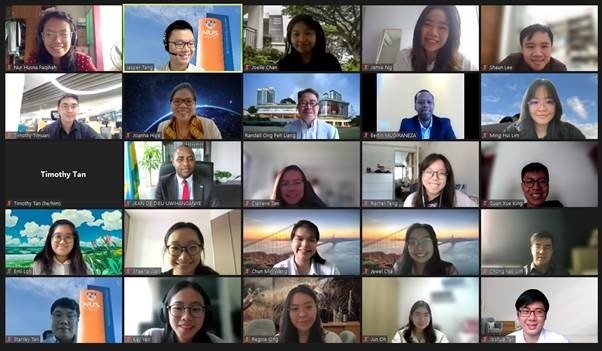
Colonialism and slave trade are topics which are inevitable in the discussion of history and development of Africa, and students were deeply immersed in several lectures which enlightened them on the history of the slave trade, and its effects on African society and practices to this day. Professor Brian Farrell from the NUS Department of History presented an in-depth lesson on Africa, British Africa and the British Empire.

Dr Dorothy Takyiakwaa from the University of Cape Coast facilitated an enlightening lecture on the slave trade and slave castles. Her lecture was immediately followed by a virtual tour of the Cape Coast Castle, one of 40 slave castles built in West Africa used to hold slaves before they were loaded onto ships and sold in the Americas. Through the use of virtual reality (VR) headsets, students were able to view the dungeons at Cape Coast Castle, which were often the slaves’ last residence and final memory of Africa before leaving the continent through the ‘Door of No Return’.
Our students were enthused about the VR headsets used for the first-time in the e-STEER programme. Said Oh Jun Ning, Year 4, NUS Science student, “The sounds and sights were realistic, and it felt like we were exploring the place itself with a tour guide. Given that the entire programme was conducted online, the virtual tour was definitely a change of pace and scenery. It would be great if VR was to be integrated into future online programmes especially in the face of current COVID-19 restrictions.”

Norsheena Riyana, a Year 1 student from the NUS Department of Political Science, described the lectures on this topic as “different and personal”, as she “spoke with individuals whose ancestors were personally affected by the atrocities committed during colonisation, the transatlantic slave trade, and the 1994 Rwandan Genocide, instead of reading these accounts through academic articles and social media”. She also highlighted the virtual tour of the Cape Coast Castle as one of the sessions that she was most interested in, as “it was the closest experience to being physically there”.

A number of students among the participants this year had a keen interest in conservation and ecology, and the e-lectures delivered by representatives from the University of Rwanda and Rwanda Development Board further piqued their interest by delineating the broad considerations behind wildlife conservation in Rwanda, particularly on the population of endangered mountain gorillas which reside in Rwanda’s national parks.
The eye-opening sessions explained more on the costs and considerations behind biodiversity management in these precious land areas, and efforts to include and give back to the surrounding communities whose livelihoods are directly influenced by wildlife efforts and ecotourism to the national parks.
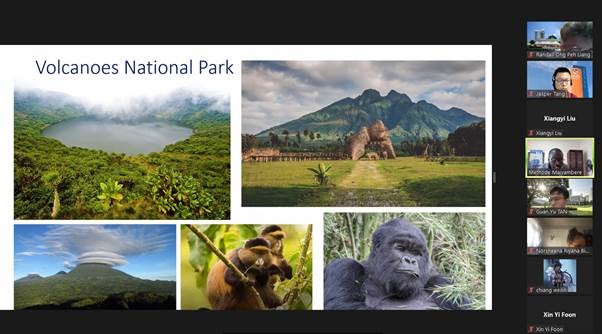
Joanna Hioe, a PhD Year 1 student from the NUS Department of Southeast Asian Studies, said, "The e-STEER Sub-Saharan Africa programme gave us the unique opportunity to survey the continent, with a panoramic view of its history, culture, economy, and geography, and literally savour it, with an audio-visual feast of its music and fashion, and tastes of its food. It was a rich buffet that left students of all majors spoiled for choice.
“The thoughtfully curated e-STEER programme opened my eyes to the plethora of ways that deep, meaningful inter-cultural and transformative encounters can still be facilitated through technology.”
Building FriendshipsThe NUS student participants also met and built friendships with peers from Zetech University (Kenya) and the University of Rwanda, through two networking sessions organised for cross-cultural sharing of Singapore and Kenyan/Rwanda cultures and way of life. Schubert Goh, Year 3 student from NUS Computing, also delivered a presentation that shared with the Kenyan and Rwandan students on Youth Culture in Singapore.
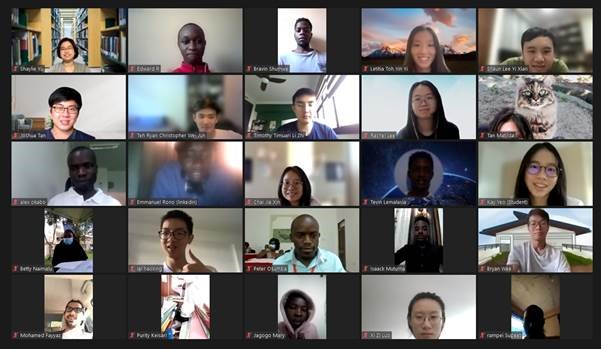
On the last two evenings of the programme, students tucked into a delectable meal set from Kafe Utu, an African café and lounge in Singapore, named for the Kiswahili word for “humanity”. Though dining individually at home, it was an experience shared virtually, in appreciation of a varied African cuisine and learning about the history and culture behind the menu.
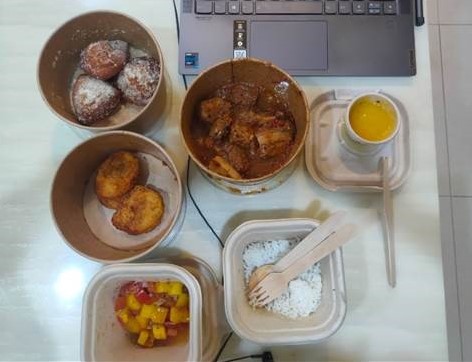
“We’re privileged and honoured to have partnered with many distinguished members of the diplomatic corps, government officials, academics, corporate professionals, entrepreneurs, and leaders of trade associations and chambers of commerce in delivering the STEER/e-STEER programmes,” said Mr Randall Ong, Associate Director at NUS GRO, who conceptualised the STEER programme from its onset.
“The feedback from participants has been overwhelmingly positive. We’re heartened that the sessions have facilitated tremendous educational value creation, such as in the analyses of social, environmental issues and business models, cross-cultural appreciation and professional networking opportunities for our students.”
Although the planning and implementation of overseas travel continues to be a challenge, NUS and GRO remain committed to providing our students with global opportunities for learning, albeit in alternative ways such as virtual immersions, to enhance the development of cultural understanding and skill sets in relating to a global economy.
This story first appeared on NUSNews on 7 January 2022.
Winners of AY2020-21 Faculty Teaching Excellence Awards Unveiled
 The NUS Faculty of Arts and Social Sciences is proud to announce the 37 winners of the Faculty Teaching Excellence Award for their work in AY2020‐21, 16 of which have also been nominated for the Annual Teaching Excellence Award(ATEA) and Annual Digital Education Award (ADEA).
The NUS Faculty of Arts and Social Sciences is proud to announce the 37 winners of the Faculty Teaching Excellence Award for their work in AY2020‐21, 16 of which have also been nominated for the Annual Teaching Excellence Award(ATEA) and Annual Digital Education Award (ADEA).
Special thanks are due to members of the Faculty Teaching Excellence Committee–Dr Susan Ang (English Language and Literature and Chair of FTEC), A/P Loy Hui Chieh (Philosophy; FASS Vice‐Dean), A/P Lim Wee Hun, Stephen (Psychology), Dr Gilbert Yeoh (English Language and Literature) and Mrs Chen Ing Ru (Centre for Language Studies)–for their efforts in shortlisting and nominating the winners.
|
NAME |
DEPARTMENT |
|
Mr Appriou Yannick Francois |
Centre for Language Studies |
|
Ms Baranska, Malwina |
Centre for Language Studies |
|
Ms Klayklueng, Sasiwimol |
Centre for Language Studies |
|
Ms Morita, Kazuko |
Centre for Language Studies |
|
Dr Chaidaroon Suwichit |
Communications and New Media |
|
Dr Hong Renyi |
Communications and New Media |
|
Dr Mitchell, Alexander Ian |
Communications and New Media |
|
Dr Shobha Avadhani |
Communications and New Media |
|
Mr Tan Kai En |
Communications and New Media |
|
Dr Timothy Wong Chong Ji |
Economics |
|
Dr Vu Thanh Hai |
Economics |
|
A/P Michelle M. Lazar |
English Language & Literature |
|
Dr Miguel Escobar Varela |
English Language & Literature |
|
A/P Starr Rebecca Lurie |
English Language & Literature |
|
A/P Thell Anne Marie |
English Language & Literature |
|
Dr Roy, Tania |
English Language & Literature |
|
A/P Chang Tou Chuang |
Geography |
|
A/P Daniel Adam Friess |
Geography |
|
Dr Gretchen Christina Coffman |
Geography |
|
Dr Kamalini Ramdas |
Geography |
|
Dr Kenney-Lazar Miles Richard |
Geography |
|
Dr Teo Sheng Kiat, Shaun |
Geography |
|
Dr Donna Maree Brunero |
History |
|
Dr Lawrence, Kelvin |
History |
|
Dr Sayaka Chatani |
History |
|
Dr Beddor, Robert Speeter |
Philosophy |
|
Prof Bain, William Ward |
Political Science |
|
Dr Dunya Deniz Lepori |
Political Science |
|
Dr Jia Lile |
Psychology |
|
Dr Nina Laurel Powell |
Psychology |
|
Dr Wong Shi Hui Sarah |
Psychology |
|
Dr Peace Wong Yuh Ju |
Social Work |
|
Dr Chua Hui Ching, Emily |
Sociology |
|
Dr Elliott Edward Prasse-Freeman |
Sociology |
|
Dr Jennifer Emily Estes |
Sociology |
|
Dr Noorman Abdullah |
Sociology |
|
Dr Radics, George Baylon |
Sociology |
Congratulations to them all!
FASS Announces New Additions to Leadership Team
IN BRIEF | 2 min read
The NUS Faculty of Arts and Social Sciences is pleased to announce recent new appointments to the Faculty's leadership team.
Three eminent members of the Faculty received new appointments to the Deanery at the beginning of this year:
- Professor Joseph Park (English Language and Literature)
Vice-Dean (Undergraduate Studies) - Dr Zhang Yang (Economics)
Associate Dean (Undergraduate Studies) - Dr Noorman Abdullah (Sociology)
Assistant Dean (External Relations and Student Life)
We wish them the very best with their new portfolios. Click here to visit the FASS Deanery page.




NUS Bags Major PR Award for College of Humanities and Sciences Campaign

One year since the official inauguration of the NUS College of Humanities and Sciences (CHS), the publicity campaign for the new College has gained recognition at the recent Public Relations in the Service of Mankind (PRISM) Awards.
The University bagged a Distinction Award in the category “Outstanding Campaign by a Non-Government Organisation or Not-For-Profit Organisation” for the launch and publicity of the interdisciplinary College.
The award recognises NUS’ effective communications regarding the necessity of an interdisciplinary education to faculty members, prospective students and their parents, alumni, employers, and members of the public.
The campaign also underscored what CHS offers students in a world plagued by complex challenges that require integrated interdisciplinary approaches. The campaign included the launch event, student profiles, social media, and CHS collaterals and media assets in the form of CHS-specific infographics, news and FAQs.
The campaign also included a video series on interdisciplinarity, a podcast series by the teaching team of the common curriculum Humanities module, and stakeholder endorsement in the form of testimonials from students and alumni of NUS Faculty of Arts and Social Sciences (FASS) and the NUS Faculty of Science (FoS) who have pursued interdisciplinary studies. A successful admissions publicity campaign was run, including the 2021 NUS Open House which drummed up interest in the College with student and employer panels, small group tours, and student chat rooms.
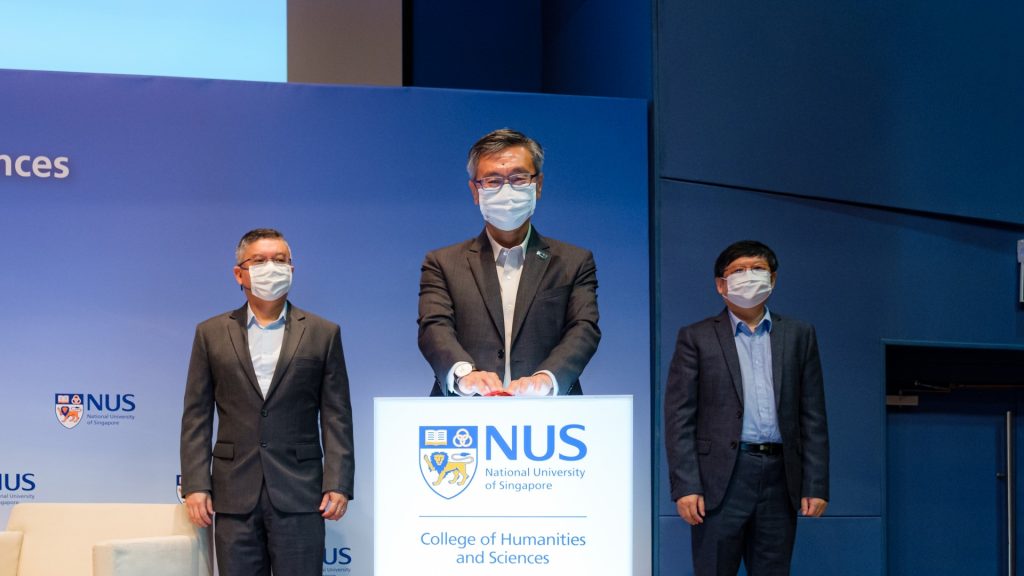
The accolade from PRISM, which coincides with the one-year anniversary of the official inauguration of CHS, bears testament to the concerted effort on multiple fronts of the campaign by various stakeholders, including the Communications teams from FASS and FoS, the NUS Office of University Communications and communications agency AKA Asia.
“The award comes as a truly wonderful one-year anniversary gift to all our colleagues involved in the CHS campaign,” said NUS Chief Communications Officer Ms Ovidia Lim-Rajaram.
“It is gratifying to know that our efforts to kickstart a meaningful, groundbreaking programme at the College are paying off, and that the journey to promoting an interdisciplinary, 21st-century educational experience at NUS is off to a great start.”
Communications at CHS is co-led by Mr Nisar Keshvani, Associate Director for Strategic Outreach and Communications at FASS, and Ms Janice Quah, Associate Director for Corporate Communications at FoS.
“The campaign award, a result of the synergy and collaboration across diverse University faculties and departments, epitomises the spirit of interdisciplinarity that CHS values, and the idea of capitalising on each other’s strengths to achieve the best outcomes,” Mr Keshvani said.
Ms Quah added, “It has been a challenging journey but seeing our communications ideas collectively come to fruition is truly fulfilling! The validation of the hard work motivates us to continue raising the bar, to sustain the impactful profiling of CHS to students and stakeholders.”
Recognising the best in public relations
Celebrating 44 winners across 27 categories, the PRISM awards ceremony was held on 15 Dec by the Institute of Public Relations Singapore (IPRS), the only accrediting body for public relations practitioners in Singapore. The Guest of Honour was Mr Tan Kiat How, Minister of State at the Ministry of Communications and Information (MCI).
Acknowledging the challenges of a shifting communications landscape, Mr Tan said, “MCI recognises the importance of excellence in public relations and communications across all sectors of the economy.”
“The campaigns up for awards today show how all of you have worked around these challenges and continued to achieve excellent levels of reach and impact.”
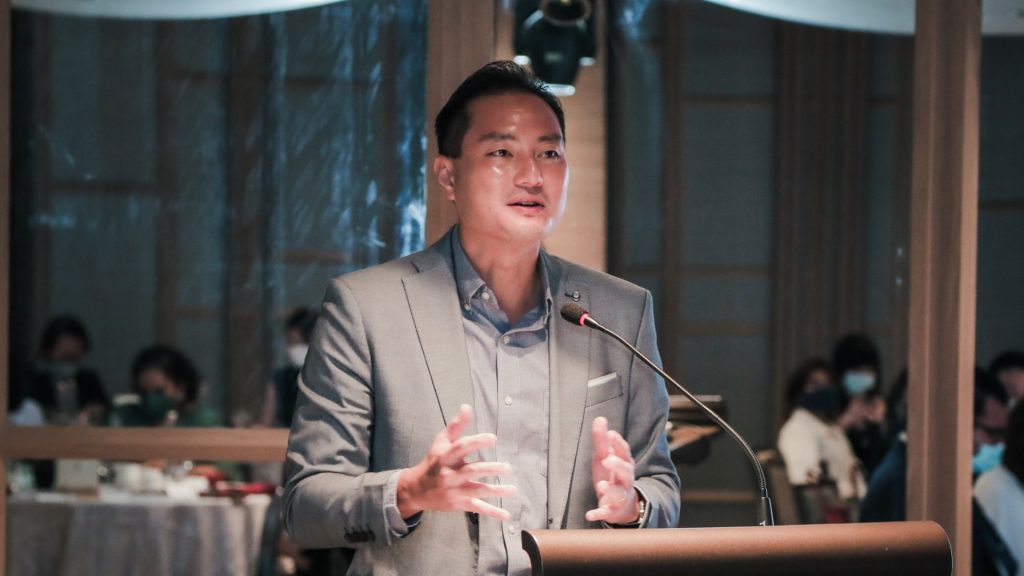
Held biennially since 1987, the PRISM Awards is one of the oldest and most prestigious awards in the industry, celebrating Singapore’s brightest stars in the communications and public relations industry. It is judged by a panel of established business leaders and senior practitioners, recognising and honouring organisations and individuals for excellence in public relations and communications.
Ms Koh Juat Muay, President of the IPRS Council 2021/2023 said, “The winning entries and the winners this year reveal a singular story – the resilience of our people, the ingenuity of the campaigns and strength of the organisations that continues to thrive in an evolving local and global communications landscape.”
“IPRS is privileged to hold PRISM Awards 2021 and share in the pride of profession demonstrated by our people and in the brilliance of their campaigns. Our winners truly embody the meaning of PRISM and that is Public Relations In the Service of Mankind,” she added.
This story first appeared in NUSNews on 21 December 2021.
[??? ????] ??????????? ??? ??? ???? ???: ????????? ???????? ??? ???????? ?? ????????? ???? ??? ???? ????
??????????? ??? ??? ???? ???: ????????? ???????? ??? ???????? ?? ????????? ???? ??? ???? ???? (Routledge, 2021), edited by Associate Professor Xu Lanjun (NUS Chinese Studies) and Associate Professor Jeremy E. Taylor (University of Nottingham), explores the different notions of “Chineseness” during the Cold War through the examination of specific case studies of the “Chinese cultural Cold War” in Hong Kong, Singapore, Malaya, Thailand, Indonesia, and Vietnam. These competing notions of “Chineseness” were played out in many areas – from bookstores, cinemas, music halls, classrooms, and sport clubs, to places of worship across the region in the 1950s, 1960s, and 1970s. The book also explains how the events of the Cold War continue to affect arguments about the extent of Chinese influence and “Chineseness” in Southeast Asia and the wider region today. Read the book here.

An Interview with Emeritus Prof S. Vasoo and Assoc Prof Winston Goh on The Strange Start of Psychology at the National University of Singapore
The Strange Start of Psychology at the National University of Singapore (NUS Department of Psychology, 2021), showcases the history of the NUS Faculty of Arts and Social Sciences' Department of Psychology, Singapore's oldest psychology programme. The programme, which kicked off during the 86/87 academic year at the Department of Social Work (renamed the Department of Social Work and Psychology), became a department in 2005.
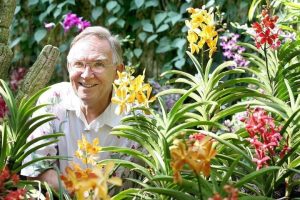
Author Dr John Michael Elliott (1945-2019), who was at the time a psychologist at the then Ministry of Social Affairs, joined the programme six weeks after it began and retired in 2018.
As the book explains, in Singapore, historically psychology was viewed more as clinical work that supported psychiatry, and mental health care was deprioritized. Instead, during the island's colonial era, patients requiring mental health treatment were institutionalized in The Insane Hospital, which commenced operations in 1841 with 30 beds. This hospital evolved into The Lunatic Asylum (1862, 100 beds), followed by The New Lunatic Asylum (1887, 300 beds), and then the Mental Hospital in 1928, which became Woodbridge Hospital in 1951.
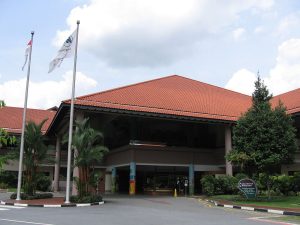
In 1993, Woodbridge Hospital moved to Buangkok Green, becoming the Institute of Mental Health's new inpatient facility.
There was a definite need for trained psychologists in Singapore, as well as a programme to train them, since, post-independence, all psychologists in the country completed their education abroad. When the NUS psychology programme got started in July 1986, however, the discipline was still often seen as non-Asian and more as medical training than a social sciences course, and also as a luxury in the realm of social work. The Department of Social Work was an ideal place for the new programme, Dr Elliott notes, as it would contribute to the department's own development, enabling it to offer an honours degree in social work and psychology.

The NUS psychology programme's initial cohort had 72 students and 1 staff and grew rapidly. There are currently around 900 students in the introductory psychology module and 220 honours graduates annually. At its inception 35 years ago the programme offered a three year general degree with a competitive fourth year honours degree. In 1989, 50 students received a general degree, 11 of whom went on to get an honours degree. Today, the department's own clinical psychology master's programme graduates approximately 15 annually, and psychology graduate students can also obtain a Master of Social Sciences or PhD.
The NUS Department of Psychology ranks 16 out of 303 on the Quacquarelli Symonds list and psychology is a well recognized and respected course of study in Singapore. Many graduates go on to engage in psychological work in the public sector, such as in Singapore's Ministries of Health, Defense, Home Affairs, and Social and Family Development. A number of graduates are also employed in private sector positions involving psychological work like human resource management and marketing, or in private practice in the fields of clinical, counselling, and industrial-organisational psychology, among others.

We discussed the The Strange Start of Psychology at the National University of Singapore, which has an online launch on Friday, 10th December at 11 am, with Associate Professor Winston D. Goh, the current NUS Department of Psychology Head, and Emeritus Professor S. Vasoo, who led the then NUS Department of Social Work and Psychology from 1987 to 1999.
 A/P Vasoo Q & A
A/P Vasoo Q & A
1. What were your most memorable experiences developing the new psychology programme during your term leading the NUS Department of Social Work and Psychology?
I have been teaching students and working with academic staff for about 50 years. In the course of these years, I always encouraged and advised them not to look back on events that had surpassed them. This is because memorable matters would not come back and one would not be able to deal with the bygones. No point spending time lamenting over things that have gone past as it can be emotionally costly and tiring. I always encourage students and academic staff to look ahead on events that will be forthcoming as these can be managed as they unfold and are within their control. I am of the opinion that various human issues that we can grasp at hand are largely solvable as long as we persistently tackle them with empathy. It is only with good empathy that we can have clearer insights to deal with human issues and relationships.
I recall that one of the challenging tasks that I had to deal with as the Head of the Department of Social Work and Psychology was to quickly recruit a group of Psychology academic staff to deliver the undergraduate psychology programme in 1986. I had selected staff with diverse psychology training such as a developmental psychologist, a cognitive psychologist, a social psychologist, an experimental psychologist, a clinical psychologist, and a psycholinguist. You can imagine with these varied backgrounds coming together to agree on a basic undergraduate curriculum was not easy. Each of them had different hobby horses to ride, which was understandable while mind-boggling, as there were protracted views within the group and at times heated arguments that I had to mediate. I brokered a deal as a non-partisan and drew a consensus among the different psychological academic personalities for the need to develop a top-notch undergraduate psychology programme based on the best psychology departments in the United Kingdom and United States. The foundation laid for the early phase of the psychology programme saw the fruition of some of our top psychology scholars in the Faculty of Arts and Social Sciences. I am indeed proud to witness that some of these accomplished scholars have become lead anchors of the NUS Department of Psychology and later appointed Heads. The nurturance of these top scholars have helped stabilize the psychology programme and provided succession of leadership. They also supported the Deanery of the Faculty of Arts and Social Sciences.
2. What can psychologists learn from social workers, and what can social workers learn from psychologists?

To put it simply, both psychology and social work are non-identical twin disciplines with each having to deal with human behaviour and social issues. As a psychologist, one has to understand human behaviour and the cause of such behaviour, and as a social worker, one has to understand the cause of social and human problems and then enable people to find ways to problem solve. Both disciplines deal with human and psychosocial issues, and human behaviour requires a multidisciplinary focus. I would say that no single discipline is adequate to solve human life course issues. I must add that a good psychologist will require social work lenses and a competent social worker needs to have helpful psychological lenses. As one will appreciate, we are all human beings and are ecologically bounded. Therefore both psychological and social work analyses are critical to better appreciate human behaviour and social interactions, and these can contribute to effective human and social problem solving.
3. What do you see as the most notable impacts in practice of social work and psychology in Singapore so far and in the future?

Psychology graduates as well as social work graduates are making robust contributions in public service, private enterprises, and non-governmental organisations. Psychologists hold highly respectable positions in areas such as clinical services, rehabilitation, health, human resources, education, the armed forces and the police, besides others. Increasingly, psychologists are needed to contribute psychological solutions to strengthen our psychological defences against various societal crises.
Likewise, social workers are also appointed in highly regarded positions in fields such as social services, rehabilitation, health, social research, counselling and mental health, education, the armed forces, and childcare, among others. Both psychologists and social workers have so far given valuable suggestions and inputs to policy changes to the care and protection of children, youth, and women, and in the support of the vulnerable and the promotion of inclusiveness of people with special needs.
Singapore like the rest of the world will be confronted with serious social and ecological changes, including the consequences of unabated climate change. In view of these changing scenarios, our future psychologists will have to be equipped with psychological skills in assessing the impact of human behaviour on mitigating issues related to the environment and climate change as well in order to have good insight into the social and psychological consequences of an ageing Singapore community. Trainee social workers can be better equipped with social analytical skills, which will make them more versatile in predicting specific vulnerable sectors of the community. Thereby, the future social workers can enhance their community problem solving capacity by building more support networks to build a socially healthy community. Specifically, more attention can be paid by both social workers and psychologists to deal with the social and psychological implications of the growing social divide between the haves and have-nots, and find more innovative ways to deliver services to enable the less well-off to move up.
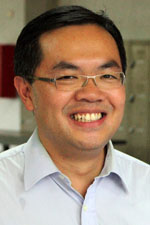 A/P Goh Q & A
A/P Goh Q & A
1. What are some of your fondest memories of Dr John Elliott, first as a teacher, and later as a colleague?
John encouraged critical thinking and we always had very illuminating discussions during his tutorials (see photo on page 28); of course, tutorials at that time only had between 5 and 7 students, so very difficult to hide! He was quite a tough marker though - never got an A from him for my term papers; but then again, As were given out very sparingly during that period (and there were no CAs at that time; the term paper grades were not counted). As a colleague, he was always willing to give advice to young hires, and his experience helped me immensely in the crafting of exam questions when I first started helming my own modules. I also remember he was very particular in signing or agreeing to legal documents - he once refused to upload materials into IVLE (the forerunner of LumiNUS) because he felt NUS did not provide enough protection for staff.
2. What motivated you to study psychology at NUS as an honours and then Masters student, and what prompted you to return to the department to teach and carry out research projects?
 I was in the pre-med programme in junior college, so the path seemed straightforward for me. But I started reading about psychology as a course in various government information booklets and thought this was more interesting than medicine - I also didn't do well at the A levels, so perhaps this was fate telling me to take another path. However, this meant you had to go overseas as there was no psychology programme offered locally and my parents could not afford an overseas education. So when I was accepted in FASS, I was set to major in the closest one at the time - Sociology. I didn't start right away as I had to serve National Service; and in my second year of NS, I found out that NUS had started a psychology programme (again, fate may have been looking out for me!). Fortunately, I did well enough in the aptitude test (required then) to be allowed to major in Psychology. Everyone was hoping to do Honours, and at the time, you had to be invited, so I was elated when the Department of Social Work and Psychology offered me Honours, no motivation required. As for the Masters, I worked as an RA after completing my Honours, so I wanted to see if a research and academic career appealed to me, and decided to do my Masters while I was a TA for the Department. After that, NUS funded my PhD overseas on a staff development scheme, so I was obligated to return to serve a bond. In a sense, NUS Psychology has been my home since I started as an undergrad student, for I never left!
I was in the pre-med programme in junior college, so the path seemed straightforward for me. But I started reading about psychology as a course in various government information booklets and thought this was more interesting than medicine - I also didn't do well at the A levels, so perhaps this was fate telling me to take another path. However, this meant you had to go overseas as there was no psychology programme offered locally and my parents could not afford an overseas education. So when I was accepted in FASS, I was set to major in the closest one at the time - Sociology. I didn't start right away as I had to serve National Service; and in my second year of NS, I found out that NUS had started a psychology programme (again, fate may have been looking out for me!). Fortunately, I did well enough in the aptitude test (required then) to be allowed to major in Psychology. Everyone was hoping to do Honours, and at the time, you had to be invited, so I was elated when the Department of Social Work and Psychology offered me Honours, no motivation required. As for the Masters, I worked as an RA after completing my Honours, so I wanted to see if a research and academic career appealed to me, and decided to do my Masters while I was a TA for the Department. After that, NUS funded my PhD overseas on a staff development scheme, so I was obligated to return to serve a bond. In a sense, NUS Psychology has been my home since I started as an undergrad student, for I never left!
3. What future plans are in the works for NUS Psychology and how do they connect to the need for scholars and practitioners of the discipline in Singapore and the region?

Top psychology departments in the world are very well resourced with research spaces, laboratories, and facilities; so we hope to move in that direction and provide all of our research-active staff dedicated lab spaces to do research that will benefit Singapore and the discipline in general. We will also need to see how many more students (we have always been one of the more in-demand majors since inception) will want to be Psychology majors with the advent of the College of Humanities and Sciences, and perhaps develop various teaching innovations to serve an even more expanded student body (the days of 5-7 pax tutorials, or a 10-student Honours cohort in my year, are long gone). But we have very good educators in the department, so I am not worried about that. Our Clinical Psychology Masters programme is also in very high demand, given the focus on mental health needs nowadays. So we will need to see how we can support training for manpower needs in the public and private sectors in terms of workshops for associate psychologists, in additional to training people to be professional clinical psychologists.
Thank you very much for your time and answers, Prof Vasoo and A/P Goh! Readers can learn more about the history of the NUS Department of Psychology here. Catch the book launch on Friday December 10th at 11 AM by registering via Zoom.
We are hiring!
The Department of Southeast Asian Studies at the National University of Singapore seeks to fill an Educator Track position. The appointment will commence in August 2022. We are particularly interested in candidates who bridge the fields of environmental anthropology, political ecology, and conservation science with reference to the Southeast Asian region. Demonstrated experience with community empowerment will be considered an added bonus. The successful candidate will be expected to teach undergraduate and graduate courses in these fields. In addition to teaching, the successful candidate will be expected to supervise undergraduate and graduate students. Depending on qualifications, the candidate may be hired at the rank of lecturer or senior lecturer. For more information and to apply, please visit our Careers page!
We're on Instagram!
We’re now on Instagram! We welcome you to follow us and we can’t wait to share more with you!
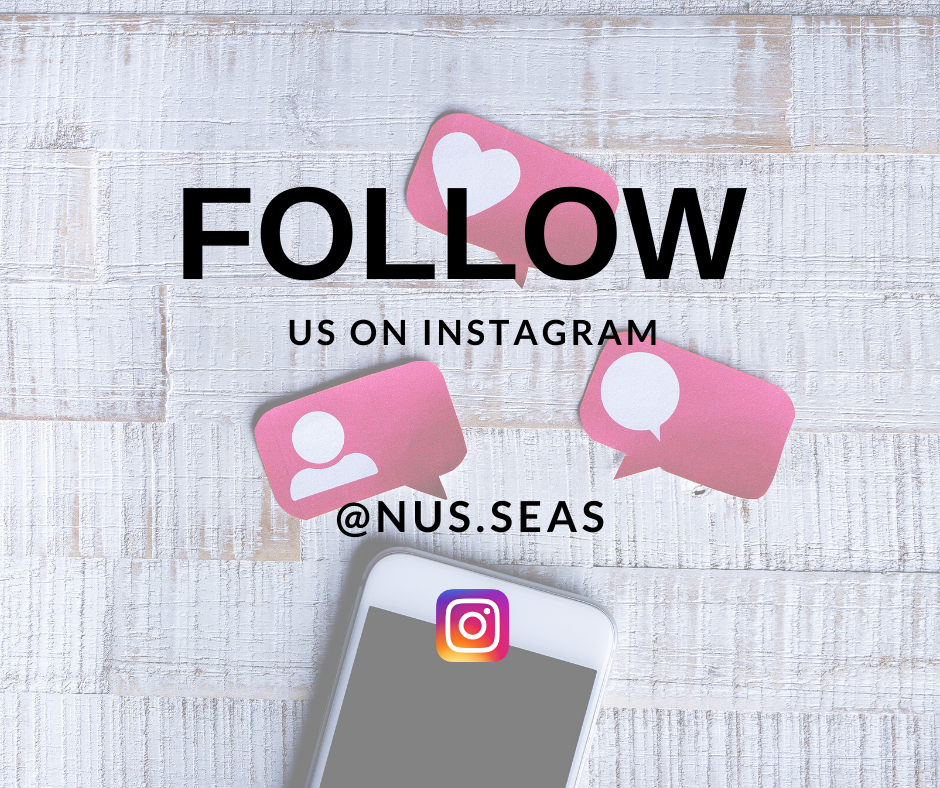
NUS Faculty of Arts and Social Sciences' 18th Dean Takes Office
IN BRIEF | 2 min read
-
Dean of the Faculty of Arts and Social Sciences, Professor Lionel Wee, and other members of the Deanery take on their leadership roles today.
Professor Lionel Wee has assumed the position of Dean of the NUS Faculty of Arts and Social Sciences (FASS) and Co-Dean of the College of Humanities and Sciences (CHS) as of today, Friday, 1 October 2021. Prof Wee takes over the helm from Professor Robbie Goh, who is now the Provost of the Singapore University of Social Sciences.
Before becoming FASS' 18th Dean, Prof Wee was the Faculty’s Vice Dean of Research (2014-2021) and is a Provost's Chair Professor of Linguistics with the Department of English Language and Literature, which he headed from 2010 to 2014.
“It is an honour to be given the opportunity to helm the Faculty of Arts and Social Sciences. The Faculty has achieved much since its founding nearly a century ago, continually evolving to anticipate and address the needs and challenges of a changing society," said Professor Wee.
"Together with the Deanery, colleagues, and students of the FASS, I am confident that we will continue to make breakthroughs in both education and research. While these benchmarks are important, diversity and inclusion are priorities for me, and essential pillars of every organisation. My plan is to further emphasise and ensure our staff and students feel empowered and safe in the Faculty in the coming years," he said.
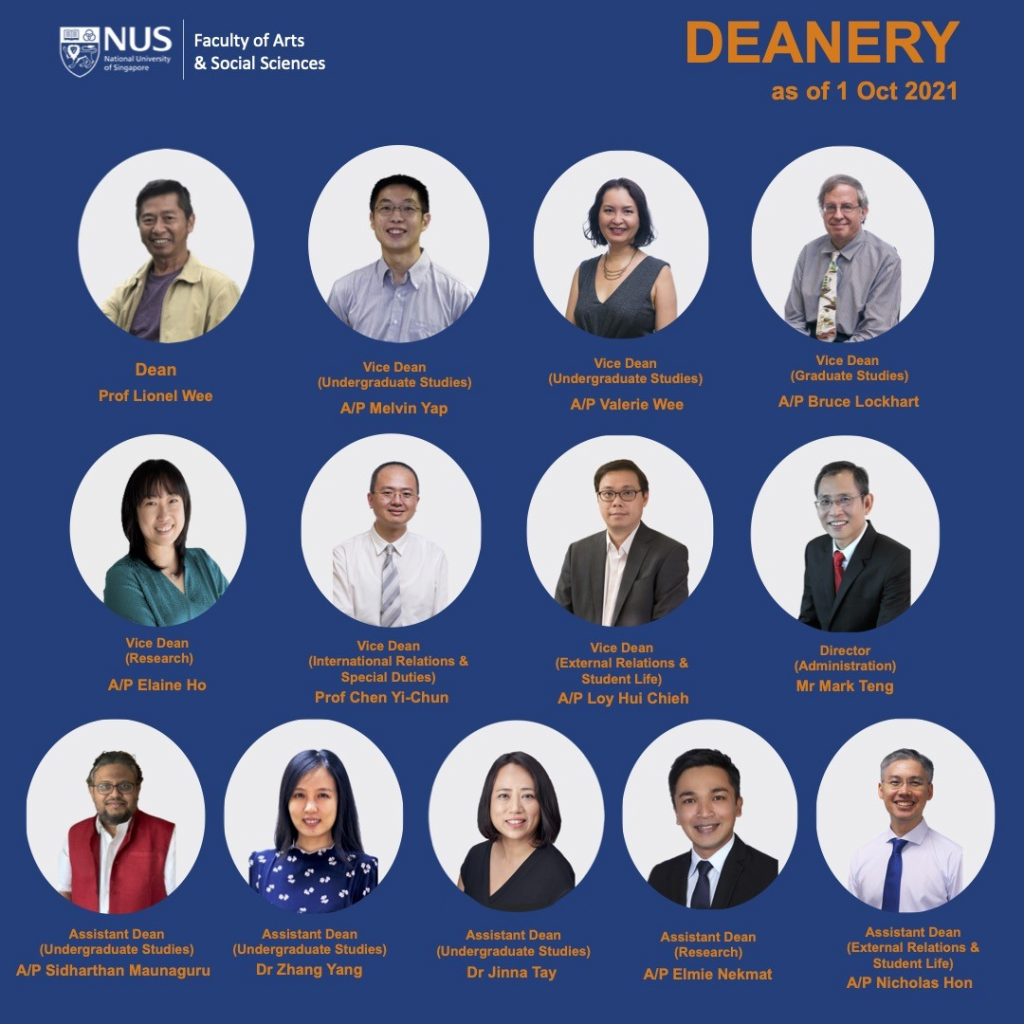
New Appointments to the Strong Leadership
Beginning their new roles with the FASS Deanery today are:
- Associate Professor Elaine Ho (Geography) as Vice Dean (Research). She was previously Assistant Dean (Research).
- Associate Professor Elmie Nekmat (Communications and New Media) as Assistant Dean (Research).
The following members of the Deanery will continue to serve in their respective positions:
- Associate Professor Melvin Yap, Vice Dean (Undergraduate Studies)
- Associate Professor Valerie Wee, Vice Dean (Undergraduate Studies)
- Associate Professor Bruce Lockhart, Vice Dean (Graduate Studies)
- Professor Chen Yi-Chun, Vice Dean (International Relations and Special Duties)
- Associate Professor Loy Hui Chieh, Vice Dean (External Relations and Student Life)
- Mr Mark Teng, Director of Administration
- Associate Professor Sidharthan Maunaguru, Assistant Dean (Undergraduate Studies)
- Dr Zhang Yang, Assistant Dean (Undergraduate Studies)
- Dr Jinna Tay, Assistant Dean (Undergraduate Studies) – recently appointed to the Deanery on 1 July 2021.
- Associate Professor Nicholas Hon, Assistant Dean (External Relations and Student Life)
The multiple historical identities of St. John's Island
(Article is in Mandarin, Translation by Google Translate) 5 September 2021, Lianhe Zaobao Original article: https://www.zaobao.com.sg/lifestyle/history-heritage/story20210905-1190485

The multiple historical identities of St. John's Island
St John's Island in the south of our country is a blue sky and green space temporarily far away from the island for many people. It actually has a rich history and played a special role in the history of Singapore's founding and development. Hearing that the former islanders recalled the old buildings and ruined tiles, countless historical pictures immediately leaped in front of them. The next time I land on the island, I will definitely have deeper emotions and thoughts about this land.
It is said that when Raffles landed in Singapore and passed through St. John’s Island, he took the name of the island with the name of his fellow missionary. St. John’s Island also has a Malay name "Sakijang Bendera", which means "red deer and flag". The Chinese name "棋樟山" is believed to be translated from "Sakijang".
St. John’s Island covers an area of about 40 hectares. There are several ferry boats departing from Binhai South Wharf every day. It takes 20 to 30 minutes to reach the destination, and the round-trip ferry ticket is about 15 yuan.
Quarantine station
At the beginning of the opening of the port in 1819, St. John’s Island served as a signal station for the outer islands. In 1874, the East India Company set up a quarantine station on the island. The ships carrying aliens (also known as "new passengers") are moored off the coast of Singapore. As soon as an infected person is found, all passengers are transferred to the island's quarantine station to smoke sulfur and sprinkle disinfectant in the disinfection area. Those who were later changed to take the lowest class must go to the island for inspection and disinfection.
At that time, infectious diseases were raging, including cholera, plague, smallpox, tuberculosis, black death and measles. The quarantine station has hospitals, pharmacies, morgues, laboratories and vaccine freezing equipment, and nearby Lazarus Island (Lazarus Island) has a graveyard. In the 1930s, St. John’s Island became one of the largest isolation centers in the world, with a capacity of more than 6,000 people.
Many of the older generations had stayed in Qizhangshan when they went to Nanyang, and they all recalled that they could not bear to look back (for a period of time, men and women must be examined naked). At that time, sanitary conditions were inadequate, water and food were lacking, and many people died before they could set foot on the main island of Singapore.
With the rise of the aviation industry in the 1970s, the number of people entering the country by boat dropped drastically, and the quarantine station that had been used for more than 100 years was successfully retired in 1976.
In an interview with Lianhe Zaobao, Assistant Professor Hamzah Muzaini of the Institute of Southeast Asian Studies of the National University of Singapore said that the island has become an isolation center very early, so the infrastructure is quite complete, with large water storage towers for supplying tap water, houses and asphalt roads.
Detention Center for Political Prisoners
In 1948, the British colonial government planned St. John’s Island as a detention center for political prisoners and private members. Lin Qingxiang, Tiffany, Uhhal, and Fang Shuishuang were detained by the British from 1953 to 1959. Lee Kuan Yew was their lawyer at the time and visited four people on the island. Tiffany became the third president of Singapore.
The former prison cells have now become pavilions. Former islander Abdul Rahim Abdul Wajis (64 years old) said that the four walls have been removed and only the four pillars and roof are original. He still remembered that political prisoners weren't kept in cells all the time, and the outdoor range within the fence was quite large and the scenery was pleasant. At that time, he and other children would sometimes walk into the detention center and would not be afraid of political prisoners.
Opium Healer
Before the end of World War II, there were more than 16,000 opiates in Singapore. In 1955, the British colonial government established an "opium healing clinic" on the island, focusing on smoking cessation and transformation, and allowing smokers to learn new skills such as carpentry, rattan and tailoring to prepare them for reintegration into society. The same site was renamed the Drug Rehabilitation Center in 1973 and closed in 1975. Some buildings are still preserved.
An opium smoker who had stayed there said in an earlier interview with the media that he and 40 other opium smokers were crowded in a barracks. At first he felt miserable, but later his physical strength and spirit gradually recovered and he began to do some work and engage in outdoor work.
Rahim’s hometown was near the pier. He recalled: “Sometimes smokers would come out to play football with the islanders. Every morning and afternoon, they would take turns to take the food scraps to another place and throw them away, sometimes passing by my house. We are very used to seeing immigrants and drug addicts, and we are not afraid."
Refugee shelter
St. John’s Island was used to settle Vietnamese refugees in the mid-1970s, and they lived on the island temporarily before being transferred to the official host country. When there were too many refugees in the 1980s and 1990s, the government took refuge in temporary refugee camps in Sembawang.
In 1998, the government announced the establishment of a detention center for illegal immigrants on the island. Because the number of overstayers and illegal immigrants arrested at that time increased, the island’s prisons could not accommodate them. The old football field near the ferry terminal was fenced off and toilets were built. However, according to the former islanders, it was not used afterwards, and buildings surrounded by green wire fences can still be seen.
Leisure and Marine Research Center
Since 1975, St. John’s Island has become a holiday paradise for Chinese people, and it is also a student holiday camp. In the past few decades, the government has deliberately developed it into a water park along with the nearby islands, and even invited investors to submit proposals, but there has been no follow-up since then.
The Land Management Authority of Singapore took over St. John’s Island from the Sentosa Development Agency in 2017. The resort on the island was upgraded and opened to the public for rent. It was temporarily closed during the epidemic.
In addition, the National Marine Research Center of St. John’s Island was established on the island in 2002, and the Maritime Aquaculture Center was established by the Agriculture and Food Bureau in 2003. Qizhang Bay, another rich ecology with mangroves, corals and seagrass, was originally planned to be opened to the public at the beginning of this year, but it was also temporarily suspended due to the epidemic.
The former islanders are full of memories
In the 1970s, islanders moved to the island one after another, and the rest were mostly islanders working for the government on the island. In 2017, the last four islanders also reluctantly left.
Muhamad Akim Giman (70 years old), who was born on the island, moved away in 1974. His house has been demolished. He took the reporter to visit another similar house and shared: "In the past, most houses built by the British army had separate kitchens and toilets. They were high-footed and allowed to ventilate underneath. The British army was right. We are very friendly, without class distinctions, like a big happy family."
As the son of the island, swimming seems to be natural. Even if the waves are big, he and his friends will jump directly into the water, and often catch fish and crabs for dinner in the nearby mangroves.
Rahim also moved out in the late 1970s, but his father was an electrician on the island, so he often went back, sometimes helping with light bulbs, and sometimes going to the beach to help repair ships. He still remembered several Chinese residents on the island. One of the largest grocery stores was run by a Chinese living on the island. The owner took a boat to the island every day to do business and returned to the island in the afternoon.
Mohamed Fawzi (50), who once lived on the nearby island of Lazarus, shared an interesting story. Although St. John’s Island is full of green areas, the islanders have tried many ways to raise cattle and sheep, but chickens and ducks are okay. When sheep are needed for religious activities, they can be bought from other islands.
St. John’s Island English Primary School is the only school on the island and closed in 1976. Retired teacher Du Shirong said in a media interview in 2015 that she taught at the school from 1962 to 1963. At that time, there were more than 400 people living on the island, and a grandma would often bring two baskets of vegetables and dry food to the teachers' residence to sell. The residents are kind and enthusiastic, and will give them freshly caught fish.
My community festival
The second "My Community Festival" hosted by the civil organization "My Community" was held from September 10th to October 3rd. The public who successfully signed up led by former islanders landed on St. John’s Island and talked about the past in detail. In addition to St. John’s Island, island tours also cover Turtle Island, Ubin Island and Pulau Hantu.
Other theme activities include watching the sunrise, understanding religion, understanding desserts, contacting craftsmen, feeling the rhythm, watching the sunset, understanding the life of the industry, night activities and community 24 hours.
Event fees range from RMB 10 to RMB 50, and some online guided activities are free. For more details, please refer to: mycommunityfestival.sg .
New NUS Dean of Arts and Social Sciences Appointed
IN BRIEF | 5 min read
-
Professor Lionel Wee will be appointed the new dean of the NUS Faculty of Arts and Social Sciences (FASS) and co-dean of the College of Humanities and Sciences from 1 October 2021.
-
Prof Goh, who has served as the Dean since 2017, will be taking a leave of absence from the University, but will continue to contribute in the Singapore education sector as the new Provost at the Singapore University of Social Sciences from 1 October 2021.
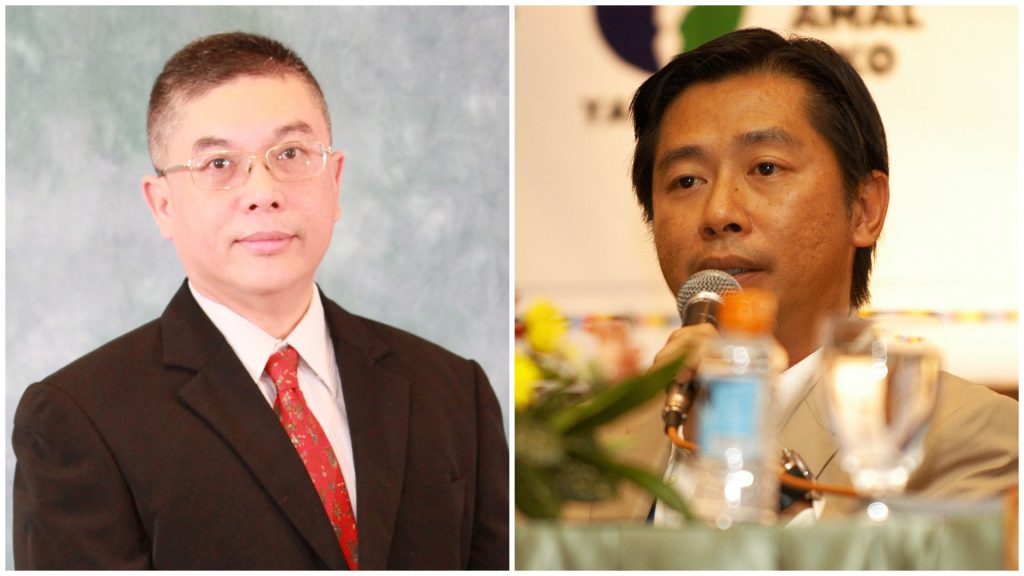
The University today announced the appointment of Professor Lionel Wee as the new Dean of its Faculty of Arts and Social Sciences (FASS) and Co-Dean of the College of Humanities and Sciences. Prof Wee will take over the helm from Prof Robbie Goh as the Faculty’s 18th Dean from 1 October 2021.
Currently FASS Vice Dean of Research and Professor of Linguistics in the Department of English Language and Literature, Prof Wee was appointed Provost’s Chair Professor in July 2017 for his outstanding scholarly achievements.
After graduating from NUS in 1988 with a Bachelor of Arts (First Class Honours) degree majoring in English Language and Sociology, Prof Wee embarked on an academic career, joining the University as a Teaching Assistant with the Department of English Language and Literature. He was awarded the NUS Overseas Graduate Scholarship where he pursued his PhD in Linguistics at the University of California, Berkeley. Prof Wee was appointed as a Lecturer upon his return to Singapore in 1995, and rose the ranks to full Professorship in 2012.
“NUS is pleased that after a rigorous global search, Prof Lionel Wee has been selected to be the next Dean. He is passionate about high quality education and research, and has an excellent understanding of FASS and the University, having served in numerous leadership roles at the department, faculty and university-levels. I am confident that he will bring the Faculty to new heights of international excellence,” said NUS President Professor Tan Eng Chye.
Besides serving as Vice Dean of Research at FASS from 2014 to present, Prof Wee was also the Head of the Department of English Language and Literature from 2010 to 2014. He had also contributed on various committees such as Chair of the FASS Faculty Promotion & Tenure Committee II, Chair of the University Mid-Term Advisory Report Committee, and Member of the University Promotion and Tenure Committee. In recognition of his dedicated service and contributions to NUS and education in Singapore, Prof Wee was awarded the National Day Awards Public Administration Medal (Bronze) in 2020 and the Long Service Medal in 2018.
“I am excited and honoured to be given this opportunity to lead my alma mater as its next Dean. Having spent more than three decades at FASS, both as a student and a faculty member, I have experienced firsthand the selfless commitment of my colleagues and impressive insights our students bring to the study of the arts, humanities and social sciences. I am confident that together, we can continue to make significant contributions to society while enhancing our Faculty’s standing as one of the leading humanities and social sciences faculties in the world,” said Prof Wee.
Besides his passion in linguistics, Prof Wee feels very strongly about animal welfare and is also very much an avid city traveller, although the pandemic has put quite a damper on travel in the past year or so. He also enjoys the cafes, a habit which he picked up during his time as a graduate student in Berkeley. Students and colleagues at FASS may have many a times seen Prof Wee deep in thought at the cafes across the NUS campus. He is very much focused in developing a particular idea or argument once he is seated down and would need to walk around before he can move on to another new idea.
Prof Wee has published widely in international and local journals, and also sits on the editorial boards of a number of academic journals and publications, including Applied Linguistics, English World-Wide, Multilingual Margins, The Journal of Asian Linguistic Anthropology, the “Cambridge Elements: World Englishes” book series, and the “Multilingualisms and Diversities in Education” book series. He is a well-respected scholar with research interests in the areas of language policy (especially in Southeast Asia), the grammar of Singapore English, metaphorical discourse, and general issues in sociolinguistics and pragmatics.
Prof Goh, who has served as the Dean since 2017, will be taking a leave of absence from the University. However, he will continue to contribute in the Singapore education sector as the new Provost at the Singapore University of Social Sciences from 1 October 2021.
Prof Goh said, “It has been a privilege and honour to serve as Dean of one of Singapore’s largest and most historied Faculties. I am grateful to my talented colleagues for all their hard work. I believe that together, we have brought the Faculty to new heights of excellence in teaching, research and service. I look forward to the work of creating new programmes and nurturing talent in my next role as Provost of the Singapore University of Social Sciences, and hope that I will also be able to forge new ties and collaborations between the two universities."
Having spent more than three decades at the University, Prof Goh has taken on numerous administrative and leadership roles outside of the Faculty. He was Deputy Director of the NUS Centre For the Arts from 1996 to 1999, and Deputy Director of the Asia Research Institute from 2008 to 2010.
“On behalf of the University, I would like to express my heartfelt appreciation to Professor Robbie Goh for his dedication and strong stewardship in leading NUS FASS. Under his visionary leadership, the Faculty has made significant contributions to the advancement of education and research in the humanities and social sciences. During his leadership, the FASS 2.0 Industry Tracks programme was started to enhance the employability of its graduates. New multidisciplinary initiatives such as the Philosophy, Politics & Economics programme were also established. The Faculty has also expanded collaborations with industry and further strengthened its high international reputation,” added Prof Tan.
This story first appeared on NUSnews on 13 August 2021. The full press release is here, and Professor Lionel Wee's biography is here.
FASS Community Recognised at the 2021 National Day Awards Ceremony
IN BRIEF | 2 min read
-
Eleven members of the FASS community have received awards, including the Public Administration Bronze, Commendation and Long Service Medals from the Prime Minister's Office.
-
Mr Mark Teng (Director Administration, Dean's Office) was conferred the Public Administration Bronze Medal and Dr Azhar Ibrahim (Malay Studies) received the Commendation Medal.
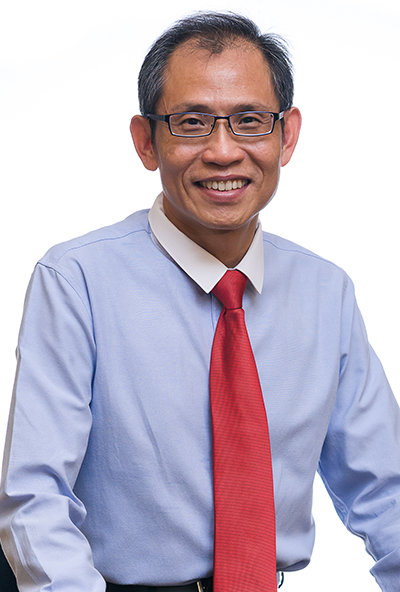
 Commendation Medal
Commendation Medal
Dr Azhar Ibrahim, Lecturer with the Department of Malay Studies, received the Commendation Medal. Dr Ibrahim earned his BA (Hons) in Southeast Asian Studies in 1997, and BA (Merit), MA and PhD from the Department of Malay Studies in 1997, 2001 and 2008. Just before returning to teach at his alma mater in 2009, Dr Ibrahim was Lecturer at the Asian Languages and Cultures (Malay Division) of the National Institute of Education, Nanyang Technological University for seven years. The author of numerous books, articles and papers in academic journals as well as mainstream media, Dr Ibrahim is also a notable speaker and active convenor and participant of academic conferences, FASS and community events. He teaches and supervises both undergraduate and postgraduate studies at the Department of Malay Studies, and his main research interests are in the areas of: religion and society, deviance and social control, and sensory studies. Long Service Medal
FASS awardees of the Long Service Medal include:
- Associate Professor Daniel Goh Pei Siong, Department of Sociology and NUS Associate Provost (Undergraduate Education)
- Associate Professor Su Jui-Lung, Department of Chinese Studies
- Associate Professor Wong Sin Kiong, Department of Chinese Studies
- Associate Professor Wong Wei Kang, Department of Economics
- Professor Henry Yeung Wai Chung, Department of Geography
- Mdm Angeline Ang Poh Kim, Associate Director, Department of English Language & Literature
- Ms Chee Lee Kuen, Management Assistant Officer, Department of Economics
- Mdm Amelia Yuen Fong Pheng, Management Assistant Officer, Dean's Office
- Mdm Salinah Binte Zuber, Management Assistant Officer, Department of Economics
The full list of NUS Recipients of National Day Awards 2021 is available here.
From Careers for a Lifetime, to a Lifetime of Careers
IN BRIEF | 5 min read
-
The top skills desired by employers will include critical thinking, analysis, problem-solving and self-management skills such as active learning, resilience, stress tolerance and flexibility.
What does the future of work look like? In this evolving world, new occupations and roles which did not previously exist continue to emerge, while certain traditional skills and jobs continue to become obsolete.
The World Economic Forum’s (WEF) The Future of Jobs Report 2020 (October 2020) highlighted a few key trends.
First, technological adoption of cloud computing, Big Data and e-commerce in many businesses will accelerate the transformation of jobs, skills and entire industry value chains. 85 million jobs are expected to be displaced by a shift in division of labour from humans to machines by 2025, while 97 million new roles may emerge.
Second, online learning and training boomed during the pandemic. The shift was a watershed moment, and there is no turning back for many industries. The pandemic also brought into sharper focus the importance of lifelong learning, with more employees upskilling and reskilling to stay relevant in the volatile job market. More workers are now pursuing personal and professional development, especially in digital skills.
Last but not least, the top skills desired by employers will include critical thinking, analysis, problem-solving and self-management skills such as active learning, resilience, stress tolerance and flexibility.

What skills do employers seek?
Many of these in-demand skills highlighted in WEF’s report corroborate CFG’s Industry Insights Survey (2020). Drawing on insights from career events, industry surveys and engagements, CFG’s survey cited a similar list of soft skills that are becoming increasingly imperative at the workplace.
These are abilities learnt through life experiences that are impervious to change, and relevant across all professions and workplaces. They are attributes we take with us when we embark on job pathways in the New Normal - which are shifting from one defined career over a lifetime, to a series of dynamic and rapidly changing careers.
Our survey clusters these abilities into two main categories: Personal Qualities and Workplace Traits.
Personal qualities
Many employers are looking for individual cognitive abilities such as problem-solving, learning agility and pattern-recognition. They are also seeking graduates who are equipped with design and computational thinking, as well as proficiency in quantitative analysis.
They want graduates who are able to look at problems from different perspectives, to solve complex problems in real-world environments. For example, can a customer service issue be resolved with a combination of user interface design changes, IT infrastructure automation and manpower staffing? What are consumer consumption patterns and behaviours telling us?
Employers also seek character traits such as curiosity, resilience, empathy, proactivity, leadership and adaptability. These traits are predictors of future potential, and potentially determine career longevity and progression. For example, are you curious to learn what other teams or functions are doing beyond your job scope and discover potential synergies? Are you adaptable to changes in your project scope, and possess a “can-do” attitude in the face of obstacles?
Workplace traits
Besides personal qualities, employers are also looking for graduates who possess certain desirable workplace traits. These include good communication and presentation skills, cultural sensitivity and a global mindset. Graduates with business acumen, who are able to influence and negotiate, and are competent in managing different teams and projects, are much sought after.
These attributes mirror the realities of the modern workplace, where teams and projects are becoming more diverse, cross-functional, cross-cultural and business-driven. For example, can you work with a diverse team of colleagues towards achieving a common objective? Can you visualise your organisation’s business potential in an overseas market or a new customer segment?
The call to CHS students
In CHS, you will acquire interdisciplinary knowledge and skills by learning how to draw connections, links and insights across diverse disciplines. It is this important foundation of interdisciplinarity that will better prepare our students to become problem-solvers in an uncertain world beyond the pandemic.
Even as the pandemic has accelerated digital transformation, data is now the new asset that enables businesses to enhance efficiency and augment the ability of their teams to deliver greater value. CHS will focus on competencies like data literacy and design thinking, skills that are now in high demand by industries seeking to unlock value from Big Data.
Beyond academics, internships are one of the best ways to hone workplace experience. When you are on vacation, aim for at least two (if not more) internships, preferably one with an overseas employer. Immerse yourself in co-curricular activities, which provide hands-on opportunities to gain skills such as leadership, teamwork and project management. These experiences in your resume and portfolio will place you in a better stead with employers.

Enhancing employability, preparing for careers
CHS students will have a dedicated Career Advisor, who will guide you through the process of developing a personal career plan. You will be pre-assigned a career preparation module, Career Compass, closely following CFG’s four-year Career Readiness Roadmap which provides a formal framework for your career planning during your undergraduate journey.
You will be enrolled in Career Catalyst, a foundational freshmen module that identifies your core strengths and enhances your profile towards securing an internship. As you progress to Years Two/Three and your final year, you can also sign up for our Career Booster workshops or Career Advancement Webinar Series (CAWS).
Article contributed by the Centre for Future-ready Graduates (Ms Joan Tay, Director and Career Advisors Mr Ryan Ang and Mr Ng Buck Seng)
This story first appeared on CHS on 29 July 2021.
NUS CHS Case Competition: Driving EV Adoption in Singapore
IN BRIEF | 1 min read
- The just-released problem statement for NUS CHS' inaugural Case Competition – Encouraging electric vehicle (EV) ownership in Singapore – is an important real-world topic of especial relevance to us all, as the nation is driving toward a future of electric mobility that is essential to the Singapore Green Plan 2030.

Are you interested in translating your innovations to reality by applying interdisciplinary knowledge and skills?This is now possible with the inaugural College of Humanities and Sciences (CHS) Case Competition, launched on 26 July.
The competition is specially designed for NUS students, and enables participants to synthesise ideas and perspectives from different disciplines to solve complex, real-world challenges.
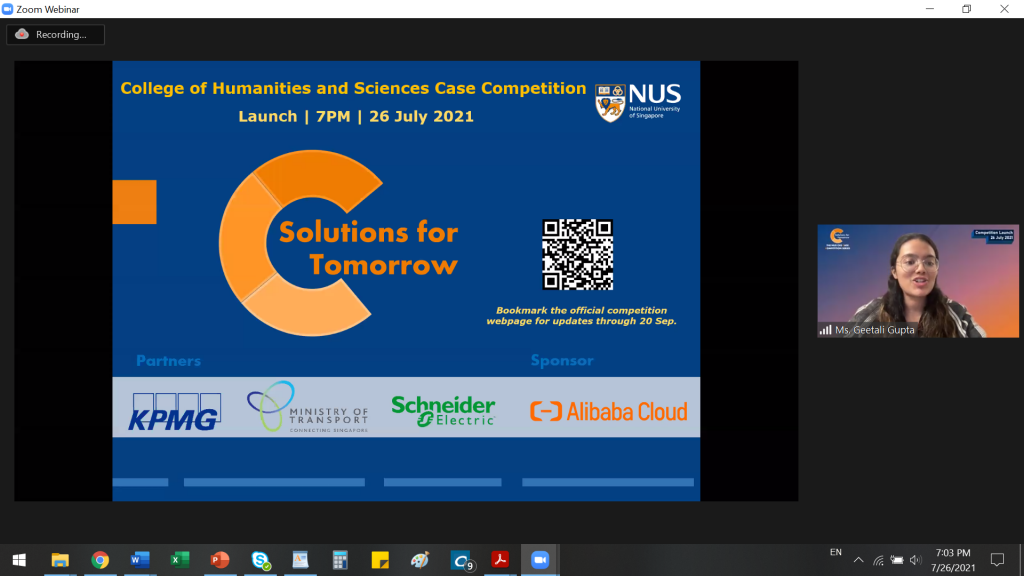
The competition themes, “Sustainability” and “Technology and Us”, are highly topical today. The problem statement - Encouraging electric vehicle (EV) ownership in Singapore - is an important real-world topic, even as Singapore ushers in a future of electric mobility as a key piece of the puzzle in the Singapore Green Plan 2030.
At the virtual launch, our competition partners - the Ministry of Transport, KPMG and Schneider Electric - discussed plans by the Singapore government to usher in the future of EV, Schneider Electric’s vision of a 100% electric mobility future with net-zero carbon emissions and upcoming trends in mobility solutions identified by the advisory arm of KPMG.
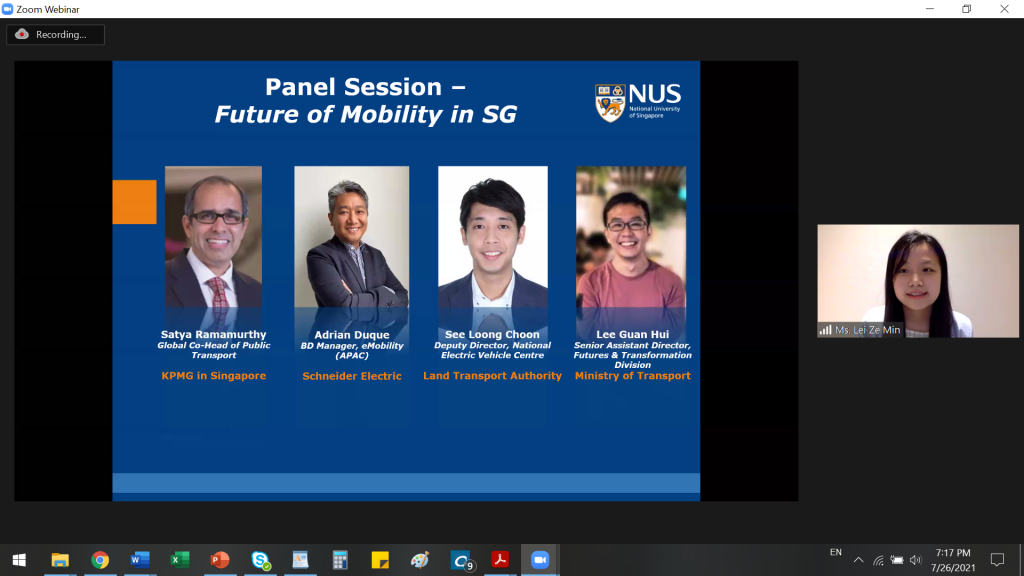
Participants will have the opportunity to attend mid-term workshops in mid-August, which provide important domain knowledge, including engineering and design, and communications skills.
The project submissions will be judged in the final round of the competition on 20 September by representatives from our competition partners. They will also be sharing their EV domain expertise with the participating teams throughout the competition.
The launch was attended by more than 100 participating teams (close to 200 individual attendees) from across NUS.
Find out more about the competition here and read the problem statement here.
Strong Interest in Interdisciplinary Learning With High Acceptance Rates
IN BRIEF | 5 min read
-
NUS President Professor Tan Eng Chye discusses the University’s recent interdisciplinary initiatives – the setting up of the College of Humanities and Sciences (CHS) and the new Common Curriculum for the Faculty of Engineering and the School of Design and Environment – and the importance of lifelong learning in ensuring that students are adaptable and future-ready.
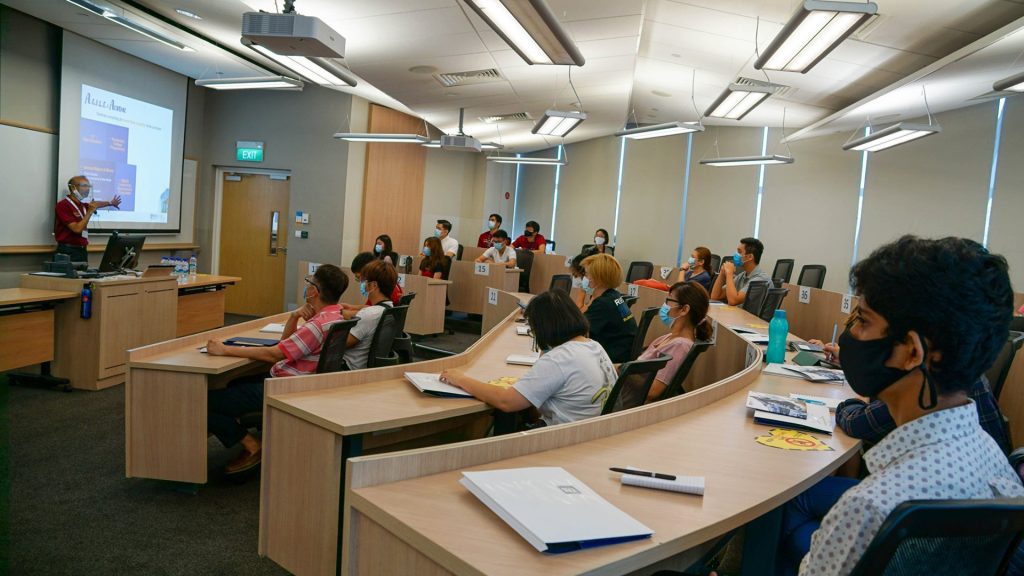
In today’s volatile, uncertain, complex and ambiguous (VUCA) world, staying stagnant is never an option. Now, more than ever, universities have to prepare students to thrive in a fast-changing and unpredictable post-COVID reality through an interdisciplinary education.
Just ask the incoming batch of freshmen, who have given a thumbs-up to the University’s recent interdisciplinary initiatives – specifically, the setting up of the College of Humanities and Sciences (CHS), and the new Common Curriculum for the Faculty of Engineering and the School of Design and Environment.
During the admissions exercise this year, 71 per cent of those who had applied to these programmes as the first choice accepted the offer. Among the incoming batch of freshmen, over 4,000 will be exposed to an interdisciplinary education. By August 2022, NUS hopes to push this number to more than 6,000.
“We are quite heartened that the applicants have responded very well,” said NUS President Professor Tan Eng Chye, as he spoke on the new changes in NUS’ curriculum. “They are receptive to the flexibility that they will have. No more are you confined to one discipline.”
Prof Tan noted that the world faces many wicked problems that cannot be solved with only one discipline.
He cited COVID-19 as a wicked problem, requiring more than just medical sciences to solve. “Even with the right medical knowledge, many countries had difficulties handling COVID-19 and its spread,” he noted.
The pandemic, in fact, prompted NUS to ramp up efforts in remodelling its educational philosophy and pedagogies to prepare its graduates for this dynamic reality.
At the centre of these reforms is the push for lifelong learning, as well as the shift towards interdisciplinary education to ensure students are adaptable and future-ready.
A lifetime of learning
While universities used to prepare their graduates for a single job, this approach is fast becoming obsolete. Today, graduates will change jobs at least 10 times over the course of their lifetime.
In line with this trend, NUS has been future-proofing its education to prepare students for lifelong learning.
“A student’s enrolment is valid for 20 years from the point they enter the university,” Prof Tan explained. “We want to remove the conception that university is only for four years. You can always come back to (NUS) to learn new skills and knowledge.”
For instance, the NUS Lifelong Learners (L3) programme upskills alumni through a wide array of skill-based, industry-relevant courses, carefully tailored to focus on emerging skills identified under SkillsFuture such as data analytics or digital literacy.
The process of returning to NUS for further studies is also made seamless. If a student does not complete a second major or degree in their initial four years, they are welcome to return to the university to read the necessary remaining modules even after graduation.

Towards interdisciplinary learning
Recognising the benefits of interdisciplinary learning, NUS is rolling this out to more students.
This started with the launch of CHS, which brings together the Faculty of Arts and Social Sciences and the Faculty of Science.
In the upcoming semester, CHS will admit 2,200 students and they will take a new Common Curriculum within their first three semesters – consisting of integrated modules with a problem-based pedagogy.
Similarly, a Common Curriculum has been introduced for the Faculty of Engineering and the School of Design and Environment to encourage knowledge transfer between the two complementary disciplines.
For instance, NUS’ very own net-zero energy building at SDE4 is a product of melding both architecture and engineering – the first of its kind in Singapore.
“The building’s beautiful architectural design alone doesn’t contribute to it being net-zero energy. What you have is a lot of deep engineering work embedded into it. It shows that architects have to work very closely with engineers in order to achieve this,” explained Prof Tan.
With interdisciplinary learning, the proportion of Unrestricted Elective modules a student can take has also been increased to up to 30 per cent, encouraging students to have two or more specialisations.
In the four faculties that now have an interdisciplinary common curriculum, this works out to more than 700 possible double major pairings, 1,700 major-minor pairings, and 100,000 major with double minor combinations.
Expanding choices for students
Ultimately, these educational innovations create greater flexibility for students to curate their own curriculum.
They will no longer have to make an immediate commitment to a single discipline. Instead, they are given time to decide on their academic calling through the common curriculum.
These efforts are central to NUS’ flagship role as a creator, integrator and propagator of knowledge.
Looking ahead, the structural barriers between faculties will further dissolve, allowing students to build even broader connections between disciplines.
“Right now, we have 70 majors and 80 minors, but we may actually have more as we go along. We start with a minor. If there’s enough interest, we push it to a second or full major. The possibilities are endless especially as we move online,” said Prof Tan.
This story first appeared on NUSnews on 26 July 2021.
Creating New Internship Opportunities: Engaging Employers to See Value in Humanities and Social Sciences
IN BRIEF | 4 min read
-
Mr Jonathan Sim, instructor from the Department of Philosophy, describes how he engaged with local employers to open internship opportunities to humanities and social sciences students who would not previously have been considered.

Humanities and social science majors are frequently misunderstood, in Singapore as in many other parts of the world. The value of their education is regularly questioned, and many employers are unaware of the value such majors can bring to the table. They prefer to hire graduates with more explicitly “practical” degrees for jobs that humanities and social sciences students could excel in.
As a result, humanities and social sciences students are not typically considered for many organisations and roles, despite offering relevant and useful skills.
So when developing an internship module, I began reaching out to organisations to create internship opportunities in such roles, to boost receptivity to hiring students from these disciplines. This enabled potential employers to better understand how students in subjects they might have previously overlooked can fill gaps in their talent pool.
Compounding the issue is that many humanities and social sciences students are unaware of the diversity of careers available to them and tend to limit themselves to roles stereotypical of their majors. There is a good reason for this. When these students apply for non-stereotypical roles, they are often turned down due to having an “impractical” major.
I regularly hear employers and people in the corporate sector lamenting the lack of creativity and critical-thinking and communication skills in their industries. These key capabilities are needed to challenge assumptions, innovate and improve processes within organisations. Employers’ lack of awareness of the value of humanities and social sciences is preventing them considering this potential talent pool.
Starting an internship module
I teach a module on data analysis and philosophical reasoning to hundreds of students each semester. With so many students under my charge, I was inspired by the idea that education is more than just about imparting knowledge. Rather, it is about facilitating growth in one’s students by providing them with opportunities for challenge and development.
As a result, I decided it would be worthwhile to experiment with an internship module where I approach employers, explain the value my students can bring to their organisation and ask them to offer temporary roles not typically filled by humanities and social sciences majors. A model designed to be mutually beneficial to both employers and students.
Here are my key lessons in how to do this:
Start by approaching contacts working in human resources (HR) and ask them to link you up with senior management or with department heads of your target companies. I initially spoke to friends in HR and some of them linked me up with HR professionals from other organisations.
Provide reassurance that you will be guiding and mentoring the students throughout the programme. My credentials as a university educator meant employers were generally open to exploring this strategic partnership.
Prepare and present a pitch clearly describing what value and skills your students can bring to the companies where you wish to secure internships. I explained how my students were excellent in data analytics, coding and problem-solving, and their training in humanities and social sciences meant they could bring unique perspectives thanks to creativity and critical thinking. Having worked with the students for one semester already, I could also vouch for their character, including attributes such as work attitude, independence and willingness to learn.
Discuss the job scope and be honest and realistic about what your students can and cannot do. I helped advise the hiring managers on my students’ capabilities, based on what I had taught them, and sometimes this meant suggesting new items in the job scope that the organisation may not have considered.
Invite students to apply for the roles available by submitting their CVs, then interview shortlisted candidates. I found interviews useful to get a better understanding of what students wanted to do and what they hoped to achieve during the internship. The application process also provided an opportunity to work with students to improve their CVs and interview skills before they spoke to employers.
Try to match students with internship roles that will best suit their personality, skills and career aspirations.
During the internships, check in on students regularly and ask them to share any challenges, so you can help them troubleshoot any issues. My role was more like an adviser pointing them to resources or giving life advice on how to handle novel social or professional situations.
Ask the students to write reflections centred on how their training in humanities and social sciences can be applied to the work they do as an intern. This helped me gauge the extent of their learning but also nudged students towards deeper reflection on their discipline to see its value and relevance in the work they did. It was very eye-opening to see concrete examples of how students found connections and applications between their studies and their work.
Benefits to organisations and students
These collaborations have proven mutually beneficial. They allow participating organisations to develop strategic partnerships with the university, helping employer branding and making it easier for them to attract talent.
At the same time, the student interns become living proof to employers that their major makes them as good as, if not better than, some students from more “practical” disciplines. The internships help inform humanities and social sciences students that they can take on roles they never thought were open to them.
We have completed one round of internships with organisations such as Henkel, a German multinational chemical and consumer goods company, and Azendian, a local AI data analytics start-up.
Students were pleased with the chance to take up roles they would not have ordinarily pursued, or been given a chance to try, in areas such as supply chain and logistics management, database management and data analytics for marketing. The internships provided profound insights on how they can apply the skills from their majors in ways that allow them to craft a niche in such roles.
The first round of placements seems to have persuaded employers to be more receptive when it comes to hiring humanities and social sciences students, as they have asked for more interns in subsequent iterations.
This is just the beginning, and there is a lot more that we can achieve in our capacity as university faculty by engaging with local organisations and employers. We can work to create more internship opportunities and help employers better understand the capabilities of our students across multiple disciplines here in Singapore and further afield.
This story first appeared on Times Higher Education on 21 June 2021.
Commencement 2021: Special Message of Congratulations to the Classes of 2020 and 2021!
IN BRIEF | 3 min watch
-
FASS Faculty and students congratulate the Classes of 2020 and 2021 and wish them all the best as they go out to change the world for the better!
“We believe in you. I believe in you. Go out there, do us proud. Make the world a better place.” — Associate Professor Loy Hui Chieh, FASS Vice Dean of External Relations and Student Life FASS, joint committee member of the NUS Philosophy, Politics, and Economics (PPE) programme, and also Faculty member of staff at the NUS Department of Philosophy.
Faculty and students talk about what life has been for them this past year, what they miss about campus life, and extend words of advice and congratulations to the graduating Classes of 2020 and 2021.
This video features Assoc Prof Loy and Dr Lohsnah Jeevanandam, Senior Lecturer, NUS Department of Psychology, as well as students from the graduating Classes of 2020 and 2021: Alvarez Brielle Clavel ('20); Somesh s/o Sailesh ('20); Douglas Ong ('20), Christina Chen (Doctoral Class of '20); Ng Qian Qian ('21); and, Lai Wei Na ('21).
Meet the Neighbours: The Seven Animals You’ll Spot in NUS
IN BRIEF | 5 min read
-
NUS is not only a second home for staff and students, but also a place for a wide range of biodiversity to call home. Mr Athanasius Koh, a management trainee with the NUS Faculty of Arts and Social Sciences (FASS) and FASS Political Science alumnus ('21) tells us about the interesting animals he has spotted around campus.
Beyond the lecture theatres, classrooms and student hangout spots, it is hard to miss the lush greenery that surrounds NUS. This has made the campus environs not only a second home for staff and students, but also a place for a wide range of biodiversity to call home.
These habitats are here to stay too. Emphasising NUS’ commitment to preserving its rich biodiversity, fighting climate change and being an environmentally responsible campus, the “Planting 10,000 Trees” initiative launched by NUS President Professor Tan Eng Chye in 2018 saw 500 mature trees planted throughout the campus, as well as 9,500 saplings nurtured in the NUS nursery. In addition, a strict policy to protect existing trees was also implemented.
Mr Athanasius Koh, a management trainee with the NUS Faculty of Arts and Social Sciences (FASS) Corporate Communications team for the past six months, and avid nature photographer, takes regular photo walks exploring these habitats. Mr Koh, who is also from the FASS Class of 2021, shares about the interesting animals he has spotted along the way.
Collared Kingfisher (Todiramphus chloris)
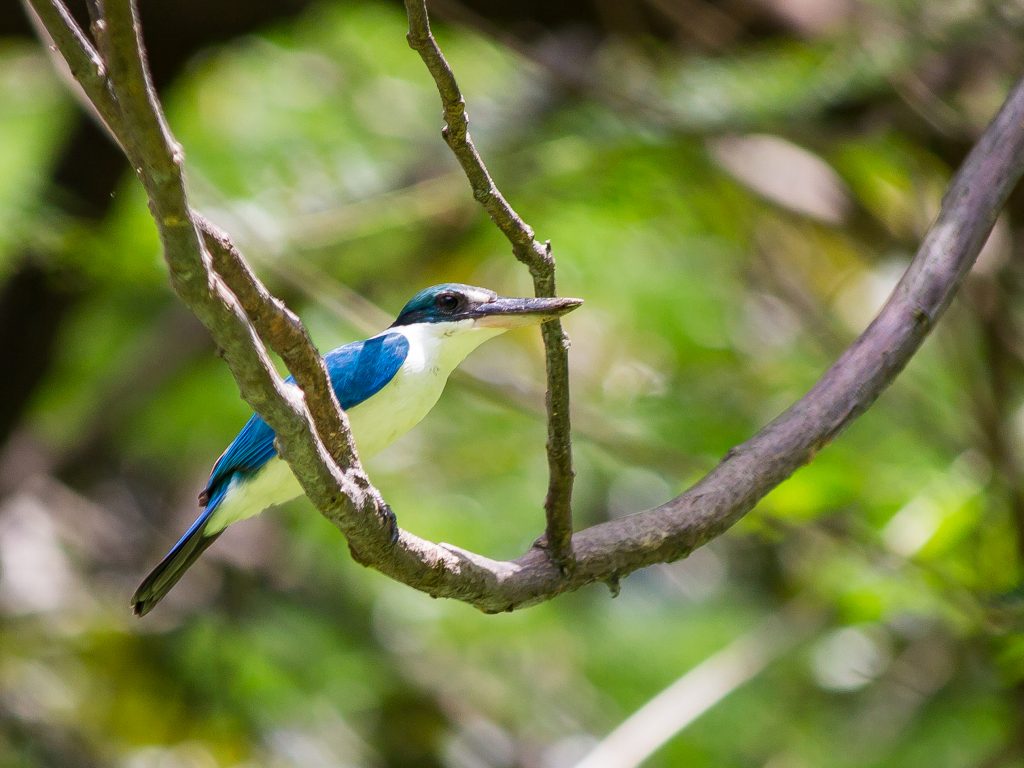 A collared kingfisher perched on a tree at AS8. (Photo: Mr Athanasius Koh)
A collared kingfisher perched on a tree at AS8. (Photo: Mr Athanasius Koh)
Dressed in beautiful blue feathers and a broad white “collar” around its neck, the collared kingfisher is a vocal bird spotted about campus with its series of harsh “kee-kee” notes, described by some as a maniacal laugh.
The collared kingfisher has also been quite the icon in Singapore’s history, gracing not only stamps but even the now decommissioned $10 note as part of The Bird Series Currency Notes from 1976 to 1984.
Look out for the collared kingfisher’s outstanding blue plumage as it rests atop trees and lamp posts. This sharply dressed celebrity is an easy spot around FASS and NUS Faculty of Engineering.
Red Junglefowl (Gallus gallus)
 Male red junglefowls proudly flaunt their dark green tail feathers and black primary feathers. (Photo: Mr Athanasius Koh)
Male red junglefowls proudly flaunt their dark green tail feathers and black primary feathers. (Photo: Mr Athanasius Koh)
Even if you have never personally caught sight of the resident FASS red junglefowl, you are more than likely to have heard its signature “cock-a-doodle-doo” around the faculty. Often confused for the domestic chicken, the red junglefowl is in fact its wild ancestor.
According to a study led by NUS ornithologist Associate Professor Frank Rheindt, the red junglefowl can be quite easily distinguished from the domestic chicken. Male red junglefowls proudly flaunt their dark green tail feathers and black primary feathers while females have distinguishing grey legs and sport black primary feathers.
While it remains a mystery why it crosses the road, the red junglefowl and its loud presence has certainly captured the attention of students and staff alike.
Plantain Squirrel (Callosciurus notatus)
 A plantain squirrel resting on a tree behind AS4. (Photo: Mr Athanasius Koh)
A plantain squirrel resting on a tree behind AS4. (Photo: Mr Athanasius Koh)
Scurrying and leaping from tree to tree, the plantain squirrel is an adorable sight if you are lucky to observe one at rest or enjoying its meal. This active animal is one of the most common mammals in Singapore and can be identified by distinctive black and white stripes on the sides of its body and its long bushy tail.
These physical features might have you thinking what a beautiful squirrel it is, and you are not alone! In fact, Callosciurus, the plantain squirrel’s taxonomic group, translates to “beautiful squirrel”.
Blink and you just might miss this nimble creature, but the plantain squirrel can be commonly found on the trees around NUS such as at the NUS Faculty of Science. Listen out for the rustling of leaves and you just might come face-to-face with this lovable rodent.
Rose-Ringed Parakeet (Psittacula krameri)
 A rose-ringed parakeet perches on a branch after breakfast along the AS6-AS8 walkway. (Photo: Mr Athanasius Koh)
A rose-ringed parakeet perches on a branch after breakfast along the AS6-AS8 walkway. (Photo: Mr Athanasius Koh)
Often moving in flocks and squawking in unison, the rose-ringed parakeet is a loud presence in NUS. Sporting a bright green plumage, orange beak and blue-tipped tail, males also have an added pink collar around their neck in their third year.
The rose-ringed parakeet was introduced to our green spaces as escaped pets. Native to the Indian subcontinent and northern Southeast Asia, it is a resilient bird that has thrived even in locations as far as Europe!
A bird that you might hear before you see, the rose-ringed parakeet has been spotted on sunny mornings at FASS’ Lovers’ Park and along the walkway between Blocks AS6 and AS8 grabbing its breakfast.
Yellow-vented Bulbul (Pycnonotus goiavier)
 The Yellow-vented Bulbul is easily distinguishable from its black eye-mask, olive-brown back and yellow undertail (Photo: Mr Athanasius Koh)
The Yellow-vented Bulbul is easily distinguishable from its black eye-mask, olive-brown back and yellow undertail (Photo: Mr Athanasius Koh)
One of the most common birds in Singapore’s many green spaces besides the mynah, the yellow-vented bulbul is an easy spot with its black eye-mask, olive-brown back and wings and most strikingly, yellow undertail.
An unfussy fellow, the yellow-vented bulbul has been observed to feed on a variety of small fruits and insects. In addition, it can sometimes be seen carrying strips of man-made waste like plastic bags and tissue paper to be used as nesting material. You might have heard its distinct chirps before, without knowing that it was the yellow-vented bulbul, but now you can keep an eye out for them too! Spot them in shrubs and trees around campus, such as the patch of greenery right outside NUS Press at Block AS3.
Changeable Lizard (Calotes versicolor)
 Adult male changeable lizards develop an orange-coloured head and black patches over their cheeks during the mating season (Photo: Mr Athanasius Koh)
Adult male changeable lizards develop an orange-coloured head and black patches over their cheeks during the mating season (Photo: Mr Athanasius Koh)
Often mistaken for the chameleon, the changeable lizard definitely is not one at all, but that does not stop it from changing its colours when it needs to! Usually brownish to greenish yellow with faint stripes along its body, adult males develop an orange-coloured head and black patches over their cheeks during the mating season.
As common as this rapid reptile is, you might be surprised to know that it is not native to Singapore. It is believed that it was accidentally introduced in the 1980s and has since populated in numbers, aggressively displacing the native green crested lizard (Bronchocela cristatella).
While the changeable lizard is somewhat adept at camouflaging, its timid nature means that you are more likely to find it scurrying away the moment there is a slightest disturbance, rustling up the grass. They can be seen all around campus such as at the FASS Fragrant Plant Garden or outside The Deck.
Oriental Pied Hornbill (Anthracoceros albirostris)
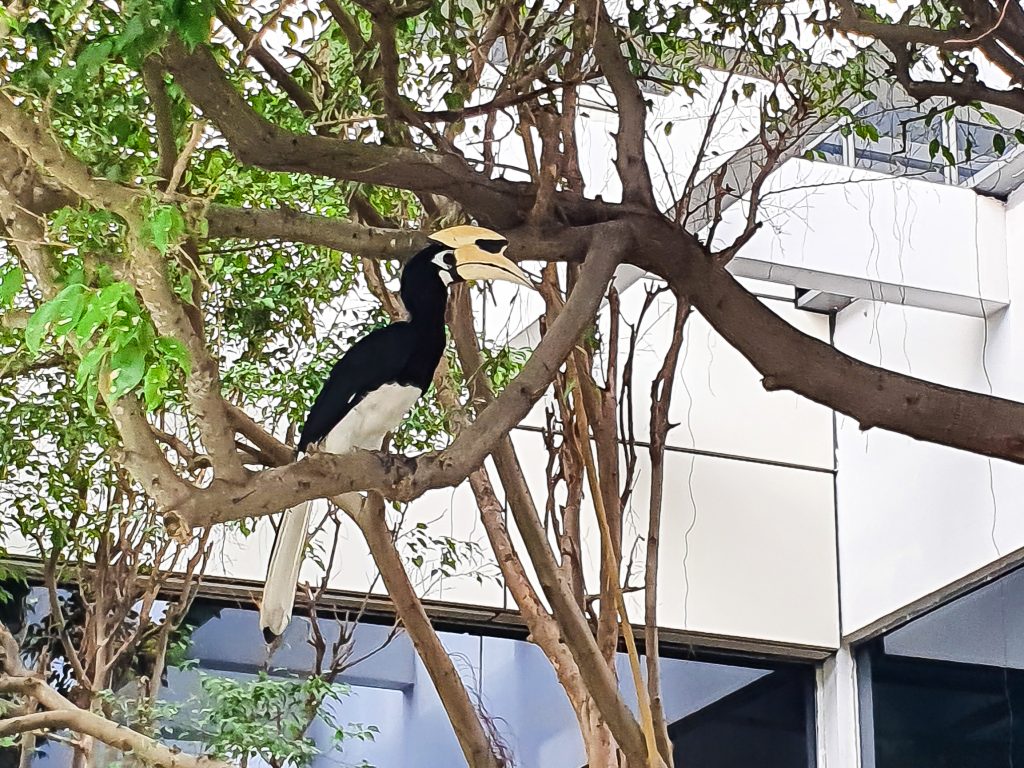 An oriental pied hornbill perches on a tree outside of AS7, Shaw Foundation Building. (Photo: Mr Athanasius Koh)
An oriental pied hornbill perches on a tree outside of AS7, Shaw Foundation Building. (Photo: Mr Athanasius Koh)
The oriental pied hornbill has certainly made an impactful comeback to Singapore’s shores. Once thought to be locally extinct, the large bird can be identified by its casque atop its beak as well as its black and white plumage.
Along with other “celebrity wildlife” like the otters in Singapore, the oriental pied hornbills’ return to the mainland can be largely attributed to conservation efforts by the National Parks Board, Wildlife Reserves Singapore and the local research community. These efforts include providing sufficient mature trees for hornbills that favour nesting in tree holes.
Spotted across a number of locations in Singapore, NUS is no exception. It has been spotted in University Town and around FASS Block AS1 as well as the trees outside AS7, Shaw Foundation Building.
Now that you have met some of the interesting wildlife that have called NUS their home, be sure to keep an eye out for our neighbours in nature between classes! Do appreciate them from a safe distance and refrain from feeding them.
This story first appeared on NUSnews on 17 June 2021.
NUS CHS Case Competition: Solutions for Tomorrow
IN BRIEF | 1 min read
- The NUS College of Humanities and Sciences has launched the Case Competition Series. Register your interest now!
 The NUS College of Humanities and Sciences has launched the Case Competition Series, which seeks to encourage undergraduate and post graduate students to apply their curriculum learning to tackle complex real-world challenges that require interdisciplinary approaches to their solution. The students, who are expected to work in teams comprising members from across different disciplines, will be presented with a complex problem (to be shared at the start of the competition in late July), and given four weeks to build their cases in consultation with participating industry and Faculty advisers before their presentation for the first round of judging. Scan the QR code below or just click here to register your interest as team leader for this competition now. More details will be released to participants next month.
The NUS College of Humanities and Sciences has launched the Case Competition Series, which seeks to encourage undergraduate and post graduate students to apply their curriculum learning to tackle complex real-world challenges that require interdisciplinary approaches to their solution. The students, who are expected to work in teams comprising members from across different disciplines, will be presented with a complex problem (to be shared at the start of the competition in late July), and given four weeks to build their cases in consultation with participating industry and Faculty advisers before their presentation for the first round of judging. Scan the QR code below or just click here to register your interest as team leader for this competition now. More details will be released to participants next month.
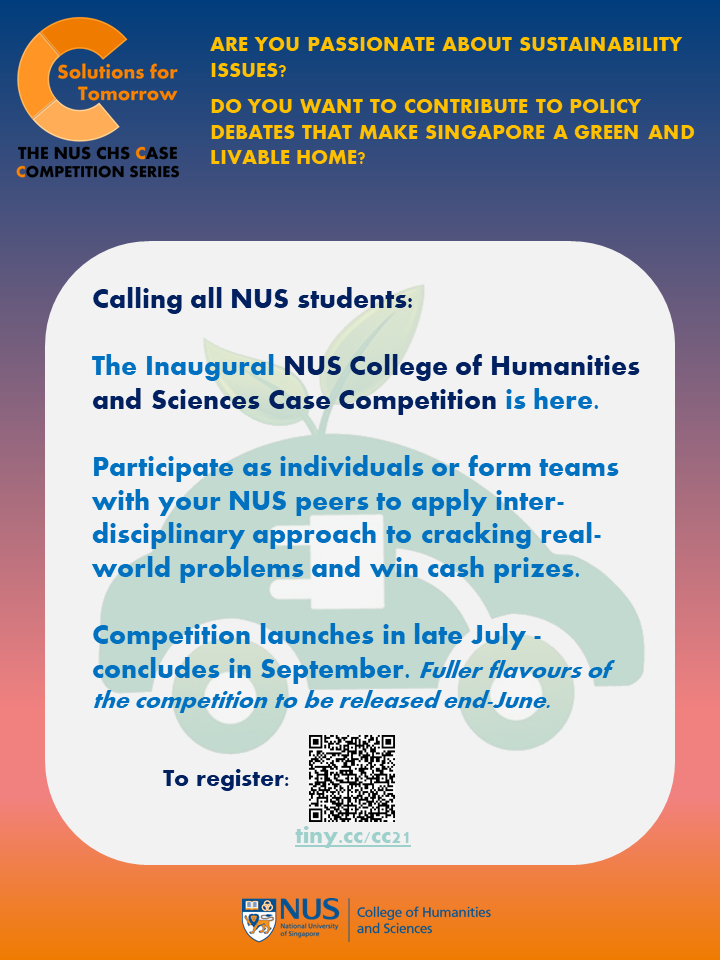
Honouring five outstanding alumni from Arts and Social Sciences
IN BRIEF | 3 min read
- Five exceptional NUS Faculty of Arts and Social Sciences (FASS) alumni from diverse backgrounds were lauded at the annual FASS Distinguished Arts and Social Sciences Alumni Awards 2020 in a simple presentation ceremony on 30 April at Swissotel The Stamford.
 (From left to right): FASS alumni Mr Yatiman Yusof, Mr Niam Chiang Meng, Ms Lim Sau Hoong, Mr Ravi Menon and Dr Liang Wern Fook have made singular contributions to the areas of the arts, education, media, finance, policy and community development.
(From left to right): FASS alumni Mr Yatiman Yusof, Mr Niam Chiang Meng, Ms Lim Sau Hoong, Mr Ravi Menon and Dr Liang Wern Fook have made singular contributions to the areas of the arts, education, media, finance, policy and community development.
Five exceptional NUS Faculty of Arts and Social Sciences (FASS) alumni from diverse backgrounds were lauded at the annual FASS Distinguished Arts and Social Sciences Alumni Awards 2020 in a simple presentation ceremony on 30 April at Swissotel The Stamford.
All have left their distinct mark in the wide-ranging fields that they serve. They are namely:
- Mr Yatiman Yusof (Geography and Malay Studies, ’72), Non-Resident High Commissioner of Singapore to Kenya
- Mr Niam Chiang Meng (Economics, ’83), Chairman of the Maritime and Port Authority of Singapore (MPA)
- Ms Lim Sau Hoong (Chinese Studies, ’83), Founder, Former CEO and Executive Creative Director of advertising agency 10AM Communications
- Mr Ravi Menon (Economics, ’87), Managing Director of the Monetary Authority of Singapore (MAS)
- Dr Liang Wern Fook (Chinese Studies, ’89 and Master of Arts, ’92), Writer, musician and educator
Congratulating the award recipients, FASS Dean Professor Robbie Goh said, “Ms Lim Sau Hoong, Dr Liang Wern Fook, Mr Ravi Menon, Mr Niam Chiang Meng and Mr Yatiman Yusof, have made singular contributions to the arts, education, media, finance, policy and community development. Not only do their wide-ranging achievements bring pride to the FASS family, but I believe that it also attests to the disciplinary range, intellectual curiosity and critical thinking that are the hallmarks of the FASS educational experience.”
This disciplinary diversity, Prof Goh elaborated, would soon be enhanced by FASS’ partnership with the NUS Faculty of Science in the NUS College of Humanities and Sciences (CHS) where students would be able to choose any major that is offered by both faculties. He added that this would be a major boost to FASS students’ educational experience as “the CHS common curriculum will prepare students for a disruptive world – by giving them a compulsory grounding in essential skills such as writing and communication, data literacy, digital literacy, design thinking and AI.”
Our alumni and their contributions
 Present at the ceremony were (clockwise from top left): FASS Dean Prof Robbie Goh; Mr Menon; Dr Liang; Mr Bernard Toh, Director of NUS Alumni Relations; Mr Niam; Ms Lim; Mr Yatiman; and NUS President Prof Tan Eng Chye.
Present at the ceremony were (clockwise from top left): FASS Dean Prof Robbie Goh; Mr Menon; Dr Liang; Mr Bernard Toh, Director of NUS Alumni Relations; Mr Niam; Ms Lim; Mr Yatiman; and NUS President Prof Tan Eng Chye.
A teacher and a journalist early on in his career, Mr Yatiman served key government appointments including as a Member of Parliament and Senior Parliamentary Secretary of the Ministry of Foreign Affairs and the then-Ministry of Information and the Arts, before his retirement in 2006. In addition to being Singapore’s non-resident envoy to Kenya, Mr Yatiman is a Board Member of the Singapore Press Holdings Foundation and the Chairman of the Malay Language Council of Advisors.
Contributing extensively to the public sector too was Mr Niam who served in the Ministries of Finance, Trade and Industry, Health, Law, and Information, Communications and the Arts – including Permanent Secretary appointments in several of these Ministries. He also served at the National Population and Talent Division, and the National Climate Change Secretariat. Aside from his current MPA chairmanship, Mr Niam is also the Chairman of Gardens by the Bay Pte Ltd and MediaCorp Pte Ltd.
A heavyweight in the media, marketing, and advertising industry, Ms Lim’s creative leadership of 10AM Communications has garnered over 300 prestigious global awards including The One Show, the Clio Awards, and the Communication Arts. Identified for her unique creative talent, Ms Lim was Visual Advisor to the Planning Committee for the 2008 Beijing Olympics’ Opening Ceremony and headed the Shanghai World Expo 2010 Singapore Pavilion Advisory Panel. In 2007, Ms Lim was awarded the President’s Design Award and was named Designer of The Year for her extensive contributions to media, marketing and culture in Singapore.
Prior to his appointment at MAS, Mr Menon served as Permanent Secretary at the Ministry of Trade and Industry, and Deputy Secretary at the Ministry of Finance. A recipient of the Singapore Government’s Meritorious Service Medal and Public Administration (Gold) Medal, he has served on boards in the public, private, and people sectors. He is currently Chairman of the Institute of Banking and Finance, and serves on the Board of Trustees of the Singapore Indian Development Association.
A singer-songwriter, poet and academic in Chinese literature and language, Dr Liang is a respected cultural figure and pioneer of Xinyao – a movement of locally composed Mandarin pop songs from the 1980s. To date, Dr Liang is the only artist who has received the National Arts Council’s Young Artist Award (Literature) and the prestigious Cultural Medallion (Music) across different art genres. He was also honoured recently with the Singapore Chinese Cultural Contribution Award for his outstanding contribution to the promotion, enrichment and development of Chinese Singaporean culture. His canon of work includes over 15 publications of literature, more than 200 songs, and two Mandarin musicals – a number of his most important works were written and composed during his university days.
On receiving the awards
Also present at the event was NUS President Professor Tan Eng Chye who presented the awards to the five alumni. Invited guests were also treated to videos of the award recipients who shared about their university days in FASS and their career highlights.
Recalling the moment he received news of the award, Mr Yatiman humbly shared, “To be frank, I’m quite surprised when I was told about it. And I thought there are hundreds, if not thousands of people who are more suitable to receive this award. I’m just a small worker in the community, not doing much in my lifetime. I think there are many others. So, for those who’ve been working hard for the good of the community, I take this award as recognition of their effort too.”
Mr Niam recalled some of his best memories were during university days where he learnt a lot about networking and life skills. It was also where he found his life partner. He said, “It is a privilege to be given this award. I would like to thank NUS and the organising committee for bestowing this honour on me and the other recipients…it means a great deal.”
 Taking the form of a rising star, the alumni award represents the inspiration these individuals bring to society through their brilliant contributions towards the Faculty, University and Singapore.
Taking the form of a rising star, the alumni award represents the inspiration these individuals bring to society through their brilliant contributions towards the Faculty, University and Singapore.
Established in 2015, the Awards recognise individuals for their distinguished scholarship and outstanding service to the Faculty, the University and Singapore. These outstanding recipients have made significant impact in various fields locally and internationally, which has contributed to the betterment and promotion of the arts and social sciences.
Previous recipients of the Awards include luminaries such as former President Mr S R Nathan, Emeritus Senior Minister and former Prime Minister Mr Goh Chok Tong, former United Nations Under-Secretary General Dr Noeleen Heyzer; Permanent Member of the Presidential Council for Minority Rights Mr Abdullah Tarmugi; and Executive Chairman of Banyan Tree Holdings Limited Mr Ho Kwon Ping.
Click here for more details on this year’s award recipients.
This story first appeared on NUSnews on 6 May 2021.
Singapore through the years: A digital cartographic record
IN BRIEF | 3 min read
- Professor Taylor and Associate Professor Feng Chen-Chieh, along with their department colleagues at NUS Geography, created Historical Maps of Singapore, an online resource hosted by NUS Libraries that provides a series of maps of different scales dating from 1846 to 2010.
 A plan of Singapore town and the adjoining districts produced by John Turnbull Thomson, a Government Surveyor, and published by J.M. Richardson in London in 1846.
A plan of Singapore town and the adjoining districts produced by John Turnbull Thomson, a Government Surveyor, and published by J.M. Richardson in London in 1846.
From quiet colonial backwater to thriving city-state, Singapore has undergone rapid transformation over the last 200 years or so.
If you are interested in finding out how the Central Business District has developed since the 1828 Jackson Plan or have a general interest in the country’s ever-changing landscape, do check out Historical Maps of Singapore, an online resource created by NUS Geography and hosted by NUS Libraries.
Historical Maps of Singapore provides a series of maps of different scales dating from 1846 to 2010. The maps have been carefully converted to a digital format and georeferenced to facilitate cross-comparison.
The work was funded through a Strategic Initiative award from NUS, and both the Singapore Land Authority and Ministry of Defence kindly provided permission for the maps to be made available online.
NUS Geography faculty members who worked on the project included the Head of Department Professor David Taylor, as well as Associate Professor Feng Chen-Chieh.
“Maps are extremely important resources, and not only for geographers. Maps are time-stamped windows not only on the ever-changing landscapes they represent in reduced form but also on the minds and values of the map-makers and those who they thought might be interested in the results of their endeavours,” said Prof Taylor.
“For example, the 1873 map shows the locations of 29 police stations, but only one hospital ~ was crime really a much greater concern than health in late 19th century Singapore? Making the maps available in digital form opens them to a wider audience and to new forms of analysis.”
 (From left to right) The changing landscape of the Telok Ayer Basin from 1860 to 1993.
(From left to right) The changing landscape of the Telok Ayer Basin from 1860 to 1993.
The online resource is being used in teaching by NUS Geography, and has proved particularly valuable during the COVID-19 pandemic when teaching was moved largely online.
The digitised maps have also been used in research. For example, geographers have used the maps as a basis for plotting changes in Singapore’s coastline and the extent to which coastal habitats such as mangrove forests have been lost, while researchers at NUS Chinese Studies have plotted changes in the locations of Chinese temples and kampungs – and in some cases their disappearances.
The Historical Maps of Singapore web-based resource has been made as straightforward as possible to use. Once on the website, users may select the maps that they are interested in and zoom in and out, revealing higher or lower levels of detail. They can also arrange several maps on top of one another as layers, and search for common features on the different maps. Layer swipes can also be done to compare different maps.
Clicking on the metadata, one can also view a description of the map, provenance and citation. These maps can be exported and viewed in Google Earth, QGIS or ArcGIS as layers. These features provide researchers and students from a range of disciplines with the analytical and visualisation tools needed to carry out more detailed studies of the digitised maps.
 Users may swipe to compare the maps over different years.
Users may swipe to compare the maps over different years.
Prof Taylor added, “The popularity of the Historical Maps of Singapore web-based resource has not surprised me. Singapore has changed so much in a relatively short period of time.
“Maps are one way of capturing and evaluating those changes. But they are capable of providing much more than a simple record of change. I hope that we are able to add to the current collection of digitised maps and associated resources in the coming years as we move increasingly into an era where geospatial information underpins so much of what we do and who we are”.
This story first appeared on NUSnews on 22 April 2021.
Archaeological survey being conducted at Alexandra Hospital, a WWII site
by Ng Keng Gene
SINGAPORE - In one account of the Alexandra Hospital massacre of Feb 14, 1942, its football field was where Japanese soldiers gathered wounded soldiers and staff, tied them by the hands in groups, and led them away to a small building at the back of the hospital grounds.
The field of about 6,000 sq m is also believed to be the site of a mass grave of the victims.
An estimated 200 people - including patients - died over two days at the hands of the Japanese.
The site's significance is not lost on the hospital's current management and the National Heritage Board (NHB).
The two organisations are working together to survey the field, and a 3,600 sq m area at the western end of the compound, ahead of the hospital's redevelopment, which will see its grounds expanded towards Queensway.
The hospital will be redeveloped into an integrated health campus by 2030, as previously announced.
Without mentioning World War II, spokesmen for Alexandra Hospital and NHB told The Straits Times they are conducting research and documenting the site's heritage "in view of the historical significance of the hospital compound".
For now, the archaeological survey involves non-intrusive scanning of the ground.
An NHB spokesman said the survey fieldwork - which began in December - has been completed, and "all findings are being analysed to determine if there is a need to conduct further investigations".
"Any materials found during the investigation will be assessed by the archaeological surveyors and NHB, and may undergo further reviews, as necessary," the spokesmen added.
An archaeology team from the ISEAS - Yusof Ishak Institute was commissioned by NHB to conduct the survey.
Asked why the two specific sites were chosen for the survey, the NHB spokesman said: "They have relatively uniform terrain and over-ground obstructions are absent, and are therefore suitable for ground-penetrating radar (GPR) surveying.
"Geophysical methods such as GPR are commonly used by archaeologists as a non-intrusive way to survey landscapes, which can provide extensive ground imaging without disturbing the ground."
Procurement documents published last October show that the survey is seeking to "locate and determine the extent and the nature of any anomalous subsoil feature(s) such as backfill, old building foundation and walls, soil cavities and services" that may be attributed to the early and mid-1900s.
Such features are expected to be within the first one or two metres below the surface.
The documents also have provisions for a contractor to provide equipment and manpower needed for trial trenching, if it is deemed necessary after the GPR results are assessed.
Trial trenching is a quick method that allows archaeologists to determine the archaeological value of a site, where several trenches are dug for evaluation, leaving the majority of the site untouched.
A single explanation for the massacre has not been found, but some claim the Japanese were pursuing troops that had fired at them from the hospital grounds.
About 50 victims were shot or bayoneted in the wards during the rampage, including one patient undergoing surgery on the operating table, while about 150 people who were rounded up and kept in three small rooms overnight either died there or suffered the same fate as those in the wards over the course of the night and the next morning.
Archaeologist John Miksic, a professor at the National University of Singapore's Department of South-east Asian Studies, said that the survey may potentially contribute to two fields of archaeological research - the colonial period and military/battlefield archaeology.
"Not much has been published on these two topics," said Prof Miksic.
Apart from the massacre, he said Alexandra Hospital also has the potential to yield information on the relationship between the British military presence and the local society of Singapore in general.
"It will be difficult to assign specific archaeological discoveries to the event of the massacre itself, though it might be possible to find a mass grave of the victims," he added.
Although not involved in this survey, Prof Miksic said that any data from the colonial era found at the hospital would be useful for comparison with data from other parts of Singapore, and with different types of sites.
Excavations that Prof Miksic participated in previously in the Central Business District yielded artefacts from the colonial period.
Dr Jack Lee, president of the Singapore Heritage Society, welcomed the news of the archaeological survey, saying that studies of sites being redeveloped, especially in locations where there is a chance of artefacts being found, should be encouraged.
He added that while the present archaeological investigation is taking place on state-owned land, he hoped that private land owners will also allow researchers to have the time to carry out similar research in the future "so that the chance to learn more about Singapore's heritage is not lost in the constant redevelopment of the urban landscape".
Heritage author Jerome Lim said that while it is difficult to predict what this survey might uncover, it is important to carry it out before redevelopment, which may prevent anything of historical significance from ever being discovered.
He hoped that more attention will be paid to the heritage value of other buildings on the hospital's grounds, other than the three blocks that have already been conserved.
"I feel some further consideration should be made for their conservation due to the history of the site as Britain's main military hospital in Singapore from 1940 to 1971," he said.
#DiscoverFASS@CHS 2021 | Sign Up for Masterclasses, Learn All About Our Majors

As part of the #DiscoverFASS@CHS campaign leading up to our Open House in May this year, we are holding 'live' Masterclasses presented by three of our award-winning Faculty members, and our Departments are hosting 'live' Q&A sessions for prospective students. These are opportunities not to be missed if you wish to know all you need to know about classes here and the myriad programmes available to you if you are a part of the FASS community. Masterclasses by Award-Winning Faculty
Experience lessons led by our dynamic faculty members.  Roasted Fetuses and Corpse Magic: An Introduction to Supernaturalism in Southeast Asia
Roasted Fetuses and Corpse Magic: An Introduction to Supernaturalism in Southeast Asia
Presented by Associate Professor Irving Johnson, Department of Southeast Asian Studies
The class aims to foreground the fascinating world of beliefs in supernaturalism that pervade Southeast Asian lives. Many of us enjoy telling and listening to creepy stories, watching horror movies on Netflix or dabbling in the esoteric. In this masterclass, we will look at some of the beliefs that structure constructions of the supernatural in modern Southeast Asia. The class revolves around a series of interrelated questions that seek to discover commonalities in popular belief systems and their prominence in the region, linking supernaturalism to larger issues of power, gender and politics. 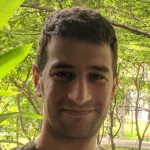 Evidence and Promise Making
Evidence and Promise Making
Presented by Assistant Professor Zachary Barnett, Department of Philosophy
Promise-making is an important part of life. We make promises to our friends, families, and significant others, and they make promises to us. We will look at a puzzle that arises when we think about "promising against the odds": How should I feel about making a promise, if I know that most of the people in my exact situation end up breaking that promise? For example, suppose that I promise to quit smoking cigarettes. At the same time, I know that most people who sincerely promise to quit smoking do not actually succeed on their first attempt. Should I believe that I will be the exception to the rule? If not, am I justified in making the promise in the first place? And if I do make the promise, should my friends and family believe me? These questions arise in many different contexts, ranging from the superficial to the serious, involving addiction or relationships. 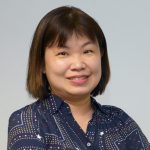 Making Sense of Self-Awareness and What That May Mean
Making Sense of Self-Awareness and What That May Mean
Presented by Dr Peace Wong Yuh Ju, Department of Social Work
In this talk, Dr Wong will attempt to broaden our understanding about ‘self’ and what that may mean to us. It is not uncommon for students in wanting to gain greater self-awareness with the attempt to learn more about one’s beliefs/feelings in relation to the observed world around us. Yet, how do we deepen our understanding of ‘self’, given that we are both familiar with who we are, and yet at times finding ourselves baffled by our reactions, and wondered why we respond in a certain manner? We will briefly discuss the various influences that may impact our values and beliefs, as well as consider what knowing your ‘self’ may mean to you.
To register for Masterclasses, click here.
Live Q&As with our Departments
Meet key Faculty and student representatives of every FASS Department and major programme in their respective Zoom meeting rooms and ask them specific questions about the requirements, content and value of the programmes they offer.
Department of Chinese Studies
The Chinese Studies Department provides training in diverse areas of Chinese Studies and Chinese Language, with the aim of preparing students for employment in a wide range of sectors. Graduates are offered career opportunities as professionals in the educational and business sectors, academia, the translation service industry and the mass media.
Join the Department's #DiscoverFASS@CHS 2021 'Live' Q&A session on 21 April (2-4 pm) here.
In the meantime, visit the College of Humanities Programmes page for more details on what this Department offers.
Department of Communications and New Media
Communications and New Media (CNM) at the National University of Singapore is the only Department in Southeast Asia that offers media studies, interactive media design, cultural studies, and communication management with a focus on new media.
Join the Department's #DiscoverFASS@CHS 2021 'Live' Q&A session on 21 April (2-4 pm) here.
In the meantime, visit the College of Humanities Programmes page for more details on the programmes offered by this Department.
Department of Economics
The Department of Economics has an established reputation as one of the largest and leading departments of Economics in the Asia-Pacific region. Faculty members’ research areas span a wide range of economic fields, with strength in the core areas of microeconomics, macroeconomics and econometrics, as well as in particular fields such as game theory and industrial organization, labor economics, education, financial economics, and growth theory and development with special reference to Asia.
The Department's #DiscoverFASS@CHS 2021 'Live' Q&A session on 21 April (2-4 pm) here. This session includes discussion of the Data Science and Economics Cross-Disciplinary Programme (DSE-XDP).
In the meantime, visit the College of Humanities Programmes page for more details on the programmes offered by this Department.
Department of English Language, Literature and Theatre Studies
The Department of English Language, Literature and Theatre Studies houses three undergraduate majors and three graduate programmes. The English Language major offers an education in linguistics, the study of human language. The undergraduate programme in English Literature is designed to provide a broad foundation in reading and analysing texts of all kinds. And, the Theatre Studies curriculum delivers education in all areas of theatre and performance history, production and interpretation.
The Department's #DiscoverFASS@CHS 2021 'Live' Q&A session on 21 April (2-4 pm) here.
In the meantime, visit the College of Humanities Programmes page for more details on the programmes offered by this Department.
Department of Geography
Modules in the Department of Geography are organized along four areas of enquiry: environmental processes and change; global political economy; society and culture; and regional specializations (with a focus on Asia). The Department also offers a Field Studies module in which students travel to countries in the region such as Thailand and Malaysia where they conduct field work and collect research material over a 3-5 week period. Home-stays and visits to local universities and key sites of interest are part of the overseas learning experience it delivers.
The Department's #DiscoverFASS@CHS 2021 'Live' Q&A session on 21 April (2-4 pm) here. This session includes discussion of the Bachelor of Environmental Studies Programme (BES-XDP).
In the meantime, visit the College of Humanities Programmes page for more details on the programmes offered by this Department.
Department of History
The Department of History offers training at undergraduate and graduate levels, and its teaching and research expertise lies primarily in the history of Southeast and East Asia, but there is strong selection of module offerings in European, American, and military history, as well as the history of art, business, religion, science and technology.
The Department's #DiscoverFASS@CHS 2021 'Live' Q&A session on 21 April (2-4 pm) here.
In the meantime, visit the College of Humanities Programmes page for more details on the programmes offered by this Department.
Department of Japanese Studies
Founded in 1981, the Department of Japanese Studies is one of the largest area studies departments devoted to the study of Japan in the Asia-Pacific region, and offers BA, MA and PhD degrees in Japanese Studies taught by specialists with qualifications from leading universities around the world.
The Department's #DiscoverFASS@CHS 2021 'Live' Q&A session on 21 April (2-4 pm) here.
In the meantime, visit the College of Humanities Programmes page for more details on the programmes offered by this Department.
Department of Malay Studies
The Department of Malay Studies actively engages in research on a wide range of issues concerning the Malay world from a multi-disciplinary perspective, promotes exchanges with centres of Malay studies worldwide, and encourages the development of new and alternative approaches to the understanding of Malay history, economy, politics, society and culture.
The Department's #DiscoverFASS@CHS 2021 'Live' Q&A session on 21 April (2-4 pm) here.
In the meantime, visit the College of Humanities Programmes page for more details on the programmes offered by this Department.
Department of Philosophy
The Department of Philosophy is one of Asia’s leading centres for philosophical education and research. It is the top English-language philosophy program in Asia, and the inaugural Asian member of the Australasian Association of Philosophy. The faculty members have a broad range of interests spanning diverse philosophical traditions, offer a philosophical education spanning diverse philosophical traditions.
The Department's #DiscoverFASS@CHS 2021 'Live' Q&A session on 21 April (2-4 pm) here. This session will also include discussion of the Philosophy, Politics, and Economics Cross-Disciplinary Programme (PPE-XDP).
In the meantime, visit the College of Humanities Programmes page for more details on the programmes offered by this Department.
Department of Political Science
The Department of Political Science offers modules in comparative politics, international relations, political theory, and public administration. It also houses the Global Studies Programme, a new, multidisciplinary field of inquiry that examines the processes and effects of globalisation across political, economic, social and cultural domains around the world.
The Department's #DiscoverFASS@CHS 2021 'Live' Q&A session on 21 April (2-4 pm) here. This session includes discussion of the Global Studies Programme.
In the meantime, visit the College of Humanities Programmes page for more details on the programmes offered by this Department.
Department of Psychology
The Psychology programme at NUS aims to equip students with knowledge in the key areas of psychology (such as human biological processes, developmental processes, social processes, cognitive processes, mental health and adjustment of individuals) as well as an understanding of the applications of psychology. It also develops skills for undertaking studies of behaviour, including statistical skills and the use of computers for data analyses.
The Department's #DiscoverFASS@CHS 2021 'Live' Q&A session on 21 April (2-4 pm) here.
In the meantime, visit the College of Humanities Programmes page for more details on the programmes offered by this Department.
Department of Social Work
The main objective of the undergraduate General and Honours degree programme offered by the Department of Social Work is to equip its graduates for entry into the social work profession at the direct-service level. Students are exposed to social service visits, skills laboratory training, fieldwork placements and module projects, among other applied learning methods.
Go to this Department's #DiscoverFASS@CHS 2021 'Live' Q&A session on 21 April (2-4 pm) here.
In the meantime, visit the College of Humanities Programmes page for more details on the programmes offered by this Department.
Department of Sociology
The Department of Sociology is a diverse, dynamic and innovative research and teaching unit with strong expertise in research on Southeast Asia, East Asia and South Asia as well as on Singapore society. One of the largest Sociology departments in the world, it offers comprehensive undergraduate, honours and graduate programmes, led by a group of dedicated and creative researchers and educators.
The Department's #DiscoverFASS@CHS 2021 'Live' Q&A session on 21 April (2-4 pm) here.
In the meantime, visit the College of Humanities Programmes page for more details on the programmes offered by this Department.
South Asian Studies Programme
South Asian Studies, as offered by the South Asian Studies Programme (SASP), focuses on the region comprising India, Pakistan, Bangladesh, Sri Lanka, Nepal, Bhutan and the Maldives. At the undergraduate level, students are offered a range of modules in economics, religious and cultural studies, history, international relations, philosophy, politics and gender studies. The aim is to provide graduates of the programme with a broad understanding of the region from different points of view - knowledge that will be useful in dealing with this changing region in the 21st century.
The Department's #DiscoverFASS@CHS 2021 'Live' Q&A session on 21 April (2-4 pm) here.
In the meantime, visit the College of Humanities Programmes page for more details on the programmes offered by this Department.
Department of Southeast Asian Studies
The Department of Southeast Asian Studies is located in the Asian Studies Division of the Faculty of Arts and Social Sciences, and offers distinctive programmes for anyone interested in studying Southeast Asia, from the undergraduate to the PhD level.
The Department's #DiscoverFASS@CHS 2021 'Live' Q&A session on 21 April (2-4 pm) here.
In the meantime, visit the College of Humanities Programmes page for more details on the programmes offered by this Department.
Centre for Language Studies
The Centre for Language Studies was established in 2001 to serve the foreign language needs of the Faculty of Arts and Social Sciences and has today over 80 full-time and part-time faculty members. It teaches thirteen different languages - Arabic, Bahasa Indonesia, Chinese, French, German, Hindi, Japanese, Korean, Malay, Spanish, Tamil, Thai and Vietnamese - to app. over 3,300 students per semester and thus helps them acquire a very valuable economic and social resource in today's world of growing globalisation and internationalisation.
The Department's #DiscoverFASS@CHS 2021 'Live' Q&A session on 21 April (2-4 pm) here.
In the meantime, visit the College of Humanities Programmes page for more details on the programmes offered by this Department.
Webinar on Greater than the Sum of Its Ports: Maritime Networks in Premodern Southeast Asia by Emeritus Professor John Miksic
Technical Webinar Co-Organised by The Joint Branch of the RINA and IMarEST (Singapore) The Society of Naval Architects and Marine Engineers Singapore
Singapore Shipping Association Greater than the Sum of Its Ports: Maritime Networks in Premodern Southeast Asia by Prof John N. Miksic Emeritus Professor, Department of Southeast Asian Studies, National University of Singapore Date : 31 March 2021
Time : The webinar will begin at 5:30 pm and end at 7.00 pm (SGT)
For more information, please visit https://www.imarest.org/events
Synopsis
The South China Sea was already crisscrossed by regular sailing routes 3,500 years ago. Archaeological research is slowly building up a picture of the networks which evolved before the arrival of the Dutch and English in 1600 interrupted the previous relation between ports in Southeast Asia and the Indian Ocean.
Singapore arose at a propitious time in the evolution of Asian maritime trade networks. This talk will describe the evidence for the development of port networks, the progress of archaeological research in adding to our understanding of how maritime trade networks operated in Asia in ancient and medieval times, and the probable shape of the network in the Temasek period (14th century).
About the Speaker
John N. Miksic received his PhD from Cornell University based on archaeological fieldwork in Sumatra. In 1987 he joined the National University of Singapore, where he is Emeritus Professor in the Southeast Asian Studies Department. He founded the Archaeology Unit at the Institute of Southeast Asian Studies. He has received awards from the government of Singapore and the court of Surakarta (Indonesia). His book Singapore and the Silk Road of the Sea won the inaugural award for best book on Singapore history in 2018. His specialties include historical archaeology of Southeast Asia, urbanization, trade, Buddhism, and ceramics.
Munshi Abdullah is a 'genius of his own', interested in technology and not pro-Western
(Article is in Malay Language)
27 February 2021, BERITA Mediacorp
Munshi Abdullah adalah 'genius tersendiri', minat teknologi dan bukan pro-Barat
Oleh: IRA MUSFIRAH
SINGAPURA: Tahukah anda, Munshi Abdullah bukan setakat seorang tokoh persuratan sahaja, malah beliau juga seorang 'genius' tersendiri yang cukup berminat dengan teknologi serta bukan pro-Barat.
Demikian antara hujah-hujah beberapa sarjana terkemuka Asia Tenggara mengenai ketokohan Munshi Abdullah, atau nama sebenarnya Abdullah Bin Abdul Kadir Munshi, yang kini diberi perspektif-perspektif segar dan baru.
Bapa kesusasteraan Melayu moden itu menerusi pelbagai penulisannya pada separuh pertama abad ke-19, banyak merakamkan tentang sejarah Singapura dan Asia Tenggara.
Namun sejarawan-sejarawan Barat turut memaparkan Munshi Abdullah sebagai seorang yang pro-Barat serta bergantung kepada penaung-penaung penjajah Inggeris.
"Saya rasa bahawa ia tidak tepat dan berbaur Orientalis," tegas Prof Madya Farish Noor, sarjana dan sejarawan Asia Tenggara.
"Dewasa ini kalau kita melihat bagaimana Munshi Abdullah dikaji kembali dan dibaca kembali, khususnya daripada ilmuan-ilmuan Asia Tenggara sendiri, kita dapat lihat bahawa sebenarnya beliau mempunyai suara dan pendirian yang lebih kukuh dan tidak begitu kagum kepada kuasa kolonial Eropah pada waktu itu. Kita dalam proses menilai kembali, pendapat belia, idea beliau, legasi warisan yang ditinggalkan beliau."
Prof Madya Farish merumuskan bahawa Munshi Abdullah adalah seorang individu yang "jauh lebih kompleks dari yang kita sangka".
Penilaian semula tentang ketokohan Munshi Abdullah itu dibincangkan hari ini (27 Feb) dalam satu sesi mengupas buku ilmiah dua jilid terbaru berjudul 'Abdullah Bin Abdul Kadir Munshi' tulisan sarjana pengajian Melayu terkemuka, Prof Madya Hadijah Rahmat.
Prof Madya Farish merupakan antara anggota panel sesi itu berlangsung di Perpustakaan Negara, selain sejarawan terkemuka Prof John Miksic, pensyarah Jabatan Pengajian Melayu di Universiti Nasional Singapura (NUS) Dr Azhar Ibrahim dan konsultan perniagaan antarabangsa Tengku Sri Indra.
Buku itu, yang mengambil masa 25 tahun untuk dihasilkan, adalah kajian paling komprehensif mengenai Munshi Abdullah yang pernah dibuat sejauh ini.
Ia cukup kaya dengan pelbagai sudut pandangan baru tentang tokoh tersebut dan menyatukan banyak bahan arkib baru dari Eropah, Amerika Syarikat dan Indonesia yang belum diteroka sebelum ini.
Dalam pencerakinan beliau pula Prof John Miksic menarik perhatian betapa Munshi Abdullah punya kerjaya yang panjang iaitu selama 30 tahun.
Dalam tempoh itu, Munshi Abdullah katanya didapati memaparkan idea-idea yang berubah dan berkembang.
"Apabila beliau mendapat lebih banyak idea tenang teknologi contohnya. Beliau bukan setakat sarjana persuratan - beliau juga seorang teknisyen, tahu bagaimana mengendalikan mesin cetak dan mengajar orang Melayu lain bagaimana mencetak buku. Beliau juga berminat tentang perkara seperti kapal wap.
"Jadi kita tahu beliau bukan minat dalam sastera sahaja, tetapi juga perkara-perkara yang praktikal," kata pengkaji terkenal itu yang merupakan Profesor Pengajian Asia Tenggara di Universiti Nasional Singapura (NUS).
Bagi Prof Madya Hadijah sendiri, beliau bermotivasi untuk mengkaji dan menulis buku itu kerana ada banyak persoalan dan kontroversi berkenaan tokoh persuratan abad ke-19 itu yang belum terjawab sebelum ini
"Jadi saya rasa perlu untuk mencari hakikat sebenar mengenai tulisan beliau (Munshi Abdullah) dan latar belakang beliau supaya kontroversi itu dapat dijawab.
"Bahan-bahan yang dikaji itu tak ada di Singapura, ada di Eropah, di Amerika dan di Indonesia dan di beberapa tempat yang lain. Jadi saya terpaksa mengembara, merentas lautan dan benua, untuk melihat dan meneliti karya-karya tersebut dan penelitian itu memerlukan masa. Dan saya mengambil cuti belajar (sabbatical)sebanyak dua kali, untuk melakukan kajian-kajian ini," cerita Prof Madya Hadijah kepada BERITAmediacorp.
Antara sumber-sumber utama yang diperolehinya adalah daripada Sekolah Pengajian Ketimuran dan Afrika, Universiti Harvard dan Perpustakaan Nasional Indonesia.
Yang pasti, para sarjana itu percaya Munshi Abdullah adalah tokoh intelektual yang melihat pentingnya sejarah.
Menurut Prof Madya Farish, kisah Munshi Abdullah "masih relevan buat kita pada zaman ini".
"Khususnya bagaimana beliau melihat pentingnya sejarah, sifat rasional, akal fikiran, pentingnya inovasi baik dalam bidang kerja mahupun dalam bidang ekonomi. Saya rasa ini merupakan idea-idea yang masih relevan. Malah lebih relevan pada wkatu itu.
"Jadi kerana itulah saya sarankan anak-anak muda dan ilmuan-ilmuan membaca buku ini dan dapat sudut pandangan yang berbeza daripada apa yang kita ketahui 20, 30 tahun yang lalu," tambah pemikir Asia Tenggara itu.
Prof Miksic pula menarik perhatian betapa sebagai seorang intelek pada zamannya,
Munshi Abdullah mementingkan akal serta mengetengahkan hujah dan analisis logikal tentang "dialog-dialog semasa" dalam masyarakat beliau ketika itu.
Penulis "Hikayat Abdullah" juga banyak memberi reaksi kepada "semua evolusi baru yang berlaku pada awal tahun-tahun 1800-an.
"Abdullah sentiasa menekankan 'akal' dan bukan khayalan... Beliau sentiasa sangat prihatin dengan realiti dan tidak mengada-adakan sesuatu.
"Tulisan beliau sentiasa mengenai sebahagian daripada hujahdan dialog-dialog yang sedang berlangsung dalam masyarakat. Ini sangat baru bagi zamannya... bagaimana beliau melaksanakannya beberapa idea baru buat pertama kalinya.
"Beliau kelihatannya tidak dipengaruhi oleh sesuatu yang tertentu dalam kerjanya. Dia kelihatannya, sebilangan orang menyifatkannya sebagai 'genius' tersendiri. Beliau tidak begitu dipengaruhi oleh sesiapa. Beliau seorang yang unik," menurut Prof Miksic semasa berkongsi pandangannya kepada BERITAmediacorp.
Kini, dengan lahir sudah kajian dan buku yang dianggap sebagai suatu penerobosan mengenai Munshi Abdullah, Prof Madya Hadijah memendam dua keping harapan.
"Harapan saya yang pertama adalah masyarakat akan membacanya, menelitinya dan membahaskannya sebab nilainya akan menjadi sia-sia jika tidak dibaca oleh masyarakat. Dan jangan pula sampai orang luar dan masyarakat lain membaca dan mendapat manfaat sementara masyarakat kita tidak mempedulikannya.
Kedua, ujar Ketua Kumpulan Akademik Bahasa dan Budaya Asia Institut Pendidikan Nasional NTU itu, beliau berharap agar akan ada golongan generasi muda yang meneruskan pengajian mengenai Munshi Abdullah dari sudut-sudut yang berbeza.
Buku 'Abdullah Bin Abdul Kadir Munshi' yang meliputi dua jilid itu boleh anda beli di kedai-kedai buku utama ataupun secara naskhah elektronik bermula S$72.
- BERITAmediacorp/ha
by Ira Musfirah for BERITAMediacorp
Instructor / Teaching Assistant Positions in the Faculty of Arts and Social Sciences
- 4 Full-Time Teaching Assistant/Instructor (Integrated Humanities)
- 3 Full-Time Teaching Assistant/Instructor (Integrated Social Sciences)
- 2 Full-Time Teaching Assistant/Instructor (Integrated Asian Studies)
- Conduct tutorials (discussion groups) and support students via email, office hours.
- Provide administrative support and assist in the day to day running of the module.
- Prepare educational resources and course materials.
- Evaluate module assessment components.
- A Bachelor’s degree or Masters’ degree, or recent PhD in a relevant discipline.
- Candidates must have excellent verbal, reading, and written skills, and be able to explain difficult concepts clearly.
- Be able to work well independently, and as a member of an interdisciplinary team with diverse interests and opinions.
- Strong interest in continued engagement with a variety of humanities and non-humanities disciplines, as well as pedagogical improvement.
- Strong ability to facilitate discussions for undergraduate students.
- Past teaching and facilitation experience (especially at the university level) with good student feedback will put candidates in a strong standing.
- Completed, signed copies of the NUS Personal Data Consent Form and Personal Particulars Form – available here and here.
- CV: An abridged CV (5-page maximum), including details on education, employment history, past experience of teaching and supervision, research activities (including publications) and achievements, honours and awards, and service accomplishments.
- Qualifications: Include scanned copies of academic degrees.
- Teaching Portfolio:
- A Teaching Statement that commences with a preface (maximum 300 words) that makes the case for appointment. This should be a highly distilled summary of key contributions to student learning and, if applicable, educational leadership, guided by key points from the candidate’s teaching philosophy. The rest of the Statement should focus on outlining the teaching philosophy, providing evidence of a strong commitment to education and learning and, if applicable, innovation and leadership in teaching, and on future pedagogical plans.
- Teaching evaluations and peer review reports, if available. Other evidence of teaching excellence and/or other contributions to education, e.g., curriculum development, pedagogical innovation etc., should also be provided.
- A Research Statement, if applicable, highlighting how a candidate plans to advance pedagogical and/or disciplinary knowledge through inquiry.
- THREE referees’ letters (one of whom must be the applicant’s PhD supervisor, if applicable).
To apply, please go to NUS Careers.
Lecturer Positions in the Faculty of Arts and Social Sciences
Beginning in August 2021, the National University of Singapore will launch the College of Humanities and Sciences (CHS), an enhanced undergraduate experience for students of the Faculty of Arts & Social Sciences (FASS) and the Faculty of Science (FOS). For more information about CHS, please visit https://chs.nus.edu.sg. CHS includes a Common Curriculum of 13 modules that provide foundational skills in literacy, numeracy and critical thinking, as well as broad exposure to Integrated Humanities, Social Sciences, and Asian Studies. The Faculty of Arts & Social Sciences (FASS) at the National University of Singapore (NUS) seeks to hire a team of dedicated educators to help implement its interdisciplinary offerings in three new core modules: Integrated Humanities, Social Sciences, and Asian Studies. FASS will hire multiple positions at the rank of Lecturer to support these modules. Candidates from any discipline in the Humanities, Social Sciences, or Asian Studies may apply. Interdisciplinary research expertise and/or experience teaching in an interdisciplinary environment will be advantageous. Successful candidates will be primarily responsible for the implementation and support of the new core modules. They will be academically housed in one of the Departments or Programmes in FASS. Candidates will be expected to teach up to 240 contact hours per academic year. Additional responsibilities will depend on rank (see below) and may include administrative service. The anticipated start date is 1 July 2021 prior to the beginning of the new academic year commencing in August 2021. The appointment is for a period of two or three years with the possibility of extension. Successful candidates will be hired on the Educator Track. The Educator Track at NUS aims to attract, nurture, and retain suitably qualified and highly effective faculty members who approach teaching as a scholarly practice, and who therefore focus on and are passionate about excellence in teaching as a means of supporting student learning. The Educator Track offers a path for career progression (up to Full Professor), and it rewards effective, innovative, and thoughtful pedagogical practices that demonstrate student learning. FASS seeks the following:
- 1 Lecturer (Integrated Humanities)
- 2 Lecturers (Social Sciences)
- 2 Lecturers (Asian Studies)
- Conduct lectures and tutorials (discussion groups) and support students via email, office hours.
- Provide administrative support and assist in the day to day running of the module.
- Prepare educational resources and course materials.
- Evaluate module assessment components.
- A PhD in a relevant discipline (in the Humanities, Social Sciences, or Asian Studies)
- Candidates must have excellent verbal, reading, and written skills, and be able to explain difficult concepts clearly.
- Ability to work well independently and as a member of an interdisciplinary team with diverse interests and opinions; team teaching experience preferred.
- Experience with and commitment to interdisciplinary teaching and research, particularly across cultural traditions/regions.
- Experience with interdisciplinary curriculum design and development preferred.
- Experience teaching in a common curriculum for first-year students preferred.
- Ability to facilitate discussions for undergraduate students, especially with first-year students of diverse backgrounds, interests and abilities.
- Teaching experience with good student feedback preferred.
- Commitment to continual pedagogical improvement and a scholarly approach to education.
Beyond the classroom: Innovations that change the world
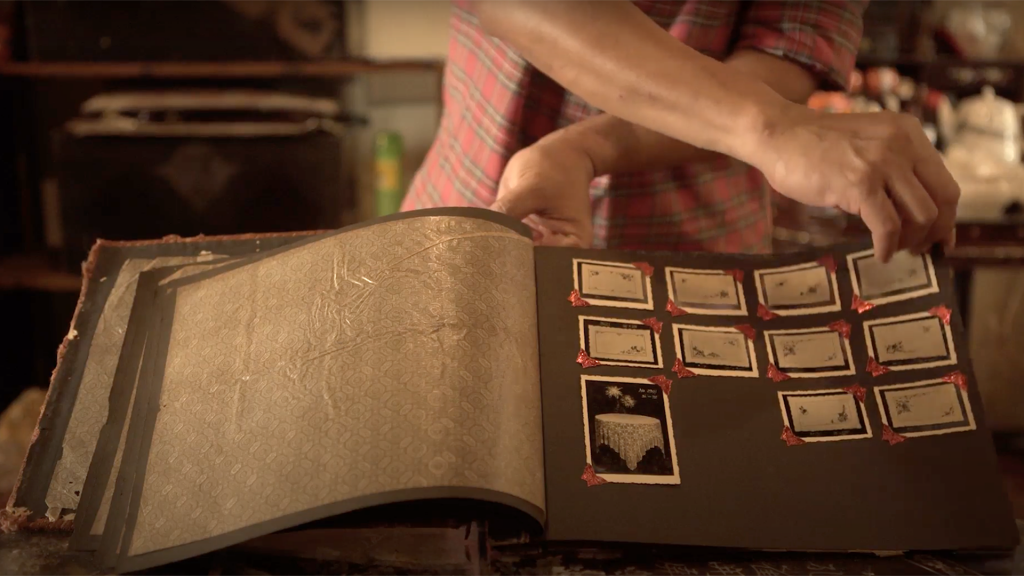
IN BRIEF | 5 min read
- Find out why these six entries stand out among the 32 proposals submitted to the NUS Resilience and Growth Innovation Challenge this year
Sometimes, a bright idea is all it takes to spark a global transformation.
With that in mind, the NUS Resilience and Growth Innovation Challenge had invited recent NUS graduates to submit inspiring proposals under three categories:
- Make Our People Better
- Make Our Society Better
- Make the World Better
As COVID-19 remains a threat, initiatives in the “Make Our People Better” category aim to improve quality of life through better home-based learning and promoting sustainable food consumption. The evaluation panel was led by Ms Melissa Kwee, CEO of the National Volunteer and Philanthropy Centre, and Professor Simon Chesterman, Dean of NUS Law.
Projects in the “Make Our Society Better” category aspire to create a more cohesive society. The panel was helmed by Ms Tan Li San, CEO Designate of the National Council of Social Service, and Professor Robbie Goh, Dean of NUS Arts and Social Sciences.
Proposals under the “Make the World Better” category include eco-friendly products and projects to arm youths with the relevant skills to thrive in a globalised world. The panel was co-chaired by Professor Tommy Koh, Rector of NUS Tembusu College, and Professor Phoon Kok Kwang, NUS Senior Vice Provost (Academic Affairs).
“As future leaders of society, our youth carry the responsibility of leaving their mark on the next generation. In this regard, it is heartening to see them championing causes that can positively impact the world,” said NUS President Professor Tan Eng Chye.
NUS is continually reviewing new proposals that are streaming in. The University intends to support 115 projects in all, a nod to its 115th anniversary that is being celebrated this year.
These six ideas stood out from the 32 projects supported so far.
Encouraging budding home farmers
Lettuce, mint and even tomatoes – Singaporeans may soon be able to grow these vegetables and more in their HDB flats.
Having witnessed “a deep psychological fear” when COVID-19 sparked panic buying here, Toby Fong and his team – superFARM – decided to bolster the nation’s food security. Their plan? Encourage green fingers through home-based farming.
“When we think about food security, it’s usually at a national level so it almost feels like the individual (is disconnected) from the entire food security equation,” said Toby, who graduated with a Master’s from NUS Architecture this year.
Under the “Make Our People Better” category, Toby, NUS Computing graduate Lim Hui Qi and NUS Arts and Social Sciences graduate Ong Jun Ren will design modular farming units that can fit into the smallest of homes. These units can also be customised for bigger spaces.
The plan is to transform niche hydroponics systems into functional mini-farms. In the next six months, half of their $50,000 funding will go to research such as field testing and online surveys, while the rest will be used for prototype development.
The team also wants to expand the individual’s role in food security to make sustainability a way of life.
“We want to recalibrate people’s attitude and behaviour to encourage responsible food consumption,” said Toby.
Making science fun for kids
Using portable science kits, sci@home is a project that will support community outreach efforts during the year-end school holidays by making science fun for underprivileged children.
“COVID-19 has unfortunately disrupted physical community engagement and outdoor learning opportunities for children, especially those from disadvantaged backgrounds,” said team member Lau Shi Yun, a NUS Physics graduate.
A $49,000 grant will allow Shi Yun and her four teammates – NUS Life Sciences graduate Chee Min Yee, NUS Psychology graduate Constance Seah, final-year Life Sciences student Pang Seok Mun and final-year NUS Chemistry student Jane Yap – to provide the kits for free. Each comes with the necessary materials and an activity booklet to help users understand the content better.
The five came together for this project that falls under the “Make Our People Better” category.
Faculty of Science undergraduates from Young Educators in Science – a programme that trains students to teach science – will serve as facilitators. They will conduct in-person and online sessions on how to apply scientific concepts such as density and polarity in real life.
With a supplementary YouTube channel, lessons are made more accessible as children can revisit previous experiments and clarify doubts anytime.
The kits will be distributed to beneficiaries by community partners. Sci@home will also use the grant to develop new kits once a month and beef up their online engagement tools and platforms.
“By tackling some of the challenges that these children and their families may face, we hope to help these young children adapt to home-based digital learning,” said Seok Mun.
Connecting generations through collections
At Tiny Museums, Singaporeans can explore an online trove of personal collections – ranging from ancient kerises to vintage vinyls – with guided tours from their owners.
The brainchild of Chua Ying Qing, Bu Dongqing – Master’s in NUS Southeast Asian Studies graduates – and Jamie Lee, the initiative aims to foster intergenerational connection under the “Make Our Society Better” category.
“The divide between older and younger generations is a growing concern in Singapore, and bridging this gap can seem like quite an insurmountable task,” said Jamie, a Southeast Asian Studies graduate.
Seeking a creative approach, the team linked up with The Folklore Archives, a group that organises in-person tours showing private collections of senior citizens to students and members of the public.
When COVID-19 hit and gatherings were banned, Tiny Museums tapped The Folklore Archives’ projects to build an online platform offering virtual tours.
While the duration and number of participants per session are still being firmed up, the team has partnered with schools and senior care centres for trials.
To widen their collection, the team has reached out to more senior collectors via Facebook and WhatsApp, and are currently screening potential candidates. There are also plans to use their $50,000 grant to create short films for collectors to showcase their wares.
“(Through this project), we hope to spark organic interactions between individuals of different ages and backgrounds,” said Jamie. “Ideally, we’d like to recreate that sense of intimacy in the original Folklore Archives sessions.”
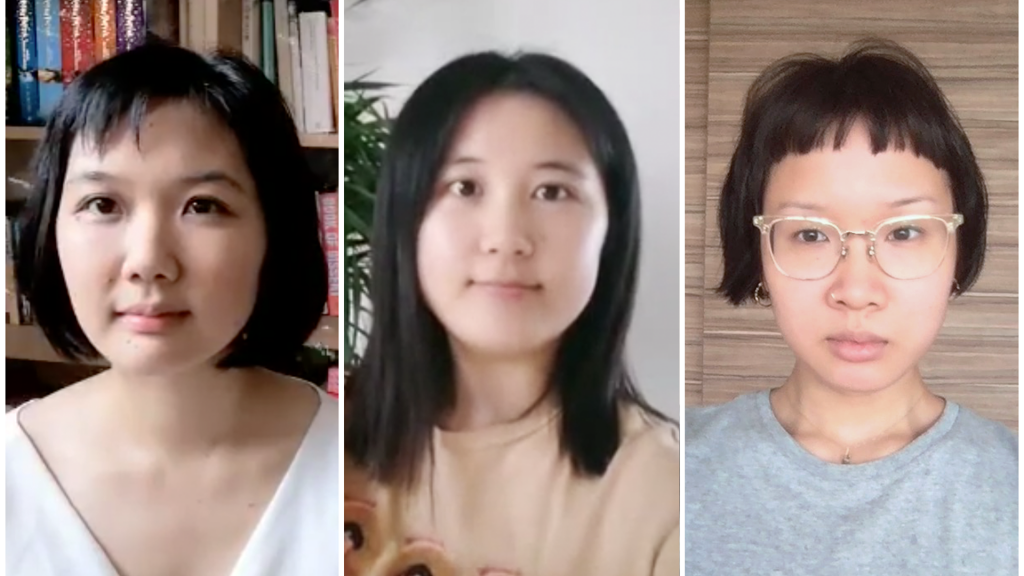
Building digital bridges for mentorship
Entering the workforce can be intimidating for soon-to-be graduates. But with a helping hand, the transition from student to professional life can be smoothened
For NUS Mechanical Engineering graduate Shaik Jifridin and his team, they realised the importance of networking and value of building a mentorship culture with people who are successful in their own disciplines.
But connecting with the right people was difficult. The restrictions during the COVID-19 pandemic made things worse by curtailing physical interactions.
To bridge the gap, Shaik and his team created With.Network, an online social platform for NUS students that forges seamless connections through sharing of ideas and collaborations.
“We want to redefine mentorship and allow schools to scale mentorship operations,” said Shaik, who counts fellow Mechanical Engineering graduate Mohammad Azfar, NUS Computing Science graduates Shradheya Thakre and Ryan Ang, and NUS Communications and New Media graduate Vivian Ngiam as his teammates.
The platform allows students and alumni to connect in a private network and engage meaningfully under the guidance of NUS. Mentees can view available mentors from various industries such as advertising or IT. The platform’s settings also allow mentors to choose how often they prefer to be contacted.
Its pilot run in February 2021 will include 50 students paired with several alumni of NUS Enterprise, the university’s entrepreneurship arm.
“We found that most alumni who have been in the workforce for at least five years are open to share their knowledge and mentor students from their alma mater if approached,” said Shaik.
By fostering greater collaborations within the school network, the team hopes to create a stronger, lasting mentorship culture.
Bag it up, we’re going green
As clothes and groceries arrived at his doorstep during the circuit breaker period, NUS Engineering graduate Sean Lee soon discovered that his online buys came with piles of plastic bags.
While e-commerce has certainly made his life easier, the amount of packaging waste spurred him and four friends to propose an eco-friendly alternative.
“The items are brought to us, so the extra packaging doesn’t make much sense,” said Sean. “This puts a lot of pressure on the consumer to be responsible (in disposing of) this packaging.”
Together with fellow Engineering alumni Jeremy Chew, Marcus Lo and Cui Wenshuo, and NUS Science graduate Edwin Wong, Sean pitched their ECOPack idea under the “Make the World Better” category.
Made for online customers, the eco-friendly carrier is designed to be durable, easy to clean and highly functional.
Customers can drop the bags off at easily accessible businesses such as supermarkets and retail stores working with ECOPack. It is a win-win partnership as brands can embrace sustainability while increasing foot traffic.
The ECOPacks will be collected and sent for cleaning, while quality checks will be done at a central location to ensure a longer lifespan to offset the carbon footprint caused by production.

Empowering Asian youth in underserved communities
As children who led nomadic lives in Mongolia, Temuulen Bayaraa and Solongo Batsuren overcame the odds to become successful young professionals today.
Their experience motivated them to empower the next generation through self-development programmes. Together with fellow Mongolians Saruul Khatanbaatar and Binderiya Makhbal, who are all Master’s in Public Policy graduates, they created Equity Lab.
“(Mongolian youth) want to be provided with the opportunities to grow and the ability to be in charge of their future,” said Saruul, whose team participated in the “Make Our People Better” category.
They discovered that nearly one in three Mongolians live in extreme poverty, a systemic issue perpetuated by poor access to quality infrastructure and services. However, the lack of social mobility was something they could address.
From their research, the team found that 15- to 18-year-olds would benefit most from their project. Through workshops, the youngsters will gain financial and communication skills, digital literacy and a better idea of their career prospects.
With their $50,000 grant, Equity Lab will develop educational resources and activities, and use a digital tool that offers gamified solutions to attract and incentivise students.
Their prototype will be tested with a partner school on the outskirts of Ulaanbaatar. Once successful, they plan to expand the programme to similar underserved communities across Southeast Asia.
“We want to see many more youths who are confident in their future and have the will to create positive impact both locally and globally,” said Temuulen, co-lead of Equity Lab.
This story first appeared in NUSnews on 14 December 2020.
Pursuing passion for migrant worker issues
Rhodes scholarship winner plans to delve into subject in her PhD studies at Oxford
Monday, 9 November 2020, The Straits Times Online Harvard graduate Poh Yong Han is the first in her family to go to university, but her parents never pressured her to excel in her studies. The only child - whose father runs a renovation firm and mum is a housewife - said her parents raised her with a strong work ethic and stressed the importance of humility to her at a young age. Her grandfather, a retired hawker, and grandmother, a cleaner, also kept her grounded through her years at Raffles Girls' School and Raffles Institution. Late last month, Ms Poh, 23, received news that she had been awarded the prestigious Rhodes Scholarship to pursue a PhD at Oxford University next year. The award of the Rhodes Scholarship resumed in Singapore in 2018, after it was suspended here and in several other countries in 2006 due to funding issues. Former recipients of the scholarship, which was established in 1902, include former US president Bill Clinton and former Australian prime minister Bob Hawke. Ms Poh, who is now finishing her master's degree in South-east Asian studies at the National University of Singapore (NUS), will continue to pursue her interest in issues affecting migrant workers and refugees at Oxford. Her interest in those who live on the margins developed after she began her undergraduate studies at Harvard University in the United States. There, Ms Poh was struck by the challenges faced by immigrants, in areas such as education and jobs. "On the one hand, there were international students like me who could further their education in a diverse and safe space, and on the other, there were low-wage migrants on temporary visas and undocumented migrants who struggled daily," she said. Determined to make a difference, she taught English as a second language to Chinese immigrants in the Greater Boston area, and was a peer-advising fellow for first-year students. Although initially apprehensive about studying overseas due to financial constraints, Ms Poh was able to secure generous financial aid from Harvard in 2016 to pursue her studies at the Ivy League college. Campus life was an eye-opener. "On the one hand, you had extremely wealthy (and mostly white) 'legacy' students and children of billionaires who attended the same elite prep schools; and on the other hand, you also had undocumented students, working-class students, and poorer students who hailed from developing countries and so forth," she recalled. "I felt very lucky to have had the education I received in Singapore, which prepared me well for the rigours of Harvard. "However, I also recognise that I was fortunate to have attended schools that received a disproportionate amount of resources, and that our public education, while relatively affordable, is also highly uneven." Interested in the social issues facing Singapore, she became editor-in-chief of the Singapore Policy Journal, a student-run journal at the Harvard Kennedy School, which focuses on public policy. For her senior thesis, she wrote on migrant worker poetry and storytelling communities in Singapore. After graduating in May this year, Ms Poh decided to look at migrant worker rights and social issues from a Singaporean standpoint, and enrolled at NUS. Pursuing a PhD, she said, is a chance to dive deep into an issue she is passionate about - protecting migrant rights. "I want to break this perception of academia as an ivory tower and reach out to people on the ground who are impacted by the policies and decisions taken at a regional or national level," she said. Of her interest in pursuing migrant worker issues, she said: "When I came back to Singapore during university breaks, I befriended migrant workers here while doing my field work and got to know some of them personally. "During the Covid-19 crisis in the dormitories, I felt upset and concerned about the spread of infection and worried that the people I knew may be affected. If my research can inform and shift policy to better these conditions, that will be fulfilling to me." At Oxford, Ms Poh plans to study immigration policy affecting economic migrants and asylum-seeking refugees, as well as transnational migrant brokerage, such as the trend of agents charging migrant workers commission for overseas job opportunities. On her family's reaction to the happy news, Ms Poh said she had to explain the significance of the scholarship and doctoral studies to her grandparents, who did not know much about Oxford. "I find their perspective really helpful because they remind me to see beyond prestige and be level-headed in my work."Congratulations to Poh Yong Han for being awarded the 2021 Singapore Rhodes Scholarship
We would like to congratulate Poh Yong Han who is currently reading an MA in Southeast Asian Studies for being awarded the 2021 Singapore Rhodes Scholarship. She graduated with an A.B. Degree in Social Anthropology and East Asian Studies from Harvard University in May 2020, with a secondary in Ethnicity, Migration and Rights. She will be pursuing a DPhil in Anthropology at the University of Oxford, matriculating in October 2021.
About the Rhodes Scholarship
The Rhodes Scholarship is an international scholarship programme established at Oxford University in 1903, which aims to select creative young leaders with a commitment to serving others. Singapore resumed the conferment of one Singapore Rhodes Scholar per year since 2018, after a 14-year hiatus. The Rhodes Scholarship for Singapore is funded in partnership with APS Asset Management Singapore (see attached Jan18 press release1). The Singapore Rhodes Scholarship Selection Committee is chaired by former Head of the Civil Service Mr Peter Ho, and comprises former Rhodes Scholars and eminent Singaporeans. The Rhodes National Secretary for Singapore is Professor Andrew Wee of the National University of Singapore, a Singapore Rhodes Scholar (1987) himself.
No August 2021 Intake: Master of Arts (Southeast Asian Studies) by Coursework
As the Master of Arts (Southeast Asian Studies) coursework programme is undergoing revamp, the programme will be suspended for the AY2021/2022 intake. Please refer to the website for updates near November 2021 for the AY2022/2023 intake. We apologise for any inconvenience caused.
Congratulations to Said Effendy for being awarded the ISEAS Tan Cheng Lock MA Scholarship!
We are glad to announce that our Southeast Asian Studies graduate, Said Effendy has been awarded the ISEAS Tan Cheng Lock MA Scholarship. We congratulate him for his achievement as her pursue his MA studies. The Scholarship, funded by The Tun Dato Sir Cheng Lock Tan Trust Fund, is offered on an annual basis and administered by ISEAS – Yusof Ishak Institute. For more information on the scholarship, click here.
Associate Professor Douglas Kammen appointed as the Dean’s Chair
Associate Professor Douglas Kammen has been appointed as Dean’s Chair in the Faculty of Arts and Social Sciences from 1 July 2020 to 30 June 2023. The Dean’s Chair appointment is in recognition of Assoc Prof Kammen’s outstanding and impactful scholarly accomplishments. Our heartiest congratulations on his appointment to the Chair!
NUS Resilience and Growth Initiative - Application for Masters Coursework Programme
In line with the NUS Resilience & Growth Initiative, we are extending applications for the Masters coursework degree programme for the August 2020 intake from 1 to 30 June 2020. This is for candidates who are/will be conferred the NUS bachelor’s degree in January 2020, June 2020, or August 2020. If you qualify and have already submitted your application earlier for the Aug 2020 intake, it is not necessary to submit another application. However, please contact the Faculty at fasbox4@nus.edu.sg. We are sorry to inform you that candidates who do not qualify under these criteria but proceed to submit an application during the period will not be considered and will not receive any notification. The outcome will be made known by end July 2020.
*NEW* Minor in Asian Studies (Commencing Semester 1, AY 2020/2021)
The Minor in Asian Studies will be of interest to students across all faculties who seek to develop a critical awareness of Asia in terms of it socio-economic, political, language and cultural features and trajectories. The programme utilises an array of multidisciplinary perspectives and intellectual traditions to bring a multifaceted, inter-Asia approach to the dynamics of Asia providing students the opportunity to take courses on a variety of topics concerning Asia based in the humanities, languages, and social sciences. This Minor will feature strong coverage to the growing connections among Asian nations, examine Asian societies’ vital institutions, and the major problems and challenges that confront them amidst unprecedented social, political, economic change with technological advancement and globalization. Through such training, students will develop a critical awareness of Asian society and culture, business histories and practices, and the historical, contemporary and the future political and economic dynamics of the vibrant region. Appreciating the value of language for students who intend to work in Asia, the Minor will also count one Asian Language module offered at the Centre for Language Studies (CLS). For more information, check out our Minor in Asian Studies page.
[ POSTPONED ] Class and Representation in Developing Democracies: The Case of Indonesia (Thursday 26 March 2020)
Due to unforeseen circumstances, the seminar will be postponed. We are in the midst of re-scheduling and will update this page again. We apologies for any inconvenience caused by this postponement and hope you can join us at the talk on the new date. Speaker: Dr Eve Warburton, Postdoctoral fellow, Asia Research Institute, National University of Singapore Date : Thursday, 26 March 2020 Time : 3.00pm Venue : AS8 #04-04 Please email to asevents@nus.edu.sg to register

SEAS Alumnus Dr Sorasich Swangsilp awarded National Research Council of Thailand (NRCT) Award
The Department of Southeast Asian Studies is delighted to congratulate alumnus, Dr Sorasich Swangsilp for being awarded the National Research Council of Thailand (Outstanding Doctoral Thesis Award) for the dissertation titled “The Localization of Global Words: The Impact on Thailand’s Foreign Policy Formation and Practices.” Dissertation supervisor, Professor Itty Abraham was also awarded a token of honour as the major advisor who contributes advice on the dissertation. The National Research Council of Thailand (NCRT) Awards are given annually to promote research development and to honour outstanding Thai researchers in scientific and social science fields.
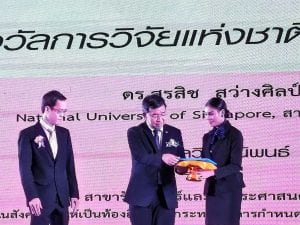


CALL FOR PAPERS - Escaping Kakania Eastern European Travels in Colonial Southeast Asia
Call For Papers | Deadline 5 MARCH 2020
ESCAPING KAKANIA EASTERN EUROPEAN TRAVELS IN COLONIAL SOUTHEAST ASIA
Workshop Date | 16 - 17 November 2020 (to be confirmed) Venue | Faculty of Arts of Social Sciences, National University of Singapore
Selected participants will be invited to a workshop at the National University of Singapore and provided with accommodation (3 nights) and return airfare by the most economical route of up to S$1,200. We aim to publish the final versions of the essays in an edited volume with a reputable publisher.
SUBMISSION Send a title, an abstract (800-900 words), and a brief CV or bio (optionally, include a writing sample, such as a previous publication) to Jan Mrázek at seajm@nus.edu.sg by 5 March 2020. Selected participants will be informed by 1 April 2020. Complete drafts of papers will be due on 1 September 2020. Scholarship on European representations of Southeast Asia in the colonial period largely deals with Western European colonial powers and their particular imagination, political relationships, orientalisms, and racisms. It is on this limited perspective, defined by the empires, that generalizations about “Europe”, “the West”, and “Western” views of “the East”, are usually based. Among the project’s aims is to challenge this perspective and complicate this picture by focusing on the experiences and writings of people who travelled to/in/through colonial Southeast Asia from “Eastern Europe.” We intend to focus mainly, but not exclusively, on nations that were at one time partly or wholly under the rule of the Austrian / Austro-Hungarian empire such as Croatians, Czechs, Hungarians, Poles, Romanians, Serbs, Slovenians, etc. Eastern Europe is characterized by a diversity of histories, geographies, languages, cultures, religions, and literary traditions, a richness that we wish to celebrate. The area is also interlinked through comparable historical experiences and “family resemblances”: Eastern European identities and self-determination were dreamed and struggled for in the margins, or under the rule, of great empires, West and East, which were trying to divide the region among themselves (rather like Western European empires did in Southeast Asia). We focus on nations that did not have colonies, were at times (semi-)colonized (rather like most of Southeast Asia), and were orientalised in Western perspectives. Yet, to see them as merely “marginal” would be to adopt imperial perspectives. They were Europeans who shared much with colonized people in Asia, but who, especially during their travels or stay in Asia, were in various ways dependent on the colonial powers. Some Eastern European travellers wrote of “mixed blood” in characterizing their own (non-)place in colonial society in Asia. Kakania, Robert Musil’s name for the Austro-Hungarian Empire, comes from the designation kaiserlich (und) königlich, “Imperial (and) Royal,” in the imperial language commonly abbreviated to k. k. [pronounced kah-kah], even as kaka- is also the children’s word for “pooping” (in German, Czech, Croatian, etc.). Kakania, the Imperial and Royal / Poo-poo-land refers to the particular Empire – one manner of homeland – but also a state of mind and a way of being. Yet the name is already charged with an attitude toward the Empire – dissent, rebellion or escape, like humour, like a childish giggle. We use Kakania not to delimit scope or impose a framework but to tickle imagination. Escaping Kakania, as travellers did, as the people and nations in the region did over the course of history, should be understood in all its poetic and ironic (im)possibilities and contradictions, forgetting neither the creative and emancipatory desires and unexpected encounters, revelations and transformations that may be part of escaping, nor the ways travellers carry Kakania – along with other dreams and nightmares of homeland – within them, or recognize it in colonial Southeast Asia. For some, that was the ultimate revelation, the ultimate giggle: forever escaping, one never escapes Kakania. The project aims to cross the boundaries of national languages and academic enclaves and stimulate a conversation among scholars from (or working on) different Eastern European and/or Southeast Asian countries. It aims to bring out the richness of experiences and imagination of Eastern European travel (and) writing, and to thematise the particularity of the traveller-writers’ experiences and views of themselves (including their sense of belonging to a nation and their sense of being “European”, “Western”, “Eastern”, “Oriental”, etc.), their views of Southeast Asia and its people (both feelings of otherness and familiarity), of Western Europeans (often as the other Other) and colonialism. At the same time, the project hopes to avoid exoticising Eastern Europe, and simplifying its difference from imperial Western Europe, by highlighting the multiplicity of travellers, countries, and historical situations – including forms of internal colonialism, orientalism, etc. – and by exploring how Eastern Europeans navigated between adopting and deviating from colonial identities, narratives and practices. Our questions include: Why did particular Eastern Europeans travel to Southeast Asia? How did they perceive, feel, think, move around, dress, eat, speak, interact with others or not, choose their company, accommodation, etc.? How did they choose to represent this? How were their views and experiences shaped by their professional, political or religious allegiances? How were the travellers perceived at home and abroad? How did particular Eastern European histories, cultures, languages and literary traditions (such as the narratives, metaphors, tropes or style of humour prevalent in a language/culture), shape travellers’ attitudes, experiences and thoughts in their writings? How do images of/from home and homeland figure in travellers’ imagery? In what ways were Eastern European experiences and representations of Southeast Asia specifically Eastern European, Austro-Hungarian, national, or otherwise local – and/or not? Was there a sense of common fate with the colonized peoples of Southeast Asia, and a recognition of the affinity between Eastern European and Southeast Asian imperialisms? How did they view and engage with colonialists and colonial ideologies of inequality and race? How are the genders and the relations between them represented, and how are they racialized (or not)? To what extent did the travellers conform to colonial behaviour? How did the sea, islands, tropical nature, colonial cities, “civilisation”, etc., figure in the travellers’ imagination? How were their views of themselves, their countries, and the world, affected by their travels? How were they and their countries of origin viewed by Western Europeans and Southeast Asians? What was specific about Southeast Asian localities, peoples and cultures, for the travellers? How do Eastern European perspectives help us to upset or correct existing understanding of “Europe”, European colonialism and racism, as well as European and Southeast Asian modernities? We want the papers to animate, complicate, undermine, and expand these initial questions in surprising ways, based on a close study of literary and historical sources. The themes and focus outlined here suggest the initial concentration of this project, but we welcome proposals that go beyond it (for example, research on “travel accounts” in Southeast Asia by authors who did not physically travel there; on visual artists, photographers, composers, etc.; or work on Southeast Asian perspectives on Eastern Europeans). By “traveller-writer” we mean anyone who travelled to Southeast Asia for work or for personal reasons and wrote about it in any genre (including fiction, poetry, letters, etc.). We focus on the colonial period in Southeast Asia, up to about mid-20th century. We are interested in reflective essays that richly present, analyse and contextualize their material. However, we do not wish to delimit too narrowly the possible approaches, topics and styles. We encourage quotations from primary sources and the incorporation of visual material. We very much welcome contributions escaping the conventions of academic writing, in style, genre (e.g., poetry, fiction), the use of visual material, or digital/online media. Please mention any ideas in your abstract. We are interested in the possibility of papers being complemented by translations of brief examples of /excerpts from primary sources in the resulting publication. When you submit your abstract, please mention if you would be interested in providing such a translation with your paper. CONVENOR Associate Professor Jan Mrázek Department of Southeast Asian Studies, National University of Singapore seajm@nus.edu.sg The workshop is made possible by a grant from the Ministry of Education (FY2019-FRC3-004) and support from the Department of Southeast Asian Studies, National University of Singapore.Voyage Module (Semester 2, AY19/20) – APPLICATIONS CLOSED!
SE3234 Sea, Islands, Vessels: A Voyage of Exploration
 Join an amazing voyage on a classic sailing ship through the Riau Archipelago and along Sumatra’s coast, stopping at many islands, exploring Indonesian multi-ethnic towns, fishing villages, and uninhabited islands. Meet locals and learn about life in island communities – how isolated are they, how connected? How isolated are we? Learn about the history, culture, environment, and economic situation of the fascinating region, also from their perspective.
Join an amazing voyage on a classic sailing ship through the Riau Archipelago and along Sumatra’s coast, stopping at many islands, exploring Indonesian multi-ethnic towns, fishing villages, and uninhabited islands. Meet locals and learn about life in island communities – how isolated are they, how connected? How isolated are we? Learn about the history, culture, environment, and economic situation of the fascinating region, also from their perspective.
Get to know intimately the sea. On kayaks explore lagoons. Experience how it feels to live with fellow sailors in the tiny floating world of the boat. Learn how to sail: hoist sails, keep watch, navigate, read charts, steer the ship. We will have a captain, but we will be the crew!
Application deadline: 25 November 2019. CLOSED
Voyage dates: 22 Feb – 1 March 2020 (Recess Week)
ABOUT THE MODULE (SEM 2, AY2019-20) At the heart of this module is a seafaring voyage. During the voyage as well as at pre- and post-voyage seminars, we will reflect on diverse but inter-related issues in historical and contemporary perspectives: archipelagic spaces and nations; the roles of the sea and boats in Southeast Asia; "sea people" and territory; colonialism and piracy; interrelation between people and natural environment; seafaring as a method of understanding Southeast Asia, and so on. You will be learning both about maritime Southeast Asia in general, but with a focus on the Riau Archipelago in Indonesia (its specific historical, economic, political, cultural, and environmental issues). You will learn the basics of sailing and navigation, as well as basic Indonesian. THE VOYAGE The information provided here is preliminary and subject to change. It assumes that like in the past, we will be able to charter a motor-sailing boat, which is likely but not guaranteed. In case it is not possible, an alternative trip will be organized, probably using ferries. The 9-day voyage in Indonesian archipelagic waters is planned for 22 February to 1 March 2020. You can find pictures and videos from past voyages here: https://www.facebook.com/nusseafarers/ and blogs created by students from a recent voyages here: https://blog.nus.edu.sg/borneoduewest/ and https://blog.nus.edu.sg/ahoyanambas19/ -- although neither the vessel nor the itinerary will be the same. The blog should give you a sense of the kind of documentation we will be doing. More information about the voyage can be found in the Annex of the application form and on LumiNUS. VOYAGE COST Students are expected to pay between S$750 – 850 (programme fee), and will need additional total $200-300 for ferry tickets, meals and other expenses when on land, and pocket money for miscellaneous expenses. Visa fee (where applicable) and additional personal expenses are borne by the student. Singapore Citizen and SPR students are also eligible to obtain some funding support to help defray the cost of the trip. Details for funding support applications will be provided to participants at a later date. APPLICATION
NUS Students can download the application form here: https://mynbox.nus.edu.sg/u/jGdKY39nSl-eZ0pn/SE3234%20Application%20Form.pdf?l
Closing date:
APPLICATION
NUS Students can download the application form here: https://mynbox.nus.edu.sg/u/jGdKY39nSl-eZ0pn/SE3234%20Application%20Form.pdf?l
Closing date: 
Emeritus Professor Award - Professor John Miksic
 Prof John Miksic was conferred the Emeritus Professorship by Provost Prof Ho Teck Hua on 4 October 2019. The award of Emeritus Professorship is conferred to full professors on retirement in recognition of their sustained contributions in to teaching, research and service to NUS. Prof Itty Abraham, Head of the Department of Southeast Asian Studies, read Prof Miksic’s achievements and thanked him for many years of dedicated service in the department, in the presence of the Provost, Dean and many colleagues from the Department of Southeast Asian Studies. After the award ceremony, Prof John Miksic thanked the university, the department, his colleagues and the administrative staffs who have helped him in achieving this honour.
Prof John Miksic was conferred the Emeritus Professorship by Provost Prof Ho Teck Hua on 4 October 2019. The award of Emeritus Professorship is conferred to full professors on retirement in recognition of their sustained contributions in to teaching, research and service to NUS. Prof Itty Abraham, Head of the Department of Southeast Asian Studies, read Prof Miksic’s achievements and thanked him for many years of dedicated service in the department, in the presence of the Provost, Dean and many colleagues from the Department of Southeast Asian Studies. After the award ceremony, Prof John Miksic thanked the university, the department, his colleagues and the administrative staffs who have helped him in achieving this honour.FASS Awards Ceremony 2019
The annual FASS Awards Ceremony celebrates the pursuit of excellence across all domains, academic and non-academic achievements alike. From Special Book Prizes and Gold Medals for high-performing undergraduates to the FASS Student Leadership Award (#FSLA) which rewards leadership in extra-curricular activities, the Faculty’s bid to cultivate well-rounded students is an unceasing one. Our heartiest congratulations our award winners!
- Jennifer Stephanie Silver Benjamin Batson Medal and Prize (Best Graduate Student in Masters of Arts)
- Levonne Goh Yan Xin Kernial Singh Sandhu Prize (Best Southeast Asian Studies Honours in Year 4)
- Jamie Annabelle Lee Tzea Lynn ISEAS-Yusof Ishak Institute Prize (Best Southeast Asian Studies Major in Year 3)
- Koh Tze Yang Special Book Prize in Southeast Asian Studies (Best Southeast Asian Studies Major in Year 2)
New Publication: Cina Timor: Baba, Hakka, and Cantonese in the Making of Timor-Leste by Douglas Kammen and Jonathan Chen
 Douglas Kammen and Jonathan Chen, Cina Timor: Baba, Hakka, and Cantonese in the Making of Timor-Leste, New Haven: Yale University Southeast Asia Studies, 2019
Although they were a tiny minority in the most backward of European colonies, the ethnic Chinese played a critical role in the development of Portuguese Timor and the making of modern Timor-Leste. Against their portrayal either as comprador merchants whose sole concern was profit or as hapless victims of tragically recurrent mass violence, this book explores the diverse origins of the ethnic Chinese in Portuguese Timor — early Hokkien-speaking pioneers whose creole offspring engaged in trade both with and against the colonial state, Hakka-speaking agriculturalists from the Pearl River Delta and Meixian regions of Guangdong, Macanese civil servants in the colonial administration, and Cantonese convicts sent to serve out their sentences on Timor’s distant shores. Drawing on Portuguese and Chinese primary sources, the book traces the intersection of colonial state practices, Chinese associational forms, and republican ideals out of which emerged a distinct identity as Cina Timor — Chinese Timorese.
Douglas Kammen and Jonathan Chen, Cina Timor: Baba, Hakka, and Cantonese in the Making of Timor-Leste, New Haven: Yale University Southeast Asia Studies, 2019
Although they were a tiny minority in the most backward of European colonies, the ethnic Chinese played a critical role in the development of Portuguese Timor and the making of modern Timor-Leste. Against their portrayal either as comprador merchants whose sole concern was profit or as hapless victims of tragically recurrent mass violence, this book explores the diverse origins of the ethnic Chinese in Portuguese Timor — early Hokkien-speaking pioneers whose creole offspring engaged in trade both with and against the colonial state, Hakka-speaking agriculturalists from the Pearl River Delta and Meixian regions of Guangdong, Macanese civil servants in the colonial administration, and Cantonese convicts sent to serve out their sentences on Timor’s distant shores. Drawing on Portuguese and Chinese primary sources, the book traces the intersection of colonial state practices, Chinese associational forms, and republican ideals out of which emerged a distinct identity as Cina Timor — Chinese Timorese.
Learning more about 'protectors' of sultans
 Tuesday, 20 August 2019, Home, The Straits Times
by Melody Zaccheus, Heritage and Community Correspondent
A two-year-long project, led by Dr Mohamed Effendy Abdul Hamid, seeks to uncover the stories and ancient techniques of Bugis warriors whose role was to serve, advise and protect the Malay rulers.
Tuesday, 20 August 2019, Home, The Straits Times
by Melody Zaccheus, Heritage and Community Correspondent
A two-year-long project, led by Dr Mohamed Effendy Abdul Hamid, seeks to uncover the stories and ancient techniques of Bugis warriors whose role was to serve, advise and protect the Malay rulers.New Publication: Hard at Work: Life in Singapore by Gerard Sasges and Ng Shi Wen (Eds.)
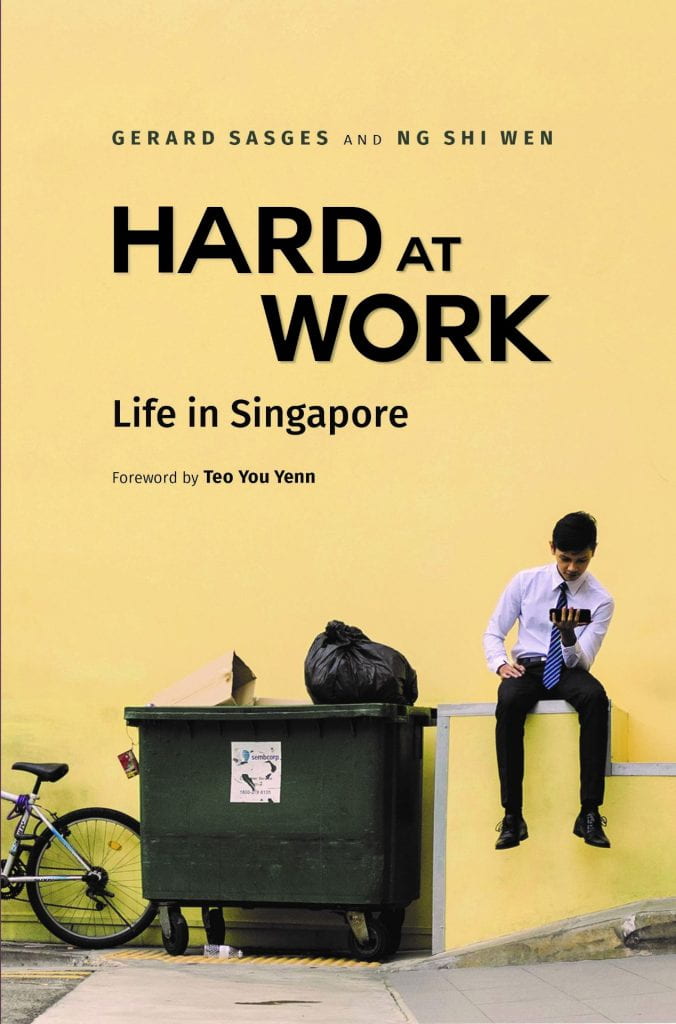 Sasges, Gerard and Ng Shi Wen (eds.), Hard at Work: Life in Singapore, Singapore: NUS Press, 2019
For most of us, work is a basic daily fact of life. But that simple fact encompasses an incredibly wide range of experiences. Hard at Work (2019) takes readers into the day-to-day work experiences of more than fifty working people in Singapore who hold jobs that run from the ordinary to the unusual: from ice cream vendors, baristas, police officers and funeral directors to academic ghostwriters, temple flower sellers, and Thai disco girl agents.
Through first-person narratives based on detailed interviews, vividly augmented with color photographs, Hard at Work reminds us of the everyday labor that continually goes on around us, and that every job can reveal something interesting if we just look closely enough. It shows us too the ways inequalities of status and income are felt and internalized in this highly globalized society.
Sasges, Gerard and Ng Shi Wen (eds.), Hard at Work: Life in Singapore, Singapore: NUS Press, 2019
For most of us, work is a basic daily fact of life. But that simple fact encompasses an incredibly wide range of experiences. Hard at Work (2019) takes readers into the day-to-day work experiences of more than fifty working people in Singapore who hold jobs that run from the ordinary to the unusual: from ice cream vendors, baristas, police officers and funeral directors to academic ghostwriters, temple flower sellers, and Thai disco girl agents.
Through first-person narratives based on detailed interviews, vividly augmented with color photographs, Hard at Work reminds us of the everyday labor that continually goes on around us, and that every job can reveal something interesting if we just look closely enough. It shows us too the ways inequalities of status and income are felt and internalized in this highly globalized society.
NUS NEWS Education - Yeo Tze Yang: Award-winning artist with a heart for SE Asia
By NUS Office of Corporate Relations, Friday 12 July 2019 for NUS News What is an artist to do? Go to art school to perfect his craft, or to a university to enhance his substance? Graduating NUS Southeast Asian Studies student Yeo Tze Yang chose the latter. After spending six years of his education in the Art Elective Programme, honing his skills in photography, videography, digital illustration and fine arts, Tze Yang chose to continue his education at NUS Arts and Social Science to find more fodder for his soul. “It’s not just about art, but it’s about the kind of things I’m interested in as a person, of which art is a big majority. Out of 100, maybe art is 60 or 70; but there’s also this important 30 to 40 per cent that I feel is very crucial. So when I did the Introduction to Southeast Asian Studies module, I found we were looking at things very close to home and very close to my heart,” he said. Tze Yang’s interest in art began at a young age. He remembers a childhood filled with pencils, crayons and paper, and observing his illustrator father do drawings for his job in the advertising industry. This interest eventually led him to join the Art Elective Programme in secondary school, where he was able to explore new mediums of art and nurture his talent. It was his exposure to fine art and art history in junior college that got him into painting. “When I first entered junior college, I was not confident at all. I was struggling. A lot of my classmates entered the programme being quite technically trained in painting and drawing, whereas I was doing design and digital media previously. So I was making all these really messy and experimental paintings, but my teachers didn’t take issue with it,” he recalled. While art was his favourite subject at school, having a very good history teacher in secondary school piqued Tze Yang’s interest in that subject as well. Studying history taught him critical-thinking skills that are important not just for him as an artist, but as a person, he said. Tze Yang began participating in various exhibitions and art fairs in 2013, after he graduated from junior college. His figurative, representational and realistic paintings of familiar scenes in the life of a Singaporean were well received, and are part of private collections in Singapore, Malaysia, the Philippines, Australia, the UK and the USA. In 2016, he was awarded the UOB Painting of the Year Silver Prize for Ah Ma’s Kitchen, a depiction of his grandmother’s kitchen that encapsulates her and her way of life. When the time came for him to choose the next step of his education journey, Tze Yang chose to further his studies at NUS Arts and Social Sciences, trying out a number of introductory modules of various majors before deciding on one. “During my first year I spent a lot of my modular credits doing things I didn’t like, until I did Southeast Asian Studies — the introductory module. I found it so relevant… We had assignments where we had to go to various parts of Singapore to do observational work, interview people and converse with strangers. I felt like there was a very nice human touch to these kinds of things, which were encouraged by the professors. Now that I’m done with my degree, I feel like this was the main takeaway,” he said. Tze Yang focused on the relationship between Singapore and Malaysia for his degree, which put him on the Malay language track. He said learning the language influenced the way he understood things around him, and provided context for understanding the politics and history behind the two countries. His academic interest in Malaysia also brought unexpected benefits for his art — the opportunity to exhibit his works in Kuala Lumpur — twice.
NUS NEWS Research - Prof John Miksic: Unearthing Singapore's forgotten treasures
By NUS Office of Corporate Relations, Friday 21 June 2019 for NUS News Professor John Miksic’s love of archaeology began as a small boy. Growing up on a farm in the United States, his grandfather would often find arrowheads from the Native American Iroquois that used to live there. These artefacts from a different time captivated Prof Miksic’s imagination — “We used to look at them and speculate what it would have been like to live on the same farm, but a thousand years ago.” From these beginnings, Prof Miksic’s journey to become one of the foremost experts on Singapore’s enigmatic history is a something of a surprising one. As an undergraduate, he studied anthropology at Dartmouth College and was fascinated with Eskimos. When he graduated in 1968, he joined the US Peace Corps hoping that he would be deployed in Northeast Asia where Eskimos originated. However, because of Prof Miksic’s farming background, he was sent to Malaysia to work on organising farmers’ cooperatives. It was there that he first experienced the rich archaeological history of Southeast Asia. “I spent two years in Kedah, which turned out to have lots of archaeological sites. There were artefacts from ancient Hindu and Buddhist temples and examples of Chinese pottery. The whole thing entranced me. It was something that I’d never been exposed to,” he said. After leaving the US Peace Corps, Prof Miksic briefly switched fields to international affairs with the aim of going into the diplomatic service. However, the pull of Southeast Asian archaeology proved too strong and he returned in 1974, receiving a Fulbright scholarship from Cornell University to conduct a PhD project in Sumatra. By the time he had completed his PhD, Prof Miksic was fluent in Indonesian, and after two years at the US Agency for International Development in Bencoolen, he was offered a job teaching Archaeology at Gadjah Mada University in Yogyakarta, Indonesia with support from the Ford Foundation and Asia Research Council. Rediscovering a bygone Singapore After a number of years at the university, he was invited to Singapore to conduct an archaeological test excavation. This was to be the first ever excavation performed in Singapore and Prof Miksic chose Fort Canning as the site. He explained, “We excavated on Fort Canning because there was a legend that there had been an ancient palace there. And, lo and behold, we actually found a 14th century layer that was still preserved!” When describing how it felt, he said, “It was tense. Honestly, I really thought the chances were slim of finding anything, let alone things that were still undisturbed after 700 years, but we did! It was amazing and a real stroke of luck. You just can’t predict what’s going to happen, but you have to try. That’s what archaeology is.” After the successful dig, Prof Miksic was offered a fulltime position at NUS in 1987, which he gladly accepted and he has worked here ever since. He is now a Professor at NUS Southeast Asian Studies. When looking back on his career and what factors led him to this point, he said, “I never planned any of it. I was just going with the flow.”
Javanese Gamelan for Beginners Workshop
The NUS Singa Nglaras Gamelan Ensemble will be conducting a Javanese Gamelan for Beginners Workshop on 20 July 2019. Limited places available. Please email to SingaNglaras@gmail.com to register.
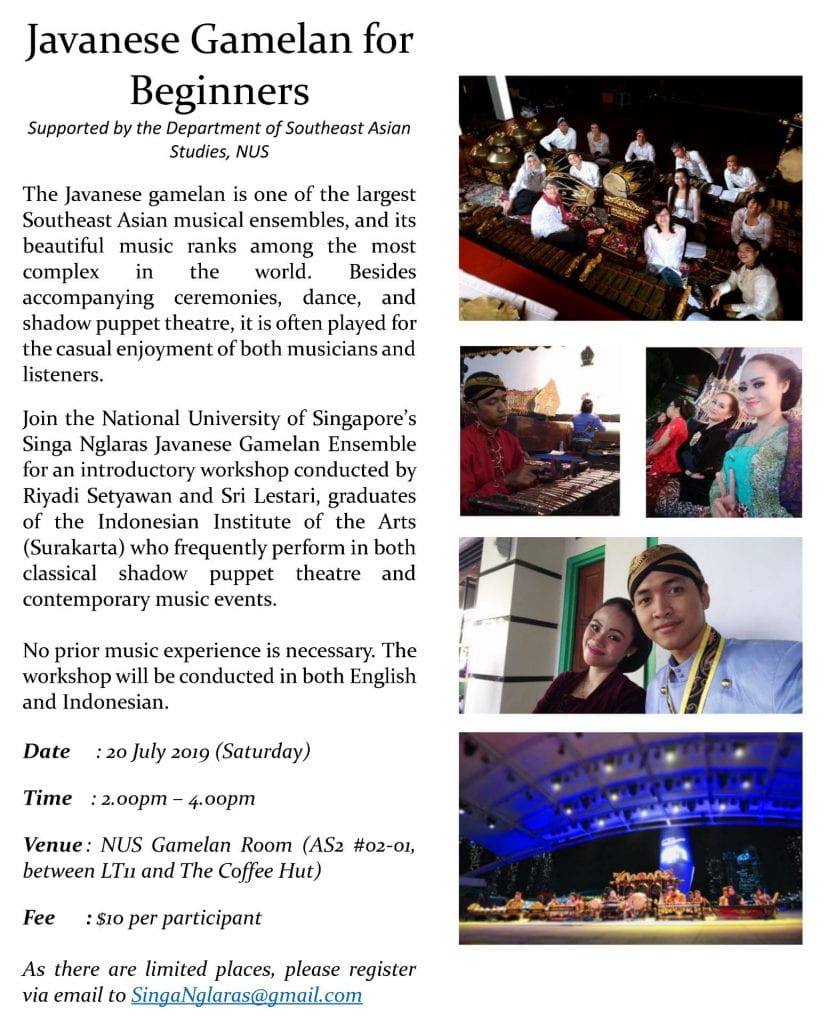
New Publication: Wayang and Its Doubles: Javanese Puppet Theatre, Television and the Internet by Jan Mrazek
 Mrazek, Jan, Wayang and Its Doubles: Javanese Puppet Theatre, Television and the Internet, Singapore: NUS Press, 2019
Much has been said about how Javanese puppet theatre, wayang kulit, richly reflects the Javanese world, and how changes and tensions in performance practice mirror those in culture and society. For decades, television has been as intensely part of the Javanese world as wayang. This book explores the ways two complex media and modes of being, seeing and fantasizing, with their different cultures, coexist and meet, and haunt or invade each other. It is what a Javanese commentator calls a “difficult marriage”: intimate on the one hand, deeply alienating on the other, institutionalized yet at the same time mercurial and shifting.
This encounter is explored on many levels: from performance aesthetics and the technicalities of television production, to issues of time, space, light, place, and movement, to audience experience of live and televised performances, to the collaboration and struggle between performers and television producers. Central to the book are personal perspectives and experiences, as well as Javanese discussions surrounding the interaction between wayang and television and their cultures.
They are brought into a conversation with reflections on media and technology by writers such as Karl Marx, Martin Heidegger, Maurice Merleau-Ponty, Jacques Derrida, Paul Virilio, and James Siegel. Wayang’s relationship with television is considered in the context of the theatre’s intercourse with older and newer media, including electricity, radio, audio- and video-recording, the internet and social media.
Mrazek, Jan, Wayang and Its Doubles: Javanese Puppet Theatre, Television and the Internet, Singapore: NUS Press, 2019
Much has been said about how Javanese puppet theatre, wayang kulit, richly reflects the Javanese world, and how changes and tensions in performance practice mirror those in culture and society. For decades, television has been as intensely part of the Javanese world as wayang. This book explores the ways two complex media and modes of being, seeing and fantasizing, with their different cultures, coexist and meet, and haunt or invade each other. It is what a Javanese commentator calls a “difficult marriage”: intimate on the one hand, deeply alienating on the other, institutionalized yet at the same time mercurial and shifting.
This encounter is explored on many levels: from performance aesthetics and the technicalities of television production, to issues of time, space, light, place, and movement, to audience experience of live and televised performances, to the collaboration and struggle between performers and television producers. Central to the book are personal perspectives and experiences, as well as Javanese discussions surrounding the interaction between wayang and television and their cultures.
They are brought into a conversation with reflections on media and technology by writers such as Karl Marx, Martin Heidegger, Maurice Merleau-Ponty, Jacques Derrida, Paul Virilio, and James Siegel. Wayang’s relationship with television is considered in the context of the theatre’s intercourse with older and newer media, including electricity, radio, audio- and video-recording, the internet and social media.Sea storms that could have cut short Singapore's port history
Wednesday, 24 April 2019, Straits Times Online by Melody Zaccheus, Heritage and Community Correspondent Singapore, a renowned ancient port for Asian trade, could have failed numerous times after Sir Stamford Raffles' arrival. The Dutch could have attacked and wiped out the outpost; pirates could have driven merchants away; and a blight which wiped out nutmeg plantations could have spelt Singapore's end. Even the advent of steam power could have changed sea routes, negating Singapore's importance. In a speech yesterday, Senior Minister of State for Defence and Foreign Affairs, Dr Maliki Osman, who opened a two-day conference on ancient harbours at the National University of Singapore (NUS), said: "At each critical point, Singapore could have taken a wrong turn and been replaced by another port located somewhere between Jakarta and Penang or Aceh." Dr Maliki said there are lessons that can be learnt from history which can serve as a guide to what the future might become. "Old frameworks and networks are now under pressure, and new ideas have to be found to keep them working and become even more efficient. This is one instance where greater understanding of the past may help people of the present to stand by their convictions in the face of negative criticism and figure out how to keep alive the values which have sustained the Silk Road of the sea for 2,000 years. The conference Singapura Before Raffles: Archaeology And The Seas, 400BCE-1600CE has been organised by the NUS Department of South-east Asian Studies, supported by the National Heritage Board, in support of Singapore's bicentennial. It is the second conference on ancient harbours to be held in Singapore after the first one in 2004. Selected papers from the event will be compiled into a publication. The conference, attended by about 180 people, brings together 18 international scholars to present their latest research on the subject of pre-colonial Singapore and its links to the maritime trade network. The speakers will cover the themes of economy, technology and social context of early South-east Asian maritime trade; the origins and growth of maritime networks in the South China Sea and the Bay of Bengal and shipwrecks in the South China Sea and Java Sea which carried cargo between different parts of the region. Singapore and nearby sea lanes played a critical role in the formation of a network which, by 400BCE, had already spanned the coasts from north-east Africa to the western Pacific Ocean, noted the conference convenor, archaeologist John Miksic, who also gave the keynote address. He added that archaeological research is one of the few ways to uncover information about this network. Dr Maliki added: "We now know more about 14th-century Singapore than any other port of the period in South-east Asia... We are only now coming to appreciate the extent to which Singapore and the Strait of Malacca have been a major contributor to the world maritime trading system." Dr Maliki said he hopes the conference will succeed in stimulating further research and collaboration between scholars working on sea trade. "I also hope Singapore will continue to build on its position as a centre of maritime trade to develop a better understanding of how seaports have evolved over the centuries." The conference is timely for the island's bicentennial, said Dr Miksic. "It helps to demonstrate that Singapore's reason for becoming successful again during the colonial era was because people living around it believed it could be. They had faith and confidence, and were really happy it was being re-established outside of the Dutch sphere without being encumbered by monopolies and taxes and so on. "Singapore went on to encourage freedom of trade and globalisation at that time. It shows that, given the right people and the right policies, Singapore can continue to be stable and play this role despite not being big in terms of geography or population or resources."
Study on life of ex-villagers on Southern Islands
 Friday, 29 March 2019, Home, The Straits Times
by Melody Zaccheus, Heritage and Community Correspondent
Two-year project documents heritage and little-known stories from former islanders.
Friday, 29 March 2019, Home, The Straits Times
by Melody Zaccheus, Heritage and Community Correspondent
Two-year project documents heritage and little-known stories from former islanders.New Publication: Independent Timor-Leste Between Coercion and Consent by Douglas Kammen
 Kammen, Douglas, Independent Timor-Lest Between Coercion and Consent, UK: Cambridge University Press, 2019.
This Element explores the primary modes by which rulers have exercised power and shaped political relations in Timor-Leste across four distinct periods. The contrast between coercion under colonial rule and consent expressed through the 1999 referendum on independence exerted a powerful influence on scholarship on Timor-Leste's politics and future. Since the restoration of independence in 2002, however, politics in Timor-Leste are best understood in terms of powerful economic constraints during the first Fretilin government (2002–06), and thereafter, thanks to revenue from the country's petroleum reserves, a ruling strategy based on a wide range of inducements (rather than genuine consent).
Kammen, Douglas, Independent Timor-Lest Between Coercion and Consent, UK: Cambridge University Press, 2019.
This Element explores the primary modes by which rulers have exercised power and shaped political relations in Timor-Leste across four distinct periods. The contrast between coercion under colonial rule and consent expressed through the 1999 referendum on independence exerted a powerful influence on scholarship on Timor-Leste's politics and future. Since the restoration of independence in 2002, however, politics in Timor-Leste are best understood in terms of powerful economic constraints during the first Fretilin government (2002–06), and thereafter, thanks to revenue from the country's petroleum reserves, a ruling strategy based on a wide range of inducements (rather than genuine consent).Singapore bicentennial: An Island's Journey
 Sunday, 27 January 2019, Insight, The Sunday Times
by Melody Zaccheus, Heritage and Community Correspondent
WHY 2019 IS HISTORY IN THE MAKING
The arrival of the British in 1819 set in motion Singapore's development into a trading port and modern metropolis. Insight looks at the significance of the bicentennial, and how it marks a chance to more fully appreciate Singapore's rich history before then.
Sunday, 27 January 2019, Insight, The Sunday Times
by Melody Zaccheus, Heritage and Community Correspondent
WHY 2019 IS HISTORY IN THE MAKING
The arrival of the British in 1819 set in motion Singapore's development into a trading port and modern metropolis. Insight looks at the significance of the bicentennial, and how it marks a chance to more fully appreciate Singapore's rich history before then.New Voyage Module (Semester 3, AY18/19) - APPLICATIONS CLOSED
SE3234 Sea, Islands, Vessels: A Voyage of Exploration
 ABOUT THE MODULE
At the heart of this module is a sailing voyage. We will visit coastal/island communities, explore marine environment, and experience life at sea and on remote islands. During that time, as well as at pre- and post-voyage seminars, we will reflect on diverse but inter-related issues in historical and contemporary perspectives: the roles of the sea and boats in Southeast Asia; archipelagic spaces and nations; "sea people" and territory; colonialism; piracy; interrelation between people and natural environment; ships and the sea in myths, narratives, and visual culture; seafaring as a method of understanding Southeast Asia, and so on.
The module will take place during Semester 3 (13 May - 21 June 2019). There will be seminar-type classes during the first weeks, followed by a 10-12 day voyage in the later part of the semester (i.e., in the first half of June). In the pre-voyage seminars, students will learn about sea, islands and vessels, as well as basic Indonesian, basics of seamanship, and together we will plan the voyage and its creative documentation. We may also go on local fieldtrips. There will be no final exam; focus will be on participation and individual and collective projects.
LEARNING OUTCOME
Students will gain a new perspective on our region – from the sea --, experiencing and learning about places, communities, ways of life, and cultural/economic links that they would be unlikely to get to know otherwise. They also gain a first-hand experience of the sea and seafaring: the seascape alive with currents and tides, the changing wind and weather, the life in the miniature world of the boat. The destruction and preservation of natural environment is another pressing issue, whose urgency is seen when one sails in Southeast Asia. Each year, the voyage may have a different itinerary or explore a different maritime/archipelagic area (e.g., Riau Archipelago in Indonesia, islands in Southern Thailand, or parts of the Philippines). Students will be learning both about maritime Southeast Asia in general, and – as a kind of case study – with focus on the particular region to be explored (its specific historical, economic, political, cultural, and environmental issues). Additionally, students will learn the basics of sailing and navigation, which will enhance their understanding of sea and seafaring.
THE FIELDTRIP
It assumes that we will be able to charter a motor-sailing boat, which is most likely but not guaranteed. In case it is not possible, an alternative trip will be organized, probably using ferries. Please see the Annex in the Application Form for important preliminary information about the fieldtrip.
You can find pictures and videos from past voyages here: https://www.facebook.com/nusseafarers/ and a blog created by students from a recent voyage here: https://blog.nus.edu.sg/borneoduewest/. Neither of these voyages were part of a module, but the FB page and the blog should still give you some idea about the planned voyage. Moreover, the blog should give you a sense of the kind of documentation we will be doing.
FIELDTRIP COST
Students are expected to pay a sum of S$1,200 to S$1,600. Visa fee (where applicable) and additional personal expenses are borne by the student.
Singapore Citizen and SPR students are also eligible to obtain funding support up to S$500 from the NUS Global Relations Office to help defray the cost of the trip. In addition, Singapore Citizens and SPR students who are not in their last semester can apply for an additional $800 subsidy (YTP). Details for funding support applications will be provided to participants at a later date.
APPLICATION
NUS Students can download the application form here: https://bit.ly/2JOx6zn (Sign in with your nus student email, i.e. e01234567@u.nus.edu.sg). Complete application form are to be submitted via email to fasbox59@nus.edu.sg by the stated deadline.
Closing date:
ABOUT THE MODULE
At the heart of this module is a sailing voyage. We will visit coastal/island communities, explore marine environment, and experience life at sea and on remote islands. During that time, as well as at pre- and post-voyage seminars, we will reflect on diverse but inter-related issues in historical and contemporary perspectives: the roles of the sea and boats in Southeast Asia; archipelagic spaces and nations; "sea people" and territory; colonialism; piracy; interrelation between people and natural environment; ships and the sea in myths, narratives, and visual culture; seafaring as a method of understanding Southeast Asia, and so on.
The module will take place during Semester 3 (13 May - 21 June 2019). There will be seminar-type classes during the first weeks, followed by a 10-12 day voyage in the later part of the semester (i.e., in the first half of June). In the pre-voyage seminars, students will learn about sea, islands and vessels, as well as basic Indonesian, basics of seamanship, and together we will plan the voyage and its creative documentation. We may also go on local fieldtrips. There will be no final exam; focus will be on participation and individual and collective projects.
LEARNING OUTCOME
Students will gain a new perspective on our region – from the sea --, experiencing and learning about places, communities, ways of life, and cultural/economic links that they would be unlikely to get to know otherwise. They also gain a first-hand experience of the sea and seafaring: the seascape alive with currents and tides, the changing wind and weather, the life in the miniature world of the boat. The destruction and preservation of natural environment is another pressing issue, whose urgency is seen when one sails in Southeast Asia. Each year, the voyage may have a different itinerary or explore a different maritime/archipelagic area (e.g., Riau Archipelago in Indonesia, islands in Southern Thailand, or parts of the Philippines). Students will be learning both about maritime Southeast Asia in general, and – as a kind of case study – with focus on the particular region to be explored (its specific historical, economic, political, cultural, and environmental issues). Additionally, students will learn the basics of sailing and navigation, which will enhance their understanding of sea and seafaring.
THE FIELDTRIP
It assumes that we will be able to charter a motor-sailing boat, which is most likely but not guaranteed. In case it is not possible, an alternative trip will be organized, probably using ferries. Please see the Annex in the Application Form for important preliminary information about the fieldtrip.
You can find pictures and videos from past voyages here: https://www.facebook.com/nusseafarers/ and a blog created by students from a recent voyage here: https://blog.nus.edu.sg/borneoduewest/. Neither of these voyages were part of a module, but the FB page and the blog should still give you some idea about the planned voyage. Moreover, the blog should give you a sense of the kind of documentation we will be doing.
FIELDTRIP COST
Students are expected to pay a sum of S$1,200 to S$1,600. Visa fee (where applicable) and additional personal expenses are borne by the student.
Singapore Citizen and SPR students are also eligible to obtain funding support up to S$500 from the NUS Global Relations Office to help defray the cost of the trip. In addition, Singapore Citizens and SPR students who are not in their last semester can apply for an additional $800 subsidy (YTP). Details for funding support applications will be provided to participants at a later date.
APPLICATION
NUS Students can download the application form here: https://bit.ly/2JOx6zn (Sign in with your nus student email, i.e. e01234567@u.nus.edu.sg). Complete application form are to be submitted via email to fasbox59@nus.edu.sg by the stated deadline.
Closing date: Job Vacancy: Associate Professor/Professor - 1 position
The National University of Singapore is seeking to fill a senior position in the Department of Southeast Asian Studies. We are particularly interested in recruiting scholars who will enjoy the opportunity of working collaboratively with colleagues from different disciplines in a leading area studies department at a highly ranked university. The Department seeks applications from Associate Professors and Full Professors who specialise in one or more of the following fields: gender and sexuality studies; urban studies; new media studies. The geographical focus of the position is mainland Southeast Asia (especially Myanmar, Malaysia, Laos and Cambodia). The successful candidate will be expected to teach undergraduate and graduate classes in their area(s) of specialisation as well as to have an active research agenda. The normal teaching load is three modules (courses) spread over two semesters. Candidates should show evidence of a strong publication record, have received at least one competitive external grant or fellowship, and have at least 7 years of teaching experience. Leadership experience would be a plus but is not required. Ideally, we would like the successful candidate to begin their appointment in 2019. Interested candidates should submit an application packet consisting of the following:
- a cover letter
- up-to-date CV
- a statement describing their research trajectory thus far and future plans
- a statement describing their teaching philosophy, and
- contact details for 3 referees
Exhibition site of Fort Canning archaeological dig to be refreshed for first time in 17 years
Sunday, 28 October 2018, Straits Times Online SINGAPORE - The exhibition site of an archaeological dig at Fort Canning Park will be updated for the first time in 17 years, the National Parks Board (NParks) announced on Sunday (Oct 28). As recently as the past few months, artefacts such as thousands of glass beads from China's Yuan Dynasty, as well as earthenware and stoneware, have been found at the historically significant site, which is believed to have housed a 14th century palace workshop. The enhancements will include more hands-on interactive spaces, such as a sand pit for simulated archaeological activities, as well as an open space for workshops. Information panels on the soil layers at the site and artefacts found there will also be updated. These multimedia educational panels on the artefacts, including recent discoveries, will give a glimpse of what life on the hill was like. The site, which will also include a new outdoor garden, will be closed from November and reopened in June 2019. The improved features of the Archaeological Dig exhibition are part of enhancement plans announced by NParks in February. The park will be the venue of the main showcase for Singapore's bicentennial next year. "We hope to cultivate interest in the heritage of this hill," said Mr Wong Tuan Wah, NParks' group director for Fort Canning Park and Istana. An archaeological dig at the site near the park's Spice Garden ended on Sunday. Organised by NParks, in partnership with veteran archaeologist Professor John Miksic from National University of Singapore, as well as Nanyang Technological University's Associate Professor Goh Geok Yian, the dig explored portions that had been left intact during earlier excavations. The team started their dig on Sept 2. At around noon on Sunday, the archaeological team found a rare piece of Thai ceramic. It is only the second such piece found in the area. Prof Miksic said it points to interactions between Temasek, as Singapore was once known, and Thailand in the 14th century. Prof Goh added: "It's important for Singaporeans to think about being part of South-east Asia. Most students often think that Singapore doesn't have a long history, beyond 200 years ago."
Borneo Due West: A Post-Voyage Presentation & Exhibition
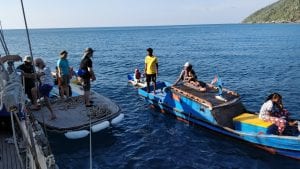 The past summer break, a motley crew comprising students, alumni, and professors from the National University of Singapore set sail on a schooner named Four Friends, heading west from the large island of Borneo (from Pontianak) to remote islands in the South China Sea and further west to Bintan, which lies just south of our remote island, Singapore.
After the eventful sea voyage, the crew now presents a visual exhibition and creative presentation based on the places visited and encounters with our distant neighbours.
PRESENTATION (5 November, 6:30pm @ NUS AS8 #06-46)
Join the crew as they bring you back out to sea and recap thier voyage through bite-sized presentations. Highlights of the expedition include encounters with the spirit world, marriage proposals that came their way, and conversations they had with locals at sea and on land about how we are more connected than we realise.
Through the presentations, steered by sailors with a sailing resume of anywhere between 2 weeks to 70 years, they invite you to explore the possibilities of seafaring in navigating the world we live in.
They will also be recreating the sensory experiences of being on board Four Friends. Learn how to cut and apply aloe vera the OG way, soap up with seawater, and find out what foods are suitable for life out at sea. Be warned… bring your pills for seasickness!
EXHIBITION (5-16 November @ NUS AS8 Level 2)
The presentation will also kick off a two-week long exhibition which will transform the vast expanse of AS8 Level 2 into a map of the part of the South China Sea they drifted through. Playing on the notion of scale, perspective, and distance, they invite all to navigate through a projection of their journey. You can engage with the map by viewing up close photos curated from the voyage through various archipelagos. Otherwise, you may also enjoy a bird’s eye view of the map two floors up from bridges at AS8 Level 3 or Level 4.
A guided tour through the islands will be taking place at 8pm on 5th November 2018 at the end of our presentation. Allow the crewmates to welcome you on deck!
‘Borneo Due West’ is a sailing trip in June 2018 organised by the Department of Southeast Asian Studies at the National University of Singapore. It was planned and lead by two scholars of Indonesian culture and society -- Associate Professor Jan Mrázek together with Assistant Professor Miguel Escobar, and skippered by Captain Warren Blake who has thus far logged over 70 years of sailing.
The voyage was also organised with support from the Provost Office and the Global Relations Office, NUS.
The past summer break, a motley crew comprising students, alumni, and professors from the National University of Singapore set sail on a schooner named Four Friends, heading west from the large island of Borneo (from Pontianak) to remote islands in the South China Sea and further west to Bintan, which lies just south of our remote island, Singapore.
After the eventful sea voyage, the crew now presents a visual exhibition and creative presentation based on the places visited and encounters with our distant neighbours.
PRESENTATION (5 November, 6:30pm @ NUS AS8 #06-46)
Join the crew as they bring you back out to sea and recap thier voyage through bite-sized presentations. Highlights of the expedition include encounters with the spirit world, marriage proposals that came their way, and conversations they had with locals at sea and on land about how we are more connected than we realise.
Through the presentations, steered by sailors with a sailing resume of anywhere between 2 weeks to 70 years, they invite you to explore the possibilities of seafaring in navigating the world we live in.
They will also be recreating the sensory experiences of being on board Four Friends. Learn how to cut and apply aloe vera the OG way, soap up with seawater, and find out what foods are suitable for life out at sea. Be warned… bring your pills for seasickness!
EXHIBITION (5-16 November @ NUS AS8 Level 2)
The presentation will also kick off a two-week long exhibition which will transform the vast expanse of AS8 Level 2 into a map of the part of the South China Sea they drifted through. Playing on the notion of scale, perspective, and distance, they invite all to navigate through a projection of their journey. You can engage with the map by viewing up close photos curated from the voyage through various archipelagos. Otherwise, you may also enjoy a bird’s eye view of the map two floors up from bridges at AS8 Level 3 or Level 4.
A guided tour through the islands will be taking place at 8pm on 5th November 2018 at the end of our presentation. Allow the crewmates to welcome you on deck!
‘Borneo Due West’ is a sailing trip in June 2018 organised by the Department of Southeast Asian Studies at the National University of Singapore. It was planned and lead by two scholars of Indonesian culture and society -- Associate Professor Jan Mrázek together with Assistant Professor Miguel Escobar, and skippered by Captain Warren Blake who has thus far logged over 70 years of sailing.
The voyage was also organised with support from the Provost Office and the Global Relations Office, NUS.
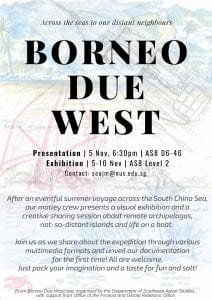
Love and Betrayal in Balingkang (Friday, 16 November 2018, 7:00pm)
The Department of Southeast Asian Studies presents “Love and Betrayal in Balingkang“, The story of King Sri Jayapangus and his Chinese wife, performed by students of SE3230 Seen and Unseen: Explorations in Balinese Theatre. Synopsis: Prembon was first performed in Bali in 1942 and combines some of the quintessential elements of Bali’s most famous theatrical genres – topeng (masked drama), gambuh (classical drama) and arja (sung opera). Prembon performances narrate stories from Balinese history and include dance, singing, narration, drama and comedy. All Prembon performances are accompanied by a full Balinese gamelan ensemble. The story is taken from the Babad Bali/Dalem – the chronicles of the Kings of Bali. It tells of King Sri Jaya Pangus (1181-1269), ruler of Pejeng (currently a small town near Ubud) who was from the Warmadewa dynasty. He had fallen in love with Kang Ching Wie, the daughter of the Subandar Cina (Chinese port administrator). Their marriage was opposed by the court priest, Begawan Siwagana who believed that Sri Jaya Pangus was going against the rules of the royal house by marrying a non-Hindu non-Balinese. Angered by Sri Jaya Pangus’ stubborn refusal to call off the marriage, he cursed the kingdom with heavy rain and floods. Sri Jaya Pangus decides to leave Pejeng and establish his own kingdom called Balingkang (named after Bali + Kang, his wife’s family name). Despite having been married for a long time, Kang Ching Wie did not produce children and Sri Jaya Pangus decided to meditate and seek help from the gods so his wife could conceive. He travelled up the slopes of the Mountain Batur. It was here that he met Dewi Danu, the goddess of Lake Batur. Sri Jaya Pangus fell in love with Dewi Danu, never telling her about Kang Ching Wie. Dewi Danu had a son with the king whom they named Mayadenawa. Kang Ching Wie waited patiently for her husband to return but he never did. She eventually decided to search for him on Mount Batur. When she found out that he was with Dewi Danu, Kang Ching Wie was devastated. Dewi Danu was angered at the betrayal she felt as Sri Jaya Pangus had never informed her of his wife. In a fit of anger, she made both Sri Jaya Pangus and Kang Ching Wie disappear from the face of the earth. The residents of Balingkang who loved their king and queen, made two giant puppets (barong landing) to remind themselves of their rulers. Performers: There will be musicians from Bali and dancers accompanying the NUS students in this 2 hour production. Tickets: Priced at $15 each. They can be bought at the official booth set up along the Central Library Walkway and online via http://bit.ly/balingkang. Be sure to join us for Singapore’s first ever Prembon performance on Friday 16 November 2018 at 7.00pm at LT13

Learning outside the Classroom - Prof John N Miksic
Prof John N Miksic was recently featured in the NUS Centre For the Arts 25th Anniversary Commemorative Publication. Check it out here.


 "The NUS Museum makes it possible for me to add a whole new dimension to my teaching. The NUS Museum is always an integral part of my summer school class SE22n Southeast Asian Social History: Archaeology, Cultural Heritage and Tourism. The exhibition Between Here & Nanyang: Marco Hsu's Brief History of Malayan Art (2013-2016), on the history of Singapore art over the last 50 years fits perfectly with my attempts to get students to think about the various currents, which have influenced the evolution of a Singaporean identity from the late colonial period until today. No other institution in Singapore provides such an art historical perspective on Singapore and the region as NUS Museum."
-Professor John Miksic
NUS Faculty of Arts and Social Sciences,
Department of Southeast Asian Studies
"The NUS Museum makes it possible for me to add a whole new dimension to my teaching. The NUS Museum is always an integral part of my summer school class SE22n Southeast Asian Social History: Archaeology, Cultural Heritage and Tourism. The exhibition Between Here & Nanyang: Marco Hsu's Brief History of Malayan Art (2013-2016), on the history of Singapore art over the last 50 years fits perfectly with my attempts to get students to think about the various currents, which have influenced the evolution of a Singaporean identity from the late colonial period until today. No other institution in Singapore provides such an art historical perspective on Singapore and the region as NUS Museum."
-Professor John Miksic
NUS Faculty of Arts and Social Sciences,
Department of Southeast Asian StudiesFaculty Teaching Excellence Award (FTEA) 2018
Congratulations to Dr Oona Paredes on being awarded the FASS Faculty Teaching Excellence Award (FTEA) 2018 for her work in AY2017/2018. Well done Dr Oona!
Fresh dig to unearth Singapore History
Veteran archaeologist to conduct six-week dig at Fort Canning.
Saturday, 1 September 2018, Straits Times The lives of Singapore's ancient rulers and people who worked in the royal Malay palace at Fort Canning Hill are being probed further by a pair of archaeologists. Speaking to The Straits Times, veteran archaeologist John Miksic, 71, said he will be co-leading an excavation at the historic Fort Canning Park for six weeks from this weekend with Associate Professor Goh Geok Yian, 46. It will be Professor Miksic's 13th dig at the park. The National Parks Board invited Prof Miksic to conduct the dig as part of its overall restoration works at Fort Canning Park. This comes in the lead-up to Singapore's bicentennial next year. The park will be the venue of the main bicentennial showcase. The archaeologists will be assisted by a team of students and volunteers as they work in a large 10m by 5m pit near the park's Spice Garden. The area, which is also near the Registry of Marriages and the Keramat Iskandar Shah, has been interpreted as a 14th-century palace workshop after an earlier discovery of a "large charcoal feature" where iron tools were likely used. Archaeologists had also found thousands of glass beads as well as small fragments of gold and clay crucibles at the site. On the upcoming excavation, Prof Miksic said: "It is a significant site because it has the densest concentration of 14th-century artefacts in undisturbed soil anywhere on Fort Canning. We are likely to find a mixture of Chinese, Malay, South-east Asian, and Indian artefacts. The only question is whether we will find any new kinds of objects which we have not found before." The hill was once home to what was likely a large palatial complex dating back to the 14th century. A keramat or shrine was also located there - it was named after the last king of Singapura, Sri Sultan Iskandar Shah. He spent three years as king of Singapura before the island was invaded by the Majapahit empire at the turn of the 15th century. When Singapura fell, Iskandar Shah fled to Johor and eventually founded Melaka. According to Prof Miksic's book, Singapore And The Silk Road Of The Sea, 1300-1800, an initial dig at Fort Canning in 1984 ascertained that the hill had been occupied in the 14th century. Pottery made in China during its Yuan dynasty was discovered there. Next year, a dedicated heritage museum is set to open at the three-storey conserved Fort Canning Centre, and will include artefacts dug up from Prof Miksic's earlier excavations there. Archaeologist Lim Chen Sian said: "It's a very large hill so the excavations conducted there so far are only the tip of the iceberg. There is potential to find more materials from the Temasek period. It would be nice to look back in time in the lead-up to the bicentennial." By Melody Zaccheus, Heritage and Community Correspondent for The Straits TimesFASS Awards Ceremony 2018
The annual FASS Awards Ceremony celebrates the pursuit of excellence across all domains, academic and non-academic achievements alike. From Special Book Prizes and Gold Medals for high-performing undergraduates to the FASS Student Leadership Award (#FSLA) which rewards leadership in extra-curricular activities, the Faculty’s bid to cultivate well-rounded students is an unceasing one. Our heartiest congratulations our award winners! 1. Talisa Kaur Dhaliwal Benjamin Batson Medal and Prize Best Graduate Student in Master of Arts (Southeast Asian Studies) 2. Tan Zi Hao Honour Roll Graduate Student Teaching Awards 3. Seri Ariyani Bte Zulfakili Kernial Singh Sandhu Prize Best Student in Southeast Asian Studies in Honours Examination 4. Levonne Goh Yan Xin ISEAS-Yusof Ishak Institute Prize Best Student in Southeast Asian Studies in Year 3 5. Jamie Annabelle Lee Tzea Lynn Special Book Prize (Southeast Asian Studies)
New Publication: After Heritage: Critical Perspectives on Heritage from Below by Hamzah Muzaini and Claudia Minca (eds.)
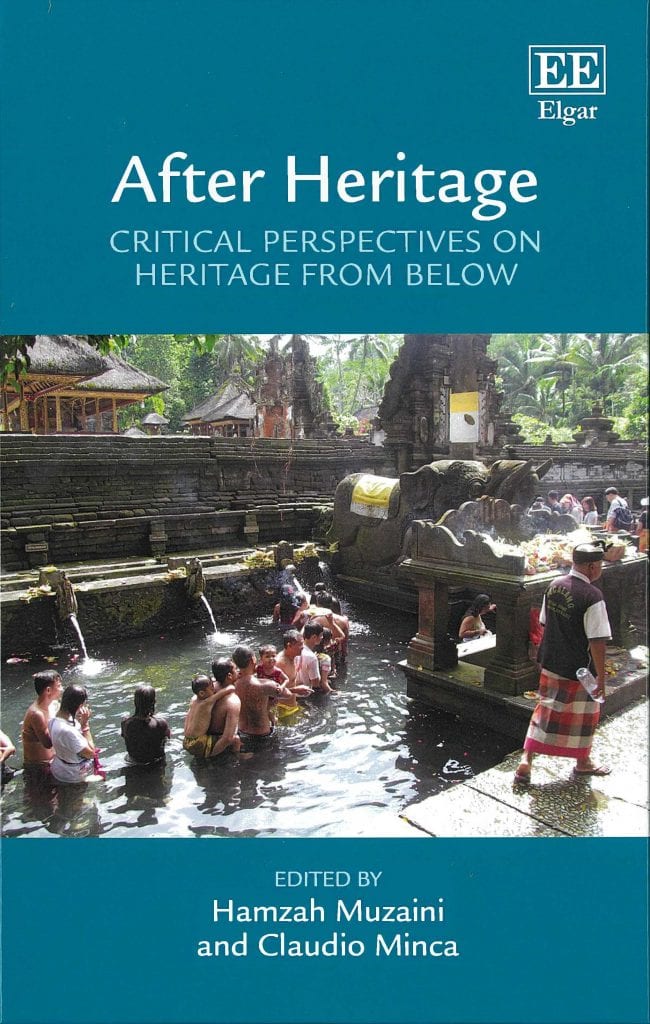 Muzaini, Hamzah and Claudia Minca (eds.), After Heritage: Critical Perspectives on Heritage from Below, UK and US: Edward Elgar Publishing, 2018
Focusing on the practices and politics of heritage-making at the individual and the local level, this book uses a wide array of international case studies to argue for their potential not only to disrupt but also to complement formal heritage-making in public spaces. Providing a much-needed clarion call to reinsert the individual as well as the transient into more collective heritage processes and practices, this strong contribution to the field of Critical Heritage Studies offers insight into benefits of the ‘heritage from below approach’ for researchers, policy makers and practitioners.
Muzaini, Hamzah and Claudia Minca (eds.), After Heritage: Critical Perspectives on Heritage from Below, UK and US: Edward Elgar Publishing, 2018
Focusing on the practices and politics of heritage-making at the individual and the local level, this book uses a wide array of international case studies to argue for their potential not only to disrupt but also to complement formal heritage-making in public spaces. Providing a much-needed clarion call to reinsert the individual as well as the transient into more collective heritage processes and practices, this strong contribution to the field of Critical Heritage Studies offers insight into benefits of the ‘heritage from below approach’ for researchers, policy makers and practitioners.The first Archaeologist in the Lion City.
 By Chua Wei Qian
By Chua Wei Qian
2,000 artifacts excavated in 10 days.
Thursday, 11 May 2018, Lianhe Wanbao He has been referred to as Singapore's Indiana Jones, and ever since 34 years ago when 2,000 artifacts were excavated within the short span of 10 days while conducting archaeological excavation at Fort Canning, he had become the first archaeologist to have conducted archaeological work in Singapore and thus marked the beginning of archaeology in the island nation. 71 years old this year, John N. Miksic comes from the USA and as Singapore in the 1980s did not have any local archaeologists, he was the first expert to be invited to carry out archaeological research here. Miksic led the 1984 National Museum first archaeological excavation at Fort Canning, He later came to settle and work in Singapore in 1987 and has been teaching in NUS for many years and is now currently a professor in NUS Faculty of Arts and Social Sciences Southeast Asian Studies Department. Even though it has been 34 years, the excavation context then still remains clear in his view. Miksic reminisces that when he knew that he became the first scholar to do Singapore archaeology, he felt deeply honoured, but he was not confident that he would be able to find much within the short period of 10 days. During that year, his archaeological team included soldiers who were being punished for going AWOL. "They did not have any archaeology background, but by the time the archaeological work was completed, they all said that archaeology presents a window into knowing the world, which made me feel contented..." They as a team divided Fort Canning into five excavation areas. In 4 days, they have completed excavating the first four areas, but they did not recover anything, and everyone was disappointed. "We did consider giving up excavating the fifth area, and finishing archaeological work early, but later decided to try our luck." Miksic says that [they] did not expect that while excavating that last area, they would have first discover colour changes in the soil, and as they dug deeper, they found glass beads, coins, and Chinese Yuan dynasty porcelain sherds such as blue and white, green porcelain. He says that many of the excavated artifacts are 14th-century objects and within the span of 10 days, they excavated more than 2,000 items, which made everyone excited.Originally wanting to do research in the extreme cold climate, [he] unwittingly came to the lion city.
[He] originally wanted to go to the northern region of Canada to study the lifestyle of the Eskimos, but unwittingly came to do archaeology in Singapore where it is summer all four seasons. Miksic has been deeply interested in archaeology since he was young so he studied archaeology in university. When he was in university, he joined an archaeological team expedition which went deep into the arctic region of northern Canada to examine the Eskimos' lifestyle. From that experience, he decided that he would continue to conduct research on how the Eskimos could survive in extreme cold without vegetation and food. "The climate of northern Canada is extremely cold, when we looked around there were just us few archaeologists. That was a rare experience, which led me to think that I would continue to study the Eskimos when I graduate." After Miksic graduated from university, he wanted to join the American President Kennedy's established “Peace Corps". He had hoped that by joining the Peace Corps, he would have been sent to Siberia when he could continue to study people leaving in the cold region. He did not expect that he would be sent to Malaysia in 1968 where he was to aid the local farmers and do research on agricultural cooperatives. 16 years later, Miksic was invited by the National Museum to conduct archaeological research in Singapore, and has since been involved in archaeology for 34 years in summer all four seasons Singapore.Winner of "Singapore History Prize"
Prof Miksic has a book on Singapore archaeology, which led him win the "Singapore History Prize". His prize-winning book is entitled: "Singapore and the Silk Road of the Sea, 1300-1800", which integrates 25 years of archaeological evidence, and details the 700 years history of Singapore, and demonstrates that Singapore was a booming port in the 14th century. The whole book richly illustrated with images and text presents Singapore's role in the face of the maritime commercial network of Asia between 1300 and 1800. On 11 January this year, this work stands out from among 29 entries and won the Singapore History Prize offered by NUS and won Miksic the prize money of SGD 50,000. He expresses that he will use a portion of the prize money to restore a number of previously excavated historical artifacts and another portion would be dedicated to creating curriculum for training young archaeologists. Translation to English credits to Assoc Prof Goh Geok Yian.General Office Operating Hours During the Month of Ramadan & Eve of Hari Raya Puasa (Eidulfitri)
Please note that the Department of Southeast Asian Studies general office will operate as follows from 17 May to 15 June: 17 May – 13 June 2018 Mon – Thu: 8:30am to 5:00pm Fri: 8:30am to 4:30pm 14 June 2018 (Eve of Hari Raya Puasa) 8:30am to 1:00pm 15 June 2018 (Hari Raya Puasa) Closed Thank you.
The Malay community is lazy? Archaeologists release their studies.
(Article is in Malay Language) Thursday, 3 May 2018, BERITA Mediacorp
Masyarakat Melayu malas? Pakar arkeologi dedahkan kajiannya
BERITAMediacorp: Masyarakat Melayu merupakan masyarakat yang rajin dan aktif sejak 700 tahun lalu dengan tanggungjawab dan peranan yang berbeza - dari bidang pertukangan, hingga ke perdagangan dan ilmu perakaunan.
Itulah antara hasil kajian Profesor John N. Miksic dari Universiti Nasional Singapura (NUS) yang menemui 300,000 bukti arkeologi yang berkait rapat dengan masyarakat Melayu.
Bahan bukti ini dirakamkan dalam buku ilmiah,‘Singapore – The Silk Road of the Sea, 1300-1800’, yang memenangi Hadiah Sejarah Singapura pada Januari lalu.
BERITAMediacorp bertemu dengan pakar arkeologi ini untuk mengetahui dengan lebih mendalam tentang penyelidikannya itu.
MASYARAKAT MELAYU TERDAHULU MAHIR DALAM PELBAGAI BIDANG
Menyingkap semula sejarah lama Singapura, mungkin ramai yang masih menggambarkannya sebagai sebuah ‘kampung nelayan’ yang mundur.
Namun, kisah Singapura bermula jauh sebelum Sir Stamford Raffles menjejakkan kaki di sini, pada tahun 1819.
Profesor Miksic membentangkan sejarah Singapura dalam konteks perdagangan maritim jarak jauh antara tahun 1300 hingga 1800, dengan adanya bidang-bidang pekerjaan yang kurang diketahui tentang masyarakat Melayu.
"Jadi mereka membuat gerabak sendiri, mereka juga membuat barang-barang dari logam, mereka mengolah tembaga untuk membuat kail untuk tangkap ikan, mereka juga membuat barang-barang dari besi, mereka juga membawa barang-barang seperti keris dan tombak, senjata," kongsi penyelidik itu yang mengambil hampir 10 tahun untuk menyiapkan buku ilmiah tersebut.
Beliau turut berkongsi bahawa dapatan penting hasil galian yang dijalankan beliau bersama pasukan pengkajinya selama hampir 20 tahun di 10 lokasi yang berbeza.
BUKTI SEJARAH PECAHKAN MITOS 'MELAYU MALAS'
Menurutnya lagi serpihan tembikar yang ditemuinya serta logam dan batu-bata lama menunjukkan gambaran yang penting tentang masyarakat Melayu - bahawa ia menggambarkan hasil pertukangan bangunan yang canggih ketika zaman tersebut.
Bahkan menurut Profesor Miksic, bukti-bukti ini juga antara lain menunjukkan dengan jelas kerajinan masyarakat Melayu terdahulu, dan secara tidak langsung memecahkan mitos dan tanggapan bahawa masyarakat Melayu terdahulu malas.
"Orang Melayu memang dari dulu sudah terkenal sebagai orang awal yang membuat kota, yang mendirikan bandar menjadikan satu sistem perhitungan untuk perdagangan.
"Orang-orang Portugis pertama datang ke Brunei, mereka hairan sekali melihat sistem yang dipakai orang-orang akauntan di Brunei untuk menghitung perdagangan. Jadi mereka sudah pandai sekali orang-orang Melayu," jelasnya.
PENTING PELAJARI PERINTIS SPURA SEBELUM 200 TAHUN
Dalam memperingati 200 Tahun Singapura diasaskan tahun depan, Profesor Miksic berkata amat penting untuk mengenali sejarah Singapura seawal abad ke-14.
"Jadi ini merupakan satu kesempatan untuk kita melihat lebih dahulu lagi, bukan hanya melihat 200 tahun, tetapi melihat 200 tahun itu sebagai satu tempoh dalam sejarah Singapura.
"Orang Inggeris bukan orang yang utama yang bertempat di sini yang memainkan peranan utama, orang Melayu, Bugis, Jawa, Minangkabau dan juga orang-orang Cina yang ada di Selat Melaka orang-orang India yang sudah lama berdagang di sini," tambahnya lagi.
HANG TUAH - MITOS ATAU BUKTI SEJARAH MELAYU?
Menyentuh tentang individu signifikan daripada masyarakat Melayu, Profesor Miksic turut mengambil perhatian tentang teks klasik lama seperti Sulalatussalatin, atau Sejarah Melayu.
Menurutnya beberapa bukti sejarah yang ditemuinya sebenarnya sejajar dengan apa yang dirakam di dalam teks tersebut dan teks klasik yang lainnya.
Ditanya sama ada Hang Tuah merupakan hanya mitos Melayu atau individu sebenar, ini pendapatnya:
"Saya yakin bahawa ada seorang laksamana yang wataknya, keperibadiannya seperti
Hang Tuah yang disebut dalam sejarah Melayu kerana ada seorang laksamana yang disebutkan juga dari sumber dari Jepun dari abad-15, mahupun Portugis.
"Namanya tidak pernah disebutkan, tapi wataknya, keperibadiannya bahawa perwira yang juga pandai, dan mempunyai bakat untuk bertemu dengan orang lain, itu semunya terbukti dengan sumber-sumber lain, jadi pasti ada orang yang seperti Hang Tuah.
"Namanya tidak penting, tapi orang yang sepertinya, yang jadi laksamana, yang juga dasar kegiatannya di Singapura, tersebut dalam Sejarah Melayu juga, dan kami dapatkan banyak sekali bukti dari arkeologi bahawa ada satu pelabuhan dengan armada laut yang cukup besar di sini pada zaman Melaka," kongsinya bersama BERITAMediacorp.
Atas kajiannya yang terperincinya itu, Profesor Miksic menang anugerah Hadiah Sejarah Singapura, bernilai $50,000 yang diadakan buat julung-julung kalinya, tahun ini.
- BERITAMediacorp/ur
byJob Vacancy: Postdoctoral Fellowship Position in “Borders, Mobility and New Infrastructures”
The Max Weber Foundation Research Group team of researchers at NUS are seeking to appoint a postdoctoral fellow to contribute to the Research Group’s activities on Borders, Mobility and New Infrastructures. All applications should be submitted no later than 20 April 2018. Find out more here.
Things you always wanted to ask Singapore's first archaeologist
Another video interview with Prof John Miksic by Mothership.SG, a Singapore Internet media company with one of the largest digital platforms in Singapore. Check out the video interview on their Facebook page 1819.
From Borneo Due West

Join an amazing voyage on a classic sailing ship. Explore remote Indonesian islands. Experience life at sea.
2-16 June 2018
Open to all NUS students, staff, and alumni! There are limited slots—sign up NOW!
Costs: Students $1200; staff and alumni $1600. Not inclusive of miscellaneous expenses of about $200. Non-final semester undergraduates (SG citizens and PRs) may be eligible for additional subsidy of $800, and/or Edusave (PSEA). If interested and/or have questions, email seajm@nus.edu.sg From Pontianak, a busy city in Kalimantan/Borneo, we sail down the mighty Kapuas River and then far into the South China Sea, where we spend most of our time, exploring remote archipelagos (Tambelan and Badas) and lonely islands (Penjantan, Pengibu, etc.), before heading to Tanjung Pinang (Bintan), a fascinating provincial capital. Meet locals and learn about life in small, remote island communities – how isolated are they, how connected? Learn history, culture, environment, and economics from their perspective. Get to know intimately the sea and its importance in this region, past and present. On kayaks explore streams and lagoons. Experience how it feels to live with fellow sailors in the tiny floating world of the boat. Learn how to sail: hoisting sails, keeping watch, navigating, reading charts, taking the helm and steering the ship. We will have a captain, but we will be the crew! The voyage is led by two scholars of Indonesian culture and society. Pak Jan specializes in arts, travel and travel writing, with particular interest in the sea. He has travelled throughout Indonesia, when possible on ships and ferries, and voyaged on a container ship from Europe to Singapore. Mas Miguel is an expert on theatre, digital media, archives, and videography – he will guide us in documenting our voyage. Organized by the Department of Southeast Asian Studies, with support from the Provost Office and the Global Relations Office, NUS.Archaeology database offers greater access to region's past
Digital product can be downloaded so it is easier to share info with public, researchers
Monday, 12 March 2018, The Straits Times
Women in 14th-century Singapore used to make their own pottery for activities such as cooking. Fragments of these low-fired kitchenware, featuring decorative grooves and patterns, were uncovered at an excavation at the Singapore Cricket Club and can now be accessed online in a new database developed by NUS Press Singapore. The database (http://epress.nus.edu.sg/sitereports/scc) is the first of its kind in the region that features data sets which can be downloaded. It so far lists 2,000 of the more than 38,000 artefacts recovered in the 2003 dig. Eventually, a total of 4,998 key artefacts will be listed on the site, supplemented by 700 photographs and 200 sketches. The project, which has been two years in the making, is led by National University of Singapore archaeologist John Miksic, 71, and assistant history professor at Nanyang Technological University Goh Geok Yian, 46. It is under a Creative Commons Licence and received some $43,000 in funding from the National Heritage Board (NHB). Dr Miksic said: "The database makes it a lot easier to share information with the general public and scholars who are invested in Singaporean or South-east Asian archaeology during the period of maritime trade." NUS Press' director Peter Schoppert said the digital product is a "practical" way to present the immense amount of data. He added that the information has been uploaded in a format that allows for statistical analysis, visualisations and detailed comparisons with other sites in Singapore and beyond. It can aid others to produce their own analysis and research projects. "It is an important first step in building a regional library of archaeological data that is fully accessible and reusable," said Mr Schoppert. On the earthenware pottery made here, the archaeologists said its general style is typical of the area from southern Thailand, along both coasts of the Straits of Melaka (as the Straits of Malacca was referred to), to western Borneo in the Temasek period. They added that the Singaporean earthenware used in the kitchen was made from "clay mixed with very fine sand". They also said that clay suitable for pottery-making was found in Bras Basah. The project comes at a time when NHB prepares to ramp up archaeological research and documentation, as part of the upcoming heritage plan - a comprehensive blueprint for the heritage sector. NHB's assistant chief executive of policy and community, Mr Alvin Tan, said the database "provides a good model for comparative research across the region; and it offers the public information and insights into our archaeological past". Dr Miksic said the selection of artefacts on the site was based on each item's potential "to illuminate socio-cultural and economic matter". Most of the Temasek period artefacts from the Singapore Cricket Club consisted of stoneware - a material used mainly for storing perishable commodities - and porcelain-finer ware used for eating and display. The archaeologists also noted their discovery of a layer of pristine white sand at the Padang. Its presence correlates to an account in the Malay Annals which describes Singapore's founder, Sang Nila Utama, as having landed on the island because he was attracted by sand so white, it looked like a sheet of cloth. Later excavations showed that the white sand beach extended all the way to Kampong Glam. Next up for the team - the addition of artefacts from a 2010 dig at Fort Canning's Spice Garden. They hope to complete this phase of the project in time for Singapore's Bicentennial commemoration next year which will be located at Fort Canning. By Melody Zaccheus, Heritage and Community Correspondent for The Straits TimesThe John N. Miksic Interview with Mothership.SG
Prof John Miksic was recently interviewed by Mothership.SG, a Singapore Internet media company with one of the largest digital platforms in Singapore. Check out his interview here where he recalls his first archaeology dig in Singapore with NSFs who went AWOL (yes, you read it correctly):https://goo.gl/nA9gK5
NUS hope to produce students who are South-east Asia-savvy
NUS to nurture graduates who are students for life
Monday, 12 February 2018, The Straits Times
It aims to weave lifelong learning into higher education to prepare alumni for future jobs After spending three to four years studying for a degree, most people head out to work - and much of what they have learnt in university is forgotten. But this concept of being a student needs to change because of changing workforce demands, said National University of Singapore (NUS) president Tan Eng Chye. "We are proposing that our graduates will be students for life," he said. The aim is for NUS to be an "anchor" for its community of graduates - nearly 300,000 of them - so that they can return to it throughout their lives for continual learning, he said. The university is now experimenting with having more than 10 per cent of adult learners in each class, he said. "But what if we increase to 20 per cent, to 30 per cent, what's going to happen?" The intention is to grow these figures, Prof Tan said in an interview with The Straits Times last month. In fact, the university is considering expanding the proportion of adult learners to more than half of its modules, said the 55-year-old, who officially took on the top position last month. Each year, the university offers about 4,800 undergraduate modules. It now offers 167 undergraduate and postgraduate modules for alumni to take for free. "That would have a tremendous impact on the whole campus," he said, adding that this concept of mixing adult learners with undergraduates is "revolutionary". While it would be easier to teach the two groups separately, there are benefits to getting them to interact. "Adult learners bring with them experience and maturity, and the adult learners can get a lot of enthusiasm and energy from younger undergraduates." An initiative that NUS introduced last August to allow alumni to attend its classes for free has proven to be popular, receiving more than 8,000 applications for 404 places in 79 modules. In January, its second run, it took in 1,200 students across 88 modules. Since Prof Tan, who was NUS provost for the past 10 years, became president, he has met students, staff and alumni, listening to them and sharing his thoughts, over the course of 30 sessions. One of his aims, he said, is for NUS to weave lifelong learning into higher education, so that graduates and the wider community will be better equipped for future jobs. Prof Tan, a mathematician, added: "The world is changing very quickly in terms of jobs… in part because of new technology and knowledge. Universities and higher education will need to respond appropriately to produce future-ready graduates." Another plan he has is to build on the university's efforts in innovation and grow its networks in the region. More than 300 students now head overseas every year as part of the NUS Overseas College programme which aims to groom entrepreneurs in different business nodes of the world. The initiative started in 2002 in Silicon Valley and now has nine locations around the world, including New York in the US, China's Beijing, Switzerland and Germany. Prof Tan said NUS will now also turn its attention to opportunities in the region: "While we remain global, how can we deepen our focus in South-east Asia?" Tapping on a region with 625 million people would allow access to talent, funds, ideas and markets, he pointed out. Last year, in partnership with Indonesian conglomerate Salim Group, NUS Enterprise - the university's entrepreneurial arm - set up Block 71 Jakarta, an incubation space for start-ups. Over the next five years, NUS will build new start-up nodes globally, including in cities across South-east Asia, such as Jakarta. The hope is also to produce a group of NUS students who are South-east Asia-savvy. "You need to know their language... you need to understand a little bit of the social, economic and political environments in each of these places." By Amelia Teng, Education Correspondent for The Straits TimesProfessor John Miksic wins the inaugural Singapore history prize
Archaeologist wins inaugural Singapore history prize
Thursday, 11 January 2018, The Straits Times SINGAPORE - An archaeologist whose work refutes the common misperception that Singapore’s history started with the landing of Sir Stamford Raffles has been awarded the inaugural Singapore History Prize. Professor John N. Miksic of the National University of Singapore (NUS), was awarded for his book, Singapore And The Silk Road Of the Sea, 1300-1800, which uses archaeological evidence to examine Singapore’s pre-colonial history in the larger Asian context. On Thursday (Jan 11), the 71-year-old American, who is the first person to conduct an archaeological dig here in 1984, was unveiled as the winner of the prize at a press conference at NUS. Created by NUS in 2014 to mark the 50th anniversary of the country’s independence, the Singapore History Prize is given to a publication with a lasting impact on the understanding of Singapore’s history. It will be given out triennially, with the next award to be given out in 2020 or 2021. Historian Wang Gungwu, who heads a four-man panel to choose the winner, said Prof Miksic’s book “has laid the foundations for a fundamental reinterpretation of the history of Singapore and its place in the larger Asian context”. He said the book has confirmed, through concrete archaeological evidence, that Singapore’s history dates back more than 700 years. “We now know more about Singapore in the 14th Century than any other city in the region in the same period,” added Professor Wang, chairman of NUS’ East Asian Institute. A citation on the book noted: “We realise that Kuala Lumpur, Bangkok, Naypyitaw, Phom Penh and Manila were all founded more recently than Singapore.” The book was one of 29 submissions received by the department of history. The four-man panel that reviewed the five shortlisted submissions was made up of Prof Wang, academic Kishore Mahbubani, entrepreneur Claire Chiang and Professor Peter A. Coclanis of the University of North Carolina, Chapel Hill. Four other books made the final shortlist - works about the history of the sarong kebaya, the Singapore Botanic Gardens, the Bukit Ho Swee fire as well as Singapore history from 1965 to 2015. Prof Miksic, from the department of South-east Asian studies at NUS, will receive $50,000 in cash. He said he may use the money for future excavations and training exercises, as well as to restore the artefacts he has in his archaeology laboratory. “It really gives the field of archaeology a certain credibility it didn’t have before,” he said. He also noted that more than a thousand Singaporean volunteers helped with many of excavations referred to in the book. “I felt like I owed a debt to them, to write this book and show the important work they’ve done,” he added. Prof Miksic is now working with NUS Press to build an online database to classify and identify Singaporean artefacts earlier uncovered, to help fellow archaeologists. The project’s first phase, to be ready by the end of next month, classifies more than 4,000 artefacts from a 2003 excavation at Singapore Cricket Club. The book, which is into its third edition, can be bought through the NUS Press website as well as book store Kinokuniya for $58, without GST. It will be translated into Chinese by 2019. By Rafaella Nathan Charles for The Straits Times, rnathan@sph.com.sgGraduate Students’ Teaching Award for Semester 2, 2016-2017
The Department of Southeast Asian Studies is delighted to announce that two of our graduate tutors have been awarded the Graduate Student’s Teaching Award in recognition of their excellent teaching in Semester 2, 2016-2017. Congratulations to the following graduate tutors: Ms Ong Yanchun (PhD Candidate) Mr Tan Zi Hao (PhD Candidate) - also a recipient of the Graduate Students' Teaching Award (GSTA) Honour Roll in recognition of their sustained high performance in winning the award three times.
Faculty Teaching Excellence Award (FTEA) 2017
Congratulations to Dr Oona Paredes on being awarded the FASS Faculty Teaching Award (FTEA) 2017 for her work in AY2016/2017. Well done Dr Oona!
Archaeology Magazine - Singapore: The Lion City's Surprising Past
The Lion City's Glorious Past
The founding mythology of this city-state was once thought to be pure fiction—archaeology says otherwise
In 1817, Sir Stamford Raffles, the governor of the British colony of Bencoolen in Sumatra, set off to find a suitable port site in the Strait of Melaka, a narrow channel in the Malay-Indonesian archipelago that connects the Indian Ocean and the South China Sea. Situated at the junction of two monsoons, the strait necessitated a long layover for ships dependent on seasonal winds. The region’s premier entrepôt at the time was Dutch-controlled Melaka, where traders from Arabia and India would stop over until the next monsoon wind took them farther north to China, or back south laden with silks and spices. The opium trade with China was growing, and Raffles was determined to build a British base in the region. In 1819, he lit upon a small island at the southern end of the strait, off the tip of Malaysia—an unremarkable settlement that he nonetheless believed was both strategically located and possessed of a glorious history. Raffles’ conviction about the island’s illustrious past came from reading his copy of the Malay Annals, a fifteenth-century narrative about the Malay kingdoms. According to this account, a Sumatran prince was out hunting on a hill when he spied a blinding white shore across the sea, a land he learned was called Temasek. On sailing over, he spotted what seemed to be a lion, and so named his new kingdom Singapura, or “Lion City” in Sanskrit. He ruled there for many years, as did his descendants after him, during which time, the Annals tell us, “Singapura became a great city, to which foreigners resorted in great numbers so that the fame of the city and its greatness spread through the world.” Eventually, this great Malay port was conquered by the Javanese and its king forced to flee north to Melaka. Raffles, hundreds of years later, saw evidence on the island for the tale: the remains of a fortified wall and what locals called Forbidden Hill, said to conceal the graves of kings. Raffles negotiated with the local sultanate to develop the settlement, and wrote to his patroness, Princess Charlotte, that he had planted the British flag on “the site of the ancient maritime capital of the Malays.” Within a few years, a sleepy settlement had turned into a bustling port, the most important in the region. Over the next two centuries, Raffles’ foresight came to be celebrated, but his inspiration was largely forgotten. The tale of princes, lions, and kingdoms faded into legend, a charming backstory for the country’s name. Raffles’ colleagues had always been skeptical of the notion of an ancient, glorious Singapore, and there was little material evidence of it. Even the discovery in 1924 of gold ornaments in Fort Canning, built on Forbidden Hill, did not spur further investigation. Instead, the birth of a nation was dated to Raffles’ arrival. According to the history books—and popular perception—the Singapore story began when the British stumbled on a fishing village in 1819. That history has now been revised, and the textbooks amended. Largely due to archaeological excavations that began in 1984 and culminated in the island’s largest-ever dig, in 2015, evidence now exists of a fourteenth-century port city that had long been buried under downtown Singapore. Led by American archaeologist John Miksic and more recently by Singaporean archaeologist Lim Chen Sian, a researcher with the Nalanda-Sriwijaya Centre Archaeology Unit at the Institute of Southeast Asian Studies, these rescue digs were driven by small private donations and passionate volunteers. Through fragments of earthenware, Chinese pottery, Indian beads, and Javanese jewelry, Miksic and others have pieced together a new story—one that pushes the city’s origins back some 500 years before Raffles’ arrival, traces the rise and fall of Singapore between the thirteenth and fifteenth centuries, and places it in the robust ancient maritime trade network of the region. In 1984, Miksic was teaching at the Gadjah Mada University in Yogyakarta, Indonesia, when he was invited to help with a dig in Singapore, the first of its kind. Miksic, who had been in Southeast Asia since the late 1960s, first as a Peace Corps volunteer and then as an archaeologist, had received his PhD from Cornell University, with a focus on trade and society in northeast Sumatra. He jumped at the chance to excavate within Singapore’s Fort Canning Park. The fort was built in 1859 on the leveled summit of a small hill downtown, known in Raffles’ time as Forbidden Hill, and host to a tomb or memorial purportedly of the last king. A plan to landscape the hill had pushed the curators of the country’s National Museum to try to save any archaeological material that might lie beneath it. Funded by a private donation, Miksic and others spent 10 days excavating near the tomb. What they found exceeded all expectations. Parts of the site were undisturbed and the stratification layers were clear. Archaeologists found sherds of Chinese pottery—both imported and locally made—and coins of the Song and Tang Dynasties. Miksic recalls being taken by complete surprise. Although there were records of Temasek in Chinese writings, there had always been arguments over its location. And the Malay Annals were considered a romance—to the extent that even Miksic’s Cornell adviser believed the Singapura story to be a fabrication. “The idea that the Annals were closely paralleled by reality was not taken seriously by historians,” says Miksic. “We had no clue until we found this stuff.” Miksic went on to lead 10 more digs at Fort Canning after moving to Singapore in 1987, and undertook another 10 to 15 excavations along the Singapore River. The sites were chosen serendipitously—all were rescue digs carried out quickly when a building was knocked down or a parking garage chosen for development. The finds, in total, included 10,000 Indian and Javanese glass beads, Indian bangles and other pieces of jewelry, and 500,000 pieces of pottery, some of which are still being sorted. Chinese and Sri Lankan coins found along the riverbank speak to the high volume of trade, and Chinese glass beads and vessels, as well as the fragment of a rare porcelain pillow and a unique compass bowl, all suggest an exceptionally close relationship with China. Significantly, a substantial amount of locally made household pottery was also found. Because cooking pots are unlikely to be imported, their presence indicates a settled community rather than a city of transients. The quantity and style of pots can also provide clues to the cultural affiliations of residents and the sizes of settlements in different parts of the old city. Some of the forms of pottery found, Miksic says, “enable us to certify that the local inhabitants were culturally related to those of Sumatra and the Malay Peninsula, rather than Java.” Taken together, the finds reveal that Singapore was a major trade hub by 1350, importing and exporting between India, Southeast Asia, and China. It was fortified—rare for the time—used currency, and likely hosted a multiethnic population governed by a local chief. Miksic says evidence suggests that it was not a political power or ceremonial center, but was perhaps like contemporaneous port towns of the Mediterranean. There was little agriculture, and services were the mainstay. Singapore procured raw materials such as iron, as well as porcelain, tortoiseshell, glass, and beads, from a network of suppliers. “The archaeology of Singapore confirms what we thought we knew from local chronicles such as the Malay Annals and Chinese texts,” says Miksic, “while adding much more detail about the types of objects traded and the complexity of the economy of even a medium-sized port.” He adds, “We are also beginning to see what a place with a strong Chinese influence would have looked like.” Comparisons with other port cities are difficult in a region that has been dominated by shipwreck archaeology, not urban digs. While there are several ancient ports along the Strait of Melaka, only a few have been excavated and almost no quantitative data has been published. Singapore’s digs have been so fruitful in part because the ancient city occupied the same well-defined river-bounded area as the colonial city. Miksic points out that, luckily, nineteenth-century British planners reserved large open spaces, making excavation easier. As more finds are processed, he believes that Singapore may offer clues into early urbanization in the region as well as the spread of Islam. Ancient Singapore certainly adds to mounting evidence of the importance of the region’s early maritime trade network—what Miksic calls the “Silk Road of the Sea.” Singapore’s golden age lasted almost a century. There are almost no artifacts from the fifteenth century, when the city was likely conquered and the trade hub moved to Melaka. But Singapore continued to be a transit point for ships—Saint Francis Xavier wrote a letter while docked here in 1551—before it was finally abandoned in the seventeenth century. According to Miksic, the Dutch policy of forcing traders to call at Batavia (today’s Jakarta) may be partly responsible, but trade in Asia also contracted in this period. The city was not revived until almost 200 years later, and when it was, he argues, it was because the qualities necessary for a successful port city had not changed. “Raffles was very close to the truth,” Miksic says. “Singapore was not just a fishing village in the precolonial period, a hole in the ground. It was something greater than that, a successful port and a cosmopolitan society.” Why did ancient Singapore stay hidden so long? Colonial archaeologists in Asia focused largely on India, Miksic notes, while modern Southeast Asian historians were enthralled by temples, sculptures, and inscriptions. Just as importantly, perhaps, since gaining independence in the 1960s, Singapore has focused almost single-mindedly on the future. If Raffles sought a historical foundation for his colonial port, the new nation’s prime minister Lee Kuan Yew looked ahead to building a modern state. That inexorable focus helped unify a diverse population of Chinese, Indians, and Malays, while transforming the country into an economic powerhouse—but, for a time, at the cost of its heritage. A landscape of malls and ever-redeveloping towers, the city today retains only a small portion of its colonial structures. Even after 1984’s exciting finds, Miksic had to raise private grants for every dig. And it would take more than a decade for his discoveries to begin getting out to the general public. It was only in 2015, the 50th year of independence, that Singapore’s secondary-school textbook was amended to reflect the new understanding of the city’s history, adding 70 pages on the precolonial period, with text and photos contributed by Miksic. Archaeology has shown that Singapore is one of the oldest capitals in southeast Asia, not the youngest. “The children growing up today,” he says, “won’t have the preconceptions their parents did.” In 2015, Singapore archaeologists undertook their largest excavation yet on a quarter-acre site in front of the Victoria Theatre and Concert Hall at Empress Place, located downtown on the riverbank. The 100-day dig was covered widely, and Singaporeans were encouraged to follow its progress. The nearly four ton yield included 700-year-old Chinese coins, stoneware, and Buddhist figurines. “The soil was jet black with artifacts. You could just grab them by the handful,” recalls Lim, who led the dig. Among the discoveries were possible imperial-grade Chinese ceramics—physical evidence that China’s imperial court recognized Temasek—and timber planks suggestive of Southeast Asian shipbuilding knowledge. “This is the first time we are uncovering such evidence from a fourteenth- to sixteenth-century archaeological context,” says Lim. The grandson of Chinese immigrants, Lim grew up despising the story he’d read in school—that an Englishman had turned a fishing village into a successful port. Like so many others, he’d gone to college in the United States. Having majored in archaeology and finance at Boston University, he worked on digs in Mexico and elsewhere. “At some point, I asked myself, ‘Why am I digging up some other country when I know so little about my own?” he says. “Mexico has 6,000 archaeologists. How many does Singapore have? One.” So he went back for a master’s degree at the National University of Singapore and began participating in digs, initially under Miksic, and then leading them himself. Unlike earlier digs, the Empress Place excavation was funded by the National Heritage Board—a clear sign of Singapore’s changing approach to its own story. The past decade has seen a growth in citizens’ heritage movements. Perhaps in response to this, and certainly in response to the rising tensions between Singaporean citizens and an expanded migrant-worker population, the government now sees heritage and culture as part of the “softer side” of nation-building in a post–Lee Kuan Yew era. Lim’s experience speaks to some of these changes. His generation, he says, struggles with identity. “Who are we? Where do we belong? Are we really Chinese? Do the Chinese in the People’s Republic or in Taiwan think so?” And “What is ‘Singaporeanism’?” Archaeology can help with these questions, he believes, since it provides a crucial link to the past and, indirectly, to identity. For Lim, learning about ancient Singapore made him feel more connected to his city. “I have a sense of sharing the same site with ancient people,” he says. “I’ve played soccer on the same ground. At a fundamental level, it makes a difference.” Just as Miksic trained him, Lim hopes to eventually train and build a pool of local archaeologists and lobby for a legal framework for digs. Singapore is now likely the most excavated major city in Southeast Asia. A country long seen as a model of modernity in Asia now offers a model for urban archaeology. Yet much remains to be learned. In the coming years, Lim will look for more information on the ancient city’s spatial organization, population size, industrial activity, and social and political structures. Says Miksic, “We know there was a mixture of east and south Asians here, just like there is today. But what was the proportion? Did they live in separate enclaves or together?” For now, it can be said that the findings show that ancient Singapore was a vibrant, multiethnic settlement—not unlike its modern-day avatar. Archaeology is recasting the history of this Asian city-state—and perhaps even what it means to be Singaporean. View the original article.TAKSU An Evening of Balinese Dance (Friday, 10 November 2017, 7:30pm)
The Department of Southeast Asian Studies presents "Taksu", an evening of Balinese dance performed by students of SE2224 Unmasked! An Introduction to Traditional Dance in Southeast Asia. Be sure to join us for this one-night only showcase on Friday 10 November 2017 at 7.30pm at LT13 Tickets priced at $10 each. Get them at the Taksu Booth along the Central Library Walkway from 12 Oct - 26 Oct 2017 or at the Department of Southeast Asian Studies (AS8, Level 6) or via email at fasbox67@nus.edu.sg.

Sailing the Balangay
 Open to NUS students, teaching staff, and alumni, from all backgrounds.
Get involved in creative projects – writing, film-making, acting, theatre, music, etc. – that will aim to fathom the sea and the islands, people and nature, past and present. Our creative work will be presented at exhibitions and events at NUS Museum and Ateneo Art Gallery.
Our three boats. The balangay, the National Boat of the Philippines, belongs to a shared heritage of Austronesian maritime culture, which spread as far as Madagascar and Polynesia. Based on boats unearthed in Mindanao (the earliest 1,700 years old), several reconstructions of the balangay have been built by traditional craftsmen from the Sulu Archipelago, in collaboration with archaeologists. The boats sailed across the Philippines and beyond, including a 17-month voyage around Southeast Asia.
The people on the voyage will include the boat builders; the first Filipino team that climbed Mt. Everest, and later embarked on the balangay voyage across Southeast Asia, without engine or modern navigational technology; students from the NUS and the Ateneo de Manila University; teaching staff from the two universities, artists, writers, film-makers, and scholars working in various fields and media.
Our itinerary will depend on wind and weather; it may include coastal communities and historical fort-islands on and off Luzon, the little-visited Lubang Archipelago with its fishing villages, religious/mystical sites, and unspoiled environment, the large island of Mindoro, and small islands and coral gardens in the Verde Straits. Pre-voyage seafaring-themed tour of Manila, a mini-symposium at the Ayala Museum; camera and acting training/guidance.
If interested or have any questions, please email Dr. Jan Mrázek at seajm@nus.edu.sg — no commitment needed at this point, but we will provide you with more info when it becomes available. Selection of participants will take place around the end of October.
Organized by the Department of Southeast Asian Studies with support from the Provost’s Office, in collaboration with Ateneo de Manila University.
Open to NUS students, teaching staff, and alumni, from all backgrounds.
Get involved in creative projects – writing, film-making, acting, theatre, music, etc. – that will aim to fathom the sea and the islands, people and nature, past and present. Our creative work will be presented at exhibitions and events at NUS Museum and Ateneo Art Gallery.
Our three boats. The balangay, the National Boat of the Philippines, belongs to a shared heritage of Austronesian maritime culture, which spread as far as Madagascar and Polynesia. Based on boats unearthed in Mindanao (the earliest 1,700 years old), several reconstructions of the balangay have been built by traditional craftsmen from the Sulu Archipelago, in collaboration with archaeologists. The boats sailed across the Philippines and beyond, including a 17-month voyage around Southeast Asia.
The people on the voyage will include the boat builders; the first Filipino team that climbed Mt. Everest, and later embarked on the balangay voyage across Southeast Asia, without engine or modern navigational technology; students from the NUS and the Ateneo de Manila University; teaching staff from the two universities, artists, writers, film-makers, and scholars working in various fields and media.
Our itinerary will depend on wind and weather; it may include coastal communities and historical fort-islands on and off Luzon, the little-visited Lubang Archipelago with its fishing villages, religious/mystical sites, and unspoiled environment, the large island of Mindoro, and small islands and coral gardens in the Verde Straits. Pre-voyage seafaring-themed tour of Manila, a mini-symposium at the Ayala Museum; camera and acting training/guidance.
If interested or have any questions, please email Dr. Jan Mrázek at seajm@nus.edu.sg — no commitment needed at this point, but we will provide you with more info when it becomes available. Selection of participants will take place around the end of October.
Organized by the Department of Southeast Asian Studies with support from the Provost’s Office, in collaboration with Ateneo de Manila University.New Publication: Changing Lives in Laos: Society, Politics, and Culture in a Post-Socialist State by Vatthana Pholsena and Vanina Boute (eds.)
 Pholsena, Vatthana and Vanina Boute (eds.), Changing Lives in Laos: Society, Politics, and Culture in a Post-Socialist State, Singapore: National University of Singapore Press, 2017
One of the lesser-studied countries in Southeast Asia, Laos has gone through momentous changes over the last two decades. Social and economic transformations have reshaped the country considerably and been felt both in cities and by the rural households that account for 70% of the population. This multi-disciplinary collection of articles penned by leading scholars on Laos in the fields of anthropology, geography, history, and political science explores key issues critical to our understanding of important dynamics in present-day Laos, including: the historical and sociological dimensions of the political elite; the correlated phenomena of agrarian change and migration; and the emergence of new relational dynamics among peoples of diverse ethnic origins, social backgrounds, cultural affinities, and economic aspirations in an increasingly mobile society.
Pholsena, Vatthana and Vanina Boute (eds.), Changing Lives in Laos: Society, Politics, and Culture in a Post-Socialist State, Singapore: National University of Singapore Press, 2017
One of the lesser-studied countries in Southeast Asia, Laos has gone through momentous changes over the last two decades. Social and economic transformations have reshaped the country considerably and been felt both in cities and by the rural households that account for 70% of the population. This multi-disciplinary collection of articles penned by leading scholars on Laos in the fields of anthropology, geography, history, and political science explores key issues critical to our understanding of important dynamics in present-day Laos, including: the historical and sociological dimensions of the political elite; the correlated phenomena of agrarian change and migration; and the emergence of new relational dynamics among peoples of diverse ethnic origins, social backgrounds, cultural affinities, and economic aspirations in an increasingly mobile society.New Publication: Imperial Intoxication: Alcohol and the Making of Colonial Indochina by Gerard Sasges
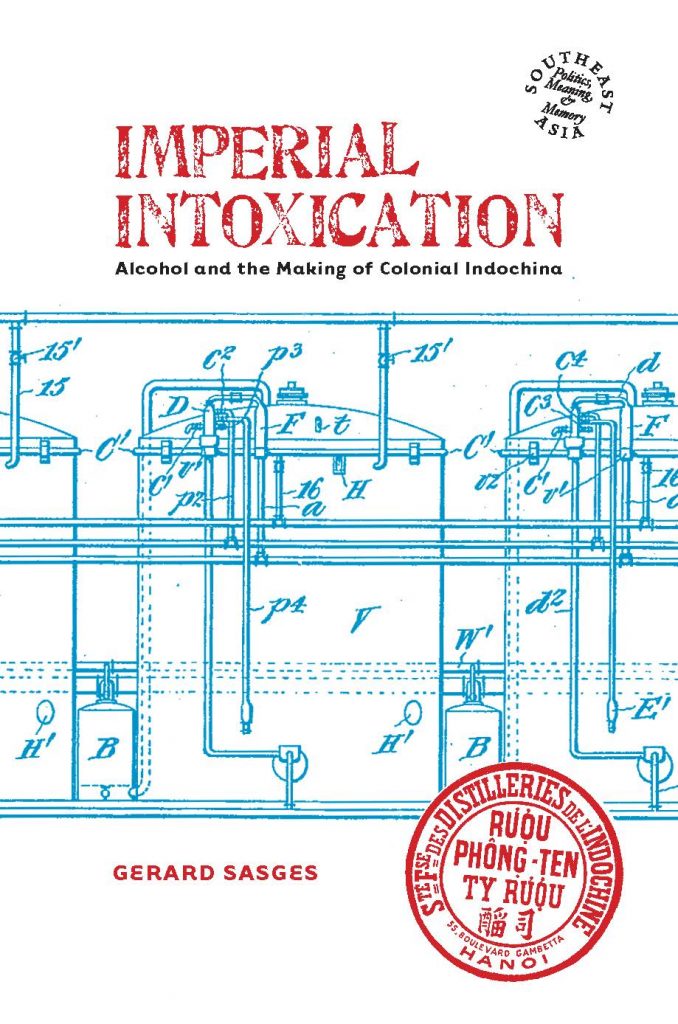 Sasges, Gerard, Imperial Intoxication: Alcohol and the Making of Colonial Indochina, Hawaii: University of Hawai'i Press, 2017
Imperial Intoxication provides a unique window on Indochina between 1860 and 1939. It illuminates the contradictory mix of modern and archaic, power and impotence, civil bureaucracy and military occupation that characterized colonial rule. It highlights the role Indochinese played in shaping the monopoly, whether as reformers or factory workers, illegal distillers or the agents sent to arrest them. And it links these long-ago stories to global processes that continue to play out today.
Sasges, Gerard, Imperial Intoxication: Alcohol and the Making of Colonial Indochina, Hawaii: University of Hawai'i Press, 2017
Imperial Intoxication provides a unique window on Indochina between 1860 and 1939. It illuminates the contradictory mix of modern and archaic, power and impotence, civil bureaucracy and military occupation that characterized colonial rule. It highlights the role Indochinese played in shaping the monopoly, whether as reformers or factory workers, illegal distillers or the agents sent to arrest them. And it links these long-ago stories to global processes that continue to play out today.Voyage to the Seven Isles (Tue, 5 September 2017)
ALL HANDS ON DECK! LIFE VESTS ON! WHY ARE YOU STILL SITTING THERE???!!! Listen – in less than a fortnight some of us novice seafarers will be reliving our May 2017 STEER voyage on a sailing boat in and around the waters of Riau Islands and Sumatra, Indonesia. We'll be storming through our trip ONCE AGAIN with the company of some pictures, films, stories, and syairs from our seasick odyssey.
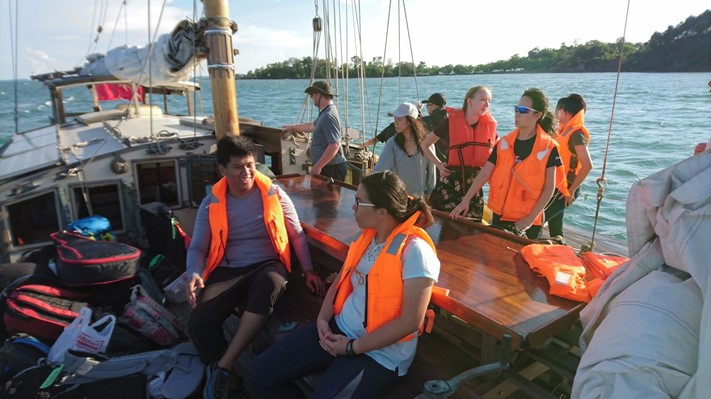 VOYAGE TO THE SEVEN ISLES
5 September 2017 @ 6:30pm
Venue: AS1-02-09 (Faculty of Arts and Social Sciences, NUS)
Admission is free! All welcome!
The sea is calling! See you there!
The “STEER Sail Indonesia Voyage” was organized by the NUS Department of Southeast Asian Studies with support from FASS, IRO and PVO.
VOYAGE TO THE SEVEN ISLES
5 September 2017 @ 6:30pm
Venue: AS1-02-09 (Faculty of Arts and Social Sciences, NUS)
Admission is free! All welcome!
The sea is calling! See you there!
The “STEER Sail Indonesia Voyage” was organized by the NUS Department of Southeast Asian Studies with support from FASS, IRO and PVO.Fear and Ambivalence in Singapore: Mapping the Saltwater Crocodile in the Singapore Consciousness (Wed, 13 September 2017)
Speaker: Kate Pocklington (Conservator, NUS Lee Kong Chian Natural History Museum) Date: Wednesday, 13 September 2017 Time: 4:00pm – 5:30pm Venue: AS8, Level 6, Conference Room (06-46) Synopsis In the 1820s, William Farquhar’s dog was eaten by a crocodile on the bank of the Rochor River. The 1849 autobiography Hikayat Abdullah, by Abdullah bin Abdul Kadir, stated this was ‘the first time people knew there were crocodiles in Singapore’. By 1996, the IUCN assessed saltwater crocodiles as being ‘regionally extinct’ in Singapore. Yet, over the last few years, Pocklington’s research has uncovered over 380 present and historic records of crocodiles in Singapore showing that whilst they are indeed elusive, they have never left our waters. The alleged realisation of their existence here nearly 200 years ago did not account for the extensive cultural manifestations and equivocal human relationships. Much of the cultural significance has been surrendered in distortions of new perceptions; once considered territorial protectors and reincarnations of warriors, crocodiles have become victim to habitat destruction, governmental incentives for eradication, and a booming international skin trade. For some, crocodiles appear to be nothing more than a dangerous predator, but there is a juncture in which their histories unfold a mapping of conversations, systems of belief and the connection between human and nature. Where do these parallels and collisions of the ‘predator and prey’ dynamic cross the paths of co-existence? About the speaker Kate Pocklington is the Conservator at the Lee Kong Chian Natural History Museum (LKCNHM) at the National University of Singapore. She studied fine art and graphic design, and later Conservation and Restoration at the University of Lincoln in the UK. She began working at LKCNHM in 2012 after her five-year ground work as natural history conservator in the Oxford University Museum of Natural History. Pocklington focuses her art and research on nature, culture, and societal change of the destructive human-nature parallels. This often creates a connection between her art and her career: preventing degradation, revitalising the past of science and nature, and looking behind and beyond. She is currently active in a collaboration between LKCNHM and NUS Museum with the prep-room project Buaya: The making of a non-myth held at NUS Museum.
SEAS Alumnus Dr Kyle Latinis featured in The Straits Times, Thursday 3 August 2017
How S'pore team hit pay dirt in Angkor Wat, The Straits Times, Thursday 03 August 2017. An archaeological field school from Singapore which set up a 12-day excavation at Cambodia's Angkor Wat has helped unearth a rare, late 12th-century statue. Buried in a pit about 40cm deep, the approximately 2m-tall sandstone statue, sculpted in the image of a guardian, was dug up last Saturday at the ancient Tonle Snguot hospital complex, just two days into a test excavation. The find has been described by experts the world over as incredible and the most significant in recent years, since most of the site's valuable items have been looted. Speaking to The Straits Times, head of the field team, Dr Kyle Latinis from Singapore's ISEAS - Yusof Ishak Institute's Nalanda-Sriwijaya Centre (NSC), said: "It is extremely rare to discover something so significant just days into our dig. We were lucky and in the right place. We also had a good sampling strategy. "You do not expect to find statues with their heads intact at Angkor Wat because looters are rampant in these areas and most of the ancient Cambodian statues are held illegally in the hands of private collectors." The field school and excavation are funded by Singapore's Ministry of Foreign Affairs (MFA) at the cost of about $70,000, said NSC head Dr Terence Chong. This is the field school's fifth session. It is a three-week archaeological research and training programme held in Cambodia and Singapore. The site was selected by NSC as well as researchers from the Apsara Authority - the Cambodian state agency charged with managing the Unesco World Heritage Site. The Singapore team scoped the project and sampling area and directed the excavation effort. This was done in consultation with Apsara Authority, the host partner. The aim is to investigate ancient hospital activities, habitation and structures. The programme is designed to emphasise the history of intra-Asian interactions over the past 2,000 years and to create a regional identity and a community of scholars from East Asia Summit countries. There are 14 participants this year, four of whom are from Singapore. The others hail from countries such as the Philippines and Cambodia. They are students and young professionals. While NSC set up the excavation, the statue was recovered by Cambodian archaeologists, among others. It has since been moved to a museum for protection. Archaeology undergraduate Natalie Khoo, 22, said: "To witness the rituals conducted for removal of the statue and the opportunity to work on this historical hospital site is an exciting and a once-in-a-lifetime experience." The statue likely was one of a pair and flanked a temple or shrine area that was part of the hospital complex, said Dr Latinis. He added that the statue likely collapsed near the original spot it was erected in, along with the temple wall. "Although the statue is broken in a few places, it is near complete. It likely collapsed after the site was abandoned," he said. He added that the other two sections of the hospital complex were dedicated to physical treatment and a medicinal plant garden. About 100 hospitals were built by the 12th-century King Jayavarman VII, who reigned from 1181 to 1218. He was known as the king who had launched the largest and the most construction projects. The Tonle Snguot site had likely been inhabited by a community before it became a hospital. It is unclear how big the hospital complex was as of now, and more work needs to be done. Dr Latinis said that a lot of ceramics, statues and structural remnants have been unearthed so far. "A whole bunch of questions on the architectural history as well as technological information and industry of the time will be answered," he added. by Melody Zaccheus, Heritage and Community Correspondent View the original article.
Celebration for Southeast Asian Studies Graduating Class of 2017
 On 10 July 2017, the Department of Southeast Asian Studies hosts a graduation tea party to celebrate and recognize our graduate’s achievements and their transition to an important new phase of life. Members of the faculty and student got together at the AS8 Level 4 Foyer for an al fresco tea reception before their commencement ceremony the same evening.
Congratulations to the Class of 2017!!
On 10 July 2017, the Department of Southeast Asian Studies hosts a graduation tea party to celebrate and recognize our graduate’s achievements and their transition to an important new phase of life. Members of the faculty and student got together at the AS8 Level 4 Foyer for an al fresco tea reception before their commencement ceremony the same evening.
Congratulations to the Class of 2017!!Wang Gungwu Medal & Prize
The Department of Southeast Asian Studies is delighted to announce that Mr Goh Aik Sai has been awarded the Wang Gungwu Medal & Prize (AY2016-2017) for the Best Masters thesis in the Social Sciences/Humanities for his thesis entitled ‘Enlightenment on Display: The Rise and Fall of Singapore Buddhist Museums’. (Advisor: Professor John N Miksic.)
Field Study in Lingga
Led by Assoc Prof Jan Mrazek from the Department of Southeast Asian Studies, a group of 12 students from NUS explored Lingga Island for 5 hours as part of a field study trip that started from Bintan Island. Their experience has been reported by Lingga Geografia, a site dedicated to tourism in Lingga. Check out the article here.
FASS Open House 2017
Come meet our staff and students at FASS Open House on 20 May 2017 and find out what Southeast Asian Studies is all about!

STEER Sail Indonesia
Join an amazing voyage on a classic sailing ship (like the one in attached picture) through the Riau Archipelago and along Sumatra’s coast, stopping at islands, exploring Indonesian multi-ethnic towns, water villages, ports, tiny fishing communities, a remote uninhabited isle, the Berbak National Park and tiger reserve on Sumatra, and the great Indragiri river. Visit markets, archaeological and cultural sites, and meet locals. On kayaks explore streams and lagoons. Learn about and feel the history, culture, nature, and economic situation of the region – and the many perspectives on its potential and its woes. Critically reflect on modernity and development, speed and slowness. Learn basic Indonesian. Learn about ships and get to know intimately the sea and its importance in this region, today and in centuries past. Experience how it feels to live with fellow sailors in the tiny floating world of the boat; and learn how to sail: work in a team hoisting sails, keeping watch, navigating, reading charts, taking the helm and steering the ship. We will have a captain, but you will be the crew! Assoc Prof Jan Mrázek, the tour leader, writes and teaches about Indonesia, as well as travel and ships. He has traveled throughout Indonesia, when possible on ships and ferries, and sailed on a container ship from Europe to Singapore. Open to all NUS students! We have places for only 12 students, so email us soon! Dates: 13-26 May 2017 Cost: TBA, estimated between $1,200 and $1,600 after subsidy. If you might be interested and/or have questions, please email Jan Mrázek at seajm@nus.edu.sg . No commitment necessary at this point – we just want to know about your possible interest, so that we can provide more information about cost and deadlines when it becomes available. This is a brand new STEER program, a pilot voyage. For info on STEER, see http://www.nus.edu.sg/IRO/prog/steer/index.html Organised by the Department of Southeast Asian Studies and the International Relations Office, NUS.
NHB organises walking tours to mark 75th anniversary of the fall of Singapore
Thursday 2 February 2017, The Straits Times. SINGAPORE - The National Heritage Board (NHB) is organising 11 walking tours around Singapore to mark the 75th anniversary of the fall of Singapore in 1942 during World War II.
Launch of "From the Ashes – Reviving Myanmar Celadon Ceramics"
The much awaited exhibition "From the Ashes: Reviving Myanmar Ceramics" was officially launched by Assoc Prof Itty Abraham with an opening speech at the NUS Museum on 8 February 2017 as part of the Department of Southeast Asian Studies Silver Jubilee celebrations. The exhibition consists of about 100 objects, most of which were made at the Twante site approximately 35 kilometers west of Yangon. Many of the Twante items are believed to date from the fifteenth century, when production of ceramics there reached its apogee. From Myanmar, Twante ceramics were traded as far away as Japan, the Philippines, and Julfar on the Arabian Peninsula. The exhibition catalogue includes a chapter entitled "Twante and the study of Southeast Asian glazed pottery" by Prof John Miksic of the Department of Southeast Asian Studies and a contribution by Southeast Asian Studies alumna Ms Foo Su Ling titled "Curatorial notes: Archaeology and Innovation". As part of the launch, Dr Myo Thant Tyn, a Myanmar chemist and head of the Myanmar Ceramic Society, was invited to share his attempts at reviving the ancient art of glazed pottery making. Dr Myo has been trying to revive the pottery-making industry in Twante to take advantage of the new market for old style pottery which is emerging due to a newly-expanded tourist market. The exhibition will run from 9 February to 30 December 2017 at the NUS Museum Archaeology Library. Admission is free.

Sharing session by Dr Myo Thant Tyn.
New World War II tour will visit 11 S’pore sites
Thursday 2 February 2017, TODAY.
Visiting Programme: Explore Jogja 2017
 The Center for Southeast Asian Social Studies at Universitas Gadjah Mada, Yogyakarta will be holding the Visiting Programme "Explore Jogja" 2017.
Interested students should contact the organiser directly for enquiries.
This is a not for credit programme and there is no funding available for students.
The Center for Southeast Asian Social Studies at Universitas Gadjah Mada, Yogyakarta will be holding the Visiting Programme "Explore Jogja" 2017.
Interested students should contact the organiser directly for enquiries.
This is a not for credit programme and there is no funding available for students.
Job Opportunity: Two Postdoctoral Fellowship Positions in “Borders, Mobility and New Infrastructures”
The Max Weber Foundation Research Group team of researchers at NUS are seeking to appoint two postdoctoral fellows to contribute to the Research Group’s activities on Borders, Mobility and New Infrastructures. All applications should be submitted no later than 31 January 2017. Find out more here.
New Publication: Ancient Southeast Asia by John N Miksic and Goh Geok Yian
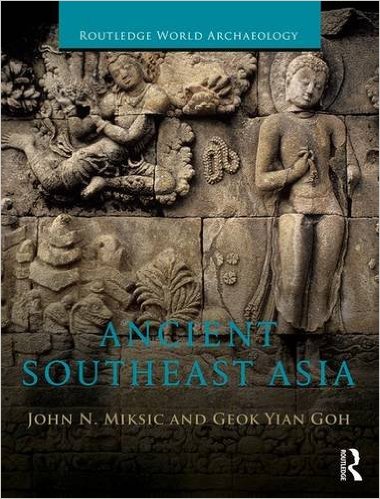 Miksic, John N and Goh Geok Yian, Ancient Southeast Asia, London and New York: Routledge, 2016
Ancient Southeast Asia provides readers with a much needed synthesis of the latest discoveries and research in the archaeology of the region, presenting the evolution of complex societies in Southeast Asia from the protohistoric period, beginning around 500BC, to the arrival of British and Dutch colonists in 1600. Well-illustrated throughout, this comprehensive account explores the factors which established Southeast Asia as an area of unique cultural fusion. Miksic and Goh explore how the local population exploited the abundant resources available, developing maritime transport routes which resulted in economic and cultural wealth, including some of the most elaborate art styles and monumental complexes ever constructed.
The book’s broad geographical and temporal coverage, including a chapter on the natural environment, provides readers with the context needed to understand this staggeringly diverse region. It utilizes French, Dutch, Chinese, Malay-Indonesian and Burmese sources and synthesizes interdisciplinary theoretical perspectives and data from archaeology, history and art history. Offering key opportunities for comparative research with other centres of early socio-economic complexity, Ancient Southeast Asiaestablishes the area’s importance in world history.
Miksic, John N and Goh Geok Yian, Ancient Southeast Asia, London and New York: Routledge, 2016
Ancient Southeast Asia provides readers with a much needed synthesis of the latest discoveries and research in the archaeology of the region, presenting the evolution of complex societies in Southeast Asia from the protohistoric period, beginning around 500BC, to the arrival of British and Dutch colonists in 1600. Well-illustrated throughout, this comprehensive account explores the factors which established Southeast Asia as an area of unique cultural fusion. Miksic and Goh explore how the local population exploited the abundant resources available, developing maritime transport routes which resulted in economic and cultural wealth, including some of the most elaborate art styles and monumental complexes ever constructed.
The book’s broad geographical and temporal coverage, including a chapter on the natural environment, provides readers with the context needed to understand this staggeringly diverse region. It utilizes French, Dutch, Chinese, Malay-Indonesian and Burmese sources and synthesizes interdisciplinary theoretical perspectives and data from archaeology, history and art history. Offering key opportunities for comparative research with other centres of early socio-economic complexity, Ancient Southeast Asiaestablishes the area’s importance in world history.New Publication: Contested Memoryscapes: The Politics of Second World War Commemoration in Singapore by Hamzah Muzaini and Brenda S.A. Yeoh
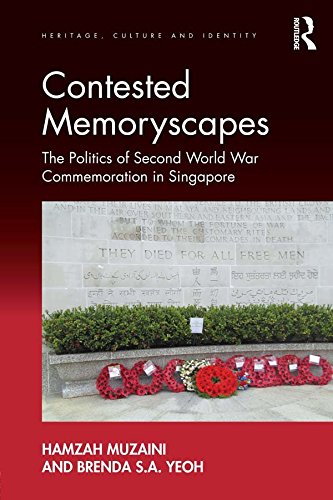 Muzaini, Hamzah and Brenda S.A. Yeoh, Contested Memoryscapes: The Politics of Second World War Commemoration in Singapore, London and New York: Routledge, 2016
This book sets itself apart from much of the burgeoning literature on war commemoration within human geography and the social sciences more generally by analysing how the Second World War (1941–45) is remembered within Singapore, unique for its potential to shed light on the manifold politics associated with the commemoration of wars not only within an Asian, but also a multiracial and multi-religious postcolonial context. By adopting a historical materialist approach, it traces the genealogy of war commemoration in Singapore, from the initial disavowal of the war by the postcolonial government since independence in 1965 to it being embraced as part of national historiography in the early 1990s apparent in the emergence since then of various memoryscapes dedicated to the event. Also, through a critical analysis of a wide selection of these memoryscapes, the book interrogates how memories of the war have been spatially and discursively appropriated today by state (and non-state) agencies as a means of achieving multiple objectives, including (but not limited to) commemoration, tourism, mourning and nation-building. And finally, the book examines the perspectives of those who engage with or use these memoryscapes in order to reveal their contested nature as fractured by social divisions of race, gender, ideology and nationality.
The substantive book chapters will be based on archival and empirical data drawn from case studies in Singapore themed along different conceptual lenses including ethnicity; gender; postcoloniality, tourism and postmodernity; personal mourning; transnational remembrances and politics; and the preservation of original sites, stories and artefacts of war.
Collectively, they speak to and work towards shedding insights to the one overarching question: 'How is the Second World War commemorated in postcolonial Singapore and what are some of the issues, politics and contestations which have accompanied these efforts to presence the war today, particularly as they are spatially and materially played out via different types of memoryscapes?' The book also distinguishes itself from previous works written on war commemoration in Singapore, mainly by social and military historians, particularly through its adoption of a geographical agenda that gives attention to issues of politics of space as it relates to remembrance and representations of memory.
Muzaini, Hamzah and Brenda S.A. Yeoh, Contested Memoryscapes: The Politics of Second World War Commemoration in Singapore, London and New York: Routledge, 2016
This book sets itself apart from much of the burgeoning literature on war commemoration within human geography and the social sciences more generally by analysing how the Second World War (1941–45) is remembered within Singapore, unique for its potential to shed light on the manifold politics associated with the commemoration of wars not only within an Asian, but also a multiracial and multi-religious postcolonial context. By adopting a historical materialist approach, it traces the genealogy of war commemoration in Singapore, from the initial disavowal of the war by the postcolonial government since independence in 1965 to it being embraced as part of national historiography in the early 1990s apparent in the emergence since then of various memoryscapes dedicated to the event. Also, through a critical analysis of a wide selection of these memoryscapes, the book interrogates how memories of the war have been spatially and discursively appropriated today by state (and non-state) agencies as a means of achieving multiple objectives, including (but not limited to) commemoration, tourism, mourning and nation-building. And finally, the book examines the perspectives of those who engage with or use these memoryscapes in order to reveal their contested nature as fractured by social divisions of race, gender, ideology and nationality.
The substantive book chapters will be based on archival and empirical data drawn from case studies in Singapore themed along different conceptual lenses including ethnicity; gender; postcoloniality, tourism and postmodernity; personal mourning; transnational remembrances and politics; and the preservation of original sites, stories and artefacts of war.
Collectively, they speak to and work towards shedding insights to the one overarching question: 'How is the Second World War commemorated in postcolonial Singapore and what are some of the issues, politics and contestations which have accompanied these efforts to presence the war today, particularly as they are spatially and materially played out via different types of memoryscapes?' The book also distinguishes itself from previous works written on war commemoration in Singapore, mainly by social and military historians, particularly through its adoption of a geographical agenda that gives attention to issues of politics of space as it relates to remembrance and representations of memory.UOB Painting of the Year Silver Award
Congratulations to Southeast Asian Studies major, Yeo Tze Yang, on winning the Silver award in the Established Artist Category at the 2016 UOB Painting of the Year competition. Check out the winning artwork here.
Public Lecture at IIUM by Prof John Miksic
On 2 November Prof. John Miksic gave a public lecture at the Centre for Malay World and Islamic Civilisation at the International Islamic University of Malaysia. The moderator of the seminar was the Honourable Tan Sri Dato’ Seri Utama Dr. Rais Yatim, Advisor to the Government of Malaysia on Socio-Cultural Matters and President IIUM. The lecture was the third in the Malay World Seminar Series. The title of the talk was "Lives in Ancient Southeast Asian Cities." Prof. Miksic has written much on this topic. The role of Southeast Asia in early urbanism has only recently become recognized. One reason for this tardy acknowledgement of the region's importance for the formation of early cities is the fact that the settlement patterns in this region differ significantly from those found in India, China, or the Near East. This is partly due to the unique environment of Southeast Asia, and partly to local cultural patterns. Prof. Miksic discussed the roles of ports, palaces, temples, markets, and forts in stimulating urbanism. He discussed examples in Cambodia, Java, and the Straits of Melaka including 14th-century Singapore, and the roles of foreign merchants in stimulating certain forms of cities during the period before the arrival of Europeans. Check out the photos from the IIUM Centre for Malay World and Islamic Civilisation Facebook page below!
[Book Launch] Ancient Southeast Asia by John N. Miksic and Goh Geok Yian
Join Professor John N. Miksic (NUS Dept of Southeast Asian Studies) and Associate Professor Goh Geok Yian (NTU HSS) at the launch of their latest publication 'Ancient Southeast Asia' on Fri, 11 Nov, at Level 16, The POD, National Library Building from 7pm. Discounted copies of the book will be available at the launch. Limited seats available. Registration is required via http://bit.ly/2eH6BiC.
TAKSU An Evening of Balinese Dance (Fri 11 November 2016, 7.30pm)
The Department of Southeast Asian Studies presents TAKSU An Evening of Balinese Dance by A/P Irving Johnson and his students from module SE2224 Unmasked! An Introduction to Balinese Dance in SEA. Be sure to join us for this one-night only showcase!
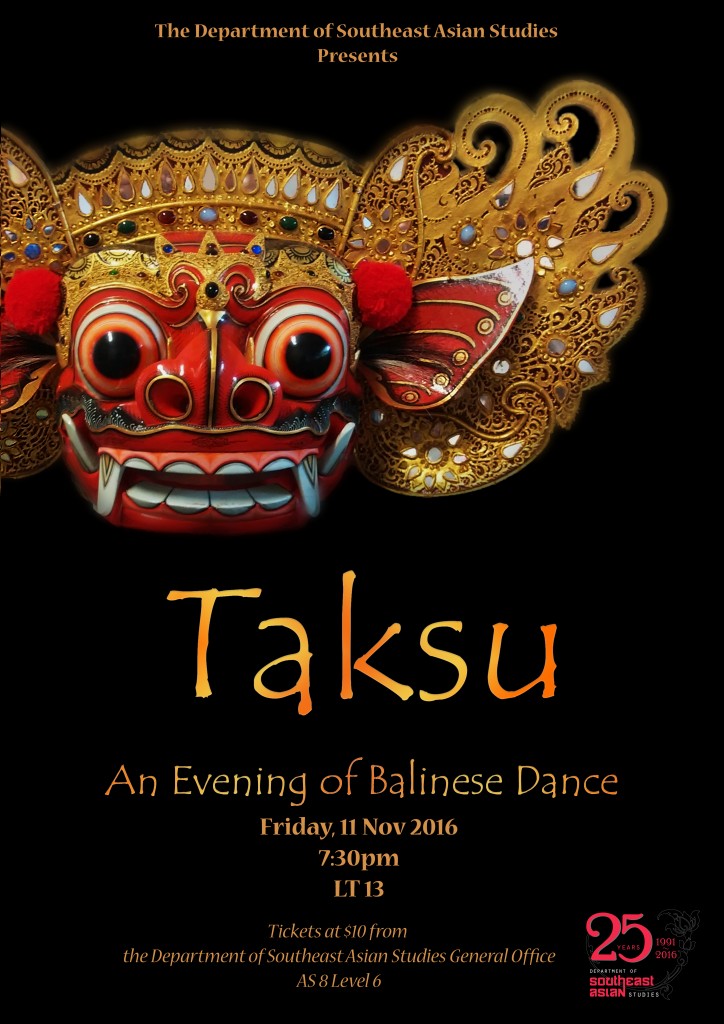
Changes to Modules Offered in Semester 2, AY2016/2017
Due to changes in staff availability in Semester 2 AY2016/2017, the following modules will not be offered:
- SE4218 Majorities and Minorities in Southeast Asia
- SE5294/GE5215 The Politics of Environment in SE Asia
'Imaginations' - A Traditional Thai Paintings Exhibition
The Department of Southeast Asian Studies proudly presents ‘Imaginations‘, a traditional Thai paintings exhibition by students of SE3224 Thai Drawing and Painting. The exhibition will be held at the NUS Central Library (outside restricted area) from 15 to 23 August 2016. All are welcome!
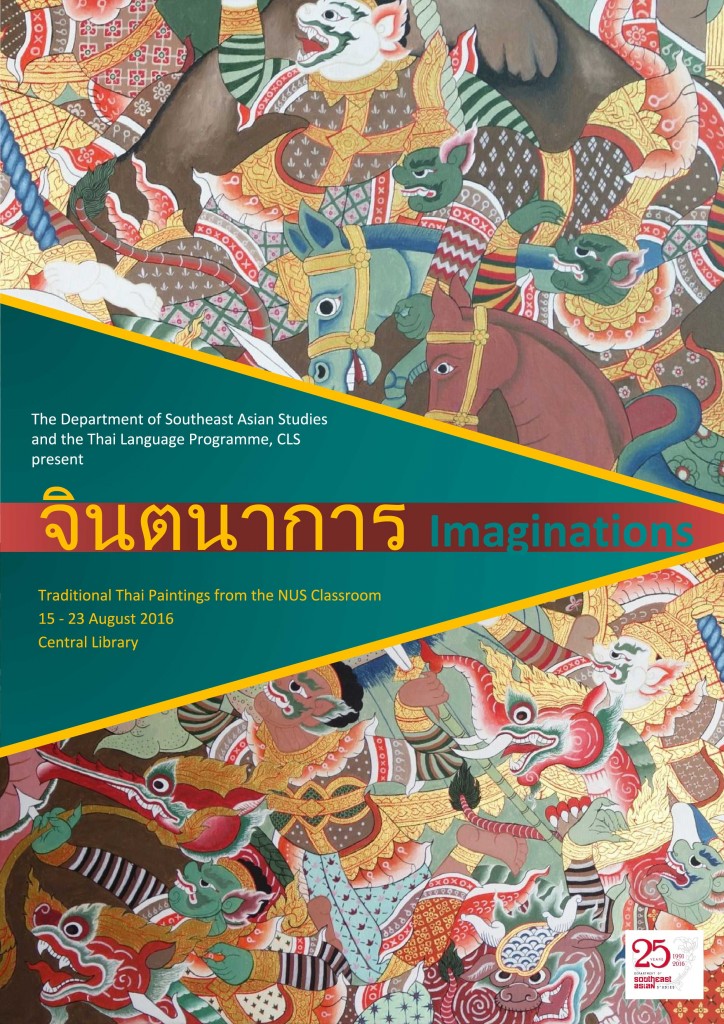
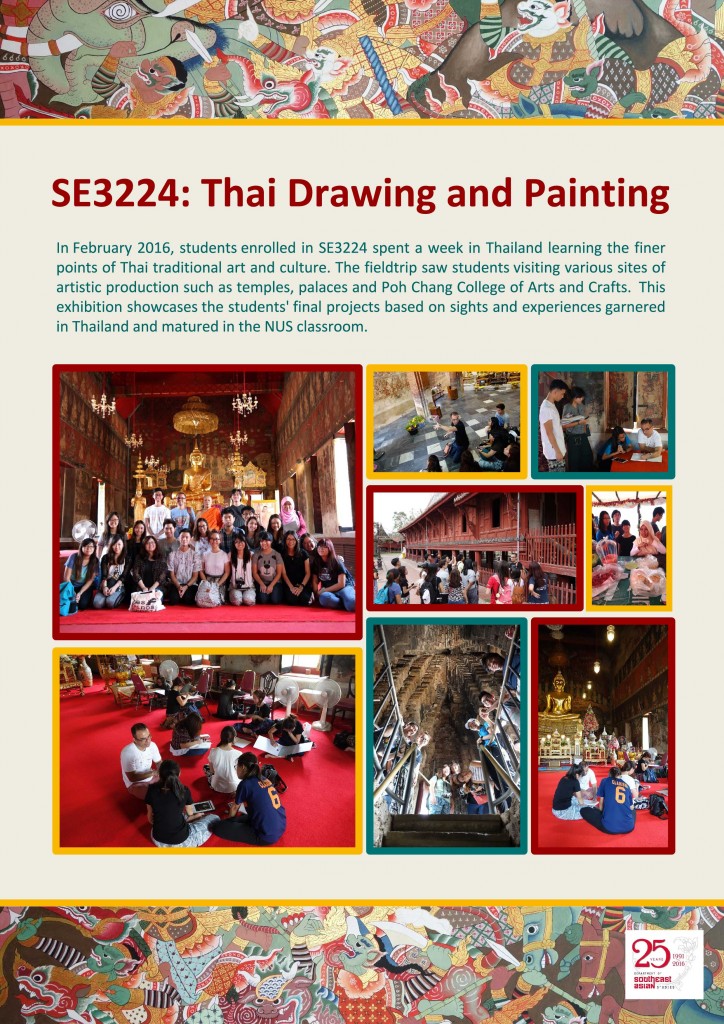
We have moved!
The Department of Southeast Asian Studies is now located on Level 6 of the new AS8 building. Our contact numbers remain unchanged. Please refer to the following pages for updated information:
25 years of Southeast Asian Studies @ NUS
The 2016/2017 Academic Year marks the 25th anniversary of the founding of the Southeast Asian Studies Programme which has become a full-fledged Department since July 2011. To celebrate this milestone, the Department of Southeast Asian Studies will be holding several events and we would like YOU to join us! Register and pay for our Silver Jubilee Dinner online here: https://nus.edu/2anDnPj Follow us on Facebook or our Department website for updates.
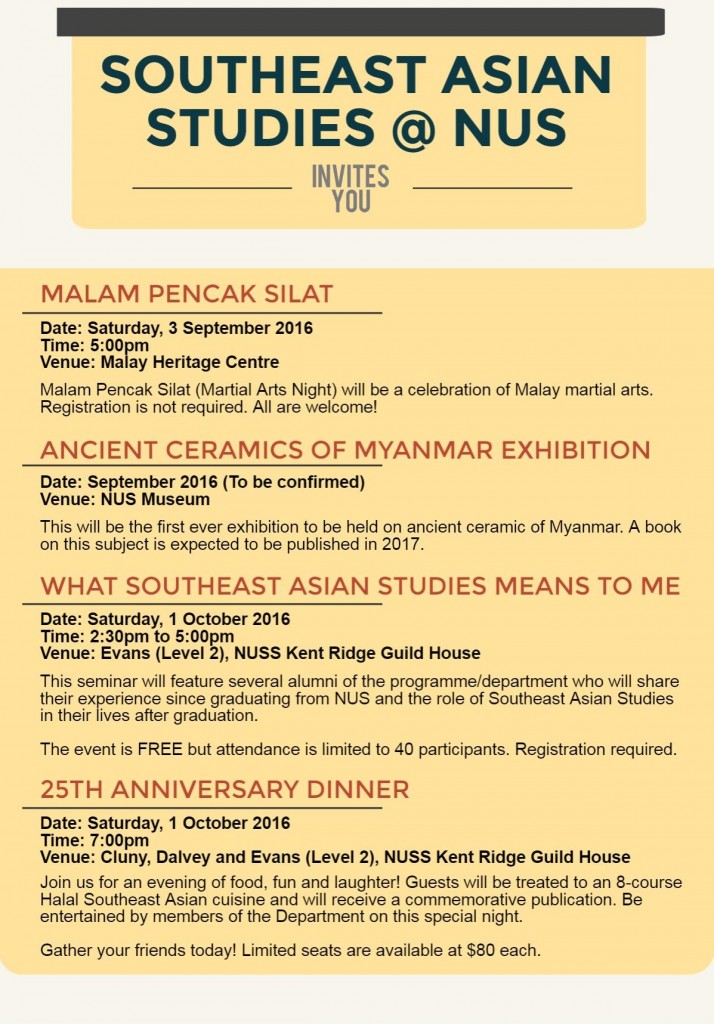
Phasing out of NUS-ANU Joint Masters Degree in Southeast Asian Studies
We regret to announce that the NUS-ANU Joint Masters Degree in Southeast Asian Studies will cease to exist effective Semester 2, AY2016/2017. The Semester 2, AY2015/2016 intake will be the final intake to the programme and no further intakes will occur.
Notice of Relocation
The Department of Southeast Asian Studies will be moving to AS8 (next to NUS Central Library) from 11 to 18 July 2016. We may not be contactable during this period and apologise for any inconvenience caused.
General Office Operating Hours During the Month of Ramadan & Eve of Hari Raya Puasa (Eidulfitri)
Please note that the Department of Southeast Asian Studies general office will operate as follows from 6 June to 5 July: 6 June – 4 July 2016 Mon – Thu: 8:00am to 5:30pm Fri: 8:00am to 5:00pm 5 July 2016 (Eve of Hari Raya Puasa) 8:00am to 1:00pm 6 July 2016 (Hari Raya Puasa) Closed Thank you.
Website Updates
Websites of all units/departments in the University, including the Department of Southeast Asian Studies, are in the process of being updated. As such, you may encounter broken links while browsing. We apologise for any inconvenience caused and will do our best to update the website.
Philippine National Book Development Board 34th National Book Awards
Kanami Namiki’s book Ramon Obusan, Philippine Folkdance and Me: From the perspective of a Japanese Dancer won the National Book Award for Best Book of Non-Fiction in English, awarded by the Philippine National Book Development Board. The book is based on Kanami’s M.A. thesis, written at NUS under the supervision of Professor Reynaldo Ileto. Kanami is currently a PhD candidate at the NUS Department of Southeast Asian Studies.

Southeast Asian Night 2016
Come and join us for Southeast Asian Night 2016 on Friday 11 March 2016 at NUS LT13.
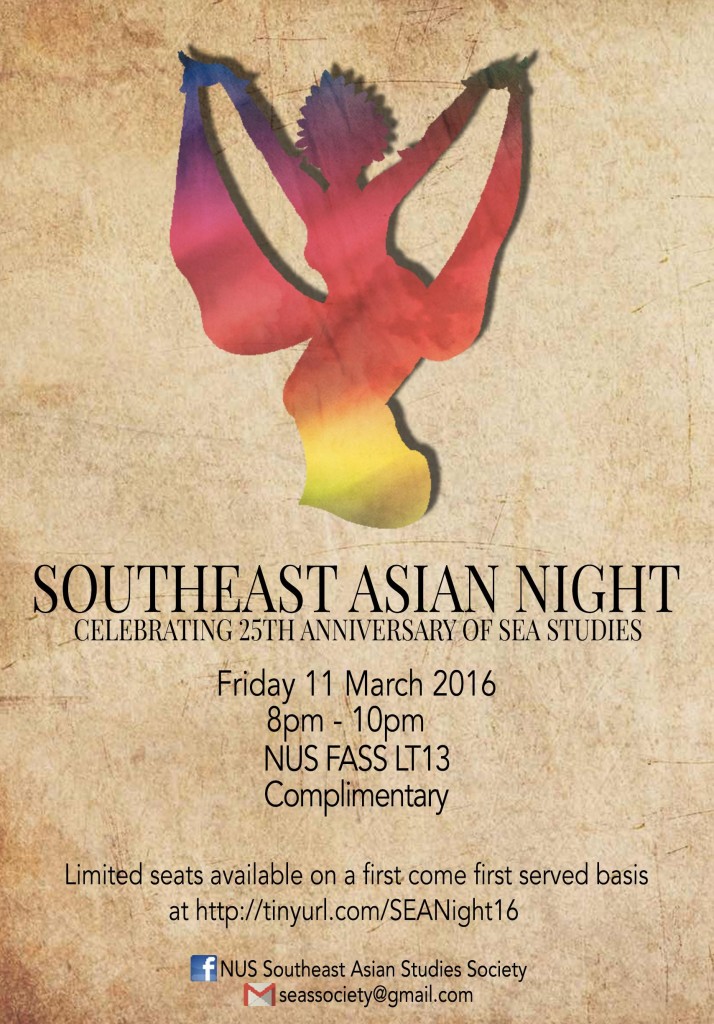
Admission is FREE!!
Best Paper and Best Presentation Awards at the International World Peace Conference 'Better Understanding for a Better World'
Congratulations to Khoo Yi Feng on winning the Best Paper and Best Presentation awards at the International World Peace Conference 'Better Understanding for a Better World' held in Yogyakarta, Indonesia from 2nd to 6th December 2015. Yi Feng's paper titled "From Victims to Victors: Learning Psychological Resilience from Khmer Survivors" discussed the coping strategies that the survivors of the Khmer Rouge employed in response to their traumatic past.
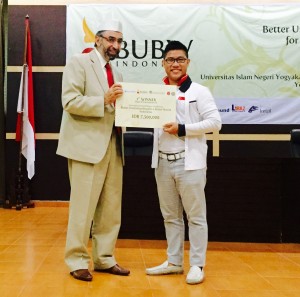
Treasures of Bugis kris at NUS exhibition
Below is a brief translation of the original article 'Khazanah keris Bugis di pameran NUS' by Mohd Raman Daud, published on 8 September 2015 in Berita Harian. Some 150 Bugis-Makassar kris of various kinds were on display in the Central Library at National University of Singapore (NUS) from 27 August to September 4 2015. According to Mr Ismunandar of the Embassy of the Republic of Indonesia in Singapore, the Spirits of Metal exhibition was jointly organised by the Rumah Budaya Indonesia in Singapore, Bugis-Makassar Polobessi Club, Singapore Kris Foundation and the NUS Department of Southeast Asian Studies. This was the first exclusive exhibition of the Bugis-Makassar kris or weaponry held abroad. Mr Andi Mohamad Irvan Zulfikar of the Bugis-Makassar Polobessi Club reported that Indonesian Kris was declared a UNESCO Masterpiece of the Oral and Intagible Heritage of Humanity since 2005. This international recognition has strengthened the Bugis community's determination to preserve its cultural values, heritage and weaponry. In his opening speech at the exhibition, the Indonesian Ambassador to Singapore, His Excellency Mr Andri Hadi, highlighted the important role of the mighty Sulawesi Island sailors who are well recognised in the Southeast Asian seas but often wrongly perceived as pirates and slave traders. According to Dr Mohamed Effendy of the Department of Southeast Asian Studies, the Bugis were highly influential and had earned the respect of early British administrators such as Sir Stamford Raffles. The Bugis sailors and merchants were also knowledgeable in seafaring, political strategy and defence including the use of firearms such as cannons and had contributed much to Singapore's maritime security. Through press reports and records of early modern Singapore, Dr Mohamed Effendy discovered that Bugis merchants contributed to Singapore's early economic development and laid foundations for success of Bugis entrepreneurs such as Ambo Sooloh. Mr Andi Mohamad and Dr Ahmad Ubbe, researchers of Bugis culture and history, also gave a lecture on Bugis kris explaining the deep cultural and spiritual relationship between a Bugis man and his kris which is regarded as his personal reflection.
FASS Professorial Seminar by Prof John Miksic (Thur, 10 September 2015)
Professor John Miksic will be giving a talk titled 'Archaeology on a Little Red Dot: Special Finds in Singapore' as part of the FASS Professorial Seminar Series. RSVP with the title “MIKSIC” to fassresearchevents@nus.edu.sg by 1 September 2015 if you would like to attend this seminar. All are welcome.

Subjectivities: A Journal of Perspectives on Southeast Asia
The inaugural issue of Subjectivities: A Journal of Perspectives on Southeast Asia has launched! This biannual publication by students and alumni of the Department of Southeast Asian Studies aims to provide an independent platform for students to showcase academic and creative works relating to various issues in Southeast Asia. The first issue 'Undersides' features articles by our alumni, Cindy Lin and Liani Manta-Khaira, current student Felicia Chia who did an interview with Prof Miksic, other NUS students, as well as Thow Xin Wei from our Singa Nglaras Gamelan ensemble. The Editorial Team is also looking for Editors and Designer/Web Manager to join them. If you have what it takes, email them at editor.subjectivities@gmail.com today! Editor Requirements: - Interested in a wide range of topics relating to Southeast Asia. - Good time management and able to effectively facilitate communication between contributors, copywriters and other stakeholders effectively. - Good command of written English. - Knowledge of a Southeast Asian language is helpful. - Proficient in MS Word. Familiarity with InDesign is a plus. *In addition, please send a short writing sample (may be a recent paper written for a module) Designer/Web Manager Requirements - Good time management and able to manage different platforms (website, social media) - Proficient in Adobe Photoshop and website editing. * Interested students can also send a portfolio of their recent works (website design, publicity materials, graphic design, artworks)
Spirits of Metal: An Exhibition of Bugis Makassar Weaponry
The NUS Department of Southeast Asian Studies together with The Embassy of The Republic of Indonesia in Singapore, The Bugis Makassar Polo Bessi Club and Rumah Budaya Indonesia in Singapore welcome you to 'Spirits of Metal: An Exhibition of Bugis Makassar Weaponry'. The exhibition at the NUS Central Library will take place from 27 August to 4 September 2015. For directions to NUS Central Library, please go to NUS Campus map:http://goo.gl/JkgA81

Job Vacancy: Assistant Professor (Tenure Track)
The Department of Southeast Asian Studies at the National University of Singapore seeks applications from scholars with a specialization in the cultural geography of Southeast Asia at the Assistant Professor (tenure track) level. We are especially interested in candidates with experience in field-based teaching and who would be able to coordinate the Faculty’s expanding portfolio of summer school programmes. The successful candidate is also expected to contribute to teaching introductory and advanced modules in the areas of historical geography, cultural heritage, and critical memory studies in the context of Southeast Asia, as well as engage in research in these areas. For more information and application instructions, click here.
World Cultures Festival 2015: Southeast Asian Edition
The Singa Nglaras Ensemble will be participating in the Word Cultures Festival 2015 organised by library@esplanade. Catch them in action on Saturday 29 August at the library@esplanade Open Stage from 1.30pm to 2.30pm!
Intricacy - Thai Art by NUS Students
The Department of Southeast Asian Studies is proud to present 'Intricacy', a Thai Art exhibition by students of module SE3224 Thai Drawing and Painting. The exhibition will be held at the NUS Central Library from 9 to 14 September 2015. It is located outside the library restricted area and is open to all. For directions to NUS Central Library, please go to NUS Campus map: http://goo.gl/JkgA81
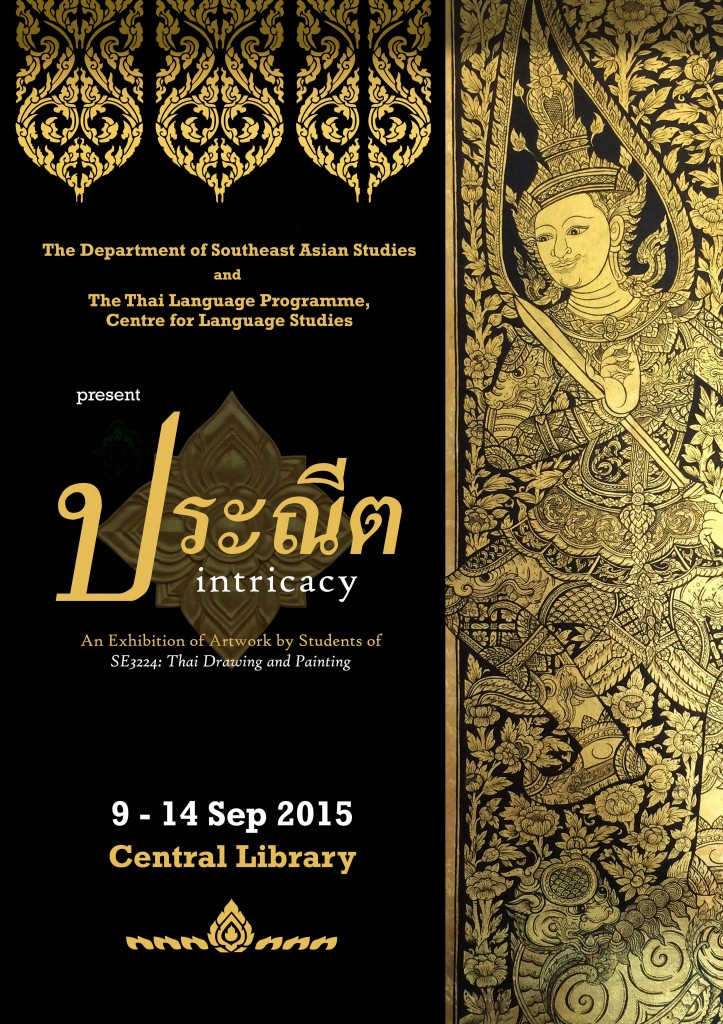
FASS Student Leadership Award (2014/2015)
The Department of Southeast Asian Studies is pleased to announce that our student, Khoo Yi Feng (ARS3), has been awarded the FASS Student Leadership Award for AY2014/2015 for his contributions towards the Chua Thian Poh Community Leadership Programme. The FASS Student Leadership Award (FSLA) recognises student leaders beyond academic excellence, and aims to reward students who demonstrate student leadership, foster experiential learning, and enhance outreach activities within FASS and the wider community. Congratulations to Yi Feng!
Closure over Jubilee Weekend
The Department of Southeast Asian Studies will be closed throughout Jubilee Weekend (7 to 10 August 2015), which is officially non-business day. The Department of Southeast Asian Studies wishes Singapore a Happy Golden Jubilee!
Archaeologists in need of funds and resources
Monday 27 July 2015, The Straits Times. Singapore's two archaeologists, dogged for years by lack of interest in the field and scant resources, are hoping the Government will pump "several million dollars" into the discipline, to pay for more staff and activities over the next 50 years. Mr Lim Chen Sian, who led a recent Empress Place dig which yielded artefacts such as centuries-old Chinese imperial grade ceramics, is also creating a registry of archaeological sites so people can be alerted to their historical value before the wrecking balls descend. The authorities are also keen for archaeology to play a bigger role in piecing together Singapore's past. Mr Alvin Tan, assistant chief executive of policy and development at the National Heritage Board (NHB), said talks about potential archaeological sites are under way. "Archaeology matters because it offers insights into our past, allows us to better understand our history and how far we've progressed as a people and a nation," he said. Mr Lim works for the Nalanda-Sriwijaya Centre at the Institute of Southeast Asian Studies (Iseas). The other archaeologist here is veteran John Miksic of the National University of Singapore. Mr Lim's work is supported by research officers Aaron Kao and Michael Ng while Dr Miksic, 69, has the assistance of Dr Geok Yian Goh, an assistant history professor at Nanyang Technological University. Mr Ng said archaeology is "neglected", adding: "There's a lot of heritage material under us to plug gaps in existing historical sources but we're constantly battling with time ro clear backlogs of previous digs. We need more resources." As well as digs and research work, government investment could fund at least five archaeologists and four part-time research assistants, according to 45-year-old Mr Lim. There is no publicly available data on how much Singapore spends on archaeology but an excavation like the recent 10-week-long dig at Empress Place was budgeted at $70,000 by the NHB. Last year, Hong Kong, which has about six full-time archaeologists, spent $153,500 on excavations and $26,000 on its Archaeological Society. Malaysia's Centre for Global Archaeological Research got about $3.6 million in government funding in 2009. Even Brunei, a country with a population of 400,000, has four dedicated archaeologists. Mr Lim hopes future teams here will have experts in areas such as underwater archaeology, anthropology, and geo-archaeology. "There's a big hurry to build up a strong Singaporean team," he said. Heritage experts believe the field should come under a government department, which can develop the existing infrastructure, come up with guidelines and police the field. The authorities have supported archaeological research here since the first dig in 1984 at Fort Canning. Recent examples supported by the NHB include excavations at Adam Park from 2010 to 2013 and the Victoria Concert Hall in 2011. Mr Lim said the NHB has been doing more for the scene over the years, such as by setting up an impact assessment and mitigation division in 2013, which works with archaeologists at sites of interest before they are developed. ''We've been running on passion and ideology but we need to elevate the level of professionalism. We can't always be digging into our own savings, working 12-hour days and relying on volunteers," he said. Dr Miksic wants Singapore to be a regional hub for the field.
''We have developed a system of analysis over 30 years. We can work together to build a picture of South-east Asia," he said.
Many areas with archaeological significance Areas such as Raffles' Landing Site, Kampong Glam, Pulau Ubin, Pulau Tekong, Sembawang, Bedok and East Coast have been deemed significant by archaeologists. Portuguese maps show that East Coast, for instance, was an area filled with settlements- such as a village at Sungei Bedok - in the 1600s. So far, excavations in Singapore have recovered artefacts from the Temasek Age, of which almost no written records exist, and have proven that the settlement's history dates as far back as the 14th century. However, the majority of digs here have been for rescue purposes, with archaeologists scrambling to organise excavations upon hearing of new construction projects. In the case of Empress Place, for instance, archaeologists rushed to salvage three tonnes of 700-year-old artefacts as the deadline to develop the area into an integrated arts, culture and lifestyle precinct loomed. The archaeologists discovered that Temasek could have had an established government with a ruler as early as the late 14th century, through the discovery of imperial-grade ceramics bestowed by the Ming Dynasty emperor Hongwu on overseas leaders. These recovered Empress Place artefacts are in the process of being catalogued. It will take another three years to analyse them. By Melody Zaccheus for The Straits Times, melodyz@sph.com.sg View the original article.
General Office Operating Hours on Eve of Hari Raya Puasa and on Hari Raya Puasa
The Department of Southeast Asian Studies general office operating hours will be open from 8:00am to 1:00pm on eve of Hari Raya Puasa (Thursday, 16 July 2015). We will be closed on Friday, 17 July 2015 for Hari Raya Puasa public holiday.
General Office Operating Hours during Ramadhan
The Department of Southeast Asian Studies general office operating hours will be as follows during this month of Ramadhan (18 June to 15 July): Monday – Thursday: 08:00am – 5:30pm Friday: 08:00am – 5:00pm We will close from 1:30pm – 2:00pm for break during this period. Thank you for your understanding and apologies for any inconvenience caused.
FASS Open House 2015
Come meet our staff and students at FASS Open House on 16 May 2015 and find out what Southeast Asian Studies is all about!
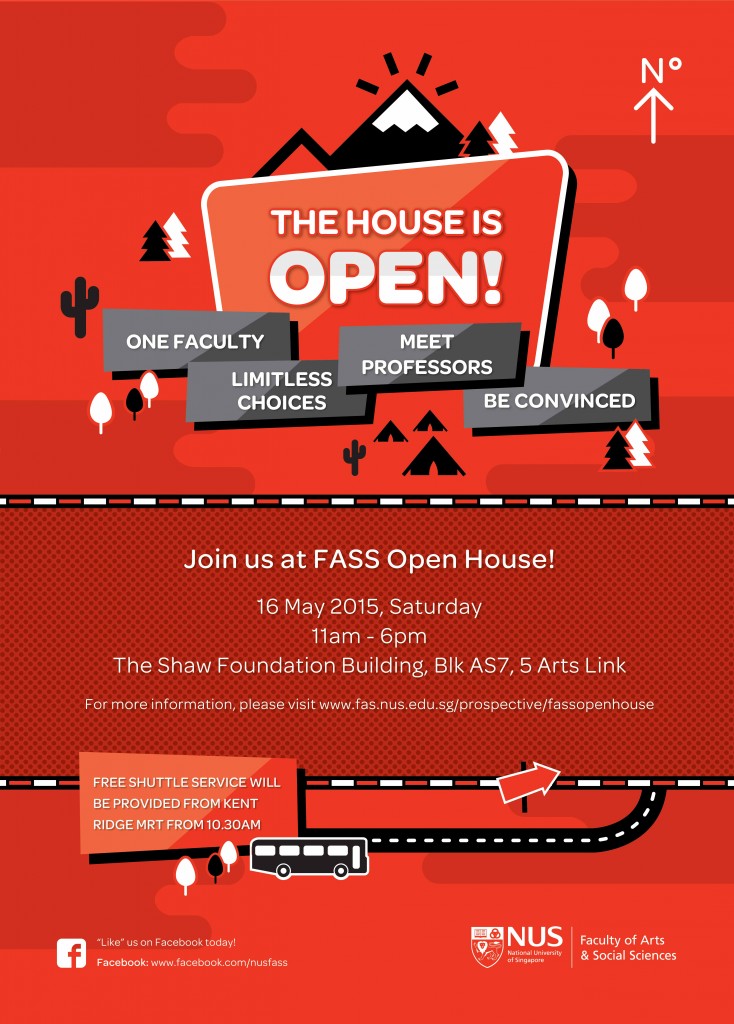
ODPRT Grant for Research Excellence, AY2014-2015
Congratulations to the following Faculty members on being awarded the ODPRT Grant for Research Excellence for AY2014/2015:
- Prof John Miksic
- Assoc Prof Itty Abraham
- Assoc Prof Vatthana Pholsena
Southeast Asian Studies - a useful degree?
Southeast Asian Studies has been highlighted as one of 3 university degrees that might be useful in future.
"With Myanmar opening up, Indonesia’s new president working to make the country more friendly to foreign investors and a rising middle class in many of the other ASEAN nations, our Southeast Asian neighbours might one day leave us in the dust.Check out the blog entry here: http://blog.moneysmart.sg/education/3-university-degrees-that-might-actually-be-useful-in-future/This means that Singaporeans who are fluent in Southeast Asian languages like Bahasa Indonesia or Thai and who are knowledgeable about the ASEAN region will find that their skills increasingly in demand."
Javanese Gamelan for Beginners Workshop
The NUS Singa Nglaras Gamelan Ensemble will be conducting a 6-week Javanese Gamelan for Beginners Workshop. Limited places available. Please email to SingaNglaras@gmail.com to register.

Southeast Asia in Context Summer School 2015
Application for Southeast Asia in Context Summer School 2015 is now open. Hosted by the Department of Southeast Asian Studies at NUS in cooperation with the International Alliance of Research Universities Global Summer Program (IARU GSP), this International Residential Summer School on Southeast Asia which is also offered under the NUS Faculty of Arts and Social Sciences FASSTrack Asia Summer School is designed to provide students with the opportunity to live, study, and travel together, making it a valuable learning experience that extends beyond normal classroom-related activities. The highlight of this course is the 10-day fieldtrip to Myanmar or Indonesia where students will be exposed to local cultures and will be engaged in on-site lectures by both the course instructors and local experts. Please visit FASSTrack Asia website to find out more. Students from the following IARU member universities may apply through the IARU Global Summer Programme (GSP) 1. Australian National University 2. ETH Zurich 3. Peking University 4. University of California, Berkeley 5. University of Cambridge 6. University of Copenhagen 7. University of Oxford 8. The University of Tokyo 9. Yale University
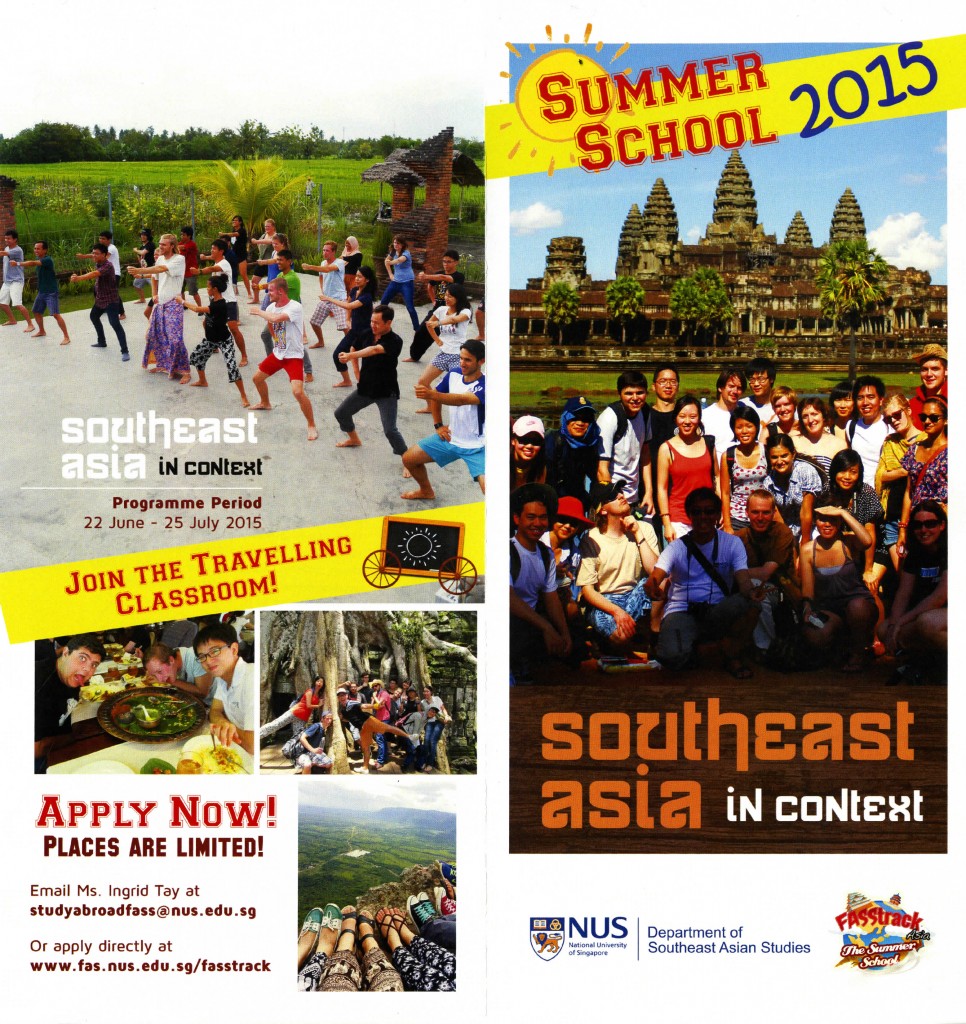
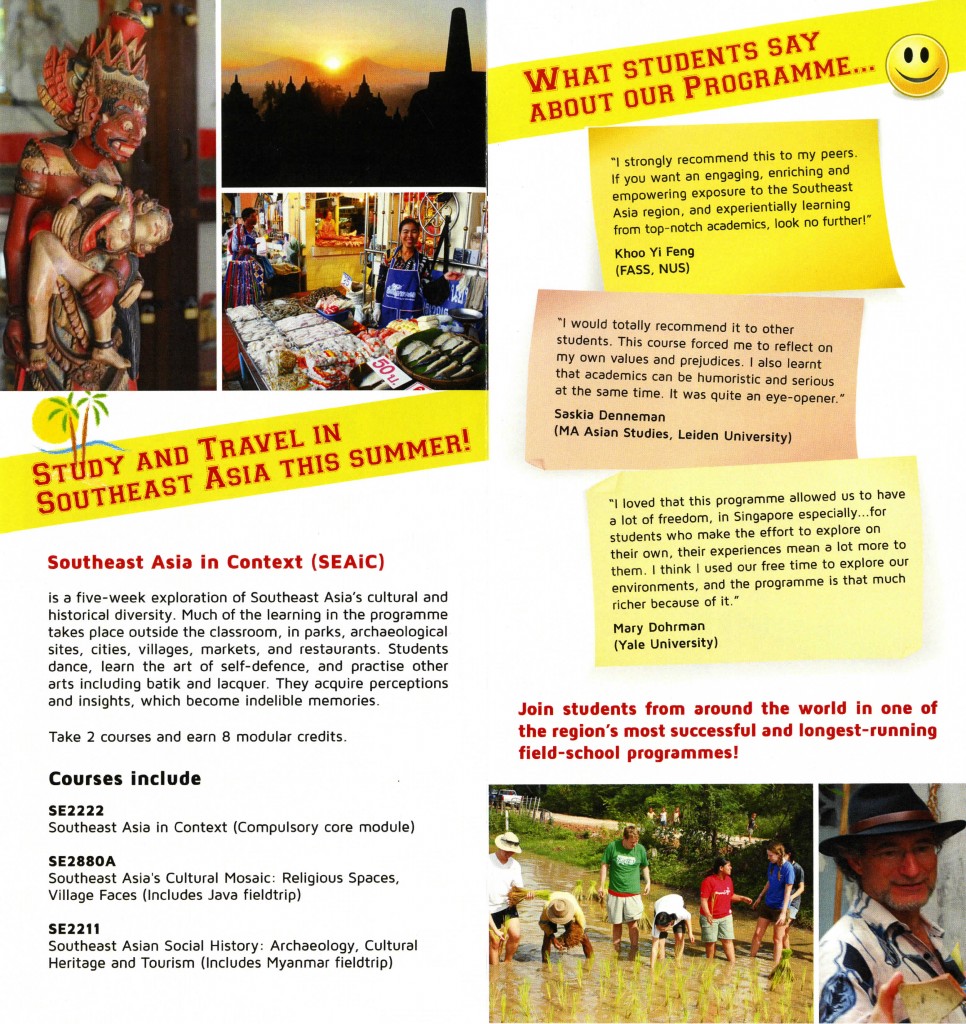
Just Do It by Ei Xu Han (Year 4 student, Social Work major)
Ei Xue Han, a Social Work major, tells us that
"life in NUS is not just about studying mundanely, but also a time for you to explore what you want and discover what you like."Read more about Xue Han's learning journey through Southeast Asian art, dance and music.
Buddhist values brought to life, artistically; Murals are anthropologist's labour of love at temple
Saturday 29 November 2014, The Straits Times. INSIDE Uttamayanmuni Temple in Choa Chu Kang, the biggest of six Thai buddhist temples in Singaproe, one man has quietly taken on a project that could span decades. Associate professor Irving Johnson of the National University of Singapore Southeast Asian studies is spending most of the school break at the temple's main shrine, filling its white panels with scenes from religious texts. It is a dream come true for the 42-year-old Singaporean who worshipped at the temple as a child with his Thai Buddhist mother. He had spent many an afternoon dreaming about painting the walls to resemble the elaborate murals that adorn the walls of its majestic counterparts in Bangkok. "I've been trapped in a cycle of work year-to-year. I'm finally fulfilling my dream. There is an intense feeling of satisfaction in seeing colour and stories light up plain cement," he said. Dr Johnson, who started on the murals in 2012, estimated that it would take 30 years to transform the shrine's 30 or so panels into a rich tapestry of paintings. Each panel has more than a hundred hand-painted characters, each about the size of a tea cup. It is so detailed the sarongs of the upper-class female characters are painted with different patterns. Such a massive undertaking usually requires a team of 20 skilled Thai artists to complete over a decade. Dr Johnson has completed two stories from the past lives of Buddha, including the story of the determined prince Mahachanok, who is saved from a shipwreck by the goddess of the ocean. The temple could do with an artistic addition, said Abbot Phrakhru Udom Dhammavithes. "Eventually Singaporeans won't have to fly to Thailand to enjoy Thai Buddhist art... it will be right in our own backyard," he said, adding that the murals help convey Buddhist values. Built in 1963, in a relatively quiet neighbourhood in Hong San Terrace, the temple receives about 5,000 visitors on occasions like Vesak Day. Dr Johnson, an anthropologist who did O- and A-level art, gets help sometimes from students, worshippers and his mother. They fill in the acrylic base layer of each painting. The self-taught classical Thai artist then adds in tones, secondary colours and other details such as gold leafing. He has also weaved in modern references: A scene depicted heaven and hell shows Nazi leader Adolf Hitler crushed under a boiling pot of oil. While his eyesight has worsened since he started painting, Dr Johnson said:
"It's not about me. It's about leaving behind a legacy and making the temple even more traditional while enlivening its walls to befit its status as a social gathering place for the Thai and Singapore community."By Melody Zaccheus for The Straits Times, melodyz@sph.com.sg View the original article.
No Longer a 'Noob' in Martial Arts by Wee Min Er (Year 2 student, Southeast Asian Studies major)
Drawing a wonderful end to SE3880B, I can proudly say that even though I do not practice martial arts, I am not a noob in understanding martial arts in Southeast Asia. If anyone is thinking of what SE modules to take the next academic year, do consider SE3880B!Wee Min Er, a 2nd year Southeast Asian Studies major, shares with us her experience in learning about Martial Arts in Southeast Asia through the module SE3880B. Read more... About SE3880B Martial Arts in Southeast Asia This module introduces the student to the study of martial arts in Southeast Asia. Southeast Asian martial arts are products of hundreds of years of cultural exchange and historical interaction with various civilizations. This module offers students an exciting opportunity to experience and learn a variety of forms of Southeast Asian martial arts. Students enrolled in the module will also experience the exciting physical and cultural practices that are essential in the learning of the martial arts through hands on sessions.
Faculty Teaching Excellence Award (FTEA) 2014
Congratulations to Assoc Prof Irving Johnson and Dr Julius Bautista on being awarded the FASS Faculty Teaching Excellence Award (FTEA) 2014 for their work in 2013/2014. Keep up the good work!
Topeng Calonarang – A Story of Magic and Power
 NUS Department of Southeast Asian Studies, with support from the Embassy of the Republic of Indonesia and NUS Office of Student Affairs, is proud to present Topeng Calonarang – A Story of Magic and Power.
Topeng Calonarang tells the story of the exploits of the widow witch of Dirah and King Erlangga of Kediri, East Java. Derived from classical texts composed in the fourteenth century, the story of Calonarang is very well-known in Bali. Performances of Calonarang include a host of actors playing different roles ranging from witches, animals, students of magic, comedians and the lion-like Barong. The play is traditionally associated with death and resurrection and is often performed as part of temple ceremonies.
Produced and directed for the first time by students in the class SE3230 Seen and Unseen: Explorations in Balinese Theatre, this student led production is a Bali-Singapore (NUS) first. It is an excellent opportunity to showcase the close bilateral ties Singapore has with Indonesia as well as the fascinating beauty of Balinese dance drama, rarely seen in Singapore. The performance will also feature guest dancers from Singapore’s only Balinese dance group, Eka Suwara Santhi.
NUS Department of Southeast Asian Studies, with support from the Embassy of the Republic of Indonesia and NUS Office of Student Affairs, is proud to present Topeng Calonarang – A Story of Magic and Power.
Topeng Calonarang tells the story of the exploits of the widow witch of Dirah and King Erlangga of Kediri, East Java. Derived from classical texts composed in the fourteenth century, the story of Calonarang is very well-known in Bali. Performances of Calonarang include a host of actors playing different roles ranging from witches, animals, students of magic, comedians and the lion-like Barong. The play is traditionally associated with death and resurrection and is often performed as part of temple ceremonies.
Produced and directed for the first time by students in the class SE3230 Seen and Unseen: Explorations in Balinese Theatre, this student led production is a Bali-Singapore (NUS) first. It is an excellent opportunity to showcase the close bilateral ties Singapore has with Indonesia as well as the fascinating beauty of Balinese dance drama, rarely seen in Singapore. The performance will also feature guest dancers from Singapore’s only Balinese dance group, Eka Suwara Santhi.Uncovering secrets of 19th century S'pore; Muslim cemetery in Kampong Glam a treasure trove of port town's past
Friday 5 September 2014, The Straits Times. TUCKED in a corner off Victoria Street is a little known Muslim cemetery that houses the remains of royalty and luminaries from early Singapore. Shrouded in heavy foliage and thick with weeds, it holds the secrets of a cosmopolitan Singapore in the 19th century, with tombstones bearing influences from not only nearby Java, but even the faraway Ottoman Empire. The design of the gravestones reflects the "socio-cultural diversity of the early port town at Kampong Glam", said Dr Imran Tajudeen, an assistant professor at the National University of Singapore's architecture department who has been leading a team of 11 in a six-month study. The prominent personalities at the 19th century Jalan Kubor - Singapore's oldest Muslim graveyard - include Tengku Abdul Kadir, the president of the Singapore Malay Union during the 1940s, local Justice of Peace Haji Ambok Sooloh Haji Omar and traders from Riau, Palembang and Pontianak. Denizens of the 4,752 graves studied also include wealthy merchants from old port towns in the region. The overseas influence is tied to Kampong Glam's past as a thriving port area which stretched from Beach Road to Kallang River and Rochor River. Due to its proximity to royal territory, it was a popular choice for rich Malay merchants during the 1800s to early 1950s. "It was all part of a self-contained port town which included Sultan Mosque and Singapore's Istana or royal palace," Dr Imran said. The cemetery was the focus of a study commissioned by the National Heritage Board (NHB) to help "uncover Singapore's connection to the Malay world", said the board's group director of policy, Mr Alvin Tan. The research is timely because some of the weather-beaten tombstones' inscriptions had "faded over time". Heritage enthusiasts have also been fretting about the possibility of the site making way for new homes. It has been earmarked since 1998 for residential development. Spending hours on site from December last year till May, Dr Imran and his team from Nusantara Consultancy marked out the graves into clusters to aid documentation. The cemetery comprises three main sections - the royal burial grounds, a plot initially intended for Indian Muslims which became a favoured plot for wealthy Bugis and Banjar merchants, and an area for Muslim burials managed by the Aljunied family. With some help from alumni of the nearby Madrasah Aljunied, the researchers also studied the inscriptions on gravestones after shading them with chalk. They found that the inscriptions had been written in multiple scripts such as Arabic, Malay, Javanese Aksara, Bugis Aksara, Gujarati, English and Chinese. Said Mr Tan: "These findings point to the diversity of cultural groups that used to live in or operate from Kampong Glam and show how it was a cosmopolitan confluence of the region." The information found will be available on the board's website, Walking Through Heritage, from today. Findings from the study will be incorporated as part of the Malay Heritage Centre's permanent galleries. Dr Mohamed Effendy from NUS' department of South-east Asian studies, who was also part of the team, said Jalan Kubor's documentation leaves behind a repository of information for future generations. He said:
"It is a treasure house of memories, where people can trace their lineages... It is important that the place is preserved. If you have no past, you have no future."By Melody Zaccheus for The Straits Times, melodyz@sph.com.sg View the original article.
NUS News Highlights: New textbook reveals pre-colonial Singapore history to local teens
By NUS Office of Corporate Relations, Monday 26 May 2014 for NUS News In 1968, a 21-year-old John Miksic, who had a penchant for digging up artefacts, was enthralled by the ancient ruins of temples and Chinese pottery at Sungai Petani, Kedah, when he arrived in Malaysia as a volunteer of the Peace Corps, a US-based international service organisation. Now, after spending almost half a century in the region, the NUS Associate Professor’s fascination with archaeology has led him to influence education of Singapore history among teenagers, through his contribution to the Ministry of Education’s (MOE) updated lower secondary history syllabus implemented early this year. “The reason I got interested in archaeology, originally, is [because I realised] how like us people were a long time ago, and how tough they were also. Their life expectancy was maybe 30 or 40 years. Life was really hard in those days. They still worked hard; they didn’t give up,” said Assoc Prof Miksic, referring to his study of regional history from the 10th to 15th centuries. The professor from NUS’ Department of Southeast Asian Studies, who joined the University in 1987, is also Head of the Archaeology Unit at the Institute of Southeast Asian Studies’ Nalanda Sriwijaya Centre. Assoc Prof Miksic proofread the lower secondary history book’s text, as well as contributed photos to it. He has also donated 4,000 artefacts to MOE, which students will use as part of the Ministry’s new inquiry-based approach to learning. Many of these artefacts are pottery shards which were collected by Assoc Prof Miksic from construction sites, where bulldozers often unearth fragments during ground-breaking. Students will now not only be able to gain knowledge from reading the textbook, but will also see and touch pieces of several hundred-year-old ceramic jars and bowls. The updated textbook includes a new section on pre-colonial Singapore, which states that the island was not an obscure backwater in Southeast Asia prior to the arrival of the British and Sir Stamford Raffles, who is credited with founding Singapore. Assoc Prof Miksic’s work validates the updated text, as he has discovered close to half a million artefacts that show that Singapore was inhabited from 1300 to 1600, then abandoned until 1800, before being resettled again. Among the sites he has excavated are Fort Canning, Parliament House Complex, Old Parliament House, Empress Place, St Andrew’s Cathedral and Colombo Court. The rationale behind MOE’s updated syllabus is to “imbue in our students a sense of national identity by helping them understand the Singapore they live in today. This will require students to first understand the relevance of Singapore’s past in shaping Singapore’s unique position,” according to a Ministry report. Assoc Prof Miksic’s area of research is in the study of ancient international trade, tracing the path of Chinese settlement in the Southeast Asian region through the ceramics they left behind—in particular, where and when they first settled, identifying the means of detecting these settlements and understanding the impact that Chinese presence had on the region. “Ceramics are very interesting because they’re technological marvels: they’re artistic, aesthetic and economic; they have different aspects to them. You can use Chinese porcelain to study many different facets of society, everything from religion to everyday life. And they last forever. Even if they’re broken, the pieces are still going to be around.” View the original article.
SEAD Faculty Members awarded the ODPRT Grant for Research Excellence, AY2013/2014
The Department of Southeast Asian Studies congratulates the following Faculty members on being awarded the ODPRT Grant for Research Excellence for AY2013/2014:
- Assoc Prof John Miksic
- Assoc Prof Irving Chan Johnson
- Dr Douglas Kammen
- Dr Gerard Sasges
The New York Times: In New Textbook, the Story of Singapore Begins 500 Years Earlier
By Jane A. Peterson, Sunday 11 May 2014 for The New York Times.
SINGAPORE — Singapore has rewritten the history taught in secondary school to expand the story of the island state’s birth.
While earlier generations learned a narrative that essentially started in 1819 with the British colonial administrator, Sir Stamford Raffles, stumbling upon a sleepy Malay fishing village, 13-year-olds now learn of a golden age that started 500 years earlier.
The new story, introduced in January, brings into focus a 300-year period, from 1300 to 1600, when Singapore was a thriving multinational trading hub, with an estimated population of 10,000.
An education ministry official who declined to be named, in line with government policy, called the change a “shift” rather than a rewrite, saying it allowed students to “explore Singapore’s origin as a port of call and her connections to the region and the world.”
Behind the revision is the work of John N. Miksic, an American archaeology professor at the National University of Singapore, or N.U.S., who advised the government on the new school text, “Singapore: The Making of a Nation-State, 1300-1975.”
Professor Miksic has led major archaeological excavations across Southeast Asia, including a dozen in Singapore over the past 30 years that have yielded eight tons of artifacts — evidence of a precolonial history that was largely neglected until now.
In a recent book, “Singapore and the Silk Road of the Sea,” he laid out detailed archaeological evidence of the settlement’s early importance and prosperity. One find cited in the book is a large cache of artifacts found at Empress Place, in the central business district near the mouth of the Singapore River, proof that the site was an ancient dock used by merchant traders from China, India and Java, beginning in the 14th century. Among the booty are a blue and white porcelain-stemmed cup from the Chinese Yuan dynasty (1271-1368) and the “Headless Horseman,” a Javanese-style statuette found among objects dating from the 14th to the 16th centuries.
Nearby, Professor Miksic’s team found evidence of the ancient city center framed by an earthen rampart and defenses that Raffles mentioned in letters. Among 30,000 artifacts from the 14th century were Chinese coins and pottery, Indian glass bangles, and gold jewelry.
Why did it take 30 years to change the story? “It takes overwhelming evidence to shift the mind-set of a people from one image of its past to another,” Professor Miksic said in an interview at his campus laboratory.
He said Singapore still tended to consider archaeology an “unaffordable luxury.” Private grants have largely financed his work. Now 67, he worries that his laboratory may close when he retires, for lack of funding. “It’s a field that is still not that appealing to enough Singaporean students,” he said. “There’s no money in it.”
Professor Miksic gives credit for the new history lesson to former students who have reached positions of authority in academia and in the Ministry of Education. Derek Heng, a former student who is a history professor at the recently created Yale-N.U.S. College, called the artifacts “tactile, visual ways to look at the past and reposition Singapore in history.”
Professor Heng surmised that one reason it had taken so long to change the narrative may have been the government’s fears of communal conflict in the 1960s and ’70s. Indonesia engaged in “Konfrontasi” — violent confrontation against the newly formed Malaysian state — in the early 1960s, which was followed by Malaysia’s ejection of Singapore in 1965. “There was a deliberate attempt not to talk about links to the ethnicity of the past,” Professor Heng said. “Now we are more confident to say we were once a Malay polity cutting straight down through Asia.”
Prof. Brian Farrell, who heads the history department at N.U.S., takes Mr. Heng’s idea a step further. “If Singapore before 1800 was a sleepy backwater, the Chinese majority could say, ‘We built Singapore; before it was a blank slate,”’ he said.
Another factor that delayed a rewriting was a 200-year period of decline, a sort of historical “black hole,” between the formerly thriving emporium and the establishment of the 19th-century British trading port, according to Kwa Chong Guan, an adjunct associate professor at N.U.S. who also advised on the textbook revisions. “Until a connection could be made, the tons of archaeological shards Miksic excavated remained of antiquarian interest,” he said.
In 2009, the professors Kwa, Heng and Tan Tai Yong published evidence from written Malay sources that bridged the gap and put Professor Miksic’s artifacts into a larger maritime trade framework. Their book, “Singapore: A 700-Year History — From Early Emporium To World City,” linked the port to the larger sultanate of Johor-Riau in the Strait of Malacca. Concurrently, Peter Borschberg, also a professor at N.U.S., published another important link: Dutch and Portuguese maritime accounts and maps showed that Singapore was on European radars well before Raffles arrived.
Other factors also may help explain the timing of the rewrite. “Now is a good time,” Professor Heng said. “There’s a need to develop a collective social memory. It’s become a political issue.”
Professor Heng suggested that one catalyst for change might have been a government announcement in 2011 of plans to run a motorway through Bukit Brown cemetery, a colonial-era Chinese municipal burial ground, slating hundreds of tombs for exhumation. Thousands of citizens signed petitions against the plan. “We have a fast-paced, highly urbanized society where people are getting disoriented,” he said. “There’s a huge momentum to look at heritage and our historical legacy.”
Singaporeans, he thinks, will feel more rooted if they see their early predecessors as part of a longer regional legacy, rather than a British colonial transplant.
“It’s time to sink new, deep psychological roots and construct an identity for ourselves,” he said.
Professor Miksic says the controversy over Bukit Brown proved that tangible heritage is important. “People want more than prosperity,” he said. “Once you have enough to live on, you want something to live for: identity, a desire to know your ancestors. It’s an innate part of what it means to be human.”
Demographic change is another relevant issue. A government white paper recently reaffirmed proposals to expand the population from 5.3 million to 6.9 million, raising hackles among those who blame inward migration for rising inflation, high home prices, crowded roads and public transport systems and a perceived lack of a level playing field in competition for top jobs.
While the government has slowed its migration plans, further inflows appear inevitable if Singapore is to remain competitive and position itself as a leading global city. Mr. Kwa argues that the rewriting of the island’s history will help citizens accept the population explosion and become more inclusive.
“Every generation has to rewrite its history,” he said. While it used to suit Singapore to see itself as a city-state with a British heritage, modern Singapore needs a different interpretation of history to reinforce a more global perspective, he suggested.
Professor Heng also sees the opening of Singapore to new migrants as a stimulus for reassessing its history: “If inward migration continues, we need to know who we are or we will get lost,” he said.
Professor Miksic goes a step further. “A short history puts a nation on shaky ground; a shallowly rooted place could be overturned quickly,” he said. “If you can show a long cohabitation between the Malays and the Chinese, it proves you have a pretty stable arrangement.”
The new syllabus is also designed to repair Singapore’s educational image, he said. Students are now being encouraged to interpret primary sources themselves to stimulate their reasoning and analysis, rather than relying on old-style rote learning: “One of the objectives is to overcome the stereotype that Singaporeans are not good at creativity,” he said. “There’s a good chance this will change the mind-set.”
Professor Kwa said he believed that Yale-N.U.S., a liberal arts college — the first in Singapore — established in 2011 as a collaboration between Yale University and the National University of Singapore, would help build a new generation of Singaporean historians, raising the profile of humanities and softening Singapore’s image as a nation preoccupied by science and technology. Already, he said, more government scholarships are going to liberal arts candidates for study in the United States and Europe.
Student attitudes have become more skeptical in the past decade, said Quek Ser Hwee, a professor of history at the National University of Singapore, adding that no student now would ask her if she feared arrest for discussing heterodox views. Opinions expressed on the department blog are now quite wide-ranging, she observed, though they stop short of breaching the “out of bounds” limits that once were rigorously policed by colonial and post-colonial administrations: “It’s part of our DNA to know them,” she said.
Yet for all the cultural shifts, the number of students majoring in history has barely changed, possibly reflecting parental preferences for “concrete” degrees, such as law or medicine. “Singapore is still an iron rice bowl,” Professor Farrell said, “a place to make a living.”
View the original article.
Migrant Workers Habitats in Singapore - assignment by students of SE3216 (Semester 2, AY2013/2014)
As part of their assignment, students of the module SE3216 Migration and Diaspora in Southeast Asia went around Singapore to visit and take photos of migrant workers' places of congregation and leisure activities in Singapore. A mapped collection of photos taken by the students are available for viewing here. About SE3216 Migration and Diaspora in Southeast Asia This module seeks to understand the complex trajectories, meanings, and outcomes of human mobility in Southeast Asia during the modern period. The main topics of this module include migration patterns and diasporic identities, cosmopolitans and hybrids, political and cultural minorities, as well as displacement and refugees. Readings and discussion will include both theoretical approaches to these topics as well as empirical and ethnographic case studies.
"★ or ✗ ?" by Ghazrizal Azry Ghazali Nor is a Winner!
The Department of Southeast Asian Studies is pleased to announce that Mr. Ghazrizal Azry Ghazali Nor, a Masters candidate at the Department, has won both the Critics’ Choice Award and the Viewers’ Choice Award at the 'Singapore on Screen 2014' competition held by the NUS Faculty of Arts and Social Sciences Singapore Research Nexus on 12 March 2014. Ghazrizal's short film ★ or ✗ ? was a landslide winner in both categories. ★ or ✗ ? asks us to consider how we depict what we see, and if there is a right or wrong way to represent it. ★ or ✗ ? can be viewed on the NUS YouTube Channel. Congratulations to Ghazrizal on his achievement!
Highly Recommended by Choice: Current Reviews for Academic Libraries - "It’s a Living - Work and Life in Vietnam Today"
It’s a Living - Work and Life in Vietnam Today by Gerard Sasges (ed.) has been selected by CHOICE: Current Reviews for Academic Libraries as a "highly recommended" read. Check out the review by Peters, E.J. below. It's a Living gives voice to 67 Vietnamese workers from all walks of life. The respondents paint vivid pictures of their daily routines and the particular rewards and challenges of each career path. The short chapters are balanced between people who take pleasure in their work and those who are mostly there for the paycheck. Apparently ordinary jobs, such as factory worker, farmer, and bank employee, are interspersed with more offbeat occupations, from grey hair plucker to rat catcher. Interviews touch on issues of corruption and arbitrary enforcement of regulations; they also reveal the importance of education and aspirations of the Vietnamese for their children. A short introduction sets out the book's major themes, but readers would benefit from more about Vietnamese socialism and how much workers have to pay toward the costs of education, health care, and retirement. Reading Bill Hayton's Vietnam: Rising Dragon (2010) can provide more context about the country's economic system. This book is a wonderful, evocative read for undergraduates or anyone with an interest in the people of Vietnam. Beautiful photos allow many of the book's personalities to shine through. Summing Up: Highly recommended. All levels/libraries. --E. J. Peters, Culinary Historians of Northern California Source Citation (MLA 7th Edition) Peters, E.J. "It's a living: work and life in Vietnam today." CHOICE: Current Reviews for Academic Libraries Mar. 2014: 1314. Academic OneFile. Web. 25 Mar. 2014. Read abstract of the book.
Annual Teaching Excellence Award (ATEA) 2012/2013
The NUS Annual Teaching Excellence Award (ATEA) recognises faculty members who have displayed a high level of commitment to their teaching. The Department of Southeast Asian Studies is pleased to extend our warmest congratulations to Assoc Prof Irving Johnson on being awarded the ATEA for AY 2012/2013.
Review of “Singapore & The Silk Road of the Sea, 1300-1800″ by The Taipei Times
Assoc Prof John Miksic's latest book, "Singapore & The Silk Road of the Sea, 1300-1800" was recently reviewed by The Taipei Times. The book review was contributed by reporter Jerome Keating. Read the full review here. Read abstract of the book.
Interview with Assoc Prof John Miksic for the International Institute for Asian Studies Newsletter
This interview was conducted for the International Institute for Asian Studies Newsletter in January 2014 and have been re-posted on the blog of the Archaeology Unit at the Institute of Southeast Asian Studies with permission of the editors. Read the interview here.
What I can do with a degree in Southeast Asian Studies?
Come join us and our SEAS graduates on Friday 14 March 2014 for a sharing session on how to maximise the potential of the most undisciplined discipline at NUS - Southeast Asian Studies! Venue: SEAS Seminar Room, Blk AS3 06-20 Time: 6:00pm - 7:00pm All students are welcomed!

Southeast Asia in Context Summer School 2014
The Southeast Asia in Context Summer School 2014 is open to all NUS Undergraduate full-time students and International Students who are enrolled full-time at their home university and have completed at least one semester or year of study at their home university. Hosted by the Department of Southeast Asian Studies at NUS in cooperation with the International Alliance of Research Universities Global Summer Program (IARU GSP), this International Residential Summer School on Southeast Asia which is also offered under the NUS Faculty of Arts and Social Sciences FASSTrack Asia Summer School is designed to provide students with the opportunity to live, study, and travel together, making it a valuable learning experience that extends beyond normal classroom-related activities. For more information on Admission & Application, please go to: http://www.fas.nus.edu.sg/sea/exchange/summerSchool-application.html The deadline for application is 17 March 2014. Submit your application today!
Southeast Asian Night 2014, Wed 14 March 2014
Mark your calendars!! Join us for a fun-filled night of Southeast Asia music and dance on Friday 14 March 2014. Venue: NUS Theatrette (LT13) Faculty of Arts and Social Sciences National University of Singapore Map: http://goo.gl/ecwbsg Presented to you by NUS Southeast Asian Studies and Gamelan Asmaradana Ltd., this performance will feature the meditative sounds of Central Javanese gamelan, the dynamic explosions of Gong Kebyar of Bali and the flirtatious 'twerking' of West Java. Admission is FREE and refreshments will be provided. Reserve your seat today via http://seanite2014.eventbrite.sg/ Tickets are to be collected at the door 30 mins before showtime.
Introduction to the Cam Script & Language - a workshop organised by NUS Southeast Asian Studies Society (Wed, 2 April 2014)
Do you want to learn how to read and write the Cam language? Then come and join us at the Cam language workshop organised by the NUS Southeast Asian Studies Society on Wednesday 2 April 2014, 4:00pm - 6:00pm. Together with Dr Thanh Phan, Vice Director for the Center of Vietnamese and Southeast Asian Studies at the University of Social Sciences and Humanities, Vietnam National University (VNU-HCMC), Dr Mohd Effendy, Postdoctoral Fellow from NUS Southeast Asian Studies will be sharing the history and myths of the Cam people. Reserve your spot today by signing up via this Google Form: https://docs.google.com/forms/d/1gOIApwQH32Yjim61Awa98qWvUsSJXspCu-HR88kUCwo/viewform For any queries, email the NUS Southeast Asian Studies Society at // <![CDATA[ // Email obfuscator script 2.1 by Tim Williams, University of Arizona // Random encryption key feature by Andrew Moulden, Site Engineering Ltd // This code is freeware provided these four comment lines remain intact // A wizard to generate this code is at http://www.jottings.com/obfuscator/ { coded = "hCshh83yCfv@rTsy1.38T" key = "knrhXomuPJACqvSbLf94FwOaBl8TdI7QViU5WEcz6KRgsY1HNxMpeZyG02t3jD" shift=coded.length link="" for (i=0; i<coded.length; i++) { if (key.indexOf(coded.charAt(i))==-1) { ltr = coded.charAt(i) link += (ltr) } else { ltr = (key.indexOf(coded.charAt(i))-shift+key.length) % key.length link += (key.charAt(ltr)) } } document.write(""+link+"") } // ]]> Sorry, you need Javascript on to email me.
'Inside the World of Work' - Interview with Dr Gerard Sasges by Oi Vietnam Online Magazine
Inside the World of Work - A glimpse into the working lives of everyday Vietnamese. -- an interview with Dr Gerard Sasges, editor of 'It's a Living: Work and Life in Vietnam Today' by James Pham of Oi Vietnam Online Magazine. Read the interview here. Read abstract of the book.
Support FASS in the 85th Anniversary Resilience Run on Saturday, 29 March 2014!
Date: 29 March 2014 Time: 7am to 1pm Venue: NUS Running Track In commemoration of their 85th anniversary in 2014, the Faculties of Arts and Social Sciences, Dentistry and Science, are collaborating on a joint-launch project on Saturday, 29 March – the 85th Anniversary Resilience Run. Comprising a fund raising campaign, the Run symbolizes the resilience of the three faculties in weathering and overcoming various challenges over the years to become the uniquely successful institution that each is today. For more information and to register for the event, please go to: http://www.fas.nus.edu.sg/anniversary/resilience-run.html
[Subjectivities]: Call for submissions for a new Southeast Asian Studies undergraduate biannual research journal.
 Subjectivities is a new biannual research journal run by students from the NUS Southeast Asian Studies Society. Each issue tackles a specific theme concerning the region. We would like to invite students, faculty members, as well as external individuals to contribute their works on Southeast Asia.
In our inaugural issue, themed UNDERSIDES, we are currently calling for submissions of essays and creative works (eg. artworks, poems) on the un-discovered, un-spoken and under-cover aspects of the region we call Southeast Asia.
Guideline for All Essay Submissions
Word Limit: 1000-1200 words
Citation Style: MLA with footnotes
Send in your entries to editor.subjectivities@gmail.com.
Deadline: 24 Jan 2014 (Week 2)
You may contact editor.subjectivities@gmail.com for more information about the submissions.
We hope you will be keen to contribute and share your interest in this region with us and we look forward to reading your works.
Subjectivities is a new biannual research journal run by students from the NUS Southeast Asian Studies Society. Each issue tackles a specific theme concerning the region. We would like to invite students, faculty members, as well as external individuals to contribute their works on Southeast Asia.
In our inaugural issue, themed UNDERSIDES, we are currently calling for submissions of essays and creative works (eg. artworks, poems) on the un-discovered, un-spoken and under-cover aspects of the region we call Southeast Asia.
Guideline for All Essay Submissions
Word Limit: 1000-1200 words
Citation Style: MLA with footnotes
Send in your entries to editor.subjectivities@gmail.com.
Deadline: 24 Jan 2014 (Week 2)
You may contact editor.subjectivities@gmail.com for more information about the submissions.
We hope you will be keen to contribute and share your interest in this region with us and we look forward to reading your works.Digging Outside the Box: Volunteer Archaeology in Singapore - a talk by Assoc Prof John Miksic (Sat, 7 December 2013)
Mark your calendars! Join Assoc Prof John Miksic for his talk on Volunteer Archaeology in Singapore on Saturday, 7 Dec 2013. This event is organised as part of The Mapping Series: In Conjunction with Singapore Biennale 2013. Speaker: Assoc Prof John Miksic (Dept. of Southeast Asian Studies, NUS) Date: Saturday, 7 December 2013 Time: 2:00pm – 4:30pm Venue: Visitors' Briefing Room, Level 1, National Library Building Synopsis Who in Singapore cares about archaeology? Quite a few people, to judge by the number who have contributed their time, sweat, and energy to the subject over the last 30 years. The pursuit of archaeology has been an informal way of spending time for hundreds of volunteers since excavations began in 1984. Academics, soldiers, school children, visiting air crews, artists, secret society members, mystics – the list of participants encompasses nearly the entire spectrum of society. The unofficial nature of archaeology in Singapore has been in many ways a boon to the pursuit of knowledge about the past of both Singapore and Southeast Asia, since almost anybody who wants to has been able to play literally in or near their own back yards. Register for this event here.
'Indiana Jones who pieces together S'pore's past' - Interview with Assoc Prof John Miksic by The Straits Times
Indiana Jones who pieces together S'pore's past. -- Archaeologist has dug into island's pre-colonial history for three decades, The Straits Times, Monday 11 November 2013. TEXTBOOKS here recount the leg-end of how Singapore's founder, Sang Nila Utama, first landed on the island in 1299 because he was attracted by sand so white that it looked like a sheet of cloth. This pristine white sand is no romantic embellishment. It has been found some 90cm under-neath the grassy expanse of to-day's Padang - part of what was once an ancient city's shoreline. The man who unearthed this discovery was born and raised on a farm in New York, grew up be-ing interested in Native Ameri-cans, then helped farmers in Ma-laysia, where he was fascinated by the temple ruins in Kedah. In the last three decades, he has been on a mission to piece together Singa-pore's pre-colonial history. Meet 67-year-old Assistant Professor John N. Miksic, Singa-pore's answer to Indiana Jones. Not that his life is anything as ex-citing as that of the cinematic he-ro, said the grizzled archaeologist. "Digging is the first step in a process of about 10 steps. Real sci-entific work is done in the laboratory, which takes up 90 per cent of an archaeologist's time." Yet his work has been drumming up excitement about Singa-pore's pre-colonial past. Since being first invited to exca-vate Fort Canning in 1984, when Singapore lacked a local archaeolo-gist, he has led digs at 11 other sites, such as Empress Place and the Old Parliament House. He has since amassed eight tonnes of ceramic fragments and other local artefacts, including shells and small statues. They help pain a picture of Singapore as a sizeable and prosperous Asian trading port with a population of 10,000 in the 14th century, more than 500 years before the landing of Sir Stamford Raffles in 1819.
I've been trying to tell people that Singapore has deeper roots that go far beyond the colonial pe-riod and date back 700 years. It gives me a real feeling of happiness when people accept that there is a lot more to Singa-pore history than the textbooks used to tell us.His latest effort is a 491-page tome titled Singapore And The Silk Road Of The Sea, 1300-1800. Launched last week, it showcases some of his findings up till 2004, including how he uncovered a lay-er of fine, unspoilt white sand at the bottom of a pit at the Singapore Cricket Club. The book details how this layer of sand used to extend from the Singapore River to Kampong Glam. From a passing vessel, it would have looked "blindingly white in the sun in contrast to the green hills and blue water which dominated the view". Dr Miksic said putting the book together took 12 years. "It was im-portant for me to provide a clear narrative for both archaeologists and the general public on Singa-pore's roots," explained the soft-spoken man, who has been with the National University of Singapore since 1987. Dr Miksic, who holds a Singapo-rean employment pass, is married to a Chinese Malaysian. His wife, 69, a retired teacher, stays with their 33-year-old daughter in Pittsburgh to help raise their two granddaughters. His son, 35, lives in San Diego. Dr Miksic, who can speak Ma-lay, said he has grown attached to Singapore, which serves as a base for his work in South-east Asia as well. "After 26 years, most of my old friends are here. It's kind of nice to be recognised in a taxi or at a chance meeting as Singapore's ar-chaeologist," said the widely-pub-lished author, whose four or five public talks he gives every year helped build his local reputation. Dr Miksic's love for the past started when he was six. Growing up on a 150-year-old farm in west-ern New York, he spent his child-hood unearthing Native American arrowheads, then piecing together stories of how "harsh" life was be-fore, with his grandfather. Dr Miksic, who studies archae-ology at Dartmouth College, embarked on his first research project in northern Canada in 1967. A year later, he volunteered for the Peace Corps and was sent to Malaysia, where his farm skills came in handy in setting up farm-er cooperatives. It was while in Kedah that he developed an interest in the ruins of temples and the treasure trove of ceramics there. Since then, his focus in South-east Asia has been on early overseas Chinese settlements and the ceramic trade, which is the per-fect source material to learn about a civilisation - better even than carbon dating, he said. Once of the most interesting pieces of ceramics he has found is a rare 14th century Chinese com-pass that he dug up at Fort Can-ning Hill. Dr Miksic is not afraid to get his hands dirty because of the "sense of suspense" and thrill of unearthing the unexpected. Most of Singaproe's ancient ar-tefacts lie under high-rise build-ings and expressways today, he said, pointing to downtown Singa-pore, Pulau Ubin, Bedok and East Coast as sites of archaeologi-cal worth. East Coast, for in-stance, was an area filled with set-tlements in the 1600s, according to maps by the Portuguese. But he is not in a hurry to start digging at all of these sites. "We go in when the site is at risk. Oth-erwise, we're leaving them for fu-ture archaeologists with better tools and technologies, who can build upon the knowledge and leg-acy we've left behind." By Melody Zaccheus for The Straits Times, melodyz@sph.com.sg View the original article.
Interview by My Paper - 'Early Singapore didn't need foreign protection', Assoc Prof John Miksic
An interview with Assoc Prof John Miksic, on his new book 'Singapore And The Silk Road Of The Sea, 1300-1800' by Jacqueline Woo for My Paper, Monday 11 November 2013. Singapore had a thriving community long before the British set foot here. And, going by historical records, it was fairly sophisticated, even in the 1300s. Dr John Miksic, an archaeologist from the South-east Asian Studies Department of the National University of Singapore, reveals this in his new book, Singapore And The Silk Road Of The Sea, launched on Nov 5. My Paper caught up with him last week. What was your most memorable excavation here? This had to be the first excavation in 1984. We had received a grant from Royal Dutch Shell Petroleum and had mobilised NSmen, labourers and staff from the National Museum of Singapore, with no proof that we would find anything. The first layers of soil had only artifacts from the 19th and 20th centuries. It was not until the third or fourth day that we broke through into a different layer and started finding 14th-century objects. That was a major relief. What is your latest findings on Singapore's history? I found an old British report that described the demolition of the old Malay Wall along Stamford Road in the 1820s. The diggers reported finding ancient Chinese coins in the earth wall. This proves that the wall was built on top of the first phase of the settlement. There must have been a warning of a threat of attack after Singapore was already settled in around 1300. Your book reveals that Singapore was a thriving city, even before Sir Stamford Raffles landed. Why is that important information? This means that early Singapore's existence did not depend on the protection of a foreign power. It also shows that Raffles chose Singapore as a site for his port precisely because he was right in believing that Singapore had a long history among the South-east Asians before Europeans arrived. This gives Singapore an identity which is independent of European influence, and should give the population greater confidence that their country can survive in the longer run, as a 700-year-long history suggests considerable continuity with the past and potential long-term stability in the future. View original article. Read abstract of the book.
Review of "Singapore & The Silk Road of the Sea, 1300-1800" by Asad Latif for The Straits Times
Pre-Raffles S'pore: A thriving port. It was a centre of commerce and culture in 14th century, The Straits Times, Saturday 9 November 2013. Think of a Singapore which has defences against invasion. Money is a fixture of everyday life. The economy is diversified. Workers specialise in different occupations. The government and the people are honest. The population is multi-ethnic and multinational. People live together peacefully. Which Singapore is this? To-day's? It actually is 14th-century Singapore, a rich and cosmopolitan trading port that was a key node on the maritime Silk Road that connected South-east Asia west-wards to India and eastwards to China. This "Silk Road of the Sea" was, if anything, more important commercially and culturally than the fabled land route from the Mediterranean through Central Asia to China on which the trade in silk epitomised the extremely profitable exchange in precious commodities. The port of Singa-pore prospered on that sea. Much of this information is not new. But what this book - written by John Miksic, the eminence grise of Singapore archaeology, based on 25 years of research - does is to add the empirical evi-dence of excavations to the histori-cal knowledge that Singapore ex-isted long before the age of Euro-pean colonialism and the arrival of Stamford Raffles. In fact, Raffles, the founder of contemporary Singapore, did not create it out of nothing but saw himself as reviving an ancient cen-tre of commerce and culture. He drew on the island's enduring attributes: its strategic location, a fair and liberal government, and a hardworking population (which included residents from China, oth-er parts of South-east Asia, and the Indian Ocean) that was able to cohere socially in spite of its cultural, linguistic and religious diversity. Ironically, Raffles acknow-ledged Singapore's pre-colonial provenance, in contrast to those who believe today that Singapore began with him. Pre-Rafflesian society exempli-fied the possibilities of multi-eth-nicity. Malays and Chinese lived together and not in different quarters in Singapore, "the oldest known site where archaeology and history combines to confirm the existence of an overseas Chi-nese community", the author says. Even unlike Melaka, a Chi-nese stronghold where they had their own ward in 1500, there was no Chinese kampung here because they were safe and had no need for a stockade. The realities and rhythms of life in pre-colonial Singapore come to life in this book, which cites early archaeological efforts before moving on to describe excavations made since 1984. In Janu-ary 1984, the first systematic ar-chaeological excavation began on Fort Canning Hill. "By 1988, various groups had become interested in the possibili-ty that Singapore's ancient past was not a closed book, but a story which was only beginning to be told," Miksic says. Organisations such as the Southeast Asian Ceramic Society, the Lee Foundation, and the Friends of the National Museum were interested in supporting this research. "By 1990, a true archaeological community had begun to develop in Singapore," he writes. "No oth-er city in South-east Asia, and few in the world, can show a record of such active grassroots involvement in urban archaeology," he says of the 1,000 volunteers who came forward to claim the city's due: at least 700 years of history. Excavations, in which Miksic was intimately involved, expanded to the Parliament House Com-plex, Empress Place, Colombo Court, Old Parliament House, the Singapore Cricket Club and St An-drew's Cathedral. A chapter evaluates the value of the evidence unearthed: earth-enware pottery, bronze and cop-per, and small fragments of gold. The significance of these finds lies in the proof the provide that ear-ly Singaporeans processed raw ma-terials to make finished products. Far from being a primitive society of fishermen and pirates, Singa-pore was a place where "planning and technological skills combined to create businesses dependent on long-term planning and investment". Its golden age ended just before 1400, but the island was not abandoned. A settlement that trad-ed with other lands survived along the Singapore River till 1600 or so. Then, a historical and archaeo-logical "vacuum" ensued till around 1800. Around 1811, the riv-er was re-occupied by a small pop-ulation affiliated to the Riau Sul-tanate on Bintan island. This was the Singapore that Raffles encountered on arrival. Singapore's journey up to that point is the ambit of this encyclo-paedic book, which includes more than 300 maps and colour photo-graphs. It bears testimony to the determination of the author, an associate professor in the Depart-ment of South-east Asian Studies at the National University of Singapore, to expand historical hori-zons beyond the Age of Raffles. Also head of the Archaeology Unit at the Nalanda-Sriwijaya Centre of the Institute of South-east Asian Studies, he places this longer history of Singapore in the context of Asia's long-distance maritime trade between 1300 and 1800. In the process, he examines how Singapore functioned in its immediate regional context, which included Johor, Melaka, Java, Riau and Siam. This is familiar territory, but the book serves to chart it through hard archaeological evi-dence that buttresses historical claims about the economic and diplomatic ingenuity of early Singaporeans. The same ingenuity will be re-quired of today's Singaporeans as they navigate their way in a possi-bly post-Western age inaugurated by the rise of China and India. America and Europe will play an essential role in Singapore's desti-ny, but the new terms of interna-tional relations in Asia will be set increasingly by Asian powers. Sadly, the author ends on a plaintive note: "It will be interest-ing to see whether new evidence of Singapore's antiquity will con-tinue to be perceived as anything more than a curiosity of minor im-portance to the formation of the nation's modern identity." It would be a national pity if that occurred. Singapore's identi-ty is an evolving one. The fact that the identity has been seven centuries in the making surely should give today's Singaporeans greater hope in their collective fu-ture. We are not a here today, gone tomorrow kind of people. At least, our national ancestors, liv-ing 700 years ago, were not. The book was launched at the National Museum on Tuesday. By Asad Latif for The Straits Times, stopinion@sph.com.sg The writer, a former Straits Times journalist. The book is available at S$58 (paperback) and S$68 (hardback), both before GST. View the original article.
Taksu: An Evening of Balinese Dance, Wed 20 November 2013
The Department of Southeast Asian Studies presents “Taksu“, an evening of Balinese dance performed by students of SE2214 Arts of Southeast Asia. Witness the product of the students’ hard work having learnt Balinese dance in Bali as well as during tutorials in NUS. Be sure to join us for this one-night only showcase!
ADMISSION IS FREE!
NUS Quality Service Award 2013
The Department of Southeast Asian Studies is pleased to extend our warmest congratulations to Mdm Rohani Sungib on being awarded the 'Service Achiever' award by the Office of Quality Management.
Book Launch - Singapore and the Silk Road of the Sea, 1300-1800
Join Assoc Prof John Miksic on Tuesday 5 November 2013 at the launch of ‘Singapore and the Silk Road of the Sea, 1300-1800’. Read more about the book here. For details of the book launch and to register your attendance, please refer to the event website or RSVP to christine.nuspress@nus.edu.sg before 1 November 2013.
Select Conversations with Gerard Sasges and Mai Huyền Chi (Sat, 19 October 2013), Launch of 'It's a Living: Work and Life in Vietnam Today'.
Join Dr Gerard Sasges and Mai Huyền Chi this Saturday, 19 October 2013 at the launch of 'It's a Living: Work and Life in Vietnam Today'.
Read more about the book here and details of the event in the poster attached below.
Faculty Teaching Excellence Award (FTEA) 2013
The Department of Southeast Asian Studies is pleased to extend our warmest congratulations to Assoc Prof Irving Johnson and Dr Julius Bautista on being awarded the Faculty Teaching Excellence Award 2013 for their work in AY 2012/2013.
New Publication: Singapore and the Silk Road of the Sea, 1300-1800 by John N Miksic
Miksic, John N, Singapore and the Silk Road of the Sea, 1300-1800, Singapore: NUS Press, 2013. Beneath the modern skyscrapers of Singapore lie the remains of a much older trading port, prosperous and cosmopolitan and a key node in the maritime Silk Road. This book synthesizes 25 years of archaeological research to construct the 14th-century port of Singapore in greater detail than is possible for any other Southeast Asian city. The picture that emerges is of a port where people processed raw materials, used money, and had specialized occupations. Within its defensive wall, the city was well organized and prosperous, with a cosmopolitan population that included residents from China, other parts of Southeast Asia, and the Indian Ocean. Fully illustrated, with more than 300 maps and color photos, Singapore and the Silk Road of the Seapresents Singapore's history in the context of Asia's long-distance maritime trade in the years between 1300 and 1800: it amounts to a dramatic new understanding of Singapore's precolonial past.
Review of "It's a Living: Work and Life in Vietnam Today" by Asad Latif for The Straits Times
Vietnam as a work in progress - New book shows how family anchors the self in ebb and flow of economy, The Straits Times, Saturday 21 September 2013. THIS book of interviews reveals the raw hunger for a better life, the tremendous personal effort made to achieve it and the entrepreneurial daring that have marked Vietnam since the introduction of market-oriented reforms in the 1980s. The almost 70 interviews were conducted over two years from 2010 as part of a class that Dr Gerard Sasges, an assistant professor in the department of South-east Asian studies at the National University of Singapore, taught while directing the University of California's Education Abroad Programme in Vietnam. The mostly student interviewers, both Vietnamese and Americans, have done a masterly job in capturing the economics of everyday life in post-socialist Vietnam. The range of characters in this book is truly astonishing. The more recognisable faces of the economy are seen in a farmer, a butcher, a construction worker, an electronics factory worker, a railway crossing guard, a security guard, a bus fee collector, a nurse, a kindergarten teacher, a KFC employee, a hotel receptionist, a karaoke bar owner, a tourism company director and a wedding planner. The Vietnamese work ethic is conveyed dramatically by a company executive: "I love my job. If I could change anything about it, it would have to be myself." But it is the portraits of the informal economy that are the most riveting in the gallery of Vietnamese labour. That economy is represented by a scrap food collector, a motorcycle parker, an art forger, a bookie, a rat catcher, a knife sharpener, a shoe shiner, a grey hair plucker, an itinerant "scale lady" who makes a living by measuring the weight and height of people, and a man who exhumes bodies to clean the bones. In spite of this diversity, the refrain running through many of the interviews is that the Vietnamese find their work hard but value it because it enables them to provide for their families, particularly the care of the elderly and education of children. The quest for an education that will give children better job prospects than their parents have is an obsession that cuts across all occupational groups. Learning English is seen as the passport to that cherished future. The other motif of the book is the way in which the premium placed on filial ties informs the world of work. A maker of che, a sweet soupy dessert, in Binh Lieu town in Quang Ninh province remarks: "People here really live with a lot of feeling, you know? Just about everyone in the commune knows each other. And with selling che here, I especially get to know all the other ladies in the market; you get to be really close working side by side every day, we treat each other like we're all part of one big family." The KFC employee in Hanoi fetes her managers for treating employees like brothers and sisters. The manager of a gay bar in Hanoi says: "Here, 10 out of 10 people know each other. It's like family here." In spite of the prospects of being made redundant, the bone cleaner prefers cremation to burial because cemeteries encroach on scarce farmland. His hope is to "find ways that the world of the living and the world of the dead can continue to coexist peacefully in the future". Rather than treat the living and the dead as belonging to two spheres, he sees the latter as a generation making space for the next one. Almost every page of this book bears testimony to how communication, companionship and laughter alleviate the captive drudgery of routine work in the competitive anonymity of the market. The family anchors the self amid the ebb and flow of the economy. Indeed, strong family ties mean that the threat of unemployment is not the existential terror that it is in more economically advanced but also fragmented societies. The value of this book for a Singapore audience lies in the light that it shines on a receding era of history when the hunger for economic survival and success inaugurated Singapore's transition from the Third World to the First. Today, many Singaporeans want a new balance to be struck between the standard of living they enjoy and the quality of life they desire. The balance reached eventually will reflect Singaporean realities. However, the Vietnamese experience suggests that a strong work ethic combined with sound cultural moorings can enable a people to thrive both economically and socially. Everyone has to make a living. How one does it makes all the difference. By Asad Latif for The Straits Times, stopinion@sph.com.sg The writer, a former Straits Times journalist, is an associate fellow at the Institute of Southeast Asian Studies. The book will be available in Kinokuniya by early next month at $28 before GST. View the original article.
SE3880 Topics in Southeast Asian Studies (Death & Dying in Southeast Asia) by Dr Mohamed Effendy, Semester 1 AY13-14
Ever thought about the afterlife, mummies and of ghosts that haunt cemeteries? What about corpses and the way we deal with them? This class brings students into the fascinating world of death in Southeast Asia. Through an engagement with cultural, historical, medical and philosophical ideas, we venture into the often taboo realm of mortuaries, cemeteries, and cadavers. The class offers students a multidisciplinary perspective to how Southeast Asians relate to the reality of death and dying to further understand Southeast Asia, one of the most diverse regions of the world. Find out more about the course: https://ivle.nus.edu.sg/lms/public/view_moduleoutline.aspx?CourseID=CF33CCDE-E092-4B89-8BF7-D43068621A22&ClickFrom=StuViewBtn This module is open for registration by all current students. Please submit appeal via CORS (for NUS matriculated students) or CAP form (for NUS exchange students) to register for this module.
New Publication: It's a Living - Work and Life in Vietnam Today by Gerard Sasges (ed.)
 Sasges, Gerard (ed.) It's a Living: Work and Life in Vietnam Today, Singapore: NUS Press, 2013.
Through interviews and 70 photographs, It's a Living reveals the energy and struggle of the world of work in Vietnam today. A goldfish peddler installing aquariums, a business school graduate selling shoes on the sidewalk, a college student running an extensive multi-level sales network, and a girl doing promotions but intent on moving into management are just a few of the people profiled. Based on frank and freewheeling interviews conducted by students, the book engages a broad range of Vietnamese on their feelings about work, life and getting ahead. By providing a ground-level view of the texture of daily working life in the midst of rapid and unsettling change, the book reveals Vietnam today as a place where ordinary people are leveraging whatever assets they have, not just to survive, but to make a better life for themselves, 24 hours a day, seven days a week.
Like Gerard Sasges' Facebook page today for an exclusive preview of this publication!
Sasges, Gerard (ed.) It's a Living: Work and Life in Vietnam Today, Singapore: NUS Press, 2013.
Through interviews and 70 photographs, It's a Living reveals the energy and struggle of the world of work in Vietnam today. A goldfish peddler installing aquariums, a business school graduate selling shoes on the sidewalk, a college student running an extensive multi-level sales network, and a girl doing promotions but intent on moving into management are just a few of the people profiled. Based on frank and freewheeling interviews conducted by students, the book engages a broad range of Vietnamese on their feelings about work, life and getting ahead. By providing a ground-level view of the texture of daily working life in the midst of rapid and unsettling change, the book reveals Vietnam today as a place where ordinary people are leveraging whatever assets they have, not just to survive, but to make a better life for themselves, 24 hours a day, seven days a week.
Like Gerard Sasges' Facebook page today for an exclusive preview of this publication!New Publication: A Mountain of Difference - The Lumad in Early Colonial Mindanao by Oona Paredes
 Paredes, Oona, A Mountain of Difference - The Lumad in Early Colonial Mindanao, Ithaca: Cornell Southeast Asia Program Publications, 2013
Paredes, Oona, A Mountain of Difference - The Lumad in Early Colonial Mindanao, Ithaca: Cornell Southeast Asia Program Publications, 2013
Job Vacancy
Professor (South Asian Studies Programme, Department of Southeast Asian Studies, or Department of Japanese Studies, with joint appointments in a disciplinary department) - 2 positions. Deadline: 13 September 2013.
Student Portal Announcement
From 3 July 2013, information relevant only to current NUS students such as class timetable, forms and links to eServices will be made available in myPortal@NUS (Student Portal).
New Publication: Ancient Harbours in Southeast Asia : The Archaeology of Early Harbours and Evidence of Inter-Regional Trade by John N Miksic and Goh Geok Yian (eds.)
 Miksic, John N and Goh Geok Yian (eds.), Ancient Harbours in Southeast Asia : The Archaeology of Early Harbours and Evidence of Inter-Regional Trade, Thailand: SEAMEO SPAFA, 2013
The archaeology of harbours is critical to understanding patterns of ancient trade and inter-regional interaction. Systematic excavations of sites of harbours, ports and docks are, however, extremely rare in Southeast Asia. Even though ancient trade has always been a favourite topic of scholars working on ancient Southeast Asia, the working areas of ports/harbours have attracted very little attention. This is the first publication to focus on the archaeology of Southeast Asian harbours.
This book compiles some of the first research by Southeast Asian archaeologists on this significant but neglected subject. It contains much new information on the roles of Southeast Asians in ancient commerce and industry, and on the nature of cultural interaction which has taken place in these sites for over 2,000 years.
The bulk of contributions in this volume concern Indonesia, as befits the immense geographical expanse of a nation comprising thousands of islands. The book brings together studies on Sumatra, Java, Bali, Sulawesi, and the eastern part of the Indonesian archipelago. Another chapter deals with protohistoric Malaysia. Chapters on the Philippines range from the thousand-year-old trading port of Butuan to Spanish colonial-era shipyards. A study of late prehistoric sites of inter-regional seaborne trade in peninsular Thailand indicates that these may be the oldest harbours in the region to link the Indian Ocean to the South China Sea. The publication should shed more light and encourage further research on this neglected field.
Miksic, John N and Goh Geok Yian (eds.), Ancient Harbours in Southeast Asia : The Archaeology of Early Harbours and Evidence of Inter-Regional Trade, Thailand: SEAMEO SPAFA, 2013
The archaeology of harbours is critical to understanding patterns of ancient trade and inter-regional interaction. Systematic excavations of sites of harbours, ports and docks are, however, extremely rare in Southeast Asia. Even though ancient trade has always been a favourite topic of scholars working on ancient Southeast Asia, the working areas of ports/harbours have attracted very little attention. This is the first publication to focus on the archaeology of Southeast Asian harbours.
This book compiles some of the first research by Southeast Asian archaeologists on this significant but neglected subject. It contains much new information on the roles of Southeast Asians in ancient commerce and industry, and on the nature of cultural interaction which has taken place in these sites for over 2,000 years.
The bulk of contributions in this volume concern Indonesia, as befits the immense geographical expanse of a nation comprising thousands of islands. The book brings together studies on Sumatra, Java, Bali, Sulawesi, and the eastern part of the Indonesian archipelago. Another chapter deals with protohistoric Malaysia. Chapters on the Philippines range from the thousand-year-old trading port of Butuan to Spanish colonial-era shipyards. A study of late prehistoric sites of inter-regional seaborne trade in peninsular Thailand indicates that these may be the oldest harbours in the region to link the Indian Ocean to the South China Sea. The publication should shed more light and encourage further research on this neglected field.Assoc Prof John Miksic receives the ODPRT Grant for Research Excellence
The Department of Southeast Asian Studies congratulates Assoc Prof John Miksic on being awarded the ODPRT Grant for Research Excellence awarded by the Office of Deputy President (Research & Technology). This grant is awarded to the top 20% of researchers in the Faculty of Arts & Social Sciences based on research performance.
Tributes to the late Dr Pattana Kitiarsa
Tributes to the late Dr Pattana Kitiarsa: Eulogy by Prof Charles Keyes; 'Mourning a son of the soil' by The Nation (Thailand's English news website).
New Publication: The Contours of Mass Violence in Indonesia, 1965-68 by Douglas Kammen and Katharine McGregor (eds.)
 Kammen, Douglas and Katharine McGregor (eds.), The Countours of Mass Violence in Indonesia, 1965-68, Singapore: NUS Press, 2012
The violence directed against the political left in Indonesia from 1965 until 1968 has been the subject of intense speculation. The large number of deaths, brutal interrogations, as well as rape, torture, short- and long-tern detention and on-going discrimination inflicted on hundreds of thousands of people who make this a compelling topic. However, political sensitivities within Indonesia and a dearth of evidence made serious research on the topic extremely difficult under the New Order regime.
The Contours of Mass Violence in Indonesia presents case studies from diverse locations throughout the Indonesian archipelago. The accounts revolve around the impact and interpretations of the September 30th Movement and its aftermath; the roles of military and civilian groups in fomenting and perpetrating violence; short- and long-tern detention; and the legacies of the assault on the political Left. Although events unfolded differently in various parts of the country, the violence amounted to a counter-revolution intended to curtail the mass mobilization and popular participation unleashed by the national revolution some twenty years earlier. The goal was to destroy the social bases of President Sukarno's left-leaning Guided Democracy, and to establish a military regime that was authoritarian and pro-Western.
Students of Indonesia will learn much from the accounts in this volume, but the discussion will also benefit scholars concerned with the dynamics of mass violence, the Cold War, regime change and counter-revolution.
Kammen, Douglas and Katharine McGregor (eds.), The Countours of Mass Violence in Indonesia, 1965-68, Singapore: NUS Press, 2012
The violence directed against the political left in Indonesia from 1965 until 1968 has been the subject of intense speculation. The large number of deaths, brutal interrogations, as well as rape, torture, short- and long-tern detention and on-going discrimination inflicted on hundreds of thousands of people who make this a compelling topic. However, political sensitivities within Indonesia and a dearth of evidence made serious research on the topic extremely difficult under the New Order regime.
The Contours of Mass Violence in Indonesia presents case studies from diverse locations throughout the Indonesian archipelago. The accounts revolve around the impact and interpretations of the September 30th Movement and its aftermath; the roles of military and civilian groups in fomenting and perpetrating violence; short- and long-tern detention; and the legacies of the assault on the political Left. Although events unfolded differently in various parts of the country, the violence amounted to a counter-revolution intended to curtail the mass mobilization and popular participation unleashed by the national revolution some twenty years earlier. The goal was to destroy the social bases of President Sukarno's left-leaning Guided Democracy, and to establish a military regime that was authoritarian and pro-Western.
Students of Indonesia will learn much from the accounts in this volume, but the discussion will also benefit scholars concerned with the dynamics of mass violence, the Cold War, regime change and counter-revolution.Our administrative staff are winners again!
The Department of Southeast Asian Studies is pleased to announce that Ms Sharifah Alawiyah, Mdm Rohani Sungib and Mdm Moli have received the NUS Quality Service Award for this year. The award is an initiative by the Office of Quality Management to recognise and reward staff who shine in customer service. Mdm Rohani Sungib and Mdm Moli were awarded the 'Service Advocate' award while Ms Sharifah Alawiyah was awarded the 'Service Achiever' award. Congratulations once again to the three of them!
SEAS Alumnus Goh Kok Wee featured in The Straits Times, LIFE!, Saturday 27 October 2012
On a charted journey - They have spent $25,000 on their old maps but Goh Kok Wee and Serene Ng are still buying more, The Straits Times LIFE!, Saturday 27 October 2012. While other couples bond over a movie or meal, civil servant Goh Kok Wee and Ms Serene Ng pore over an old map. In four years, the married couple have amassed almost 200 antique maps and prints of Singapore, South-east Asia and China. These date back as far as the 16th century and are all originals. "Isn't is amazing that in the 1500s and 1600s, without satellites, people were still able to map the world so accurately?" says Mr Ng, 41, who holds a doctorate in management and is currently in between jobs. The collection is stored in archival sleeves and tubes as well as folders with mylar paper in between to prevent the plastic from sticking to the paper. It is kept in an air-conditioned room in the couple's executive apartment in Jurong East to protect it from humidity. Most of the maps and prints were made by old European colonial powers such as France, Britain and Portugal, in languages ranging from Latin to German. Their creators include renowned cartographers such as the Flemish Gerardus Mercator and the German Sebastian Munster. The prints of drawings or sketches document everyday life in 19th-century China, before cameras were invented. Among the more outstanding items are a five-fold panoramic print titled View Of The Towns and Roads of Singapore From The Government Hill, made by a Captain Robert Elliot of the Royal Navy in 1830. Government Hill is today known as Fort Canning. There is also a map depicting Ceylon, now Sri Lanka, and British posessions in the Far East in the 1800s. One item holds particular historical significance: a first-edition Singapore map from 1954, created to mark the island's ascension to the status of city by King George VI. The couple rarely take out the archived collection to view, although many of their favourites have been framed and hung on the walls. Ms Ng says they have spent at least $25,000 on the entire collection. Each map usually costs them hundreds of dollars. The most expensive is a €1,600 (S$2,540) map of South-east Asia dating from 1641, made by Dutch cartographer G. Blaeu. Bought from a dealer in the Czech Republic, it bears colourful illustrations of knights and angels. Mr Goh estimates that original early maps of Singapore by cartographic engineers from the East India Company can fetch US$800 (S$976) to US$1,200, depending on their condition. Some are as small as an A4-sized sheet of paper. He says that maps with panoramic views of Singapore from the 19th century can be sold for up to US$3,000, depending on their condition. The 41-year-old adds: "Most people prefer to go on Google to see them but the feeling of holding a 200- to 300-year-old map in your hands is just different." Their collecting habit started in 2008 in Canberra. The couple were based in the Australian capital then because Mr Goh had been posted there. They stumbled on some old maps of the region in a vintage shop and realised that there were many affordable maps out there. That was the spark for Mr Goh, who majored in South-east Asian Studies at university, while Ms Ng was struck at the stories that these old documents had to tell. "To entice people to buy their maps, map-makers threw in funny monsters and creatures. Only in the 18th and 19th centuries did maps start to resemble the ones we know today," says Ms Ng on how modern maps are unadorned with such aesthetic flourishes. "These were the things that intrigued us." Some pieces in their collection were acquired from overseas galleries on their travels. They are also in touch with dealers and tradesmen in Europe and the US, who alert them when interesting items come on the market. Items they buy are then shipped to them with a certificate of authenticity. The couple have two children aged 12 and eight. Mr Goh says: "We encourage them to look and ask questions. It's very different from the Xbox but I think they are beginning to appreciate it." Asked what they will do with the collection in the long term, Ms Ng says they hope to leave it as a historical legacy to a local museum. Mr Goh adds: "I don't think we will ever be done. We are continuously researching and looking for new editions." He adds with a laugh: "We are constantly trying to add to our collection. We save up to buy a piece of paper." By Nicholas Yong, nicy@sph.com.sg View the original article.
New Publication: The Spirit of Things: Materiality and Religious Diversity in Southeast Asia by Julius Bautista (ed.)
 Bautista, Julius (ed.), The Spirit of Things: Materiality and Religious Diversity in Southeast Asia, Ithaca: Cornell Southeast Asia Program Publications, 2012
What role do objects play in crafting the religions of Southeast Asia and shaping the experiences of believers? The Spirit of Things explores religious materiality in a region marked by shifting boundaries, multiple beliefs, and trends toward religious exclusivism. While most studies of religion in Southeast Asia focus on doctrines or governmental policy, contributors to this volume recognize that religious "things" - statues, talismans, garments, even sacred automobiles - are crucial to worship, and that they have a broad impact on social cohesion. By engaging with `religion in its tangible forms, faith communities reiterate their essential narratives, allegiances, and boundaries, and negotiate their coexistence with competing belief systems. These ethnographic and historical studies of Southeast Asia furnish us with intriguing perspectives on wider debates concerning the challenges of secularization, pluralism, and interfaith interactions around the world.
In this volume, contributors offer rich ethnographic analyses of religious practices in the Philippines, Thailand, Malaysia, Vietnam, Indonesia, and Burma that examine the roles materiality plays in the religious lives of Southeast Asians. These essays demonstrate that religious materials are embedded in a host of practices that enable the faithful to negotiate the often tumultuous experience of living amid other believers. What we see is that the call for plurality, often initiated by government, increases the importance of religious objects, as they are the means by which the distinctiveness of a particular faith is "fenced" in a field of competing religious discourses. This project is called "the spirit of things" to evoke both the "aura" of religious objects and the power of material things to manifest "that which is fundamental" about faith and belief. .
Bautista, Julius (ed.), The Spirit of Things: Materiality and Religious Diversity in Southeast Asia, Ithaca: Cornell Southeast Asia Program Publications, 2012
What role do objects play in crafting the religions of Southeast Asia and shaping the experiences of believers? The Spirit of Things explores religious materiality in a region marked by shifting boundaries, multiple beliefs, and trends toward religious exclusivism. While most studies of religion in Southeast Asia focus on doctrines or governmental policy, contributors to this volume recognize that religious "things" - statues, talismans, garments, even sacred automobiles - are crucial to worship, and that they have a broad impact on social cohesion. By engaging with `religion in its tangible forms, faith communities reiterate their essential narratives, allegiances, and boundaries, and negotiate their coexistence with competing belief systems. These ethnographic and historical studies of Southeast Asia furnish us with intriguing perspectives on wider debates concerning the challenges of secularization, pluralism, and interfaith interactions around the world.
In this volume, contributors offer rich ethnographic analyses of religious practices in the Philippines, Thailand, Malaysia, Vietnam, Indonesia, and Burma that examine the roles materiality plays in the religious lives of Southeast Asians. These essays demonstrate that religious materials are embedded in a host of practices that enable the faithful to negotiate the often tumultuous experience of living amid other believers. What we see is that the call for plurality, often initiated by government, increases the importance of religious objects, as they are the means by which the distinctiveness of a particular faith is "fenced" in a field of competing religious discourses. This project is called "the spirit of things" to evoke both the "aura" of religious objects and the power of material things to manifest "that which is fundamental" about faith and belief. .Dr Irving Johnson wins the Faculty Teaching Excellence Award (FTEA) for the third year running!
The Department of Southeast Asian Studies congratulates Dr Irving Johnson on winning the Faculty Teaching Excellence Award (FTEA) 2012. Well done Dr Johnson!
Decoration of Honour for Dr Pattana Kitiarsa
Dr Pattana Kitiarsa has been decorated with “The Most Admirable Order of the Direkgunabhorn” honour at a special ceremony at the Thai Embassy on 13 September 2012. This decoration of honour was granted to Dr Kitiarsa by His Majesty King Bhumibhol on 5 December 2011. It represents his country’s appreciation of Dr Pattana Kitiarsa's voluntary work and contributions to the Thai migrant community in Singapore.

New Publication: The Court of Surakarta by John N Miksic
a
 Miksic, John N, The Court of Surakarta, Menteng, Jakarta: BAB Publishing Indonesia, 2012
In the early 20th century, Indonesia was divided into 350 greater and lesser kingdoms. Although Dutch imperialism influenced this pattern, the political history of the archipelago over the centuries had been marked by the expansion and contraction of various local spheres of influence. One of the oldest and most powerful centers of power in the sprawling Indonesian archipelago has always been located in central Java. The court of Surakarta Hadiningrat, formed in the 1740s, can trace its origins to kingdoms of the 8th century. In 1945 the ancient kingdoms were superseded by the newly-formed Republic of Indonesia.
The courts with their panoply of ancient traditions gave way to a new political ethos in which individual achievement replaced aristocratic birth as the main criteria for success. Overnight the courts were reduced to political irrelevance. Their rulers lost both inherited power and traditional sources of income. Many simply disappeared, while others clung to a precarious existence as tourist attractions or cultural centers.
Java is now home to over 100 million people, two-thirds of whom belong to the ethnic group known as Javanese. Javanese culture is known for its high degree of refinement and devotion to ideas of spirituality and etiquette. This stereotype, fostered in part by the Dutch, masks a much richer complexity. The past half-century has seen much rapid social change, usually peaceful, but more than once marked by extreme violence. The court of Surakarta continues to strive to find new ways to achieve the harmony between change and tradition which Javanese philosophy has always emphasized as one of its main goals.
Miksic, John N, The Court of Surakarta, Menteng, Jakarta: BAB Publishing Indonesia, 2012
In the early 20th century, Indonesia was divided into 350 greater and lesser kingdoms. Although Dutch imperialism influenced this pattern, the political history of the archipelago over the centuries had been marked by the expansion and contraction of various local spheres of influence. One of the oldest and most powerful centers of power in the sprawling Indonesian archipelago has always been located in central Java. The court of Surakarta Hadiningrat, formed in the 1740s, can trace its origins to kingdoms of the 8th century. In 1945 the ancient kingdoms were superseded by the newly-formed Republic of Indonesia.
The courts with their panoply of ancient traditions gave way to a new political ethos in which individual achievement replaced aristocratic birth as the main criteria for success. Overnight the courts were reduced to political irrelevance. Their rulers lost both inherited power and traditional sources of income. Many simply disappeared, while others clung to a precarious existence as tourist attractions or cultural centers.
Java is now home to over 100 million people, two-thirds of whom belong to the ethnic group known as Javanese. Javanese culture is known for its high degree of refinement and devotion to ideas of spirituality and etiquette. This stereotype, fostered in part by the Dutch, masks a much richer complexity. The past half-century has seen much rapid social change, usually peaceful, but more than once marked by extreme violence. The court of Surakarta continues to strive to find new ways to achieve the harmony between change and tradition which Javanese philosophy has always emphasized as one of its main goals.New Publication: The Buddha on Mecca's Verandah: Encounters, Mobilities, and Histories along the Malaysian-Thai Border (Critical Dialogues in Southeast Asian Studies) by Irving Chan Johnson
 Johnson, Irving Chan, The Buddha on Mecca's Verandah: Encounters, Mobilities, and Histories along the Malaysian-Thai Border (Critical Dialogues in Southeast Asian Studies), Seattle: University of Washington Press, 2012
The Buddha on Mecca's Verandah examines the many ways in which people living along an international border negotiate their ethnic, cultural, and political identities. This ethnography of a small community of Thai Buddhists in the Malaysian state of Kelantan draws on rich, original vignettes to show how issues such as territoriality, identity, and power frame the experiences of borderland residents. Although the Thai represent less than 10 percent of the Kelantan population, they are vocal about their identity as non-Muslim, non-Malay citizens. They have built some of the world's largest Buddhist statues in their tiny villages, in a state that has traditionally been a seat of Islamic governance. At the same time, the Thai grapple with feelings of social and political powerlessness, being neither Thai citizens nor Muslim Malaysians. This thoughtful study offers new perspectives and challenges the classical definition of boundaries and borders as spaces that enforce separation and distance.
With insights applicable to comparative border and frontier studies around the world, The Buddha on Mecca's Verandah will appeal not only to anthropologists but also to specialists in Asian and Southeast Asian studies, cultural geography, religious and ethnic studies, globalization, and cosmopolitanism.
Johnson, Irving Chan, The Buddha on Mecca's Verandah: Encounters, Mobilities, and Histories along the Malaysian-Thai Border (Critical Dialogues in Southeast Asian Studies), Seattle: University of Washington Press, 2012
The Buddha on Mecca's Verandah examines the many ways in which people living along an international border negotiate their ethnic, cultural, and political identities. This ethnography of a small community of Thai Buddhists in the Malaysian state of Kelantan draws on rich, original vignettes to show how issues such as territoriality, identity, and power frame the experiences of borderland residents. Although the Thai represent less than 10 percent of the Kelantan population, they are vocal about their identity as non-Muslim, non-Malay citizens. They have built some of the world's largest Buddhist statues in their tiny villages, in a state that has traditionally been a seat of Islamic governance. At the same time, the Thai grapple with feelings of social and political powerlessness, being neither Thai citizens nor Muslim Malaysians. This thoughtful study offers new perspectives and challenges the classical definition of boundaries and borders as spaces that enforce separation and distance.
With insights applicable to comparative border and frontier studies around the world, The Buddha on Mecca's Verandah will appeal not only to anthropologists but also to specialists in Asian and Southeast Asian studies, cultural geography, religious and ethnic studies, globalization, and cosmopolitanism.Wijit: Thai Art by Leong Chao Yang (Year 2 student, Southeast Asian Studies major)
Read about Chao Yang's experience in learning about Thai Art through our module SE3224 and putting up an art exhibition showcasing artworks by some students from the AY2012/2013 class of SE3224. As a painter, I have always regarded the artist’s canvas as an avenue for subtle creative expression. In the didactic world of traditional Thai art, however, I found that it was not so much about the artist’s individual achievements or artistic originality. Rather, the paintings serve as powerful visual illustrations for monks to propagate the teachings of Buddha to devotees.. I learnt about this during a one-week field trip to Bangkok along with my classmates as part of the "SE3224: Thai Drawing and Painting" course last semester. The module, which was taught by Dr Irving Johnson from the Department of Southeast Asian Studies, brought me face-to-face with some of the most exquisite works of Thai art in Buddhist temples across Central Thailand, from Buddhaisawan Chapel to Wat Khongkharam. The highly subsidised field trip was a memorable experience where we had a chance to take a well-deserved break in the middle of a hectic semester and take drawing classes at the Pok Chang College of Fine Arts. Enrolled in possibly the first Thai art class outside its country of origin, I found myself drawing and spilling ink over hundreds of elaborate patterns every week. This ultimately resulted in my final project, a portrait of Phra Wessuwan, a guardian god in the Thai Buddhist cosmology. I still remember having fun shopping for art materials and painting with my classmates. Under Dr Johnson’s guidance, we put up Wijit: Thai Art by NUS Students, an exhibition which showcased some of these final-year projects at the NUS Central Library from 7 to 16 August 2012. Planning the exhibition was a great learning experience, given the unconventional gallery space and limited time and resources. In spite of the challenges, the exhibition went well and we were all smiles after the setup as we viewed our glistering gold-leafed works standing proudly on their easels.
Students from the SE3224 course on a field trip to Buddhaisawan Chapel, Bangkok, in February 2012.
My final art project Phra Wessuwan displayed at the exhibition.
The exhibition, Wijit: Thai Art by NUS Students, was held from 7 to 16 August at NUS Central Library.
Congratulations to our administrative staff!
The Department's office staff, Ms Sharifah Alawiyah, Mdm Rohani Sungib and Mdm Moli have been awarded the FASS Service Award 2012. This award provides recognition to administrative staff who demonstrates outstanding and exemplary performance in delivering consistent and high quality service to students, colleagues, and members of the public.Thank you for your efficient service over the years and congratulations on the well deserved award!
New Publication: Philippine Ancestral Gold by John N Miksic, Florina H. Capistrano- Baker and John Guy (eds.)
 Miksic, John, Florina H. Capistrano- Baker and John Guy (eds.), Philippine Ancestral Gold, Singapore: NUS Press, 2012
Philippine Ancestral Gold is a spectacular publication in full-color that features more than 1,000 gold objects that were recovered in the Philippines from the 1960s to 1981 and now form part of the collection of the Ayala Museum in Manila. Many of these treasures were found in association with tenth-to-twelfth century Chinese export ceramics, and formal similarities with objects from other Southeast Asian cultures affirm regional affinities and inter-island trade networks that flourished in the region before there was regular contact with the Western world. Adornments of elite individuals and the deities they adored include a spectacular array of golden sashes, necklaces, pectorals, diadems, earrings, finger rings, and arm and leg ornaments.
The book situates these objects within the context of early Southeast Asian history. In the first chapter, Floriana H. Capistrano-Baker outlines the history of the collection and presents an overview of the objects according to over-lapping categories of form, function, technology, and geographic provenance. In the second chapter, John Miksic explains how the collection contributes to a reassessment of the prehistory of Southeast Asia. Miksic notes the persistence of indigenous forms and the localization of imported traditions, and discusses the correlation between burial practices and social organization and suggests that the removal of gold objects from circulation through ritual burial is an indicator of non-hereditary leadership. Chapter 3, John Guy examines the meaning and metamorphosis of forms in comparison with related material recovered in the region. Guy highlights stylistic similarities and differences between the Philippine objects and those from such cultures as Java, Champa, and Borneo. He discusses as well the important role of export ceramics in dating associated gold finds. Chapter 4 describes related finds from the Butuan-Surigao-Agusan region in light of the rise and fall of different polities in Southeast Asia.
This extraordinary collection exists because of the passion and dedication of Leandro and Cecilia Locsin, whose vision of preserving for future generations these marvelous objects provides valuable glimpses into the Philippine precolonial past, and is a remarkable homage to the Filipino people.
Miksic, John, Florina H. Capistrano- Baker and John Guy (eds.), Philippine Ancestral Gold, Singapore: NUS Press, 2012
Philippine Ancestral Gold is a spectacular publication in full-color that features more than 1,000 gold objects that were recovered in the Philippines from the 1960s to 1981 and now form part of the collection of the Ayala Museum in Manila. Many of these treasures were found in association with tenth-to-twelfth century Chinese export ceramics, and formal similarities with objects from other Southeast Asian cultures affirm regional affinities and inter-island trade networks that flourished in the region before there was regular contact with the Western world. Adornments of elite individuals and the deities they adored include a spectacular array of golden sashes, necklaces, pectorals, diadems, earrings, finger rings, and arm and leg ornaments.
The book situates these objects within the context of early Southeast Asian history. In the first chapter, Floriana H. Capistrano-Baker outlines the history of the collection and presents an overview of the objects according to over-lapping categories of form, function, technology, and geographic provenance. In the second chapter, John Miksic explains how the collection contributes to a reassessment of the prehistory of Southeast Asia. Miksic notes the persistence of indigenous forms and the localization of imported traditions, and discusses the correlation between burial practices and social organization and suggests that the removal of gold objects from circulation through ritual burial is an indicator of non-hereditary leadership. Chapter 3, John Guy examines the meaning and metamorphosis of forms in comparison with related material recovered in the region. Guy highlights stylistic similarities and differences between the Philippine objects and those from such cultures as Java, Champa, and Borneo. He discusses as well the important role of export ceramics in dating associated gold finds. Chapter 4 describes related finds from the Butuan-Surigao-Agusan region in light of the rise and fall of different polities in Southeast Asia.
This extraordinary collection exists because of the passion and dedication of Leandro and Cecilia Locsin, whose vision of preserving for future generations these marvelous objects provides valuable glimpses into the Philippine precolonial past, and is a remarkable homage to the Filipino people.New Publication: Rethinking Cultural Resource Management in Southeast Asia: Preservation, Development, and Neglect by John Miksic, Goh Geok Yian and Sue O'Connor (eds.)
 Miksic, John, Goh Geok Yian and Sue O'Connor (eds.), Rethinking Cultural Resource Management in Southeast Asia: Preservation, Development, and Neglect , London: Anthem Press, 2011
Presenting both the need for – and difficulty of – introducing effective cultural resource management (CRM) in the region, ‘Rethinking Cultural Resource Management in Southeast Asia' explores the challenges facing efforts to protect Southeast Asia’s indigenous cultures and archaeological sites from the ravages of tourism and economic development. Recognising the inapplicability of Euro-American solutions to this part of the world, the essays of this volume investigate their own set of region-specific CRM strategies, and acknowledge both the necessity and possibility of mediating between the conflicting interests of short-term profitability and long-term sustainability.
Miksic, John, Goh Geok Yian and Sue O'Connor (eds.), Rethinking Cultural Resource Management in Southeast Asia: Preservation, Development, and Neglect , London: Anthem Press, 2011
Presenting both the need for – and difficulty of – introducing effective cultural resource management (CRM) in the region, ‘Rethinking Cultural Resource Management in Southeast Asia' explores the challenges facing efforts to protect Southeast Asia’s indigenous cultures and archaeological sites from the ravages of tourism and economic development. Recognising the inapplicability of Euro-American solutions to this part of the world, the essays of this volume investigate their own set of region-specific CRM strategies, and acknowledge both the necessity and possibility of mediating between the conflicting interests of short-term profitability and long-term sustainability.Medals & Prizes Winners, AY2010-2011
Congratulations to the following students who were awarded medals & prizes for AY2010-2011:
Special Book Prize (ARS 2) – Yue Jie Zheng Bryan
The Institute of Southeast Asian Studies Prize (ARS 3) – Tan Huiwen Marianne
Kernial Singh Sandhu Prize (ARS 4) – Wee Feng Yi
The Benjamin Batson Gold Medal (MA in Southeast Asian Studies) – Faizah Bte Zakaria
The New York Times: Glitter That Epitomized an Ancient Culture
By Sylviane Gold, Friday 22 July 2011 for The New York Times. Gold was so entwined with the ancient culture of Java, the chief island of the Indonesian archipelago, that even its dogs, it was said, wore golden collars. John Miksic reports the rumors just to debunk them in his book “Old Javanese Gold,” which has been revised and expanded as a companion to the Yale University Art Gallery’s revelatory new exhibition of some 200 gold objects from pre-Islamic Indonesia. Part of a collection donated to the museum by Valerie and Hunter E. Thompson, the artifacts in “Old Javanese Gold: The Hunter Thompson Collection” do not, in fact, include a dog collar. But they are so striking in their diversity that it is easy enough to imagine pampered pets whose gilded accouterments would fit right in with the show’s ritual objects, ornaments and everyday items. No doubt the array of exquisite miniature jewels misnamed “bird rings” contributes to this illusion. Intricate designs studded with tiny gems and mounted on pea-size rings, they do look as if they could adorn the claws of a well-to-do bird. More likely, the labels say, they were a kind of ear ornament, worn along with the more familiar-looking hoops and hooks incised with geometric patterns and scrollwork. There are other kinds of jewelry here, too — wire bracelets, delicate chains, carved seal rings, embossed anklets and necklaces of pendants shaped like tiger claws, the better to render the wearer as strong and courageous as the beast. There are clasps and finials used for clothing, heavily inscribed and inlaid with stones. Javanese goldsmiths turned out dainty beading and filigree as well as boldly sculptural forms, catering to a multiplicity of tastes and conventions. Dazzling as the jewelry items are, they seem almost ordinary when compared with the more mysterious objects connected to specifically Indonesian practices. The earliest of these, a burial mask and funerary face covers made of thin sheets of beaten gold, are powerful and moving in their abstract simplicity and evocation of death. Less cosmic but equally suggestive, a beautiful little container with a carved lid resembling a flower was probably used for lime powder, one of the components necessary for the millenniums-old habit of betel chewing. An ornate sculpture of a leering, hook-nosed demon was once the handle of a kris, the often wavy-bladed dagger revered in Southeast Asia. A crystal-topped, beehive-shaped golden helmet was made to crown either some noble personage or a full-size statue of Buddha. Smaller sculptures of Buddha and bodhisattvas attest to the religious fervor that also found expression in the vast 10th-century temple complex at Borobodur on Java. Anyone who has been to Borobodur, or to the nearby Hindu temple at Prambanan, will not be surprised at the 14 centuries of artistry and workmanship on display in “Old Javanese Gold.” But even knowledgeable visitors may be stopped in their tracks by the display case filled with tools similar to those used by the craftsmen and artists who made the objects on display. Somehow, with nothing more than humble little hammers and awls, these magicians transformed shiny lumps of metal into sophisticated works of art.
New Publication: Decentring & Diversifying Southeast Asian Studies: Perspectives from the Region by Goh Beng Lan (ed.)
 Goh Beng Lan (ed.) Decentring & Diversifying Southeast Asian Studies: Perspectives from the Region, Singapore: ISEAS Publishing, 2011.
Current critical thinking on regions outside the West appears to have shifted from a preoccupation with the limitations of Western discourse to endeavours in fostering inter-referencing in Asian contexts as a means to decentre and diversify knowledge production (Chen 2010, Hillenbrand 2010). This book presents an instance of dialogue and elaborations among Southeast Asian scholars on their dilemmas and ethical recourse as they respond to the critique of area studies and new political-economic and cultural reconfigurations around them. It proposes that the contemplation of the future of Southeast Asian Studies by intellectuals in the region involves both epistemological and ethical questions: How can Southeast Asian intellectuals respond to current critical norms yet construct representations which are faithful to lived realities and meanings in the region and which can also challenge oppressive discourses at the official and oppositional levels? By insisting that theoretical distinctions are shaped by moral imperatives, this book hopes that it can help bring to an end the quarrel between insider-outsider or regional versus Eurocentric perspectives on Southeast Asia. The different interpretations between insider/regional or outsider/European perspectives may be more telling of distinct ethical-political imperatives in knowledge production than the ontology of Southeast Asia. Rather than being oppositional, these different perspectives may in fact complement each other.
Goh Beng Lan (ed.) Decentring & Diversifying Southeast Asian Studies: Perspectives from the Region, Singapore: ISEAS Publishing, 2011.
Current critical thinking on regions outside the West appears to have shifted from a preoccupation with the limitations of Western discourse to endeavours in fostering inter-referencing in Asian contexts as a means to decentre and diversify knowledge production (Chen 2010, Hillenbrand 2010). This book presents an instance of dialogue and elaborations among Southeast Asian scholars on their dilemmas and ethical recourse as they respond to the critique of area studies and new political-economic and cultural reconfigurations around them. It proposes that the contemplation of the future of Southeast Asian Studies by intellectuals in the region involves both epistemological and ethical questions: How can Southeast Asian intellectuals respond to current critical norms yet construct representations which are faithful to lived realities and meanings in the region and which can also challenge oppressive discourses at the official and oppositional levels? By insisting that theoretical distinctions are shaped by moral imperatives, this book hopes that it can help bring to an end the quarrel between insider-outsider or regional versus Eurocentric perspectives on Southeast Asia. The different interpretations between insider/regional or outsider/European perspectives may be more telling of distinct ethical-political imperatives in knowledge production than the ontology of Southeast Asia. Rather than being oppositional, these different perspectives may in fact complement each other.New Publication: Old Javanese Gold by John N Miksic
 Miksic, John N, Old Javanese Gold, 2nd revised ed., New Haven: Yale University Press, 2011.
While ancient Javanese bronze and ironwork have long elicited interest, there is a lesser-known yet equally fascinating aspect of the Indonesian island's history: gold artifacts, including jewelry, clothing accessories, statues, coins, and containers. Not only do these objects display exceptional craftsmanship, they also provide a significant source of information on Javanese society, culture, religion, economy, technology, and art from the 1st century BC to 1500 AD.
This revised and expanded edition of the 1990 publication Old Javanese Gold celebrates Valerie and Hunter Thompson's 2007 gift of Javanese gold objects to the Yale University Art Gallery and the subsequent founding of the Department of Indo-Pacific Art. Along with entirely new photography and a fresh design, the book's essays have been updated to incorporate recent discoveries — including the Wonoboyo hoard, one of the most important gold hoards ever excavated in Southeast Asia.
Miksic, John N, Old Javanese Gold, 2nd revised ed., New Haven: Yale University Press, 2011.
While ancient Javanese bronze and ironwork have long elicited interest, there is a lesser-known yet equally fascinating aspect of the Indonesian island's history: gold artifacts, including jewelry, clothing accessories, statues, coins, and containers. Not only do these objects display exceptional craftsmanship, they also provide a significant source of information on Javanese society, culture, religion, economy, technology, and art from the 1st century BC to 1500 AD.
This revised and expanded edition of the 1990 publication Old Javanese Gold celebrates Valerie and Hunter Thompson's 2007 gift of Javanese gold objects to the Yale University Art Gallery and the subsequent founding of the Department of Indo-Pacific Art. Along with entirely new photography and a fresh design, the book's essays have been updated to incorporate recent discoveries — including the Wonoboyo hoard, one of the most important gold hoards ever excavated in Southeast Asia.New Publication: Borobudur: Majestic Mysterious Magnificent by John N Miksic and Timbul Haryono
 Miksic, John N and Timbul Haryono Borobudur: Majestic Mysterious Magnificent, Indonesia: BAB Publishing, 2010.
Buddhism might not have originated in Indonesia, but one of the world's greatest Buddhist monuments stands handsomely in a volcano-rimmed valley on the island of Java in Indonesia. Celebrating the 9th-century wonder that models the Buddhist conception of the universe and has never failed to attract visits from thousands of tourists and spiritual pilgrims from the world over each year, this beautiful book provides insightful and inspiring texts from scholars who have dedicated years of their time studying the mystical monuments that are combined with attractive photos. Those who are keen on learning more about architecture, archaeolofy and ancient Asian history will find the deftly written texts in this volume as good reference. Those who merely want to keep a token to treasure the historical and monumental construction will find this book perfect to adjourn the coffee tables at their home.
Miksic, John N and Timbul Haryono Borobudur: Majestic Mysterious Magnificent, Indonesia: BAB Publishing, 2010.
Buddhism might not have originated in Indonesia, but one of the world's greatest Buddhist monuments stands handsomely in a volcano-rimmed valley on the island of Java in Indonesia. Celebrating the 9th-century wonder that models the Buddhist conception of the universe and has never failed to attract visits from thousands of tourists and spiritual pilgrims from the world over each year, this beautiful book provides insightful and inspiring texts from scholars who have dedicated years of their time studying the mystical monuments that are combined with attractive photos. Those who are keen on learning more about architecture, archaeolofy and ancient Asian history will find the deftly written texts in this volume as good reference. Those who merely want to keep a token to treasure the historical and monumental construction will find this book perfect to adjourn the coffee tables at their home.New Publication: Research on the Ceramics Discovered at the Trowulan Site in Indonesia by John N Miksic and Meitoku, Kamei
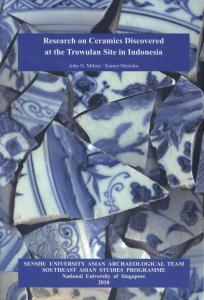 Miksic, John N and Kamei Meitoku Research on the Ceramics Discovered at the Trowulan Site in Indonesia, Tokyo,Japan: Senshu University, 2010
A collection of sherds donated to Dr. Miksic consists of very important examples of Yuan Dynasty blue and white ceramics which are believed to have been collected at Trowulan, east Java, Indonesia. This was the 14th-century capital of Majapahit, which claimed Singapore as one of its dependencies. The blue and white sherds are probably the largest single collection of this type in the world. Dr. Miksic and Prof. Kamei Meitoku of Senshu University, Japan, collaborated on a two-year project to catalogue and analyze this material, which will be of interest to scholars working on the development of Chinese porcelain in general, and in trade between China and Southeast Asia in the 14th century.
Miksic, John N and Kamei Meitoku Research on the Ceramics Discovered at the Trowulan Site in Indonesia, Tokyo,Japan: Senshu University, 2010
A collection of sherds donated to Dr. Miksic consists of very important examples of Yuan Dynasty blue and white ceramics which are believed to have been collected at Trowulan, east Java, Indonesia. This was the 14th-century capital of Majapahit, which claimed Singapore as one of its dependencies. The blue and white sherds are probably the largest single collection of this type in the world. Dr. Miksic and Prof. Kamei Meitoku of Senshu University, Japan, collaborated on a two-year project to catalogue and analyze this material, which will be of interest to scholars working on the development of Chinese porcelain in general, and in trade between China and Southeast Asia in the 14th century.New Publication: Figuring Catholicism: An Ethnohistory of the Santo Niño de Cebu by Julius Bautista
 Bautista, Julius, Figuring Catholicism: An Ethnohistory of the Santo Niño de Cebu, Quezon City: Ateneo de Manila University Press, 2010
This book is about a statue of Christ as a boy worshipped by millions of Filipinos from all walks of life. Today the Santo Niño - said to be the same wooden figure brought to the islands by Ferdinand Magellan at the moment of his 1521 "discovery" of the Philippines - is enshrined in a bullet-proof glass case in a Basilica that hosts throngs of devotees during its Friday novenas. The author combines ethnography with historiography and discourse analysis to study how our most prevalent assumptions about the figure are produced and disseminated. What ideas have sustained such assumptions after all this time? How did the figure become such a popular "national" treasure? To what can we attribute the Santo Niño's appeal outside the official doctrines of the Catholic faith? This book looks at historical documents, popular songs, news articles, poems, and oral accounts to address such questions. In doing so, the book describes the contours of a "figured" Catholicism as the context in which we can think about the Santo Niño in ways we have not done before.
Bautista, Julius, Figuring Catholicism: An Ethnohistory of the Santo Niño de Cebu, Quezon City: Ateneo de Manila University Press, 2010
This book is about a statue of Christ as a boy worshipped by millions of Filipinos from all walks of life. Today the Santo Niño - said to be the same wooden figure brought to the islands by Ferdinand Magellan at the moment of his 1521 "discovery" of the Philippines - is enshrined in a bullet-proof glass case in a Basilica that hosts throngs of devotees during its Friday novenas. The author combines ethnography with historiography and discourse analysis to study how our most prevalent assumptions about the figure are produced and disseminated. What ideas have sustained such assumptions after all this time? How did the figure become such a popular "national" treasure? To what can we attribute the Santo Niño's appeal outside the official doctrines of the Catholic faith? This book looks at historical documents, popular songs, news articles, poems, and oral accounts to address such questions. In doing so, the book describes the contours of a "figured" Catholicism as the context in which we can think about the Santo Niño in ways we have not done before.New Publication: The A to Z of Ancient Southeast Asia by John N Miksic
 Miksic, John N, The A to Z of Ancient Southeast Asia, Lanham, Maryland: Scarecrow Press, 2010
Anyone who has seen the stunning ruins at Angkor, Bagan, and Barabudur will readily understand why Southeast Asia is the host of so many United Nations Educational, Scientific, and Cultural Organization World Heritage Sites. As beautiful as the spiraling towers, intricate carvings, and delicate bas-reliefs adorning these monuments are, however, they just barely scratch the surface of the immense historical and cultural heritage of the region.
Covering the countries of Brunei, Cambodia, Indonesia, Laos, Malaysia, Myanmar, the Philippines, Singapore, Thailand, and Vietnam during the period from the first to the fifteenth century, The A to Z of Ancient Southeast Asia helps us comprehend the vast and complex history of the region through a chronology, a glossary, a bibliography, an introduction, appendixes, maps, photographs, diagrams, and hundreds of cross-referenced dictionary entries on the major (and many minor) sites, the more significant historical figures, the kingdoms they ruled over, the economic and social relations between them, and the artistic, cultural, and religious context.
Miksic, John N, The A to Z of Ancient Southeast Asia, Lanham, Maryland: Scarecrow Press, 2010
Anyone who has seen the stunning ruins at Angkor, Bagan, and Barabudur will readily understand why Southeast Asia is the host of so many United Nations Educational, Scientific, and Cultural Organization World Heritage Sites. As beautiful as the spiraling towers, intricate carvings, and delicate bas-reliefs adorning these monuments are, however, they just barely scratch the surface of the immense historical and cultural heritage of the region.
Covering the countries of Brunei, Cambodia, Indonesia, Laos, Malaysia, Myanmar, the Philippines, Singapore, Thailand, and Vietnam during the period from the first to the fifteenth century, The A to Z of Ancient Southeast Asia helps us comprehend the vast and complex history of the region through a chronology, a glossary, a bibliography, an introduction, appendixes, maps, photographs, diagrams, and hundreds of cross-referenced dictionary entries on the major (and many minor) sites, the more significant historical figures, the kingdoms they ruled over, the economic and social relations between them, and the artistic, cultural, and religious context.New Publication: Christianity and the State in Asia: Complicity and Conflict by Julius Bautista and Francis Khek Gee Lim (eds.)
 Bautista, Julius and Francis Khek Gek Lim (eds.), Christianity and the State in Asia: Complicity and Conflict , Londong and New York: Routledge, 2009
Christianity is one of the most rapidly growing religions in Asia. Despite the challenges of political marginalisation, church organisations throughout much of Asia are engaged in activities - such as charity, education and commentary on public morality - that may either converge or conflict with the state's interests. Considering Christianity's growing prominence, and the various ways Asian nation states respond to this growth, this book brings into sharper analytical focus the ways in which the faith is articulated at the local, regional and global level.
Contributors from diverse disciplinary and institutional backgrounds offer in-depth analyses of the complex interactions between Asian nation states and Christianity in the context of modernisation and nation-building. Exploring the social and political ramifications of Christian conversions in Asia and their impact on state policies, the book analyses how Christian followers, missionaries, theologians and activists negotiate their public roles and identities vis-a-vis various forms of Asian states, particularly in the context of post-colonial nation-building and socio-economic development.
This volume represents a critical contribution to the existing scholarship on Christianity's global reach and its local manifestations, and demonstrates the significance of the Asian experience in our understanding of Christianity as a global religion.
Bautista, Julius and Francis Khek Gek Lim (eds.), Christianity and the State in Asia: Complicity and Conflict , Londong and New York: Routledge, 2009
Christianity is one of the most rapidly growing religions in Asia. Despite the challenges of political marginalisation, church organisations throughout much of Asia are engaged in activities - such as charity, education and commentary on public morality - that may either converge or conflict with the state's interests. Considering Christianity's growing prominence, and the various ways Asian nation states respond to this growth, this book brings into sharper analytical focus the ways in which the faith is articulated at the local, regional and global level.
Contributors from diverse disciplinary and institutional backgrounds offer in-depth analyses of the complex interactions between Asian nation states and Christianity in the context of modernisation and nation-building. Exploring the social and political ramifications of Christian conversions in Asia and their impact on state policies, the book analyses how Christian followers, missionaries, theologians and activists negotiate their public roles and identities vis-a-vis various forms of Asian states, particularly in the context of post-colonial nation-building and socio-economic development.
This volume represents a critical contribution to the existing scholarship on Christianity's global reach and its local manifestations, and demonstrates the significance of the Asian experience in our understanding of Christianity as a global religion.Publication of Ms. Ng Sue Chia’s Honours Thesis (BA Hons, Cohort 2002-2003)
An Honour’s Thesis from the SEASP by Ms Ng Sue Chia (Honours Cohort 2002/2003) titled, “Threads of Gold: The Rise of Indochinese Enterprises in Terengganu” was spotted by a German Publishing house (VDM-Publishing) which approached her for the publication of her thesis. Retaining the original thesis title, the published book will be launched some time in September 2009 and available for purchase on Amazon.com and Nobles & Barnes.com.
Congratulations to Sue Chia on this accomplishment!
Details of the book is noted below: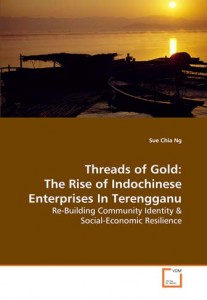
Ng Sue Chia, Threads of Gold: The Rise of Indochinese Enterprises in Terengganu, Germany: VDM Verlag, 2009.
It has been more than 20 years since the Cham community settled en masse in Kuala Terengganu, Malaysia. Yet, hardly much is written about them. This book aims to provide an ethnographical study and examine the immediate history, networks and identity of the Cham Diaspora. The locals had assumed that they are either ‘Malays’ from Cambodia or ‘Vietnamese Muslim converts’. They are Muslim-Cham from Cambodia and Vietnam, who fearing the assaults of the Pol Pot regime and possible threats to their identity-and-religion, have from 1975 begun to flee to various United Nations-run refugee camps in Thailand, hoping to be resettled in Malaysia. From their initial occupations as petty traders and odd job labourers, they have emerged as successful textile and gold retailers in KT. They have also built a socioeconomic network within their community on which they could depend for various form of support.
This book would be of interest to anthropologists and political analysts who are studying minority group relations and the social- political dynamics of refugees-local population interactions.
The Preservation Monument Board (PMB) Honours Thesis Research Grant
Congratulations to Winna Ng Ying Ying (ARS 4) on being awarded the PBM Honours Thesis Research Grant ($1 500) for her thesis, “The Presentation of the Peranakan Community at the Peranakan Museum”.
Medals & Prizes Winners, AY2008-2009
Congratulations to the following students who were awarded medals & prizes for AY2008-2009:
Special Book Prize (ARS 2) – Wee Feng Yi
The Institute of Southeast Asian Studies Prize (ARS 3) – Chen Zhihui Pearlyn
Kernial Singh Sandhu Prize (ARS 4) – Koh Swee Hong Edwin
The Benjamin Batson Gold Medal (MA in Southeast Asian Studies) – Nyan Ming Ren Francis
New Publication: From Distant Tales: Archaeology and Ethnohistory in the Highlands of Sumatra by John N Miksic, Dominik Bonatz, J. David Neidel & Mai Lin Tjoa-Bonatz (eds.)
 Miksic, John N, Dominik Bonatz, J. David Neidel & Mai Lin Tjoa-Bonatz (eds.), From Distant Tales: Archaeology and Ethnohistory in the Highlands of Sumatra, United Kingdom: Cambridge Scholars Publishing, 2009
This is the most comprehensive book devoted to Sumatra in more than half a century. It summarizes earlier studies, and provides a huge amount of new knowledge for the first time in readily accessible form. Sumatra is one of the world’s largest islands, rich in flora and fauna, minerals and timber, and located at the midpoint of the maritime route between China and India. These are ideal conditions for the creation of a fascinating history. Sumatra has played a major role in world trade for 2,000 years, but its culture and archaeology have been surprisingly neglected. This volume sets out to remedy this defect. With chapters on history, archaeology, anthropology, folklore, and religion, the authors focus particular attention on the relations between the coastal peoples who are best known to outsiders, and the hinterlands, where most of the important resources lie. The list of authors includes most of the principal living authorities on Sumatra. Their cumulative experience consists of many years on all parts of the island. The book is copiously illustrated, and includes a comprehensive bibliography for those who wish to pursue further study of the wide range of topics covered.
Miksic, John N, Dominik Bonatz, J. David Neidel & Mai Lin Tjoa-Bonatz (eds.), From Distant Tales: Archaeology and Ethnohistory in the Highlands of Sumatra, United Kingdom: Cambridge Scholars Publishing, 2009
This is the most comprehensive book devoted to Sumatra in more than half a century. It summarizes earlier studies, and provides a huge amount of new knowledge for the first time in readily accessible form. Sumatra is one of the world’s largest islands, rich in flora and fauna, minerals and timber, and located at the midpoint of the maritime route between China and India. These are ideal conditions for the creation of a fascinating history. Sumatra has played a major role in world trade for 2,000 years, but its culture and archaeology have been surprisingly neglected. This volume sets out to remedy this defect. With chapters on history, archaeology, anthropology, folklore, and religion, the authors focus particular attention on the relations between the coastal peoples who are best known to outsiders, and the hinterlands, where most of the important resources lie. The list of authors includes most of the principal living authorities on Sumatra. Their cumulative experience consists of many years on all parts of the island. The book is copiously illustrated, and includes a comprehensive bibliography for those who wish to pursue further study of the wide range of topics covered.Dr Irving Johnson featured in 'Hot Profs in NUS' - The Ridge, August 2007 Issue
Hot Profs in NUS, The Ridge, August 2007 Issue. Dr. Johnson's spontaneity and enthusiasm in everything he does could not have been more evident than in how he readily agreed to this interview. Known for spicing up his lectures by performing shadow puppetry, singing and then complaining about how Singapore has no spontaneity, this man strongly believes in discovering your angin. This interview was conducted by email because the Hot Professor was running off to look at paintings in Thailand. How do you feel about being called a Hot Professor? It's great! Finally some credit. Thank you ExpressMen and GO. But then again, it depends on how you say it. 🙂 What is your angin? Ah ... my passions. I really like performing Thai shadow puppetry (NANG TALUNG). I don't know why. My dream is to one day perform across southern Thailand - buy myself a pickup, and travel from village to village performing at temple festivals, funerals, etc. Can't do without nang talung. I think if there ever came a day when I couldn't do puppetry, I'd shrivel up into a dry mass of sadness and depression. I also really enjoy painting in the classical Thai style. I'm working on a painting right now for a wall in my living room. It's been more than a year now and it's still far from complete because I only work on it in my spare time. A shout out to the students of NUS: FOLLOW YOUR ANGIN! THINK OUTSIDE THE SILLY BOX. View the original article.
SEAS Alumnus Wang Zineng featured in NUS Centre for the Arts (CFA) Artzone Magazine Issue 2, Aug - Oct 2007
One Cool Guy - Wang Zineng has chosen a route less followed by his peers in opting for a life dedicated to the arts, Artzone Issue 2, August - October 2007. While others are busy climbing their way up the career ladder in the private or public sector, Zineng chose a subtler route. What differentiates him from the rest of the recent crop of graduants is his eye for detail and an infinite appreciation of the arts, especially visual arts. For Zineng, the arts scene is not about the glitz and the glam. The passion for art in him overpowers the conventional path material success. Zineng has recently completed his honours thesis on Malayan batik painting in the Southeast Asian Studies Programme, NUS. Presently an adjunct assistant curator at NUS Museum, he is in charge of four projects: one involves setting up the second installation of NUS Museum's exhibition on their permanent collection known as Highlights: Modern Southeast Asian Art Collection, which will run until 2008. In this project, Zineng helped to finalise the selection of artworks, identify the overarching themes of these works, and decide where within the NUS Museum to place these artworks. He also contributed to the exhibition brochure. Unlike the movie Night at the Museum where dinosaurs were seen chasing humans and working at the museum seems like an exciting adventure, Zineng's job requires more than just surface action. Besides having to do thorough research in preparation for exhibitions, he constantly needs to preserve a healthy rapport with the staff, artists and other professionals. When asked about his future plans, he spoke of studying textilemaking in Indonesia in August and will continue to develop theoretical and context-based bodies of knowiedge in Southeast Asian art and culture. His interests are not confined to modern art. Instead he gets pleasure from firsthand research and keeping abreast with developments in the study of the ethnographic arts. "My plans are simple; they revolve around only one requisite - that I believe what I do bears relevance and interest to people around me. If I ever stop believing, that is the day I discontinue making plans." Zineng shared his heartwarming memories of an encounter which took place at the end of an afternoon touring Bodies and Relationships: Selected Works of Lee Sik Khoon before it opened. "Lee Sik Khoon's wife came up to me and thanked me for putting into words what she has always lett about her husband's art but could never express. Quite naturally, I felt a great sense of pride at that point." By Hanizah Abdullah, Artzone Contributor View the original article.
Thai Princess performed with the NUS Thai Music Ensemble
Thai princess ends fruitful visit to S'pore, The Straits Times, Thursday 26 April 2007. PRINCESS Maha Chakri Sirindhom of Thailand wrapped up a three-day visit to Singapore yesterday. She made four stops on her last day here, which started at 9.30am and included a visit to the Genome Institute of Singapore (GIS) in Buona Vista. Touring the institute's research facilities, the princess showed", "good grasp and great interest" in genetic sciences, said GIS' deputy director, Associate Professor Lawrence Stanton. Her three-day visit began, with the launch of the International Convention for Rehabilitation Engineering and Assistive Technology. The inaugural conference and exhibition, which ends today, showcases devices and technology designed to rehabilitate people with disabilities: Known for her involvement in community and social development projects, the princess' interest in health care stems from the influence of her grandparents, who were trained medical personnel. In addition to her visits, she also made personal donations of $5,000 each to three centres for the disabled - the Rainbow Centre and Margaret Drive Special School, SIA-Minds Employment Development Centre, and the Tan Tock Seng Hospital Rehabilitation Centre. On the diplomatic front" she met Singapore's leaders, including Prime Minister Lee Hsien Loong who hosted a lunch for her at the Istana. The warm hospitality shown her left the princess "extremely pleased" with her visit, said the Thai Ambassador to Singapore, Mr Chalermpol Thanchitt. It was not all work, though. She found time to attend a concert at the University Cultural Centre in Kent Ridge on Monday. The Singapore Chinese Orchestra (SCO) performed two songs composed, by the princess. She gamely agreed to join the orchestra on stage, playing a tune on the sor duang (a two-string violin-like Thai instrument) with the National University of Singapore Thai Music Ensemble and SCO. The rare royal performance received a standing ovation. Said Mr Chalermpol: "It was a great show of friendship and unity." View the original article.
Spotlight on Southeast Asian Studies (FASS Ascent, Vol. 15, No. 1)
Spotlight on Southeast Asian Studies - a special feature on Southeast Asian Studies (FASS Ascent Magazine, Vol. 15, No. 1, September 2006)



